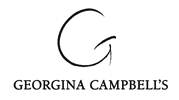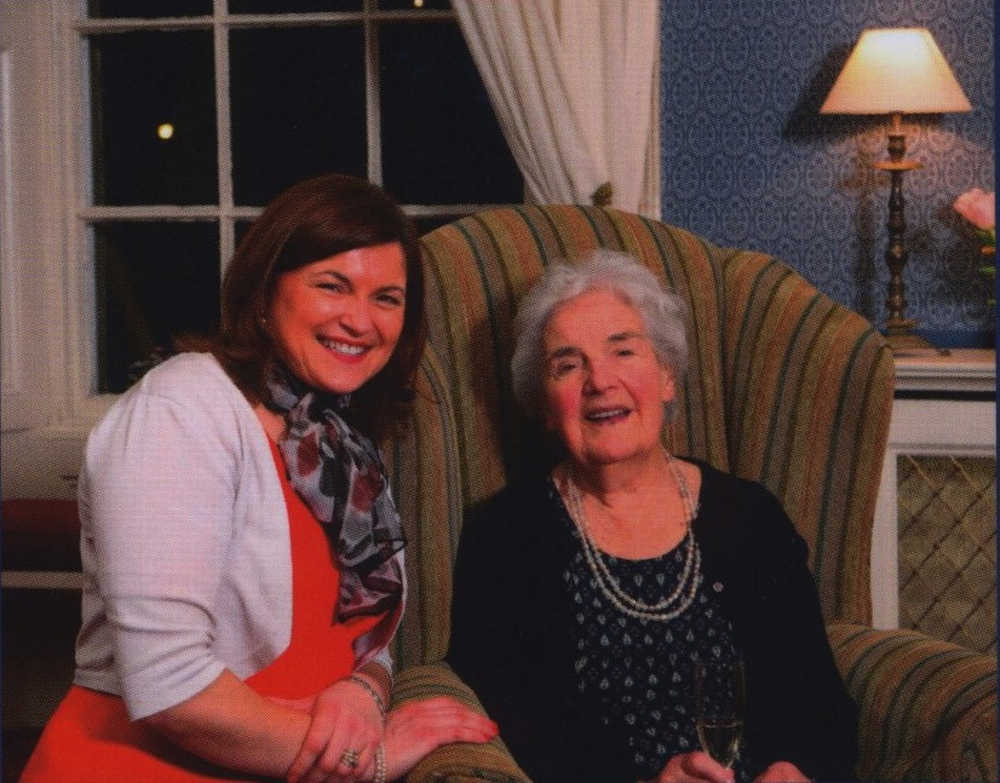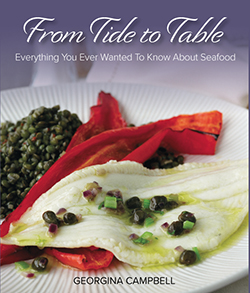Article BOOK REVIEWS
Pesto Lasagne from 'The Wine and Food of Ely Through the Seasons'
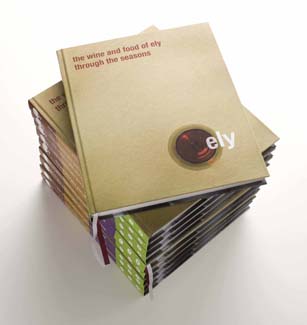
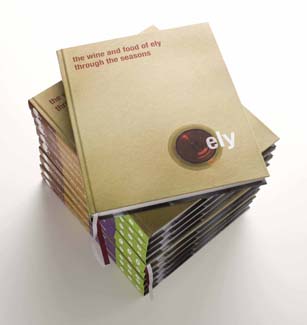 Homemade pasta is easier to make than you might think, as shown by this appealing vegetarian main course from Erik and Michelle Robson’s impressive and practical recently published cookbook ‘The Wine and Food of Ely Through the Seasons’ (full colour hardback, €29 from Ely restaurants and selected wine merchants).
Homemade pasta is easier to make than you might think, as shown by this appealing vegetarian main course from Erik and Michelle Robson’s impressive and practical recently published cookbook ‘The Wine and Food of Ely Through the Seasons’ (full colour hardback, €29 from Ely restaurants and selected wine merchants). Ely restaurants are renowned for serving organic beef, pork and lamb from the family farm in the Burren, County Clare and for their exceptional wine list (over 100 wines by the glass), as well as food that - despite the scale - is all home cooked.
This recipe for Pesto Lasagne demonstrates their down-to-earth attitude and attention to detail – and, like all the 70+ recipes in the book, two wine suggestions are offered to accompany the dish.
Although lengthy, this recipe is straightforward and would be relaxing to prepare when you are not rushed (and, whilst they wouldn’t do this at Ely, commercial pesto and/or lasagne sheets could be used instead when you’re busy).
The pesto mix can be prepared in advance, but the lasagne sheets should be cooked just before you are about to assemble the lasagne. If you don’t have a pasta machine, roll the pasta out into square sheets with a rolling pin on a floured surface.
Click for recipe
The Galway Ingredient
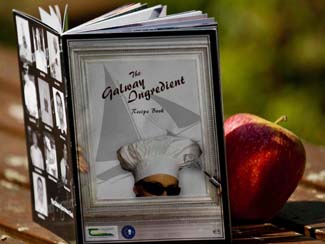
 Over in the west of Ireland, a small group of Euro-Toques chefs (members of the non-elitist international chefs’ organisation dedicated to safeguarding culinary heritage) got together to celebrate the food of the area - and the recent Volvo Ocean Race stopover - in a DIY recipe book, The Galway Ingredient.
Over in the west of Ireland, a small group of Euro-Toques chefs (members of the non-elitist international chefs’ organisation dedicated to safeguarding culinary heritage) got together to celebrate the food of the area - and the recent Volvo Ocean Race stopover - in a DIY recipe book, The Galway Ingredient. Teagasc gave some welcome support, but it was produced on a tight budget and the standard is a credit to those involved, notably Michael O’Meara (Oscars Bistro) who is as handy with a camera as a set of knives (www.foodandwinephotography.com), and editor Gerry Galvin.
The ten contributing chefs include Cliodhna Prendergast (Delpi Lodge), Tim O’Sullivan (Renvyle House Hotel), Stefan Matz (Ashford Castle) and Wade Murphy (Lisloughrey Lodge), and the widely varying recipes using local ingredients, and Micheal O’Meara’s evocative images convey a real sense of place – giving a lot for just €5. (Available from selected bookshops, Failte Ireland in Galway and participating restaurants; inquiries to: gmgalvin@eircom.net).
Click through the link to see a delicious recipe by Gerry Galvin for Seafood Coddle
Book Reviews
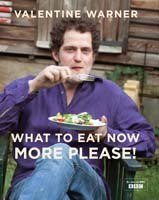 Two very appealing new cookbooks have hit my desk recently, and both will merit a re-visit later in the year, as there are some delicious recipes well worth sampling.
Two very appealing new cookbooks have hit my desk recently, and both will merit a re-visit later in the year, as there are some delicious recipes well worth sampling.What To Eat Now – More Please! by Valentine Warner
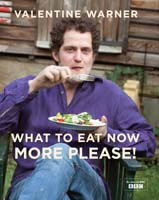
Followers of Valentine Warner’s first TV series and book, What To Eat Now, which turned the spotlight on autumn and winter food, will have been pleased to see him back on BB2 in recent weeks, doing the same for summer food in What To Eat Now – More Please! (Mitchell Beazley, stg£20).
As well as being a curious and accomplished chef (those years working under luminaries such as Alastair Little and Rose Carrarini really show) Valentine has artistic talent which can be seen in his quirky illustrations, curiosity and offbeat style. But, aside from all that, he has a great way producing lovely simple food with style – and, while there’s plenty of international influence at work (and nothing wrong with that), what’s inspirational is the use of what are mostly familiar everyday ingredients at the peak of their perfection.
Howard Sooley’s photography deserves special mention for getting this across, as his images are so full of life they just leap off the page. I really like this book, it has lots of ideas for gardeners, foragers and fisherpersons; people on holiday, holding a barbeque or heading off on a picnic: deelish.
Picnic crudité loaf
Most of the dishes in the book are basically pretty sensible, but I can’t make my mind up about the following recipe – is it actually any use or just a bit too fey? It’s certainly cute anyway – and, without the loaf idea you have a good basic recipe. And you can always use the discarded bread to make breadcrumbs (freeze until the next time you want to make a stuffing or crumb topping).
“I cannot remember where I saw this dish first”, says Valentine Warner, “But I do recall a sixties-looking book with a sun-bleached dust jacket and the weirdest-coloured food inside. I thought this ingenious idea should resurface. You’ll need a good, large crusty loaf, not the pale, soft and weedy type that people give to 1-footed pigeons.” Quite.
Click here for recipe
Mackerel Tataki
This is a more typical recipe from What To Eat Now - More Please! And, as Valentine rightly says, “It’s a fine way to approach small and lean summer mackerel. The tastes are so clean.” (I’m not sure that too many of us are likely to “carry a tiny case with the rapid response kit of ingredients, [so] you can make this outdoors with fish caught or bought”, but you could certainly make it in a holiday cottage.) Make sure that the fish is super-fresh.
Click here for recipe
Green & Black’s Chocolate Recipes
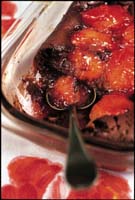 By contrast, Green & Black’s Chocolate Recipes (Kyle Cathie stg£14.99) is full of all sorts of luscious items that should only be seen as special treats - and a dead cert to come at the top of a lot of wish lists. The recipes are predictably irresistible, combining unfamiliar and sometimes unexpected combinations (chocolate in sauces for savoury dishes, eg game, for example), with a host of luscious favourites and their variations (chocolate mousses, for example, comes in no less than eight guises – I like the idea of the bitter chocolate mousse with blackcurrants…).
By contrast, Green & Black’s Chocolate Recipes (Kyle Cathie stg£14.99) is full of all sorts of luscious items that should only be seen as special treats - and a dead cert to come at the top of a lot of wish lists. The recipes are predictably irresistible, combining unfamiliar and sometimes unexpected combinations (chocolate in sauces for savoury dishes, eg game, for example), with a host of luscious favourites and their variations (chocolate mousses, for example, comes in no less than eight guises – I like the idea of the bitter chocolate mousse with blackcurrants…). There’s also background on the production of chocolate, plus practical tips on cooking techniques and handling chocolate. A must-buy for all chocoholics.
Drunken Damson Dessert
This gorgeous dessert is one of the healthier recipes in Green & Black’s Chocolate Recipes and, now that top fruit is coming into season, this combination of damsons (or other plums) with best quality chocolate should fit the bill perfectly when you need a grand finale for a special late summer meal.
If you are not using damsons rescued from your own damson gin, you can use fresh plums instead in this recipe, as explained in recipe.
Click here for recipe
Book Reviews
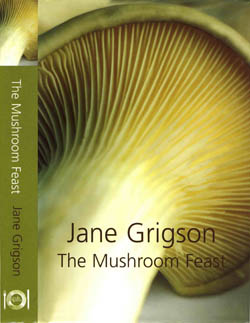
 The seasonal rush of books for the Christmas market is only around the corner (one I just can’t wait to see is Carmel Somers’ Eat Good Things Every Day, due to hit the bookshops in October), meanwhile the short lull allows a little time to catch up with some others.
The seasonal rush of books for the Christmas market is only around the corner (one I just can’t wait to see is Carmel Somers’ Eat Good Things Every Day, due to hit the bookshops in October), meanwhile the short lull allows a little time to catch up with some others. For example, anyone thinking of joining one of the many mushroom-hunting and other foraging outings on offer in the coming weeks, such as the annual event at Longueville House, Co Cork, would find the late Jane Grigson’s classic The Mushroom Feast (Grub Street, hardback) a particularly enjoyable read and - with over 250 recipes and masses of tips for picking and preserving the best varieties - a practical one too. First published in 1975, it pre-dates the ‘all-colour photography’ era but more than compensates with some charming line drawings, and wonderfully wide-ranging and beautifully-written text; re-printed in hardback in 2007, both this and a 1987 paperback edition are easily available online.
Two recently published books that should be read by anyone with so much as a passing interest in food (or health, wealth, the environment and just about everything to do with the human condition) are In Defence of Food by Michael Pollan and Waste by Tristram Stuart.
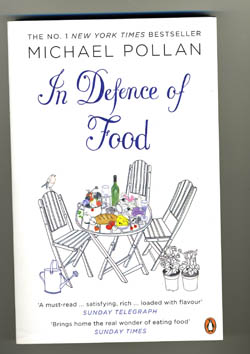 Michael Pollan’s In Defence of Food (Penguin, £8.99) follows Pollan’s recent bestseller, The Omnivore’s Dilemma, which was a thought-provoking production-to-plate analysis of the choices and responsibilities facing us when deciding what we can/should eat for dinner. The new book looks at the more positive side of the coin, inviting readers to ‘junk the science, ditch the diet and rediscover the joys of eating well’ – although equally scholarly it’s ultimately a cheerier read altogether, not least because it finishes with a chapter of pointers towards eating better, and more healthily, which put us back in control. Even if you were to skip the rest and just read the final chapter, it would be worth buying this book: the sub-headings in a chapter that gives the reader an encouraging sense of empowerment include Pay More, Eat Less (quantity v quality), which seems a very sensible mantra, debunking the persistent post WW2 line that food should be cheap; Eat Meals (ie proper meals, not on the hoof); Don’t Get Your Fuel From The Same Place Your Car Does (much of the food sold at garages is highly processed and non-perishable); Eat Slowly (see www.slowfood.com). And he keeps the very best bit until last; in order that ‘eaters can involve themselves in food production to whatever extent they can’ Pollan urges: ‘Cook and, If You Can, Plant A Garden’. I’ll vote for that - what could be more satisfying?
Michael Pollan’s In Defence of Food (Penguin, £8.99) follows Pollan’s recent bestseller, The Omnivore’s Dilemma, which was a thought-provoking production-to-plate analysis of the choices and responsibilities facing us when deciding what we can/should eat for dinner. The new book looks at the more positive side of the coin, inviting readers to ‘junk the science, ditch the diet and rediscover the joys of eating well’ – although equally scholarly it’s ultimately a cheerier read altogether, not least because it finishes with a chapter of pointers towards eating better, and more healthily, which put us back in control. Even if you were to skip the rest and just read the final chapter, it would be worth buying this book: the sub-headings in a chapter that gives the reader an encouraging sense of empowerment include Pay More, Eat Less (quantity v quality), which seems a very sensible mantra, debunking the persistent post WW2 line that food should be cheap; Eat Meals (ie proper meals, not on the hoof); Don’t Get Your Fuel From The Same Place Your Car Does (much of the food sold at garages is highly processed and non-perishable); Eat Slowly (see www.slowfood.com). And he keeps the very best bit until last; in order that ‘eaters can involve themselves in food production to whatever extent they can’ Pollan urges: ‘Cook and, If You Can, Plant A Garden’. I’ll vote for that - what could be more satisfying? 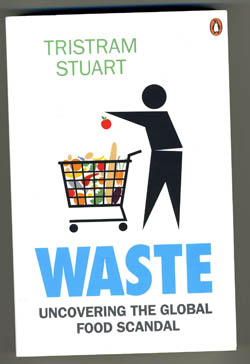 Tristram Stuart’s Waste (Penguin, £9.99), on the other hand, is a chilling indictment of a widespread uncaring attitude that allows vast quantities of food to be dumped or written off in all sectors of the developed world – crops written off in the field, discarded fish dumped in the sea, fresh food thrown into supermarket bins and, at a domestic level, uneaten food is binned from our fridges. Perhaps there is no food shortage, just mismanagement on a vast scale. Reading this book will open our eyes and, at the very least, persuade us to be less wasteful personally – and it will undoubtedly influence many key decision-makers in the food industry.
Tristram Stuart’s Waste (Penguin, £9.99), on the other hand, is a chilling indictment of a widespread uncaring attitude that allows vast quantities of food to be dumped or written off in all sectors of the developed world – crops written off in the field, discarded fish dumped in the sea, fresh food thrown into supermarket bins and, at a domestic level, uneaten food is binned from our fridges. Perhaps there is no food shortage, just mismanagement on a vast scale. Reading this book will open our eyes and, at the very least, persuade us to be less wasteful personally – and it will undoubtedly influence many key decision-makers in the food industry. 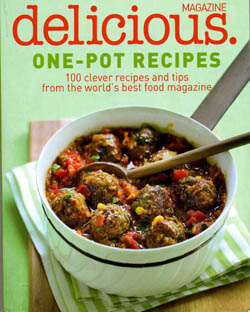 Over to less contentious matters and a new trio of cookbooks from Delicious Magazine – Frugal Feasts, Baking and One-Pot Recipes. Each little book offers 100 accessible recipes (all with a photo) and, coming in at under a fiver in the UK (approx €6), at a very recession-friendly price. They remind me of Neven Maguire’s earlier books – the simple inexpensive ones published when he was the chef on RTE’s Open House: the production standard isn’t fancy and you won’t find too many surprises here, but they’re down to earth, don’t use expensive/obscure ingredients and anyone could cook from them. A handy reference for younger people running a home under pressure for the first time – and maybe a useful aide-memoire for more experienced cooks who may be reacquainted with some old favourites that lapsed from the repertoire during the Tiger years.
Over to less contentious matters and a new trio of cookbooks from Delicious Magazine – Frugal Feasts, Baking and One-Pot Recipes. Each little book offers 100 accessible recipes (all with a photo) and, coming in at under a fiver in the UK (approx €6), at a very recession-friendly price. They remind me of Neven Maguire’s earlier books – the simple inexpensive ones published when he was the chef on RTE’s Open House: the production standard isn’t fancy and you won’t find too many surprises here, but they’re down to earth, don’t use expensive/obscure ingredients and anyone could cook from them. A handy reference for younger people running a home under pressure for the first time – and maybe a useful aide-memoire for more experienced cooks who may be reacquainted with some old favourites that lapsed from the repertoire during the Tiger years.RECIPE from Delicious Magazine’s Frugal Feasts (£5 in UK)
All-in-one baked lemon and rosemary chicken
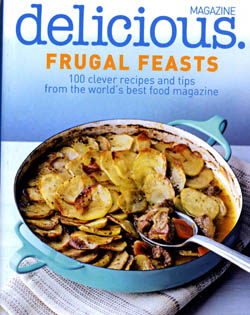 This super-simple one-pot chicken recipe from Delicious Magazine's Frugal Feasts (£5, UK) requires almost no prearation and is ready in less than one hour.
This super-simple one-pot chicken recipe from Delicious Magazine's Frugal Feasts (£5, UK) requires almost no prearation and is ready in less than one hour.Click for recipe
Cliff House Hotel, The Cookbook
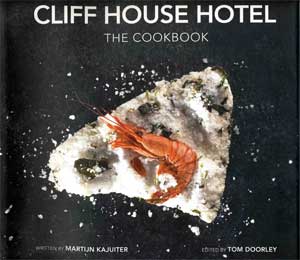
 STOP PRESS! (Or at least it would be stop press in a non-digital world), a lovely big hunk of a book has just landed on my desk and – although it’s something to come back to in more detail another time – I just have to share my initial impressions of Cliff House Hotel, The Cookbook (Houghton Mifflin Harcourt publishers, New York; hardback 238pp, €24.95).
STOP PRESS! (Or at least it would be stop press in a non-digital world), a lovely big hunk of a book has just landed on my desk and – although it’s something to come back to in more detail another time – I just have to share my initial impressions of Cliff House Hotel, The Cookbook (Houghton Mifflin Harcourt publishers, New York; hardback 238pp, €24.95). Well-produced books are rare enough at the best of times but, (even if General Manager Adriaan Bartels says in his Introduction ‘little did we know how much work it would involve or how long it would take’), it seems nothing short of a miracle to produce a work of this quality so quickly. Aside from anything else (although built on a site that has been a hotel since the 1920s), this stunning hotel is very new – it is in fact our current Newcomer of the Year - which makes this achievement all the more remarkable.
It is, of course, all down to talent and dedication – how many new hotels have a visionary like the highly regarded Dutch Head Chef, Martijn Kajuter, in the kitchen from the outset (autumn 2007 in fact, before the kitchen was built), and with the total support of a team led by Mr Bartels, who is widely acknowledged as one of Ireland’s most exceptional hoteliers. Add in the creativity of Cork photographer Andrew Bradley and the team at Design Factory (Dublin and New York) who, together, give the book an assured style in tune with hotel itself, and unusual things are only to be expected.
As to the main content – written by Martijn Kajuter and edited by Tom Doorley – anyone who’s experienced the sophisticated food at The Cliff House Hotel will no doubt anticipate recipes like Monkfish with Smoke, but should be pleasantly surprised by the relative accessibility of many of the dishes put forward by this most creative of chefs. However complex the restaurant offering may seem to admiring diners, Martijn Kajuter’s foundation is the wholesome, seasonal produce of the area – notably seafood and good things from their own garden and St Raphael’s Centre in Youghal.
And, while there may be recipes that (however beautiful to look at) few readers will wish to undertake, an impressive range of equally beautiful but much simpler dishes is offered, with correspondingly short and straightforward ingredients lists.
Whether regarded as a coffee table book or a working cookbook, this handsome book is truly representative of both The Cliff House Hotel and its surrounding area. It will no doubt be coveted by many who have visited the hotel - and be at the top of many a Christmas list this year. It also happens to be very kindly priced.
Book Reviews
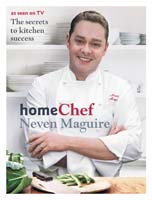
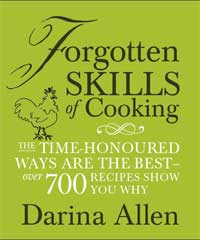 It’s an exceptionally good year for cookery books so, for a lot of gift lists, that could be Christmas pretty much sorted. The only question is, which ones suit your nearest and dearest best?
It’s an exceptionally good year for cookery books so, for a lot of gift lists, that could be Christmas pretty much sorted. The only question is, which ones suit your nearest and dearest best?The season’s crop breaks down roughly into three groups – first there are the heavyweights (serious books that you’ll want to keep for life), secondly the chef cookbooks (which, ironically, mainly focus on home cooking this year) – and then (don’t laugh), many of the others seem to major in cupcakes…
The newest of the heavyweights is Darina Allen’s Forgotten Skills of Cooking (Kyle Cathie hardback, rrp €31.50); subtitled “the lost art of creating delicious home produce”, this very ‘now’ encyclopaedic 700-recipe tome details the many practical cookery/food skills that the last couple of generations have missed out on.
It’s based on the highly popular Forgotten Skills courses at Ballymaloe Cookery School – which Darina started when she became a grandmother and realised the importance of passing on her knowledge. Saying that “doing it yourself is not just economically sound but incredibly satisfying”, Darina covers subjects as diverse as Keeping a Few Chickens or Using the Whole Pig – to Home Smoking, and Cider and Wine Making; more familiar topics like baking and making old-fashioned stews are covered too – also preserving and making your own yoghurt and butter.
Much of this will be familiar to over 50s who grew up in the country, and will make anostalgic read for some – and younger readers who have never had to make do and now need to save money may be interested to find lots of ideas - including ways to use up leftovers, something which came naturally to earlier generations. Forgotten Skills of Cooking is just hitting the shops now.
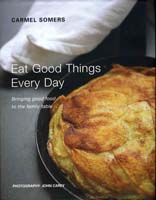 Also just going into the book shops, Carmel Somers’ beautifully produced Eat Good Things Every Day (Atrium/Cork University Press, hardback 326pp, €39), is an inspiring and brilliantly down to earth book; although not (yet) a household name Carmel, who is owner-chef of the well-named Good Things Café & Cookery School at Durrus, Co Cork (current winner of our Natural Food Award), is totally focused on making the best possible use of fresh seasonal produce - and this highly practical, time- and budget-conscious book is all about being better organised and eating really well without waste: with once-a-week shopping lists, she gives recipes for eight weeks of daily meals – and, like the wonderful food served in her café, it’s healthy and flavoursome fare.
Also just going into the book shops, Carmel Somers’ beautifully produced Eat Good Things Every Day (Atrium/Cork University Press, hardback 326pp, €39), is an inspiring and brilliantly down to earth book; although not (yet) a household name Carmel, who is owner-chef of the well-named Good Things Café & Cookery School at Durrus, Co Cork (current winner of our Natural Food Award), is totally focused on making the best possible use of fresh seasonal produce - and this highly practical, time- and budget-conscious book is all about being better organised and eating really well without waste: with once-a-week shopping lists, she gives recipes for eight weeks of daily meals – and, like the wonderful food served in her café, it’s healthy and flavoursome fare. Together, these two books represent Ireland’s best cooking and most inspiring food philosophy – buy them both and see if you can bear to give them away.
 Chef cookbooks always make an interesting gift and there’s no shortage of choice – for the many fans of Dublin’s L'Ecrivain restaurant, Derry Clarke’s Keeping It Simple (Gill & Macmillan, hardback €24.99) may be an first obvious choice, although, with a fascinating introduction by Paolo Tullio, Roly's Café & Bakery (Gill & Macmillan, softback €19.99) could be a close second.
Chef cookbooks always make an interesting gift and there’s no shortage of choice – for the many fans of Dublin’s L'Ecrivain restaurant, Derry Clarke’s Keeping It Simple (Gill & Macmillan, hardback €24.99) may be an first obvious choice, although, with a fascinating introduction by Paolo Tullio, Roly's Café & Bakery (Gill & Macmillan, softback €19.99) could be a close second.  But ever-popular chef, Neven Maguire of MacNean House & Restaurant, also has a new book, Home Chef (HarperCollins, hardback €25) and, as he has a special talent for understanding the domestic kitchen and a well-earned following, this adaptation of favourite MacNean Restaurant dishes for cooking at home is sure to be a winner.
But ever-popular chef, Neven Maguire of MacNean House & Restaurant, also has a new book, Home Chef (HarperCollins, hardback €25) and, as he has a special talent for understanding the domestic kitchen and a well-earned following, this adaptation of favourite MacNean Restaurant dishes for cooking at home is sure to be a winner. For a more international take, restaurateur-chefs Rose Gray and Ruth Rogers of the iconic River Café, The River Café Classic Italian Cook Book (Penguin hardback, €39.60) should tick all the boxes – who was it who taught Jamie Oliver (and many others) to cook, after all?
 Then for everyone who’s loving baking there’s the “cupcake” brigade, led by London’s famous Hummingbird Bakery Cookbook (Ryland Peters & Small hardback, stg£16.99) which features cupcakes galore, along with cakes, pies, muffins, brownies and bars…while fans of Julie Duff’s excellent previous book, Cakes Regionl & Traditional, will snap up her newer Cakes From Around The World (Grub Street, paperback stg£14.99). Ireland’s most famous mother-of-three,
Then for everyone who’s loving baking there’s the “cupcake” brigade, led by London’s famous Hummingbird Bakery Cookbook (Ryland Peters & Small hardback, stg£16.99) which features cupcakes galore, along with cakes, pies, muffins, brownies and bars…while fans of Julie Duff’s excellent previous book, Cakes Regionl & Traditional, will snap up her newer Cakes From Around The World (Grub Street, paperback stg£14.99). Ireland’s most famous mother-of-three, Rachel Allen, brings plenty of experience to her pretty pink-bound Home Cooking (HarperCollins hardback, rrp €30.75) and, although wide-ranging, you’ll find some unusual cupcakes hiding in there too.
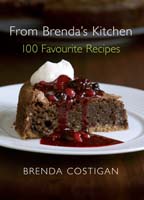 From Brenda’s Kitchen (Gill & Macmillan paperback, €19.99), however, is a cupcake-free zone – which won’t worry the many fans who will be delighted to have 100 recipes from her popular and long-running column in the Sunday Independent in one handy volume.
From Brenda’s Kitchen (Gill & Macmillan paperback, €19.99), however, is a cupcake-free zone – which won’t worry the many fans who will be delighted to have 100 recipes from her popular and long-running column in the Sunday Independent in one handy volume. [See this month’s Cookery Feature for sample recipes from some of the cookbooks mentioned.]
Book Reviews - Seasonal Sanity Savers
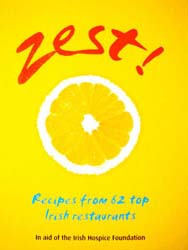
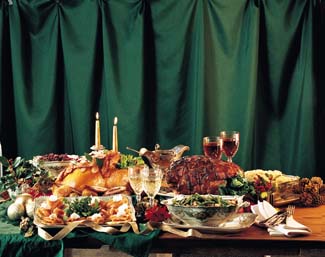 Tradition usually rules at Christmas if you’re cooking for a large number (see our main cookery feature for the traditional Christmas feast ) – and, if you’re lucky, there will be plenty of leftovers to ease demand on the cook for a day or two afterward.
Tradition usually rules at Christmas if you’re cooking for a large number (see our main cookery feature for the traditional Christmas feast ) – and, if you’re lucky, there will be plenty of leftovers to ease demand on the cook for a day or two afterward. But if you are just a couple or a small group, turkey and ham may not appeal – and then there are those with special dietary needs, notably vegetarians, who must have something different. And, following the seasonal over-indulgence on protein-heavy foods, even the most dedicated carnivore will feel better for an occasional meat-free meal or at least one with an emphasis on fresh vegetables. With all this was in my mind you may find the following suggestions from more of the season’s best cookery books appealing throughout the Christmas/New Year holiday.
 For anyone with a food allergy, navigating your way through festive fare (and restaurant menus) can be a nightmare, making Antoinette Savill’s practical and inspiring book Learn to Cook Wheat, Gluten and Dairy Free (Grub Street paperback, stg£14.99) something of a godsend; knowing the restrictions, many people will be surprised at the variety offered across the range of 100 recipes in the book – including dishes suitable for Christmas/entertaining such as Roast Pheasant with Gravy & Bread Sauce.
For anyone with a food allergy, navigating your way through festive fare (and restaurant menus) can be a nightmare, making Antoinette Savill’s practical and inspiring book Learn to Cook Wheat, Gluten and Dairy Free (Grub Street paperback, stg£14.99) something of a godsend; knowing the restrictions, many people will be surprised at the variety offered across the range of 100 recipes in the book – including dishes suitable for Christmas/entertaining such as Roast Pheasant with Gravy & Bread Sauce.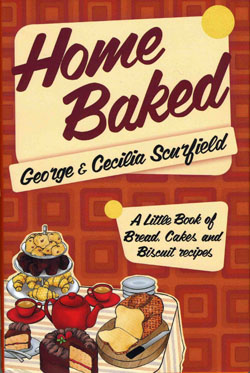 Cookbooks have become so highly illustrated that many younger cooks will find the idea of a ‘text only’ cookbook with perhaps a few line drawings quite strange. They have a special charm however, and it’s good to see some revivals – Home Baked (Grub Street hardback, stg£12.99) is a new edition of George and Cecilia Scurfields’ two little baking classics, Home Baked and Home-Made Cakes and Biscuits, first published in 1956 and 1963 respectively. With plenty of practical advice and foolproof recipes, this will be an interesting and useful little treat for new generation bakers, or a bit of nostalgia for an older cook.
Cookbooks have become so highly illustrated that many younger cooks will find the idea of a ‘text only’ cookbook with perhaps a few line drawings quite strange. They have a special charm however, and it’s good to see some revivals – Home Baked (Grub Street hardback, stg£12.99) is a new edition of George and Cecilia Scurfields’ two little baking classics, Home Baked and Home-Made Cakes and Biscuits, first published in 1956 and 1963 respectively. With plenty of practical advice and foolproof recipes, this will be an interesting and useful little treat for new generation bakers, or a bit of nostalgia for an older cook.  Brother Anselm’s Glenstal Cookbook (Columbia Press, www.columba.ie; €12.99 with free delivery in Ireland; also available from booksellers, eg Amazon) is a collection of simple, wholesome dishes cooked by Brother Anselm, who is head chef at Glenstal Abbey, and with a Foreword by his real brother, the actor John Hurt. They are good family recipes and, as Brother Anselm normally cooks for 30-40mpeople, the quantities in some recipes are quite large –perfect for a party perhaps, and easy to scale down. No glossy photos, but this is a more personal; offering with quirky drawings to illustrate.
Brother Anselm’s Glenstal Cookbook (Columbia Press, www.columba.ie; €12.99 with free delivery in Ireland; also available from booksellers, eg Amazon) is a collection of simple, wholesome dishes cooked by Brother Anselm, who is head chef at Glenstal Abbey, and with a Foreword by his real brother, the actor John Hurt. They are good family recipes and, as Brother Anselm normally cooks for 30-40mpeople, the quantities in some recipes are quite large –perfect for a party perhaps, and easy to scale down. No glossy photos, but this is a more personal; offering with quirky drawings to illustrate.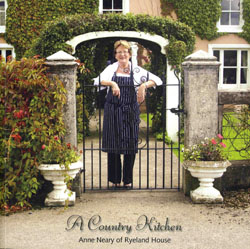 For family and friends who drop by over the Christmas period, try Anne Neary’s 10 minute recipe for Mulled Wine from A Country Kitchen (paperback, available online from www.ryelandhousecookery.com , €26 incl P&P, and selected bookshops in the South-East). Written by a teacher with nearly 20 years experience of running her Ryeland House Cookery School in Co Kilkenny, and a love of the country, its produce and introducing young people to the origins of their food, it’s a book with an authentic voice - and one I will come back to. Meanwhile, from the Christmas chapter, here’s a tasty little number for a party helping down the mince pies.
For family and friends who drop by over the Christmas period, try Anne Neary’s 10 minute recipe for Mulled Wine from A Country Kitchen (paperback, available online from www.ryelandhousecookery.com , €26 incl P&P, and selected bookshops in the South-East). Written by a teacher with nearly 20 years experience of running her Ryeland House Cookery School in Co Kilkenny, and a love of the country, its produce and introducing young people to the origins of their food, it’s a book with an authentic voice - and one I will come back to. Meanwhile, from the Christmas chapter, here’s a tasty little number for a party helping down the mince pies.Click here for recipe
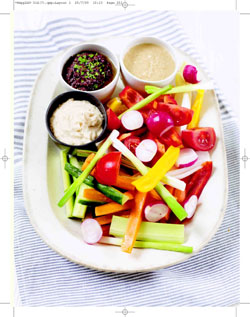 Crudités with White Bean Dip
Crudités with White Bean DipSeasonal raw vegetables, served as an appetiser or hors d'oeuvre, are lovely at any time and a great antidote to heavy food over Christmas. “Especially,” says Rachel Allen in her book Home Cooking (HarperCollins, hardback €19.99), “When there is a tasty dip to indulge in.” She gives lots of ideas, including tapenade, savoury nut butter, guacamole and tzatziki; most – like this versatile white bean dip – are suitable for vegetarians. The dip can also be spread on bruschetta or a piece of crispbread, or warmed up and served with a steak or chops. Keeps in the fridge for up to two days.
Makes as many as you like.
Click for recipe
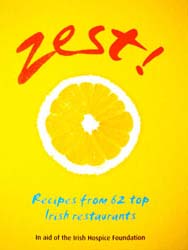 Gravadlax with dill mustard sauce
Gravadlax with dill mustard sauceMany of us have reason to be grateful for the tireless work and kindness of the Irish Hospice Foundation and Zest! (hardback, Irish Hospice Foundation, €20) is a beautiful new recipe collection from leading chefs all around Ireland, each of whom contributed recipes for a balanced three-course meal to raise funds for this exceptionally worthwhile cause.
But, charitable aims aside, this is a fine book in its own right and includes many gorgeously do-able recipes, such as this gravadlax donated by the stylish Dublin restaurant, Peploes, on St Stephen’s Green. Like vegetarian food, fish is especially appreciated at this time of year, and gravadlax makes a delicious alternative to traditional smoked salmon; you do have to remember to begin a couple of days ahead, but it is very simple to make.
Click for recipe
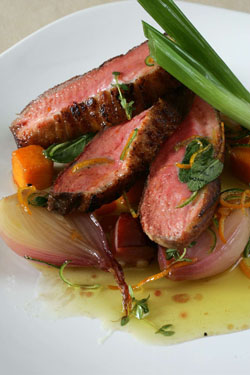 Crispy duck breast with glazed butternut squash
Crispy duck breast with glazed butternut squashFrom Derry Clarke’s (lEcrivain) latest book ‘Keeping It Simple’ (Gill & Macmillan €24.99), this could be a nice recipe for a smaller Christmas meal, for 2-4 people. Derry advises “Before cooking duck breast, rub the skin with sea salt for extra crispness.
Cooking the duck skin side down in a pan that you heat from cold also helps the skin to cook through. I would recommend serving duck pink. The butternut squash in this dish cuts the richness of the duck.”
Rare duck is quite a cheffy thing and you can of course cook it for longer, if preferred. You can also vary the accompaniment – here the butternut squash works with the duck in the same way as more traditional turnip, for example.
Click for recipe
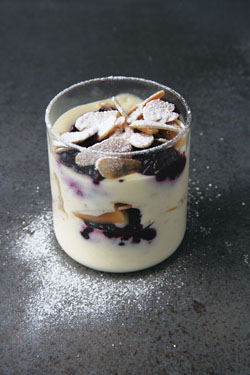 If you’re looking for a delicious, traditionally inspired dessert that’s a bit of a talking point, Punjabi Cranachan, from Anjum’s New Indian, could be the one. “Punjabis love whisky”, says Anjum, “And cranachan (a Scottish dessert made from porridge oats, honey, whisky and cream) could have almost been Punjabi in origin.
If you’re looking for a delicious, traditionally inspired dessert that’s a bit of a talking point, Punjabi Cranachan, from Anjum’s New Indian, could be the one. “Punjabis love whisky”, says Anjum, “And cranachan (a Scottish dessert made from porridge oats, honey, whisky and cream) could have almost been Punjabi in origin. It is a hallmark of Indian cooks that they spice up and make their own any foreign ingredients and dishes that come their way, so it feels quite natural to do it here... with an almond cream, which adds a wonderful flavour and almost tastes like kheer. It can all be made in advance and, assembled when ready to serve, is delicious, cooling and beautiful.”
Click for recipe
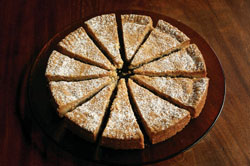 Mincemeat and Almond Shortbread
Mincemeat and Almond Shortbread There’s likely to be at least one spare jar of mincemeat in most kitchens at this time – plenty more if you make your own – and this versatile short-term preserve deserves better than to be thought of as a ‘single use’ ingredient for mince pies.
The popular Sunday Independent cookery columnist Brenda Costigan gives this unusual recipe in her new cookbook, From Brenda's Kitchen (Gill & Macmillan, paperback, €19.99), saying “A real treat, this recipe has become a seasonal must at Christmas in our house. It also makes a lovely gift.”
Click for recipe
Book Reviews - A Taste of Spice
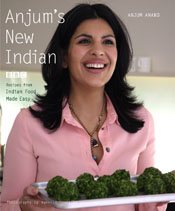
 We all look for change in January and that includes food – the weather may drive us to comfort food but we also crave lighter dishes and a change of tone that spicy foods from world cuisines can offer. There’s plenty of inspiration to be found in Anjum’s New Indian (Quadrille paperback, €19.50), which offers a welcome contrast to the rich festive fare of recent weeks.
We all look for change in January and that includes food – the weather may drive us to comfort food but we also crave lighter dishes and a change of tone that spicy foods from world cuisines can offer. There’s plenty of inspiration to be found in Anjum’s New Indian (Quadrille paperback, €19.50), which offers a welcome contrast to the rich festive fare of recent weeks. This Easy Mung Lentil Curry is a tasty vegetarian dish that should rest the system and is often served in the homes of Sindhis, in the northern region of Sindh (now part of Pakistan); Anjum says this “Simple but utterly delicious lentil curry… appeals to all”.
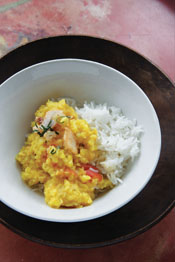
Serves 2-3
Click for recipe
Incidentally, it can be difficult to have all the right fresh herbs and spices in stock when you’re in the mood for ethnic dishes; a new range of ‘Fresh Blends’ herbs and spices, grown organically in Australia for the Gourmet Garden (www.gourmetgarden.com) range and sold in a handy 115-120g tube, could be the answer.
Although the carbon footprint for European users must be awesome, they’re not wasteful in use and ideal for busy cooks who don’t want to lose out on flavour - the tubes are stored in the fridge and keep their fresh taste for months, and can also be used straight from the freezer.

The new range reflects the world’s four most popular flavours - Indian, Thai, Moroccan and Mediterranean – and there are nine individual herb and spice blends available in the core range: Basil, Hot Chilli, Coriander, Chives, Garlic, Ginger, Italian Herbs, Lemon Grass, and Parsley.
Ching’s Chinese Food in Minutes (HarperCollins, hardback €25) offers a great selection of appealing, healthy and easy Chinese dishes that use everyday ingredients – and can all be on the table in under 30 minutes, making this a really useful everyday reference for those nights when you’re tempted to resort to the takeaway.

Some good vegetarian dishes are included among the wide range – and red meat lovers would be delighted to see this Garlic chilli pepper beef & mushroom pak choy, which takes only 10 minutes.
Click for recipe
Book Reviews - Prannie Rhatigan's Irish Seaweed Kitchen
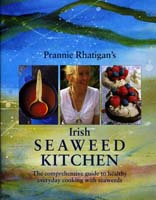
 A remarkable book by any standards, it comes as no surprise find that Prannie Rhatigan’s Irish Seaweed Kitchen (Booklink; full colour hardback 288pp, €35) was many years in the making – the wonder of it is that this wide ranging, searching and very beautiful work ever went to press at all, as its subject is clearly a work in progress for this gifted medical doctor, organic gardener and Slow Food cook.
A remarkable book by any standards, it comes as no surprise find that Prannie Rhatigan’s Irish Seaweed Kitchen (Booklink; full colour hardback 288pp, €35) was many years in the making – the wonder of it is that this wide ranging, searching and very beautiful work ever went to press at all, as its subject is clearly a work in progress for this gifted medical doctor, organic gardener and Slow Food cook.Growing up on the west coast of Ireland ‘where the rhythm of the tides and lore of the sea still provide a backdrop to everyday life’, Prannie learned about ‘the glistening crop on the foreshore’ and the harvesting pattern of different types of seaweed throughout the year and their uses in the kitchen and garden.
That experience provided the foundation for a lifelong interest in using seaweed as a food, and harnessing its nutritional and medicinal benefits in a way that brings together the traditional Irish uses for seaweed, going back through many generations, and the value laid on seaweed for nutrition and health by Asian cultures – notably Japan, China and Korea – which is now better understood in the west, as contemporary Japanese cuisine becomes mainstream.
The result is a fascinating tapestry of social history, anecdote, practical down-to-earth information (types of seaweed – 15 in this book, in red, brown and green groups; uses; harvesting; preparing; drying and storing), stunning imagery (contributed by at least two photographers and an illustrator) and a unique collection of over 150 recipes – elicited from friends, colleagues, family, and a whole raft of well known chefs and cooks, including luminaries such as Rick Stein and Darina Allen, alongside a core of recipes developed by Prannie and Johnny themselves.
The teamwork involved has been extraordinary- as a glance at the acknowledgments will show – and it’s a beautifully produced book, with great attention to detail throughout, right down to the bookmark with a ‘Quick Guide to Preparing Seaweed’
The timing is perfect for this highly original book, and – even in the unlikely event that you never wanted to cook a single recipe from it – it makes a fascinating read, as well as a wonderful reference for anyone interested in Ireland, food, health or simply life.
SAMPLE RECIPES:
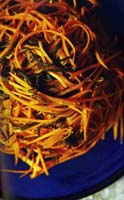 Recipe for Carrot and Sea Spaghetti Salad
Recipe for Carrot and Sea Spaghetti SaladIn this salad, contributed by artist and teacher, Diane Roemer, willowy sea spaghetti and delicate carrot strips combine with a sweet garlicky dressing to create a salad as delightful to look at as it is to eat. “Easy to prepare, it never fails to delight even first time seaweed tasters.”
Seaweed used: sea spaghetti
Click for recipe
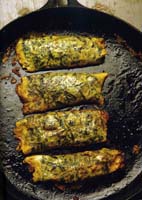 Recipe for Seaweed Crêpes with Prawns
Recipe for Seaweed Crêpes with PrawnsWith Shrove Tuesday and the annual pancake fest coming up in the middle of February, why not try this seafood crepe, created in Malaysia, or something quick, easy and different. Prannie comments: “When asked to contribute a recipe, enterprising seaweed fans Barry and Maggie O'Dowd went straight to the source and called up friends in Asia. Between them all they came up with this recipe. A case of too many cooks getting it just right!”
Seaweed used: Nori
Click for recipe
Book Reviews - The Yellow Door, Our Story, Our Recipes by Simon Dougan
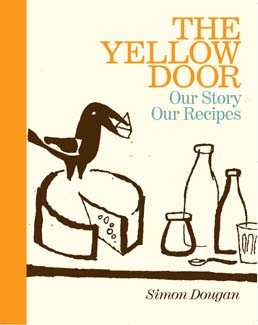
 The Yellow Door, Our Story, Our Recipes, by Simon Dougan
The Yellow Door, Our Story, Our Recipes, by Simon Dougan Blackstaff Press £20
Simon Dougan is one of the luminaries of Irish food, and undoubtedly one of the great influences for good in the development of Northern Ireland’s (and indeed the island’s) food culture.
Television has introduced him to the wider public in recent years, but it is his simple, uncompromising philosophy of food – shared with his equally respected wife, Jilly Dougan, of Moyallen Foods – that has earned him, and his Yellow Door businesses in Portadown and Belfast, huge loyalty from an appreciative clientèle.
This is Simon’s first book, and it is very interesting – much more than just a recipe book, it’s a true reflection of his philosophy and common sense, beginning as it means to go on with the ‘Using this Book’ page steering the reader firmly towards free range, organic if possible, local, seasonal products, also whole milk and unrefined sugar.
 If you like the kind of food that Simon likes - ‘good honest high quality food’, ‘not stuffy, not overly lavish, just gutsy flavoursome honest food’ – you’ll love this book.
If you like the kind of food that Simon likes - ‘good honest high quality food’, ‘not stuffy, not overly lavish, just gutsy flavoursome honest food’ – you’ll love this book. The range of recipes is wide and well-chosen, taking in a good selection of modern international classics (pea & mint risotto, sesame-seared Irish scallops with Thai dressing), the great breads that are so important at The Yellow Door, and a good core of traditional or traditionally-inspired dishes (Cashel Blue tart, Paul’s game terrine, roast chicken, shepherd’s pie with root vegetable mash).
There’s a great section on parties (who better than a chef and caterer to advise on cooking for large numbers?) but most interesting to me, by far, are the recipes celebrating local produce, notably the soused Lough Neagh pollen (a fish like a freshwater herring, plentiful in Lough Neagh), and Lough Neagh eels (see recipe below); the area is renowned for fruit too - I’d have loved more on Armagh apples, but you’ll also find a celebration of Armagh strawberries and (a nice surprise) several drinks recipes using sloes.
And best of all perhaps, from the practical angle, Simon shares his favourite suppliers, delis and speciality food shops with the reader - good for you, and good for them. Brilliant.
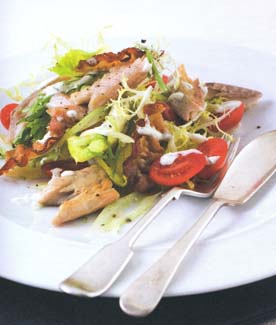 Smoked Eel and Pancetta Salad
Smoked Eel and Pancetta SaladEel fishing has been traditional to Lough Neagh for many generations and it continues, although on a smaller scale than formerly. Having been banned in the Republic, at least temporarily, it is now a controversial issue, making this rare product even more special (Joe Barry’s article in the Irish Independent/Rural Living, 2/3/10, may be of interest).
But alternatives can be used for this dish, in which the punchy dressing is a good foil for the smoked eel. In his introduction to this recipe, Simon Dougan concedes, “... obtaining eels may be a little problematic. If you can find it, smoked eel is well worth the trouble, or freshly smoked mackerel or herrings make a very good alternative.”
Click for recipe
Book Reviews - The Country Cooking of Ireland by Colman Andrews
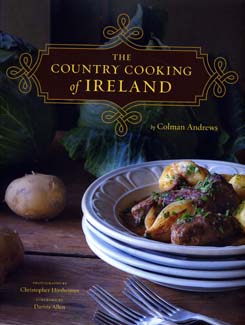
 The Country Cooking of Ireland by Colman Andrews, with photographs by Christopher Hirscheimer, Foreword by Darina Allen (Chronicle Books, hardback 384pp, US$50, €40).
The Country Cooking of Ireland by Colman Andrews, with photographs by Christopher Hirscheimer, Foreword by Darina Allen (Chronicle Books, hardback 384pp, US$50, €40).An impressive book by any standards, this beautifully produced coffee table tome weighs in at 2.3kg and – thanks to Christopher Hirscheimer’s stunning photography – presents an extremely appealing, mainly rural, view of Ireland and the simple excellence that is our food culture at its best.
Despite its size and weight, it’s an engaging as well as an informative read, successfully setting the renewed Irish respect for quality produce and simple cooking into a balanced historical perspective, with carefully selected recipes illustrating the point.
Colman Andrews, co-founder and former editor of Saveur magazine, is one of America’s best known and most highly respected food writers and – despite the home market promotion generated by the marketing association Good Food Ireland launches in Dublin and Cork - this comes across very much as a book written by an American for Americans with, for example, detailed references to ingredients and their availability or recommended substitutions.
It was four years in the making, and the time and care taken with research shows in many ways, with meticulous references to a wide range of sources (including, much to my surprise, some of my own books – although not Good Food From Ireland, which might have been the most useful) and a tightly packed Acknowledgments page citing the many people who shared their experience, knowledge, advice, anecdotes and recipes with him along the way.
It is good to see key personalities of Ireland’s food world showcased so effectively on the world stage – not only high profile communicators such as Myrtle and Darina Allen (Ballymaloe House), Peter Ward of Country Choice in Nenagh, and our most famous producers – the cheesemakers, smokers, butchers and growers who have built up the reserves of quality that have brought this small country to the attention of a food writer with international standing – but also less-sung heroes who have made vital contributions.
How good to be reminded of the pioneering work of Gerry Galvin at The Vintage in Kinsale in the 1970s, for example, and also his later work at Drimcong House in Co Galway and with Euro-Toques - which, strangely, does not seem to mentioned at all, although there’s no doubting the organisation’s continuing importance in bringing like-minded chefs together to support local producers and create the improving situation we enjoy today.
Similarly, although mentioned briefly, many would have expected John and Sally McKenna’s contribution to be acknowledged more prominently as their independent recognition of and support for artisan producers (which was ahead of the marketing association Good Food Ireland by many a country mile) has been a great encouragement to many small food businesses over the last 20 years.
 The selection of around 250 recipes for the book must have been quite a challenge and it’s interesting to see how the balance has been achieved, with old recipes woven in beside the snippets of folklore, literary quotations and history that set the food in context, and newer ones illustrating the way that today’s younger cooks and chefs interpret traditional themes – rather noticeable reliance on a clutch of TV chefs might surprise some readers, but this is understandable as American readers are likely to identify with them because they tend to be active representatives of the Irish food scene abroad, attending and cooking for events as well as having a presence in the media.
The selection of around 250 recipes for the book must have been quite a challenge and it’s interesting to see how the balance has been achieved, with old recipes woven in beside the snippets of folklore, literary quotations and history that set the food in context, and newer ones illustrating the way that today’s younger cooks and chefs interpret traditional themes – rather noticeable reliance on a clutch of TV chefs might surprise some readers, but this is understandable as American readers are likely to identify with them because they tend to be active representatives of the Irish food scene abroad, attending and cooking for events as well as having a presence in the media.Darina Allen’s Foreword is especially interesting because she has, of course, been the main pioneer in this area herself, with books such as the definitive 1996 Country Cooking: Traditional & Wholesome Recipes From Ireland, a massive undertaking with a Foreword by food historian Regina Sexton and now quite hard to source, and the more accessible Irish Traditional Cooking – over 300 recipes from Ireland’s Heritage.
But Darina rightly acknowledges the value of an outside view, saying “Colman, more clearly than most, can see the evolution and the revolution that has taken place in Irish food and transmits it here in a clear and charming way. Colman’s tasteful curatorial eye is observant and eclectic, almost magpie-like; he has chosen the best and most interesting sweetmeats to present.”
And she puts her finger on the particular interest of the book which is not really the recipes, excellent as they may be, but “…the delightfully interwoven snippets of country life he’s captured in his historical research, interviews with artisans, and vignettes of country house hotels… Colman, with his global perspective and vast knowledge of different food cultures, has looked in and seen how we are, and this book is an unprecedented celebration of what he’s observed.”
The Country Cooking of Ireland by Colman Andrews is available from bookshops, online from Good Food Ireland (€40 +€10 p&p within Ireland) and, of course, from Amazon – where a popular purchase, apparently, is the duo of The Country Cooking of Ireland and Darina Allen’s recently published Forgotten Skills of Cooking; the pair comes in at around €47 including postage, making it extremely good value.
SAMPLE RECIPE
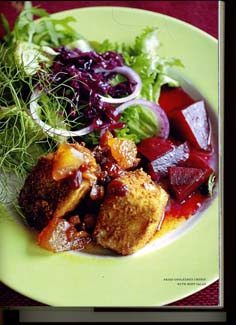 Fried Cooleeney Cheese with Beet Salad
Fried Cooleeney Cheese with Beet SaladThis is a popular dish at Brocka on the Water * in Ballinderry, County Tipperary. Cooleeney cheese, made by the Maher family in Moyne, near the Tipperary town of Thurles, is often available in the United States (see Sources, page 369). Camembert may be substituted.
Click for recipe
[*See also listing for Brocka on the Water in Georgina Campbell’s Ireland/Waterways Ireland 2010 “Taste of the Waterways” guide, which is just out.]
Book Reviews
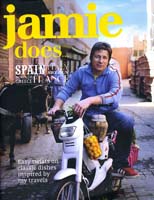 Something different by way of book reviews this month, as an unusual and interesting collection of books has come our way.
Something different by way of book reviews this month, as an unusual and interesting collection of books has come our way. Firstly, there is
 Jamie Does... (Penguin hardback, 360pp, £26) which is, of course, the book accompanying Jamie Oliver’s latest TV series – and is a sign of the times, as it’s based on six places that can be visited quickly and cheaply from the UK (volcanic ash allowing).
Jamie Does... (Penguin hardback, 360pp, £26) which is, of course, the book accompanying Jamie Oliver’s latest TV series – and is a sign of the times, as it’s based on six places that can be visited quickly and cheaply from the UK (volcanic ash allowing). This fits in perfectly with our nervy, cash-conscious mood – and encourages, subliminally at least, the idea that there are lots of interesting things you can do without taking the risk of being away from your job for too long, so there’s a better chance it will still be there when you get back.
Jamie Oliver’s sincerity is palpable and he has done a fantastic amount to change attitudes to food in apparently inaccessible places, such as the Department of Education - plus his casual, gutsy style of cooking not only has wide appeal but belies genuine skill.
It would be hard not to like him and, if he says he should take more of these trips because ‘all those new flavours, sights, sounds and smells were like a breath of fresh air to me and I came home excited and full of new recipes’’ he’s probably right - these are the sort of short breaks that can give any of us a real lift without costing too much, it's just a pity flying is so much hassle.
Then - back at home (hopefully), after enjoying the food of Marakech, Athens, Andalucia, Stockholm, Venice or France’s Midi Pyrenees - you can cook Jamie’s ‘fun, optimistic, escapist food’ based on each country’s star dishes.
I’ve been thinking lately that many of the most popular cookery writers are producing too many books (which can have an effect on the quality), but this one does have a place, and should cheer people up.
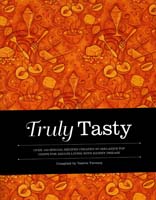 Truly Tasty (Atrium, hardback 332pp, €19.95/£17.95), is a beautiful and truly unique cookery book, in which well known Irish chefs have created recipes specifically for adults living with kidney disease – and all royalties go to the Irish Kidney Association.
Truly Tasty (Atrium, hardback 332pp, €19.95/£17.95), is a beautiful and truly unique cookery book, in which well known Irish chefs have created recipes specifically for adults living with kidney disease – and all royalties go to the Irish Kidney Association. Books for special diets can be dry and depressing affairs but this one - compiled by kidney transplant recipient, Valerie Twomey, as part of her ongoing campaign to promote organ donor awareness - is an extremely professional and handsomely produced book, edited by well known Irish Food Writers’ Guild member Lizzie Gore-Grimes and with beautiful food photography by Hugh McElveen, backed up by a dedicated team, including Cork journalist Brian Moore, who interviewed every single chef for the book.
Every adult living with kidney disease should treat themselves to a copy of Truly Tasty – and it would make a wonderful gift for a friend or relative living with the challenge of cooking with the limitations of the renal diet sheet.
Who wouldn’t be glad of a bit of inspiration and guidance from the likes of Ross Lewis (Chapter One), Catherine Fulvio (Ballyknocken House & Cookery School), Derry Clarke (l'Ecrivain), Domini Kemp (Itsa4), Neven Maguire (MacNean House & Restaurant) and Rachel Allen, to mention only a few of the famous chefs who have each contributed recipes for a three-course meal.
A four-page section of advice from the Irish Nutrition and Dietetic Institute outlines the aim of the renal diet, and how it works to prevent a build-up of waste products in the blood - also the importance of working within your particular diet sheet, as each person with Chronic Kidney Disease is unique; on the face of it the recipes look like normal recipes, but it must be remembered that the book was developed specifically for adults with kidney disease - and that they are advised to discuss the recipes with their dietitian before using them.
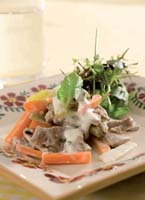 Warm Lamb Salad with Yoghurt and Fresh Mint Dressing
Warm Lamb Salad with Yoghurt and Fresh Mint DressingThis recipe was contributed by Euro-Toques consultant chef Eugene McSweeney (www.dialachef.ie), former proprietor-chef of the renowned (and much missed) Lacken House in Kilkenny.
Click for recipe
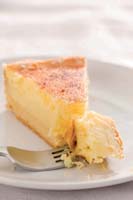 Lemon Tart
Lemon Tart The chef behind the familiar stylishly simple food at Avoca Handweavers, Leylie Hayes, contributed this gorgeous lemon tart - proof that being on a restrictive diet needn’t always mean no treats.
Click for recipe
 By contrast, two fascinating books with indirect food associations came my way recently. Just as all politics is local, so is all history – and there has never been more interest in local history than there is today.
By contrast, two fascinating books with indirect food associations came my way recently. Just as all politics is local, so is all history – and there has never been more interest in local history than there is today. Bygone Limerick by Hugh Oram (Mercier Press paperback,126pp, €14.99) will be of interest to anyone who has the slightest connection with Limerick City or County – or even people with no connection whatsoever, who simply enjoying marvelling at the way things used to be, and finding connections and unexpected titbits of information.
All sorts of companies, names and products that we take for granted have their roots in Limerick – of food interest, for example, we learn that Shannon Meats started production in Rathkeale in 1953 and was the cause of much jubilation in those austere days; Limerick city’s Potato Market, which opened in 1843, had fallen out of use until the Limerick Civic Trust decided to restore it in the mid-eighties; the then Taoiseach Charles Haughey re-opened it officially in 1987 and the first Saturday market was held there that October.
There is something for everyone here, including subjects of national interest - such as the history of the transatlantic flying boats at Foynes, and all the glamour attached (and still a fascinating place to visit by the way) and, of course as Hugh pointed out, that's where chef Joe Sheridan invented the Irish Coffee one winters night in 1943.
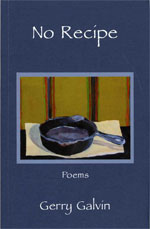 Whatever your interests there’s bound to be something to catch your eye in a good local history – and, as it happens Gerry Galvin, the author of No Recipe (paperback, 64pp Doire Press, www.doirepress.com, €12) comes from County Limerick and will no doubt especially enjoy browsing the Kilmallock pages...
Whatever your interests there’s bound to be something to catch your eye in a good local history – and, as it happens Gerry Galvin, the author of No Recipe (paperback, 64pp Doire Press, www.doirepress.com, €12) comes from County Limerick and will no doubt especially enjoy browsing the Kilmallock pages...Gerry is, of course, one of Ireland’s best-known and most-respected senior chefs, a founding commissioner of Euro-Toques Ireland, fondly remembered for his days at The Vintage in Kinsale in its ‘culinary capital’ heyday, and then later at the lovely Drimcong House at Moycullen, Co Galway, both of which he ran together with his wife, Marie.
A cultured chef, with literary and artistic gifts as well as prodigious skill in the kitchen, Gerry’s approach to food has always seemed intellectual, questioning of the whys and wherefores; his distinctive style produced many original dishes, some of which found their way into his beautifully written cookbooks, The Drimcong Food Affair (McDonald Publishing, 1992) and Everyday Gourmet (O’Brien Press, 1997).
All of which brings us to No Recipe, a book of poems that is light enough to sit quietly in an inside pocket or handbag, ready for those moments – on the bus or train home from work, perhaps, or sitting on a rock beside the sea – when thoughtful companionship is most welcome.
The title (which is also the title of one of the poems) is telling, also the cover painting of an empty pan on a piece of paper – no, not a cookbook, yet when food has been one of his lifelong loves how could it be entirely absent from this new departure?
We travel with a keenly observant man, and one of many moods; we glimpse his loves - of family, of nature and of the changing seasons, for example – share reflections on experiences in a year spent travelling in a camper van, feel his personal longings and losses, and the relentless passage of time. And there is humour and playfulness too, as in this poem – a good companion indeed.
Special Offer (For Jennie)
When you were two and three and four,
we commandeered a trolley by the door;
you, my special offer, I propelled
between the lines of cereals, spices, jams,
two-for-one the relish and the ham.
Along the aisles of cans and creams
we cut a dash, careered past cabbages
and plums; we slowed—a bit—
before the frosty stares of those
who thought the place belonged to them.
That stuffy manager stopped us in our tracks.
"This is not a playground, sir!'
You stunned him with your outrage,
oh yes you did, you snapped,
'Bad man, must not be nasty to my dad!'
How we made our trolley dance
to the playfulness of this romance,
stocking up for one day hence
on the way to independence.
Book Reviews

 The Eye of the Ventriloquist by Paul Chatenoud. (Published by Les Cygnes, Paris, price €20; translated from French by Allaye O'Connor).
The Eye of the Ventriloquist by Paul Chatenoud. (Published by Les Cygnes, Paris, price €20; translated from French by Allaye O'Connor).Memoirs by people who've spent a lifetime working in the hospitality industry are rare enough; and, when they do happen, they're often self-serving which is a great pity, because this is one of the best possible sources of brilliant stories.
Paul Chatenoud is a Frenchman who runs a B&B, near Ardara in west Donegal. Paul has little time for what he calls the ayatollahs who keep us on the straight and narrow, whether it's stopping us smoking too much or drinking to excess.
He's the very antithesis of another kind of Frenchman, the bureaucrat who invented VAT. Paul is an absolute and unyielding Contrarian, which is what makes this book such fun to read and, at times, astonishing. His thoughts range far and wide, from the shallows to the deeps.
Born of French parents and brought up in Morocco, his contrarian views were evident from early on. When he was doing his French military service as a young man, it was the height of the Algerian war of independence.
 Paul became enamoured with the beauty of the then underground Algerian national anthem, and promptly set about teaching it to the young French soldiers under his command. That defiant view of life has remained with him ever since.
Paul became enamoured with the beauty of the then underground Algerian national anthem, and promptly set about teaching it to the young French soldiers under his command. That defiant view of life has remained with him ever since.Bankers, property developers and the government must be thankful that they've escaped Paul's attention in this book. Most people move on from such contrary views when they leave education and start work. Not Paul, he's been a genuine cultured bohemian all his life, which is what makes his book such fun, a great read.
He starts off by quoting de Valera, who said: "The Irish genius has always placed spiritual and intellectual values above material ones". Paul comments: "Alas, this is no longer true today. The American sirens are quashing the Irish spirit, as they continue to do everywhere else in the world".
From here, it's upwards and onwards all the way through the book. He also quotes Napoleon, who once mused that if he had gone to Ireland instead of Egypt in 1798, England and indeed the world would have been very different.
The book, which was originally published in French and has just come out in English, tells how Paul started what was the first bookshop in Paris to concentrate on books about music.
He's been in Ireland for the past 25 years, and out of financial necessity, turned his cottage in Donegal into a B&B (unregistered, naturellement). He delights in the many strange liaisons of the people who've come to stay there over the years. He mentions one couple who, when asked whether they were married, replied, "Yes, but not to each other".
Another guest is the jinxed type whom every host will recognise: within a few hours of arriving, this lady guest had managed to blow up the water heater; then the heater; and, finally, the bedside lamp...
One 80 year old couple provide a revelation. They are staying with Paul and celebrating the longevity of their marriage with champagne. Paul asks the man his secret and he says: "I did everything I wanted to do". Then the man's wife turns to Paul and whispers: "He did exactly everything I wanted".
He also mentions the wonderful traditional pubs in his locality and the way in which many local drinkers relish their pints, interspersed with shots of whiskey. Paul himself had to reform his ways and hasn't been a drinker for years, as the need for sobriety became essential for his future existence, but that hasn't stopped one of his other great loves, making love to the opposite sex.
He relates adventures with women, many of whom, in the best Gallic tradition, just happened to have been married to other people at the time. The husband of one of his companions once chased him across Paris, threatening to slay him.
He has many deep thoughts about the state of the world and condemns all the modern day "thought police" who try to control what people do, like stopping them smoking. His perverse wish not to have his smoking habits interfered with is a strong element in the book and he relates how one restaurant owner in Dublin told him, before the ban on smoking came in, that the non-smoking tables in the place would fill up by 6.30pm, while the smoking tables weren’t occupied until 9pm.
Clearly, in Paul's view, smokers have a more bohemian view of life, willing to risk it well into the night. "Puritans and self-righteous people have never been associated with creativity", he asserts.
He has many outrageous comments about life in his adopted country, but here's plenty of serious stuff, too. He points out that people in Ireland have one of the highest rates of cancer in Europe and says that this could be partially attributed to people internalising their emotions.
He says that in his locality, whenever there is even a hint of trouble or a problem, people say to him, "Paul say nothing".
Paul has some very strange stories in the book, too, like the one about his 40 year old friend, who died on the very day that his son was born. Exactly the same thing had happened to the man's father when he was born and before that, to his grandfather.
It's an engaging book, that tells much about Paul Chatenoud – who is renowned for his marketing genius. His most recent conquest was Marie Claire magazine in Italy and the current issue has 16 pages on Paul and his B&B. Perhaps he should be advising the Kerry hoteliers, whose current promotional ambition is to get Queen Elizabeth II to visit Killarney - a bit vieux chapeau, Paul would say.
It's a sign of how he is appreciated in France that Le Canard Enchainé (the French equivalent of The Phoenix) is among the many publications giving him approval. His unorthodox approach is great for publicity and even the BBC has fallen for his offbeat charms.
Paul, the eternal spiritual and cultural wanderer, seems to have a certain fascination for buttocks (female, of course), evident throughout the tome. At the conclusion of his book, he talks to a guest who is curious about the sculpture of a buttock, made by a local Donegal artist from bog oak that had been submerged in water for 5,000 years. Paul asks, "How will your buttock be in 5,000 years time?"
That's what you might call a good question, and he asks plenty throughout this provocative work.
Website
----
Reviewed by Hugh Oram
Book Reviews
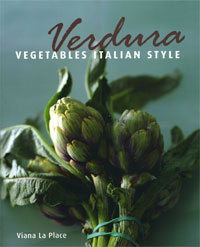 Spices, Salt and Aromatics in the English Kitchen, by Elizabeth David
Spices, Salt and Aromatics in the English Kitchen, by Elizabeth David (Grubb Street; hardback, 280pp; stg £12.99).
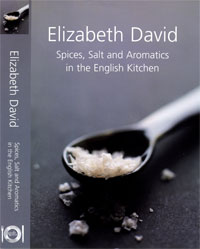 It is always a pleasure to see classic cookbooks coming out again in shiny new covers and specialist publishers Grubb Street have some treats lined up for us in the coming months - Elizabeth David fans, in particular, will enjoy seeing some of her titles again, along with some other favourite kitchen classics.
It is always a pleasure to see classic cookbooks coming out again in shiny new covers and specialist publishers Grubb Street have some treats lined up for us in the coming months - Elizabeth David fans, in particular, will enjoy seeing some of her titles again, along with some other favourite kitchen classics. Elizabeth David’s books have never been difficult to obtain, but there is something very satisfying about seeing one fresh from the printer – a smallish, squat little hardback, and not so much a drawing in sight, never mind the statement photography that is de rigeur today. A reminder, if ever there was one, that cookbooks were until recently meant for reading (and digesting), rather than looking at.
Although Elizabeth David was very much a post-war writer, her popularity has never waned and her books have as much relevance as ever today - maybe more so for the practical cook, as so many of the ingredients for her recipes were unavailable to most people at the time when they were written.
A reminder, perhaps, that the best cookbooks are all to do with ideas, memories, and hope for the future – and, while Elizabeth David is mainly associated with ‘the continent’ (which typically meant down to earth, deeply flavoursome French food and the warmth and colour of Mediterranean cooking), she wrote to be read as much as to inspire people to cook from the recipes she collected – she was also interested in the British table.
Spices, Salt and Aromatics in the English Kitchen is a late work and, through its enlightening text and wide ranging recipes, it tells a story of what Elizabeth David described as 'the English love affair with Eastern food and Arabian Nights ingredients.'
It is an interesting contradiction that a people who have a reputation for ‘plain food’ should have taken such extreme measures down through the centuries to acquire spices – so, in this book (which was to have been the first volume in a series of works on English Cooking Ancient and Modern), she examines the English preoccupation with the spices, the fruit, the flavourings, sauces and condiments of the orient near and far.
The origins and uses of ingredients such as nutmeg, cardamom and juniper are explained, also the influence of centuries of oriental trade on the English kitchen, where spices and Indian curries, kebabs and yoghurt are now perfectly at home, along with dishes such as risotto and paella.
And, of course, you will find recipes for briskets and spiced beef, smoked fish, cured pork and sweet fruit pickles – all recipes that we now think of as ‘typically English’.
Verdura, Vegetables Italian Style by Viana La Place
Grubb Street; paperback; 320pp; stg£12.99. Publication 29th July 2010
 What a lovely time of year to be reminded of this classic book celebrating the joys of seasonal vegetables – if you’re not already familiar with Viana La Place's Verdura, which was first published in America in 1991, just think ‘River Café style’: Rose Gray says on the back cover ‘Verdura is one of the cookbooks we refer to almost every day…a must-have book for all of us who love Italian food.’
What a lovely time of year to be reminded of this classic book celebrating the joys of seasonal vegetables – if you’re not already familiar with Viana La Place's Verdura, which was first published in America in 1991, just think ‘River Café style’: Rose Gray says on the back cover ‘Verdura is one of the cookbooks we refer to almost every day…a must-have book for all of us who love Italian food.’ Another simply presented book – its bigger format and two-colour design are more contemporary than the Elizabeth David books, but a long way from the colour-heavy books that weigh down the shelves today – Verdura celebrates fresh ingredients simply treated, and is very much in tune with the way the farmers’ market and allotment-holding generation is thinking today.
The book begins with a vegetable and herb guide and an ingredient glossary, also a range of menu suggestions, for different seasons and occasions.
Through its 300 or so detailed recipes La Place eases the reader (particularly the American reader) into the earthy Italian way of thinking about food, often using familiar vegetables such as artichokes, aubergines and radicchio but also introducing some that may be new to us, like chayote, cardoons, and brocciflower (this cauliflower-broccoli hybrid she sautés in garlic and oil, then tops it with pungent provolone).
The range of recipes is wide - antipastos, salads, soups, sandwiches, pasta, risottos, pizzas, and much more (including a great chapter on bread dishes and sandwiches) - and desserts are also included: anyone for Grilled Figs with Honey and Walnuts?
Summer Minestrone with Rice
Minestrone Estivo di Riso
Minestrone is so strongly associated with winter that it may come as a surprise that it is also eaten during the summer months. In warm weather, it is served at room temperature with a generous amount of fresh basil stirred into it. A special feature of this recipe is the big spoonful of sweet, rich sun-dried tomato paste that is added as the soup cooks. This soup thickens as it cools, becoming quite dense and not a bit brothy. Get a big spoon and dig in.
Click for recipe
Book Reviews - The Accidental Chef
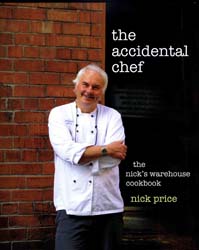
 The Accidental Chef - The Nick's Warehouse Cookbook, by Nick Price (Booklink, hardback, 144pp, colour photography throughout; £20)
The Accidental Chef - The Nick's Warehouse Cookbook, by Nick Price (Booklink, hardback, 144pp, colour photography throughout; £20)Brave (not the word he would use), talented and inspirational, Nick Price is a larger than life character in the Northern Ireland food world, and has played a key role in many of the good things that have developed there in recent years.
Although it wasn’t their first venture in the world of hospitality, Nick and his wife Kathy (a constant presence in this book, as in life) are best known for their Hill Street restaurant in Belfast, Nick's Warehouse, which they created out of dereliction in the 1980s in what has now become the trendy ‘Cathedral Quarter’.
On the front flap of this delightful book Nick Price is described by one of his many admirers as ‘the greatest cook in the history of Northen Ireland’ – not, as he characteristically point out, a view to which he subscribes.
For, understandable as the enthusiasm is, that is to miss the point about a man who would certainly have no wish to be held up in comparison beside culinary talents such as the extraordinarily gifted Michael Deane, for example (and yes, Deane is a real cook and not just a ‘chef’s chef’, as is Paul Rankin) not to mention historical greats like Florence Irwin, and whose own exhortation to readers to ‘enjoy the story, pour yourself a glass of wine, cook the dishes and enjoy!’ is far more telling.
His talent in the kitchen isn’t in question but, as this informal and gloriously readable book illustrates in its celebration of forty years in what Nick simply refers to as ‘the catering business’, the real achievements of this modest – at times almost self-deprecating - chef are as a people person: someone who relishes the fun and conviviality of food and inspires others to respect it, work hard to get the best from it, and to enjoy it.
Most of those who buy the book at the restaurant (the main source at the moment) will know all this already, but if meeting him for the first time, the person you will find in the book is surrounded by family, staff, and friends, who all come to life through gentle asides and anecdotes told with a discernible chuckle.
The food is far from incidental but it’s introduced with a lightness of touch which is rare in someone who is known for passionately held views when it comes to the provenance of food.
Most of Nick’s working lifetime has been spent furthering the cause of artisan food production, and he is now chairman of Taste of Ulster and leader of the North East Ireland convivium of Slow Food – and, unusually for a restaurateur, he is even moving into food production himself, with the development of a new cheese.
As to the recipes, ‘eclectic, magpie and even primal’ are descriptions that have been attached to his cookery. You might add unpretentious, down to earth and do-able, all compliments that rarely apply to chefs’ recipes.
There’s a core of lovely retro dishes - which are thankfully back in favour after all the nonsense of tall food, foams, drizzles and smoke which have preoccupied chefs of late – family recipes, ideas picked up on holiday, great side dishes and a particularly good chapter on sauces, dressings and relishes.
For the time being the book is only available at the restaurant - but that’s as good an excuse as any to make a visit to this hospitable place.
The following recipe is typical, and ideal for cooking now as the ingredients are in season and at their best here in Ireland.
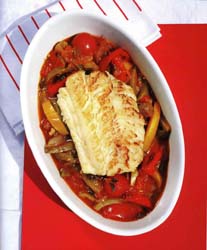 Hake baked in a peperonata sauce
Hake baked in a peperonata sauceAka 'spetse fish' after a small island in the Saronic Gulf, Greece, where Kathy and I had our honeymoon 7 months late, but we were skint and had to save up after the event! We had a great couple of weeks. Kathy learned the finer points of ouzo drinking and I learned to love octopus and spetse fish.
When we got back home I tried many times to replicate the dish, as experienced on Spetse, and eventually succeeded.
Click for recipe
Book Reviews - Catherine's Italian Kitchen
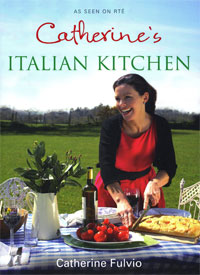
 Catherine's Italian Kitchen by Catherine Fulvio (Gill & Macmillan paperback 254pp, €19.19)
Catherine's Italian Kitchen by Catherine Fulvio (Gill & Macmillan paperback 254pp, €19.19)Having full time experience running her lovely Co Wicklow farm B&B, Ballyknocken House, and the cookery school she has set up there, the delightful Catherine Fulvio is a practical cook as well as an inspiring one, so this is definitely won’t be one of those books that languishes on the bookshelf and rarely gets used.
Catherine grew up with all the farm activities going on around her and fresh produce coming into her mother’s kitchen, giving her an innate sense of the value of fresh local ingredients so using them at their best and in season comes naturally to her – as it does to Italians also.
Through her Sicilian husband, Claudio, Catherine became immersed in Italian food and it was an obvious topic for her first RTE TV series, Catherine's Italian Kitchen - which was so popular that she had to go back for more, and it’s to be followed this autumn by Catherine's Roman Holiday.
Down to earth as ever, Catherine has chosen the popular dishes that Irish people enjoy for this attractive book, which gives very do-able but authentic versions of lots of old favourites and straightforward lessons in, for example, pasta and pizza.
But you’ll also find the traditional Italian drinks and snacks that set the scene for an Italian night in - and some equally straightforward special occasion dishes, such as this lovely seasonal tart.
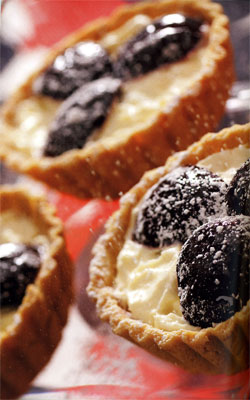 Plum and Mascarpone Tart
Plum and Mascarpone TartCrostata di prugne e mascarpone
Makes 1 large tart or 6 individual tartlets, serves 6-8
“Once the pastry is made, this is actually a particularly easy recipe. I also make this same tart with fresh strawberries or raspberries and it looks and tastes beautiful for a summer party.”
Click for recipe
Book Reviews - Ireland for Food Lovers
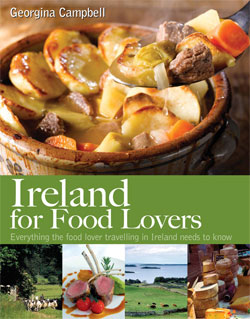
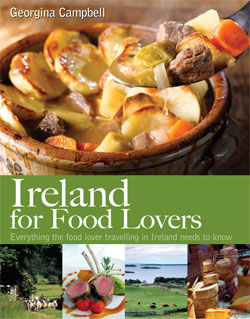 "What a lovely, lovely book! There should be a copy on show in every Irish embassy in the world...so comprehensive & so beautifully produced" Myrtle Allen
"What a lovely, lovely book! There should be a copy on show in every Irish embassy in the world...so comprehensive & so beautifully produced" Myrtle AllenNot so much a book review this month, more an introduction to our own latest book - after that we’ll be back to normal in December, with all the Christmas books.
Speciality local products were pretty thin on the ground when we started travelling regularly on research trips in the 1980s, but every year there have been ever more wonderful local foods to enjoy.
They’ve become an increasingly important presence on menus, and also to buy from speciality shops, markets and farm shops, to take home as a treat for another time. Many are now widely distributed, but there’s something very special about enjoying them on their own home patch.
 These foods and their creators are the characters that have peopled and enhanced our travels, and could do the same for any visitor - especially if there is time to do a little homework before setting off.
These foods and their creators are the characters that have peopled and enhanced our travels, and could do the same for any visitor - especially if there is time to do a little homework before setting off.Would you like to know where to find rare breed pork, who makes the best preserves, or where your seasonal local fruit and vegetables are sure to be on the menu? Are you planning a self catering holiday and need to find the best local food shops and markets for your stay?
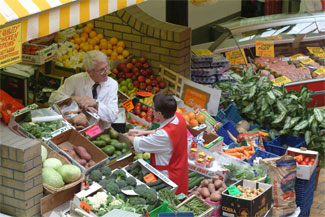 Perhaps you’d like to visit a food festival or you’re keen to learn a few new tricks in a cookery school? Or maybe you’d just like to get a treat for yourself or send an Irish food gift by mail order? If any of this rings bells with you, then Ireland for Food Lovers (large format paperback, full colour, 336pp, €20) could be the book for you...
Perhaps you’d like to visit a food festival or you’re keen to learn a few new tricks in a cookery school? Or maybe you’d just like to get a treat for yourself or send an Irish food gift by mail order? If any of this rings bells with you, then Ireland for Food Lovers (large format paperback, full colour, 336pp, €20) could be the book for you...Using Ireland for Food Lovers, anyone can “Shop like a local, eat like a local – find and enjoy the best regional foods in every part of Ireland”. Designed to be equally useful to visitors and Irish residents, it’s arranged by region to assist with planning holidays and short breaks and brings together all the information that food lovers currently have to glean from multiple sources.
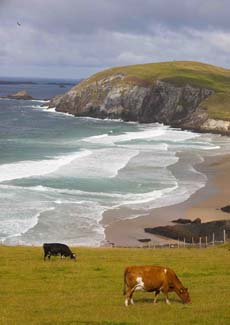 This is a practical book that combines the best of Irish food and travel and it’s the first book to offer a complete region by region user guide to finding and buying the best Irish foods – and how to enjoy them at their best, both when eating out and at home.
This is a practical book that combines the best of Irish food and travel and it’s the first book to offer a complete region by region user guide to finding and buying the best Irish foods – and how to enjoy them at their best, both when eating out and at home. Ireland for Food Lovers introduces the food producers of each area, both artisan and the best larger-scale ones, and home cooks will find recipes using the foods of each region in mainly traditional dishes. And there are also details of cookery schools offering courses based on Irish food traditions and local produce, which often include visits to artisan producers.
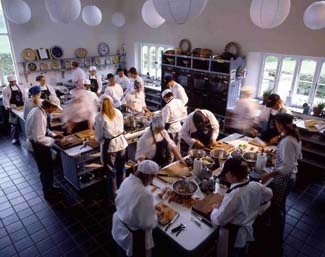 Featuring food shops, farmers markets and food festivals all around the country, it’s ideal for self-catering holidays, leading visitors straight to the best local shopping options. You’ll also find carefully selected places to eat out and stay, where the best of local Irish produce is showcased.
Featuring food shops, farmers markets and food festivals all around the country, it’s ideal for self-catering holidays, leading visitors straight to the best local shopping options. You’ll also find carefully selected places to eat out and stay, where the best of local Irish produce is showcased.Ireland for Food Lovers is the culmination of knowledge gained over many enjoyable years of travelling around every county in Ireland. As well as providing information on the best foods, producers, suppliers and hospitality throughout the country, it constantly directs the reader to further sources of information, including public bodies, other respected guides, marketing associations and professional associations.
Practical features include information on the shops and websites that can supply Irish produce by mail order and, although packed with useful information, it’s set in context with scenic photography and a general introduction to each region.
The author claims no credit for this celebration of Ireland’s developing food culture – the stars are the people and foods featured in the book, and the spotlight is emphatically on them.
Book Reviews
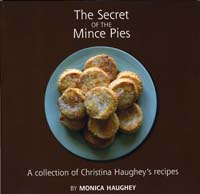 A round-up of interesting foodie titles to consider for the Christmas bookshelf...
A round-up of interesting foodie titles to consider for the Christmas bookshelf...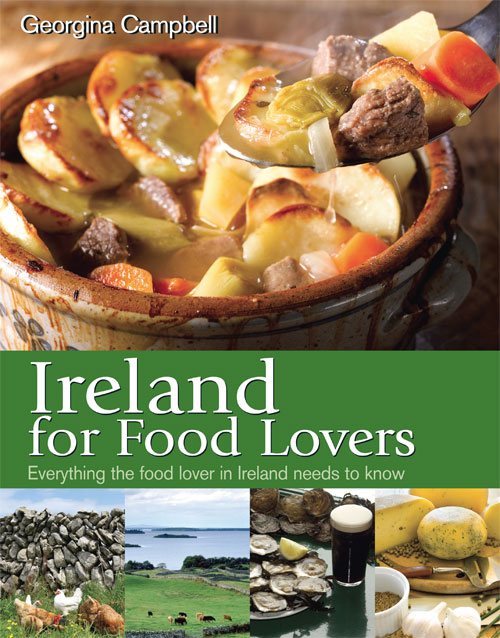 There are always plenty of Irish interest food books to choose from coming up to Christmas, and this year is no exception – beginning, of course, with our own latest book, Ireland for Food Lovers (€20).
There are always plenty of Irish interest food books to choose from coming up to Christmas, and this year is no exception – beginning, of course, with our own latest book, Ireland for Food Lovers (€20). This fully illustrated guide-cum-cookbook highlights the best of Irish foods, the landscapes and seascapes that make them unique - and the people who produce and supply them, serve them to their guests or teach us how to cook them. It’s available directly from us online (ireland-guide.com) with free p&p to addresses in Ireland, and from bookshops. The perfect foodie gift! Click here to buy
A seasonal recipe to try now: Muckross Venison Casserole
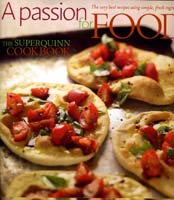 Another well illustrated book that is jam-packed with hints and suggestions is The Superquinn Cookbook - A Passion for Food (hardback €25, from Superquinn stores). Written by Irish Food Writers’ Guild Chairperson, Orla Broderick, this appealing and informative book marks 50 years of fresh food retailing for Superquinn and, as is right and proper, the chapters reflect the key fresh food areas of the store – plus a whole lot of extra information on, for example, store cupboard essentials and wines, and of course the history of the store, plus a foreword and recipe from Superquinn founder Feargal Quinn. Recipes from Superquinn colleagues and customers are also included – and some from well known chefs including Ross Lewis, Neven Maguire and Donal Skehan – and a novel feature is that each recipe comes complete with its own downloadable shopping list.
Another well illustrated book that is jam-packed with hints and suggestions is The Superquinn Cookbook - A Passion for Food (hardback €25, from Superquinn stores). Written by Irish Food Writers’ Guild Chairperson, Orla Broderick, this appealing and informative book marks 50 years of fresh food retailing for Superquinn and, as is right and proper, the chapters reflect the key fresh food areas of the store – plus a whole lot of extra information on, for example, store cupboard essentials and wines, and of course the history of the store, plus a foreword and recipe from Superquinn founder Feargal Quinn. Recipes from Superquinn colleagues and customers are also included – and some from well known chefs including Ross Lewis, Neven Maguire and Donal Skehan – and a novel feature is that each recipe comes complete with its own downloadable shopping list.A seasonal recipe to try now: Smoked Salmon Carpaccio with Horseradish Cream
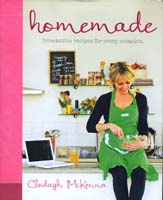 Those who like the homeliness of busy books will enjoy TV chef Clodagh McKenna’s Homemade (Kyle Cathie hardback, £18.99), which is choc-a-bloc with detail, and with quirkiness a-plenty provided by pages of different colours and background patterns, several fonts to each page and little ‘reminder notes’, cut-outs, ‘paper clips’ all creating a sense of organised chaos rather like a family kitchen notice board…lots of ideas and advice on presentation and scene-setting – and, of course, recipes a-plenty.
Those who like the homeliness of busy books will enjoy TV chef Clodagh McKenna’s Homemade (Kyle Cathie hardback, £18.99), which is choc-a-bloc with detail, and with quirkiness a-plenty provided by pages of different colours and background patterns, several fonts to each page and little ‘reminder notes’, cut-outs, ‘paper clips’ all creating a sense of organised chaos rather like a family kitchen notice board…lots of ideas and advice on presentation and scene-setting – and, of course, recipes a-plenty. A seasonal recipe to try now: My Farmers’ Market Paté (Clodagh’s best seller at her Canal Café at the Village at Lyons, Celbridge, Co Kildare)
 Quite different is a very personal little book by Monica Haughey, The Secret of the Mince Pies (paperback; €10 from www.secretofthemincepies.com and from Dublin Food Co-op, Newmarket Square). Monica’s late mother, Christina Haughey, was a renowned Tyrone cook and known especially for her baking, and this book is not only a collection of favourite recipes but also a touching memoir of her family life and the area she grew up in. Monica’s mother was especially well known for her mince pies and, up to the age of 80, would bake 22 dozen of them and send them to family and friends here and abroad. And the secret of her mince pies? This - and the deliciousness of everything else she cooked - is indeed revealed in Monica’s delightful little book.
Quite different is a very personal little book by Monica Haughey, The Secret of the Mince Pies (paperback; €10 from www.secretofthemincepies.com and from Dublin Food Co-op, Newmarket Square). Monica’s late mother, Christina Haughey, was a renowned Tyrone cook and known especially for her baking, and this book is not only a collection of favourite recipes but also a touching memoir of her family life and the area she grew up in. Monica’s mother was especially well known for her mince pies and, up to the age of 80, would bake 22 dozen of them and send them to family and friends here and abroad. And the secret of her mince pies? This - and the deliciousness of everything else she cooked - is indeed revealed in Monica’s delightful little book.A seasonal recipe to try now: Mince Pies!
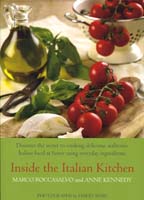 And then there are the Irish/Italian books. As Italian food is extremely popular in Ireland it is perhaps surprising that there has been, until recently, a dearth of Italian cookbooks written for the Irish market. Then, last year, along came Catherine Fulvio’s TV series and the accompanying Catherine’s Italian Kitchen (Gill & Macmillan, paperback) – and this autumn has seen the arrival of not only the popular food columnist Paolo Tullio’s book, Paolo Tullio Cooks Italian (bookstores nationwide, €20) but also Inside The Italian Kitchen by Marco Roccasalvo and Anne Kennedy (€20 from greatfood.ie, Camp de’ Fiori, Donnybrook Fair stores and other and selected outlets). Unusually, this is published by a foodie website - and co-authored by its founder, in association with the well known chef-restaurateur Marco Roccasalvo; together with photographer Harry Weir (who also contributed the photographs for The Superquinn Cookbook) they have created a book that is jam-packed with fascinating practical information on the ingredients that are essential to success, a great range of recipes and evocative images that give a true flavour of Italy.
And then there are the Irish/Italian books. As Italian food is extremely popular in Ireland it is perhaps surprising that there has been, until recently, a dearth of Italian cookbooks written for the Irish market. Then, last year, along came Catherine Fulvio’s TV series and the accompanying Catherine’s Italian Kitchen (Gill & Macmillan, paperback) – and this autumn has seen the arrival of not only the popular food columnist Paolo Tullio’s book, Paolo Tullio Cooks Italian (bookstores nationwide, €20) but also Inside The Italian Kitchen by Marco Roccasalvo and Anne Kennedy (€20 from greatfood.ie, Camp de’ Fiori, Donnybrook Fair stores and other and selected outlets). Unusually, this is published by a foodie website - and co-authored by its founder, in association with the well known chef-restaurateur Marco Roccasalvo; together with photographer Harry Weir (who also contributed the photographs for The Superquinn Cookbook) they have created a book that is jam-packed with fascinating practical information on the ingredients that are essential to success, a great range of recipes and evocative images that give a true flavour of Italy..jpg) Domini Kemp’s simple, gutsy food is equally well known through the bagel shops, cafés and restaurants that she runs with her sister, Peaches, and her weekly recipe column in The Irish Times. If you want colourful, tasty and down to earth dishes guaranteed to please family and friends and that won’t take too long to put on the table, you won’t do better than follow the advice of this busy woman – so Domini’s Itsa Cookbook (Gill & Macmillan, €19.99/£17.99) is a surefire winner.
Domini Kemp’s simple, gutsy food is equally well known through the bagel shops, cafés and restaurants that she runs with her sister, Peaches, and her weekly recipe column in The Irish Times. If you want colourful, tasty and down to earth dishes guaranteed to please family and friends and that won’t take too long to put on the table, you won’t do better than follow the advice of this busy woman – so Domini’s Itsa Cookbook (Gill & Macmillan, €19.99/£17.99) is a surefire winner.A seasonal recipe to try now: Poached Haddock and Egg with Parsnip Purée
When looking for a gift for anyone who enjoys a good read as much as do-able recipes or fabulous photography, I’d recommend considering any of the Grub Street titles (www.grubstreet.co.uk) as, unusually, this publisher specialises in evocative food writing that fires the imagination, with minimal illustrations (if any). This takes us back to an older tradition that is both stimulating and soothing.
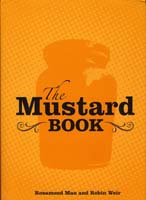 Grub Street publish some quirky books which are often of historical interest too. Rosamund Man and Robin Weir’s The Mustard Book (£16.99), for example, is a fascinating and authoritative book on an everyday ingredient which has been cultivated for over six thousand years, covering all aspects – including cultivation, and its medical uses, plus a wide range of recipes and a section on making mustard at home.
Grub Street publish some quirky books which are often of historical interest too. Rosamund Man and Robin Weir’s The Mustard Book (£16.99), for example, is a fascinating and authoritative book on an everyday ingredient which has been cultivated for over six thousand years, covering all aspects – including cultivation, and its medical uses, plus a wide range of recipes and a section on making mustard at home. A seasonal recipe to try now: Honey and Mustard Roast Turkey Breasts
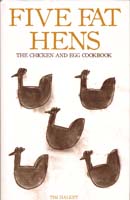 Talking quirky, who could resist a book that begins “I was born at home, just in time for lunch – the doctor lured me out with a Cold Roast Chicken Sandwich. Dad had just popped down to make up a few rounds – one for the doctor, another for the midwife and one for himself. Mum was busy….” A love of good food inspired author Tim Halket to build a hen house and Five Fat Hens (£18.99), subtitled The Chicken and Egg Cookbook, is one of the enjoyable results. Five Fat Hens is a diary of his year as a house-husband and cook, offering not only recipes but plenty of observations and opinions along the way.
Talking quirky, who could resist a book that begins “I was born at home, just in time for lunch – the doctor lured me out with a Cold Roast Chicken Sandwich. Dad had just popped down to make up a few rounds – one for the doctor, another for the midwife and one for himself. Mum was busy….” A love of good food inspired author Tim Halket to build a hen house and Five Fat Hens (£18.99), subtitled The Chicken and Egg Cookbook, is one of the enjoyable results. Five Fat Hens is a diary of his year as a house-husband and cook, offering not only recipes but plenty of observations and opinions along the way. A seasonal recipe to try now: Omelette with Black Pudding
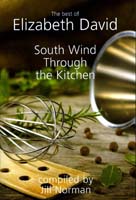 Then there are Grub Street’s hardback editions (priced around £12.99-£14.99) of a number of Elizabeth David classics, including recent re-issues of English Bread and Yeast Cookery; Spices, Salt and Aromatics in the English Kitchen and - perhaps most appealing as a general-interest food gift book - South Wind Through the Kitchen, compiled by Jill Norman (literary trustee of Elizabeth David's estate). Younger cooks new to Elizabeth David and who enjoy having an historical perspective will find it fascinating to be introduced to this legendary writer - who will be remembered by their mothers and grandmothers for brightening up post-war British kitchens (and ultimately Irish ones too) with Mediterranean sunshine, through the introduction of foods like olive oil and pasta, artichokes and aubergines that are now staples of contemporary cooking….
Then there are Grub Street’s hardback editions (priced around £12.99-£14.99) of a number of Elizabeth David classics, including recent re-issues of English Bread and Yeast Cookery; Spices, Salt and Aromatics in the English Kitchen and - perhaps most appealing as a general-interest food gift book - South Wind Through the Kitchen, compiled by Jill Norman (literary trustee of Elizabeth David's estate). Younger cooks new to Elizabeth David and who enjoy having an historical perspective will find it fascinating to be introduced to this legendary writer - who will be remembered by their mothers and grandmothers for brightening up post-war British kitchens (and ultimately Irish ones too) with Mediterranean sunshine, through the introduction of foods like olive oil and pasta, artichokes and aubergines that are now staples of contemporary cooking….For those who prefer their food books highly illustrated, At Elizabeth David's Table (Michael Joseph, hardback £25) is the answer: published to celebrate the 60th anniversary of Elizabeth's first book and with an introduction by Jill Norman, it is a beautifully illustrated collection of her dishes, together with other material including some of her short essays, and tributes from today’s chefs, including Jamie Oliver, Rose Gray and Hugh Fearnley-Whittingstall.
A seasonal recipe to try now: Faisan à la Cauchoise (Pheasant with Cream, Calvados and Apple), given in South Wind Through the Kitchen, and originally published in French Provincial Cooking.
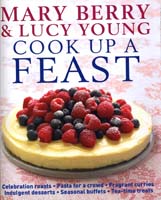 Equally successful, in a very different way, is Cook Up a Feast by Mary Berry & Lucy Young (Dorling Kindersley, hardback 336pp, 20/€25). Mary Berry, one of Britain’s most popular (and reliable) cookery writers, and her assistant of 20 years, Lucy Young, have together produced one of the most practical reference books you’re likely to come across: this is as much a guide to coping with large numbers as a cookbook, and a very attractive and confidence-inspiring one it is too. In the ‘Good Housekeeping’ tradition, the advice is well thought out and down to earth – and you just know every recipe will work.
Equally successful, in a very different way, is Cook Up a Feast by Mary Berry & Lucy Young (Dorling Kindersley, hardback 336pp, 20/€25). Mary Berry, one of Britain’s most popular (and reliable) cookery writers, and her assistant of 20 years, Lucy Young, have together produced one of the most practical reference books you’re likely to come across: this is as much a guide to coping with large numbers as a cookbook, and a very attractive and confidence-inspiring one it is too. In the ‘Good Housekeeping’ tradition, the advice is well thought out and down to earth – and you just know every recipe will work.A seasonal recipe to try now: Traditional Chicken, Leek, and Mushroom Pie; quantities are given for pies serving 6 or 12 – and it would work wonderfully well with cooked turkey too.
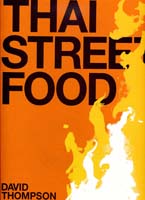 And, finally, the biggest food book (by far) that I have yet come across also happens to be outstanding in every other way so, if size matters and you have someone on your gift list who really loves Thai food, the solution has to be Thai Street Food (Octopus £40; www.octopusbooks.co.uk). This massive tome comes with an impeccable pedigree: having reached a wide audience through both his writing and his acclaimed London restaurant, nahm, which was the first Thai restaurant to earn a Michelin star, author David Thompson is an undisputed authority on Thai food. Earl Carter, whose superb photographs dominate this new book, leads with a 26 page photo-essay – a repeated feature, uninterrupted by captions, which are given at the back – and the complementary, tightly disciplined, text almost seems to take second place, as it follows Thailand’s streets from dawn markets through to night time dtam sang stalls. Not an easy read – the sheer size and weight of this impressive book is demanding – but an exciting and rewarding one.
And, finally, the biggest food book (by far) that I have yet come across also happens to be outstanding in every other way so, if size matters and you have someone on your gift list who really loves Thai food, the solution has to be Thai Street Food (Octopus £40; www.octopusbooks.co.uk). This massive tome comes with an impeccable pedigree: having reached a wide audience through both his writing and his acclaimed London restaurant, nahm, which was the first Thai restaurant to earn a Michelin star, author David Thompson is an undisputed authority on Thai food. Earl Carter, whose superb photographs dominate this new book, leads with a 26 page photo-essay – a repeated feature, uninterrupted by captions, which are given at the back – and the complementary, tightly disciplined, text almost seems to take second place, as it follows Thailand’s streets from dawn markets through to night time dtam sang stalls. Not an easy read – the sheer size and weight of this impressive book is demanding – but an exciting and rewarding one.A seasonal recipe to try now: Deep-Fried Cured Pork Ribs; ‘so lip-smackingly good that you may wish to double the recipe’.
Book Review - An Irish Butcher Shop by Pat Whelan
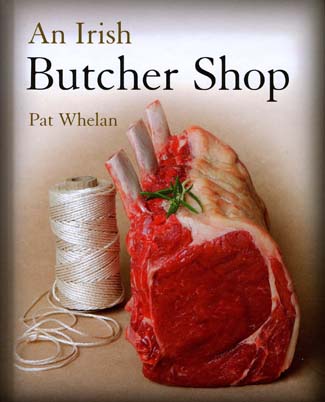
 Who could fail to be charmed by a book that arrives carefully wrapped in stout brown paper, tied up with white string, labelled with a manilla tag label (like the ones my father used, when sending produce on the overnight train from Cornwall up to Covent Garden) and neatly finished with red sealing wax…?
Who could fail to be charmed by a book that arrives carefully wrapped in stout brown paper, tied up with white string, labelled with a manilla tag label (like the ones my father used, when sending produce on the overnight train from Cornwall up to Covent Garden) and neatly finished with red sealing wax…? It’s hard to spoil this picture of perfection by opening it but, once carefully disassembled (in case later tempted to reconstruct the dream) it opens to reveal a handsome book An Irish Butcher Shop (Collins Press, €25) by Pat Whelan, with the cover featuring the very ball of string (or its cousin) alongside a juicy rib roast of what can only be Tipperary beef.
Pat Whelan, perhaps Ireland’s most famous butcher and certainly one of the most innovative, is the second generation owner of James Whelan Butchers in Clonmel (established by his parents in 1960), farmer, and chairman of the extremely effective Tipperary Food Producers Network (www.tipperaryfoodproducers.com).
Tradition and innovation go hand in hand here in Tipperary, where the value of tradition – and especially traditional farming, as in grass fed cattle - is respected, but the importance of a forward-looking outlook is equally well understood.
Whelans was Ireland’s first online butcher, and now has a thriving business dispatching meat throughout Ireland and the UK, with an overnight service anywhere in Ireland. The range is wide and includes speciality produce from the local area such as wagyu beef, free range pork and Inch House traditional black pudding as well as their own Angus and Hereford beef, local lamb, rabbit and Hubbard chicken.
The wide range of products sold in the shop, together with Pat Whelan’s balanced appreciation of both the old and the new, is reflected in this book which is part memoir – a tribute to the love of the job instilled in him by his parents and a country childhood - part text book (each meat has a detailed introduction, for example, and there is a chapter devoted to cooking methods), and then his collection of around 90 recipes, which has a bias towards the goodness of traditional flavours but also offers a fair range of international dishes, including some from Pat’s wife, Lina, who is from Lithuania.
The great meats of Tipperary dominate, of course – beef, pork and lamb – but there’s a substantial poultry chapter, including recipes for the Christmas turkey and roast goose, some appealing game recipes, a good range of side dishes and a chapter on kitchen basics like sauces, stocks and pastry.
An Irish Butcher Shop is a practical book, but it’s also opens a window into Tipperary life – and, above all, it’s a book with heart.
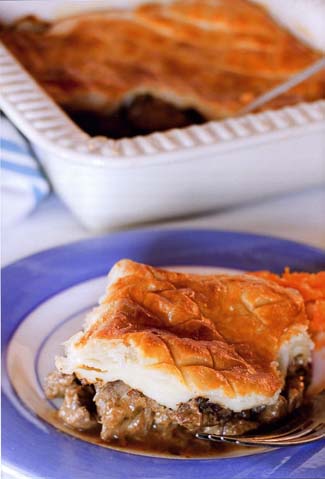 RECIPE: Steak and Kidney Pie
RECIPE: Steak and Kidney Pie“ Nothing can compare with my mother's steak and kidney pie,” says James Whelan in the introduction to this recipe in his book, An Irish Butcher Shop. “I still use the same recipe with just a small tweak; where she would have used lard or dripping to cook the meat, I use olive oil.
As an all-round favourite, steak and kidney pie ticks all the boxes. It's a very satisfying dish that also freezes well for a delicious midweek treat without any fuss.”
Serves 6
Click for recipe
Book Review - MasterChef AT HOME
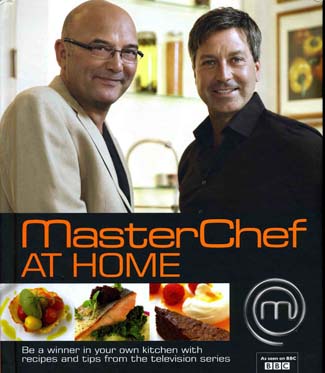
 MasterChef AT HOME (DK hardback 366pp, £20 / €25)
MasterChef AT HOME (DK hardback 366pp, £20 / €25)BBC’s MasterChef is a phenomenally popular show, with over 7.8 million viewers and now in its seventh series - so the chances are you’re a fan, so this could be just the book for you.
Featuring over 200 of the best recipes from the amateur, professional and celebrity competitions of 2010 (including nine complete menus from previous winners), this practical, educational and gimmick-free book begins with Forewords by the four judges – John Torrode, Greg Wallace, Michel Roux Jr and Monica Galetti – and is then divided in the best tried and tested manner into Starters, Vegetables & Fish, Poultry, Meat, Game and Desserts, with just a light sprinkling of judges’ comments.
Especially useful features include Monica Galetti’s Master Classes (Making Mayonnaise, Filleting Flatfish, Making Soufflés etc), MasterTips (giving ingredient information, or for mastering smaller tasks like peeling tomatoes or making pasta dough) and suggested Flavour Combinations (eg pork, apple & black pudding, beef and olives, lamb and beetroot, pheasant and sloes, star anise and rhubarb...).
While some of the dishes may be on the cheffy side, they are explained very clearly (some, but not all, with photographs) and a surprising number are appealingly simple (relatively speaking).
For this reason I would be drawn to dishes like Alex Rushner’s Sea Trout with Beetroot Puree, Claire Lara’s Roasted Pigeon with Pommes Mousseline and Pancetta Peas (see below) and Dhruv Baker’s Masala Tea Ice Cream and Spiced Sauternes-Poached Pear with a Chocolate Truffle, all of which have a simple elegance and depend on luscious ingredients for their success rather than a huge amount of fancy footwork.
RECIPE
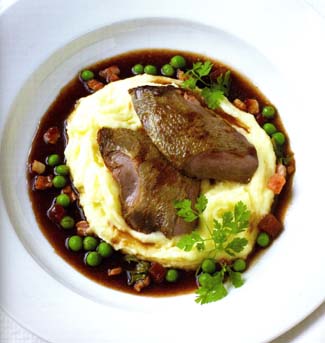 Pigeon with Pommes Mousseline and Pancetta Peas
Pigeon with Pommes Mousseline and Pancetta PeasFresh peas are listed for this dish from Claire Lara (lecturer and 2010 Professionals champion) but, as peas freeze exceptionally well, frozen peas make a perfectly reasonable alternative – particularly as pigeon is in season longer than peas.
Click for recipe
Book Review - The Dubliner Diaries by Trevor White

 The Dubliner Diaries by Trevor White (The Lilliput Press, www.lilliputpress.ie; €9.99)
The Dubliner Diaries by Trevor White (The Lilliput Press, www.lilliputpress.ie; €9.99)As memories of the Celtic Tiger fade into the clouds of dirt it kicked up as it disappeared over the horizon, there’s a poignancy to reading Trevor White’s funny, perceptive, bitter-sweet diary of publishing his thinking person’s magazine, The Dubliner, through those crazy years.
Trevor writes brilliantly and it’s a great read on all sorts of levels. And, while even the most energetic verbal gymnastics could hardly persuade anyone that this is a food book, it certainly has relevance to Irish hospitality. How could it not have, given Trevor’s background: his parents, Peter and Alicia White, owned that great 1980s Dublin restaurant, Whites on the Green, and he could hardly have failed to be influenced by the high standards of culinary excellence they nurtured.
 As has been observed elsewhere, Trevor’s self-deprecating style is very appealing and it’s interesting to see those strange ‘Tiger’ years through the penetrating gaze of someone who knows the city, and just about everyone of consequence in it, intimately - and has no qualms about drawing uncomfortable and (usually) true conclusions about people and events of the time.
As has been observed elsewhere, Trevor’s self-deprecating style is very appealing and it’s interesting to see those strange ‘Tiger’ years through the penetrating gaze of someone who knows the city, and just about everyone of consequence in it, intimately - and has no qualms about drawing uncomfortable and (usually) true conclusions about people and events of the time. Even when he gets it wrong – especially when he gets it wrong, as he would say himself – it makes fascinating reading; paradoxically, the satirical tone of the magazine reflects back most engagingly on its founder. As the chronicle of a decade that most of us would like to forget as soon as possible, this little book is destined to become even more interesting with time, and it is fitting that it ends on a high note – with our hero’s exit from involvement with the publication he created, and the birth of his son.
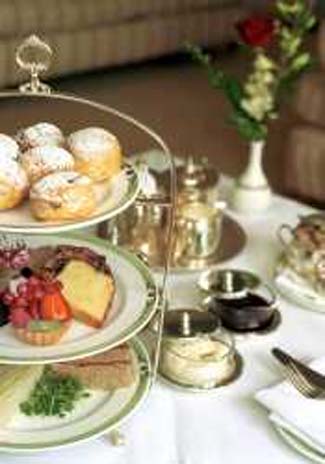 Whatever about the frequently lamentable goings-on of the noughties, a constant that beams out from The Dubliner Diaries whether he likes it or not is Trevor’s love of, and commitment to, his native city, warts and all. If there were any doubt about this, the proof is in his more recent enterprises: the recently launched City of a Thousand Welcomes is a not-for-profit idea that, quite literally, aims to connect visitors with real Dubliners (‘Ambassadors’) who are knowledgeable and passionate about their city and will welcome them to it over a complimentary cup of tea/coffee or a drink. The response from an interested public has been fantastic, Trevor reports, “ In just over two weeks we've had over 2,000 applications for the voluntary, unpaid position of Dublin Ambassador... we were hoping to get 1000 in three months!”
Whatever about the frequently lamentable goings-on of the noughties, a constant that beams out from The Dubliner Diaries whether he likes it or not is Trevor’s love of, and commitment to, his native city, warts and all. If there were any doubt about this, the proof is in his more recent enterprises: the recently launched City of a Thousand Welcomes is a not-for-profit idea that, quite literally, aims to connect visitors with real Dubliners (‘Ambassadors’) who are knowledgeable and passionate about their city and will welcome them to it over a complimentary cup of tea/coffee or a drink. The response from an interested public has been fantastic, Trevor reports, “ In just over two weeks we've had over 2,000 applications for the voluntary, unpaid position of Dublin Ambassador... we were hoping to get 1000 in three months!” The Welcomes initiative is set to begin in early June 2011, and it will shortly be joined by a sister project, The Little Museum of Dublin. This new non-profit museum at 15, St Stephen’s Green will tell the story of Dublin in the 20th Century; it is to belong to the people of Dublin, and the collection will be completed by public donation. “We want to create something that Dubliners will always be proud of” Trevor explains, “and curious visitors cannot afford to miss.”
Sponsors and partners of this admirable civic initiative include Dublin City Council, Dublin Regional Authority, Fáilte Ireland, the Merrion Hotel, Porterhouse Bars and TV3.
Book Review - Guide to Irish Farmhouse Cheeses
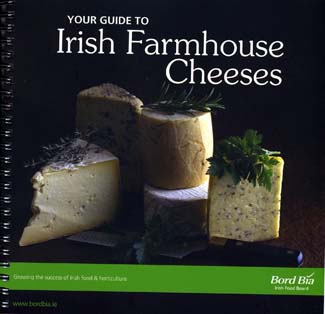
 Bord Bia’s new 'Guide to Irish Farmhouse Cheeses' is mainly trade orientated – it is designed to promote and encourage the use of Farmhouse Cheese in restaurants, catering and food service – but it also make a great reference for all interested foodies, and will be an invaluable resource for teachers.
Bord Bia’s new 'Guide to Irish Farmhouse Cheeses' is mainly trade orientated – it is designed to promote and encourage the use of Farmhouse Cheese in restaurants, catering and food service – but it also make a great reference for all interested foodies, and will be an invaluable resource for teachers. Within the smart spiral-bound covers you’ll find a comprehensive directory of hand made Irish cheeses (127 individual cheese types), with photographs of each one and background information, contact details and profiles of 47 cheesemakers from across the country.
Irish farmhouse cheese is recognised for the fundamental role it plays in the growth and development of Ireland's artisan dairy sector, with annual sales valued at €2.6m, accounting for 10% of the speciality market. There
are opportunities within this sector to encourage new shoppers into the category – and an increase of just 1% in shopper numbers could generate €154,000 in sales. At present consumer spend on dairy accounts for 13% of the average grocery expenditure per household across the year.
Eimear O'Donnell, Bord Bia's Sector Manager for Farmhouse Dairy, said 'The guide and wall chart were designed as educational tools for industry providing important background information on each of the farmhouse cheesemakers along with the characteristics of each of their cheeses. It is the first of its kind and we hope it will be the vehicle for new business for the sector. Ireland was a world - class farmhouse cheese sector delivering on quality, taste and authenticity and it is important that the tradition is preserved.'
Free copies: If you would like a free copy of 'Your Guide to Irish Farmhouse Cheeses' and supporting wall chart, please email Bord Bia's Small Business team on eimear.odonnell@bordbia.ie
The wall chart and guide can also be found online at www.bordbia.ie
Abbey Feta Cheese Quiche with Tomato, Basil and Aubergine
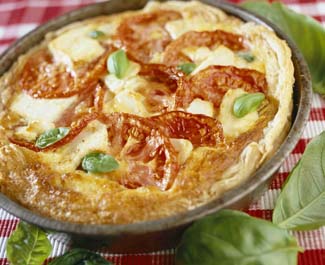 This recipe originally came from Sarah Webb of The Gallic Kitchen in Abbeyleix, Co Laois, and it was one of the recipes given in our recently published regional food tourism guide, Ireland For Food Lovers (Epicure Press, €20).
This recipe originally came from Sarah Webb of The Gallic Kitchen in Abbeyleix, Co Laois, and it was one of the recipes given in our recently published regional food tourism guide, Ireland For Food Lovers (Epicure Press, €20). This summery tart would make a nice lunch or supper dish. The feta cheese suggested is made by Paddy Jack Hyland, nearby at Ballacolla and, unusually for a quiche, it uses puff pastry so the dish is easy to make, and a lighter option than traditional shortcrust. Courgettes might be more easily available than aubergine, and would do equally well.
Serves 4
Click for recipe
Book Review - Food to Love by Edward Hayden
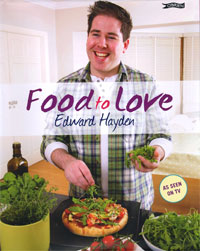
 Young Kilkenny chef Edward Hayden is a busy man: not only does he have a regular cookery slot on TV3’s popular Ireland AM programme and a column in the Sunday World, but the day job finds him teaching in the Cookery School at Dunbrody House in Co Wexford – and he also gives classes at Waterford Institute of Technology.
Young Kilkenny chef Edward Hayden is a busy man: not only does he have a regular cookery slot on TV3’s popular Ireland AM programme and a column in the Sunday World, but the day job finds him teaching in the Cookery School at Dunbrody House in Co Wexford – and he also gives classes at Waterford Institute of Technology. Yet he also finds time to keep a blog going on his website (edwardentertains.com), and to write books, the first of which (Edward Entertains) he even published himself. This time around he has a publisher, but what comes through is still very much the real Edward, who is bursting with energy and enthusiasm for ‘home cooking’ saying, quite rightly, that ‘there’s something very satisfying about spending time cooking and serving a delicious home cooked meal to family and friends’.
The aim is to give recipes that are not too labour-intensive, that use readily sourced ingredients, and that work well. A good aim as it’s what most people want from a cookery book, and the sections are equally sensible, ranging from Light Bites, Super Soups and ‘Not Just Your Daily Bread baking recipes to Mouthwatering Meat Dishes, Something Fishy and One Pot Wonders and then through to Versatile Veg, Spuds-U-Like, Sweet Temptations – and so on.
There’s even a sprinkling of festive recipes, covering the all big food days like Christmas, Hallowe’en and Shrove Tuesday.
There’s a distinctly personal and homely feeling to this book, which includes many familiar recipes but always with Edward’s special delivery and his little twists and hints to make them a bit different. The food for Carol Marks’ photographs has been styled by Edward himself, and here again the tone is very homely.
Nice details include a section of Menu Suggestions, a useful blue ribbon page marker – and also a bookmark featuring a recipe for Pumpkin Seed Bread.
On the downside, although the Contents section is very clearly laid out, there is no Index - an omission which I always find very irritating in a cookbook, although it may not annoy everyone.
 RECIPE: Peach & Strawberry Pavlova
RECIPE: Peach & Strawberry Pavlova Serves 6
“I think pavlova is an eternally popular dessert; it's always a great success. Also, for the calorie conscious it does have a considerably lower quantity of fat than other desserts (you might need to go easy on the cream though!)”
Click for recipe
Book Review The Free Range Cook by Annabel Langbein
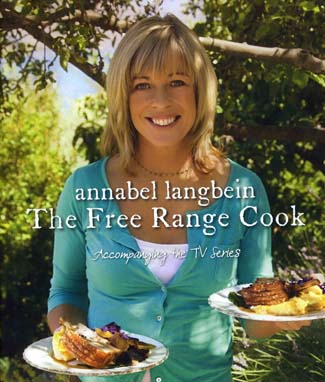
 Annabel Langbein is one of New Zealand’s most popular food writers and it’s easy to see why. Her message is bang on trend – she’s ‘on a mission to get people into the kitchen with fun, no-stress recipes that make the most of what nature has to offer” - and her down-to-earth approach to cooking has made her a phenomenon.
Annabel Langbein is one of New Zealand’s most popular food writers and it’s easy to see why. Her message is bang on trend – she’s ‘on a mission to get people into the kitchen with fun, no-stress recipes that make the most of what nature has to offer” - and her down-to-earth approach to cooking has made her a phenomenon. Annabel has already written and self-published 17 books, which have been widely translated and sold internationally. She is now launching in the UK for the first time and this book is a companion to her 13-part TV series of the same name, Annabel Langbein The Free Range Cook, which is to be aired in 73 territories worldwide and will be showing on the Good Food Channel next spring.
Annabel explains, "My book is not about impressing people with gastronomic acrobatics, turning out complicated plates in the theatre of a restaurant. It's about having fun and celebrating what nature has so graciously provided for us."
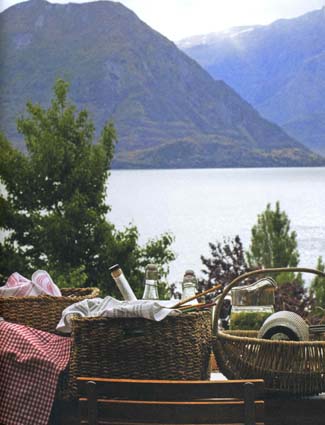 Sourcing and seasonality are at the heart of the book and chapters are organised to reflect that - From the Garden, From the Farm, From the Oven, From the Larder, From the Orchard, and From Lake and Sea…
Sourcing and seasonality are at the heart of the book and chapters are organised to reflect that - From the Garden, From the Farm, From the Oven, From the Larder, From the Orchard, and From Lake and Sea…Recipes cover all aspects of cooking, including baking, preserving, making cordials and sauces, and many of them will already be familiar.
The point of this book isn’t original recipes, but finding the best ingredients (“the closer you get to the source, the better your food is likely to taste”), using them well – and having fun. And the gorgeous New Zealand landscapes are easy on the eye too – Annabel’s simple, delicious food and the scenic backdrops won’t do any harm at all to tourism in her native country.
Chocolate Cherry Tiramisu
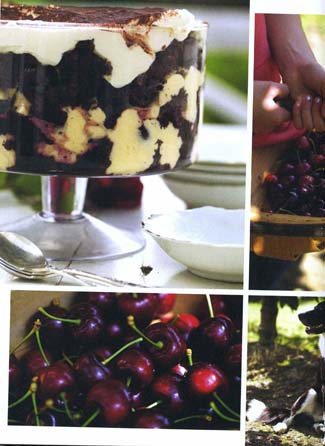 “Some recipes make this classic unnecessarily complicated, but this version is dead easy and wickedly good. Traditionally, tiramisu contains coffee or alcohol, but I’ve made this with Berry Syrup (the recipe is given in the book) so the kids can enjoy it too. If you’re short on time, use store-bought chocolate cake or sponge.”
“Some recipes make this classic unnecessarily complicated, but this version is dead easy and wickedly good. Traditionally, tiramisu contains coffee or alcohol, but I’ve made this with Berry Syrup (the recipe is given in the book) so the kids can enjoy it too. If you’re short on time, use store-bought chocolate cake or sponge.”Click for recipe
Book Review - Cooking Gluten Wheat and Dairy Free by Michelle Berriedale-Johnson
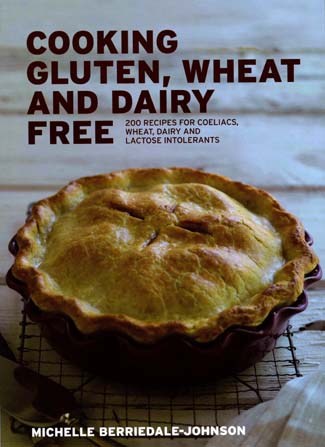
 Cooking Gluten, Wheat and Dairy Free, by Michelle Berriedale-Johnson
Cooking Gluten, Wheat and Dairy Free, by Michelle Berriedale-Johnson 200 recipes for coeliacs, wheat, dairy and lactose intolerants
ISBN 978-1-906502-92-8 paperback, stg£14.99
For anyone suffering from allergies or intolerances to dairy, wheat and gluten, the main problem is that they are the most commonly used ingredients in food manufacture, so most ready-made foods contain at least one of these products.
This means you will have to cook for yourself – and you could not ask for a better, or more experienced guide than Michelle Berriedale-Johnson.
A well known expert on food allergies and intolerances, Michelle became interested in special diets over 20 years ago when her son was diagnosed as being dairy intolerant. She set up a food company, Berrydales, specialising in additive free, dairy free, gluten free and egg free foods and started a quarterly magazine, The Inside Story (later renamed Foods Matter), about dietary problems, which has now become an online magazine and portal www.foodsmatter.com.
This book explains what the forbidden ingredients are, where they are likely to turn up and what alternatives to use – all vital information, if you are to successfully follow a dairy, gluten and wheat free diet.
Michelle gives 200 wide-ranging recipes for soups, starters, light lunches, egg dishes, pasta and pizzas, fish, meat, poultry and game, salads, vegetables and vegetarian dishes, desserts, breads, biscuits and cakes - all of which are milk, cream, butter, cheese, yogurt, wheat, gluten and lactose free. While not fully illustrated, the book has a sprinkling of photographs and is clearly laid out and well produced.
Michelle is also the author of a best-selling book on a related subject, The Everyday Wheat- Free and Gluten-Free Cookbook, published by Grub Street.
RECIPE: FRESH SALMON AND SPINACH PASTA
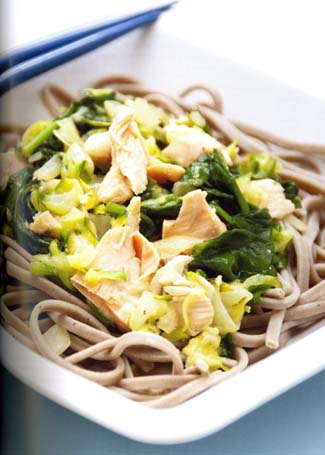 A lovely light summer dish - very quick to make. If you cannot get gluten and wheat-free tagliatelle, you could use Japanese soba (buckwheat) noodles, which are also delicious. Alternatively, use a gluten and wheat-free spaghetti. Serves 6
A lovely light summer dish - very quick to make. If you cannot get gluten and wheat-free tagliatelle, you could use Japanese soba (buckwheat) noodles, which are also delicious. Alternatively, use a gluten and wheat-free spaghetti. Serves 6Click for recipe
Book Reviews
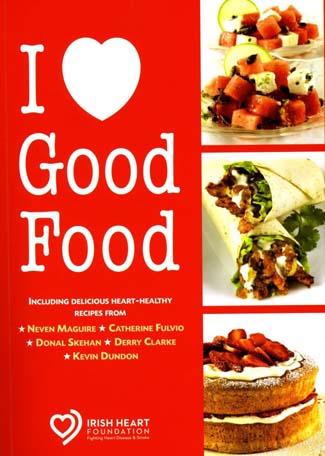
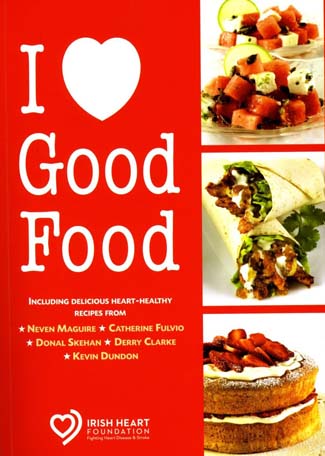 I Love Good Food, Irish Heart Foundation (Poolbeg Press €19.99; paperback, 230pp full colour; available from bookshops & online from www.irishheart.ie at €16.99 + p&p)
I Love Good Food, Irish Heart Foundation (Poolbeg Press €19.99; paperback, 230pp full colour; available from bookshops & online from www.irishheart.ie at €16.99 + p&p)The Irish Heart Foundation is well known for the excellent recipes they have published in recent years, including numerous appealing booklets to coincide with their popular Happy Heart Eat Out weeks and a successful Happy Heart Cookbook. Now they’ve gone one better and come up with a lovely new book, I Love Good Food.
Billed as ‘a practical tool to guide the nation to healthier cooking and eating’, the book is based on the premise that we all love good food - and that variety is the spice of life - and its 120 appealing recipes cover a wide range of occasions from weekday and ‘on the go’ meals to ideas for entertaining, together with many useful hints (eg you can reduce salt by replacing some of it with black pepper – try it and see!).
Smartly-packaged in striking red and white livery - with recipes edited by Orla Broderick, beautifully presented by food stylist Ann Kenny and photographed by Neil Macdougald - a glance through this well-produced book will prove that eating healthily is no hardship.
And you’ll be in good company too, with recipes contributed by chefs, cookery writers and celebrities such as former Miss World Rosanna Davison and Boyzone’s Mikey Graham, TV presenters Miriam O’Callaghan, Marty Whelehan and Caroline Morahan, actors, comedians, and culinary stars including Kevin Dundon (Dunbrody House), Neven Maguire (MacNean House & Restaurant), Catherine Fulvio (Ballyknocken House) and Donal Skehan.
Pointing out that ‘It is the overall daily and weekly balance of foods that determines whether an eating plan is healthy or not’, the book’s key message is to beware of the highly processed foods that are loaded with fat, sugar and salt; instead get into the kitchen, where you have full control of what you and your family are eating – and the simple, yet full-flavoured, dishes featuring at the cookbook launch in Peploe’s restaurant in Dublin proved that healthy food can be seriously delicious.
MC at the event was John Healy, Maitre d’ on the RTE show The Restaurant, who, having survived two heart attacks, is currently one of the many people in Ireland waiting for a heart transplant; like Westlife’s Nicky Byrne, whose father died following a heart attack in 2009, John is now a voluntary campaigner for the Irish Heart Foundation. Their stories are moving, and could be the catalyst that’s needed for us to make major changes to the way we eat.
This is the kind of book that you will happily buy for yourself and I intend to take advantage of the good value offered by IHF’s online sales - where multiple sales are only charged at the same p&p rate as one book - and get copies for all the family as stocking fillers this Christmas. What better gift could there be than a guide to better heart health for your family, in 120 tasty stages?
RECIPE: Warm Goats' Cheese And Mango Salad
 This is one of the dishes I enjoyed at the launch, photographed by fellow guest, Myles McWeeney. The recipe is from television presenter Sinead Desmond, who says “This has to be one of my all-time favourite dishes, perfect for entertaining. It is stunning and simple - need I say more? Oh, and it tastes great too.” So true.
This is one of the dishes I enjoyed at the launch, photographed by fellow guest, Myles McWeeney. The recipe is from television presenter Sinead Desmond, who says “This has to be one of my all-time favourite dishes, perfect for entertaining. It is stunning and simple - need I say more? Oh, and it tastes great too.” So true.Preparation time: 10 minutes Cooking time: 10 minutes Serves 4
Click for recipe
Lasagne
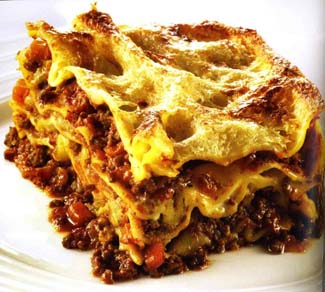 This anytime dish is my own contribution to I Love Good Food. Created for an earlier Irish Heart Foundation recipe booklet, this variation on classic lasagne uses everyday store cupboard items where possible, and low-fat ingredients and cooking methods provide a healthier alternative without losing flavour.
This anytime dish is my own contribution to I Love Good Food. Created for an earlier Irish Heart Foundation recipe booklet, this variation on classic lasagne uses everyday store cupboard items where possible, and low-fat ingredients and cooking methods provide a healthier alternative without losing flavour. For an even healthier alternative, you could be less generous with the Parmesan or even use low-fat cheese.
Serves 6
Preparation time: 30 minutes Cooking time: 2 hours
Click for recipe
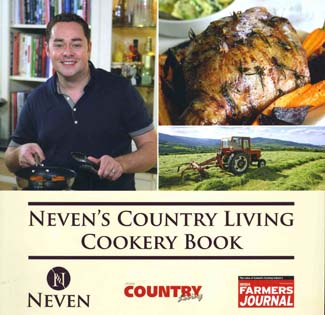 Neven's Country Living Cookery Book
Neven's Country Living Cookery Book (published by The Irish Farmers Journal ISBN-13: 9780953490226; rrp €19.95 204pp, full colour; available from bookshops, also online from www.farmersjournal.ie at €15 plus €3 p&p, with free shipping on orders of 2 or more).
Neven Maguire is unquestionably one of Ireland’s most gifted chefs and, on a daily basis, he creates restaurant meals that amaze and delight his customers. But his USPs extend far beyond the kitchen, and he is known as much for other things as for his amazing restaurant: his warm, engaging personality and love of family and place; support of his treasured local producers and suppliers; and (perhaps uniquely among top chefs – and we put this down to early teaching by his mother, Vera) an ability to talk simply and directly to the home cook, both at demonstrations and in his recipes.
Since 2008, Neven has been the principle food writer of Irish Country Living (free with the Irish Farmers Journal every Thursday) and, with a shared enthusiasm for the country’s best food producers and constant linking of farm and fork, it is a partnership made in heaven.
The readers love his genuine respect for the farming community, of course, and also his down to earth approach. Small wonder then that the Editor, Mairead Lavery, says: “Over and over again we have been asked to gather Neven's recipes into a cookery book. And that's exactly what we've done. With over 100 favourite recipes from Neven's column in Irish Country Living, we hope this book will become a mainstay in many kitchens where good food is prepared, eaten and appreciated.”
Neven's Country Living Cookery Book is a lovely book, with some rural images as well as delicious dishes, to underline the source of the ingredients that Neven uses in his admirably straightforward recipes.
It is widely available and already a best seller – and, as I discovered to my delight on a recent visit to MacNean House, Neven ensures that each overnight guest finds a signed copy waiting in their room. Another good reason to visit Blacklion so!
RECIPE: Roasted Pepper with Boilie Cheese
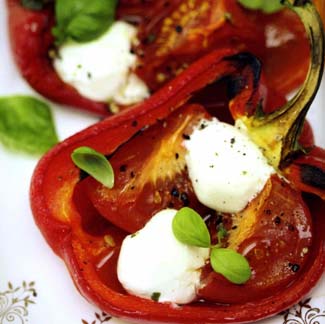 Neven says, “The Boilie cheese I use is produced at a local creamery Fivemiletown, in Fermanagh. Boilie are fresh cheese curds that have been rolled by hand into balls; they are marinated in oil and herbs and are readily available in two varieties, one coming from cow's milk and the other from goat's milk. Both are soft and have a wonderfully delicate flavour. I just love them and like to use them to fill red peppers; although the stalks of the pepper are not edible, they do look attractive and help the peppers keep their shape.”
Neven says, “The Boilie cheese I use is produced at a local creamery Fivemiletown, in Fermanagh. Boilie are fresh cheese curds that have been rolled by hand into balls; they are marinated in oil and herbs and are readily available in two varieties, one coming from cow's milk and the other from goat's milk. Both are soft and have a wonderfully delicate flavour. I just love them and like to use them to fill red peppers; although the stalks of the pepper are not edible, they do look attractive and help the peppers keep their shape.” Note: The olive oil and Maldon sea salt suggested in this recipe could now be replaced with Irish produced rapeseed oil (Neven is a fan of Donegal Rapeseed Oil) and Irish Atlantic Sea Salt, from West Cork.
Serves 4
Click for recipe
Book Reviews
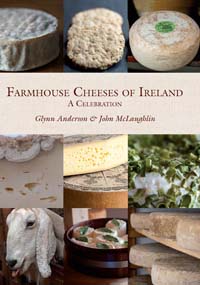
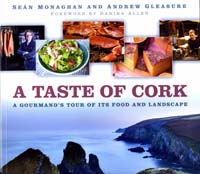 Print publishing may be in an uncertain place right now, and book shops feeling the force of the move towards e-publishing but, judging by the bumper crop of books that have come in for review this autumn, there’s nothing to beat seeing a handsomely produced book on the shelf – and books still make the greatest Christmas presents.
Print publishing may be in an uncertain place right now, and book shops feeling the force of the move towards e-publishing but, judging by the bumper crop of books that have come in for review this autumn, there’s nothing to beat seeing a handsomely produced book on the shelf – and books still make the greatest Christmas presents. Pride in Ireland’s evolving food culture is a developing theme in Irish publishing, as seen in two very recent books. A Taste of Cork, A Gourmand’s Tour of its Food and Landscape (The History Press Ireland, large format paperback, 96pp, €19.99) is a collaboration between photographer Seán Monaghan and writer Andrew Gleasure, both based in Cork, with a Foreword by Darina Allen. The photographic element is strong, with portraits of many of the county’s best-loved personalities in the food world and their products, set against the backdrop of the wonderful land- and sea-scapes that are the foundation of so many of the good things that we find in the shops, markets, restaurants – and homes – of Cork. The narrative includes a nicely judged amount of history and factual scene setting – with plenty of general background information on the county’s attractions, as well as food-focused items – making this a book that should appeal to visitors. The price is a little high – a common problem with Irish books when competing with imports - but, on a practical note, it is not too heavy (weighing in at under 500g), so will tuck nicely into the return luggage and is not too expensive to post.
 By contrast, Glynn Anderson & John McLaughlin’s Farmhouse Cheeses of Ireland, A Celebration (hardback, Collins Press, 256pp, €25) is smaller and more compact, but it’s as dense as a block of the harder cheeses described between the covers and weighs in at well over 1kg. Expect the trademark Collins Press high production values, with no short cuts taken: this well-designed reference book is built to last and will take plenty of hard wear from the professionals and serious foodies who will value its comprehensiveness and the detailed information it gives on virtually every Irish cheese of note currently in production. A length Introduction sets modern Irish cheesemaking in context, with history, factual production information (answering such fundamental questions as ‘what is cheese?’ and ‘what is farmhouse cheese?’); explaining the classification of cheese, also how cheese is made (including how to make it at home), how to buy well and store correctly. Importantly, especially for those professionally interested, there’s also a section on ‘Cheese administration’, which includes cheese naming in Europe, information on CAIS (the Association of Irish Farmhouse Cheese Makers), Slow Food (that raw milk question raises its head again) and IOFGA (Irish Organic Farmers and Growers Association). Each cheese is then described in detail, with a profile of each producer, the cheese(s) made, a table summarising key information, and even the awards received. There’s also a chapter of recipes, many of them contributed by well known chefs, although there is a sense that this was an add-on – it includes some appealing dishes, but without images and it doesn’t have the same comprehensively ‘thought through’ feeling of the earlier sections. Although it may date rather quickly as new cheeses emerge and others go out of production, this is a welcome specialist reference (reminiscent of the Slow Food book, Italian Cheese, published in 2001), and it marks a coming of age for Irish farmhouse cheese in international terms.
By contrast, Glynn Anderson & John McLaughlin’s Farmhouse Cheeses of Ireland, A Celebration (hardback, Collins Press, 256pp, €25) is smaller and more compact, but it’s as dense as a block of the harder cheeses described between the covers and weighs in at well over 1kg. Expect the trademark Collins Press high production values, with no short cuts taken: this well-designed reference book is built to last and will take plenty of hard wear from the professionals and serious foodies who will value its comprehensiveness and the detailed information it gives on virtually every Irish cheese of note currently in production. A length Introduction sets modern Irish cheesemaking in context, with history, factual production information (answering such fundamental questions as ‘what is cheese?’ and ‘what is farmhouse cheese?’); explaining the classification of cheese, also how cheese is made (including how to make it at home), how to buy well and store correctly. Importantly, especially for those professionally interested, there’s also a section on ‘Cheese administration’, which includes cheese naming in Europe, information on CAIS (the Association of Irish Farmhouse Cheese Makers), Slow Food (that raw milk question raises its head again) and IOFGA (Irish Organic Farmers and Growers Association). Each cheese is then described in detail, with a profile of each producer, the cheese(s) made, a table summarising key information, and even the awards received. There’s also a chapter of recipes, many of them contributed by well known chefs, although there is a sense that this was an add-on – it includes some appealing dishes, but without images and it doesn’t have the same comprehensively ‘thought through’ feeling of the earlier sections. Although it may date rather quickly as new cheeses emerge and others go out of production, this is a welcome specialist reference (reminiscent of the Slow Food book, Italian Cheese, published in 2001), and it marks a coming of age for Irish farmhouse cheese in international terms.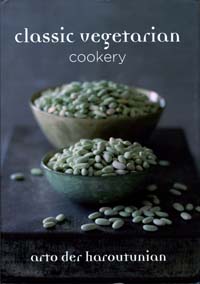 Vegetables, and vegetarian cookery, are coming into their own at last and it is good to see this timely new edition of Arto der Haroutunian’s Classic Vegetarian Cookery (Grub Street, hardback, 286pp, stg£14.99). First published as Classic Vegetable Cookery in 1985, it has been out of print for almost twenty years and it says a lot about our changing attitudes to food that publication is once again considered viable. Health, economy, the grow-it-yourself movement, interest in foraging, a growing sense of environmental responsibility – all of these are leading us back to vegetables. And, when they take time to browse through these 250 recipes from all over the world for inspiration, what a delightful surprise is in store for the many who previously thought of them merely as accompaniments, playing second fiddle to main dishes of meat or fish. ‘I believe we have no choice but to eat more vegetables in the future,” the author comments, “I do not think we will all become vegetarians but I am sure we will consume more vegetables, fruit and nuts, many of which are unknown to us and as yet unavailable in our corner shops. What is already there, however, is a magnificent array of all of the goodness of Nature.” Although not illustrated, this is an attractive, well laid-out book and easy to use.
Vegetables, and vegetarian cookery, are coming into their own at last and it is good to see this timely new edition of Arto der Haroutunian’s Classic Vegetarian Cookery (Grub Street, hardback, 286pp, stg£14.99). First published as Classic Vegetable Cookery in 1985, it has been out of print for almost twenty years and it says a lot about our changing attitudes to food that publication is once again considered viable. Health, economy, the grow-it-yourself movement, interest in foraging, a growing sense of environmental responsibility – all of these are leading us back to vegetables. And, when they take time to browse through these 250 recipes from all over the world for inspiration, what a delightful surprise is in store for the many who previously thought of them merely as accompaniments, playing second fiddle to main dishes of meat or fish. ‘I believe we have no choice but to eat more vegetables in the future,” the author comments, “I do not think we will all become vegetarians but I am sure we will consume more vegetables, fruit and nuts, many of which are unknown to us and as yet unavailable in our corner shops. What is already there, however, is a magnificent array of all of the goodness of Nature.” Although not illustrated, this is an attractive, well laid-out book and easy to use. Another classic is Lindsey Bareham’s The Big Red Book of Tomatoes (Grub Street, paperback, 456pp, £15.99). First published in hardback in 1999, this new paperback edition is not only welcome but extremely good value. Tomatoes are a staple in every kitchen, but did you ever think there might be over 400 really good recipes for this ‘fruit we like to eat as a vegetable’? Some can be rustled up in a few minutes, most take less than half an hour and then there are those that simmer away comfortingly for ages while you get on with something else. Different types of tomato are considered (and where they are grown best) also the tomato’s affinity with particular foods - eggs, bread, pasta, salads, meat, fish and sauces. Along with one or two other exceptionally versatile foods (such as eggs), the cupboard is never bare when you have a few tomatoes to rustle up a meal – and this is a book that could very quickly become an everyday favourite.
Another classic is Lindsey Bareham’s The Big Red Book of Tomatoes (Grub Street, paperback, 456pp, £15.99). First published in hardback in 1999, this new paperback edition is not only welcome but extremely good value. Tomatoes are a staple in every kitchen, but did you ever think there might be over 400 really good recipes for this ‘fruit we like to eat as a vegetable’? Some can be rustled up in a few minutes, most take less than half an hour and then there are those that simmer away comfortingly for ages while you get on with something else. Different types of tomato are considered (and where they are grown best) also the tomato’s affinity with particular foods - eggs, bread, pasta, salads, meat, fish and sauces. Along with one or two other exceptionally versatile foods (such as eggs), the cupboard is never bare when you have a few tomatoes to rustle up a meal – and this is a book that could very quickly become an everyday favourite.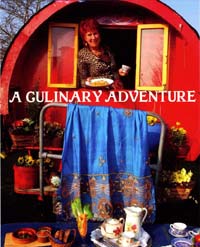 The Phoenix Restaurant Cookbook A Culinary Adventure (Firebird Publishing; available online www.thephoenixrestaurant.ie, €25 including p&p, and selected local outlets) is by Lorna Tyther, owner of the charming vegetarian Phoenix Restaurant in County Kerry. She has produced a predictably quirky little Irish vegetarian cookbook, which is full of life and warmth - a true reflection of The Phoenix Restaurant itself, and its magical gardens. Stockists include Ballyseedy Garden Centre, The Dingle Book Shop, local shops and farmers’ markets.
The Phoenix Restaurant Cookbook A Culinary Adventure (Firebird Publishing; available online www.thephoenixrestaurant.ie, €25 including p&p, and selected local outlets) is by Lorna Tyther, owner of the charming vegetarian Phoenix Restaurant in County Kerry. She has produced a predictably quirky little Irish vegetarian cookbook, which is full of life and warmth - a true reflection of The Phoenix Restaurant itself, and its magical gardens. Stockists include Ballyseedy Garden Centre, The Dingle Book Shop, local shops and farmers’ markets. And so to dessert… Macarons (Grub Street, hardback, 208pp, stg£25) is by Pierre Hermé, ‘the king of French pastry’; with shops in Tokyo, Paris and London, he has given the little macaron star status and this sumptuous book is the first to publish all the celebrated patissier’s recipes together in English. The photography is stunning and the special techniques required for making these delicate treats are explained in 32 step-by-step photo-illustrated instructions for making shells and fillings. Once the techniques are mastered, macarons are basically all about the fillings and all the classics are here – dark chocolate, praline, coffee, pistachio. But you’ll also find Hermé’s famously unexpected combinations too – including orange and cream cheese, for example, Mandarin and pink pepper, and a bright green macaron filled with fresh mint. A gorgeous gift for any foodie – and especially that budding MasterChef in your life.
And so to dessert… Macarons (Grub Street, hardback, 208pp, stg£25) is by Pierre Hermé, ‘the king of French pastry’; with shops in Tokyo, Paris and London, he has given the little macaron star status and this sumptuous book is the first to publish all the celebrated patissier’s recipes together in English. The photography is stunning and the special techniques required for making these delicate treats are explained in 32 step-by-step photo-illustrated instructions for making shells and fillings. Once the techniques are mastered, macarons are basically all about the fillings and all the classics are here – dark chocolate, praline, coffee, pistachio. But you’ll also find Hermé’s famously unexpected combinations too – including orange and cream cheese, for example, Mandarin and pink pepper, and a bright green macaron filled with fresh mint. A gorgeous gift for any foodie – and especially that budding MasterChef in your life.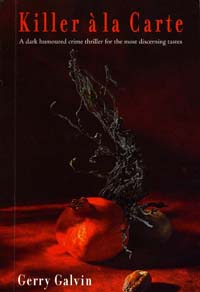 And finally, when it comes to the all-important stocking filler, don’t forget Gerry Galvin’s darkly comic crime thriller, Killer à la Carte (Doire Press, paperback, €13.99), in which a famous restaurant critic gets up to dastardly deeds…entertainment a-plenty for quieter times over the Christmas holiday.
And finally, when it comes to the all-important stocking filler, don’t forget Gerry Galvin’s darkly comic crime thriller, Killer à la Carte (Doire Press, paperback, €13.99), in which a famous restaurant critic gets up to dastardly deeds…entertainment a-plenty for quieter times over the Christmas holiday.
Book Reviews
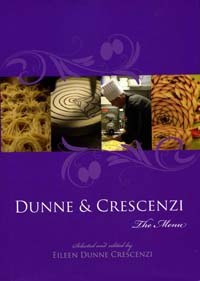
 There’s nothing to beat seeing a handsomely produced book on the shelf and books still make the greatest Christmas presents. This - the second month of our Christmas books selection - includes three great recipes for alternative desserts for your festive meals.
There’s nothing to beat seeing a handsomely produced book on the shelf and books still make the greatest Christmas presents. This - the second month of our Christmas books selection - includes three great recipes for alternative desserts for your festive meals.A fascinating culinary story began when Eileen Dunne Crescenzi and her husband Stefano met in Italy, when they were both working with the United Nations. They dreamt of running a restaurant together and, on settling back in Ireland, they opened a deli in north Dublin which was to be the foundation of a hospitality ‘empire’ that now comprises eight restaurants and cafés offering varying - but equally authentic - Italian dining and deli experiences, all based on the best artisan foods from Ireland and Italy.
Now Eileen has written a beautiful cookbook Dunne & Crescenzi, The Menu (Mercier Press, hardback €19.99), with recipes from their much-loved flagship restaurant on Dublin’s South Frederick Street. This handsomely produced book is dedicated to their many loyal customers – for whom it is a must – who will enjoy recreating their favourite dishes at home.
For any cooks as yet unfamiliar with the restaurant, it is a lovely introduction and an excellent general Italian reference, as the range is wide and balanced – antipasti, bruschetta, soups and salads, pasta dishes, polenta, risottos, meat and fish dishes are all here plus, of course, some mouthwatering desserts. Federica Crescenzi’s stylish photography sets the tone, and practical little comments and asides ensure good results for the home cook – this is a book for everyone who loves good food.
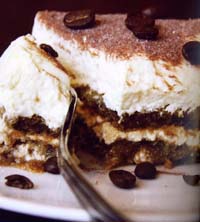 SAMPLE RECIPE: TIRAMISU WITH VINSANTO
SAMPLE RECIPE: TIRAMISU WITH VINSANTO“When we ran our little deli in Sutton back in 1995, neighbours would often ask us to cater for family gatherings, pre-wedding dinners, etc. Tiramisu was particularly popular - a combination of chocolate, cream cheese and coffee that most people adore. We have tried various liquors but find that vinsanto gives it an elegant lift.”
Click for recipe
Giving ‘over 130 reasons to love our food’, Jamie's Great Britain (Michael Joseph/Penguin hardback, stg£30)
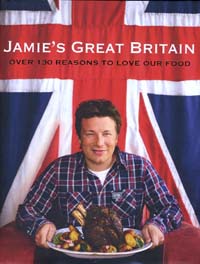 celebrates ‘the real essence of British food, done properly’.
celebrates ‘the real essence of British food, done properly’. Every country should take pride in its food, and this enthusiastically collected combination of classics and new dishes created with British produce is well timed to coincide with a newfound appreciation of the good things that have been on our collective doorsteps all the time – and big events coming up in Britain in 2012, including the Queen’s Diamond Jubilee and the Olympics.
You don’t need to be British or have any previous bias towards British food to enjoy this book, as there is plenty about it that has resonance with the neighbouring island.
 SAMPLE RECIPE: CHRISTMAS ICE PUDDING
SAMPLE RECIPE: CHRISTMAS ICE PUDDING“Puddings you can make ahead of time and leave in the freezer until you need them are great. Especially around the holidays, which is when I tend to make this one. I see this dessert as a sort of cross between a summer pudding and an arctic roll, so it hits a lot of those retro buttons. Because it's an assembly job, anybody at all can make this - so if you've got someone at your house who won't muck in because they say they can't cook, put them to work on this!”
Click for recipe
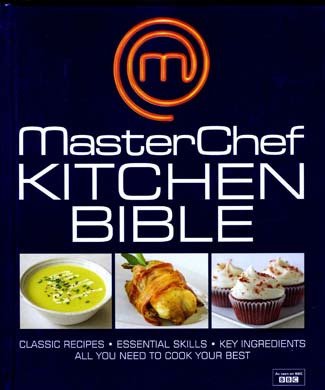 MasterChef KITCHEN BIBLE, Everything you need to know to become a MasterChef in your own kitchen (Dorling Kindersley hardback, £26/€30) is billed as ‘the ultimate cooking companion’ and, with advice on everything from choosing the best knives to suggestions from flavour pairing along with all of the skills, tips and recipes you need to cook successfully to a high level at home, that’s no idle boast.
MasterChef KITCHEN BIBLE, Everything you need to know to become a MasterChef in your own kitchen (Dorling Kindersley hardback, £26/€30) is billed as ‘the ultimate cooking companion’ and, with advice on everything from choosing the best knives to suggestions from flavour pairing along with all of the skills, tips and recipes you need to cook successfully to a high level at home, that’s no idle boast. The range of recipes is interesting and includes a great collection of retro and ‘modern classic’ treats like the sample below, as well as original MasterChef recipes form the programmes. A fine book.
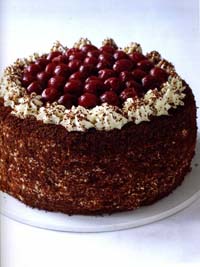 SAMPLE RECIPE: BLACK FOREST GATEAU
SAMPLE RECIPE: BLACK FOREST GATEAU“This is a classic cake that cannot be improved. However, don't waste the remaining cherry juice - use it as a basis for a berry fruit salad.”
Preparation time 55 minutes
Cooking time 40 minutes
Serves 8
Click for recipe
Book Reviews
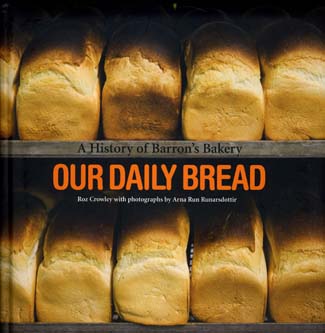
 Books are not just for Christmas and these are a few more of the good ones to enjoy this year.
Books are not just for Christmas and these are a few more of the good ones to enjoy this year.Books weren’t really on the agenda at the Good Food Ireland conference in November, but the queue at the magnificent showcase lunch put up by the association’s producer members was slow to move because there were so many interesting people to talk to, and there happened to be a delay beside the Barron’s Bakery stall – lucky for me, as Esther Barron had time to show me their lovely history of the bakery ‘Our Daily Bread’ (hardback ‘with a cover the soft feel of a loaf of bread’, €25 incl p+p, available online from www.barronsbakery.ie), and I came home with one tucked under my arm. And very nice it is too.
Written by Roz Crowley and with photographs by the Icelandic photographer Ara Run Runarsdottir, it’s an evocative book that will bring back many memories to family, customers and the people of West Waterford, and delight anyone with an interest in baking or social history.
Celebrating 125 years in business, this family bakery in Cappoquin is renowned throughout Ireland for its loving hands-on family management, traditional methods and the original Scotch brick ovens which produce a uniquely crusty loaf. As well as being a great read, the book also includes Mrs Barron’s recipes which, as Roz Crowley says ‘provide deliciously calorific interludes’. A lovely book.
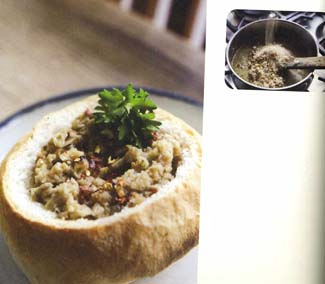 SAMPLE RECIPE: MUSHROOM SOUP IN A BLAA
SAMPLE RECIPE: MUSHROOM SOUP IN A BLAA“This is an easy recipe and quantities of ingredients don't have to be exact, so you can avoid using the weighing scales. I serve this in a crusty roll, such as one of Barron's traditional blaas*,” explains Eithne Barron. “The bread taken out of the roll to make space for the soup is used as breadcrumbs to thicken the soup. The cut-off tops can be buttered or dipped in olive oil.” (*The Waterford ‘blaa’ is a local speciality bread roll).
Click for recipe
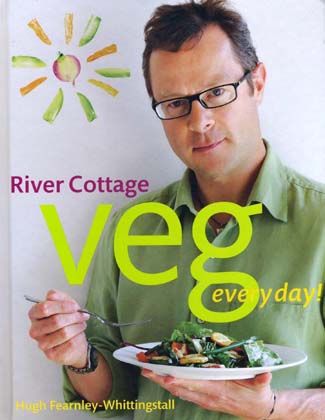 Underlining the very welcome surge of interest in GIY and seasonal fresh fruit and veg – which, to some extent, is a result of his own campaigning - Hugh Fearnley-Whittingstall’s River Cottage Veg Everyday (Bloomsbury Hardback stg£25) is bang on trend and, whether or not you are a follower of his TV programmes, if you’re a keen cook (and perhaps a gardener too), you’re bound to love this book.
Underlining the very welcome surge of interest in GIY and seasonal fresh fruit and veg – which, to some extent, is a result of his own campaigning - Hugh Fearnley-Whittingstall’s River Cottage Veg Everyday (Bloomsbury Hardback stg£25) is bang on trend and, whether or not you are a follower of his TV programmes, if you’re a keen cook (and perhaps a gardener too), you’re bound to love this book. And why wouldn’t you, with over 200 imaginative recipes to help you make the most of the delicious foods which are all too often relegated to the role of side dishes – the example below is an interesting once, combining the root vegetables not usually destined to go into stir-fries with oriental ingredients.
While not aimed particularly at vegetarians, it is nevertheless a vegetarian cookbook – for everyone.
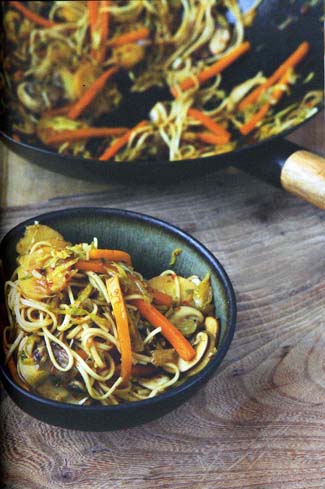 SAMPLE RECIPE: WINTER STIR-FRY WITH CHINESE FIVE-SPICE
SAMPLE RECIPE: WINTER STIR-FRY WITH CHINESE FIVE-SPICE“The warming hint of star anise within Chinese five-spice powder gives this dish character. You can chop and change the vegetables a little depending on what you have to hand - celeriac instead of parsnip, for instance, or shredded cabbage rather than sprouts - but I do think this is a particularly fun way of using Brussels sprouts.”
SERVES 2
Click for recipe
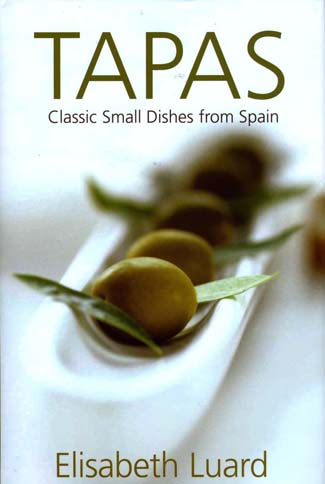 Elizabeth Luard’s TAPAS, Classic Small Dishes from Spain (Grub Street, hardback £15.99) is also bang on-trend, but nothing that this exceptionally talented and insightful writer does is ever governed by fashion. She is one of the leading authorities on European cooking, and the experience and inspiration from fifteen years spent living in Spain are the foundation of this book.
Elizabeth Luard’s TAPAS, Classic Small Dishes from Spain (Grub Street, hardback £15.99) is also bang on-trend, but nothing that this exceptionally talented and insightful writer does is ever governed by fashion. She is one of the leading authorities on European cooking, and the experience and inspiration from fifteen years spent living in Spain are the foundation of this book. In it, she champions the small dishes traditionally served with sherry in Spain – which, as she shows clearly, informatively and entertainingly in this definitive book, also travel well to other cultures and are ideal for all sorts of occasions.
An especially useful feature is a menu section, showing how tapas can be combined to create exciting party meals for different seasons and occasions.
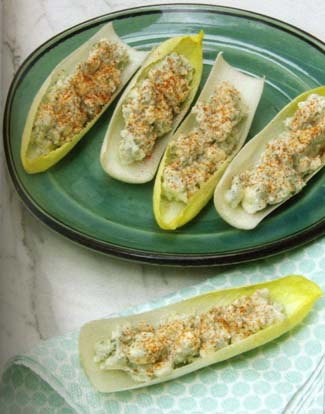 SAMPLE RECIPE: Chicory stuffed with blue cheese Ojas de chicoria con queso de cabrales
SAMPLE RECIPE: Chicory stuffed with blue cheese Ojas de chicoria con queso de cabrales“This is a very common tapa in the north of Spain, where the French influence is strong. The boat-shaped leaves of endive (also known as chicory or white-leaf) make perfect finger-food. The stuffing, while other blue-veins will do, is usually the pungent Cabrales, a blue-vein made in Asturias in much the same way as Roquefort.”
MAKES 8 TAPA MOUTHFULS / SERVES 2 AS A STARTER
Click for recipe
Book Review - BOUGHT, BORROWED & STOLEN, Recipes & Knives from a Travelling Chef
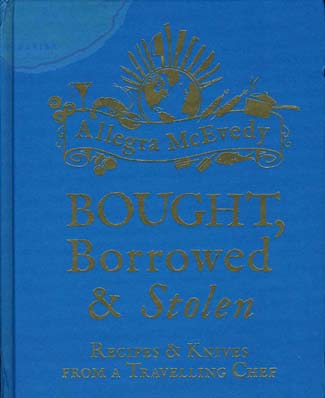
 Not a lot of people could claim an MBE for services to the hospitality industry on their CVs, but Allegra McEvedy is one who can – and the best-selling food writer, chef, broadcaster and culinary explorer’s unusual book BOUGHT, BORROWED & STOLEN, Recipes & Knives from a Travelling Chef (Octopus, hardback £25) illustrates perfectly what makes her stand out from the crowd.
Not a lot of people could claim an MBE for services to the hospitality industry on their CVs, but Allegra McEvedy is one who can – and the best-selling food writer, chef, broadcaster and culinary explorer’s unusual book BOUGHT, BORROWED & STOLEN, Recipes & Knives from a Travelling Chef (Octopus, hardback £25) illustrates perfectly what makes her stand out from the crowd. Going back to a childhood of travelling around with her historian father, a treasure trove of culinary notes collected from 20 countries over a quarter of a century provides the foundation for the recipes – and, once she became a professional chef, the knife collection started so she now has knives that illustrate the foodie character of each country.
Thus, instead of just a recipe collection, ‘the tools they use to create their magic’ convey the essence of the food she experienced in each country, and the ‘taste memories’ that she describes in a highly individualistic style. A fascinating book.
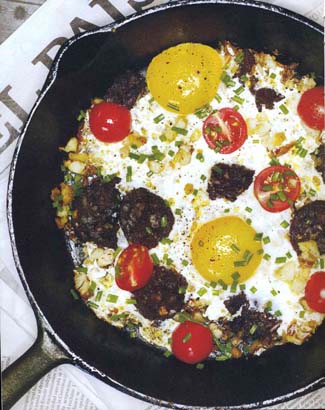 SAMPLE RECIPE: FRIED EGGS, SALT COD & BLACK PUDDING
SAMPLE RECIPE: FRIED EGGS, SALT COD & BLACK PUDDING(This recipe from Spain will look remarkably familiar to lovers of an Irish brunch – it makes a good post-Christmas feed!)
“The idea was a four-day romantic New Year's getaway, the reality was somewhat different...
Day 1 we met up with our great friend and bon viveur, Oli, and he and the wife went on a ten-hour bender that, given my state of pregnancy at the time, meant that the ensuing row ('It's my holiday too, you know') became a foregone conclusion.
Day 2 was New Year's Eve, and we got mugged (though Susi held on to her handbag for dear life, growling, for some reason, like a small dog, so they got away with nothing).
Day 3 was spent driving up to southern France to hook up with some friends, nice idea, but it happened to coincide with the one and only day in my pregnancy of gut-wrenching vomiting.
Day 4 we headed back to Barcelona for our evening flight, stopping for lunch in Girona, and came across this revelation of a dish - the highlight of the trip (though it has to be said, the competition was a bit thin).
Unfortunately there was also an unscheduled Day 5: stuck in the airport due to snow in Gatwick for thirty-six hours. Pregnant, with no fresh air and only airport food for a day and a half. Worst Trip Ever.”
Serves 2, and after you've soaked the cod only takes l5 minutes
100g/31/2 oz salt cod
2 tablespoons extra virgin olive oil
1 clove of garlic, chopped
75g/3oz black pudding (or one sausage of morcilla, the Spanish kind), sliced or diced
a small handful (6-ish) of cherry tomatoes, halved
2 eggs
a small handful of chives or spring onions, sliced
pepper
First you have to rehydrate the cod (put into a container under cold running water for 5 minutes, then soak for several hours, changing the water a couple of times), which, just to warn you, is easiest done overnight.
If the fish still has skin and bones, get rid of them, then cut it up into rough 1cm/1/2 inch dice.
Preheat the oven to 170°C/340°F/gas mark 31/2.
Using a pan that can go into the oven, heat the oil over a medium flame and fry the pieces of cod and the garlic. Cook for about 5 minutes, until it all begins to get golden and crunchy and starts sticking to the bottom of the pan, then
add the black pudding and the tomato halves.
After another 5 minutes, evenly distribute the contents around the pan, then crack the eggs in and tip it so that the whites run all around. Give it a few grinds of the peppermill and put the pan into the oven for about 3-ish minutes, until the eggs are set.
Sprinkle with chives and eat immediately - toast is good.
Book Review - FISH COOKBOOK
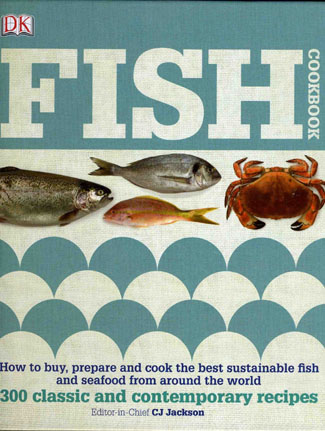
 Dorling Kindersley are famous for the quality of their reference books and one of their latest kitchen bibles is focused on the sea: the DK FISH COOKBOOK, How to buy, prepare and cook the best sustainable fish and seafood from around the world (Dorling Kindersley £20/€25).
Dorling Kindersley are famous for the quality of their reference books and one of their latest kitchen bibles is focused on the sea: the DK FISH COOKBOOK, How to buy, prepare and cook the best sustainable fish and seafood from around the world (Dorling Kindersley £20/€25).This lavishly illustrated book does what it says on the cover and is crammed with information on all aspects of fish and seafood, as well as offering over 300 recipes ranging from classics to everyday meals, and with all of the attention to detail expected of DK reference books.
And it’s fantastic value too – no wonder Irish publishers find it such tough going competing with the big international ones.
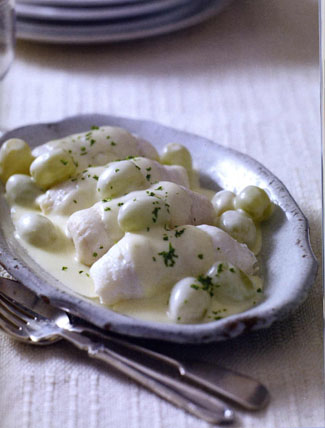 SAMPLE RECIPE: SOLE VERONIQUE
SAMPLE RECIPE: SOLE VERONIQUE“This dish, with white grapes, is part of the classic French repertoire.”
The fish: Lemon sole, or petrale sole, brill, or turbot
• PREP 30 mins • COOK 20 mins • SERVES 4
Click for recipe
Book Review - GIMME THE RECIPE
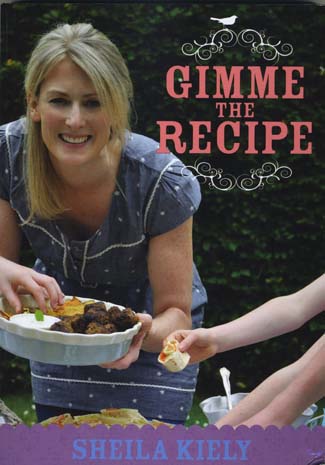
 Anyone who has six children and runs a business with her husband must have a pretty down to earth take on feeding family and friends, and countless mums all over Ireland will relate to the daily ‘what’s for dinner mum’ dilemma, and the challenge of family gatherings and having friends in for a bite described in Sheila Kiely’s Gimme the Recipe (Mercier Press, paperback €19.99).
Anyone who has six children and runs a business with her husband must have a pretty down to earth take on feeding family and friends, and countless mums all over Ireland will relate to the daily ‘what’s for dinner mum’ dilemma, and the challenge of family gatherings and having friends in for a bite described in Sheila Kiely’s Gimme the Recipe (Mercier Press, paperback €19.99). Like the phenomenally successful Donal Skehan, Sheila has come to mainstream publishing via the ‘foodie blogosophere’, specifically the popular blog www.gimmetherecipe.com, which this Cork-based food lover started after attending a food writing course at Ballymaloe in 2010.
How she has time to do that as well as all the things listed in her Introduction each day is a mystery, but her approach is supremely practical and down to earth and, like the blog, the book will doubtless become a trusted companion in family kitchens all over Ireland.
Most of the content will be familiar to regular cooks. But the aim was not to come up with a whole lot of original ideas but “…to pull together all my everyday recipes so I would have a stockpile of easily accessible solutions to the perennial problem of what to make for the hungry family.
Then I realised there are probably lots of people out there in the same boat as Deirdre [her running companion - yes, she runs too!] and myself, so I decided to compile my recipes into a book, with the aim of helping other busy parents who need something straightforward to cook that is healthy, filling and made from readily available ingredients.”
All that is spot-on thinking, and any possible lack of originality is not an issue. One of the golden rules given by Maeve Binchy to aspiring short story writers recently is ‘write about what you know’, and the same can be said of cookery books – this one will do well.
.jpg) One of about 15 recipes in the ‘Chicken Dinners’ chapter, this CREAMY CHILLI CHICKEN is a good example of Sheila Kieley’s practical approach: “I love the simplicity of using crème fraiche to quickly make a sauce for this zingy fresh-tasting dish. Full of crunchy vegetables that are briskly cooked, this highly nutritious, yet creamily comforting dish is quick and easy to prepare.”
One of about 15 recipes in the ‘Chicken Dinners’ chapter, this CREAMY CHILLI CHICKEN is a good example of Sheila Kieley’s practical approach: “I love the simplicity of using crème fraiche to quickly make a sauce for this zingy fresh-tasting dish. Full of crunchy vegetables that are briskly cooked, this highly nutritious, yet creamily comforting dish is quick and easy to prepare.”Ingredients: - serves 4-5
1 tbsp olive oil
4 skinless chicken breasts
1 garlic clove
1 red chilli
1 red pepper
1 medium red onion
½ head of broccoli (approx. 200g)
Small bunch of fresh coriander
Handful of whole baby sweetcorn
1 lemon
Handful of cashew nuts
200g crème fraiche
Method:
• Heat the olive oil in a large frying pan over a medium heat and brown the chicken on one side for 4 minutes.
• Meanwhile, peel and crush the garlic, deseed and finely chop the chilli and slice the red pepper.
• Turn the chicken breasts over and slice them lengthways into three or four strips to speed up the cooking on the second side for 2 minutes.
• Push the chicken to the sides of the pan, add the garlic, chilli and red pepper to the middle of the pan and cook for 1 minute.
• Peel, halve and finely slice the red onion.
• Chop the broccoli into florets and roughly chop the coriander.
• Add the broccoli, red onion and baby sweetcorn to the pan and cook for 2 minutes.
• Use a fine grater or a zester to zest the rind of the lemon. Add it to the pan with the juice of half the lemon.
• Add the cashew nuts and chopped coriander and mix well.
• Stir in the crème fraiche, heat through and serve with boiled baby potatoes or boiled rice.
Book Review - Saved by Cake - Over 80 Ways To Bake Yourself Happy
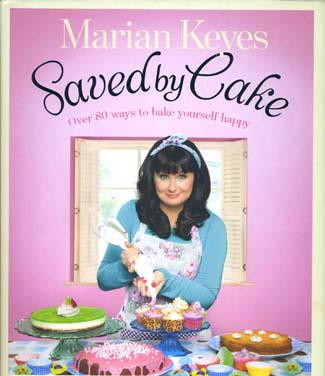
 The therapeutic nature of baking is well known - we all know that it’s a cosy and all-consuming activity that demands concentration, involves all the senses and rewards you with much more than delicious things to eat, as, above all, it gives a wonderful sense of satisfaction in a job well done.
The therapeutic nature of baking is well known - we all know that it’s a cosy and all-consuming activity that demands concentration, involves all the senses and rewards you with much more than delicious things to eat, as, above all, it gives a wonderful sense of satisfaction in a job well done. But the idea of using it as an actual therapy for an illness as serious as depression is quite another matter. Yet that’s exactly what one of our most popular writers of women’s fiction, Marian Keyes, did when none of the orthodox therapies worked for her: one day she decided to bake a birthday cake for a friend and ‘that was it’. After that she baked to get through the days, wrote down her recipes – and the result is Saved By Cake – Over 80 ways to bake yourself happy (Penguin, hardback; 230pp €15.99).
It’s a book that could help many other people in the same situation, but you don’t have to be feeling down to wat to but it and dive straight into it. It’s practical – all the basic information you need about baking equioment and techniques etc – entertaining and includes lots of classics as well as plenty of unusual recipes that Marian has developed herself.
The range of difficulty is wide “…Some are very straightforward and simple because that was all I could handle at the time and some are more complex because there were times when I needed...to concentrate hard”.
So you’ll find everything from rock cakes and buttermilk scones to banana cream pie (which involves making pastry, making a custard and a meringue), macaroons and ‘shoe and handbag biscuits’ which are a challenge to the imagination as much as test of decorating skill. And there’s even a ‘healthy section’ on baking with fruit and veg; not as strange as it sounds – try the Beetroot Cake and see for yourself!
A good book to buy for yourself, or as a gift – especially as all of the Irish royalties will be donated to the Society of St Vincent de Paul.
*If you're a keen baker, why not have a go at the Dr. Oetker Cupcake Challenge - and maybe win a holiday for two to the home of the cupcake, New York City. Entries close 30th June; details from www.cupcakechallenge.ie
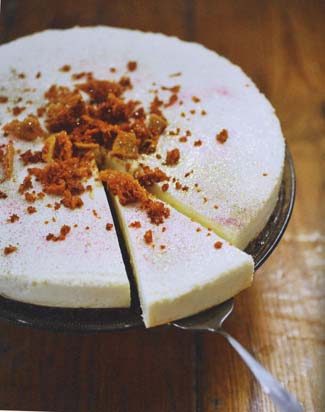 RECIPE: Fridge-Set Honeycomb Cheesecake
RECIPE: Fridge-Set Honeycomb CheesecakeThe most exciting part of this cheesecake for me was making the honeycomb. Others mightn't be as excited as me, and may decide to simply go out and buy five Crunchies. That's grand. This is a fridge-set cheesecake, which means it's not baked.
The setting agent I've used is gelatine, but it isn't suitable for vegetarians, seeing as it's made from cow's hoof or something equally unthinkable. So something else will have to be used. Agar-agar is a word I hear bandied about, but I'm afraid I don't know much about it.
Serves 10
For the base
200g home-made honey-comb (which I'll get to)
50g milk chocolate
75g butter
OR
5 Crunchie bars
75g butter
For the honeycomb
4 tablespoons golden syrup
170g caster sugar
3 teaspoons bicarbonate bof soda
For the filling
200g mascarpone cheese
200g Philadelphia cheese
50g golden caster sugar
150ml condensed milk
1 teaspoon vanilla extract
150ml whipping cream
2 sachets of powdered gelatine
To decorate
edible gold glitter (optional)
To make the honeycomb, grease a 20cm square tin. Put the golden syrup, 1 tablespoon water and the sugar into a saucepan. Start on a low heat, until the sugar dissolves, then increase. Stir hard. It will really put up a fight at the beginning. Eventually, as it heats up, it will soften.
Bring it to the boil, but watch it like a hawk because sugar is notorious for burning. Bring it down to a simmer for 5 to 10 minutes, then, add the bicarbonate of soda and the honeycomb will start foaming like a rabid dog. Stir, for the love of God, stir! The setting process has already started and you're fighting against time to get all the bicarb through before it goes hard. Mix thoroughly, or as thoroughly as you can, and don't get even an atom of it on your skin because this stuffis like napalm.
Pour into your tin, striving for a fairly even height and shape, but it won't be easy. Never mind, you will get to thump it with a mallet later for its misbehaviour. It should set in around half an hour, but if it stays sticky and tacky, rather than brittle, put it in the fridge. Block out the rest of your evening in order to wash your saucepan.
To make the base, grease a 23cm springform tin. If you're using your home-made honeycomb, put it in a plastic bag and shatter it with a mallet (reserve a little for decorating). Melt the chocolate and butter, mix with the honeycomb, then pack into the bottom of the tin and refrigerate for about an hour. Or, if you're using shop-bought Crunchies, put them in a plastic bag and bash them to smithereens.
Keep approximately one-fifth aside for decorating at the end. Melt the butter, mix with four-fifths of the Crunchies, then pack them into the prepared tin and refrigerate for about an hour. To make the filling, beat the mascarpone, Philadelphia, sugar, condensed milk and vanilla extract. In a separate bowl, beat the cream until it's stiff. Fold the cream into the cheese and sugar mix.
Prepare the gelatine by pouring 240ml hot (but not boiling) water into a bowl, then sprinkling the powder on top of the water - the powder always goes into the water, not the other way round. Whisk briskly and for ages - you'll be good and bored - until it's dissolved.
Then add it very slowly to the cream/cheese mix. Pour it on top of the set honeycomb base and put in the fridge overnight. Serve with the reserved broken honeycomb and golden glitter sprinkled over the top.
Book Review - Easy Food Home-Cook Hero
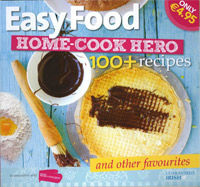
 Not so much a book review this month, more a call to cook: Easy Food Home-Cook Hero, 100+ recipes and other favourites (paperback, 146pp; Zahra Publishing, €4.95) is an action-packed little paperback based on entries submitted to the 2011 Home-Cook Hero Awards and including the winning dishes in ten categories.
Not so much a book review this month, more a call to cook: Easy Food Home-Cook Hero, 100+ recipes and other favourites (paperback, 146pp; Zahra Publishing, €4.95) is an action-packed little paperback based on entries submitted to the 2011 Home-Cook Hero Awards and including the winning dishes in ten categories. The wide range of dishes and ease of preparation make this a useful little book to have in the kitchen whether or not you’re interested in competing but, with no age limit, and categories covering everything from Tasty Pastry and Larder Luck to Special Diets and Tiny Tastes, the idea is to encourage all keen home cooks to get involved.
So, if you have a favourite recipe, why not give it a whirl – you can enter any time up to 28th September 2012 and you’ll find all the details at www.easyfood.ie/be-a-home-cook-hero/. Could be a great way to keep the kids busy through the long summer holidays …
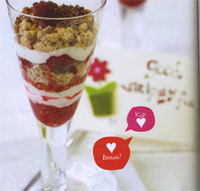 This pretty anytime recipe for Good Stripey Fun is from 7-year old Holly Meehan of Gorey, Co Wexford, who says “It looks cool. It tastes lovely too, and is sooo easy and fun to make. Even though there is chocolate in it, mum says it’s still good for me. It’s better than any breakfast I know! You could eat it at any time as a healthy snack.”
This pretty anytime recipe for Good Stripey Fun is from 7-year old Holly Meehan of Gorey, Co Wexford, who says “It looks cool. It tastes lovely too, and is sooo easy and fun to make. Even though there is chocolate in it, mum says it’s still good for me. It’s better than any breakfast I know! You could eat it at any time as a healthy snack.” Serves 4
400ml natural yoghurt
175g fresh raspberries or frozen summer fruits (defrosted); reserve 12 for decoration
2 tbsp icing sugar
125g granola
75 hazelnuts, toasted and chopped
50g dark chocolate, grated
1 Combine raspberries and icing sugar in a bowl and crush with a fork.
2 Spoon a little yoghurt into each of four serving glasses.
3 Add a layer of granola and chopped nuts.
4 Divide the raspberries between the glasses.
5 Add a further layer of yoghurt, then granola and chopped nuts.
6 Top with a layer of grated chocolate and decorate with reserved raspberries.
7 Cover with clingfilm and chill until ready to serve. Enjoy!
Book Review - The Chef & I, a nourishing narrative
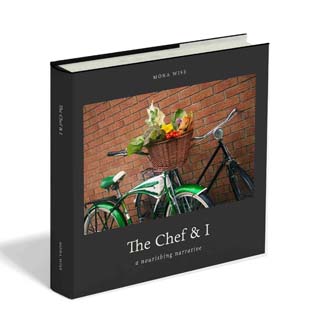
 The Chef & I, a nourishing narrative (WiseWords Ltd, hardback, 178pp, full colour, €25; eBook €4.99)
The Chef & I, a nourishing narrative (WiseWords Ltd, hardback, 178pp, full colour, €25; eBook €4.99)The world of publishing is all topsy-turvy these days and, while book sales are generally in sharp decline – due mainly, we are told, to the rise of the internet and related areas - we see a growing number of bloggers successfully publishing books.
Donal Skehan was the first food blogger to make an impression in print in Ireland but there have been plenty since and one of the most recent is popular Galway-based blogger, Móna Wise (www.wisewords.ie), who had an established following awaiting the arrival of her first book The Chef & I. Self-published in May by Móna and her husband, Ron Wise it’s a very attractive, professionally produced book – and it’s greatly to their credit that it’s all-Irish with everything, including the printing, done in Galway.
 The market, by contrast, is international. Móna spent 15 years in America before returning to Galway to settle with her American husband Ron (‘the Chef’) and bring up their family here, and the book – which is sold online by kennys.ie and wisewords.ie and also available as an eBook - has a distinctly trans-Atlantic tone with American spelling and US measurements in the recipes.
The market, by contrast, is international. Móna spent 15 years in America before returning to Galway to settle with her American husband Ron (‘the Chef’) and bring up their family here, and the book – which is sold online by kennys.ie and wisewords.ie and also available as an eBook - has a distinctly trans-Atlantic tone with American spelling and US measurements in the recipes. But the forty or so recipes are only half of the book which is, as the subtitle ‘a nourishing narrative’ implies, the story of Móna and Ron. It’s a love story with a food interest – how they met, their developing relationship, the restaurant they ran together in the States, their adopted family, meals shared with family and friends, and their food philosophy ‘growing and cooking wholesome, local, fresh and organic food’ just half a mile from the place where Mona grew up.
These days Ron – a graduate of the Culinary Institute of America who has ‘always allowed gardening and food to anchor him’ – cooks in Morton’s of Galway in the mornings and will be found looking after his chickens and ducks or building a swing for the kids in the afternoon.
This book is in fact Mona’s third-year university project – she has one year to go of a four year (BA-Connect Degree) course at NUIG studying German, English Literature with a specialism in Creative Writing - with Eoin Purcell acting as her editor. It’s a fine production and it’s not a bit surprising that she now has her own column with The Sunday Times.
And Móna – who describes herself in the book as ‘a five year plan person’ – has ambitious plans - this book will be followed by The Chef & me ... with kids (2013), and then The Chef & me ... Breakfast and Bread (2014). Once Móna graduates from college the couple plan to ‘shift gears a little’ and will work on a much bigger project, titled Cooking away with Patience Gray, which will be a hardback coffee table-style book (2016). Much for their many fans to look forward to.
 RECIPE: Cioppino
RECIPE: CioppinoFEEDS 4 ADULTS
When I take that first bite or even just a quick lick of the spoon as he is making the sauce I know instantly, from looking at the color and inhaling the scent, that the next thing that passes through my lips will be my favorite from now until eternity. This is exactly how I feel when I taste this dish.
The smell of the garlic from the sauce, the rich redness of the tomatoes, the inviting orange hue of saffron and the shocking green contrast of parsley thrown in at the last minute. It begs to be savored. It cries out for attention and with magnetic force the spoon goes from hand to pot. I could stop right there. I should stop right there.
Hello, my name is Mona. I am a cioppino addict. Welcome to the club! Oh, and if this is a new dish you are adding to. your repertoire then it is pronounced 'Chuh-peano'. Devour the deliciousness of it all.
INGREDIENTS: Saffron broth
1 bay leaf
3 cups [720 ml] water
Fish bones
Trimming from a bulb of fennel
1/2 cup [120 ml] white wine
Pinch of saffron
Salt
Pepper
METHOD
Place all ingredients into a pot and bring to the boil.
Simmer for 30 minutes then strain.
INGREDIENTS: Tomato fennel sauce
2 onions — diced
4 cloves of garlic
1/2 tsp dried chili flakes
1/2 cup [60 g] celery - diced
1 whole bulb of fennel - diced
1 cup [120 g] chopped tinned tomatoes
2 tbsp butter
2 tbsp parsley, chopped
METHOD
In a large pan sauté the onions, garlic, chili flakes, celery and fennel in a dash of olive oil.
Add in the tomatoes and then finish with the butter and parsley.
INGREDIENTS: Cioppino
1 Ib [450 g] assorted fish
1 Ib [450 g] bag of mussels, scrubbed clean and de- bearded
1 Ib [450 g] clams, scrubbed clean
8 oz [225 g] calamari, cut into rings
3 cups [720 ml] of saffron broth
All of the (above) tomato fennel sauce
A handful of chopped parsley
METHOD
Remove the tomato fennel sauce from the pan and set aside.
Add all the fish and shellfish to the pan and allow to cook for a minute or two. Add the sauce back in and then add the saffron broth too.
Let it simmer until the fish is tender and all the shells have opened. (If they do not open after ten 10 minutes they are duds, throw them out).
If the broth and sauce mixture is too soupy, then strain off the liquid and reduce it in another pan for a few minutes.
Finish with 1 tablespoon of butter and a handful of chopped parsley.
Serve in a large bowl with a loaf of homemade garlic bread.
WiseNotes
Best served with a crisp white wine but beer works too. If you want to make it spicier then add more heat to the tomato fennel sauce. You can be flexible with the fish. I love monkfish with this dish. Do not use smoked fish.
Book Review - Ard Bia Cookbook
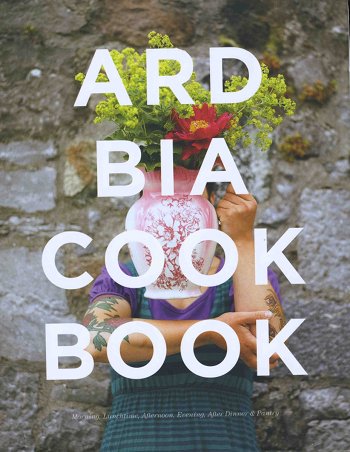
Ard Bia Cook Book  (Atrium, hardback 328pp, €39/£35).
(Atrium, hardback 328pp, €39/£35).
In his foreword to the Ard Bia Cookbook, travel writer Manchán Magan ponders, “If Druid is the mind of Galway, Salthill its lungs and Tigh Neachtain’s its kidneys, might Ard Bia be its soul?”
It’s a good question. Certainly many people would think of this delightful spot as the city’s heart, both for its lovely waterside location in one of the city’s oldest, most characterful and historically interesting buildings right beside Spanish Arch – and for the extraordinary cosmopolitan mix of influences and talents that owner Aoibheann Mac Namara has brought to this atmospheric place. Although originally from Co Donegal and with vibrant connections in Europe, including an art gallery in Berlin, Aoibheann is very much an honorary Galwegian and has thrown herself into the life and culture of the city with great style.
But perhaps Ard Bia is more like a room in a house and, if so, it would have to be the cosy and welcoming kitchen of an Irish cottage, with its apparently artless eye-appeal and aromas of wonderfully wholesome food promising comfort and conviviality - food for the body and soul, in equal measure.
Whatever the verdict, Ard Bia is certainly one of Galway’s best-loved restaurants and a beautiful book to celebrate its tenth anniversary is very welcome. Publisher Mike Collins of Cork University Press has earned a reputation for outstanding Irish-interest books, notably in the food area, and this is another one with all the hallmarks of quality production.
A handsome book that’s as much a pleasure to handle as it is to read, it’s clearly special - and the team behind it is awesome, including not only Aoibheann herself and her talented restaurant team, but also the highly regarded food writer Aoife Carrigy and a whole rake of other special contributors from Ireland and abroad.
The formidable line up ranges from photographer James Fennell, (widely known for his poignant ‘Vanishing Ireland’ books, with historian Turtle Bunbury), several other photographers and artists and a diverse collection of related talents covering design, art direction, food styling and editing as well as hands-on food contributions including recipe creation and cooking, of course, but also less likely examples like wild food foraging.
Yet, impressive as all that may be, the real value of the Ard Bia Cookbook lies in its versatility, practicality and the creativity with which it celebrates the wonderful produce of the Galway region. Accurately flagged as ‘A unique family-friendly cookbook, a source of inspiration for modern healthy living, a keepsake for loyal fans of the restaurant, a memento for visitors to Galway, a celebration of the enduring energy of Ard Bia and all involved in it’, it’s quirky and stimulating – but, like the restaurant itself, never at the cost of the real business of the day: good cooking.
The main chapters capture the mood and foods of Ard Bia at different times of day – Morning, Lunchtime, Afternoon, Evening and After Dinner – but a very substantial amount of space, perhaps a third of the book, is given over to a series of Pantry sections and this, with its attention to basics and ‘All the little touches that transform food from good to great’, is my favourite part of the book...
Here you will learn – or be reminded of – all the little things that lift apparently simple restaurant dishes into the ‘special’ category: herbs, spices, seasonings; flavoured butters, sauces; the foraging year; many rewarding ways of preserving fruits and vegetables; important basics that are all too often side stepped by shortcut cooks, including stocks and baking techniques...
Whether it’s used as a beginner’s manual or a handy reference for the experienced cook, the Pantry is the engine room of the Ard Bia cookbook and the reason why – even in the unlikely situation that the main recipe section should never be used at all – it’s sure to become a well-thumbed favourite in any kitchen lucky enough to have it on the bookshelf.
SEASONAL RECIPE SELECTION:
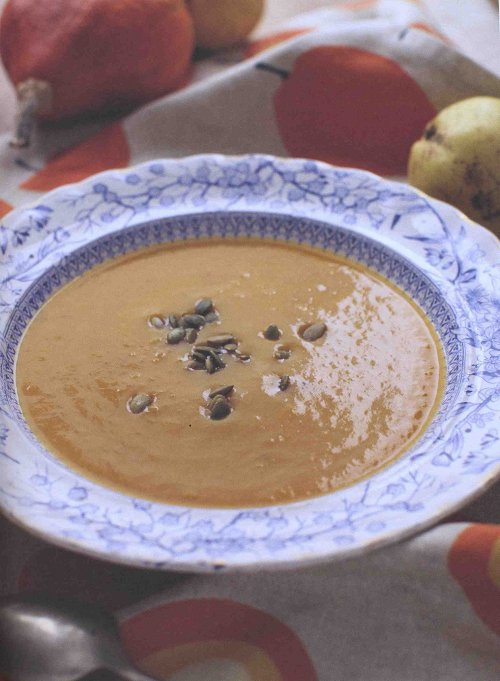 AUTUMNAL SQUASH SOUP
AUTUMNAL SQUASH SOUP
This warming soup is a favourite consolation in Ard Bia when the days are getting shorter, the evenings crisper and summer has finally slipped into autumn. Butternut squash and pumpkin are the most readily available, but farmers' market stalls often have interesting varieties of squash, each with their own unique flavour.
3-4 tbsp olive oil
2 onions, diced
5 garlic cloves, bashed with the
flat of a knife and peeled
2 tsp cumin seeds
1 thumb-sized piece of fresh
ginger, peeled and finely chopped
salt and pepper, to taste
1 carrot, peeled and roughly diced
2 sticks celery, roughly chopped
1 pinch of cayenne pepper (optional)
1.2kg / 2.61bs squash of choice, peeled and de-seeded (butternut squash or pumpkin are the most common)
1 litre / 2 pints vegetable stock
Tastes great with:
1 handful toasted pumpkin seeds
3-4 handfuls fresh coriander (optional)
Serves 4-6
Heat a large heavy-based pot over a medium heat and add the olive oil, diced onion, bashed garlic, cumin seeds, ginger, salt and pepper, carrot and celery along with the cayenne pepper, if using. Sweat over a low to medium heat
until the onion and vegetables soften a little and the cumin seeds are toasted.
When you think you have enough flavour in your pot - the change in colour is a clue but you'll know by the delicious aromas - add your chosen member of the squash family.
Barely cover with stock, cover with a lid and allow to simmer until the squash is cooked, about 20-25 minutes, although it will depend on what type of squash you use, so check by piercing with a knife. Allow to cool a little before blending. Add a little water if the soup needs thinning.
Check the seasoning for taste and serve garnished with toasted pumpkin seeds or fresh coriander.
Tip: Bashing a clove of garlic, instead of finely chopping or crushing it, will coax out sweeter, milder flavours rather than a more fiery heat. Don't worry about leaving them whole, as you'll be blending the soup.
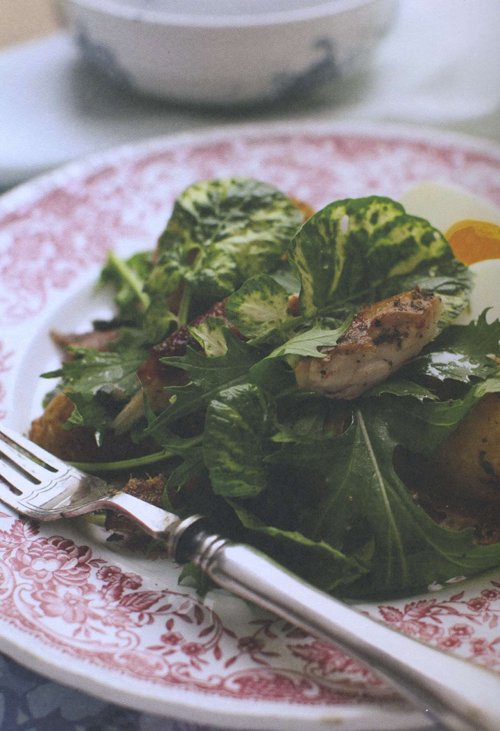 BURREN BRUNCH OF SMOKED TROUT, POTATO AND LANDCRESS
BURREN BRUNCH OF SMOKED TROUT, POTATO AND LANDCRESS
This brunch dish is pure west of Ireland. We use smoked fish from the Burren Smokehouse in Lisdoonvarna, County Clare, and dress it with Steven Gould's exquisite landcress grown in Corrundulla, just outside Galway city. You can try it with smoked mackerel and watercress for more robust flavours.
Serves 4-6
4-6 large eggs
16-20 new potatoes
1 tbsp butter
2-3 tbsp rapeseed oil
2-3 butterflied fillets of smoked trout,
250g / lOoz mixed peppery leaves (landcress and mizuna are great)
2 handfuls each parsley and dill, chopped
Tastes great with: lemon aioli (see below)
LEMON AIOLI
1 egg yolk
1 whole egg
1 tbsp Dijon mustard
1 tbsp wholegrain mustard
2 garlic cloves, crushed
1 tbsp white wine vinegar
250ml / 8.5fl oz rapeseed oil
250ml / 8.5fl oz sunflower oil
1/2 lemon, juice only
First make the lemon aioli: Beat eggs, mustards, vinegar and garlic together with a tablespoon of water in a food processor (or in a bowl with a whisk).
With the processor still running gradually drizzle in the oils. It is important to take your time at this stage so that the mayonnaise doesn't split. Once the mix begins to thicken, the oil can be added a little faster.
Next boil the eggs: Judging the timing for the perfect soft-boiled egg will depend on the size of your eggs. Bring a pot of water to the boil, add the eggs and boil for about six minutes for large eggs. Then plunge into cold water to arrest the cooking, peel and halve. The yolk should be just set but still moist. If you prefer it runny, cook for a minute less; likewise if your eggs are smaller.
Cover the new potatoes in plenty of cold, salted water and bring to the boil. Reduce to a simmer and cook gently until a knife slides easily through. Allow to cool, and quarter.
In a medium frying pan melt a large knob of butter over a medium heat and add a splash of oil. When good and hot, add the potatoes and cook for a few minutes to gently brown, then flake the smoked trout into the pan and mix
well. Season lightly, as the trout can be salty.
Just before removing from the heat, throw in the landcress and herbs and toss it all together to wilt the leaves a little. Serve with the boiled eggs, halved, and a good dollop of aioli.
Tip: Eggs have an air pocket between the outer shell and inner membrane which expands as the eggs age (which is why stale eggs float in water). Pricking an egg's base before boiling allows hot air to be released without the shell cracking, and will make the egg easier to peel.
Finish by adding a little lemon juice at a time, checking until the desired taste is achieved. Season and loosen the aioli with a little warm water if the consistency is too thick.
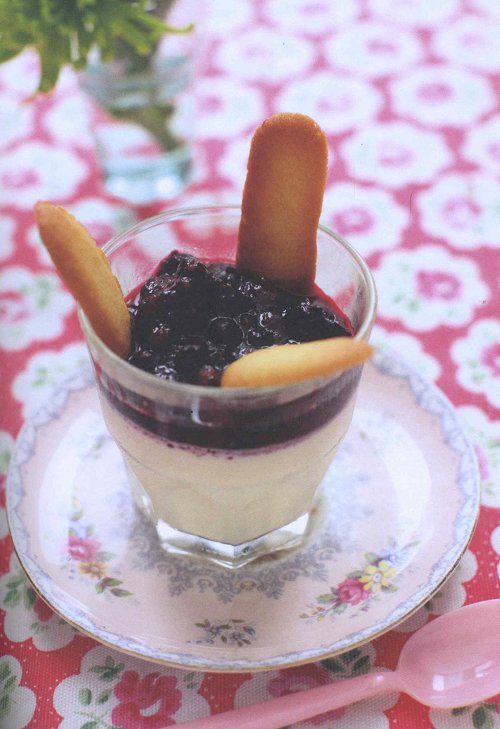 LEMON POSSET
LEMON POSSET
The posset is making a bit of a comeback. Now a simple set creamy dessert, it gets its name from a nineteenth-century drink of wine-curdled spiced milk. A cinch to make, the posset packs quite a punch especially if topped with a fruity compote.
500ml / 17fl oz fresh cream
150g/6oz sugar
2 lemons, juice and zest
For the berry compote:
200g / 7oz mixed berries (blackberries, raspberries, blueberries, elderberries, etc)
150g / 6oz sugar (or extra if berries are very sharp)
100ml/4floz water
1 handful lemon balm leaves, chopped (optional, but great with dark berries)
Serves 4-6
Bring the sugar and cream to the boil, turn the heat down and simmer for three minutes. Take off the heat and allow to cool.
Once cool, whisk in the lemon juice and zest and beat thoroughly for about two minutes. Pour into clean jars or glasses and leave in the fridge to set for three to four hours.
Before you make the compote, taste one or two berries to check for sweetness - if they're rather tart you may want to add a little extra sugar. Combine the berries, sugar and water in a small saucepan, bring to the boil and reduce to a simmer. If you have managed to get, your hands on some lemon balm, add the chopped leaves at this stage.
Cook just until the sugar dissolves and the fruit has softened but not pureed, about 10 minutes depending on the type and ripeness of the berries. Check the sweetness of the compote, adding a little more sugar if necessary (you may want to dissolve it in a little hot water and add as a sugar syrup to ensure it is fully dissolved).
Allow to cool before pouring a little on top of each of the set possets. We like to serve these with little biscuits on the side.
Tip: Diced rhubarb also makes for an interesting seasonal compote, although you'll need to be more generous with the sugar and with the cooking time to soften the fruit.
Cook Book Reviews

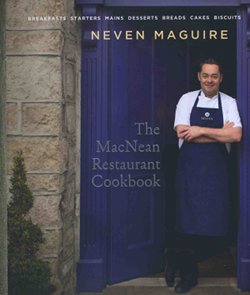 The Christmas crop of food books is exceptionally heavy this season - I was tempted to test this, literally, on the bathroom scales as there’s been a move towards posh hardbacks since the recession started and the difference in weight is very noticeable.
The Christmas crop of food books is exceptionally heavy this season - I was tempted to test this, literally, on the bathroom scales as there’s been a move towards posh hardbacks since the recession started and the difference in weight is very noticeable.
Not great news for the postman perhaps but, on the upside, these weighty tomes are impressive enough to make extremely presentable gifts for very little money – and any of the books featured here would fit the bill handsomely. High productions standards and great photography (often including evocative background imagery of Ireland and Irish life) are among the features that make them especially covetable – and, my, isn’t the young photographer Joanne Murphy quite the star this year?
Of the Irish interest cookbooks, top of my pile has to be Neven Maguire’s new book The MacNean Restaurant Cookbook (Gill & Macmillan, hardback €24.99) which celebrates 30 years of his family’s iconic restaurant in Blacklion, Co Cavan. It’s a special tribute to his late mother, the wonderful Vera, who first taught him to cook and was a huge influence, instilling in him many of the principles that became his driving passion and the reasons for his extraordinary success. Vera worked in the kitchen with him until 2001 when he took over the family business, which he now runs with his wife Amelda and a dedicated young team that he values highly – and praises to the rooftops at every available opportunity. For more on this remarkable book see this month’s main Cookery Feature.
Books produced for charity are particularly special and one that would make a beautiful Christmas present is SABA: The Cookbook (published by SABA, hardback €30 from Saba, Saba To Go, Easons other good bookshops). Written by owner and former RAI (Restaurants Association of Ireland) president, Paul Cadden and executive chef Taweesak Trakoolwattana (Tao), it is not only a lovely collection of authentic Thai and Vietnamese dishes but also the story of Saba’s first five years; all proceeds go to The Bone Marrow Transplant Unit in Our Lady’s Children’s Hospital, Crumlin and to The Thai Red Cross Society.
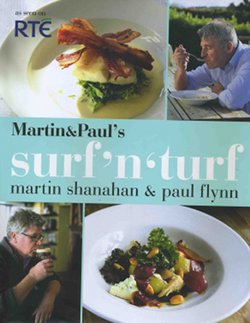 Martin Shanahan and Paul Flynn’s Martin&Paul’s Surf’n’Turf (Quadrille hardback £17.99/€22.99; photography by Simon Wheeler) is just what’s needed to get more of us into the kitchen and, I suspect, will have particular appeal to male cooks which is all to the good. Martin and Paul, respective proprietors of Fishy Fishy Restaurant & Café in Kinsale Co Cork and the Tannery restaurant and cookery school in Dungarvan, Co Waterford, were both well-established and highly respected chefs long before they hit the small screen but it’s the runaway success of RTE’s ‘Martin’s Mad About Fish’ and, more recently, ‘Martin&Paul’s Surf’n’Turf’ that has put the spotlight on them. And how fortunate it is for Ireland’s cooks that things have turned out this way, as both are great champions of seasonal local produce and their cooking style is gutsy and down to earth. For samples of two typically accessible dishes, see this month’s In Season (hill lamb) and Special Irish Foods & The People Who Make Them (Gubbeen bacon).
Martin Shanahan and Paul Flynn’s Martin&Paul’s Surf’n’Turf (Quadrille hardback £17.99/€22.99; photography by Simon Wheeler) is just what’s needed to get more of us into the kitchen and, I suspect, will have particular appeal to male cooks which is all to the good. Martin and Paul, respective proprietors of Fishy Fishy Restaurant & Café in Kinsale Co Cork and the Tannery restaurant and cookery school in Dungarvan, Co Waterford, were both well-established and highly respected chefs long before they hit the small screen but it’s the runaway success of RTE’s ‘Martin’s Mad About Fish’ and, more recently, ‘Martin&Paul’s Surf’n’Turf’ that has put the spotlight on them. And how fortunate it is for Ireland’s cooks that things have turned out this way, as both are great champions of seasonal local produce and their cooking style is gutsy and down to earth. For samples of two typically accessible dishes, see this month’s In Season (hill lamb) and Special Irish Foods & The People Who Make Them (Gubbeen bacon).
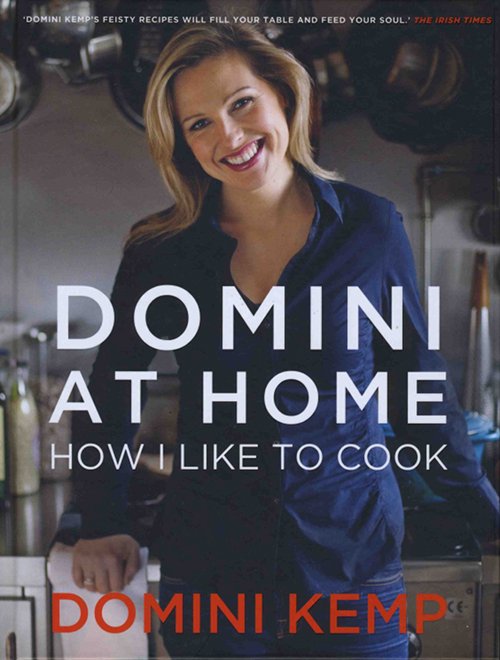 Together with her sister Peaches, Domini Kemp runs the popular Itsa…restaurants (and other food companies) and her food column in the Irish Times Magazine has a great following, so her third cookbook, Domini at Home – How I Like to Cook (Gill & Macmillan hardback €22.99) will be eagerly snapped up by fans who enjoy her honest, no-nonsense style and her way of simplifying dishes to get them on the table faster without compromising on taste. And, clearly conscious of the fact that so many cookery books end up being mainly ornamental, she wants her recipes to ‘encourage everyone get out the knives and cooking board and cook some dinner.’ Joanne Murphy’s photographs show the stylish do-ability of Domini’s dishes, and it’s especially great to see dishes that will do two nights (or next day’s lunch boxes) and, unusually, a good range of vegetarian dishes too.
Together with her sister Peaches, Domini Kemp runs the popular Itsa…restaurants (and other food companies) and her food column in the Irish Times Magazine has a great following, so her third cookbook, Domini at Home – How I Like to Cook (Gill & Macmillan hardback €22.99) will be eagerly snapped up by fans who enjoy her honest, no-nonsense style and her way of simplifying dishes to get them on the table faster without compromising on taste. And, clearly conscious of the fact that so many cookery books end up being mainly ornamental, she wants her recipes to ‘encourage everyone get out the knives and cooking board and cook some dinner.’ Joanne Murphy’s photographs show the stylish do-ability of Domini’s dishes, and it’s especially great to see dishes that will do two nights (or next day’s lunch boxes) and, unusually, a good range of vegetarian dishes too.
RECIPE: Domini’s Leek & Bread Pudding
“I love a good veggie dish that works as both a one-pot supper wonder and as part of a Sunday lunch affair instead of spuds, which, while I adore them, I get fed up with every now and then.
This leek pudding comes from Thomas Keller of The French Laundry, though in his one he uses brioche, which I replace with a good-quality white loaf. I imagine the brioche cubes would make it even more luscious and rich, but to be honest the plain ones work really well.
I highly recommend serving it on its own midweek or as part of something more lavish on a Sunday. It would be gorgeous with roast chicken, I bet.”
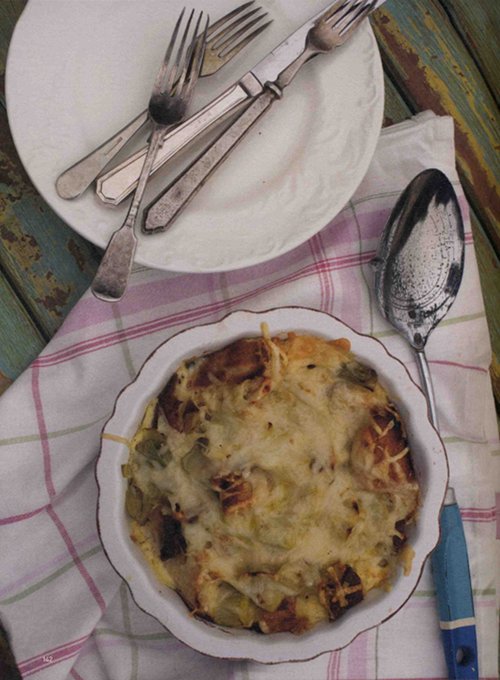 Serves 6-8
Serves 6-8
6 really big leeks
50 g butter
Olive oil
Salt and pepper
3 cloves garlic, peeled and sliced
Few sprigs thyme
1 loaf decent white bread (about 600 g)
500 ml milk
500 ml cream
3 eggs
Pinch nutmeg (optional)
250g Gruyère OR Cheddar cheese, grated
Preheat the oven to 170°C.
Chop the leeks into 2-3 cm slices and then sweat with the butter and a splash of olive oil in a large saucepan with a lid on it for 10 to 15 minutes until good and soft.
Season really generously, and add the garlic and thyme.
While this is cooking, cut the bread into 3 cm cubes and bake in the oven for 10 minutes or so until golden brown. I would also season these lightly. Beat together the milk, cream and eggs. You can grate or add a pinch of nutmeg to this if you like.
When the leeks are good and soft, add the toasted bread cubes, mix well and then spoon into a suitably sized gratin dish. The leeks should come quite high up the dish, but you do need to allow for the cream mixture to go in, so leave enough room. Pour the cream mixture on top and then top with cheese. Leave it for 15 minutes to an hour or so, to soak.
Bake for about an hour until the top is golden brown. Allow to cool a little so the filling can settle, and then serve.
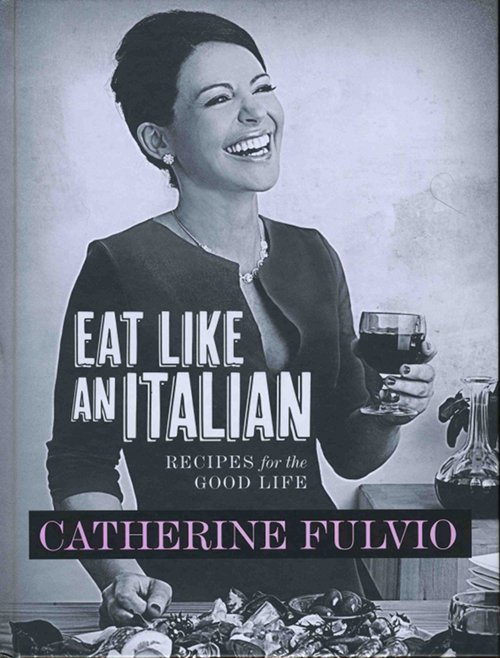 Fans who love the warm style and accessible recipes of Catherine Fulvio, the bubbly TV chef and proprietor of Ballyknocken Cookery School and B&B in Co Wicklow, will relish Eat Like An Italian (Gill & Macmillan hardback, €22.99) which expands on the links between Irish and Italian culture that she has developed through her husband, Claudio, and his family.
Fans who love the warm style and accessible recipes of Catherine Fulvio, the bubbly TV chef and proprietor of Ballyknocken Cookery School and B&B in Co Wicklow, will relish Eat Like An Italian (Gill & Macmillan hardback, €22.99) which expands on the links between Irish and Italian culture that she has developed through her husband, Claudio, and his family.
This book is a celebration of the Italian philosophy that puts ‘the good life’ first, with food a top priority – and, as she points out, Italy is one of the slimmest nations in Europe and the Mediterranean diet is arguably the healthiest in the world...
Typically, Catherine encourages us to embrace the Italian lifestyle and food culture by using our own local seasonally fresh produce, prioritising our mealtimes by making them routine and including friends and family, taking daily exercise and a drink in moderation. Sounds good to me – and with great photographs by Harry Weir, everything looks good as it promises to taste.
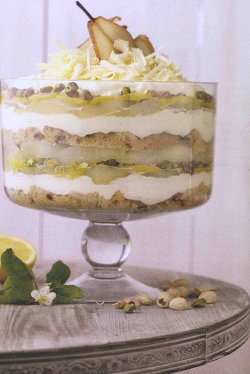 RECIPE: Catherine Fulvio’s Lemon & Panettone Trifle
RECIPE: Catherine Fulvio’s Lemon & Panettone Trifle
ZUPPA INGLESE Dl LIMONE E PANETTONE / SERVES 4-6
“There always seems to be some panettone left over, delicious as it is. it can dry out, so this is a good way to use it with sweet results. When poaching the pears, try adding a few pieces of lemon zest. It not only gives a wonderful flavour to the stock syrup, but helps to keep the pears from discolouring.”
Catherine gives a slightly ‘Irish’ version of panettone in ‘Eat Like An Italian’ and this refreshing trifle is the perfect partner. Her Keeping it Local hints are a welcome feature of the book, although you would be hard pushed to find Coisreal Longueville to poach the pears in these days – alternatively you could use their beautiful new Longueville House Cider, or of course a light Italian white wine.
3 pears, peeled, cored and sliced into wedges
100g caster sugar
400ml water
100g mascarpone
120ml natural yoghurt
120ml cream
1 lemon, zest only
5 tbsp icing sugar
100ml poaching syrup from the pears
3 tbsp amaretto
8-10 slices of panettone
2 tbsp chopped pistachio nuts, plus extra to decorate
white chocolate shavings to decorate
1 To poach the pears, heat the sugar and water in a saucepan until the sugar has dissolved. Add the pears and simmer for about 15 minutes, until cooked through. Set aside.
2 Lightly whip the mascarpone, yoghurt, cream, lemon zest and icing sugar together in a bowl.
3 In a separate bowl, combine the poaching syrup and amaretto.
4 Layer a few slices of pear in- pretty glasses or a large trifle bowl and spoon over the lemon yoghurt cream. Add a layer of panettone, drizzle over some of the amaretto poaching liquid and sprinkle over a few nuts. Continue layering, ending with the yoghurt mascarpone cream.
5 Decorate with pear slices, white chocolate shavings and a few nuts.
KEEPING IT LOCAL: Select a few great-looking conference pears at the market stand. Poach in Coisreal Longueville, a delicious crisp white wine from the O'Callaghan family in Longueville House, Cork.
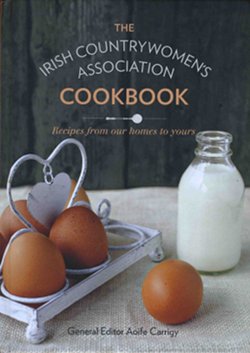 Casual browsers may be surprised to find Edward Hayden among contributors to the The Irish Countrywomen’s Association Cookbook (Gill & Macmillan hardback, €22.99), but the popular Kilkenny chef is so well known to members from the ICA events that he supports that he’s earned his stripes as a sort of ‘honorary member’... Which is a comfortable place to be as the ICA has been associated with good food in Ireland for over a century, and especially since 1947 when they set up the famous network of country markets to sell home-produced food – which are still going strong today.
Casual browsers may be surprised to find Edward Hayden among contributors to the The Irish Countrywomen’s Association Cookbook (Gill & Macmillan hardback, €22.99), but the popular Kilkenny chef is so well known to members from the ICA events that he supports that he’s earned his stripes as a sort of ‘honorary member’... Which is a comfortable place to be as the ICA has been associated with good food in Ireland for over a century, and especially since 1947 when they set up the famous network of country markets to sell home-produced food – which are still going strong today.
“Think of it as akin to having not just your own mammy on speed dial, but rather a whole host of mammies and grannies from all over the country, each sharing their own words of wisdom and precious first hand experiences.” That reassuring thought should alone be enough to make this book a best seller, and why not. It’s the first national ICA cookbook produced by this much-loved national institution – and, knowing that ‘In today’s busy modern lives, the importance of a family meal cannot be overstated’ it will surely prove, as they say themselves, ‘an invaluable resource for the next generation of home-makers: those novice cooks who might call home for that foolproof recipe might now reach for this book instead.’
Professionally produced, with Aoife Carrigy as General Editor and photography by Joanne Murphy, you’ll find a pleasing collection of ICA members’ favourites old and new, many of them handed down through generations – and including some festive treats such as Roast Goose With Damson & Apple Sauce (Brid Malone, Laois) and an Egg-Free Christmas Pudding (Mary Fitzgerald, Wexford).
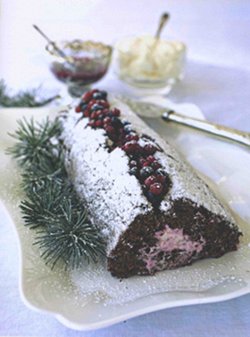 ICA Cookbook RECIPE: Cranberry & Chocolate Roulade
ICA Cookbook RECIPE: Cranberry & Chocolate Roulade
Recipe from: Brid Malone, Laois. Mother of five, walker and swimmer.
“The tart cranberries give this chocolate roulade a refreshing edge after a rich meal. I like to serve it after my Christmas dinner of roast goose with damson sauce (recipe given in book) but really it is delicious any time of year. This recipe won first prize in the 1998 ICA All-Ireland Christmas Recipe Competition.” Serves 8-10
4 eggs, separated
140g (5oz) sugar
40g (1½ oz) cocoa powder
for the filling
225g (8oz) fresh cranberries (or frozen, defrosted fully)
3 tablespoons orange juice
85g (3oz) caster sugar
275ml 1/2 pint) cream, whipped stiffly
2 tablespoons Grand Marnier
to garnish
icing sugar
sprig of holly
mixed frozen berries defrosted (optional)
You will need
20cm x 30cm (8in x 12in)
Swiss roll tin
1. Preheat oven to 180ºC/350ºF/Gas 4. Grease Swiss roll tin and line with baking parchment.
2. In a large bowl, whisk egg yolks with sugar until pale in colour and very thick and light in texture. Sieve over the cocoa and gently fold in using a metal spoon.
3. Whisk the egg whites until just stiff but not dry. Fold a third of this into the roulade mix. Repeat with the second third, and finally fold in the remaining egg white. Pour into prepared tin and bake in preheated oven for 18-20 minutes or until well risen and springy to touch. Cover with a damp tea towel and leave to cool in tin.
4. To make the filling, gently simmer the cranberries, orange juice and sugar in a saucepan for about 10 minutes or until tender. Remove from the heat and allow to cool before folding into the whipped cream together with the Grand Marnier.
5. Turn the cooled roulade onto a sheet of baking parchment dusted with icing sugar. Trim the edges and spread the cream mixture over the roulade. Roll up gently but don't worry if it cracks slightly.
6. Chill for at least two hours before serving. Dust with more icing sugar and decorate with defrosted berries and a sprig of holly.
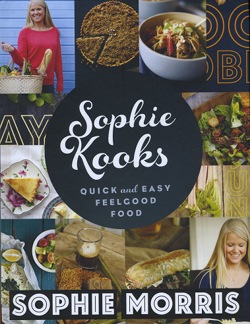 Co-founder of Kooky Dough, a young company that makes deliciously natural cookies-to-bake-quickly-at home, Sophie Morris and her business partner, Graham Clarke, famously turned down investment offers on ‘Dragons’ Den’ a while back - and then went on to make a huge success of their business.
Co-founder of Kooky Dough, a young company that makes deliciously natural cookies-to-bake-quickly-at home, Sophie Morris and her business partner, Graham Clarke, famously turned down investment offers on ‘Dragons’ Den’ a while back - and then went on to make a huge success of their business.
Sophie Kooks Quick and Easy Feelgood Food (Gill & Macmillan, hardback €22.99) is Sophie’s first book and the same principles of speed and quality applied to her business are seen in her approach to home cooking. She says that making a nourishing home-cooked meal every day is key to staying on top of her hectic life: ‘Why reach for the take-away menu when you can assemble Dad’s Chinese Beef in minutes?’ A girl after my own heart.
And, while emphasising that she is not a chef, she is a graduate of Ballymaloe Cookery School and this 28-year old knows her stuff. I like a lot of things about this attractive book, especially the month-by-month format which helps cooks in hurry to work with the seasons.
Most of the recipes are in the ‘real food’ camp, so these cupcakes are not a very typical choice (and, personally, I think we’re cup-caked out at this stage), but they are a very pretty variation on Christmas baking.
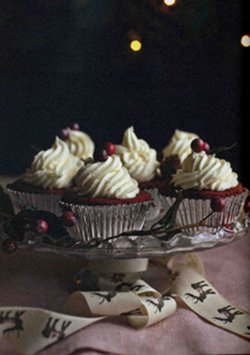 RECIPE: Sophie’s Christmassy Red Velvet Cupcakes
RECIPE: Sophie’s Christmassy Red Velvet Cupcakes
It's not so much the taste of these cupcakes but the look of them that makes them so Christmassy. The gorgeous, deep-red colour of the sponge alongside the snow-white cream cheese icing makes the cupcakes seem very luxurious. Perfect little Christmas treats...
65g butter, softened (preferably unsalted)
155g caster sugar
1 large egg
½ teaspoon vanilla extract
1 tablespoon cocoa powder
2 tablespoons red food colouring
120ml buttermilk, divided
150g plain flour
½ teaspoon baking powder
salt
1 teaspoon white vinegar
½ teaspoon bread soda (bicarbonate of soda)
For the icing
300g icing sugar, sieved
50g butter, softened (preferably unsalted)
120g cream cheese
Preheat the oven to l80ºC/350'F/gas 4. Line a muffin tin with 12 paper cases.
Cream the butter and sugar in a large bowl with an electric beater, until pale and fluffy. Add the egg and vanilla extract and beat until combined.
In a small bowl, mix the cocoa powder with the food colouring to make a very thick paste. Add this paste to the butter and egg mixture, and beat well to combine. Pour in half the buttermilk and beat again until well combined.
Sift the flour, baking powder arid a pinch of salt into another bowl. Pour half this flour mix into the batter in the large bowl and beat well. Add the remaining buttermilk and beat again. Now add the remaining flour mix and beat well for a few minutes.
Place the vinegar and bread soda in a small bowl and stir to combine. Add this mixture to the cake hatter and beat well for a few minutes.
Use a spoon to divide the cake batter evenly among the baking cases, so that they are two-thirds full. Bake fo r20 minutes, until springy lo the touch and a skewer inserted comes out clean. Leave the cupcakes to cool in the tray for a few minutes before removing them to a wire rack.
Meanwhile, make the icing. Beat the icing sugar and butter in a medium bowl with an electric beater until combined. Add the cream cheese and beat again. Beat the mixture for about 5minutes to get a really fluffy, pale icing.
When the cupcakes have cooled fully, dollop a spoon of icing on top of each one. Spread the icing but make sure you don't cover the cupcakes completely the pretty red sponge must be visible.
You could also use a piping bag to put a pretty swirl of icing on top of each cupcake. And to make them extra festive, you could sprinkle them with some red edible glitter.
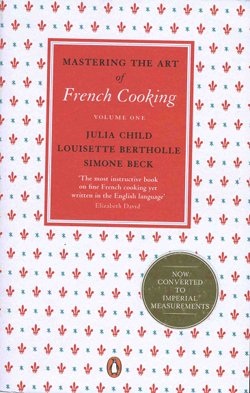 Classic re-issues are always of interest as it’s fascinating to observe the old faithfuls being introduced to a new generation. Penguin have issued a 2-volume set of Julia Child’s Mastering the Art of French Cooking to mark the 50th anniversary of this iconic work, written with partners in her Paris cookery school L’Ecole des Trois Gourmandes, Simone Beck and Louisette Bertholle; it’s available as a boxed hardback set (£50/€56) or individual paperbacks (£12.99/£15.99).
Classic re-issues are always of interest as it’s fascinating to observe the old faithfuls being introduced to a new generation. Penguin have issued a 2-volume set of Julia Child’s Mastering the Art of French Cooking to mark the 50th anniversary of this iconic work, written with partners in her Paris cookery school L’Ecole des Trois Gourmandes, Simone Beck and Louisette Bertholle; it’s available as a boxed hardback set (£50/€56) or individual paperbacks (£12.99/£15.99).
Elizabeth David was a fan it remains the most highly respected book on classic French cooking in the English language. It’s amusing to note the cover sticker announcement ‘Now converted to Imperial Measurements’. This reminds me of a new edition of Mrs Beeton that was brought out some years ago and converted to metric measurements in anticipation of a changeover that never really happened. It was a disaster and later editions have offered both.
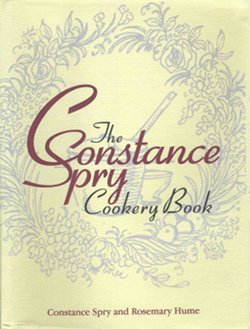 The new edition of what many regard as the ultimate kitchen bible, The Constance Spry Cookery Book (Grubb Street, hardback £30), also gives dual imperial/metric measurements and this thumping great volume running to over 1,000 pages is fantastic value.
The new edition of what many regard as the ultimate kitchen bible, The Constance Spry Cookery Book (Grubb Street, hardback £30), also gives dual imperial/metric measurements and this thumping great volume running to over 1,000 pages is fantastic value.
Although some of the household tips and practical references have been overtaken by technology and may seem quaint, this book – once on the wedding list of every bride who aspired to run a good kitchen and entertain with confidence – remains a sound all round reference with a wide-ranging education between its covers.
Bar a few diagrams, neither of these classics is illustrated by the way, but they more than make up for lack of visual appeal through interesting content and the clarity of the language – something not often found these days, as contemporary books rely so heavily on photography to illustrate their points.
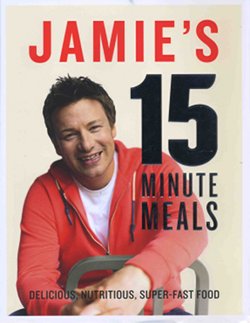 Of this season’s mainstream UK publications, several sure-fire best sellers are weighing down my desk, including Jamie’s 15 Minutes Meals (Michael Joseph hardback, £30), which – despite the fact that you’d be hard pushed to make most of these meals in the promised time frame - will probably be even more popular than usual in Ireland thanks to the opening of Jamie Oliver’s first Irish restaurant, in Dundrum, recently.
Of this season’s mainstream UK publications, several sure-fire best sellers are weighing down my desk, including Jamie’s 15 Minutes Meals (Michael Joseph hardback, £30), which – despite the fact that you’d be hard pushed to make most of these meals in the promised time frame - will probably be even more popular than usual in Ireland thanks to the opening of Jamie Oliver’s first Irish restaurant, in Dundrum, recently.
But whether or not the timing is strictly achievable, these are easy colourful multi-cultural dishes and every page is imbued with Jamie’s usual enthusiasm, health consciousness (calorie counts for all dishes as well as his trademark emphasis on wholesome fresh ingredients) and ambition to educate - especially by impressing on young cooks the importance of the kitchen skills and good organisation which allow you to ‘own your kitchen’ (his comments on clutter are, ahem, instructive) and cook fast...
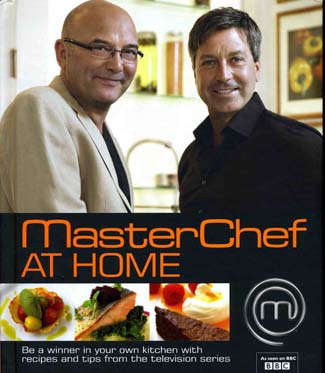 Surprisingly perhaps, Masterchef Everyday (Dorling Kindersley, £20/£25) shares similar territory to Jamie Oliver, with John Torode and Gregg Wallace bringing together a range of former MasterChef contestants’ dishes in a broadly educational way (‘Everything you need to become a MasterChef’), and with 20 of the 130 recipes simplified for ‘everyday’.
Surprisingly perhaps, Masterchef Everyday (Dorling Kindersley, £20/£25) shares similar territory to Jamie Oliver, with John Torode and Gregg Wallace bringing together a range of former MasterChef contestants’ dishes in a broadly educational way (‘Everything you need to become a MasterChef’), and with 20 of the 130 recipes simplified for ‘everyday’.
Whether your everyday is the same as their everyday is up to you - but that strikes me as being rather contradictory anyway - the whole point of MasterChef is to do with achieving stratospheric standards, there are masses of books already dealing very well with everyday.
Whatever about all that, it’s an attractive, good tempered and informational book and great value – and, like Jamie’s 15 Minute Meals (and Paul&Martin’s Surf’nTurf), I suspect it would be particularly well received by the men on your gift list who have an interest in cooking.
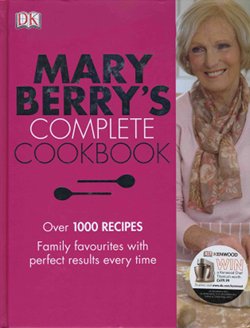 Mary Berry, on the other hand – a ‘kitchen bible’ author if ever there was one – has a more feminine appeal and I’d say Mary Berry’s Complete Cookbook (DK hardback £25) would take its place very happily on the bookshelf of any family kitchen where (let’s be honest) mum is usually the everyday cook.
Mary Berry, on the other hand – a ‘kitchen bible’ author if ever there was one – has a more feminine appeal and I’d say Mary Berry’s Complete Cookbook (DK hardback £25) would take its place very happily on the bookshelf of any family kitchen where (let’s be honest) mum is usually the everyday cook.
It’s one of those great all-round references with a huge range of recipes, confidence-inspiring step-by-step photos, ‘Cook’s know-how’ tips and ‘Healthy notes’ that make you feel you have an experienced auntie in the kitchen with you.
Classic situations like cooking for Christmas are very well covered (I’ll come back to The Dinner next month) and fans of The Great British Bake Off will know that all kinds of baking are especially strong...
Christmas Pudding needs a few weeks to mature, if possible, so this is a good recipe to make now.
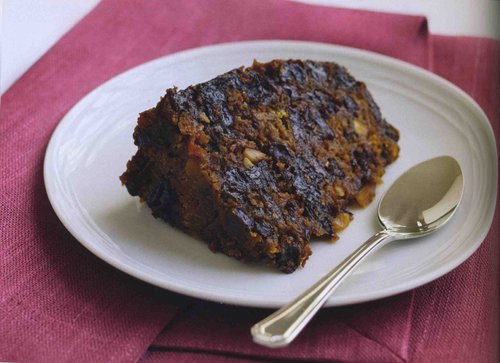 Mary Berry’s Christmas pudding
Mary Berry’s Christmas pudding
This is a rich, dark pudding, laden with dried fruit, spices, and alcohol - the traditional way to finish the festive meal.
SERVES 8-10 522-418 CALS PER SERVING
90g (3oz) self-raising flour
125g (4 oz) shredded vegetable suet or grated chilled butter
30g (1 oz) blanched almonds, shredded
125g (4oz) carrot, grated
250g (8 oz) raisins
125g (40z) currants
125g (4 oz) sultanas
125g (4 oz) fresh breadcrumbs
¼ tsp grated nutmeg
60g (2 oz) mixed candied peel, chopped
90g (3 oz) light muscovado sugar
grated zest and juice of 1 lemon
2 eggs, beaten
butter for greasing
75ml (2½ fl oz) dark rum or brandy
brandy butter (see below) to serve
1x1.25 litre (2 pint) pudding bowl
1 In a large bowl, combine the flour, suet or butter, almonds, carrots, raisins, currants, sultanas, breadcrumbs, nutmeg, candied peel, sugar and lemon zest. Add the lemon juice and eggs, and stir until well combined.
2 Lightly butter the pudding bowl. Spoon in the pudding mixture and level the surface
3 Cover with buttered greaseproof paper, then foil, both pleated in the middle. Secure the paper and foil in place by tying string under the rim of the bowl.
4 Put the bowl into a steamer or saucepan of simmering water, making sure the halfway up the side the bowl. Cover and steam, topping up with boiling water as needed, for about 6 hours.
5 Remove the bowl from the steamer or pan and leave to cool. Remove the paper and foil covering. Make a few holes in the pudding with a fine skewer and pour in the rum or brandy.
6 Cover the pudding with fresh greaseproof paper and foil. Store in a cool place for up to 3 months
7 To reheat for serving, steam the pudding for 2-3 hours. Serve at once, with brandy butter. Make your own brandy butter by creaming together 250g (8 oz) each of unsalted butter and caster sugar or icing sugar, and 90ml (3 fl oz) brandy. The brandy butter can be frozen for up to 3 months.
Cook Book Reviews

 Is it art, craft or theatre? All three perhaps, with food as the medium and the emphasis on art? That’s the kind of thing that diners tend to ponder on at The Cliff House Hotel in Ardmore, Co Waterford, where gifted Dutch chef Martijn Kajuiter’s astonishing food has been wowing the critics since this old hotel re-opened as an exciting contemporary destination in 2008, when it was our Newcomer of the Year.
Is it art, craft or theatre? All three perhaps, with food as the medium and the emphasis on art? That’s the kind of thing that diners tend to ponder on at The Cliff House Hotel in Ardmore, Co Waterford, where gifted Dutch chef Martijn Kajuiter’s astonishing food has been wowing the critics since this old hotel re-opened as an exciting contemporary destination in 2008, when it was our Newcomer of the Year.
Written by Martijn Kajuiter and the respected journalist Alex Meehan, with truly stunning in-season photography by Shane O’Neill, Let’s Go Disco (published by The Cliff House Hotel, hardback, €45) is a predictably unconventional book, starting with the title – apparently it’s their rallying cry in the kitchen ‘when it’s time to knuckle down and get things done’.
And like the hotel itself - a luxury destination which thrives despite having opened on the cusp of recession - Let’s Go Disco bucks the trend in the world of hardback food books too, as Martin is not a TV chef, as yet anyway, although he did make an appearance recently in MasterChef.
And talking of MasterChef, if you have an aspiring one in the family this is the perfect gift, as it’s educational as well as inspiring and thought-provoking. (Don’t plan to post it out to too many people though, as it weighs in at 2kg.)
 There is realism - chefs photographed smoking (hmmm…); the stained fingernails that may be an uncomfortable reminder of how much handling this kind of food involves - but this is a book about the philosophy and teamwork in The Cliff House kitchen and, while it’s light years away from being a recipe book in the usual sense, Martijn is at pains to point out that there is no compromise in the way his 36 dishes are described: and each complex dish is itemised like a numbered map, with mini-recipes to match. I was interested to see this as, from the diner’s perspective, I have wondered if it might enhance the experience to have guidelines on the best order to undertake the tasting of such minutely detailed dishes.
There is realism - chefs photographed smoking (hmmm…); the stained fingernails that may be an uncomfortable reminder of how much handling this kind of food involves - but this is a book about the philosophy and teamwork in The Cliff House kitchen and, while it’s light years away from being a recipe book in the usual sense, Martijn is at pains to point out that there is no compromise in the way his 36 dishes are described: and each complex dish is itemised like a numbered map, with mini-recipes to match. I was interested to see this as, from the diner’s perspective, I have wondered if it might enhance the experience to have guidelines on the best order to undertake the tasting of such minutely detailed dishes.
 Local foods in season provide the foundation for this extraordinary cuisine - and they even grow some produce themselves in a cliff-top polytunnel and raised beds beside the hotel – but that could easily be forgotten when faced with the sheer complexity of the work on the plate.
Local foods in season provide the foundation for this extraordinary cuisine - and they even grow some produce themselves in a cliff-top polytunnel and raised beds beside the hotel – but that could easily be forgotten when faced with the sheer complexity of the work on the plate.
Interestingly, although strikingly modern, Kajuiter’s cooking is also reminiscent of the elaborate works of the ground breaking chefs celebrated in earlier centuries, such as Careme (1784-1833, “The King of Cooks and Cook of Kings”) and Escoffier (1846-1935). Plenty of food for thought here, let’s just hope there won’t be too many imitators.
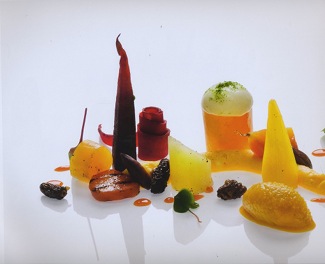 Available online from: www.thecliffhousehotel.com and on sale at The Cliff House Hotel, Ardmore, Co Waterford, and The Cliff Townhouse, St Stephen’s Green, Dublin 2.
Available online from: www.thecliffhousehotel.com and on sale at The Cliff House Hotel, Ardmore, Co Waterford, and The Cliff Townhouse, St Stephen’s Green, Dublin 2.
Book Reviews
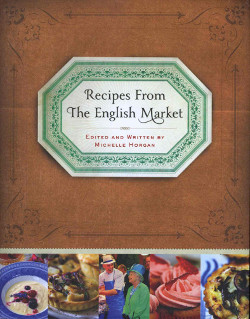
 This month’s books have both been written in celebration of great Irish institutions.
This month’s books have both been written in celebration of great Irish institutions.
Firstly, Michelle Horgan’s Recipes From The English Market (Atrium Press, hardback €25) is another handsome food book from a division of Cork University Press. There is nowhere like The English Market in Cork city, Ireland’s oldest covered market, and it’s no wonder that this delightful place is where the most charming image of the Queen was captured on her 2012 visit - and yes, it quite rightly features on the cover.
Renowned for the quality and diversity of its produce, the English Market supplies the city’s leading restaurants and is a favourite shopping destination for both local residents and visitors. Today the mixture of stalls may be becoming much more cosmopolitan (full details of current stallholders are given on their excellent website), but many of the older ones are thriving and have been in the same family for generations - and this is the best place in Ireland to source many of the traditional foods and cuts of meat that have gradually disappeared elsewhere.
Stall by stall, Michelle Horgan gives the history of each one, with photographs of the market characters and some of their favourite recipes - many of them for old-fashioned favourites which are now rarely seen outside Cork city. The range of foods sold covers everything from local meats, fish, poultry and vegetables - all of which are sold in several competing stalls run by different families - to cheeses, baked goods and the ‘exotics’ that have become part of Cork life, including olives and Hadji Bey Turkish Delight (inspiration for an unusual ice cream, which has a recipe given in the book).
This was a book waiting to be written and, although foodies may sometimes wish for a little more detail (on the now almost forgotten cuts of meat for example), it is sure to be very popular with visitors to Ireland as well as regular shoppers at this wonderful market.
The recipes include some great comfort food, reminiscent of an older Ireland - see this month’s main Cookery Feature.
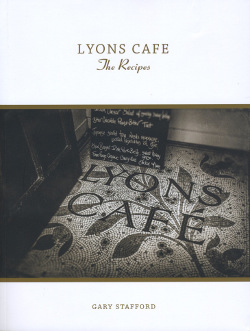 In the North-West, and in celebration of tens years at the popular Lyons Café in Sligo Town, talented chef-proprietor Gary Stafford has published the book that his customers of this charming café have been asking for - Lyons Café, The Recipes (paperback, with original imagery by Sligo photographer Darek Smetana; €16 from the café and local bookshops).
In the North-West, and in celebration of tens years at the popular Lyons Café in Sligo Town, talented chef-proprietor Gary Stafford has published the book that his customers of this charming café have been asking for - Lyons Café, The Recipes (paperback, with original imagery by Sligo photographer Darek Smetana; €16 from the café and local bookshops).
It’s not just any old cookbook, though, as it is a celebration of its surroundings and the workings of the busy kitchen as well as the food itself. Henry Lyons Department store in Sligo town was founded in 1835 and this gloriously old-fashioned shop is an absolute gem, becoming more precious with each passing year as other stores take the modernisation route.
The first floor Lyons Café is operated independently and it fell into good hands when the keen and well-travelled young chef, Gary Stafford, took the helm in 2002 – and, reflecting the character of the lovely old café itself, this very welcome cookbook is a delight.
A charming mixture of history, great traditional baking and colourful, fresh-flavoured dishes inspired by his travels, this is a book that will be treasured by loyal customers – and will surely inspire many others to visit this Sligo gem for themselves.
Although privately published, it’s a very professional production - well edited, appealingly designed and printed (in Ireland) on quality paper - and deserves wider distribution and/or online sales.
SAMPLE RECIPE: In this month’s In Season there is an unusual and useful Lemon Chutney from Lyons Café .
Book Reviews - At Home in Ireland by Mary Leland
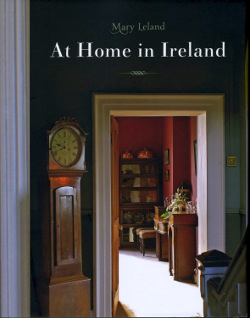
 At Home in Ireland by Mary Leland (Atrium, hardback, 290pp; colour photographs throughout; €30)
At Home in Ireland by Mary Leland (Atrium, hardback, 290pp; colour photographs throughout; €30)
For over fifteen years from the mid-1990s, the Cork-born author and journalist, Mary Leland, had a loyal following for the erudite and beautifully written heritage and hospitality pieces she contributed weekly to The Irish Examiner - no easy task, as I know well, since her travels took her all over the country and the travel time alone must have been a considerable commitment.
It mounted up to an impressive body of work and merited a more permanent presence than publication in a newspaper, so the handsome hardback collection recently published by Atrium (an imprint of Cork University Press) is very welcome.
Mary is at pains to emphasise that it is not a guide and this supremely readable book is certainly much more than that; while not a lavish ‘coffee table’ production, it’s a book to be picked up whenever the mood is right - the perfect bedside companion.
Over a hundred houses and historic buildings and their owners are included, many of them familiar to me (which is always a joy) and others not (a tantalising introduction). Although slightly shorter, the entries are otherwise published as they were originally, with only footnotes to explain any major changes; they could be as recent as 2011 or go back to the mid ‘90s, so reading them can be a strange sensation. However, while not noted in the main body of text, the original dates are given in the list of Contents and, unless playing a game with yourself to see if you can guess, it is worth looking back to put each one in the context of its times.
The houses selected represent, as Mary says in her Preface, only a small minority of the total work of around 800 articles, which must be a sadness for her, and even some of those included or mentioned here have since closed their doors to guests. Glin Castle for example, although still a family home, was formerly a Blue Book property and has been closed since the Knight of Glin’s untimely death in 2011.
Even in Justin Green’s excellent Introduction, he refers not only to the wonderful family home Ballyvolane, which he and his family run very successfully as a Hidden Ireland country house and wedding venue, but also their delightful Lismore restaurant, O’Brien Chop House, which closed only last autumn.
But if these sadnesses highlight the ephemeral nature of things, that should encourage us to celebrate the survivors, as this book does so well - and, although not specifically a food book, Mary’s hospitality column began with restaurant reviews and there is much of interest to the food lover here.
Anyone with a love of Irish heritage and hospitality will find this book a rewarding and sometimes moving read.
Book Review - Wild Food - Nature's Harvest - How to Gather Cook & Preserve by Biddy White Lennon and Evan Doyle
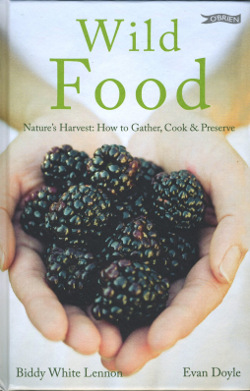
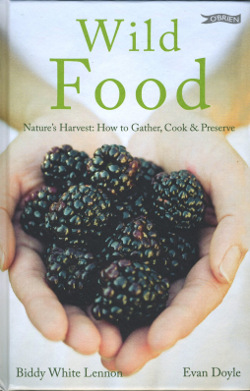 Georgina Campbell
Georgina Campbell
It’s generally a quiet time of year for new books but, in any case, everything else can go on the back burner this month as the big news in the Irish foodie world is the much anticipated arrival of Biddy White Lennon and Evan Doyle’s foraging book, Wild Food - Nature’s Harvest: How to Gather Cook & Preserve (O’Brien Press, hardback €16.99).
It’s been a long time coming - appropriately enough, as Biddy (food writer) and Evan (hotelier/restaurateur) are both keen members of the Slow Food movement - but its gestation period appears to have been perfect, as it would be hard to imagine a more timely publication.
Since they started work on it several years ago the world has gone foraging mad, with fashionable restaurants employing full time foragers (something Evan says there was no interest in when he first sought a forager for The Strawberry Tree in Killarney two decades ago…) and half the country’s kitchen staff wandering around beaches and country laneways in their whites. Which is all good stuff - aside from anything else it helps close the rural-urban divide which is at the root of so many of the problems the modern world faces.
While not a pocket book - many will be surprised to find that it’s quite a chunky hardback - it’s an attractive book, and tough enough to stand a lot of bashing around both the glovebox and the kitchen. Biddy says “It gives point to a walk to come home with something tasty to eat, to preserve and give as gifts” and, having guided you to the best wild foods to gather throughout the year, there’s a goodly quotient of recipes to ensure you make the most of them when you get home.
Anyone who has followed Biddy’s columns in, for example the Irish Farmers’ Journal, or seen any of her other books, will know to expect a pleasingly straightforward and homely approach, and Evan Doyle’s recipe contributions from Ireland’s only certified organic restaurant, The Strawberry Tree at BrookLodge Hotel, Macreddin, Co Wicklow are also very do-able. But what sets this book apart from others covering similar territory is the passion shared by Biddy and Evan for their subject, and the way that they have - so appropriately - given it a special local Irish spin.
Following a cold February, the foraging season is just beginning to get into gear now, so this is a subject I’ll enjoy coming back to in more detail in a month or two, together with some of the recipes.
Book Review - Blazing Salads 2
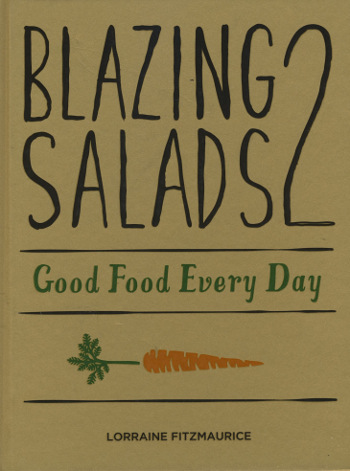
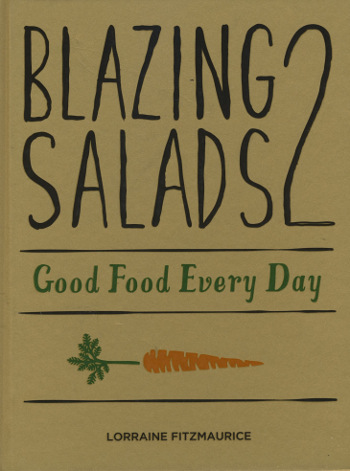 BLAZING SALADS 2 Good Food Every Day, by Lorraine Fitzmaurice (Gill & Macmillan, hardback €19.99).
BLAZING SALADS 2 Good Food Every Day, by Lorraine Fitzmaurice (Gill & Macmillan, hardback €19.99).
It may seem a long time to some, but to me it seems as if Blazing Salads has always been there gracing Dubin with its wholesome presence, yet they only opened in 2000 and their first book came out in 2004. And it’s great to see another one, a hardback this time and - with the wince-making exception of spreading the author’s portrait over a double page spread and splitting her beautiful face - a much more attractive, and more extensive, book than the first, yet only €3 more in the price. It’s funny how we have more hardbacks and higher production values all round now, in recession; bookshops are certainly offering fantastic value these days.
Anyone familiar with Blazing Salads and its down to earth philosophy of quality and simplicity should just head down to their local bookshop and snap up a copy, because it does what it says on the tin - it really is all about good food every day, there are no gimmicks just loads of great ideas in imaginative but very straightforward do-able dishes that won’t take too much time - and you’ll enjoy making them.
Lorraine Fitzmaurice and her siblings at Blazing Salads - including relocated brother Joe, who is baking in a wood-fired oven in Cloughjordan now, and delivers the breads up to them in Dublin at the crack of dawn every morning - have a happy knack of making, or giving you recipes for, delicious food that just happens to be very healthy and vegetarian.
You might not even notice there’s no meat or fish - like Denis Cotter’s Café Paradiso in Cork (only a lot simpler) it’s just great food that happens to be vegetarian. And, as Lorraine points out in her introduction, a lot of the macrobiotic food they were brought up on, and that their schoolfriends thought weird in the 1970s (when they called her mother ‘the witch’), is pretty much mainstream now. I can identify strongly with all of that, having had similarly forward-thinking parents myself...
Anyway, there’s nothing weird about this book and, while - with everything from nibbles and soups, to excellent main courses and yummy desserts - it’s far from being heavily loaded in favour of salads, they are as Lorraine says, ‘not a garnish on the side of a plate of ‘real’ food. Our salads are real food.’ A round of applause please.
I commend this book to anyone who’s looking for simple, tasty and healthy ideas - and, especially, chefs who may find it a bit of a challenge coming up with interesting vegetarian options for their menus. No shortage of good dishes here.
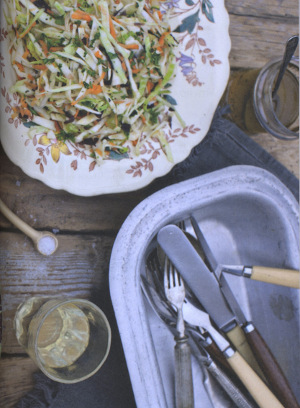 RECIPE: WHITE CABBAGE SALAD WITH DULSE
RECIPE: WHITE CABBAGE SALAD WITH DULSE
This is a typically robust dish, perfect for this ‘between season’ time, when hard cabbage is especially valuable, and the inclusion of dulse - used in the same way as you might include a not too dominant herb such as parsley - gives it an unusual edge.
Lorraine suggests it as an accompaniment to the ‘much maligned veggie burger’ - great recipes for some of those are included too, the ideal way to ensure you’re not getting any unwelcome additives in your burgers being to make them yourself.
“Like potato salad, coleslaw is usually a sad sight, drenched in mayonnaise. These crunchy, refreshing salads celebrate good produce with healthy dressings, and make a great addition to any meal.
To shred your cabbage, turn it on its side and hold the bottom end. Using a large, sharp knife, slice as thinly as you can from the top. When you get towards the middle, cut out the heart and the stem you were holding and discard, shredding the rest of the leaves as finely as you can and place in a large bowl.
Don't let the seaweed put you off this fresh, delicious salad!”
Serves 4 to 6
25 g dulse seaweed
280 g white cabbage, shredded
2 leaves cos lettuce, shredded
1 medium carrot, roughly grated
1 tsp fresh parsley, finely chopped
2 tbsp extra virgin olive oil
2 tsp red wine vinegar
A tsp dried oregano
Sea salt
Coarsely ground black pepper
1 Rinse the dulse well. Place in a small bowl and cover with 3 tbsp water. Set aside to soak for 20 minutes.
2 Finely slice the lettuce and add to your prepared cabbage. Coarsely grate the carrot and add to the bowl along with the parsley. Drain the seaweed and roughly chop and add to the salad.
3 Place the olive oil, red wine vinegar, dried oregano, a pinch of salt and pepper into a bowl and whisk. Pour over the salad and mix well.
4 Make the salad at least 30 minutes before serving to allow the flavours to develop. Check the seasoning and adjust accordingly using the red wine vinegar and sea salt.
Book Reviews - Food for Friends by Edward Hayden
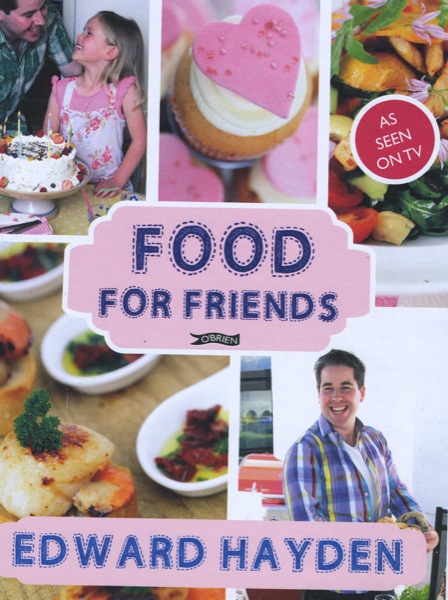
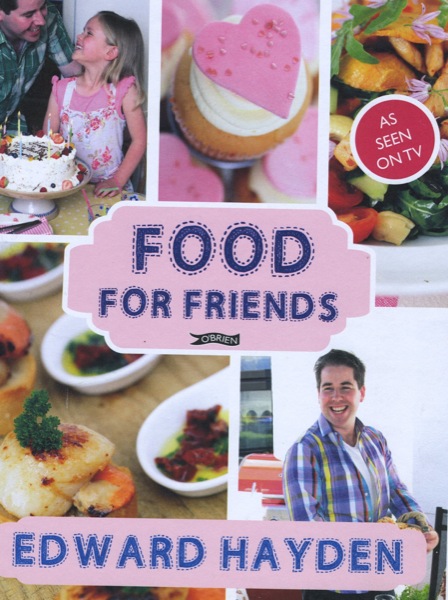 Food for Friends by Edward Hayden (O’Brien Press, hardback, €22.99/£18.99).
Food for Friends by Edward Hayden (O’Brien Press, hardback, €22.99/£18.99).
Popular author and TV chef Edward Hayden is well known from his appearances on TV3's 'Ireland AM' and perhaps even more so from his classes and demonstrations in a cookery schools and venues around the country, where his cheerful nature and relaxed presentation goes down a treat.
Following on the success of his first cookbook, Food To Love, he’s worked on the implications of how ‘staying in can be the new going out’ - ie you need some handy recipes to help you keep up with your friends and enjoy their company without too much hassle in the kitchen.
No worries, Edward has the solution for all kinds of get-togethers, in all seasons. Brunches and supper parties, formal dinner parties, barbecues, children’s parties, seasonal festivities and family bashes - you name it, Edward has the ideas and promises “to show even the most inexperienced cook how to easily make sumptuous food fast!”
Try his mini quiches and judge for yourself.
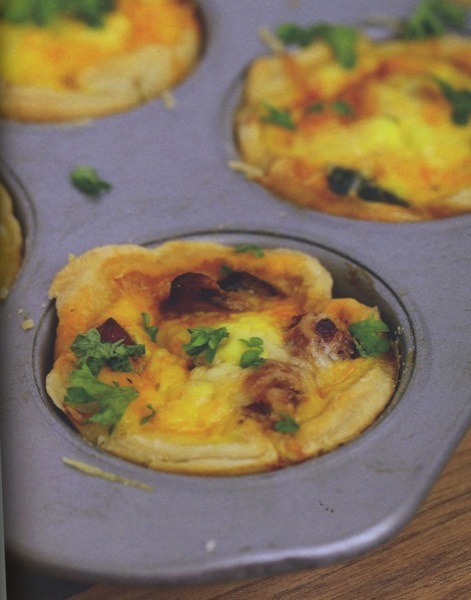 Quiche in a Tin
Quiche in a Tin
Although I love it, I always think quiche is quite, time-consuming to make. The whole blind-baking process adds so much time to the affair that now I always make these mini quiches, which require no blind baking and still give that lovely crisp pastry effect. Again this is one of these recipes that you can vary the flavour as much as you like by substituting ingredients.
Makes 12
Short Crust Pastry:
6oz/225g plain flour
4oz/110g butter
Pinch of salt
A couple of tablespoons of ice cold water
Filling:
A little oil for cooking
½ courgette, cubed
5oz/150g chorizo, thinly sliced
½ onion, diced
6 mushrooms, thinly sliced
3 large eggs
10floz/300mlmilk
Salt 6 ground black pepper
4oz/110g cheese, grated
Preheat the oven to 180C/350F/Gas Mark 4.
Lightly grease a twelve-cup deep muffin tray.
Sieve flour into a large mixing bowl and add a pinch of salt. Rub the butter into the flour and salt mixture until it resembles very fine breadcrumbs, then mix in enough ice-cold water to bring the mixture together.
Knead the pastry gently, then cover with cling film and rest in the fridge until required. Roll out the pastry, cut into discs and use it to line the twelve cups of the muffin tray.
Heat a little oil in a large, wide-based sauté pan and add the courgette, chorizo, onion and mushrooms and cook over a medium heat until they have softened. Allow these to cool and then divide between the pastry lined cups of the muffin tray.
In a large jug whisk together the eggs with the milk and seasoning. Carefully pour this mixture into the pastry-lined cups, sprinkle with a little cheese and bake in the preheated oven for approximately twenty minutes or until the pastry is crisp, the egg custard has fully set and the cheese is bubbling.
Allow to cool in the tin for five minutes and then, using a palette knife, carefully remove them from the tin and serve, either hot or cold.
EDWARD'S HANDY HINT: Sometimes 1 replace a little of the milk with some cream for added richness.
Book Reviews - Apron Strings, Recipes from a Family Kitchen by Nessa Robins
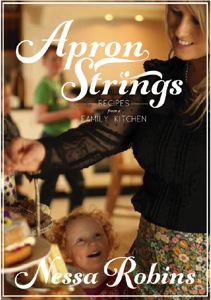
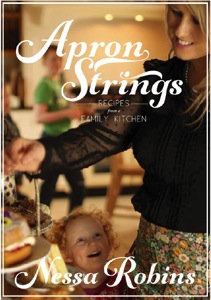 Apron Strings, Recipes from a Family Kitchen by Nessa Robins (New Island, hardback, €22.99/£19.99)
Apron Strings, Recipes from a Family Kitchen by Nessa Robins (New Island, hardback, €22.99/£19.99)
Blogging has changed the landscape of food writing in an amazingly short time - Westmeath nurse and mum of four, Nessa Robins, has a huge following for her blog Nessa’s Family Kitchen which she only started in 2010 and it has opened up other avenues for her too, including columns in the Westmeath Independent and Easy Parenting magazine. And now, along comes this beautiful book - and not only written by her, but nearly all of the photography is Nessa’s too.
I really love this book, and not just for the cookery and recipes but because Nessa has woven the food elements so seamlessly into other aspects of everyday family life and her experience as a nurse.
In a way it’s reminiscent of the earliest cookery books, in that you’ll find ‘Thrifty tips for running a household’ alongside a section on pregnancy and post-pregnancy diet, alongside children’s party themes and recipes, and ‘Natural Remedies for Common Ailments’ along with practical ideas for picnics and tips on keeping hens.
There are loads of images of her four lovely, busy children (often helping in the kitchen or in the garden), touching tributes to her late parents and due thanks to husband Diarmuid, who sounds like an absolute rock.
And, through the highs and lows of this terrific family, we get a great insight into life in Westmeath, too - house prices will be rocketing.
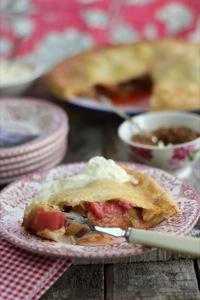 Sample Recipe: LIZ'S RHUBARB & STRAWBERRY TART
Sample Recipe: LIZ'S RHUBARB & STRAWBERRY TART
Pastry
450g plain flour
25g icing sugar
225g cold bulter
2tbsp cold water
Filling
900g rhubarb
225g strawberries, sliced
1tbsp cornflour
300g caster sugar
Egg wash - made with one beaten egg and a dash of milk
To Serve:
Soft brown sugar
Softly whipped cream
Preheat the oven to 200°C / fan 180°C / Gas Mark 6.
First, make the pastry. Sieve the flour and the icing sugar into a bowl. Rub in the butter then gradually add the water and bring the pastry together in a ball. Turn out onto a piece of floured greaseproof paper, flatten into a round wrap and chill. This pastry needs to be chilled for at least an hour.
Divide the pastry in two. To make the tarts, roll out the pastry 1 /8 inch (3mm) thick approximately, and use about 2/3 of each ball to line the tart tins. Divide the sliced rhubarb and strawberries between the two tarts, sprinkle over the cornflour and the caster sugar.
Roll out the remaining two balls of pastry to make a lid. Place over the fruit and seal the edges. Score a few times with a fork to allow the steam to escape while the tart is baking. Brush with the egg wash.
Bake in the preheated oven for approx: 45 minutes, until golden brown. Serve with a little sprinkling of soft brown sugar and a dollop of softly whipped cream.
Makes 2 tarts
Book Reviews - Georgina Campbell's Ireland, The Best of Irish Food & Hospitality & Dromoland Castle Cookbook
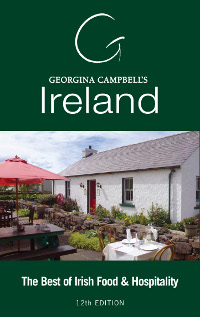
 Georgina Campbell’s Ireland, The Best of Irish Food & Hospitality
Georgina Campbell’s Ireland, The Best of Irish Food & Hospitality
GCGuides, 576 pages, paperback with flaps; maps & colour images. ISBN: 978-1-903164-334; available from bookshops and online from Ireland-guide.com (p&p free in Ireland), €20/stg£16.99.
Not a review, of course, just a reminder that our famously informative “glovebox bible” Georgina Campbell’s Ireland, The Best of Irish Food & Hospitality is back in print by popular demand. Having emerged from a spell as an online-only guide, this new print version is designed as a handy compact companion to Ireland’s leading independent hospitality and food website, Ireland-guide.com.
Widely recognised as the definitive guide for the discerning traveller in Ireland, it leads readers to all of the best places to eat, drink and stay throughout Ireland – and this neat new edition also includes much else for food lovers to enjoy along the way.
Within its compact format, a wide range of categories - hotels, restaurants, cafés, pubs, country houses, guesthouses and farmhouses - plus information on local and artisan foods, ensures the best choices for the discerning traveller in all price ranges.
Brief, accurate descriptions summarise all the best establishments throughout Ireland, North and South, and are partnered by more detailed information on the Ireland-guide.com website and app. Producer entries highlight the quality and variety of Irish produce that visitors will find on leading menus and in the quality shops listed; many products are also available from the producers, markets and online.
The ideal reference for times when you’re away from your desk and mobile coverage is infuriatingly absent, to keep in the car and beside the phone - and as a valued small gift - this quality production will be welcomed by fans of Georgina Campbell’s guides, and is sure to earn many new ones.
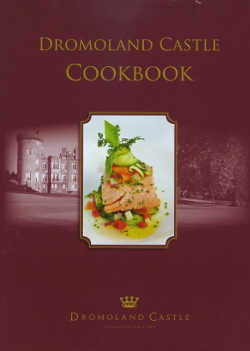 Dromoland Castle Cookbook (hardback, 194pp, colour photography throughout; price €30, available from Dromoland Castle, or online from dromoland.ie/dining (p&p varies). Recipes by David McCann, photography by David Crimmins.
Dromoland Castle Cookbook (hardback, 194pp, colour photography throughout; price €30, available from Dromoland Castle, or online from dromoland.ie/dining (p&p varies). Recipes by David McCann, photography by David Crimmins.
50 years in business this year, the food-focused celebrations at Dromoland Castle in Co Clare have included the publication of the Dromoland Castle Cookbook, featuring not only a fine range of modern classic recipes by David McCann (Executive Head Chef since 1995), but also some insights into life behind the scenes at the Castle.
The wholesome fare offered in the weekly Staff Lunch Menu makes interesting reading, for example, culminating with roast beef and all the trimmings on Sunday, followed by rice pudding and raspberry jam - it took me back to student days in Paris when one of my brothers worked at the Ritz and I was sometimes lucky enough to be invited to eat (very well indeed) with the staff at their big long basement dining table…
There are some classic basic recipes with multiple applications, delicious baking that any home cook could undertake with confidence - and some handy Kitchen Tips: use bread soda paste for silver cleaning, for example, and warm garlic cloves before peeling.
A practical cookbook and a record of a kitchen where great pride is taken in a job well done and short cuts are never countenanced, this is a lovely souvenir for guests and will itself play an interesting role in the hotel’s history in decades to come.
David McCann and long serving Restaurant Manager, Tony Frisby make a great duo, with Tony bringing the warmth of welcome and impeccable service that David’s consistently excellent modern classical cooking deserves. Together they worked on another aspect of the 50th anniversary celebrations, the creation of an eight course “Nostalgic Tasting Menu” with fine wine pairings.
Inspired by the menus served when the hotel opened in 1963, it features upbeat recreations of popular dishes of the day, like smoked salmon Mimosa, fillet of sole Princess, tournedo Rossini and peach Melba - and, while the Cashel Blue in the blue cheese ‘Melt’ may have been only a distant glint in its creators’ eyes at that time, the intentions are honourable and the whole meal is great fun.
The idea for the Nostalgic Menu came after the book so most of the old recipes don’t feature, but you will find Dromoland Prawn Cocktail - which, when served in the tasting menu as part of the ‘Assiette of Hors d’Ouevres’, comes in a dainty little cocktail glass specially purchased for the occasion.

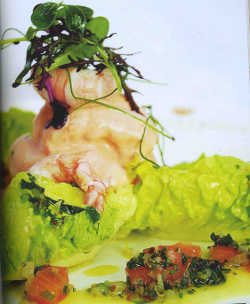 Dromoland Prawn Cocktail Salad
Dromoland Prawn Cocktail Salad
4 portions
INGREDIENTS
1 recipe court bouillon (see below)
20 large Dublin Bay prawns
2 heads of baby gem prepared & washed
1 recipe sauce vierge (see below)
4tbsp mayonnaise (house recipe given in book)
1 tbsp tomato ketchup
dash of Worcestershire sauce
dash of Tabasco
dash of brandy
squeeze of lemon
seasoning
METHOD
1. Bring the court bouillon to the boil.
2. Remove the heads from the prawns. Gently remove the centre tail fin and intestine (which is attached).
3. Plunge the tails into the boiling court bouillon, bring back to the boil and simmer for 40 seconds. Remove the prawns onto a tray, season with salt and pepper and allow to cool for 5 minutes.
4. Shell the prawn tails, keeping intact.
5. To make the cocktail sauce, place the mayonnaise in a bowl, add the ketchup and mix well. Next mix in the brandy, Worcestershire sauce and tabasco. Finish with the lemon juice and correct the seasoning.
6. Keep eight medium baby gem leaves whole, chiffonnade* the rest of the leaves.
7. To present, cup two whole baby gem leaves in the centre of each plate. Place the chiffonade on top neatly.
8. Toss the prawns in half of the cocktail sauce, place five prawns per portion on top of the lettuce and coat with the remainder of the sauce.
9. Spoon the sauce vierge around the salad.
Note: Dublin Bay Prawns are also known as Langoustine or Norwegian Lobster. *Chiffonnade is to shred or slice leaf vegetables, herbs or lettuce (Julienne)
COURT BOUILLON
Mainly used for shellfish and fish
Makes 2 litres
3 litres cold water
1 leek, 2 carrots, 3 onions, 2 celery sticks, ½ fennel
bulb or trimmings (washed & peeled)
1 sprig of thyme
2 bay leaves
5 parsley stalks
2 sprigs of chervil & tarragon
1 bulb of garlic, cut in half
1 tsp coriander seeds
2 star anise
12 white peppercorns
1 lemon (zest & juice)
pinch of sea salt
200ml white wine vinegar
1. Place all the ingredients except the wine vinegar in a large pot. Bring to the boil and reduce to a simmer for 30 minutes, next add the wine vinegar and return to a simmer for 5 minutes.
2. Pass through a fine sieve and reserve for use or freeze.
SAUCE VIERGE
4 portions
2tsp finely diced shallots
2 beef tomatoes skinned, deseeded & diced
1 sprig of basil leaves finely sliced
1 sprig of tarragon leaves chopped
1 tsp chopped chives
1 tsp crushed coriander seeds
juice of 1 lemon
100ml olive oil
seasoning
1. Heat the oil in a small heavy based pot, add the shallots and remove from the heat.
2. Add all the other ingredients except the tomato and leave to infuse and cool.
3. When at room temperature, add the diced tomato and correct the seasoning.
Book Review - Chapter One, An Irish Food Story by Ross Lewis
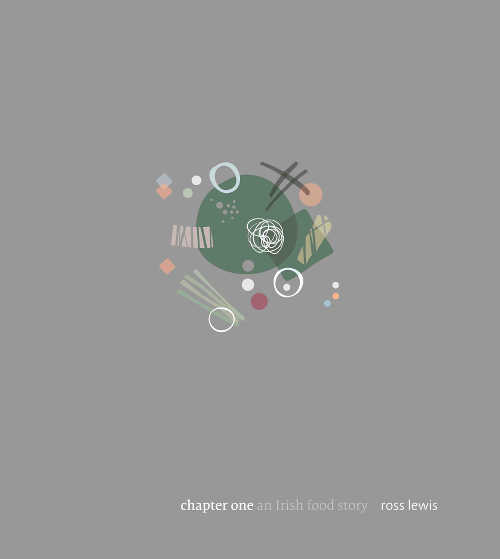
 Gill & Macmillan, hardback 315 X 285, 302pp, ISBN 9780717157877; photography by Barry McCall; €39.99. From bookshops, the restaurant, and online
Gill & Macmillan, hardback 315 X 285, 302pp, ISBN 9780717157877; photography by Barry McCall; €39.99. From bookshops, the restaurant, and online
Stunning is a word that’s overused these days, but first sight of this beautiful and long anticipated book simply took my breath away.
It is big, very big (weighing in at around two and a quarter kilos in fact) but, even before you open it, the subtle, enigmatic cover design flags an original and thought provoking approach.
Opposite the imprint page, a glorious full page image of four earthy potatoes on a crumpled brown paper bag leaves you in no doubt of the down to earth philosophy underpinning both this work of art and the restaurant and maturing food culture that it celebrates.
Chapter One is one of Ireland’s most highly-praised restaurants, and rightly so. It’s now hard to believe that its location in Dublin’s north city was originally such a disadvantage but, following a slow burn in the early years, it started to attract the attention of critics, with the Guide among the earliest admirers - being northsiders ourselves, we were especially delighted to have such quality in the area and it was our Restaurant of the Year in 2001.
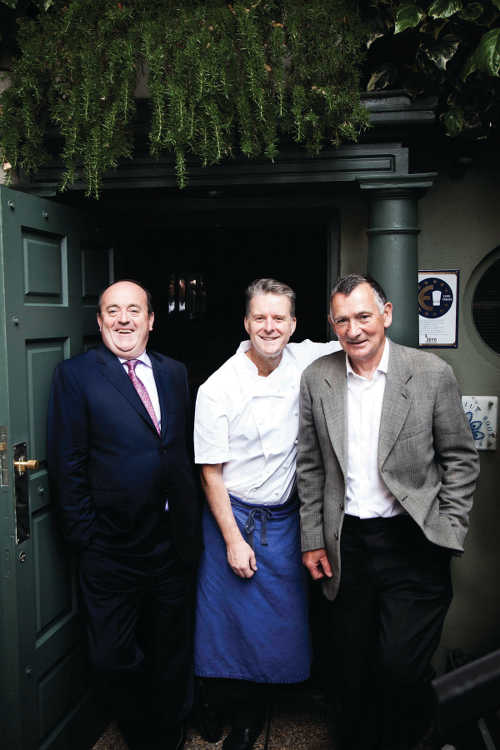
Southsiders soon came in droves however, to experience the exceptional ingredients-led cooking and warmly professional service at this superb and always slightly understated restaurant, enjoying not only the outstanding dining experience but also the sense of discovery (crossing the Liffey to dine being regarded as an adventure at the time).
Many dozens of books have been written about Irish food in recent decades, some of them excellent, but Chapter One, An Irish Food Story is head and shoulders above the best of them. The Irish food book of its generation, it is both a personal story - of chef-patron Ross Lewis, his co-proprietor and ‘maitre d’ extraordinaire’ Martin Corbett, and all involved with this remarkable and much-loved restaurant - and the story of Irish food and its recent development.
Published to coincide with Chapter One’s 21st birthday, the book also marks a coming of age for modern Irish food - a success story which owes a huge debt to people like Ross Lewis and the artisan producers that he and his fellow travellers have always championed.
 A committed member and former Commissioner General of Euro-Toques Ireland (www.euro-toques.ie), which Myrtle Allen founded in 1986, Ross Lewis’s introduction to the book is entitled ‘Food Philosophy’ and cuts straight to the chase: “Good cooking begins with good produce, and when you have the richness of the Irish larder to choose from, there is an opportunity to really soar.” And soar he most certainly does, both in the restaurant which has established an international following and in the book, where his treasured growers and artisan suppliers - some of whom have supplied the restaurant since the 1990s - are given pride of place.
A committed member and former Commissioner General of Euro-Toques Ireland (www.euro-toques.ie), which Myrtle Allen founded in 1986, Ross Lewis’s introduction to the book is entitled ‘Food Philosophy’ and cuts straight to the chase: “Good cooking begins with good produce, and when you have the richness of the Irish larder to choose from, there is an opportunity to really soar.” And soar he most certainly does, both in the restaurant which has established an international following and in the book, where his treasured growers and artisan suppliers - some of whom have supplied the restaurant since the 1990s - are given pride of place.
Many of the giants of the artisan food world are feted here - legendary figures like Veronica Steele the ‘matriarch of Irish farmhouse cheese, the catalyst for the artisan food movement’; other dairy specialists including Seamus Mulligan and Valerie Kingston; passionate growers like Dermot Carey, Denis Healy, David Llewellyn, Brendan Guinan and Donnacha Donnelly; dedicated hunter gatherers - Manus McGonagle, Mick Healy and Mark Cribbin - butchers, fishmongers and smokers including Jack McCarthy, Tom Durcan, Alan Murphy, Ed Hick, Maurice Kettyle, Terry Butterly and Fingal Ferguson; ‘Ireland’s patron saint of bees’ Eoghan Mac Giolla Coda and innovators like Kitty Colchester and Arun Kapil, who bring new flavours to enrich Irish traditions.
The word ‘palette’ occurs often in the text, a reminder of the constant quest for perfection at Chapter One, in the sourcing of ingredients and their transformation into beautiful modern dishes that demonstrate a keen interest in current food trends (Nordic influences, for example, and a re-examination of the historic role of spices), always based on the solid foundations of classical techniques and tradition.
I have never encountered a food book that expresses a philosophy so holistically in every aspect of its production and design, and this is down to an exceptional team including Ross Golden-Bannon (Editor, Project Manger and Concept Consultation) who ensured that the vision came to reality; Orla Broderick, who had the challenging task of recipe editing; and of course the acclaimed photographer, Barry McCall. His work interprets the food philosophy succinctly, conveying a sense of pared down simplicity with great depth; photo portraits of Chapter One’s key personnel and artisan suppliers are especially memorable and the clean, deceptively simple food photography makes you want to eat off the page.
While recipes from the restaurant play a central role, along with some marking special events, notably the State Banquet for the visit of Queen Elizabeth II in 2011, Ross Lewis is quick to concede that the recipes may be challenging, even for proficient home cooks - and, for many readers, ‘the story’ will be the main focus.
 Aspiring MasterChefs will find plenty to hone their skills on but, for the rest of us, Orla Broderick’s meticulous editing makes it possible to pick out elements of complex dishes that we could comfortably tackle at home - and of course there are some simple treats that are central to the restaurant’s repertoire that we can all enjoy, such as their magnificent breads (see below).
Aspiring MasterChefs will find plenty to hone their skills on but, for the rest of us, Orla Broderick’s meticulous editing makes it possible to pick out elements of complex dishes that we could comfortably tackle at home - and of course there are some simple treats that are central to the restaurant’s repertoire that we can all enjoy, such as their magnificent breads (see below).
Destined to earn its place among the great classic food works, this is a book that should be seen in high places - to represent Ireland in embassies and international food fairs, in executive lounges and on managing directors’ coffee tables. But it is also the perfect (and surprisingly kindly priced) gift for any genuine food lover - and everyone who values Irish food, and takes pride in its journey, will want to have a copy.
RECIPES
While complex, the seasonal starter recipe given below is a good example of a Chapter One dish with multiple elements that can be undertaken separately; there are some slight variations from the version given in the book, where more details can be found.
The bread recipe that follows is one of the half dozen or so breads that form part of the delicious opening sequence that is an essential part of any meal at Chapter One. The Brown Soda Bread is probably the simplest recipe in the book - and none the less enjoyable for that.
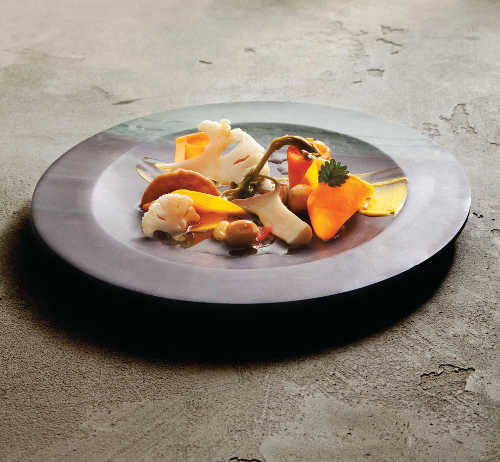 Winter pickled vegetable salad with marinated green raisins and caper sprouts, beurre noisette and fresh salted hazelnuts
Winter pickled vegetable salad with marinated green raisins and caper sprouts, beurre noisette and fresh salted hazelnuts
“This is a beautiful way to start a meal. The golden raisins, caper and hazelnuts make for a play of textures and flavours. Different pickling liquids combine saltiness and acidity with the crunch of the vegetables. Fresh salted hazelnuts add further to the texture, so we’ve everything from sweet, sour and salty to umami. The carrot purée adds the all-important ingredient of luxury.”
Serves 8
FOR THE MARINATED GREEN RAISINS
Ingredients
50 g large green raisins, 40 in total
100 ml Sauternes wine
Method
Bring the raisins and wine to a simmer and then leave to
infuse for 24 hours. Drain.
FOR THE PICKLED CARROT
Ingredients
3 large carrots
handful of salt
50 ml water
50 g sugar
100 ml Llewellyn’s apple balsamic cider vinegar
2 tsp Japanese apple vinegar (glossary), optional
5 coriander seeds
1/2 star anise
1 tsp caraway seeds
Method
Slice the carrots on. a mandolin. Lay on a tray, sprinkle evenly with salt and leave for 20 minutes. Rinse and pat dry.
Put the water, sugar and vinegars in a pan together with the spices and bring to the boil until the sugar has dissolved.
Leave to cool, then pour over the carrots and pickle for at least 2-3 hours.
FOR THE PICKLED CAULIFLOWER
Ingredients
1/4 cauliflower, tough core removed
4 g salt, plus a handful for the cauliflower slices
600 g rice wine vinegar
40 g sugar
5 g lemon zest
Method
Slice the cauliflower on a mandolin. Lay on a tray, sprinkle with salt and leave for 20 minutes. Rinse and pat dry.
Bring the vinegar to the boil with the sugar, zest and salt. When the sugar is dissolved, allow to cool.
Reserve 350 ml of the pickle for the pumpkin and pour the rest over the cauliflower. Pickle for at least 2 hours.
FOR THE PICKLED PUMPKIN
Ingredients
1/4 small crown prince pumpkin
6 g salt, plus a handful for the pumpkin slices
250 ml Hondashi stock (details in glossary)
30 ml mirin
30 ml sake
5 g rice vinegar
30 ml dark soy sauce
350 ml pickling liquor from the pickled cauliflower
Method
Peel the pumpkin and then slice on a mandolin. Lay on a tray, sprinkle with salt and leave for 20 minutes.
Rinse and wring out in a clean tea towel to get rid of as much water as possible.
Bring the Hondashi stock, mirin, sake, vinegar and soy to the boil with the salt. Leave to cool, then mix with the 350 ml of reserved pickle from the cauliflower recipe.
Pour over the pumpkin slices and pickle for at least 2 hours
FOR THE PICKLED WHITE RADISH
Ingredients
1/2 white radish, scrubbed
600 g rice wine vinegar
40 g sugar
5 g lemon zest
4 g salt
Method
Finely slice the white radish on a mandolin. Bring the vinegar to the boil with the sugar, zest and salt. When the sugar is dissolved, remove from the heat and add the ascorbic acid, then leave to cool.
Pour over the radish slices and pickle for at least 2 hours. pinch of ascorbic acid
FOR THE PICKLED RED RADISH
Ingredients
10 radishes, scrubbed
100 g Llewellyn’s apple balsamic cider vinegar
50 g sugar
Method
Finely slice the red radishes on a mandolin. Bring the vinegar to the boil, then add the sugar and allow to dissolve and cool. Pour over the radish slices just before serving.
FOR THE ROASTED HAZELNUTS
Ingredients
20 g skinned hazelnuts
25 g butter
Method
Heat the butter in a saute pan until it starts to brown.
Add the hazelnuts and pan-roast them, tossing frequent!. until they are an even golden brown.
Drain on kitchen paper and season with salt, then crack with the blade of a knife.
TO SERVE
250 g carrot and brown butter purée with black cumin
(see below)
16 pickled Ballyhoura king oyster mushrooms (details in Basic Recipes)
handful caper sprouts (details in glossary)
100 ml beurre noisette (details in Basic Recipes)
fresh micro herbs
CARROT AND BROWN BUTTER PURÉE WITH BLACK CUMIN (Makes 400g)
300g carrots, very finely sliced
90g beurre noisette (butter cooked to a nutty brown state)
10g tarragon vinegar reduction (details in Basic Recipes)
Pinch of ground black cumin
Cook the carrot slices in the beurre noisette over a medium heat until completely soft. Blend to a smooth purée in a blender, adding the tarragon vinegar reduction and finishing with a small pinch of the black cumin to taste.
Refrigerate until needed.
SERVING
Put the carrot purée into a squeezy bottle. Pipe a 4 cm line of purée onto the left-hand side of each serving plate, then use an offset palette knife to spread the purée to form a long rectangle across the middle of each serving plate.
Gently warm the beurre noisette. Arrange 2 pieces of each pickled vegetable, as well as 2 pieces of pickled mushroom on and around the puree, then add 3-4 caper sprouts and some of the hazelnuts.
Add the marinated raisins and then dress with a little of the beurre noisette.
Garnish with the fresh micro herbs.
Chapter One Brown Soda Bread
Makes a 900 ml loaf
Ingredients
380 g wholemeal flour
230 g self-raising flour
140 g wheat bran
40 g jumbo porridge oats
40 g pinhead porridge oats
15 g salt
8 g sugar
25 g bread soda
1 litre buttermilk
40 g treacle
butter, to grease
Method
Preheat the oven to 200°C.
Put all the ingredients, except the bread soda, buttermilk and treacle, in a KitchenAid fitted with a whisk attachment. Mix the dry ingredients with the whisk.
Heat the treacle and buttermilk to 45°C (this enables the flour to take the liquid and to absorb more quickly and evenly).
When the buttermilk and treacle mixture is heated, add the bread soda. Then add to the dry ingredients in the mixer and mix on a medium speed for 5 minutes, then on a high speed for 2 minutes.
Transfer the dough to a greased 900 ml non-stick bread tin and cook in the oven for 40 minutes. (We place a heavy tray on top of the tin to ensure an even-shaped bread for even slices.)
Remove from the tin and cook for another 10 minutes, then transfer to a metal rack to cool.
Leave to cool for 2 hours before slicing as the treacle makes it quite sticky and difficult to cut while still warm.
Book Review - Celebrating Irish Salmon by Mairin Ui Chomain
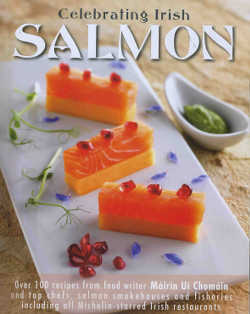
 Celebrating Irish Salmon (Artisan House Editions, paperback; €20; available from bookshops, featured restaurants and online from www.artisanhouse.ie)
Celebrating Irish Salmon (Artisan House Editions, paperback; €20; available from bookshops, featured restaurants and online from www.artisanhouse.ie)
They came to the beautiful Lough Inagh Lodge Hotel in their hundreds to enjoy the December launch of Mairin Ui Chomain’s new book, as they had done to Sallynne & Derry Clarke’s iconic restaurant L'Ecrivain for the Dublin launch in November.
A first for the new Connemara based independent publishing house, Vincent Murphy and Mary Ruddy’s Artisan House Editions, and - surprisingly - the first cookbook dedicated to Irish salmon, this little gem was already a huge success even before the launching formalities had been completed.
Mairin - Connemara born and the daughter of a ghillie - has salmon in her blood: her evocative Introduction includes the casual comment that “Wild salmon, trout and eel were the mainstay of our diet during the summer season.” Happy days indeed, and serving her well again now with this new book, which will be sought out by the many who enjoy Ireland’s most popular fish on a regular basis and who may be looking for new ways to cook it - especially fans of her other very successful speciality seafood books, Irish Mussel Cuisine and Irish Oyster Cuisine.
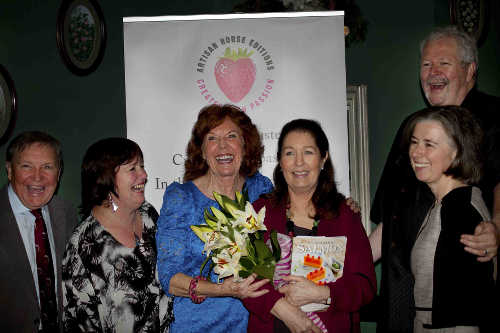 As might be expected of an experienced home economics teacher, TV and radio presenter and former Chairperson of the Irish Food Writers’ Guild, the contents are exceptionally well balanced and carefully thought out. You’ll find much of interest about the salmon (the Foreword is by salmon biologist Prof. Ken Whelan, well known to listeners of Mooney Goes Wild), useful basic preparation and cooking details, a great range of recipes and expert beverage notes by Betty Murphy and Peter Dunne.
As might be expected of an experienced home economics teacher, TV and radio presenter and former Chairperson of the Irish Food Writers’ Guild, the contents are exceptionally well balanced and carefully thought out. You’ll find much of interest about the salmon (the Foreword is by salmon biologist Prof. Ken Whelan, well known to listeners of Mooney Goes Wild), useful basic preparation and cooking details, a great range of recipes and expert beverage notes by Betty Murphy and Peter Dunne.
About half of the 100+ recipes are Mairin’s own, with the balance from some of Ireland’s leading chefs, top producers and other specialist contributors. Smokers are well represented, with recipes from the likes of Burren Smokehouse, Connemara Smokehouse, Kenmare Select, and Ummera Smoked Products, the well known seaweed expert Prannie Rhatigan is a contributor too - and there’s even a recipe from chef Enda McEvoy’s much-anticipated new Galway restaurant, Loam (not yet open).
There’s something for every occasion here and recipes are all very do-able, with Mairin’s own recipes especially practical and the chef contributions well edited for times when a bit of a challenge is welcome in the kitchen.
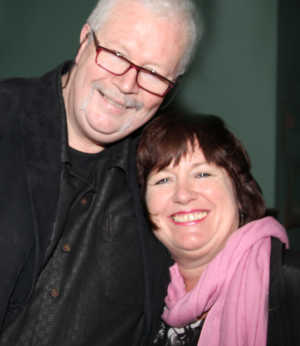 With photography by Walter Pfeiffer, Celebrating Irish Salmon was always going to be visually impressive, but it’s also outstanding for high production values - and the fact that it’s very much a west of Ireland affair, with the editorial team based in Letterfrack and printing by KPS Colour Print, just up the road in Co Mayo. Congratulations are due to all concerned, it’s a great inaugural publication for Artisan House and sure to be the first of many.
With photography by Walter Pfeiffer, Celebrating Irish Salmon was always going to be visually impressive, but it’s also outstanding for high production values - and the fact that it’s very much a west of Ireland affair, with the editorial team based in Letterfrack and printing by KPS Colour Print, just up the road in Co Mayo. Congratulations are due to all concerned, it’s a great inaugural publication for Artisan House and sure to be the first of many.
COVER RECIPE: Wild Salmon Sashimi With Melon And Pomegranate
Pomegranates are among the most antioxidant-rich fruit in the world. They are very good for the heart and also increase your levels of serotonin (happy hormones). Besides, the red seeds look beautiful.
Serves 4
225 g / 8 oz wild salmon fillet, skinned
2 cantaloupe melons
1 pomegranate
12 pea shoots
6 edible flowers (e.g. borage, chive or wild garlic, depending on season)
wasabi (or hot horseradish)
Cut the melons into 12 delicate finger-size rectangles. Cut the raw salmon into similar sized pieces.
Using four rectangular plates, place three melon fingers on each plate and top with salmon fingers.
Arrange three pomegranate seeds on each salmon finger and arrange pea shoots and flowers between the fingers.
Place a teaspoon of wasabi on the side.
To drink: Try a sake such as Hoyo 'Genji' Sake, full of white flowers, peaches and apricots. A Riesling or a craft beer would also work well.
Book Review - Oyster Delight by Jonathan Mite
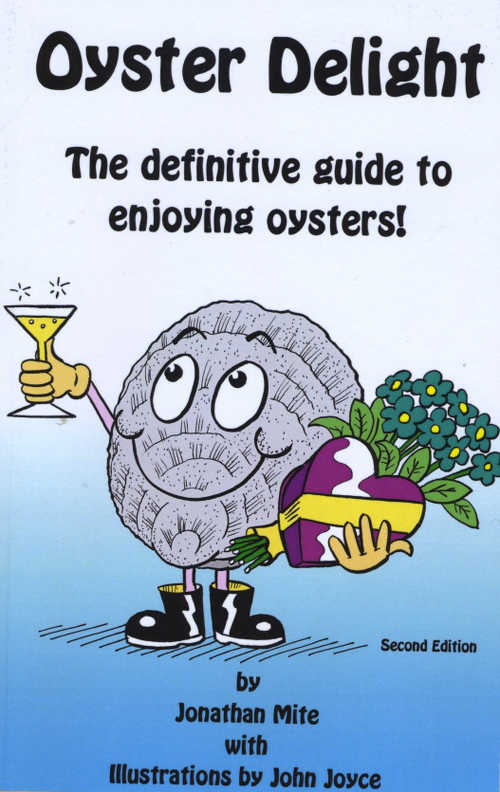
 Oyster Delight (White Seahorse Press, paperback 100pp; price approx. €10.22 from Amazon.co.uk, also available online from www.whiteseahorse.com)
Oyster Delight (White Seahorse Press, paperback 100pp; price approx. €10.22 from Amazon.co.uk, also available online from www.whiteseahorse.com)
You’ll have to read About the Author to work out who Jonathan Mite is, as this wacky little book is actually by ‘scribe and oysterman’ (and, as it happens, marine biologist) Alex Blackwell and his ‘editor and oyster gourmand’ wife Daria, who live in Co Mayo and produced and sold oysters in Ireland and abroad for many years.
Alex describes the book - which began as a leaflet, grew by popular demand and is now in its second edition - as ‘tongue in cheek’ but, behind the humorous front and cheeky drawings, there’s a mine of useful information about oysters, buying and storing them, opening them, a note about allergies and much more, along with a good stash of recipes - some of which come with a note “Warning: may induce compulsive eating behaviour.” Unlike most books today it is not awash with full colour images, but the black and white photos and drawings have a nice retro feel.
The couple spent 20 years in the States, so there’s an American tone to a lot of the recipes and a feeling that the book is aimed at the US market (it is priced in USD on their website), but their local ties are strong and Alex's sister, Kirsten McDonagh of the delightful seafood restaurant Quay Cottage in Westport, supplied some of the recipes. She would have been very supportive in his endeavours to interest restaurateurs in serving oysters in those early years too - it’s hard to imagine it now, but oysters have not always been highly valued in Irish restaurants as they are today.
Man has enjoyed them for over two thousand years though - the discarded shells are a common ingredient in pre-historic middens - and, with Valentine’s Day just around the corner, Alex’s motto “Eat Oysters Love Longer” may be worth remembering.
SAMPLE RECIPE: Grilled Oysters with Lemon Garlic Butter
Makes 4 to 6 starters or two main courses
24 oysters
10 tablespoons softened unsalted butter
2 tablespoons finely grated Parmesan cheese
2 tablespoons minced parsley leaves
1 tablespoon lemon juice
2 teaspoons minced garlic
1 teaspoon minced fresh chives
1/2 teaspoon hot sauce, optional
1/2 teaspoon salt
1/4 teaspoon cayenne pepper
Shuck the oysters leaving the meat in the deep shell.
Combine all ingredients except the oysters in a bowl and mix thoroughly. Transfer butter mixture to a piece of plastic wrap and roll up to form a tight log and freeze until firm.
Preheat a grill to high.
Place the washed oyster shells on a baking sheet and top each shell with an oyster.
Remove the butter from the freezer and unwrap.
Slice the butter into 24 rounds and place a round on top of each oyster.
Place the oysters on the preheated grill and cook until the oysters are just cooked through, curled around the edges and the butter is melted and bubbly, 4 to 6 minutes.
Serve immediately.
Book Review - Irish Pantry by Noel McMeel
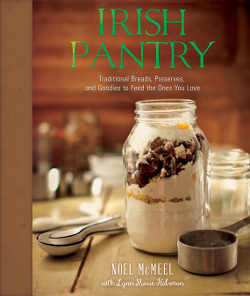
 IRISH PANTRY: Traditional Breads, Preserves and Goodies to Feed the Ones You Love By Noel McMeel With Lynn Marie Hulsman; photographs by Steve Legato. Running Press, hardback 320pp. Price €25.00, £18.99.
IRISH PANTRY: Traditional Breads, Preserves and Goodies to Feed the Ones You Love By Noel McMeel With Lynn Marie Hulsman; photographs by Steve Legato. Running Press, hardback 320pp. Price €25.00, £18.99.
The number of cookery books published each year is mind boggling, but there is a depressing sameness about most of them.
Perhaps it is a reflection on the relative ease with which a book can be published since the digital revolution, that so many of them are unoriginal and do little more than re-package a predictable collection of all-too-familiar recipes. Happily, this handsome hardback from one of Northern Ireland’s best known chefs, Noel McMeel, bucks the trend.
You wouldn’t feed a family using his recipes, but you could certainly spoil them - and you could stock up with all the treats to be shared and enjoyed with those ‘unexpected visitors’, or to be given as gifts on departure - or for any of the little milestones in life when something personal is called for: a handmade jar of jam or chutney, a loaf of crusty soda bread, a tin of biscuits, a freshly baked cake, or a box of carefully wrapped homemade sweets all speak volumes.
Noel - who has an impressive c.v. and is currently Executive Head Chef at Lough Erne Resort in Fermanagh, venue of the recent G8 Summit - grew up on a farm at Toomebridge, Co Antrim (a place we know well from working on our Taste of the Waterways guides) and, like many others who have found a lifetime’s fulfilment in the kitchen, it all started with the farm, the seasonal foods of the area, and his mother’s kitchen.
Many people who remember a country childhood will feel a surge of recognition when reading Noel’s description of his mother’s kitchen pantry, which “featured a cooling marble slab and sighing shelves laden with traditional and delicious treats standing at the ready to sustain her large family, or to celebrate the vibrant stream of expected and unexpected guests they loved to welcome.”
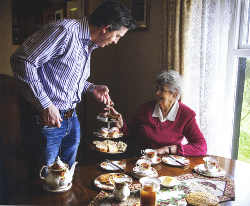 Noel’s philosophy is to “Find the very best local ingredients. Support farms and grocers that respect the earth. Prepare meals that delight and excite the senses, but don’t get seduced into over complicating. Above all else, let the natural flavour of good food shine through.” A sound foundation for a cooking style that embraces traditional Irish roots while also welcoming influences from time spent working in Europe and the United States.
Noel’s philosophy is to “Find the very best local ingredients. Support farms and grocers that respect the earth. Prepare meals that delight and excite the senses, but don’t get seduced into over complicating. Above all else, let the natural flavour of good food shine through.” A sound foundation for a cooking style that embraces traditional Irish roots while also welcoming influences from time spent working in Europe and the United States.
All of this is reflected in Irish Pantry, including the international influences - in fact the book, which was published in Philadelphia and has an American co-author, has a distinctly American tone with US measurements put ahead of European ones and a good sprinkling of un-Irish recipes, including the likes of Jamaican jerk rub, graham crackers, watermelon rind pickles, garam masala and ‘a simple Chinese dressing’ among the surprises.
And Irish Pantry is not all about nostalgia either. Many practical hints from Noel’s professional training and experience as a teacher are passed on to ensure success, no matter how little cooking experience you may have, and he explores traditional techniques that are currently enjoying a revival like potting, curing and pickling, unusual condiments (include a saltless seasoning salt), and some intriguing drinks - did you know you could make your own ‘Irish cream’? And, says Noel, it’s “embarrassingly easy to make” too.
A lovely gift book, and one that’s sure to be a treasured souvenir for its sense of place - especially perhaps by guests at the Lough Erne Resort, who may have enjoyed some of the recipes during their stay.
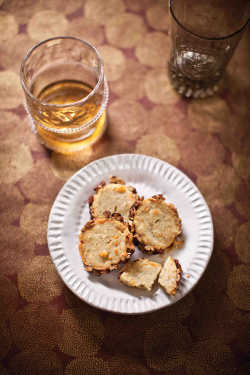 SAMPLE RECIPE: Blue Cheese and Pecan Crackers
SAMPLE RECIPE: Blue Cheese and Pecan Crackers
Cashel Blue is an example of one of Ireland’s many fine cheeses. Fragrant and sharp, baked into crackers, it’s a great accompaniment to fruity white wines and full-bodied reds.
Makes about 21/2 dozen crackers
8 tablespoons (1 stick) / 120 grams unsalted butter, at room temperature
8 ounces / 230 grams blue cheese, such as Cashel Blue, crumbled, at room temperature
11/2 cups / 180 grams all-purpose flour, plus more for dusting
2 teaspoons kosher salt
1 teaspoon freshly ground black pepper
2 medium-size eggs, beaten
1/2 cup / 75 grams roughly chopped pecans
In the bowl of an electric mixer fitted with the paddle attachment, cream the butter and blue cheese together on high speed for 1 minute, or until smooth.
With the mixer on low speed, add the flour, salt, and pepper and mix until it’s in large crumbles, about 1 minute.
Add 1 tablespoon of water and mix until combined.
Dump the dough onto a floured board, press it into a ball, and roll it into a 12-inch /30-centimeter-long log.
Brush the log completely with the egg wash.
Spread the pecans in a square on a cutting board and roll the log back and forth in the pecans, pressing lightly, distributing them evenly on the outside of the log. Wrap in plastic wrap and refrigerate for at least 30 minutes or for up to 4 days.
Meanwhile, preheat the oven to 350°F / 175°C. Line a baking sheet with parchment paper.
With a sharp knife, cut the log into slices 3/8 inch / 9 millimeters thick and place them on the prepared pan.
Bake for 22 minutes, until very lightly browned. Rotate the pan once during baking.
Transfer to a cooling rack, and let cool completely, and serve at room temperature, or store in an airtight container in a cool, dark place for up to a month.
Book Review - The Extra Virigin Kitchen by Susan Jane White
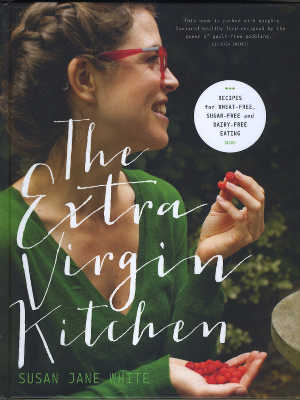
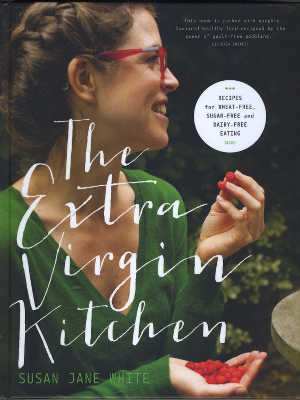 The Extra Virgin Kitchen, Recipes for Wheat, Sugar and Dairy-Free Eating by Susan Jane White with photographs by Joanne Murphy (Gill & Macmillan, hardback, 262pp; €27.99).
The Extra Virgin Kitchen, Recipes for Wheat, Sugar and Dairy-Free Eating by Susan Jane White with photographs by Joanne Murphy (Gill & Macmillan, hardback, 262pp; €27.99).
“Sinfully delicious recipes for wheat-free, sugar-free and dairy-free eating” are the promise in this handsome and very timely book from Susan Jane White, a well known specialist writer who has earned a following for her entertaining and insightful column in the Sunday Independent’s Life magazine.
Demand for free-from food and advice on food intolerance is one of the fastest areas of growth in health and nutrition and, as is now widely documented, Susan Jane’s interest in it came the hard way, through personal experience of health problems that turned out to be caused by intolerance to wheat and sugar.
Typically, she chose not to see this as restrictive but as “an opportunity to escape the shackles of energy-sapping processed food.” And, as anyone who has met her - glowing with health and brimming with energy and enthusiasm - will agree, Susan Jane is the best possible advert for the pure food philosophy she advocates.
A lot of the recipes use ordinary everyday ingredients, less familiar ones may come from specialist shops (there is a list of favourites), but the range and variety of dishes will surprise many who think in terms of ‘special diets’ and this persuasive and very readable book will entice you to give it a go, especially as there’s something for everyone here, including the children.
A good place to start would be to have some fun with a spiraliser (which makes pasta-like ribbons from vegetables), or knock up a batch of hazelnut and raisin freezer cookies, strawberry shortbread or beetroot candy for a treat.
Then maybe think about some superfoods - brazil nut pesto, perhaps, sprouting seeds, or ocean vegetables (“seaweed is the next big thing”). Vegetables, whole grains, pulses are all major players in the Virgin Kitchen but, while animal proteins play a secondary role, you can also enjoy familiar main courses like roast chicken, which Susan Jane pairs here with gremolata and charred pumpkin. But the single most-missed food mentioned by people on wheat-free diets is good bread - so why not try her buckwheat bread and see how it goes.
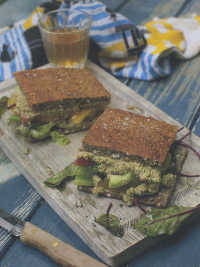 RECIPE: YOUR NEW WHEAT-FREE BREAD
RECIPE: YOUR NEW WHEAT-FREE BREAD
Few pleasures in life con compete with tearing open a hot focaccia. I'm not suggesting you quarantine or banish such pleasures. On the contrary, let's celebrate these delights for what they are and enjoy them from time to time.
For a wholegrain and nourishing alternative, I recommend inaugurating this recipe to your life. And your freezer. It tastes like Irish brown bread, but without the bloating often associated with wheat.
½ cup buckwheat flour
½ cup organic soya flour
2 teaspoons baking powder
1 teaspoon Herbamare seasoning, celery salt or sea salt
1 teaspoon ground ginger
1 teaspoon ground cinnamon
2 cups almond milk, oat milk or hemp
¾ cup millet or barley flakes
¾ cup sunflower seeds
½ cup whole buckwheat grains
1-2 tablespoons honey, barley malt or maple syrup (optional).
Makes one loaf
Preheat the oven to 200°C/180°C fan/400°F. Line a shallow tin just smaller than a magazine page with greaseproof paper. We're going to bake this in a tray rather than a loaf tin, so when it's cooked, we'll cut it into squares. Each square can be used for a sambo, sliced horizontally like a bap.
Sieve the flours, baking powder, seasoning and spices into a large bowl to introduce air and make it fluffy. Try not to omit the spices, as they are central to this bread.
Add the milk, millet flakes, sunflower seeds, whole buckwheat grains and honey (if using). It should be a pouring consistency and be quite runny. Pour the batter into the lined tin.
Bake for 35-40 minutes, depending on the depth of the tray you are using. Remove from the oven, allow to cool on a wire rack and divide into quarters. Looks really slick.
Once you taste this buckwheat bread, you'll never want to buy bread again. Freeze in quarters, ready to split horizontally and toast every morning.
Book Review - The Proof is in the Pudding - Kelly's Black & White Pudding Recipes

 Available from Kellys Butchers, Newport, Co. Mayo; The Castle Bookshop, Castlebar; and online from mayobooks.ie Price: €15, with proceeds going to Cystic Fibrosis West.
Available from Kellys Butchers, Newport, Co. Mayo; The Castle Bookshop, Castlebar; and online from mayobooks.ie Price: €15, with proceeds going to Cystic Fibrosis West.
There may be nothing new about black (and white) pudding in Ireland, it’s been a great everyday food for generations. But this traditional pork product did slip a bit in the popularity stakes for a couple of decades while we were getting used to the idea of ‘being modern’ and enjoying international cuisine - and eating less of the full Irish too.
Then the late great Gerry Galvin and several other like-minded chefs instigated a revival by using pudding - especially black pudding - as an ingredient in their restaurant dishes in the ‘70s and ‘80s.
And just look at them now. Puddings have never been more popular, and not just in the traditional cooked breakfast either. Practically every self-respecting restaurant now has a house speciality of some sort based on black or white pudding, and very good most of them are too.
A few specialist butchers have the competitive edge when it comes to the core product and Kelly’s of Newport - winners of a gold medal from the Confrerie des Chevaliers du Goute-Boudin (The Black Pudding Fraternity of Lovers of Good Food), no less - are among the very best.
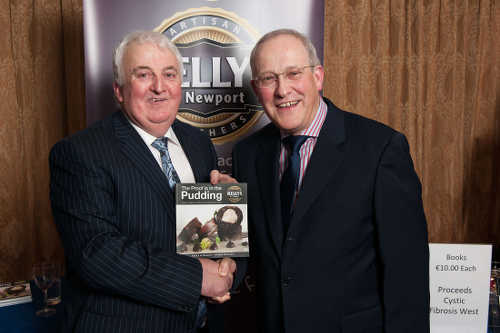 So who better to make up a compilation of pudding recipes? And no ordinary compilation either, but a very smart 124 page book, proudly compiled, edited, designed, printed and marketed in Mayo - and even with a Foreword by the First Man of Mayo, An Taoiseach, Enda Kenny.
So who better to make up a compilation of pudding recipes? And no ordinary compilation either, but a very smart 124 page book, proudly compiled, edited, designed, printed and marketed in Mayo - and even with a Foreword by the First Man of Mayo, An Taoiseach, Enda Kenny.
But, while the key products and the book itself undoubtedly represent Mayo’s best, the recipes come from the best of chefs and cooks all over Ireland, and a very handsome little collection it makes.
The range is wide, covering everything from starters and snacks to sophisticated main courses and even dessert, so you’ll find inspiration for every taste and occasion here.
SAMPLE RECIPES:
If you’re new to black pudding and wondering whether to get some in the shop, you can try before you buy by popping into Kelly's Kitchen restaurant next door, which is run by Sean’s daughter Shauna Kelly.
Many of the ingredients come from her Dad’s butchers and once you’ve enjoyed some of her simple, tasty fare - like this appealing combination of black pudding and organic goat’s cheese from Co Clare - you’ll be hooked.
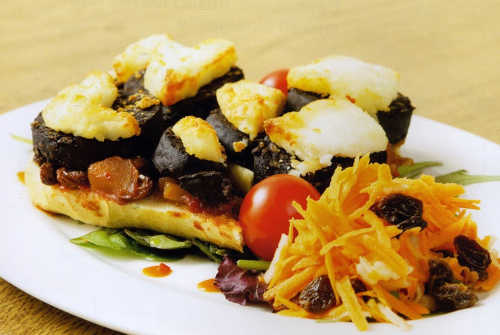 Black Goat
Black Goat
Serves 2
8 slices of Kelly's award winning black pudding
8 tablespoons of Kelly's kitchen home-made tomato relish
one long crusty baguette
8 slices of St Tola organic goat's cheese
1 tablespoon of rapeseed oil
Preheat the oven to 180°C.
Heat the rapeseed oil in a non-stick frying pan.
Cook the Kelly's Black Pudding for approx 2 minutes on each side.
Cut the baguette lengthways in half and smother with home-made tomato relish.
Next cut the Black Puddings in half and place on top of the relish, and then cover liberally with St Tola organic goat's cheese.
Place each baguette half in the preheated oven for 5-6 minutes, or until the goat's cheese is bubbling.
To serve cut each baguette into 3 pieces and serve with a seasonal salad.
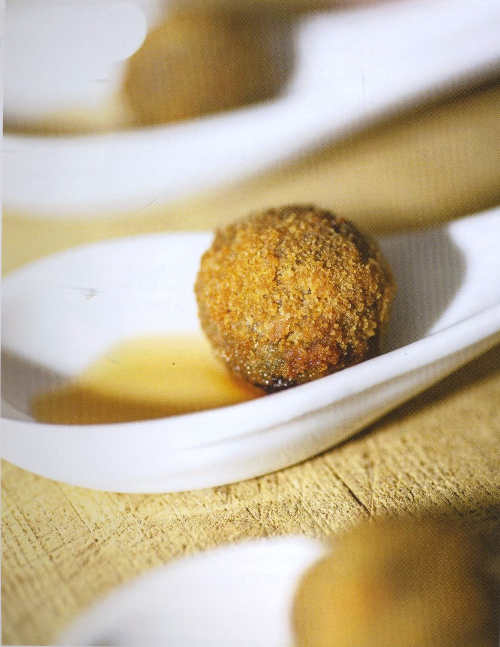 Kelly's Black Pudding And Chocolate Truffles
Kelly's Black Pudding And Chocolate Truffles
Jonathan Keane, head chef at the Lodge at Ashford Castle (formerly Lisloughrey Lodge), contributed these unusual sweet/savoury morsels to The Proof is in The Pudding: “Here at Wildes Restaurant we serve these tasty little appetisers on a Chinese spoon with some fig vinegar and a mint leaf. Can also be served at dinner parties with some melted Westport Grove
marmalade.”
Makes 10
100g Kellys putog
10 small squares 72% dark chocolate
50g flour
2 eggs
100g breadcrumbs (dried)
Blitz the putog in a food processor to make a smooth paste.
Roll the putog into 10 balls, then insert a square of chocolate into each one.
Roll the truffles in flour, followed by beaten egg and then breadcrumbs.
Leave in fridge to set for 15 minutes.
Deep-fry at 180°C until golden brown.
Book Review - The Pleasures of the Table, Rediscovering Theodora FitzGibbon by Donal Skehan
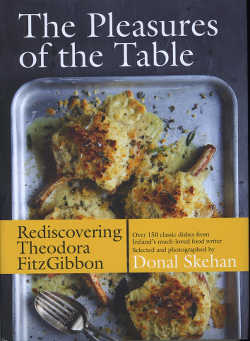
 Georgina Campbell
Georgina Campbell
The Pleasures of the Table, Rediscovering Theodora FitzGibbon. Over 150 classic dishes from Ireland’s much-loved food writer selected and photographed by Donal Skehan (Gill & Macmillan hardback, with photographs by Donal Skehan, €24.99).
A sort of Irish ‘Julie & Julia’, the aim of this new collection of recipes from the late Theodora FitzGibbon’s many books is to introduce the Irish grande dame of cookery writing in the 1970s and ‘80s to a new generation. And this it should achieve very well, thanks to the choice of one of Ireland’s most popular young TV cooks and writers, the charismatic Donal Skehan, to perform the introduction.
Donal’s keenly observed introductory remarks show his appreciation of this strong, unconventional and glamorous woman, and how much he relished the job - which included being ‘interviewed’ by her husband, the film-maker and archivist George Morrison, who must have approved of the ‘young man’ undertaking the project, as he not only supplied the wonderfully evocative images of Theodora that are sprinkled through the book, but also let Donal into the ‘three key components’ of a good food photograph. Whether by coincidence or as a result of this useful advice, Donal’s photography of a selection of the recipes (handsomely styled by Sharon Hearne-Smith) is a highlight of the book.
Donal’s introduction, and the tributes from diverse figures ranging from George Morrison to Darina Allen and Mary O’Rourke, put this dominant figure of Irish cookery into context with reference to her extensive travelling (mainly with her father and her first husband, the writer Constantine FitzGibbon), and a bohemian life in which she rubbed shoulders with the cultural giants of the day and had many opportunities to explore the food of other countries.
In Ireland she was perhaps mainly defined by her role as The Irish Times cookery writer and this is highlighted in the tributes, although - this being a feel good book - the manner of her departure from the paper is not mentioned. Those of us who knew her at the time were saddened by the lack of respect afforded to her, after providing avidly-followed contributions over two decades. Her peers showed their support in a practical manner, however, by making her the inaugural President of the Irish Food Writers’ Guild on its formation in 1990 - and you will find a portrait of her in the Dublin Writers’ Museum.
As to the recipes themselves - which are presented without comment, pretty much as they would have appeared in previous publications - Donal has chosen them well to give a true representation of her style.
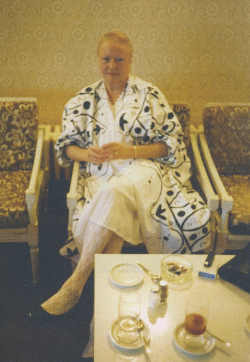 Many are not ‘her’ recipes but European classics popular at the time (and none the worse for that), but the more interesting ones are Irish, from books such as A Taste of Ireland (1968) and Irish Traditional Food (1983), and she deserves particular credit for championing Irish country cooking and Irish food history at a time when so many were muttering about there being ‘no such thing as Irish cuisine’ and looking to international recipes for inspiration.
Many are not ‘her’ recipes but European classics popular at the time (and none the worse for that), but the more interesting ones are Irish, from books such as A Taste of Ireland (1968) and Irish Traditional Food (1983), and she deserves particular credit for championing Irish country cooking and Irish food history at a time when so many were muttering about there being ‘no such thing as Irish cuisine’ and looking to international recipes for inspiration.
A Taste of Ireland was my own first cookery book on arrival in Belfast as a student and many of its simple, wholesome and inexpensive dishes became favourites in our house when it was my turn to cook, notably Dublin Coddle. Many people say they don’t like coddle - and I admit to having developed a more attractive version, dubbed Campbell’s Coddle, as boiled sausages and bacon do not appeal to everyone - but, as always with very simple dishes, it is the quality of the basic ingredients that make all the difference.
Strangely, however - and in direct contrast to Myrtle Allen’s Ballymaloe Cookbook (shortly to be re-issued), which was first published in 1977 - there is virtually no reference to provenance in Theodora’s recipes.
This attractive book is necessarily a mere sampling of Theodora’s work - and her most remarkable contribution was not Irish at all, but the encyclopaedic reference work, Food of the Western World.
For me, at least, it will not, as suggested, ‘replace her old cookbooks and the cut-out yellowed clippings from her column years ago’, but it is another one that I am very happy to add to the collection.
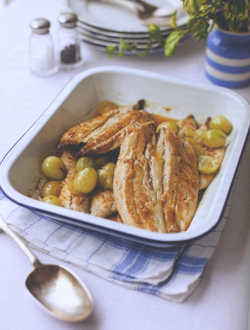 SAMPLE RECIPE: Mackerel with Gooseberries - goosberries being the first soft fruit of the year, this unusual variation on the classic fish and fruit combination is perfect for early summer.
SAMPLE RECIPE: Mackerel with Gooseberries - goosberries being the first soft fruit of the year, this unusual variation on the classic fish and fruit combination is perfect for early summer.
“Grilled or fried mackerel served with a gooseberry sauce is well known and very good, as the acid gooseberry cuts the oily flavour of the fish. But it can also be baked with gooseberries in cider.”
4 mackerel, cleaned and filleted
225 g (8 oz) gooseberries
2 tablespoons brown sugar or to taste
pinch ground nutmeg
salt
approx. 300 ml (1/2 pint) cider
Top and tail the gooseberries, then mix well with the sugar and nutmeg.
Put a layer of mackerel in an ovenproof dish and cover with the gooseberries, then put the remaining layer of mackerel over the top. Sprinkle with salt and pour the cider over.
Cover and bake at 180°C/350°F/gas mark 4 for about 40 minutes.
Serves 2-4.
Book Reviews - Bread on the Table & Wholesome

 Two more cookery books from well known Irish food bloggers this month - anyone who thinks print is dead should take a look at the avalanche of food bloggers’ books that have appeared since Donal Skehan broke the mould with his Good Mood Food (Mercier Press, 2009). And also, perhaps, consider the ever-growing popularity of children’s books, a publishing phenomenon that’s growing a whole new generation of book lovers.
Two more cookery books from well known Irish food bloggers this month - anyone who thinks print is dead should take a look at the avalanche of food bloggers’ books that have appeared since Donal Skehan broke the mould with his Good Mood Food (Mercier Press, 2009). And also, perhaps, consider the ever-growing popularity of children’s books, a publishing phenomenon that’s growing a whole new generation of book lovers.
Bread on the Table, Baking Traditions for Today, by Valerie O’Connor (O’Brien Press, hardback 160pp, €19.99/£17.99).
I really like this first book by the Limerick food writer and blogger Valerie O’Connor (valskitchen.com). A knowledgeable and innovative cook, she has many strings to her culinary bow - not only as a cook, food writer, consultant and photographer, but also an organic horticulturalist, ‘city farmer’, and organiser of Limerick Food Trails.
How she found time to write, style and photograph this book with all that going on is a mystery, but it’s a credit to her and, even if you have other books on baking, this one merits a place on your kitchen bookshelf for its freshness and the high proportion of recipes that bring something original to the table.
All of the usual categories - yeast, soda, sourdough - are covered, also breads with seaweeds and wild herbs (happy partnerships with a long tradition), gluten-free bakes and some nice extras including butter making and flavoured butters.
The recipes are well organised and easy to follow and the interesting introductions have a tone of authority that will give confidence to beginner bakers, no doubt a side effect of Valerie’s popular baking classes.
Recipes that are different enough to make it a book that stands out from the crowd include Potato Bread (not the usual Irish potato bread, but a white yeast loaf using a combination of flour and mashed potatoes); Griddle Cake Burger Buns (cooked in the frying pan); Soda Bread Pizza (nice to see this one coming round again); Spelt Soda Bread with Dilisk (keeps better than traditional soda bread); and Black Pudding and Apple Scones (’great with tangy cheese and a pint’).
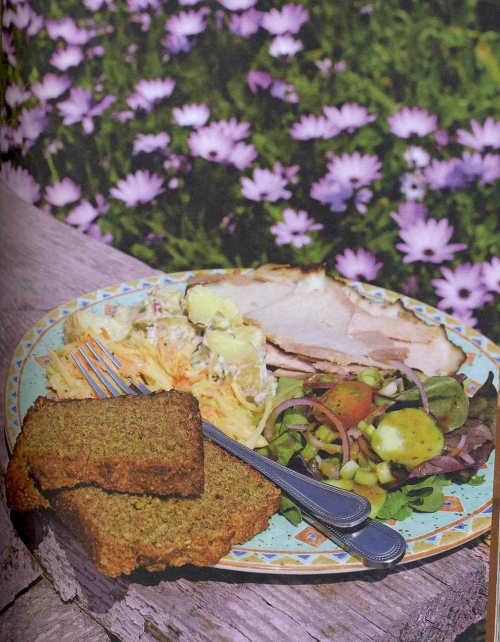 SAMPLE RECIPE: Brown Bread Nan Phadai
SAMPLE RECIPE: Brown Bread Nan Phadai
‘Brown soda bread is an institution in Ireland, one that inspires heated discussion amongst (mostly) women about quantities and techniques; some folk like to add wheatgerm and oats, some throw in an egg or a glug of oil.
I loved this bread from the first time I tasted it at the wonderful Tigh Nan Phadai cafe on Inis Mor, the largest of the Aran Islands, where I was met by six of the eight Concannon sisters, all of whom had their own take on bread recipes.
Their mother, who catered daily for her brood of twelve, baked three loaves of this every morning, along with another two cakes of white soda bread. If you think you don't have time to bake, think about Mrs Concannon!
This bread is simply perfect, and another easy one. If you visit Inis Mor be sure to stop at the cafe and try this bread with one of their amazing salads.’
Makes one large 2lb loaf
Ingredients:
700g/1 lb 8oz wholemeal flour
1 tsp salt
2 tsp bread soda
100g/4oz wheatgerm
700ml/1 pint 6fl oz buttermilk
50ml/2floz sunflower oil.
Preheat the oven to 190C/375F/Gas 5
Prepare a 2lb loaf tin by rubbing the insides with butter or oil
1. In a large bowl combine the flour with the salt, bread soda and wheat-germ, pour in the buttermilk and oil and mix with a spoon to a sloppy consistency.
2. Spoon the mixture into your prepared tin and bake in the oven for 10 minutes, then remove from the tin and return it to the oven for a further 10 minutes.Allow to cool on a wire rack.
3. This loaf has a delicious, crumbly texture so take care when cutting it. It works with just about everything from smoked salmon to ham or cheese, or just plain with butter.
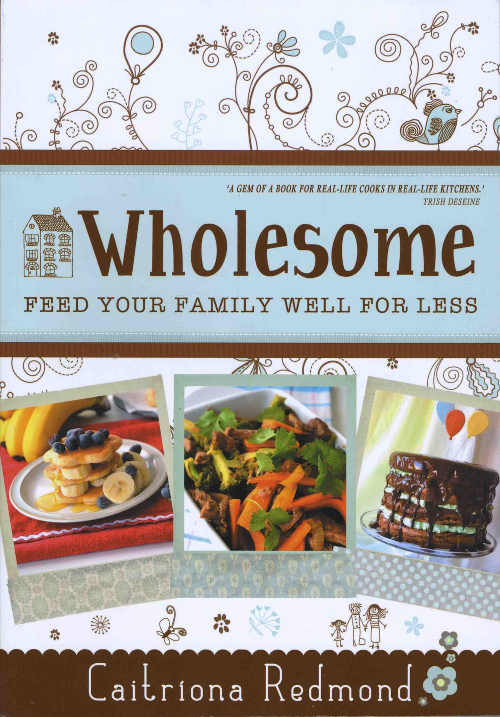 Wholesome: Feed Your Family Well for Less, by Caitriona Redmond (Mercier Press, paperback 256pp, €19.99).
Wholesome: Feed Your Family Well for Less, by Caitriona Redmond (Mercier Press, paperback 256pp, €19.99).
A heartening recessionary tale, this is the story of a steep learning curve originally driven by necessity - and that ultimately brought about a rewarding change of lifestyle for a home cook and her family.
‘Gone are the days when I filled a supermarket trolley without a care for what it would cost when I got to the checkout’ is an opening line that will resonate with many readers and, in this book, Caitriona Redmond (wholesomeireland.com) shares the tips and recipes that have helped her to keep to a budget of just €70 per week since she was made redundant in 2009 - and feed her husband and two boys very well into the bargain.
Once she got over the initial shock of redundancy Caitriona decided to apply the skills she had developed as a successful PA to the problem in hand. Approaching her kitchen as a business, with ingoing and outgoing items, she takes a forensically analytical approach to the situation - stocktaking, working out budgets (food and non-food items), compiling meal plans and shopping lists - and explains clearly and dispassionately the value of buying fresh instead of processed foods.
Regarding the latter, she is very honest - cheap processed foods such as pizza can actually work out cheaper than using fresh foods, and they certainly take less time to get onto the table. “There are three key things you need in order to serve up fresh food on a regular basis: Time; Skills; Information. By educating yourself and getting used to having fresh food in your kitchen you’ll find yourself less likely to pick up convenience food in the supermarket…There’s an old saying ‘what goes in must come out, and that can be applied to good and bad food.”
The extent of the journey for Caitriona is summed up by a comment in the introduction to the Roast Chicken recipe: “I used to roast a chicken, pick the two breasts off and then discard the rest. Oh my goodness, the sheer waste of it turns my stomach.” I have to admit that I was quite shocked by that admission, but you can’t help but admire the honesty - and she now stretches a chicken to provide two dinners for four, plus a batch of chicken stock. All easy to do if you know how.
Savvy shopping, storage, batch cooking, alternative protein sources, and ‘the emotional toll of living on a tight budget’ are all considered. If you’re in the same boat at the moment, you should be able to take heart from this comment: “When so much of my life was out of my control, cooking and nourishing my family was something I could control. It gives me great strength to be able to take ownership of and responsibility for the food we eat and where it comes from.”
This is in a sense a social commentary as much as a cookery book. That the book had to be written at all is a reflection on the lack of priority that we now give to the fuel a healthy body needs: good food.
If the Minister for Health wants to save money on hospitals, a serious longterm plan for food education would be the best place to start.
The proportion of our income that is spent on food has plummeted since the ‘cheap food policy’ was introduced in post-war Britain and (unintentionally) produced several generations that expected food to be cheap as a right, something we are paying heavily for now.
The skills of everyday home cooking and running a household that were once passed down from parent to child have almost been lost (although ‘hobby cooking’ is now having some positive impact), and the skills gap is not being filled in our schools.
Ironically, the good housekeeping that Caitriona Redmond advocates in Wholesome - the budgeting, the careful shopping, the meal plans, the batch cooking - was once the norm, and many famous and not so famous books have been written on the subject over several hundred years. Plus ca change…
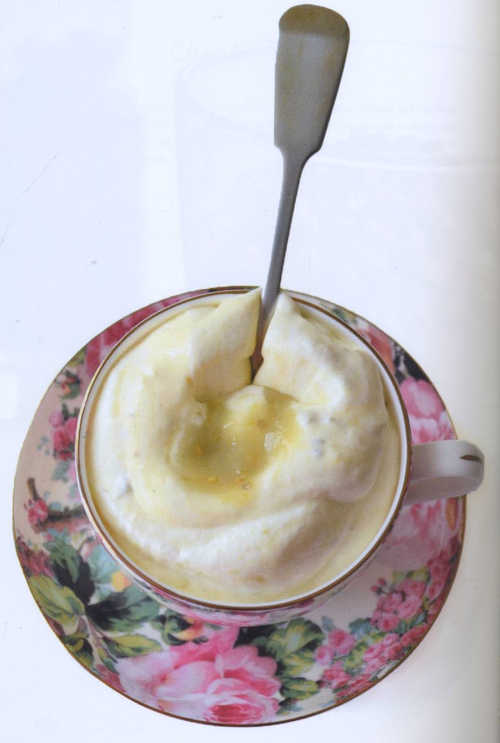 SAMPLE RECIPE: Gooseberry Fool
SAMPLE RECIPE: Gooseberry Fool
‘While gooseberry fool is a very seasonal treat for the middle of the summer when gooseberries are ripe, you can enjoy fool all year round -just change the type of fruit you use, or use frozen gooseberries.’
Serves 5
• 200g fresh gooseberries • 3 tablespoons sugar • 200ml milk
• 1 teaspoon vanilla extract • 2 egg yolks • 1 tablespoon cornflour
•150ml fresh cream
Method
Put the gooseberries and 2 tablespoons of the sugar in a small saucepan and heat on low. Leave to simmer gently until all the fruit has popped. Once it has popped, mash with a potato masher, then strain away the larger pieces through a sieve.
Heat the milk in a large saucepan along with the vanilla extract. Put the egg yolks, cornflour and the remaining tablespoon of sugar in a mug and stir with a fork.
When the milk is warm, pour this mixture into the milk and whisk well. Continue to lightly whisk the milk as it comes to the boil. Keep on whisking until it becomes thick and fluffy. Remove from the heat and allow to cool.
Once all the ingredients are cold, whip the cream to loose peaks. Pour half the whipped cream into the custard mixture and stir with a spoon. Pour in the gooseberry sauce. Stir again and then fold in the rest of the cream.
Serve immediately in individual glasses/cups.
Book Reviews - No-Bake Baking
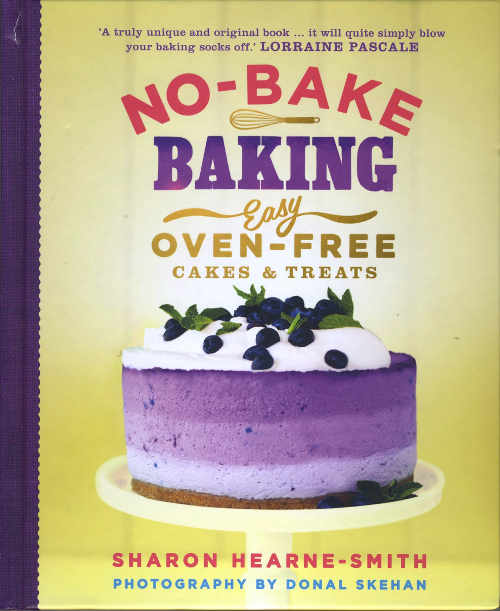
 NO-BAKE BAKING Easy Oven-free Cakes & Treats by Sharon Hearne-Smith with Photography by Donal Skehan (Quercus, £16.99 Hardback).
NO-BAKE BAKING Easy Oven-free Cakes & Treats by Sharon Hearne-Smith with Photography by Donal Skehan (Quercus, £16.99 Hardback).
Although this is her own first book, food stylist Sharon Hearne-Smith’s name will be well known to aficionados who read the credits on the major TV food shows and ogle the gorgeous food shots that she sets up for magazine features and cookery books by many of Britain and Ireland’s most famous chefs.
Her styling and editorial work attracts plenty of well-deserved praise, but this job was special and she has pulled out all the stops to show that, despite the huge numbers of cookbooks that pour off the presses these days, it is still possible to be different - and partnering with the multi-talented Donal Skehan as photographer was a stroke of genius, giving the reader double value and adding to Sharon’s own great sense of style and fun.
You could be forgiven for thinking that everyone’s into home baking these days, but no one is better placed than a food stylist to see what’s really going on and Sharon has clearly sensed that there’s a whole raft of people out there who like the idea but may be reluctant to try it themselves.
And so the concept of oven-free baking was born. It is, she says, ‘perfect for novices, cooking with kids or anyone who’s short on time’, and - although no-bake does not mean no-cook - the range of treats that she has lined up using alternative cooking and preparation methods to ‘magic them up’ is impressive.
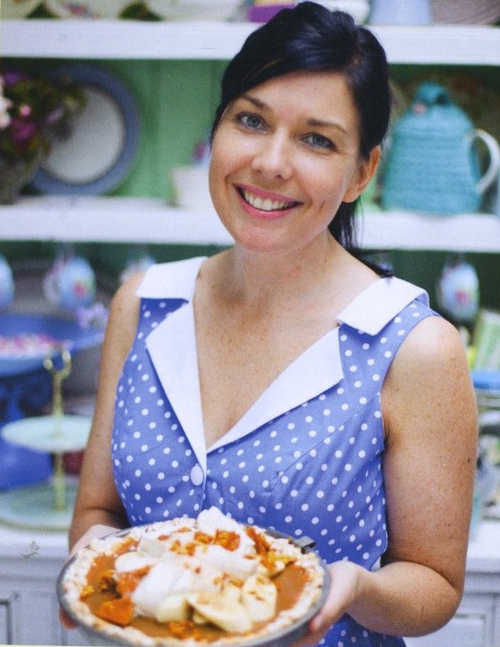 The oven may be taboo, but anything else that can cook or heat - the hob, microwave, slow cooker and bread machine, for example - is called into action, along with the all-important fridge and freezer for those irresistible cold sweets and refrigerator cakes; I’m sure it won’t be long before Sharon’s Frozen Yoghurt Breakfast Ring starts appearing on B&B menus around the country.
The oven may be taboo, but anything else that can cook or heat - the hob, microwave, slow cooker and bread machine, for example - is called into action, along with the all-important fridge and freezer for those irresistible cold sweets and refrigerator cakes; I’m sure it won’t be long before Sharon’s Frozen Yoghurt Breakfast Ring starts appearing on B&B menus around the country.
While some very easy recipes may include completed ingredients such as biscuits, you won’t find too many ‘how to cheat at cooking’ recipes here. But there are lots of fun ideas that the kids will love (anyone for Peppermint Cream Buttons, Watermelon Bombe or Eat-the-Bowl Peanut Butter Puds or Bumblebee Jelly Cake?) and some show-stopping special occasion cakes and desserts, such as a Jewelled Princess Castle Cake (a biscuit cake decorated with towering white chocolate shards be-jewelled with dried fruits and nuts, edible gold balls and glitter), the Candy-Stripe Blueberry Cheesecake that features on the cover, and the luscious Strawberry Charlotte, given below.
Published in London, priced in sterling and boasting cover quotes from Jamie Oliver, Lorraine Pascale and Rachel Allen, No-Bake Baking is well and truly aimed at the international market - and this original book is set to be big success.
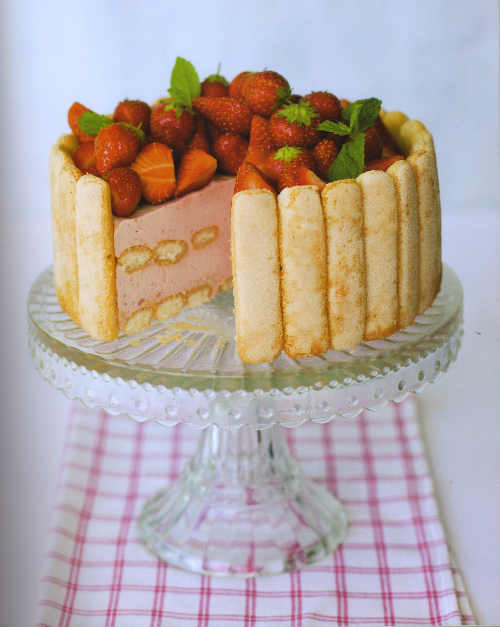 RECIPE: Sharon’s handsome Strawberry Charlotte would make an impressive seasonal centre piece for a summer party
RECIPE: Sharon’s handsome Strawberry Charlotte would make an impressive seasonal centre piece for a summer party
A charlotte is a French cake in which sponge fingers form the sides, concealing a set fruit mousse filling. You can add chopped strawberries to the filling if you want more texture and colour throughout.
Serves 8-10
200g caster sugar
Sunflower oil, for greasing
350g sponge fingers (about 60 depending on size)
FILLING:
8 gelatine leaves
400g Strawberry Purée (see below)
100g caster sugar
325ml double cream
500g natural yoghurt or natural fromage frais
TO FINISH:
500g fresh strawberries, halved if large and with most green tops removed
Small handful of fresh mint sprigs
150ml double cream, softly whipped
ESSENTIAL KIT:
20cm round, spring form cake tin
STRAWBERRY PURÉE: Makes 200g, so make a double batch
250g fresh strawberries
Optional: 1-3 tsp icing sugar; a little lime juice.
Wash the berries and remove any green tops. Blend in a food processor or liquidiser until completely smooth. Pass through a sieve into a bowl. If you like, add sifted icing sugar a teaspoon at a time to give your preferred sweetness, or add a squeeze of lime juice to give a bit of bite.
This is now ready to serve but will keep for 2-3 days in the fridge.
1. For the filling, soak the gelatine leaves in just enough cold water to cover, for 5-10minutes until soft. Make the strawberry purée if you haven’t yet, pour into a wide frying pan and simmer over a medium heat for about 5 minutes until reduced by half and thickened.
2. Meanwhile, place the sugar for the sponge fingers in a medium saucepan with 200ml of water and bring to the boil on a high heat, stirring until dissolved. Give it another minute before pouring into a wide baking dish. Leave the sugar syrup to cool slightly.
3. When the purée has reduced, stir in the filling sugar until dissolved, then remove from the heat. Squeeze excess water from the soft gelatine and stir into the puree until dissolved. Leave to cool.
4. Whip the cream in a large bowl until just stiff. Fold into the yoghurt or fromage frais in another large bowl until blended.
5. Grease the tin and line the sides with parchment. Soak a few biscuits at a time in the sugar syrup for 30-60 seconds, turning halfway, until softened but not soggy or breaking. Carefully place upright against he tin edge, sugared side outwards. You will need about 30. Soak half the remaining biscuits in the syrup and lay them flat in the tin, trimming to cover the base completely.
6. Gently fold the cooled purée into the cream mixture until well blended, pour half into the tin and smooth with the back of a spoon. Soak the remaining biscuits in the syrup and arrange on top, trimming to fit. Pour the remaining filling over, smoothing again. Cover with cling film and chill for 3hours or overnight until firm.
7. Carefully remove from the tin, place on a stand and peel away the paper. Decorate with strawberries and mint sprigs on top. Cut into wedges and serve with softly whipped cream.
Book Reviews
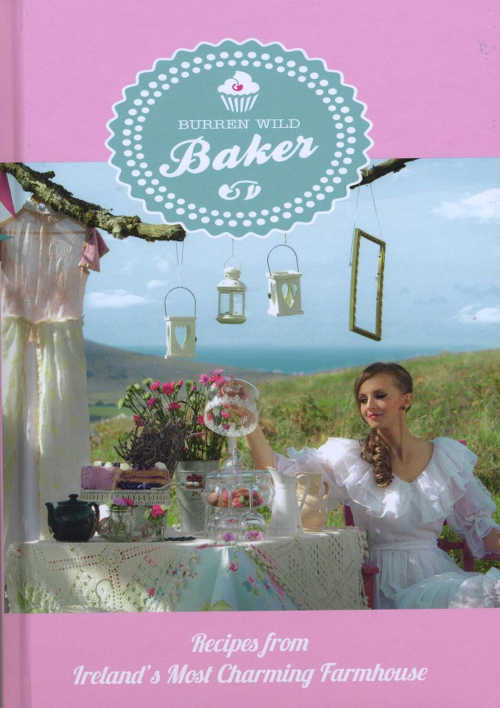
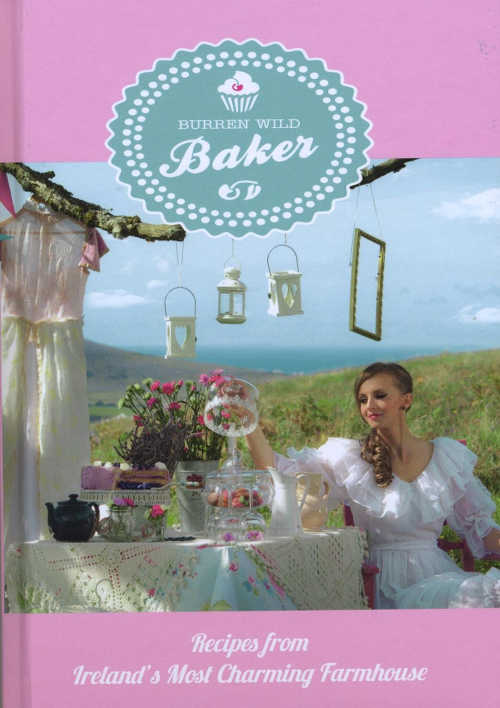 A touch of summer magic comes into play this month, as we look at a couple of quirky cookbooks from original cooks in Clare and Kerry - and also an unusual supermarket magazine, Fresh, which has the focus very clearly on local Irish producers and suppliers, some of whom are graduates of The Food Academy, a collaboration between Bord Bia, Local Enterprise Offices and SuperValu that provides support for start-up businesses.
A touch of summer magic comes into play this month, as we look at a couple of quirky cookbooks from original cooks in Clare and Kerry - and also an unusual supermarket magazine, Fresh, which has the focus very clearly on local Irish producers and suppliers, some of whom are graduates of The Food Academy, a collaboration between Bord Bia, Local Enterprise Offices and SuperValu that provides support for start-up businesses.
And, with that in mind, we’re thinking ahead to the ‘new school year’ time, when we’re all in the mood to learn and begin new projects - whether that is starting a new food enterprise or re-energising your business, ‘Money For Jam’ and ‘Sales Tales’ (see below) are sure to inspire you.
Burren Wild Baker, Recipes from Ireland’s Most Charming Farmhouse, by Kasha Connolly (Hazel Mountain Publications 2014, hardback 78pp €20).
Originally from Poland, Kasha Connolly is a third generation baker and chocolatier whose walking guide husband, John, runs Burren Wild Tours from the Bellharbour cottage farmhouse he inherited from his granny, Agnes. It is now home to this enterprising lady’s Hazel Mountain Chocolates and Granny’s Cottage café, where Agnes is ‘fondly remembered for her heavenly cakes’.
You can buy this collection of recipes online (burrenwildbaker.com) but it’s better by far to visit John and Kasha’s cottage, enjoy a few delicious bakes in the sweet café, and come away with some chocolates as well as a copy or two of the book.
Blueberry Picnic Cake is a good sample recipe for this month, as blueberries are in season in August (produced commercially at Derryvilla Blueberry Farm near Portarlington; 087 2466643 or 057 8642882), and so is their wild cousin, the bilberry or fraughan, which grows abundantly in moorland areas - if you can get there before the birds.
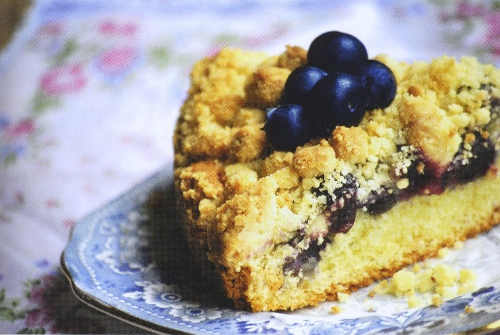 SAMPLE RECIPE: Blueberry Picnic Cake
SAMPLE RECIPE: Blueberry Picnic Cake
INGREDIENTS
For the crumble
70 g butter
60 g caster sugar
10 g vanilla sugar
140 g plain flour
For the cake
110 g soft butter
120 g icing sugar
1 large egg
½ teaspoon vanilla extract
210 g plain flour
40 g potato flour
1½ teaspoons baking powder
120 g sour cream
250 g fresh blueberries
Note: All ingredients need to be at room temperature,
YOU WILL NEED: 23 cm springform, base lined with baking paper, sides lightly greased with unsalted butter.
OVEN: Preheat the oven to 180°C.
METHOD
Crumble
Melt the butter on a low heat, then take off the heat and add both sue and the flour. Mix until it resembles breadcrumbs. Put it to one side.
Cake
Cream the butter and icing sugar until light and fluffy. Add egg and vanilla extract and continue mixing for a further 3 minutes.
Separately sieve both flours and baking powder together. Add the flour and the sour cream consecutively, one third at a time to the creamed butter and sugar, folding after each addition. Do not beat. The mixture will be quite thick.
Transfer the mixture into the prepared baking tin, sprinkle blueberries and then the crumble evenly over the top.
Bake for 50-55 minutes.
To serve
Sprinkle with icing sugar once the cake has cooled.
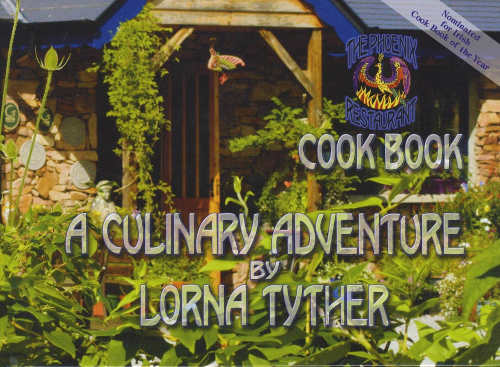 The Phoenix Restaurant Cookbook, A Culinary Adventure by Lorna Tyther hardback 134pp (Firebird Publishers, 2011).
The Phoenix Restaurant Cookbook, A Culinary Adventure by Lorna Tyther hardback 134pp (Firebird Publishers, 2011).
A dancer by profession, Lorna Tyther is the larger than life character who runs the quirky Phoenix Restaurant on the R561 near Tralee - a must-stop destination for a bite on the way to or from Dingle, it’s almost vegetarian although some fish dishes are also offered these days.
Wonderfully warm and creative, there’s more than a touch of the hippy about Lorna and her restaurant, and everybody loves it for its laid back individuality - and the delicious fresh garden produce that goes into much of the food. It’s also the place to buy this original book, which is not new but well worth looking out for, for its happy combination of stories and lovely wholesome, do-able recipes, most of which are dairy and gluten free.
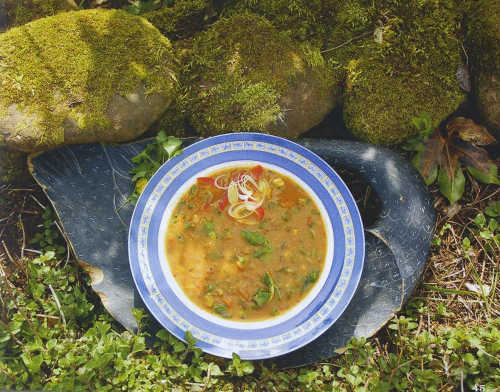 SAMPLE RECIPE: CHARD & TOMATO SOUP
SAMPLE RECIPE: CHARD & TOMATO SOUP
“A soup does not always have to be thick and creamy. This soup is great when there is an abundance of chard and ripe tomatoes.”
Large colander of Chard, well chopped
2 Yellow Peppers, finely diced
2 Sweet Potatoes, finely diced
10 fresh Tomatoes, peeled and finely diced
5 Garlic Cloves, finely diced
1 teaspoon Coriander Seed, ground in a pestle and mortar
A thin slice of Organic Lemon
1/4 teaspoon Cayenne Pepper (optional)
2 teaspoons Paprika
2 tablespoons Olive Oil
Salt & Black Pepper
4 mugs of Water
Parsley
Sunflower Oil for frying
Fry the garlic with the coriander and then add the chard (do use the entire chard, white stem and all).
Add the tomatoes. Pick the ones which are fabulous and sweet today but will definitely be past their sell by date tomorrow.
Add the peppers and potatoes and sauté for a few minutes and then add the rest of the spices.
Add the water along with the lemon slice and simmer until everything is soft.
Remove half the ingredients, including the slice of lemon and liquidise. Return to the pan, season well with salt and pepper and add the olive oil.
Reduce and serve with a sprig of fresh parsley and plenty of black pepper.
Playing with colours
Pre-cooked pulses such as deep red kidney, aduki or even butter beans give a great variation in colour and texture, turning this tangy, light summer soup into a protein rich meal in a bowl.
Instead of serving bread with soup it may be served with a cooked grain such as rice, millet or quinoa. If you have friends or family members who are intolerant to yeast or wheat this can make a pleasant change.
Fresh is the SuperValu magazine, not something that would normally be reviewed, but it’s unusual for a supermarket publication to have such a strong focus on local producers and suppliers, right down to involvement with The Food Academy (see above).
They’re certainly putting their money where their mouths are, and this is seen also in their longterm relationship with chef Kevin Dundon, who is well known for his commitment to local producers, and the excellent choice of former Food&Wine Magazine editor - currently co-editor with Donal Skehan of the gorgeous quarterly magazine FEAST, A Dinner Journal - Ross Golden-Bannon, as Editor of fresh.
The SuperValu family includes some truly iconic shops - personally run town-centre businesses like Field’s of Skibbereen and Scally’s of Clonakilty spring to mind - proving that supermarkets need not necessarily have a negative effect on towns, local community or producers.
The editorial content in fresh is interesting too of course, and there are loads of good recipes, including this easy seasonal side dish from a barbecue feature by Kevin Dundon.
SAMPLE RECIPE: CHERRY TOMATOES AND COURGETTE SKEWERS
Serves 4
12 SuperValu cherry tomatoes
2 SuperValu courgettes, or one large one
1 SuperValu onion, quartered
1 SuperValu lemon, quartered, to serve
2 tablespoon SuperValu Olive Oil
8 Skewers, soaked in water if wooden to prevent burning
1 Preheat the barbecue or griddle pan to medium.
2 Cut the courgettes side-ways so you have quite thick disks, about as think as your thumb. Thread the vegetable onto the skewers.
3 Brush the vegetables with olive oil and cook them on the grill, or roast them in the oven for 3 minutes on each side or until the vegetables are chargrilled. Put a squeeze of lemon on top before serving.
So, wholesome food is not only good for us, but it’s going to drive our economy back to health as well. If you’d like to play a practical role in that area of the recovery and take control of your own life instead of depending on employment from others, there is plenty of help and advice at hand, including The Food Academy (see above).
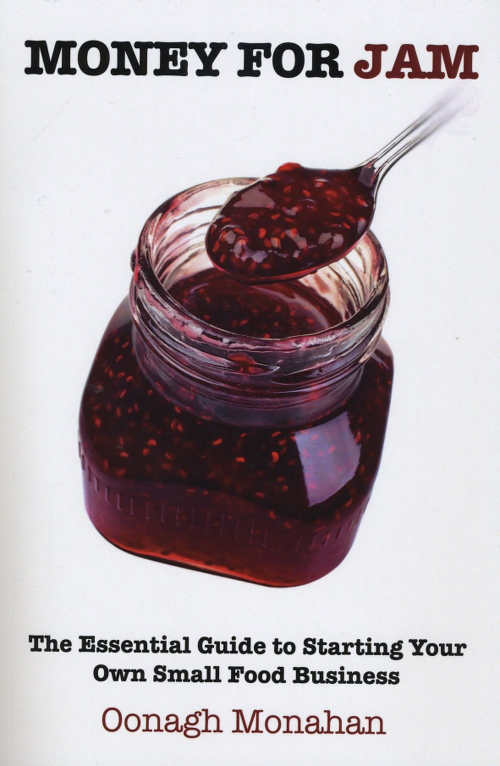 You would also be well advised to get hold of a copy of Oonagh Monahan’s Money for Jam, The Essential Guide to Starting Your Own Small Food Business (Oak Tree Press, paperback; €14.95).
You would also be well advised to get hold of a copy of Oonagh Monahan’s Money for Jam, The Essential Guide to Starting Your Own Small Food Business (Oak Tree Press, paperback; €14.95).
Encouraging and down to earth, she covers everything you need to know from consumer trends and opportunities, and deciding what to produce, through the minefield of legislation, food hygiene and product development, to branding, labelling, marketing and distribution- and much else besides. With a decade’s experience in helping a whole range of small food businesses to make it to market and to prosper, Oonagh is very well qualified to help, and this practical a book is laced with case studies to inspire and encourage.
But maybe you already have a business - in food or hospitality, perhaps. It’s survived the long hard years of recession, but is somewhat the worse for wear. They say the rising tide lifts all boats, but there are plenty of business owners around Ireland who are wondering about that at the moment and these businesses need re-energising.
 What’s needed to kick start a post-recession strategy will include some inspiration in the sales department - and, once you get past the rather scary cover, Conor Kenny’s thought provoking book Sales Tales, True Stories of How Great Sales Happen (Oak Tree Press, paperback; €14.95) could well be the read to get things started.
What’s needed to kick start a post-recession strategy will include some inspiration in the sales department - and, once you get past the rather scary cover, Conor Kenny’s thought provoking book Sales Tales, True Stories of How Great Sales Happen (Oak Tree Press, paperback; €14.95) could well be the read to get things started.
It’s based on 30 years of experience of a man who, he says modestly, ‘has learnt to sell largely by making a lot of mistakes and working hard to understand what inspires a reaction and what it is that it is that makes people buy or not.’
This very readable book is based on real life sales stories that illustrate the essential do’s - and don’ts - that will help to increase sales. It’s the voice of experience, and I can vouch for this as I know Conor personally, and work with his independent training and mentoring company Conor Kenny & Associates (www.conorkenny.com) on hospitality related business development programmes - watch out for details of the new programmes and workshops that we’re developing for the autumn and winter. They’re great fun, providing masses of immediately actionable learning and brilliant networking with likeminded people - I can’t wait to get going again.
Book Reviews
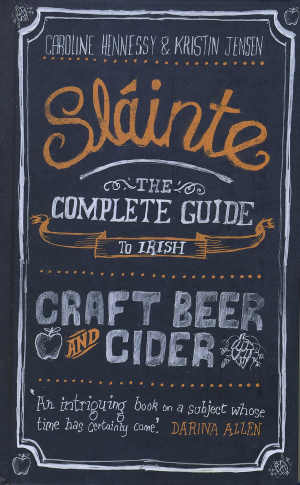
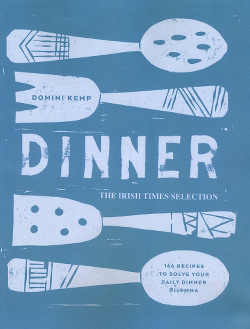 Georgina Campbell Reviews
Georgina Campbell Reviews
DINNER The Irish Times Selection, by Domini Kemp (Gill & Macmillan hardback, €22.99)
Fans of Domini Kemp’s brilliant weekly column in the Irish Times Weekend Magazine will be delighted to have so many of her best recipes brought together in a book, where they won’t be getting lost any more.
Subtitled ‘166 Recipes to Solve Your Daily Dinner Dilemma’, the focus of this collection is very clear and Domini has trawled through all the recipes she has written since starting her Irish Times column in 2008, to pick out the ‘quick hassle-free diners that you can get ion the table in an hour’.
And what a great collection it is. Domini doesn’t do gimmicks, but what she does do supremely well is to convey her enthusiasm for punchy, do-able dishes that give a nod to food trends and new ingredients, but are never ruled by fashion.
While there have been some big changes since 2008, Domini’s ‘love of great flavours, ease, comfort and, a lot of the time, healthy nutritious recipes’ has been a constant throughout, and that’s very much the tone of this exciting but eminently practical book of one-course meals. Some of the lighter main dishes of this savoury collection would double as starters, but this is not the place to look for desserts.
While not presuming a kitchen stocked up with exotics, a lively range of ingredients is called on (with alternatives suggested for some of the less familiar ones, eg verjus) and the overall balance of the selection is good, including plenty of particularly interesting vegetarian dishes (see sample below).
A few dishes are a bit more suitable for having friends in or special occasions, but this handsome big book is really all about getting an interesting meal on the table day in day out, and it should be just what’s needed to get us all out of the midweek repertoire rut.
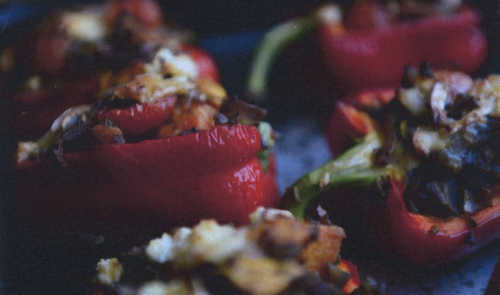 SAMPLE RECIPE : Stuffed Peppers With Sweet Potato And Chestnuts
SAMPLE RECIPE : Stuffed Peppers With Sweet Potato And Chestnuts
These stuffed peppers are a substantial vegetarian main course. Sometimes, the key to good vegetarian cooking is getting the texture as well as the flavour just right, and this dish has got both thanks to the chestnuts.
You can also make it vegan if you omit the egg and cheese; it will still be super tasty.
Serves 4
1 large sweet potato, diced
2 tbsp olive or coconut oil
1 red onion, peeled and finely sliced
1 clove garlic, peeled and crushed
200 g cooked, peeled chestnuts, chopped
12 cherry tomatoes, halved
1 tsp thyme leaves
Pinch chilli flakes
1 egg, beaten
4 red peppers, cut in half, pith and seeds removed but stems
intact (this stops the peppers from collapsing in the oven)
Few chunks of goat's cheese
Chopped parsley
Preheat the oven to 180°C. Cook the diced sweet potato in half the oil on a parchment-lined baking tray for 15 minutes or until tender.
Meanwhile, sweat the onion and garlic in the rest of the oil until soft but not coloured, which should take about 10 minutes.
In a bowl, mix the onion and sweet potato with the chestnuts, tomatoes, thyme, garlic and chilli flakes. Add in the beaten egg to bind it.Stuff the peppers with the mixture and top with a generous sprinkling of goat’s cheese. Bake for 30 minutes. Serve with a green salad.
 Sláinte, The Complete Guide to Irish Craft Beer and Cider, by Caroline Hennessy and Kristin Jensen (New Island, hardback 232pp, €19.99)
Sláinte, The Complete Guide to Irish Craft Beer and Cider, by Caroline Hennessy and Kristin Jensen (New Island, hardback 232pp, €19.99)
This is a book that couldn’t have been written ten, five or maybe even a couple of years ago. The resurgence of craft beers and ciders in Ireland has been one of the most exciting aspects of the ‘real food revolution’ that is currently taking the country by storm. But it has arrived with astonishing speed and an increasingly crowded - and confused - market place means that expert guidance is urgently needed.
How fortunate that two of Ireland’s most respected young writers and bloggers, Caroline Hennessy and Kristin Jensen, happen to have a particular interest in beer and craft drinks and a burning desire to share their enthusiasm and knowledge.
Kristin’s popular craft beer column has been enjoyed by readers of our monthly e-zine for many a month now, so nothing but the best would be expected from that quarter - and anyone attending events where craft beers are showcased would be very likely to have found the pair of them tasting, comparing and wondering at the sheer tidal wave of beautiful beers that have been coming onto the market of late. And, while they are there, Caroline - whose husband, Scott ,is one half of the Kiwi-Aussie duo at Eight Degrees Brewing - might just have some special new product to promote as well.
 Craft cider makers have been a little more cautious than their brewing brothers, but they are now developing new ciders apace and this book covers nearly twenty, of which several have already made headlines on a regular basis.
Craft cider makers have been a little more cautious than their brewing brothers, but they are now developing new ciders apace and this book covers nearly twenty, of which several have already made headlines on a regular basis.
Sláinte is jam packed with fascinating facts but it’s also a great read - the sort of reference book that you pick up to check a fact or two only to find, several hours later, that you’ve been drawn down all kinds of unexpected and exciting zythologian alleys.
It’s not only a very timely guide, but authoritative too and certainly destined to become the definitive reference, although it may be hard to keep up to date. It will be seized on by the growing army of discerning drinkers who are keen to find out which craft drinks they will most enjoy, especially when paired with their favourite foods - the latter part of the book has a strong food focus, and a great range of recipes too.
So, even if you don’t know a dunkel from an eisbock, anyone who enjoys real beer and cider should give this book a try - the fun is in the learning.
 The Nation’s Favourite Food Fast! by Neven Maguire, with photography by Joanne Murphy (Gill & Macmillan hardback 256pp, €22.99)
The Nation’s Favourite Food Fast! by Neven Maguire, with photography by Joanne Murphy (Gill & Macmillan hardback 256pp, €22.99)
A new book from the nation’s favourite chef is always welcome and this one is bound to be snapped up by the many people who feel challenged by the clock when it comes to getting a nutritious meal on the table. Compiled by Orla Broderick - herself a busy working mum - every recipe in the book can be on the table within an hour, and many in half of that.
As always with Neven and his team, there’s a great range of do-able dishes that are down to earth yet have an extra little something, or suggest a combination that you mightn’t have thought of, to keep things fresh in everyday cooking.
This collection also takes account of the fact that you may sometimes want to entertain even though time is against you, and cleverly includes half a dozen simple but impressive main courses to look after that particular challenge - and a few desserts too, although one-course meals are generally the practical option for speedy dinners.
As Neven and Amelda’s twins, Connor and Lucia, get bigger, Neven’s bound to become more focused on children’s meals - so it will come as no surprise to find that there’s a chapter on kid’s favourites and some great ideas for lunchboxes too (adult as well as junior). Given the time of year, this is the current challenge for many parents, here’s some of Neven’s advice.
CLEVER LUNCHBOX IDEAS
As we all know, healthy lunch ideas that inspire you to put together real food for your kids are essential if you want your children to have a balanced diet. Packing a lunch into a sectioned lunchbox or small Tupperware containers makes it easy to put together an assortment of healthy bits of food in a way that is appealing to a small child's eye.
It's important to include lots of textures, colours and a well-rounded assortment of food groups. Try to vary what you put in so that you don't pack the same thing every day.
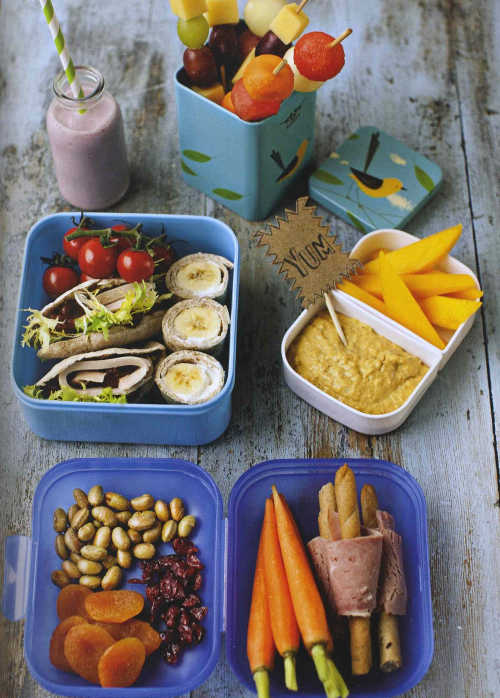 SOME MENU SUGGESTIONS:
SOME MENU SUGGESTIONS:
Melon ball skewers (using different varieties)
Cheese cubes with red and green grapes on skewers
Banana wrap - smear vanilla yoghurt on a wholemeal wrap,
put in a peeled banana, then roll up to enclose and cut into quarters
Mini wholemeal pittas filled with lettuce, turkey, tomato relish and cherry tomatoes
Baby carrots
Roasted red pepper hummus (shop-bought or homemade)
Bread sticks wrapped In thinly sliced baked ham or Parma ham
Crunchy soya beans
Dried apricots and cranberries
Mixed berry smoothie.
Book Reviews
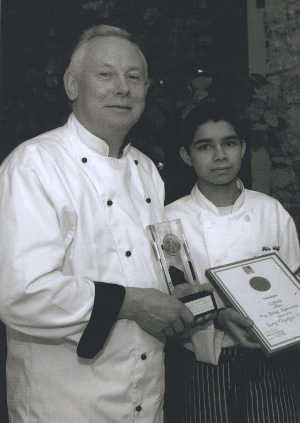
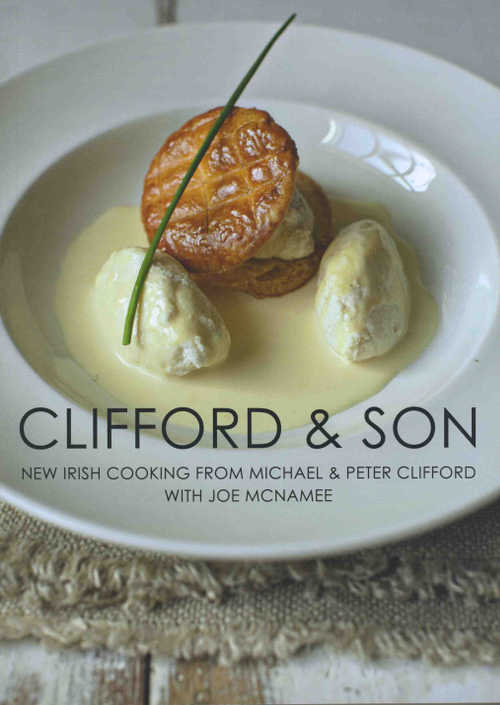 Clifford & Son, New Irish Cooking From Michael & Peter Clifford, With Joe McNamee. (Liberties Press, paperback €29.99 / £24.99)
Clifford & Son, New Irish Cooking From Michael & Peter Clifford, With Joe McNamee. (Liberties Press, paperback €29.99 / £24.99)
A warm tribute to a great chef, this is not just a cookbook but the poignant story of a quiet gentleman of the Irish culinary scene who rose from tragic childhood circumstances, that were unknown to most, to take his place as one of this country’s leading classical chefs until his untimely death in 2006 - but passed on his love of food and culinary skills to twins Peter and Laura, who were adopted by Michael and his wife Deirdre in 1993.
I remember it well as it coincided with a visit to Cork city - and, of course, to Clifford’s Restaurant - by the Irish Food Writers’ Guild, and Deirdre proudly brought their beautiful babies down to the restaurant, to present them to us for the very first time.
Both children grew up to excel in the kitchen - each has been a winner of the Tesco Young Cook Competition, for example. Peter, especially, has continued to carry the torch for his father and is now a rising star, having gone on to hone his considerable skills in many famous kitchens - and, with the help of food writer Joe McNamee (himself a trained chef) he has realised along held ambition to write a book celebrating his father’s work and introducing some of his own.
 The story is mainly told by Joe, through a series of interviews conducted with many of the people who knew and admired Michael - including luminaries like Marco Pierre White, who wrote a moving Foreword.
The story is mainly told by Joe, through a series of interviews conducted with many of the people who knew and admired Michael - including luminaries like Marco Pierre White, who wrote a moving Foreword.
The recipes include an impressive collection of Michael’s classics such as his Gourmet Irish Stew, which became the definitive modern Irish Stew used by Bord Bia when showcasing ‘the food island’, his nettle soup and several dishes based on the much loved but humble local product Clonakilty black pudding - along with likeminded contemporaries, including the late Gerry Galvin, he was one of the first classical chefs to raise simple traditional ingredients like black pudding to superstar status by presenting them in fine dining dishes.
Together with Peter’s own contemporary creations, this collection comprises a touching tribute to a great father and son partnership.
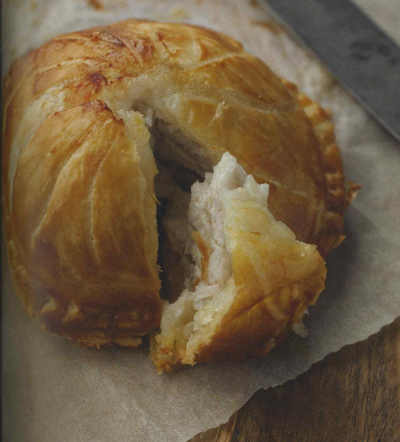 SAMPLE RECIPE: GAME PIE
SAMPLE RECIPE: GAME PIE
“This dish combined my dad's love of shooting and game. In season, he always had this one on in the restaurant. I've eaten it loads of times and I always put it on in game-season as well. This could be considered one of his fundamental recipes - a don't-leave-home-without-it recipe - and is as good as any for giving an idea of the man through his food. Use any game birds available: the more the merrier, but it's still a great dish with just one or two birds. I’ve served it with prunes macerated in port and star anise and a bit of braised red cabbage and chestnuts. I've never had the patience to wait, but I've a feeling it would also be good eaten cold as a winter picnic lunch.”
INGREDIENTS
2 shallots, sliced
1 clove garlic, crushed
2 sprigs thyme
25g butter
250g game meat, finely sliced
1 large Rooster potato, grated
280g puff-pastry sheet
125ml fresh cream
2 tbsp milk
1 egg
METHOD
Saute shallots, crushed garlic and thyme in butter. Mix with the finely sliced game meat, add grated potato and season with salt and pepper.
Line the base of a shallov baking dish with pastry, place the filling on top, cover with the rest of the pastry and secure the edges. Brush the pastry with an egg wash made by beating together the milk and egg and cut a 1 cm circular hole in the centre of the pie to act as a ‘chimney for steam.
Cook for 20 minutes at 185° Celsius. Meanwhile, reduce the cream by half. Remove the pie from the oven, pour the reduced cream into the hole, cook for a further 5 minutes and then serve.
 The Natural Food Kitchen, Delicious, globally inspired recipes using only the best natural and seasonal produce, by Jordan Bourke with photographs by Tara Fisher (Ryland Peters & Small, hardback160pp; £16.99).
The Natural Food Kitchen, Delicious, globally inspired recipes using only the best natural and seasonal produce, by Jordan Bourke with photographs by Tara Fisher (Ryland Peters & Small, hardback160pp; £16.99).
Jordan Bourke is based in London - where he worked with the wonderful Skye Gyngell when she was at the Petersham Nurseries restaurant, among many other starry projects - but this engaging young chef trained at Ballymaloe and is an active member of the Irish Food Writers’ Guild.
His first book, The Guilt-Free Gourmet, written with his sister Jessica, was a best seller, and now he’s back on a solo run with more exciting healthy food.
Offering up more of his signature “indulgent yet ‘guilt-free’ food”, this colourful new globally inspired collection is aimed at well travelled cooks of all ages who love their food but are health conscious too - and there will be plenty here to please even the most jaded palate, so he is sure to have another success on his hands.
SAMPLE RECIPE:
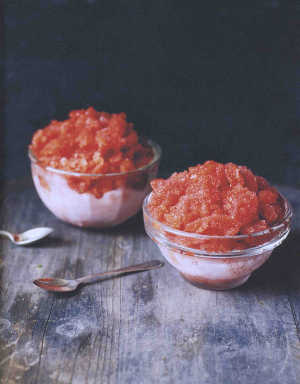 Winter granita of blood orange & persimmon
Winter granita of blood orange & persimmon
Granita is a lovely way to finish off a meal. Light and refreshing, it really showcases the natural flavours of whichever fruit you use. Here, beautiful winter blood orange and persimmon (see buying tips below), make for a perfect partnership and a really refreshing dessert.
2 very ripe 'hachiya' persimmons (flesh should be completely soft, almost falling apart)
juice of 8 blood oranges (about 550 ml/2¼ cups)
zest of 1 unwaxed lemon
6 tablespoons pure maple syrup
pinch of sea salt
Serves 4-6
Cut the persimmons in half and scoop out their gelatinous, almost liquid flesh. Place in a food processor with the blood orange juice, lemon zest, maple syrup and salt. Blitz on and off until the persimmon flesh is puréed and everything is well combined.
Transfer the liquid to a shallow tray, preferably metal, and carefully place it in the freezer. After 1 hour, using a fork, drag the ice crystals away from the edges. Do not whisk it all up as you would with a sorbet, as you want to keep the large crystals of ice intact.
Place it back in the freezer for a further 2 hours to set properly. When ready to serve, remove from the freezer and scrape with a fork until rough; this will take a bit of effort, as the granita will be fully set.
Spoon into chilled glasses and serve.
PERSIMMON TIPS
They look quite similar, but have completely different textures and uses. Confusingly, the hachiya and fuyu varieties will often be sold under one general name, either persimmon, Sharon fruit or cachi, but really it is their specific name that is most important, so be sure to ask if you are unsure.
Round and larger than fuyu, hachiya is astringent, extremely tart and very firm when unripe, so don't attempt to eat them then. During ripening, they will go from orange to a very deep orange, almost red colour, and their flesh will become completely soft, almost exploding out from their skin, and gelatinous once opened.
Fuyu are smaller and squatter in shape, and are often sold in the UK as Sharon fruit. They remain quite firm on the outside, with a slightly softer, yet still slightly crunchy inside. With a mild sweetness, they are ideal for eating as you would an apple.
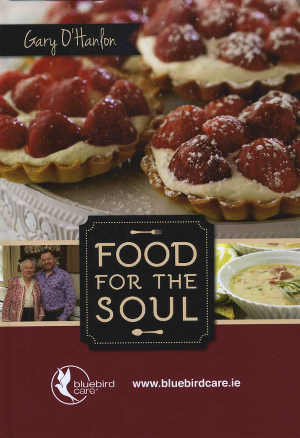 Food For The Soul by Gary O’Hanlon (Bluebird Care, hardback 144pp RRP €19.95)
Food For The Soul by Gary O’Hanlon (Bluebird Care, hardback 144pp RRP €19.95)
Perhaps best known these days as known as head chef of the superb Longford restaurant VM at Viewmount House, Gary O’Hanlon is also a proud Donegal man so it’s very appropriate that his first cookbook, Food for the Soul, was launched at A Taste of Donegal Food Festival in August.
Gary partnered with Bluebird Care (www.bluebirdcare.ie) on the project and Operations Director, Eddie O’Toole, said that “good home cooking is very important to our customers who live in their own homes …and we understand the importance of a healthy and balanced diet.”
Describing the book as ‘food for the soul, stories from the heart’ Gary has selected a range of recipes for all abilities and most occasions, from Starters and Snacks to Mains and Desserts.
He has personalised each recipe with background information and reminiscences - and, as well as giving a ‘How-to-Guide’ for the more difficult recipes, there’s even a series of online videos showing Gary cooking each dish.
A book with heart, that is going to raise money for Active Retirement Associations across Ireland, this is a great initiative and very worthy of support.
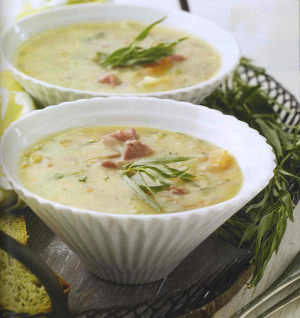 SAMPLE RECIPE: HAM HOCK & SPLIT PEA BROTH
SAMPLE RECIPE: HAM HOCK & SPLIT PEA BROTH
This hearty budget-friendly recipe would be great for feeding a crowd, but Gary says that it also freezes well - wouldn’t it be very handy to have some in the freezer over Christmas and New Year?
SERVES 15-20
Ingredients
2 ham hocks (soaked in cold water for 24 hours)
1 large onion finely chopped
l00g barley soaked in cold water for 2 hours
l00g green split peas
100g yellow split peas
3 carrots diced
4 stalks of celery, peeled then diced
5 litres chicken stock
1 lb butter
2 cups flour
White pepper and salt to taste
Boil the ham hocks for 3 hours or until the meat is falling from the bone.
Set aside.
Melt the butter and add the carrots, onion, celery, peas and barley.
Cook for 5 minutes, stirring every minute.
Add the flour to make a roux.
Mix well, but gently.
Now add the chicken stock.
Mix well and turn down to a very low heat.
Keep mixing every 5 minutes for 1 hour, or until vegetables etc. are cooked.
Adjust consistency if it gets a little thick, then season.
Rip off chunks of the ham hock and drop into the broth.
Will make approximately 15-20 bowls.
TOP TIPS
You could replace the ham hock with chicken by boiling a whole chicken, using the stock for the broth then ripping up the meat and dropping into the broth.
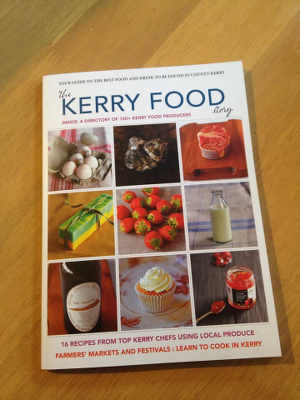 The Kerry Food Story (Published by the Institute of Technology, Tralee, Co. Kerry, 68pp paperback. Supported by Kerry Local Enterprise Office; free of charge)
The Kerry Food Story (Published by the Institute of Technology, Tralee, Co. Kerry, 68pp paperback. Supported by Kerry Local Enterprise Office; free of charge)
Well they say that the best things in life are free and, while contradictions abound, The Kerry Food Story seems to back up the theory. It’s a great little booklet for anyone - interested visitor, local retailer or customer, hotelier, chef or student - who wants to reference the 150+ Kerry food producers listed in the directory, and there’s no shortage of inspiration in the recipes supplied by eight of the county’s top chefs, all of whom have studied at the IT Tralee.
You’ll also find a list of cookery schools, information on farmers' markets and festivals where you can buy produce and useful Kerry websites to find out everything about local food and drink in the region.
Creating recipes especially for the project, chefs have showcased a wide range of ingredients to demonstrate the diversity of local products, including local fish and seafood such as Kush Mussels, Beaufort Free-Range Eggs, Annascaul Black Pudding, Ballinskelligs Duck, Ring of Kerry Lamb, Valentia Island Milk and Farmhouse Ice Cream, indulgences like Lorge and Skelligs Chocolates - and the relatively new Dingle Gin.
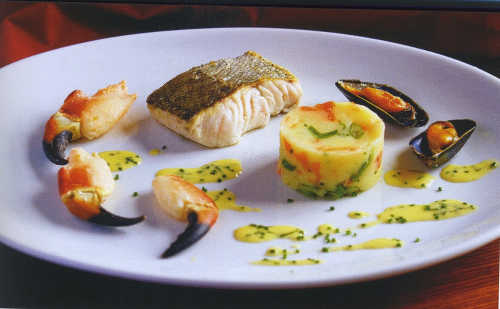 SAMPLE RECIPE: Fillet Of Portmagee Pier Hake with Daly's Smoked Salmon, Cromane Mussels and Skellig Crab Claws
SAMPLE RECIPE: Fillet Of Portmagee Pier Hake with Daly's Smoked Salmon, Cromane Mussels and Skellig Crab Claws
From Noel Dennehy. Head Chef at The Moorings, Portmagee.
4 x 200g Portmagee hake fillets
Sea salt
2 tablespoons olive oil
j 80g Daly's smoked salmon
3 spring onions
320g hot mashed potato
20 fresh Cromane mussels
1 tablespoon of butter
1 shallot, finely chopped
1 clove garlic, finely chopped
50 ml white wine
100ml cream
Juice of 1/2 lemon
1 tablespoon chives, finely chopped
12 Skellig Crab Claws
1. Preheat the oven to 180C/350F/Gas 4. Season the hake with sea salt. Heat a tablespoon of olive oil in a non-stick frying pan with an oven-proof handle. Add the hake, skin-side down first, and fry for 1 minute. Turn the fish over gently, then cook for 1 minute more before placing the pan in the oven for five minutes.
2. Slice the smoked salmon and spring onion finely and stir into the hot mashed potato. Keep warm.
3. Sauté the mussels in a tablespoon of butter with the shallot and garlic for 1 minute. Add the white wine and reduce by half. Add the cream and cook for 1 minute. Add the lemon juice and chives and stir. Add the cooked crab claws and cook for 1-2 minutes until heated through.
4. Divide the potato between four warm plates. On each plate, place a fillet of hake with 3 crab claws and 5 mussels. Drizzle any sauce from the pan around the fish and serve immediately.
Georgina Campbell's Book Reviews
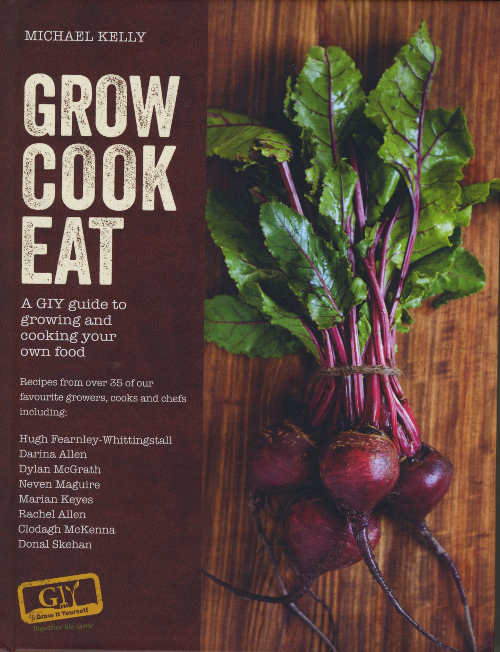
 Grow Cook Eat by Michael Kelly (GIY Ireland Ltd, hardback 294pp, full colour; €25 online from GIY: http://is.gd/lWiPqL ) All proceeds to GIY, a registered charity in Ireland.
Grow Cook Eat by Michael Kelly (GIY Ireland Ltd, hardback 294pp, full colour; €25 online from GIY: http://is.gd/lWiPqL ) All proceeds to GIY, a registered charity in Ireland.
I had intended waiting until the early spring to review GIY (Grow It Yourself) founder Michael Kelly’s brilliant book, thinking it would be especially welcomed by potential food growers just when the new season begins to stir. But it’s much too good to keep waiting, and anyway it seems very appropriate to write about it in December, when his Veg of the Month is garlic.
For garlic has special significance to Michael, and the whole GIY movement - currently numbering over 50,000 members in several countries, and growing fast - is the result of his indignant response to finding garlic all the way from China in his local supermarket. Rightly thinking it could grow just as well here, he planted some to see how it would turn out.
Fortunately for GIY, the experiment was a success and not only inspired him to grow and rear numerous other foods, but also to found GIY in order to share knowledge with other likeminded growers. There is no stopping him now and the organisation is developing fast, with campaigns a-plenty in train and GIY HQ in the making.
The scale of the GIY ambition is enormously impressive and I can empathise with it personally, although it’s a far cry from the days when local people with big gardens lent space to me on an individual basis to grow food for the family, and I bored people at dinner parties with chat about compost…
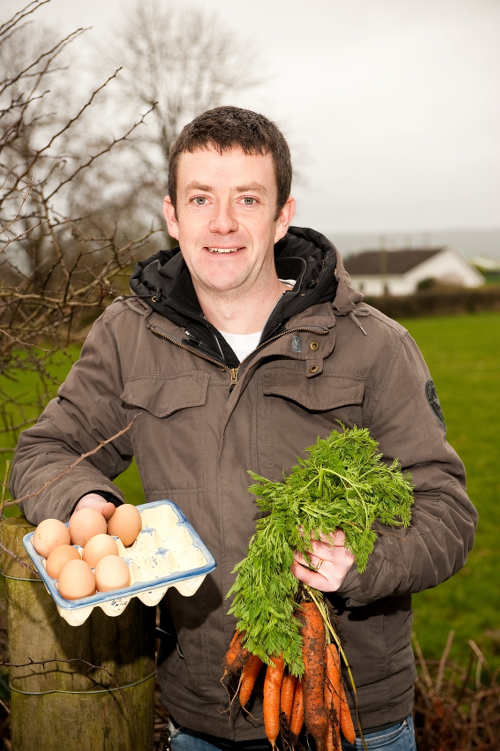 Michael distinguishes between food production and gardening, by the way, and is not too keen on the latter (‘horticultural haughtiness…is in fact a real turnoff’). While this may seem a bit harsh to those of us who enjoy both gardening and food production, it certainly gives a clear focus to a book that is practical and enjoyable in equal measure.
Michael distinguishes between food production and gardening, by the way, and is not too keen on the latter (‘horticultural haughtiness…is in fact a real turnoff’). While this may seem a bit harsh to those of us who enjoy both gardening and food production, it certainly gives a clear focus to a book that is practical and enjoyable in equal measure.
Presented as a month-by-month guide Grow Eat Cook is a fascinating combination of Michael’s writing in the nine years that he’s been a GIYer and new material, including (marketing genius that he is) excellent recipes by some three dozen high profile contributors, mainly celebrity chefs.
In December, for example, Rachel Allen contributes her Roast Garlic Colcannon (see below), there’s a Beetroot and Carrot Gratin from Michelle Darmody of Cake Café, Cauliflower with Cheese Sauce from Cathal Armstrong (co-owner of Restaurant Eve, Virginia USA), a moist Squash and Coriander Seed Bread from Catherine Fulvio - and finally Lilly Higgins’s Apple Galette, which rounds off the year very prettily.
There’s a similar range of recipes each month, and the recipe content certainly broadens the appeal - so much so, in fact, that this would make a great gift for any food lover, with or without a garden. Just remember to tell any novices who may be thinking of growing garlic that it’s traditional to sow it by the shortest day (21st December), to be sure of success. Then there will be no stopping them either.
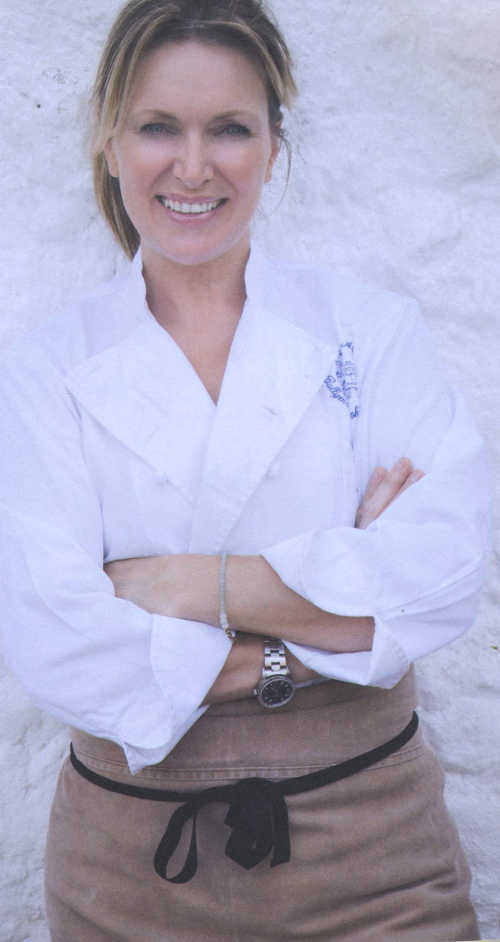 RECIPE: Roast Garlic Colcannon (From Entertaining at Home by Rachel Allen, Collins 2010)
RECIPE: Roast Garlic Colcannon (From Entertaining at Home by Rachel Allen, Collins 2010)
Colcannon is a traditional Irish dish made from mashed potato and cabbage or kale. By roasting the garlic in this way, its flesh is tempered and tamed to become sweet and mellow.
SERVES 4-6
1 large head of garlic, left whole and unpeeled
3 tbsp olive oil
salt and ground black pepper
1 sprig of rosemary
1kg (2 lb 3oz) floury potatoes, unpeeled
450g (1lb) Savoy cabbage or kale
250ml (9fl oz) milk
50g (2oz) butter
Preheat the oven to 220°C (425 °F), Gas mark 7.
Place the whole head of garlic in a small ovenproof dish, drizzle with olive oil, season with salt and pepper and add the sprig of rosemary. Cover with foil and cook in the oven for about 45 minutes or until the garlic has completely softened.
Place the potatoes in a large saucepan and cover with cold water. Add a good pinch of salt, cover with a lid and bring to the boil. After 10 minutes strain off two-thirds of the water, put the lid back on the pan and cook over a gentle heat so that the potatoes steam for about 30 minutes until they are tender.
Remove and discard the dark tough outer leaves from the cabbage (if using). Wash the rest and cut into quarters, removing the core. Cut the cabbage or the kale across the grain into slices about 7mm thick. Place in another large saucepan, add the milk and simmer for about 4 minutes or until tender.
When the potatoes are just cooked, peel and mash them while still warm with the butter and some salt and pepper. Use your fingers to squeeze out the roasted garlic pulp and beat into the potatoes with enough boiling milk from the cabbage to make a fluffy puree. Then drain the cooked cabbage or kale, stir into the mash and taste for seasoning.
For perfection, serve immediately in a hot dish with a lump of butter melting on top.
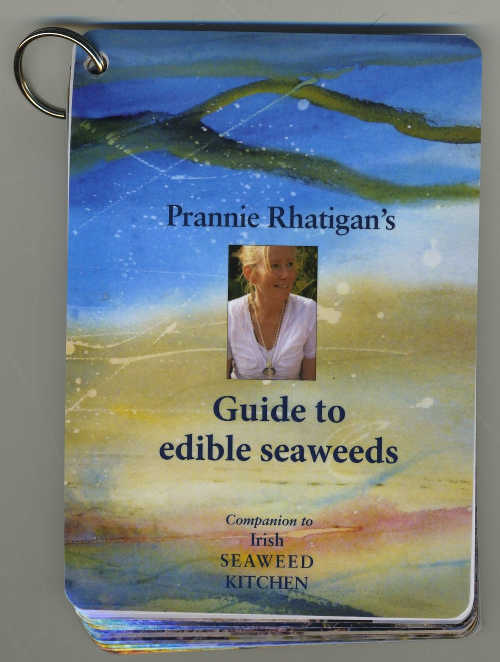 Prannie Rhatigan’s Guide to Edible Seaweeds (http://irishseaweedkitchen.ie/shop €8.45 + 2.15 p+p within Ireland)
Prannie Rhatigan’s Guide to Edible Seaweeds (http://irishseaweedkitchen.ie/shop €8.45 + 2.15 p+p within Ireland)
Moving from the land to the sea and the shoreline, fans of Prannie Rhatigan’s gorgeous and enormously influential book Irish Seafood Kitchen, will be delighted to find this new companion guide. Laminated and ring bound, it’s small enough to be handy and practical to keep in your pocket on shoreside rambles yet big enough to have space for all the essential information while being easy to read. Information includes clear colour photographs for every entry, and details on uses and sustainable harvesting as well as most likely locations and a clear description including seasonal variations. A perfect stocking filler.
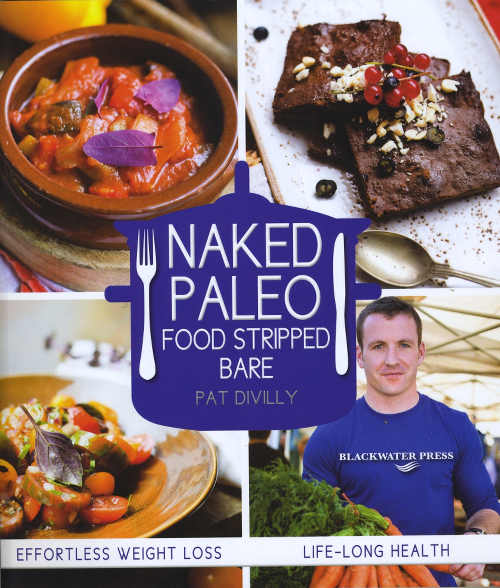 Naked Paleo - Food stripped Bare, by Pat Divilly (Blackwater Press, paperback, 140pp, full colour; €19.95 from major bookshops)
Naked Paleo - Food stripped Bare, by Pat Divilly (Blackwater Press, paperback, 140pp, full colour; €19.95 from major bookshops)
‘Effortless weight loss and life-long health’ are the rather astonishing promises of this attractive book, the second by Galway nutritionist and personal trainer Pat Divilly.
Yet, even if one has to be somewhat sceptical about such claims, the basic principles of using fresh foods in season, meat and seafood, nuts, seeds and healthy oils, rather than processed foods, make sense for all. Similarly, there’s no doubt that, for some people at least, it is beneficial to avoid gluten, wheat and dairy foods - all of which would have been strangers to our Paleolithic cavemen ancestors who provide the inspiration for the ‘Paleo-friendly’ diet.
There is plenty of food for thought in this book, which questions a whole range of nutritional assumptions, from what we should have for breakfast to whether the food pyramid needs a design overhaul. Pat Divilly also highlights the importance of mindset as well as nutrition to our health and wellbeing, and lists ’30 Things Happy People Do’ to illustrate the point.
And one thing is certain - the sight of a good meal is pretty much guaranteed to cheer people up. While certain substititions may be challenging - using nut flours instead of grains, for example - and it would be much easier to find your way around the book if it had a traditional Index, the range of recipes provided by the highly regarded chef and restaurateur JP McMahon, of the EatGalway restaurant group, ensures there will be no shortage of tasty ideas to see you on your way.
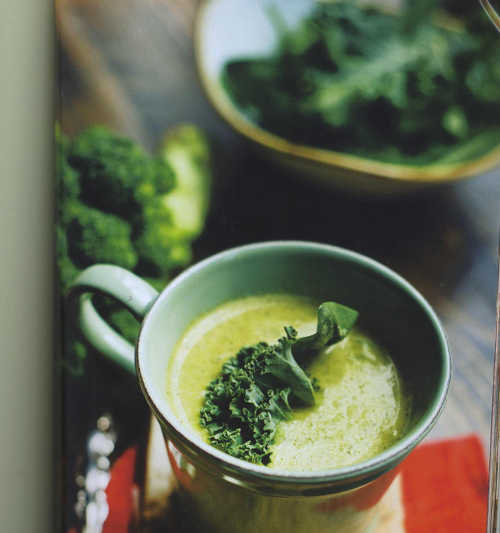
RECIPE: Broccoli and Kale Soup
(Serves 8)
Ingredients
1 large head of broccoli, chopped
150g kale, chopped
300g spinach
1 tbsp extra virgin olive oil
1 carrot, chopped
1 onion, diced
2 tbsp Dijon Mustard
2 bay leaves
1 tbsp fresh thyme
Sea salt
¼ tsp grated nutmeg
1 tsp smoked paprika
2 cloves garlic, crushed
1.7 l vegetable stock
125ml non-fat plain yogurt
Method:
1. Heat oil over medium-high heat in a large pot.
2. Add the onions, season with a pinch of sea salt and sauté until they soften.
3. Add the carrots, a pinch of salt and continue to cook for another two minutes.
4. Add mustard, thyme, salt, smoked paprika and garlic. Sauté for one minute. Add broccoli, kale, spinach and stock.
5. Bring to a boil. Reduce heat and let simmer for twenty minutes.
6. Stir yogurt into the mixture.
7. Puree the mixture with a stick blender and adjust seasoning to taste.
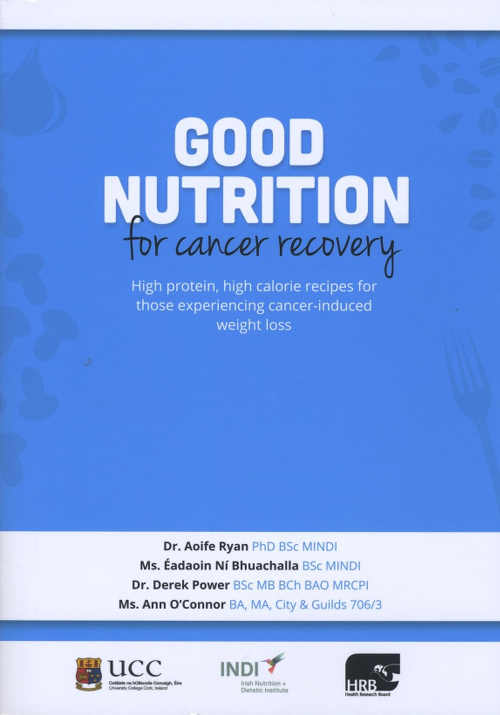 GOOD NUTRITION for Cancer Recovery (University College Cork; http://www.cancercookbook.ie/)
GOOD NUTRITION for Cancer Recovery (University College Cork; http://www.cancercookbook.ie/)
So much of the current debate on healthy food relates to the problems associated with overweight and obesity that it is easy to overlook the challenges faced by those dealing with the opposite problem, ie involuntary weight loss.
Yet that is one of the most common difficulties for patients recovering from cancer, and it is important to find nutritional solutions that are appealing enough to tempt poor appetites, easy to prepare for patients who may have little energy, and practical to eat when there may be physical disabilities to overcome, such as difficulty with swallowing.
Produced by a team at University College Cork led by Dr Aoife Ryan, Ms Eadaoin Ni Bhuachalla, Dr Derek Power and Ms Ann O’Connor, this informative and easy to use 130 page handbook offers clearly presented information, advice and a range of easily prepared recipes, written to a very specific brief by invited contributors. It is sure to be a valuable resource for recovering cancer patients and their families.
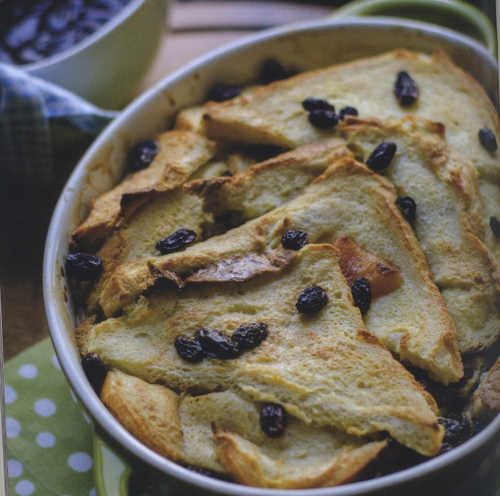 RECIPE: Apricot And Raisin Bread & Butter Pudding, Vanilla Ice Cream and Warm Fudge & Chocolate Sauce
RECIPE: Apricot And Raisin Bread & Butter Pudding, Vanilla Ice Cream and Warm Fudge & Chocolate Sauce
[Recipe from Philip Brazil, Executive Head Chef, Sheen Falls Lodge, Kenmare, Co. Kerry]
Prep time: 20 minutes Cooking Time: l hour
Serves 4
150ml full-fat milk
150ml double cream
1 tsp. vanilla extract
25g butter, for greasing
1/2 loaf of sliced white bread
75g dried apricots, chopped
75g raisins
3 eggs
2 egg yolks
4 tbsp. caster sugar
Hot chocolate sauce
85g dark chocolate
150ml double cream
85g fudge
1. Preheat the oven to 150°C. Grease a casserole dish with the butter.
2. Place the milk, cream and vanilla into a saucepan over a low heat and heat until steaming, but not boiling. Remove from the heat and leave to infuse for ten minutes.
3. Place dried fruit between the layers of buttered bread in the dish.
4. Whisk the eggs/egg yolks and caster sugar together in a bowl, and then gradually pour over the infused milk mixture, stirring constantly.
5. Pour the custard mixture over the bread and dried fruit and transfer to the oven to bake for 45-60 minutes, or until the custard is set and the bread is golden-brown.
6. Meanwhile, for the chocolate sauce, heat the chocolate and cream together in a pan over a low heat, stirring continuously until combined. Once combined, stir in the fudge stir until dissolved.
Serve the bread and butter pudding with chocolate sauce and a scoop of ice-cream.
Georgina Campbell's Book Review - Cava Bodega Cookbook, TAPAS A TASTE OF SPAIN IN IRELAND, by Jp McMahon
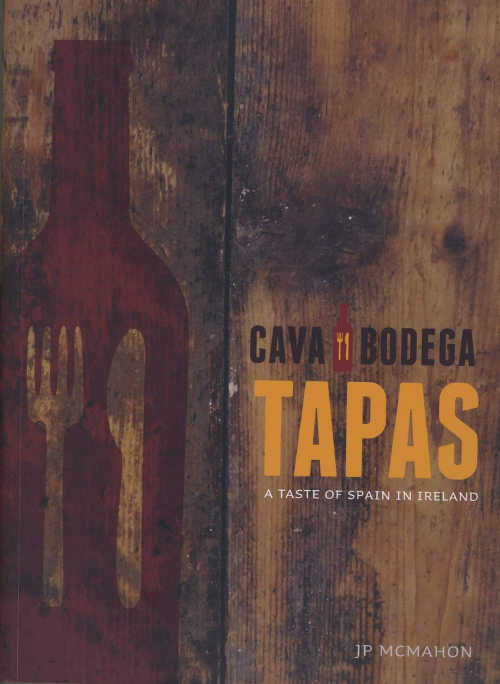
 Cava Bodega Cookbook, TAPAS: A TASTE OF SPAIN IN IRELAND, by Jp McMahon, with photography by Julia Dunin, paperback, 280pp, €25
Cava Bodega Cookbook, TAPAS: A TASTE OF SPAIN IN IRELAND, by Jp McMahon, with photography by Julia Dunin, paperback, 280pp, €25
(available from the three EatGalway restaurants - Cava Bodega, Aniar, EAT Gastropub) and online from www.cavarestaurant.ie/pages/cookbook.html; p+p €8-12.50, depending on destination)
Chef/restaurateur and academic Jp McMahon’s passion for all things Iberian is no secret and, of the terrific trio of Galway restaurants that he and his wife Drigin operate - the much-feted Aniar, Cava Bodega and EAT Gastropub - there’s always a feeling that his heart beats fastest for Cava. This book is certainly written from the heart and, like so many books with subtitles, therein lies its raison d’etre.
We have many wonderful restaurants in Ireland that are run by passionately committed owners, and a surprising number of them have felt the need - and found the time and energy - to add an extra dimension to their work by producing a book that encapsulates their philosophy and the organic hospitality entity that they have created. It is a lovely thing to do, and can often - as here - convey the warmth, love and dedication that drives people with the hospitality gene to create something unique for others to enjoy.
 TAPAS really is a labour of love, so much so in fact that the easy tone (almost) makes it feel effortless. While it is far from being an oversized tome, it gives a pretty comprehensive introduction to Spanish food and wine in the uniquely Irish context provided by Cava Bodega and the local suppliers - like farmers Ronan Byrne (aka The Friendly Farmer) and Brendan Allen of Castlemine Farm, among others - that are so dear to JP’s heart.
TAPAS really is a labour of love, so much so in fact that the easy tone (almost) makes it feel effortless. While it is far from being an oversized tome, it gives a pretty comprehensive introduction to Spanish food and wine in the uniquely Irish context provided by Cava Bodega and the local suppliers - like farmers Ronan Byrne (aka The Friendly Farmer) and Brendan Allen of Castlemine Farm, among others - that are so dear to JP’s heart.
But, while local food is an essential building block in the Cava Bodega story - and Jp dedicates a full page to Euro-Toques, explaining the importance of its environmentally aware local food promoting network to chefs, cooks and producers - he makes it clear in his Preface that the local food movement is only half the story: “If we are to truly embrace our heritage we need to move beyond the local moment of the present and dig deep into shared traditions…To care about food one needs to be local and global, simultaneously - to hold past, present and future in one hand, knowing that the earth is just one big place where we can grow food to feed us all.”
And it is the bringing together of authentic Spanish cooking and a combination of Irish and Spanish ingredients (Spanish when no local Irish equivalent exists - and always in season) that is the most inspiring aspect of this warmly appealing and educational book.
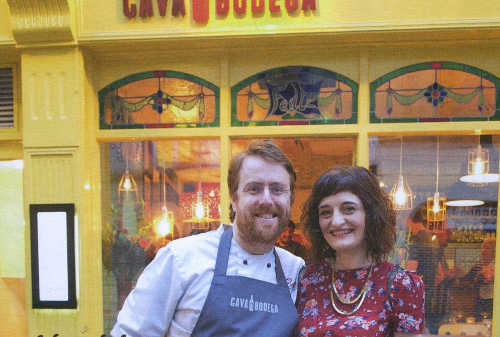 Whatever your level of interest, you can dip into it for anything from a brief history of Spanish cooking to a definition of words that are used so casually these days, like Tapas and Pincho; and you’ll find everything from an introduction to Spanish wines to the contents of the Spanish kitchen cupboard - and, fascinatingly, a thinking chef’s insight into the many foods and techniques that currently absorb the food world, such as foraging, fermentation, pickling, curing, and the ‘nose to tail’ philosophy of respect for the animals we eat.
Whatever your level of interest, you can dip into it for anything from a brief history of Spanish cooking to a definition of words that are used so casually these days, like Tapas and Pincho; and you’ll find everything from an introduction to Spanish wines to the contents of the Spanish kitchen cupboard - and, fascinatingly, a thinking chef’s insight into the many foods and techniques that currently absorb the food world, such as foraging, fermentation, pickling, curing, and the ‘nose to tail’ philosophy of respect for the animals we eat.
All fascinating stuff, and that’s before you even get to the 70 or so carefully considered recipes in the second half of the book. There should be plenty to tempt all comers here, and - although there are a few cheffy details like foams and hay smoking in some of the main dishes - they are all clearly explained and easy to follow.
A book to educate and entertain, and a book to use with pleasure - highly recommended to anyone with a genuine love of food.
 SAMPLE RECIPE: LING
SAMPLE RECIPE: LING
baby fennel, beetroot puree, pistachio powder (serves 4)
“Ling is a great alternative to cod, which is, to say the least, overfished and overeaten in Ireland. I always call ling a ‘cousin of cod’. Perhaps it’s a closer relative, like a brother or a sister.”
1 side of ling (skin-on, cut into four 150g portions, lightly seasoned)
8 baby fennel (use large fennel cut into four if you can't find baby fennel)
100g butter
olive oil
sea salt
FOR THE BEETROOT PUREE
10 small beetroot, cooked
50ml apple juice
15ml sherry vinegar
sea salt
FOR THE PISTACHIO POWDER
45g pistachios, shelled
5g sugar
1g sea salt
FOR THE BEETROOT PUREE: Bring the cooked beetroot, apple juice, and sherry vinegar to the boil. Season to taste (you may need more liquid or vinegar to achieve the correct texture) and blend in a food processor until extremely smooth.
FOR THE PISTACHIO POWDER: Dry roast the pistachios in a 180°C oven until hard and crunchy. Allow to cool. Blend in a food processor with the sugar and the salt. Spread the powder onto a baking tray and place in a 55ºC oven until a crumb texture is achieved.
TO COOK THE BABY FENNEL: Fry the fennel briefly in a warm pan with some oil. Season with sea salt and add half the butter. Lower the heat and continue to cook until the fennel is soft to touch.
TO COOK THE FISH: Fry the fish, skin side down in some olive oil in an extremely hot pan. Cook the fish mostly on the skin side. If the skin starts to burn lower the heat. When you’re happy with the texture of the skin, turn over the fish and add the butter. Baste the fish in golden nutty butter. Do not allow the butter to burn. When the fish is cooked, remove from the pan and place on some kitchen paper.
TO PLATE: Place the beetroot puree on the plate and give it a swish with the back of a spoon. Then place the fennel on top of the puree. Finally, rest the fish on top of the fennel and sprinkle some pistachio powder over the entire dish.
Georgina Campbell's Book Review - Clodagh's Irish Kitchen
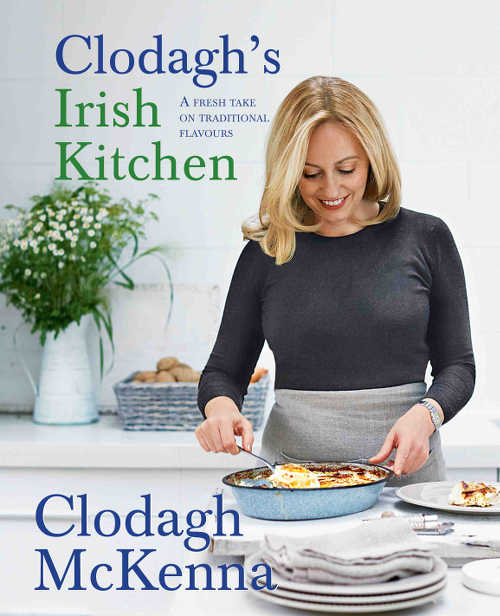
 Clodagh’s Irish Kitchen by Clodagh McKenna, with photography by Tara Fisher. Kyle Books, hardback, 256pp. RRP €25
Clodagh’s Irish Kitchen by Clodagh McKenna, with photography by Tara Fisher. Kyle Books, hardback, 256pp. RRP €25
Well timed to hit the book shops just before St Patrick’s Day, Clodagh’s Irish Kitchen offers a nicely balanced collection of 150 upbeat traditional recipes presented with pzazz.
Wholesome and delicious, Clodagh McKenna has put together a great range of dishes with special little points of difference for every conceivable occasion from everyday suppers to weekend bakes and entertaining, some of which will be familiar to customers of her ‘Clodagh’s Kitchen’ restaurants.
Nicely on trend, they are designed to showcase the range and quality of Irish ingredients, including some foraged foods - in dishes like Wild Nettle Gnocchi with a Cashel Blue Sauce, and Fresh Dillisk Pasta for example - and there are some themed menus with matching ‘Tablescapes’, including a pretty Seashore one that’s perfect for a seafood and foreshore foraging menu.
The sample recipes given below could make a lovely special occasion meal for St Patrick’s Day that’s not hidebound by tradition - and there’s a beautiful green-themed tablescape with a Herb Table Runner to create a stunning setting for a party.
RECIPES:
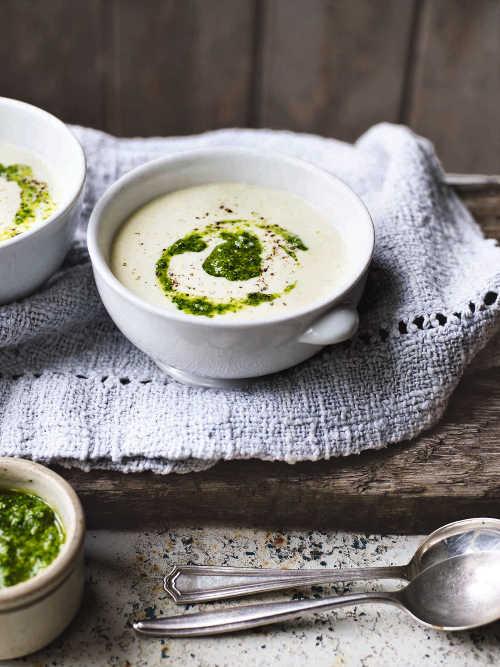 Colcannon Soup with Parsley Pesto
Colcannon Soup with Parsley Pesto
This soup reinterprets the Irish classic ‘colcannon’, a dish that is made of mashed potatoes and kale or cabbage. You could add some pulled pork or pancetta to this soup if you wish. Delicious served with my Cheese and Rosemary Savoury Scones.
Serves 6
50g butter
300g potatoes, peeled and diced
1 onion, diced
2 garlic cloves, crushed
½ teaspoon freshly grated nutmeg
800ml hot chicken or vegetable stock
400g cabbage, sliced
200ml single cream
sea salt and freshly ground black pepper
For the parsley pesto
110g fresh flat-leaf parsley
150ml extra virgin olive oil
25g pine kernels, toasted
1 garlic clove, crushed
50g freshly grated Parmesan cheese
1 Melt the butter in a heavy-bottomed saucepan over a medium heat. Add the potatoes, onion, garlic and nutmeg. Stir, cover, and reduce the heat to low. Leave to sweat for about 15 minutes, stirring occasionally.
2 Add the stock and bring the heat up to high. Let the onion and potatoes cook in the stock until they are completely soft, then add the cabbage – the cabbage will take only 5 minutes to cook.
3 While the cabbage is cooking, place all the ingredients for the parsley pesto in a food processor and blend until you have a smooth consistency. Set aside.
4 When the cabbage has wilted, stir in the cream, then pour the soup into a blender and whiz to a smooth consistency. Season with salt and pepper. Return to the pan to warm through if required.
5 To serve, pour the soup into warmed bowls and garnish with a generous drizzle of parsley pesto
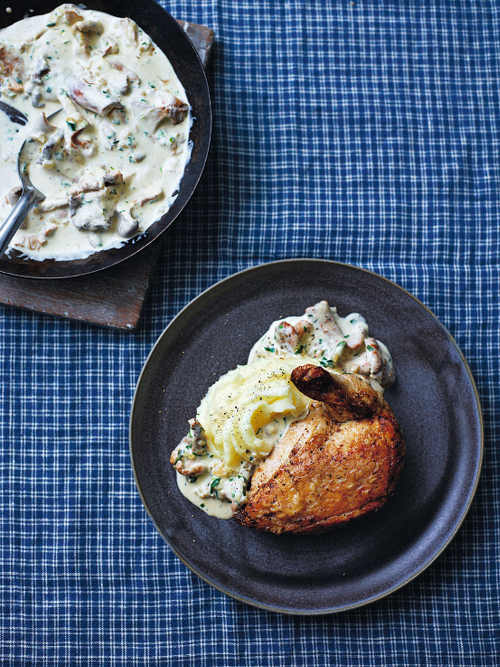 Crispy Chicken with a Creamy Irish Whiskey and Wild Mushroom Sauce
Crispy Chicken with a Creamy Irish Whiskey and Wild Mushroom Sauce
We serve this dish in my restaurant in Dublin, Clodagh’s Kitchen, during the cold winter months, and it’s akin to a big, warm hug in your tummy! The sweet sharpness of the Irish whiskey cuts through the cream and earthy wild mushrooms. Serve with any variation of my Creamed Potatoes.
Serves 4
2 tablespoons olive oil
20g butter
2 garlic cloves, whole
4 supreme chicken fillets, skin on
Creamed Potatoes of your choice, to serve
sea salt and freshly ground black pepper
For the sauce
50g butter
2 shallots, finely chopped
300g wild mushrooms
100ml Irish Whiskey
300ml single cream
1 tablespoon finely chopped tarragon
1 Preheat the oven to 180°C/gas mark 4.
2 Heat the oil and butter in an ovenproof frying or griddle pan over a medium heat. Add the garlic cloves and place the chicken fillets, skin-side down, in the frying pan. Season with salt and pepper.
3 Leave the chicken to crisp for 2 minutes, then turn over and repeat on the other side. Next, place the pan in the oven for 20 minutes. The whole garlic cloves will add a very slight flavour to the chicken.
4 While the chicken is cooking, make the sauce. Melt the butter in a saucepan over a medium heat. Stir in the shallots and wild mushrooms, and cook for three minutes, stirring all the time. Then pour in the whiskey and turn up the heat. Leave to simmer until the whiskey has reduced by half.
5 Stir in the cream and tarragon. Season with salt and pepper, reduce the heat to low and cook for a further 5 minutes.
6 Once the chicken is cooked, remove from the oven. If you like, slice each fillet into 4 pieces, otherwise leave whole.
7 Divide the creamed potato between warmed plates, then arrange the sliced crispy chicken around the potato and spoon the whiskey and wild mushroom sauce on top.
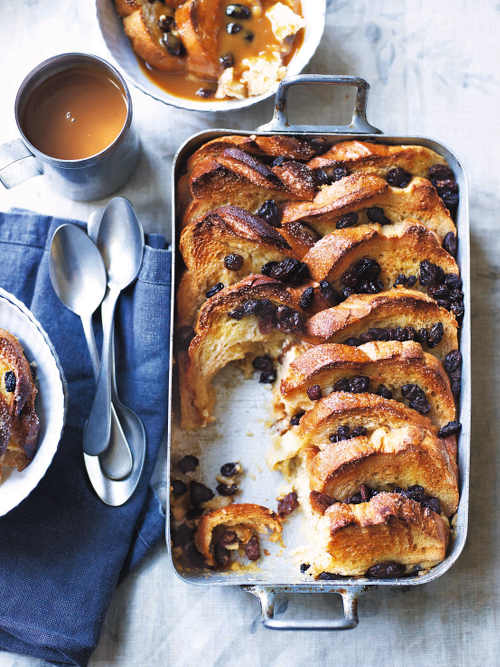 Salted Caramel Whiskey Bread and Butter Pudding with Raisins
Salted Caramel Whiskey Bread and Butter Pudding with Raisins
You could say that I grew up on bread and butter pudding. My mum or dad would prepare it at least once every two weeks. It is so simple to make and great for using up stale bread. I believe that it can also be a very elegant dish – in fact, I served this very recipe at my pop-up restaurant in NYC a few years back, and it was the most requested dessert on the menu. I wasn’t surprised! The salted caramel whiskey sauce is addictive and could also be poured over ice cream to make an Irish sundae. This pudding can be made up to a day in advance and warmed through in the oven before serving.
Serves 6
100g raisins
120ml Irish whiskey
5 large eggs
480ml double cream
225g granulated sugar
½ teaspoon ground cinnamon
¼ teaspoon ground nutmeg
1 teaspoon vanilla extract
8–9 slices of firm white bread, crusts left on
400g unsalted butter, at room temperature, plus extra for greasing
For the salted caramel whiskey sauce
110g unsalted butter, cubed
225g granulated sugar
1 dessertspoon sea salt
600ml double cream
1 In a medium mixing bowl, combine the raisins and whiskey, and leave to soak for 1 hour.
2 In a large bowl, whisk together the eggs, cream, sugar, cinnamon, nutmeg and vanilla to make a custard. Spread one side of each slice of bread with butter. Cut the slices in half diagonally and arrange half the bread in the bottom of the prepared baking dish, overlapping the slices. Drain the raisins and sprinkle half over the bread. Repeat with the remaining bread and raisins. Pour the custard over the bread and let it soak for 30 minutes.
3 Preheat the oven to 200°C/gas mark 6. Butter a 22cm square non-reactive baking dish.
4 Place the baking dish in a large baking pan. Add enough hot water to come halfway up the sides of the dish. Bake for 50– 60 minutes, or until the pudding is set and the top is golden. Remove the baking dish from the water bath and leave to cool slightly on a wire rack.
5 To make the salted caramel whiskey sauce, melt the butter in a small saucepan over a medium heat. Whisk in the sugar, salt, cream and whiskey. Reduce the heat to low and simmer for 10 minutes, or until the sauce thickens. Serve the pudding warm with the salted caramel whiskey sauce spooned over the top.
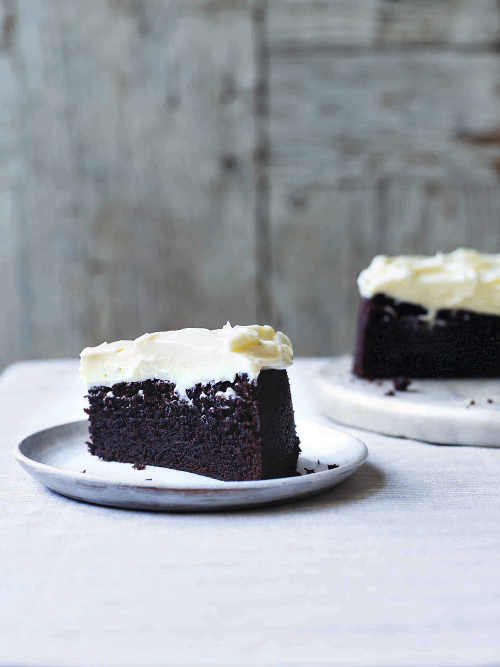 Guinness Cake
Guinness Cake
This cake can only be described as dark and majestic. The bitterness of the Guinness is balanced by the sugar and the vanilla icing adds a fluffy lightness to balance it perfectly. I make this at my restaurant, Clodagh’s Kitchen, using a locally brewed stout called O’Hara’s, which is similar to Guinness. If you don’t like stout, worry not – you will like this cake! The caramel and coffee flavours make this cake one of the best that I have ever made or eaten… Trust me!
Serves 10
260g unsalted butter
300ml Guinness
100g cocoa powder
2 free-range eggs
420g caster sugar
2 teaspoons vanilla essence
180ml buttermilk
300g plain white flour
2 teaspoons bicarbonate of soda
1 teaspoon baking powder
For the icing
100g unsalted butter, softened
300g icing sugar
1 teaspoon vanilla essence
300g full-fat cream cheese
1 Preheat the oven to 170°C/gas mark 3. Line the base of a 30cm round springform cake tin with baking parchment.
2 To make the cake, heat the butter in a large saucepan over a medium heat until melted. Stir in the Guinness, then remove from the heat and stir in the cocoa powder.
3 In a large mixing bowl, whisk together the eggs, sugar, vanilla essence and buttermilk, and then slowly add the Guinness mixture, whisking all the time.
4 In a separate large bowl, sieve together the flour, bicarbonate of soda and baking powder. Using an electric whisk, slowly pour the wet mixture into the dry ingredients and keep whisking until it is all well combined.
5 Transfer the mixture to the prepared cake tin and bake for approximately 45 minutes. Test to make sure the cake is cooked by inserting a dry skewer into the middle of the cake – if it comes out clean, the cake is cooked. Set aside to cool a little, then remove from the tin and allow to cool completely on a wire rack.
6 Meanwhile, make the icing by blending all the ingredients together using an electric hand whisk until light and fluffy.
7 Place the cake on a plate and generously spread the icing on top. The cake will keep for up to 1 week in an airtight container.
Georgina Campbell's Book Reviews
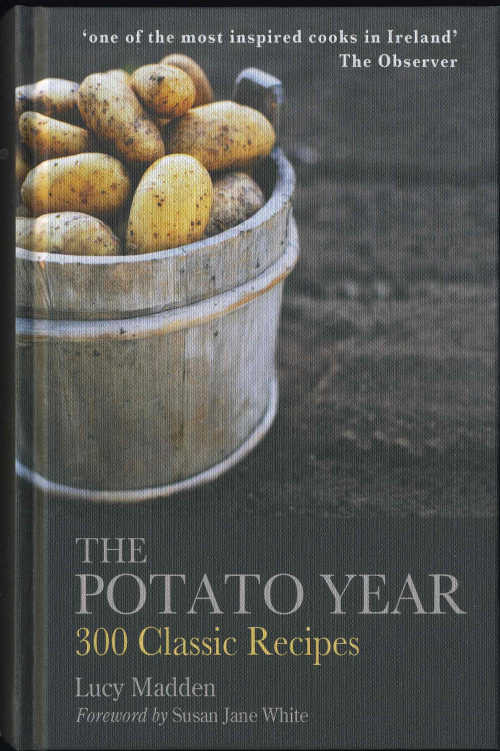
 A brace of books this month, all about the humble tuber that has become our national vegetable: the potato. Lucy Madden's The Potato Year, 300 Classic Recipes (Mercier Press, hardback; 350pp; €14.99) and Eveleen Coyle's The Irish Pocket Potato Recipe Book (G&M, hardback; colour photography throughout, 256pp; €4.99)
A brace of books this month, all about the humble tuber that has become our national vegetable: the potato. Lucy Madden's The Potato Year, 300 Classic Recipes (Mercier Press, hardback; 350pp; €14.99) and Eveleen Coyle's The Irish Pocket Potato Recipe Book (G&M, hardback; colour photography throughout, 256pp; €4.99)
Lucy Madden is well known to readers of this ezine for the sharply observed vignettes on Irish life and its oddities that regularly enlighten and entertain us. Together with her husband Johnny Madden, ninth generation owner of the wonderful Hidden Ireland house Hilton Park, at Clones, Co Monaghan - and more recently their son Fred, who is a chef, and his family - she has earned an enviable reputation for the wonderful food that she grows in the walled garden and has cooked for decades of lucky visitors. Her book The Potato Year, 300 Classic Recipes (Mercier Press, hardback; 350pp; €14.99) is a result of a particular passion that has kept her happily occupied in both garden and kitchen: growing and cooking potatoes.
This celebration of our best loved and yet most under rated vegetable dates back several decades to the first edition in 1992 - when, home published with the help of Lucy’s daughter, Amelia, it was an unexpected success. All these years later the new edition, which begins with a predictably perceptive Introduction by best-selling author of The Extra Virgin Kitchen and all round “health geek”, Susan Jane White, is very welcome. Kicking off the year, that comforting favourite, Dublin Coddle, sets the tone - and those of us who enjoy traditional cookery books, where a good read is part of the deal and the imagination creates the illustrations, will be happy to find that it’s a refreshingly image-free zone.
There can be few cooks as well qualified to create such a range of potato dishes throughout the changing seasons and, while this is mainly a celebration of the deliciousness and versatility of potatoes in their many varieties, their historical significance and - most importantly - notable health advantages are also highlighted, by both Susan Jane and Lucy.
“So,” says Lucy, “Keep your pasta, polenta and lentils, away with your rice, couscous and quinoa, these are mere upstarts. Bring back the potato to its place of significance on our plates.”
As Susan Jane White concludes her Foreword: this looks set to become a classic.
SAMPLE RECIPE for APRIL: A Warm Salad with Cream and Dill
Dill sown early in a greenhouse should be producing leaves by now. Dill appears with great reluctance if sown outside in my garden and runs to seed at the first chance.
11/2 lb (700g) potatoes, old or new
3 shallots, finely chopped
1 tablespoon butter, melted
6fl oz (175ml) cream
2 tablespoons dill leaves, chopped
Sea salt and freshly ground black pepper
4 handfuls mixed salad leaves
Boil or steam the cleaned potatoes until tender. Cook the shallots in the melted butter until translucent, then stir in the cream and the dill. Bring to the boil and season. Put the salad leaves on plates, place the potatoes on top and pour over the warm dressing. Eat immediately.
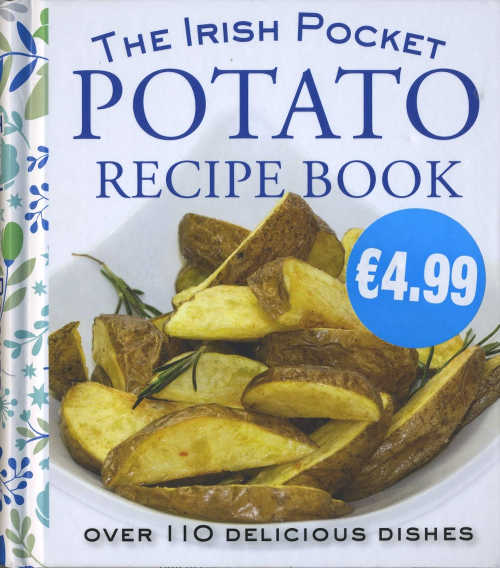 Also celebrating the potato, Eveleen Coyle - well known in Dublin as an editor and, more recently, for her Fab Food Trails (www.fabfoodtrails.ie) walking tours of Irish cities - is the author of a new title in Gill & Macmillan’s popular ‘Pocket’ series. The Irish Pocket Potato Recipe Book (G&M, hardback; colour photography throughout, 256pp; €4.99) offers ‘over 110’ recipes including many from our extensive traditional repertoire as well as some less obvious ones.
Also celebrating the potato, Eveleen Coyle - well known in Dublin as an editor and, more recently, for her Fab Food Trails (www.fabfoodtrails.ie) walking tours of Irish cities - is the author of a new title in Gill & Macmillan’s popular ‘Pocket’ series. The Irish Pocket Potato Recipe Book (G&M, hardback; colour photography throughout, 256pp; €4.99) offers ‘over 110’ recipes including many from our extensive traditional repertoire as well as some less obvious ones.
While not exactly a pocket book - you would need a poacher’s pocket - this squat little volume is comfortable in the hand, cutely presented (complete with bright blue ribbon marker) and, given the incredibly low price, is bound to find its way into many a visitor’s luggage. On the down side the photography is uneven throughout (the reason is obvious from the long list of credits at the end).
Also, it would be nice to see an Index - there is a contents list but, like too many current cookery books (including The Potato Year), no index. But, overall, this is a very attractive book for the price and is sure to do well.
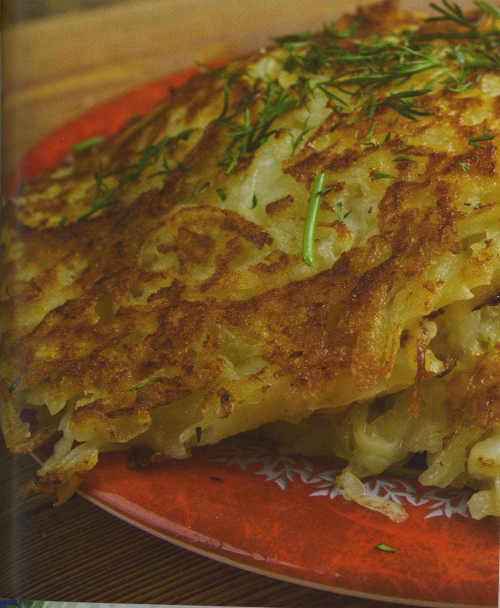 SAMPLE RECIPE: Nancy's Boxty
SAMPLE RECIPE: Nancy's Boxty
My husband's aunt Nancy Geelen was from the boxty stronghold of Leitrim and was famous for her boxty. This is her recipe.
SERVES 4-6
INGREDIENTS
8 large old or new potatoes
115 g/4 oz flour
1 tsp bicarbonate of soda
225 ml/8 fl oz milk
pinch of salt
2 tbsp butter, plus
extra to serve
METHOD
Scrub the potatoes and peel them if they are old. Grate into a large dish using the fine side of the grater.
Drain the potato into a clean tea towel to remove the excess liquid. Add the flour, bicarbonate of soda, milk and salt and mix well with a wooden spoon. Melt the butter in a heavy frying pan. When, bubbling, add the potato mixture.
Cook, turning, until browned on both sides. Serve at once with more butter.
Georgina Campbell's Book Reviews
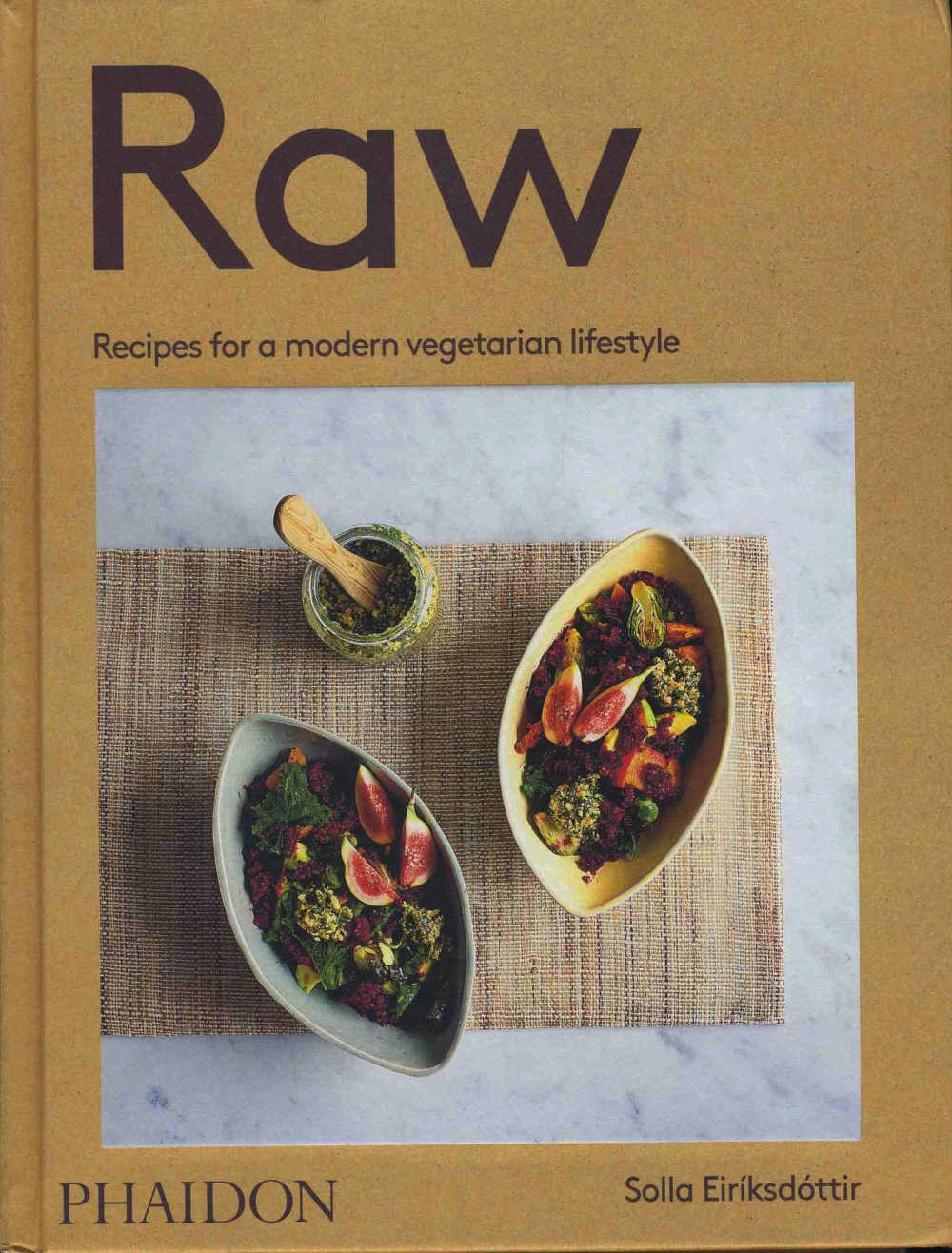
 RAW Recipes for Radiant Living by Bernadette Bohan (Gill & Macmillan hardback 204pp photography by Neil Hurley.
RAW Recipes for Radiant Living by Bernadette Bohan (Gill & Macmillan hardback 204pp photography by Neil Hurley.
Judging by images on the cover and throughout this handsomely presented book, Bernadette Bohan is her own best advertisement for the healthy eating plan she so passionately advocates.
And why wouldn’t she want to share her views so others can also benefit from the healing powers of food that she has experienced herself - looking at this beautiful woman glowing with health, it’s hard to credit that she has recovered not once, but twice, from cancer. And then you also learn that she is 60…wow is the only word that comes to mind.
All this gives her message great credibility, of course, and her previous books have also touched a nerve, especially the best-selling Eat Yourself Well, which explains how she decided to take charge of her own health following the second cancer diagnosis, mainly by making major changes to her diet - and how this led to a full recovery.
This time around the emphasis is on the hands-on business of what to eat (mainly plant based food), what to avoid (processed foods, sugar, dairy, coffee and meat), what to shop for and what to do with it.
'It's not the food in your life but the life in your food' according to Bernadette, who says her health improved greatly, her skin glowed, her energy exploded and her waist shrank following her change of diet.
In this book, Bernadette explains what raw, living foods are, gives a shopping list for essential foods (some of which may be unfamiliar), and explains the equipment needed for best results - including juicers (including a ‘masticating juicer’ which is quite an investment but does all kinds of amazing things including making pizza bases and pie crusts), a dehydrator, a power blender, sprouting jars and, of course, a vegetable spiraliser for making all kinds of things including vegetable ’pasta’.
The shopping list includes replacements for the usual sweeteners and seasonings - including celery salt (see recipe below) as a salt substitute, something we grew up with as my mother was an early advocate of health foods.
As the title suggests there’s an emphasis on cold food in the recipes - juices, smoothies, salads, snacks and dips - but there are some hot dishes too, including comfort food (anyone for carb-free spaghettit with sweet pepper pasta sauce?), and - just in case you’re thinking this all sounds too virtuous to be true - a whole chapter on Yummy Treats & Sweets...
You may have to learn a new food vocabulary to ‘go raw’ but it’s great time of year to make a change and Bernadette’s way could be the answer for many people - including those who just want to lose weight, or are addicted to sugar.
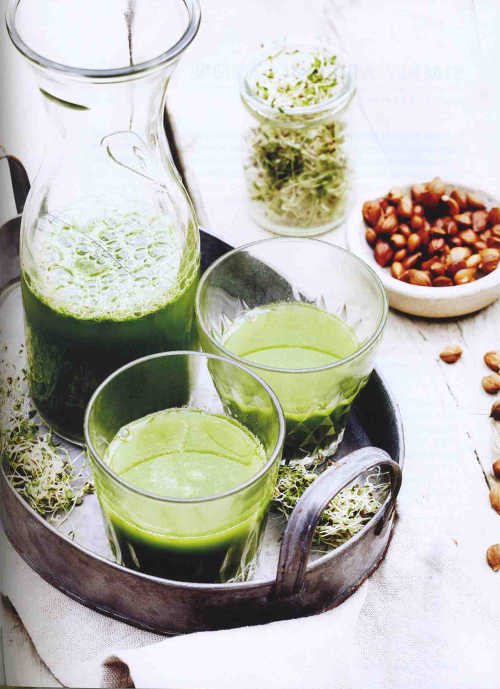 SAMPLE RECIPES:
SAMPLE RECIPES:
IMMUNE-BOOSTER JUICE
Most juices contain fruits, but it's green veggie juices that alkalise the body. When the body fluids contain too much acid, it is known as acidosis. Acidosis occurs when your kidneys and lungs can't keep your body's pH in balance.
This juice will neutralise and alkalise the body as it contains alfalfa sprouts and apricot kernels. All sprouts - alfalfa, sunflower, pea, broccoli, buckwheat - alkalise pH levels. I use black dinosaur kale, but if you can't source it, curly kale will do nicely. Black dinosaur kale has long, dark green leaves and can be sourced in all major supermarkets. Root ginger has numerous health benefits, too.
This juice is a wonderful way to boost immunity, as you are drinking the blood of the plants.
WHAT YOU NEED
— Handful kale
— 2 handfuls alfalfa sprouts
— 1 cucumber
— 2 celery stalks
— 5 apricot kernels (optional)
— Ginger, to taste
WHAT YOU DO
1 Process the kale and sprouts through the juicer.
2 Then add apricot kernels, celery, cucumber and ginger.
3 Return the pulp to the juicer to squeeze out more juice.
POTASSIUM-RICH CELERY SALT
IMMUNE BOOSTER
'Each year, food companies use an amount of salt that is every bit as staggering as it sounds: 5 billion pounds.' - Michael Moss
Why not try making your own (salt-free) celery salt? It really is simple. Why bother? Well, table salt (sodium chloride) has been linked to heart disease, muscle cramps, arthritis, diabetes and cancer. It contains bleaching agents, synthetic iodine, and, last but not least, the dreaded sugar. I know, it's hard to believe.
Eating excess sodium can also be harmful to people with hypertension or high blood pressure, and it causes fluid retention. Also remember that convenience foods and ready-prepared meals are high in sugars and salts.
Celery, on the other hand, is loaded with potassium; you can vary the flavour of the salt by adding garlic or onion, or make them separately. It's a fabulous way to use up wilted celery.
WHAT YOU NEED
1-2 bunches celery
WHAT YOU DO
1 Chop the celery into small chunks and place on dehydrator trays.
2 Dehydrate overnight until the celery is dry and mince in a blender. How cool is that?
Georgina Campbell's Book Reviews
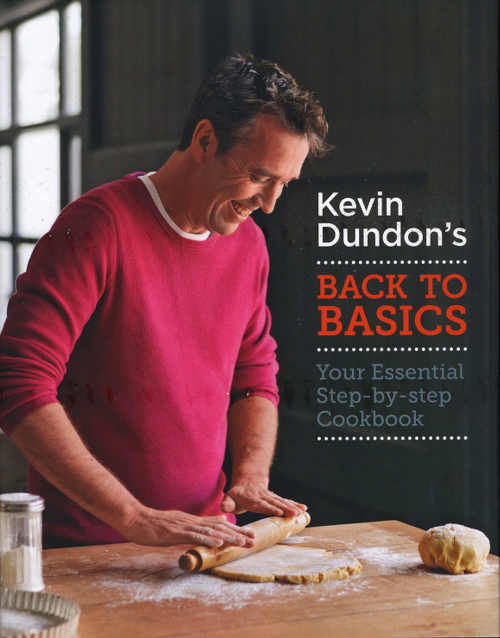
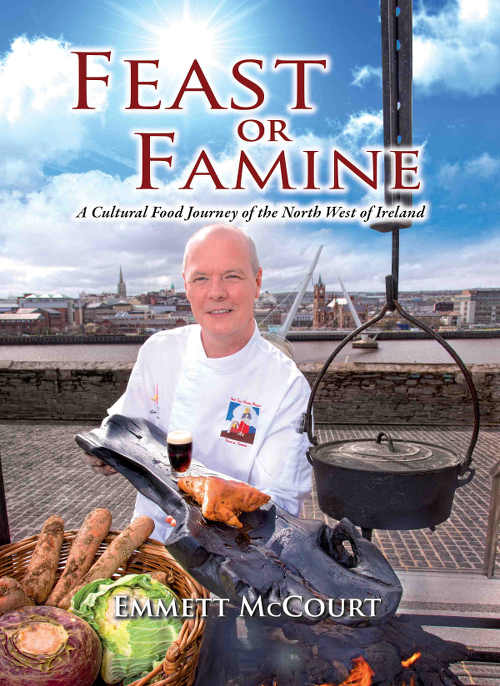 Feast or Famine: a Cultural Food Journey of the North West of Ireland by Emmett McCourt. Guildhall Press, hardback, 272 pp, fully illustrated. £19.95.
Feast or Famine: a Cultural Food Journey of the North West of Ireland by Emmett McCourt. Guildhall Press, hardback, 272 pp, fully illustrated. £19.95.
Passion is an overused word these days, but it’s hard to think of a better one when describing Derry chef Emmett McCourt and his relationship with the foods, and food heritage, of the North West of Ireland.
He may have worked in some of the world’s finest kitchens, but his roots are in this region and his love and respect for its traditional foods and cooking methods is palpable.
This book is at the centre of the multi disciplinary Irish Food Heritage Project (www.feastorfamine.ie), initiated by Emmett in 2011 “to capture and preserve the food history of the North West of Ireland” with the support of the North West Regional College, where he lectures and cooks in the college’s restaurants.
The project is proving an enormous success, with new strands developing all the time - a mobile cookery demonstration theatre and road show is a recent addition, designed to tour markets, fairs and food events around the country.
Even a quick glance through this book will give an idea of the dedication required to collect and collate such a massive amount of material about the food and culture of the North West. Every page is jam-packed with fascinating stories, songs, poems, recipes and photographs - lots of photographs.
This is not one of those design-led books with carefully curated images that are given acres of space around them, this one uses every available corner to fit in just one more brilliant producer, shopkeeper or cook (or their grandfather, or a great aunt..), the foods that they have loved down the years, and the historical context that has left its legacy - the Famine, emigration and World War Two and many others. There’s a sense of urgency in the way that it’s all packed in, as if it mustn’t be lost or go to waste - which indeed was the inspiration for the Irish Food Heritage Project in the first place.
With the (generally welcome) growth of modern Irish cooking there is a tendency, at the moment, to be dismissive about our simple traditional foods and cooking methods. Should persuasion be needed, Feast or Famine demonstrates vividly why that is a mistake.
As well as providing a fascinating introduction to the region’s food history, anyone planning a visit to the North West will find Feast or Famine a useful practical guide, as the final sections cover the contemporary scene, including a chapter detailing The City of Derry’s Unique Culinary Adventure, with a map and over fifty Food Heritage Hotspots highlighted, including many of the best pubs and restaurants.
Having already been successful at national level in the Gourmand World Cookbook Awards (www.cookbookfair.com), Feast or Famine was also shortlisted in the Best Local Book and Best Culinary Travel Book category in the ‘Gourmand Best in the World’ Competition, to be held in China this month. This book is an extraordinary achievement and deserves to do well - it is certainly a book that I will enjoy coming back to, time and time again.
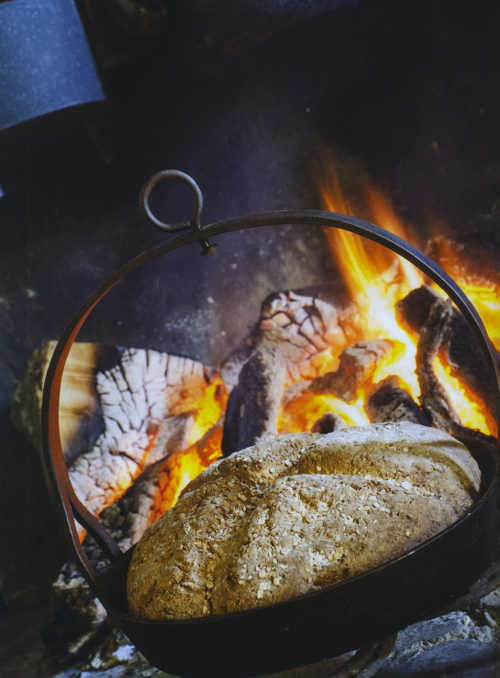 SAMPLE RECIPE: Oaten Bread
SAMPLE RECIPE: Oaten Bread
Oats appear a great deal in Irish cookery and oaten bread was widely eaten on a daily basis. Bread was traditionally baked in a cast-iron pot with lid— a pot oven.
Coals or turf were then placed on top to give radiant heat. Great skill and experience was used in determining the correct coals or turf to be placed on top of the lid to prevent the bread from burning.
Ingredients (Makes 2 medium loaves/1 large)
500g rolled oats
l00g soda bread flour 500ml-1000ml buttermilk
tsp baking powder 2 tsp golden syrup
1 tsp salt
Method
Place oats, baking powder, flour and salt in a bowl.
Add golden syrup and buttermilk gradually.
Mix to a stiff dough.
Turn out onto a lightly floured surface and knead until smooth, then divide in half.
Roll each half into a round, about 6.5 to 7.5cm thick.
Place on lightly greased baking sheet.
Preheat oven to 200C/Gas 6 and bake for 40 minutes until well risen and golden.
Serve warm with lashings of butter.
 Kevin Dundon’s Back To Basics - Your Essential Step-by-Step Cookbook Mitchell Beazley/Octopus Publishing; hardback 222 pages, photography by Cristian Barnett; £20.
Kevin Dundon’s Back To Basics - Your Essential Step-by-Step Cookbook Mitchell Beazley/Octopus Publishing; hardback 222 pages, photography by Cristian Barnett; £20.
When I first saw this book it reminded me (in a good way) of the old Good Housekeeping Step-by-Step cookery books that my mother had in the1950s. I still have one or two of them and every time I refer to one of their recipes I’m impressed again by the accuracy and attention to detail on every page - a real education, and a vast amount of work in those days before computers and digital imagery.
They may be in black and white, but they sure get the message across and give inexperienced cooks (and perhaps plenty of more experienced ones too) the confidence to learn new techniques and apply them successfully across a range of recipes.
Kevin Dundon’s Back to Basics does the same kind of thing in an appealing modern way, teaching skills rather than just giving recipes - although there is no shortage of those, and this cleverly organised book includes great recipes for all kinds of different occasions.
If you’ve been watching Kevin’s new cookery series ‘Back to Basics’ on UTV Ireland you’ll know the system - each time, he takes a basic ingredient, type of food or technique and, through the recipes, teaches a wide range of skills as you work your way through the series or the book. And it’s all about real food.
The recipes are both down to earth and enticing, covering everything from delicious things to do with eggs (from scrambled eggs to soufflés!), through all kinds of pastries and sauces, to mastering meat, poultry and fish, and of course gorgeous desserts and baking.
Through making all these delicious dishes, that are perfect for showing off to family and friends along the way, you acquire a complete armoury of skills and the confidence to try just about anything.
Common sense tells us that the issues around health and obesity that are worrying us so much today have far more to do with education and life skills than distractions like counting calories.
Kevin’s skills as a chef and cookery school instructor help make this book the pleasurable learning tool that it is, and - although equally appealing to people of all ages and situations - it would be an ideal engagement gift or small wedding present to set a young couple on the path to a lifetime’s enjoyment of good food and better health for themselves and their families.
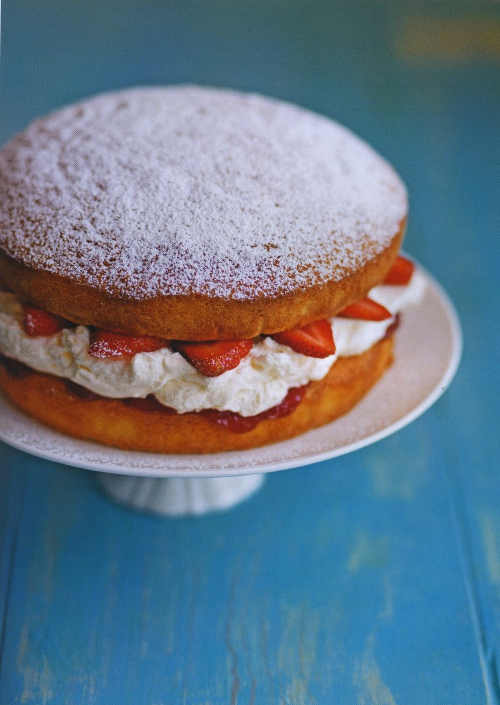 SAMPLE RECIPE: Victoria Sponge with Strawberries
SAMPLE RECIPE: Victoria Sponge with Strawberries
Here we have one of my favourite desserts - great for entertaining. An easy way to remember the proportions in the recipe is to weigh the egg and add the same weight of butter, sugar and flour.
Serves 4-6
300g (2½ sticks plus 1 tbsp) butter, at room temperature, plus extra
for greasing
300g (2½ cups) plain (all-purpose) flour
2 tsp baking powder 300g (21/3 cups) caster (superfine) sugar
5 large (US extra large) eggs
1 tsp vanilla extract
For the filling and topping:
6 tbsp strawberry jam
120ml (½ cup) whipped cream 300g (11oz) strawberries, sliced
Icing (confectioners') sugar, for dusting
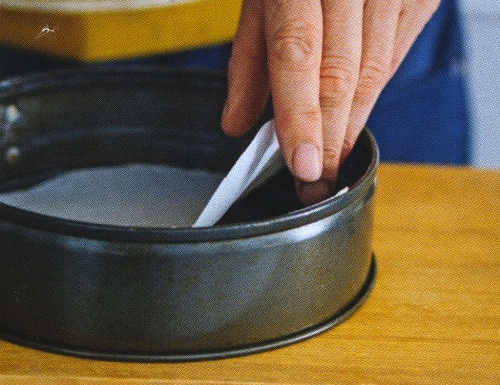 Preheat the oven to 180ºC/350°F/gas mark 4. Grease two 20cm (8 inch) cake tins and line the bottoms with non stick baking (parchment) paper [image (a)].
Preheat the oven to 180ºC/350°F/gas mark 4. Grease two 20cm (8 inch) cake tins and line the bottoms with non stick baking (parchment) paper [image (a)].
Place the flour and baking powder in a bowl and mix together.
In a large separate bowl, beat the butter and sugar until light and fluffy, [image (b)].
Beat in the eggs and vanilla extract, then fold in the flour. Divide the batter evenly between the prepared tins.
 Bake for 25-30 minutes, or until a skewer or toothpick inserted in the centre comes out clean. Turn out the sponges on to a wire rack and leave to cool.
Bake for 25-30 minutes, or until a skewer or toothpick inserted in the centre comes out clean. Turn out the sponges on to a wire rack and leave to cool.
To sandwich the cake together, peel off the lining papers and spread half the jam on each sponge. Cover the jam on one sponge with the whipped cream and sliced strawberries.
Place the second sponge on top, jam-side down. Dust with icing sugar.
Tips and ideas
Use berry compote (recipe given in book) instead of jam.
Try other fillings, such as mascarpone, crème fraiche mixed with strawberry purée or lemon curd.
The filling can be piped on top of your cake if you want to make it even more decorative. Half-fill a piping (pastry) bag fitted with a 1cm (½ inch) star nozzle (tip) and twist closed to make sure it contains no air pockets. You can start by practising on a piece of non stick baking (parchment) paper if you like. Remember that mistakes can be scraped off and you can start again.
Georgina Campbell's Book Reviews
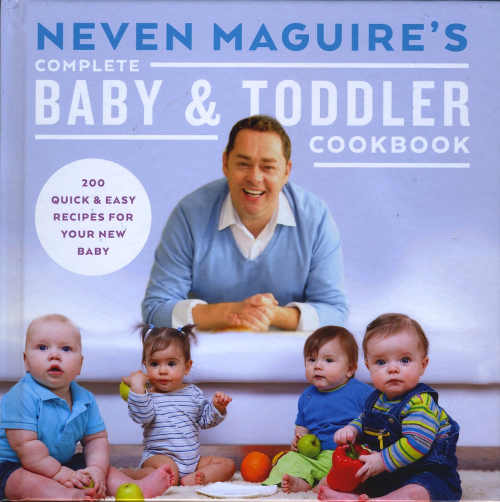
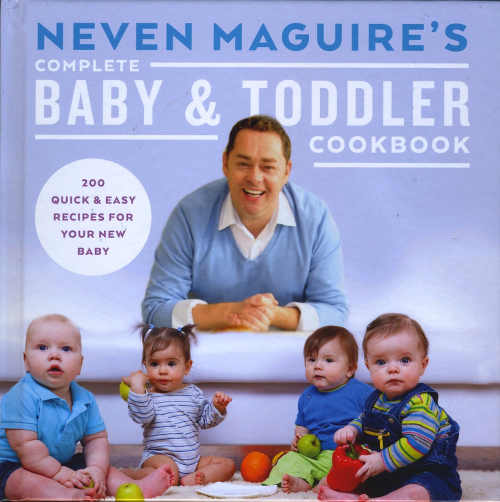 Neven Maguire’s Complete Baby & Toddler Cookbook (Gill & Macmillan hardback 276pp, €18.99; photography by Joanne Murphy).
Neven Maguire’s Complete Baby & Toddler Cookbook (Gill & Macmillan hardback 276pp, €18.99; photography by Joanne Murphy).
Every parent wants to give their child the best possible start in life and, just as a good breakfast is the best start to each day, good nutrition in the early stages is the best foundation for health throughout life. And who better to advise than Ireland’s best loved chef and father of 3-year old twins, Neven Maguire?
Although already the author of countless popular cookbooks, this one is different and the public obviously have great faith in it as Neven’s Baby & Toddler Cookbook - inspired by his own children, Connor and Lucia - shot straight to number one, even before the official launch.
Working with a great team including nutritionists and recipe testers, Neven - who is an ambassador for Danone Early Life Nutrition’s ‘First 1,000 Days’ educational programme, who reviewed and approved all the weaning and toddler recipes in the book although there is no commercial input - has produced not just a book of over 200 easy to make recipes and daily meal planners, but also advice on many of the questions that challenge parents today.
It will give confidence to parents wondering about the practical things - when to wean, which foods to start with, when to move on to ‘proper food’, what equipment to buy and so on - and also help, in a wider sense, with advice about things like allergies and whether to choose organic foods, and in setting goals as the routine changes from tiny babyhood to the days when a toddler can share in family meals.
The recipes include all the traditional purées and mashed foods that have sustained generations of babies, recipes with more texture for older babies, dishes that toddlers and all the family can enjoy together, and a final section on children’s party food and family celebrations.
This is the perfect first baby gift. With its combination of traditional common sense and up-to-the-minute nutritional advice, it will guide new parents through the sometimes unnerving early days and help to develop the good eating habits that will lead to a lifetime’s enjoyment of food as well as good health.
And with obesity topping the health worries list at the moment, it will be reassuring to parents to know that care taken with correct nutrition in the early stages - pre-natal, infancy, weaning and toddlerhood - will make obesity in later life far less likely.
On a practical level, the book is well laid out and indexed, it’s a good size, comfortable to handle, and the wipe clean cover makes a lot of sense. If changes are made in a later edition, a page marking ribbon would make a good addition and some of the coloured print might be reconsidered as contrast could be improved on some pages, making for better legibility.
 SAMPLE RECIPE: CREAM OF CARROT PUREE
SAMPLE RECIPE: CREAM OF CARROT PUREE
This technique can be used with any vegetable. Bulking it out with the baby rice makes it a much more substantial meal. Makes 600g (24 cubes)
225g carrots
50ml freshly boiled water
2 tbsp baby rice
340ml breast or formula milk
Top and tail the carrots, then peel and cut into thin slices, each about 2-3mm. Place in a saucepan with the water and bring to the boil. Reduce the heat to medium, cover with a lid and simmer for 12-14 minutes, until tender. Purée in a food processor and cool.
Mix the baby rice with the milk to make a smooth purée, then fold into the carrot purée. Spoon the cream of carrot puree into ice cube trays and freeze*.
*Flash freeze the filled ice cube trays for about 4 hours. Once the cubes are frozen solid, quickly pop out the cubes into ziplock bags. Make sure you label and date the bags with a waterproof marker.
(Further information and advice on freezing, defrosting and reheating is given in the Top Tips section in Stage 1 of the book)
Georgina Campbell's Book Reviews

 It’s The Little Things - Francis Brennan’s Guide to Life (Gill & Macmillan hardback (Gill & Macmillan hardback 231pp, €14.99).
It’s The Little Things - Francis Brennan’s Guide to Life (Gill & Macmillan hardback (Gill & Macmillan hardback 231pp, €14.99).
Francis Brennan has become something of a national treasure since he and his brother John launched themselves into RTE’s ‘At Your Service’ some seven or eight seasons ago, and his warm and courteous personality beams out of every page of his best selling book, It’s The Little Things.
It’s a real feel-good read, and great to keep somewhere where you can enjoy a bit any time you have a few minutes to spare - pop it into your beach bag, or keep it beside the bed to end the day with a little dose of Francis’s sensible and good humoured advice on just about everything - how good manners at home make a pleasanter life for everyone, all about dinner parties, being a good neighbour, in flight behaviour, job interviews, dining out, even social media - you name it and Francis has the answer to doing it nicely.
It all boils down to courtesy and consideration really, and, as he says in his finishing lines ‘Be mindful, be kind, be happy!’ Seasoned with anecdotes from his travels, his beloved Park Hotel and wisdom learnt from his mother (there’s even an occasional recipe thrown in), this is a little gem. If you thought books on etiquette were old hat these days, just spend a bit of time with The Little Things.
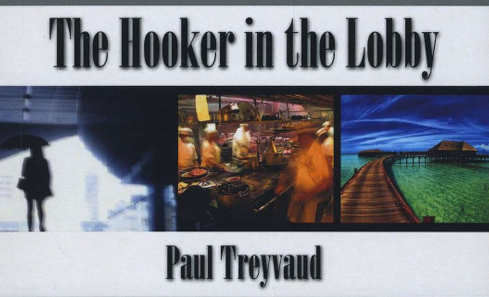 The Hooker in the Lobby by Paul Treyvaud (Varsity Press, paperback 220pp, €15; buy online http://www.publishedinireland.com/product/the-hooker-in-the-lobby/ or from Treyvaud’s Restaurant)
The Hooker in the Lobby by Paul Treyvaud (Varsity Press, paperback 220pp, €15; buy online http://www.publishedinireland.com/product/the-hooker-in-the-lobby/ or from Treyvaud’s Restaurant)
By contrast to ‘It’s The Little Things’, Paul Trevaud’s first book is a warts and all account of life in the hospitality industry - the title is a fair indication of what to expect and, as he says in the first line. ‘If you are in any way offended by bad language, put this book down now!’
If that’s not a problem you should find it a great read - if you’re in the industry, you’ll find plenty to empathise with and, if you’re just a punter who wonders what goes on behind the scenes, you’ll find an authentic personal account here.
And, for those who don’t already know him through the highly regarded Treyvaud's Restaurant in Killarney that he runs with his brother Mark, or through his TV work, Paul is the real McCoy. A graduate in Hotel Management & Business Studies at Cathal Brugha Street (and, even more importantly, ‘classically trained throughout his life by Ireland’s original Masterchef, his father Michel Treyvaud’), he’s an industry professional through and through.
And, surprising as it may seem, the fundamentals expressed echo much that Francis has to say - the importance of family, for example, and the key role that an entrepreneurial spirit and a strong work ethic play in achieving success in hospitality. And, if you’ve always wanted to run a restaurant, go straight to the final chapter where you’ll find some very level headed advice.
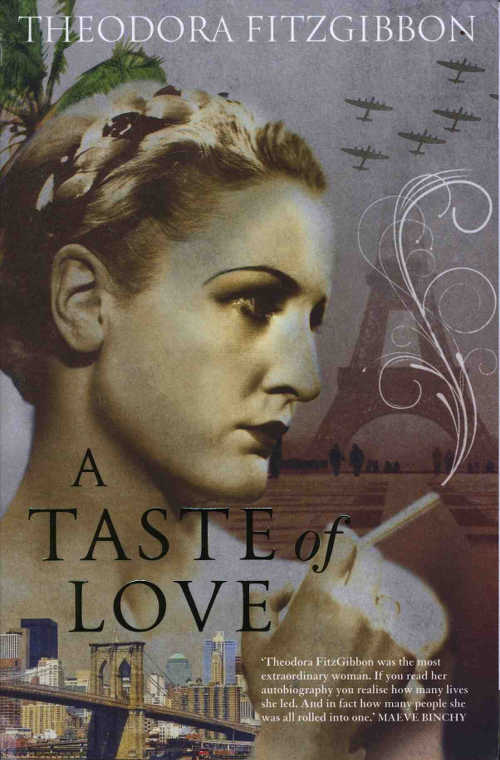 A Taste Of Love by Theodora FitzGibbon (Gill & Macmillan, Paperback, 304 pp, €16.99)
A Taste Of Love by Theodora FitzGibbon (Gill & Macmillan, Paperback, 304 pp, €16.99)
And so to Theoodora and A Taste of Love. Originally an autobiography in two volumes, With Love (1938-1946) and Love Lies A Loss (1946-1959), it’s a romping good read and full of surprises.
The first of which, for many readers, may be that she was not called Theodora at all but ‘settled on it’ after considering a number of options - something which may hold the key to the way she dealt with an extraordinary life.
This book covers her early years and, especially for those of us who knew her mainly as a cookery writer and colleague (she was the founding President of the Irish Food Writers’ Guild), the times she lived in and the people she knew are endlessly fascinating - Paris in the 1930s, London in the Blitz, and famous names including Dylan and Caitlin Thomas, Augustus John, Francis Bacon, Dali, Picasso and even the Soviet spy Donald Maclean who were in her social circle.
Even her early food experiences were exotic in the extreme - imagine being given cookery lessons by the former Queen Natalie of Serbia…After a famously turbulent marriage to Irish-American writer Constantine FitzGibbon, Theodora married the film maker and archivist, George Morrison (of Mise Eire fame), and they lived in Dalkey, where she wrote the Irish Times cookery columns for two decades, along with many cookery books including her most famous, A Taste of Ireland - this was my own introduction to Irish cooking and I always admired her staunch defence of good Irish food at a time when it was fashionable to run it down. She was her own woman - anyone who admires an adventurous spirit will love this book.
Georgina Campbell's Book Review
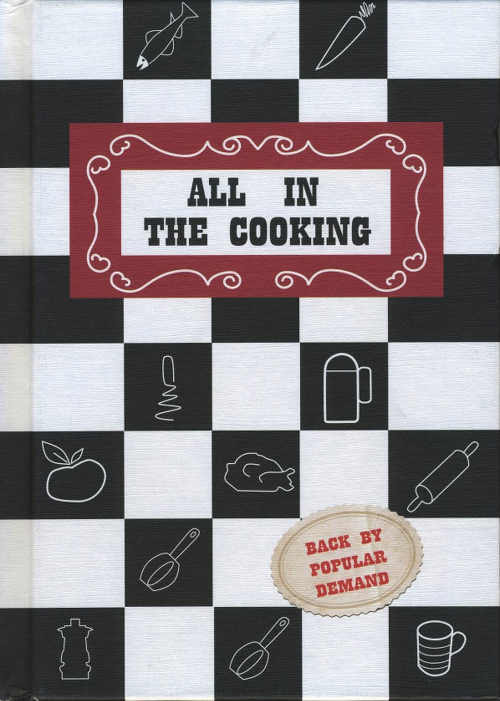
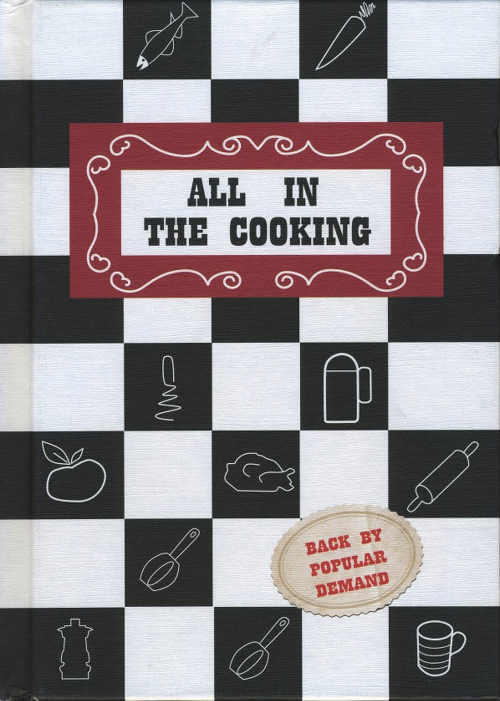 All in the Cooking by (O’Brien Press, €16.99 hardback 256pp; some diagrams, no photographs.)
All in the Cooking by (O’Brien Press, €16.99 hardback 256pp; some diagrams, no photographs.)
Back, as the publishers say, by very popular demand, this is the official textbook of Dublin’s famous Colaiste Mhuire Cookery School, Cathal Brugha Street, and you’ll know all about it already if you were going through college - or doing Domestic Science at an Irish secondary school - any time between the late ‘40s and early ‘70s.
It was first published in 1946 and a Foreword by one of the original authors, now in her 97th year, gives it a real sense of its place in modern Irish food history. Naturally delighted to see it back in print, and ‘to know that traditional Irish preparation and cooking of good food are enjoying renewed admiration’, Anne A. Browne (née Martin) expresses hope that it will be appreciated by a new generation.
And well it might, if they are close to their grandmothers anyway, as many a granny will happily reminisce over the disciplined, informative, thoroughly-indexed and photo-free pages that are so typical of the era, and recall the successes (and maybe a few failures) of working from one of the many dog-eared copies that were in daily use in Ireland at the time.
Maybe there won’t be much call for sheep’s head (or its variant, sheep’s head broth), brain cakes, egg cutlets or even stewed celery nowadays, but I for one could still work very happily with the Basic Kitchen Equipment that’s helpfully listed - who really needs the clatter of gadgets that clutter up our cupboards and worktops these days?
Yes, times have changed and the advice given on meal planning, shopping and food storage may seem dated, but the principles are unchanged and anyone running a home or just looking after themselves needs to know the basics if they are do it well, efficiently, economically and enjoyably.
How the quality of life would be improved for those who now stuff their trolleys with convenience foods and complain bitterly about the high cost of feeding a family if they had only been taught how to plan meals, shop well and cook wholesome food from scratch using inexpensive seasonal ingredients…Obesity was almost unknown in 1946, or even in the ‘70s when this book went out of print.
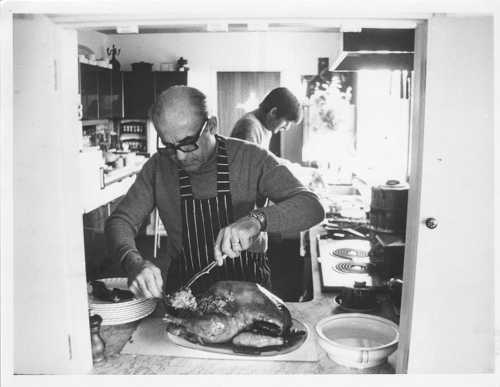 There’s a lot of practical detail about all the primary ingredients - fish, meats poultry - including diagrams showing the Irish meat cuts (one of the things that differentiates this book from standard UK textbooks), the basic cooking methods and (happy days) carving. How many of us search around frantically for someone who can make decent hand of carving the Christmas turkey? There aren’t too many people like my father these days, happy to work away on the bird at the head of the table or in the kitchen, calmly portioning it up while everyone else flew around doing the extras...
There’s a lot of practical detail about all the primary ingredients - fish, meats poultry - including diagrams showing the Irish meat cuts (one of the things that differentiates this book from standard UK textbooks), the basic cooking methods and (happy days) carving. How many of us search around frantically for someone who can make decent hand of carving the Christmas turkey? There aren’t too many people like my father these days, happy to work away on the bird at the head of the table or in the kitchen, calmly portioning it up while everyone else flew around doing the extras...
Rabbits get a whole chapter to themselves, and maybe there’s a lesson in that, but it is the chapter on Vegetables that will surprise many younger readers. Some of the cooking methods may seem old fashioned, but the varied range of locally available produce regarded as commonplace at the time is in painfully sharp contrast to the usually poor (and unfairly priced) offering from local growers in supermarkets today.
Yes, interest in vegetables is reviving, thanks to influences such as GIY and the trend towards ‘vegetables as fashion’ in restaurants, but we have a long way to go before it becomes the norm to think about what’s in season and at its best before beginning to plan our meals.
How often do we see Irish grown garden peas, broad beans, French beans or scarlet runners (as runner beans were called), in the mainstream shops, never mind the likes of endive, salsify, kohl rabi, chicory, globe artichokes, asparagus, or watercress - all grow well in Ireland, but read the label today and they will almost certainly be imported.
Sadly, the time that this sensible book has been out of print represents lost generations of cooking skills and waning recognition of the value of our culinary heritage - and, as is now being recognised, Ireland is the poorer for that.
The Irish Food Writers’ Guild (‘A voice for better eating’) is one of the groups taking action to remedy the situation. One of the aims put forward in our White Paper “The Health of the Nation”, recently presented to Oireachtas representatives, is to “Establish an annual ‘lost cooking generation’ focus week within the Guild to support older people’s cooking skills.” (In this context ‘older people’ means other than students). There is a long way to go but, together with many other educational initiatives, including “Embedding cooking and growing skills in education from primary level onwards”, the vision is achievable - and a relevant modern book along the lines of All in the Cooking would be a great teaching tool.
On a more cheerful note, with retro style enjoying a comeback, All in the Cooking should be a fruitful reference for anyone who enjoys baking - especially anyone running a café or tea shop and looking for ways to improve menus that currently seem to be mainly ‘more of the same’.
There are plenty of the nice old fashioned hot puddings and cold sweets that have been half-forgotten (when did you last see deliciously simple Apple Snow on a menu?), for example, and there are bound to be a few recipes from the Bread and Cakes chapter that will widen the repertoire and bring smiles to the faces of family, friends and customers alike.
SAMPLE RECIPE: Eve’s Pudding
Now that Irish apples coming into season, try this comforting hot pudding from All in the Cooking. Windfalls will be fine, just adjust the sugar accordingly; margarine is the given fat for the cake mixture, as was usual at the time, but it is better made with butter.
Similarly, it would usually have been served with cornflour custard sauce (there is a recipe in the book; the famous commercial equivalent is Bird’s), but it is delicious with real egg custard.
I have given dual measurements below but, as All in the Cooking is a facsimile of the original publication, only imperial measurements are given in the book. Some essential conversions and oven temperatures are given (in rather small print) on a bookmark.
1lb/450g apples
About 2oz/5g sugar
2 cloves
About 1 dessertspoonful water
2oz/50g margarine, at room temperature
2oz/50g castor sugar
1 egg
30z/75g flour
¼ teaspoon baking powder
A few drops vanilla essence
1. Peel core and slice the apples and put them into a greased pie dish with the sugar, cloves and a little water.
2. Make the cake mixture. Beat the fat and sugar together in a bowl until white and creamy, using a wooden spoon or electric mixer. Gradually add the beaten egg and vanilla to the creamed mixture and fold in the sieved flour and baking powder with a metal spoon, adding a little water if necessary to make a dropping consistency.
3. Spread the cake mixture over the apples and smooth with a knife. Bake in a very moderate oven (350ºF, 175ºC) for 40-45minutes, until the mixture is quite cooked. Dredge castor sugar on top and serve.
Georgina Campbell's Book Reviews
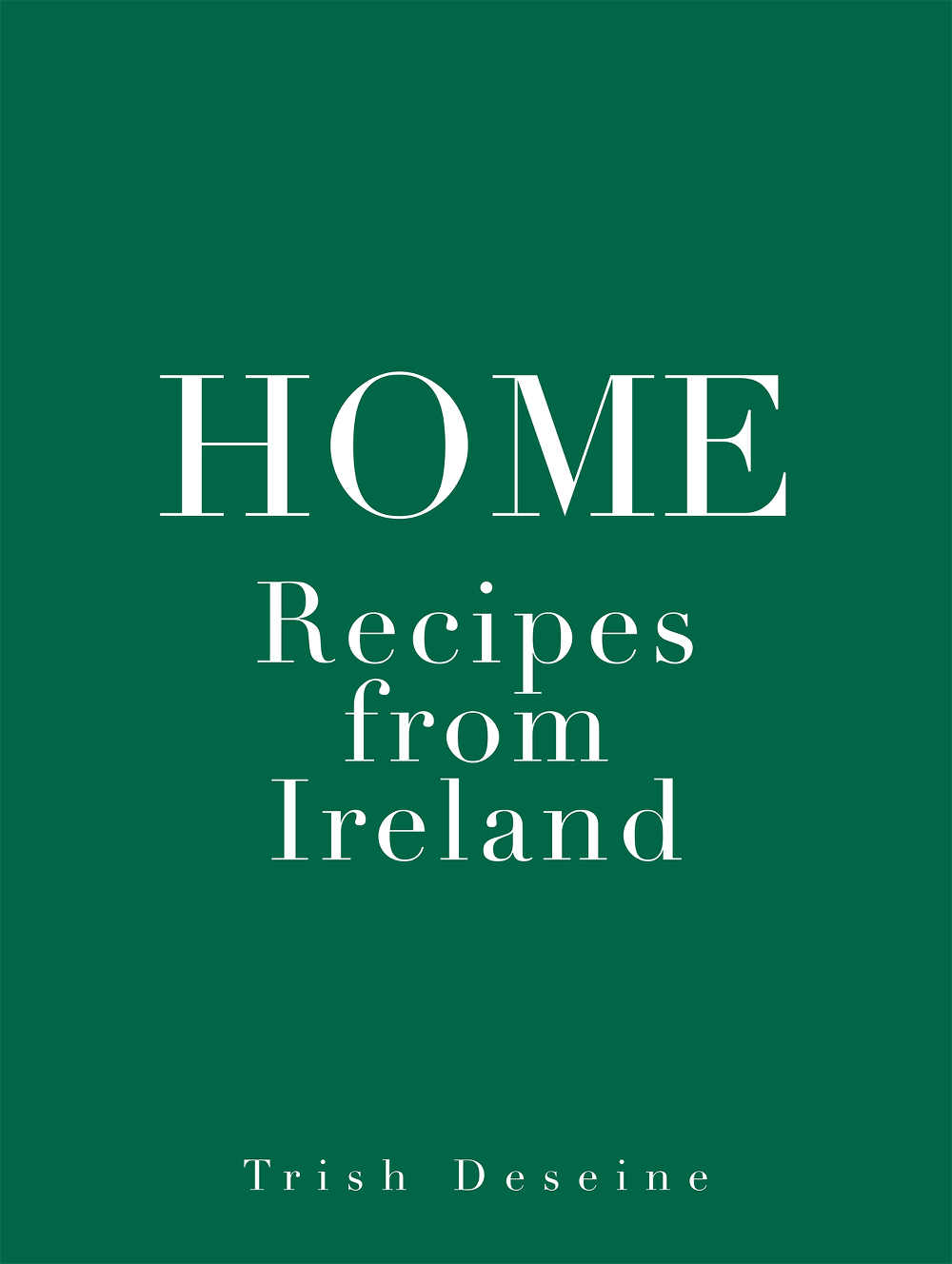
 From the terrific autumn crop of food books that’s piling up on my desk, I’ve selected two especially gift worthy volumes for this month’s reviews. Trish Deseine’s new book, HOME: Recipes from Ireland (Hachette Cuisine; hardback, 356pp; photography by Deirdre Rooney; €29) & SEA GASTRONOMY Fish & Shellfish of the North Atlantic by Michael O’Meara (Artisan House hardback 440pp with original photography by the author, €30)
From the terrific autumn crop of food books that’s piling up on my desk, I’ve selected two especially gift worthy volumes for this month’s reviews. Trish Deseine’s new book, HOME: Recipes from Ireland (Hachette Cuisine; hardback, 356pp; photography by Deirdre Rooney; €29) & SEA GASTRONOMY Fish & Shellfish of the North Atlantic by Michael O’Meara (Artisan House hardback 440pp with original photography by the author, €30)
Both are impressive big books, weighing in at nearly 2.5kg - which means a cost of €10 if posted within Ireland; €30.50 to UK and all EU countries; and €36.50 to the ‘Rest of the World’. But, at €30 or less, they are so attractively priced that either would make a splendid Christmas present without breaking the bank, even if sent by post.
Described accurately by her publicists as “a heartfelt love letter to Irish food”, Trish Deseine’s new book, HOME: Recipes from Ireland (Hachette Cuisine; hardback, 356pp; photography by Deirdre Rooney; €29), is both a poignant reminder of the Ireland that we have all left behind and a (mainly) joyful welcome to the one that has replaced it.
The Northern Ireland of her childhood may have been a place of mixed blessings but, looking back after 25 years in France, Trish Deseine now sees afresh how the good, simple food of the family farm in Co Antrim - in the days when ‘eating local was the only option’ - has influenced her, and there’s a strong traditional thread running through this book.
But it is also, quite literally, a voyage of discovery, as Trish researched her labour of love the old fashioned way, by taking to the road. For six months she travelled the length and breadth of the country, sometimes rediscovering a half forgotten food past and, at others, seeing with fresh eyes a new and vibrant foodscape that we can all now enjoy in sharper focus through her story.
Along with well chosen producers of this country’s ‘larder of fine ingredients’, she visits some of the chefs (many of them GCGuides’ Award winners) who are making Ireland’s reputation as a dining destination - including Derek Creagh of Harry's Shack; David Hurley of Gregan’s Castle on The Burren; Graham Neville of Dublin's Restaurant FortyOne; Stevie Toman of Ox, Belfast; Enda McEvoy of Loam, Galway; Jess Murphy joint-owner and chef of Kai, Galway; Kevin Aherne of Sage, in Midleton and Robbie Krawczyk of Tankardstown House, Co Meath - and, like her own more homely dishes, the recipes she has persuaded them to divulge are surprisingly do-able.
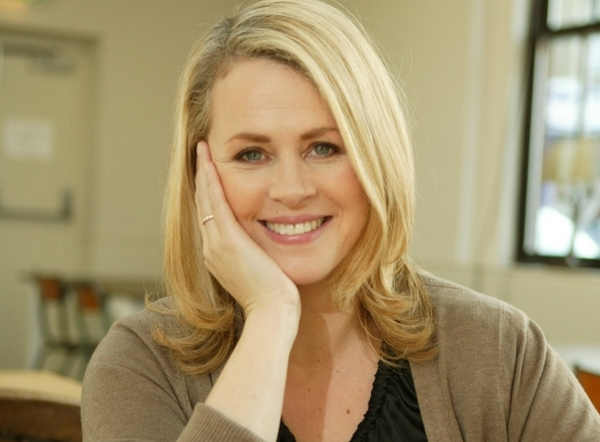 It is as good to see the traditional Irish ingredients like oats, kale, cream, apples, bacon and bread (including that uniquely Northern Irish speciality, Veda bread!), treated with such warmth and respect, as it is to share the pleasure Trish enjoys when finding new products and dishes that have developed while she was away.
It is as good to see the traditional Irish ingredients like oats, kale, cream, apples, bacon and bread (including that uniquely Northern Irish speciality, Veda bread!), treated with such warmth and respect, as it is to share the pleasure Trish enjoys when finding new products and dishes that have developed while she was away.
The much talked about new Northern Ireland blue cheese Young Buck, for example, features in her Oat Cookies, and dishes like Durrus Cheese, Sea Beet and Nutmeg Pizza, from Good Things Café, demonstrate beautifully the balance between innovation and tradition that is the hallmark of chef and teacher, Carmel Somers.
While Home is a personal hymn to an Ireland rediscovered, it is not uncritical. Thus, for example, the introduction to a recipe using the very popular ‘crab toes’ (claws) does not shy away from explaining the ‘rather unpalatable truth’ about the ways in which they may be harvested (crabs are often declawed at sea then thrown back). Similarly she outlines the options between ‘free range organic’ and ‘industrialised production’ pork products, and addresses other such issues when necessary throughout the book.
And then there is Deirdre Rooney’s brilliant photography, which is a constantly illuminating presence guiding the reader through Home - in fact, the visual element is so strong that even those with little or no interest in cooking might very well seek this book out simply because it is such an evocative portrait of Ireland. Her food photography is superb, but the landscapes, seascapes and - especially - the skyscapes are hauntingly beautiful and, at a whopping 31x21cm, the page size really does them justice.
The size, photography and design make this a good old-fashioned ‘coffee table’ book but it is also a very practical reference - and surprisingly modestly priced for its size and quality. There is much more that could be said about this wonderful book, but that is no substitute for seeing it for yourself - and, fortunately, it offers exceptional value too.
***Trish’s recently filmed 3-part BBC NI TV show Trish Deseine’s Doorstep Food – a series on eating local, celebrating Northern Ireland's ‘food revolution’ - is BBC1 NI from Monday 9th November, 7.30pm
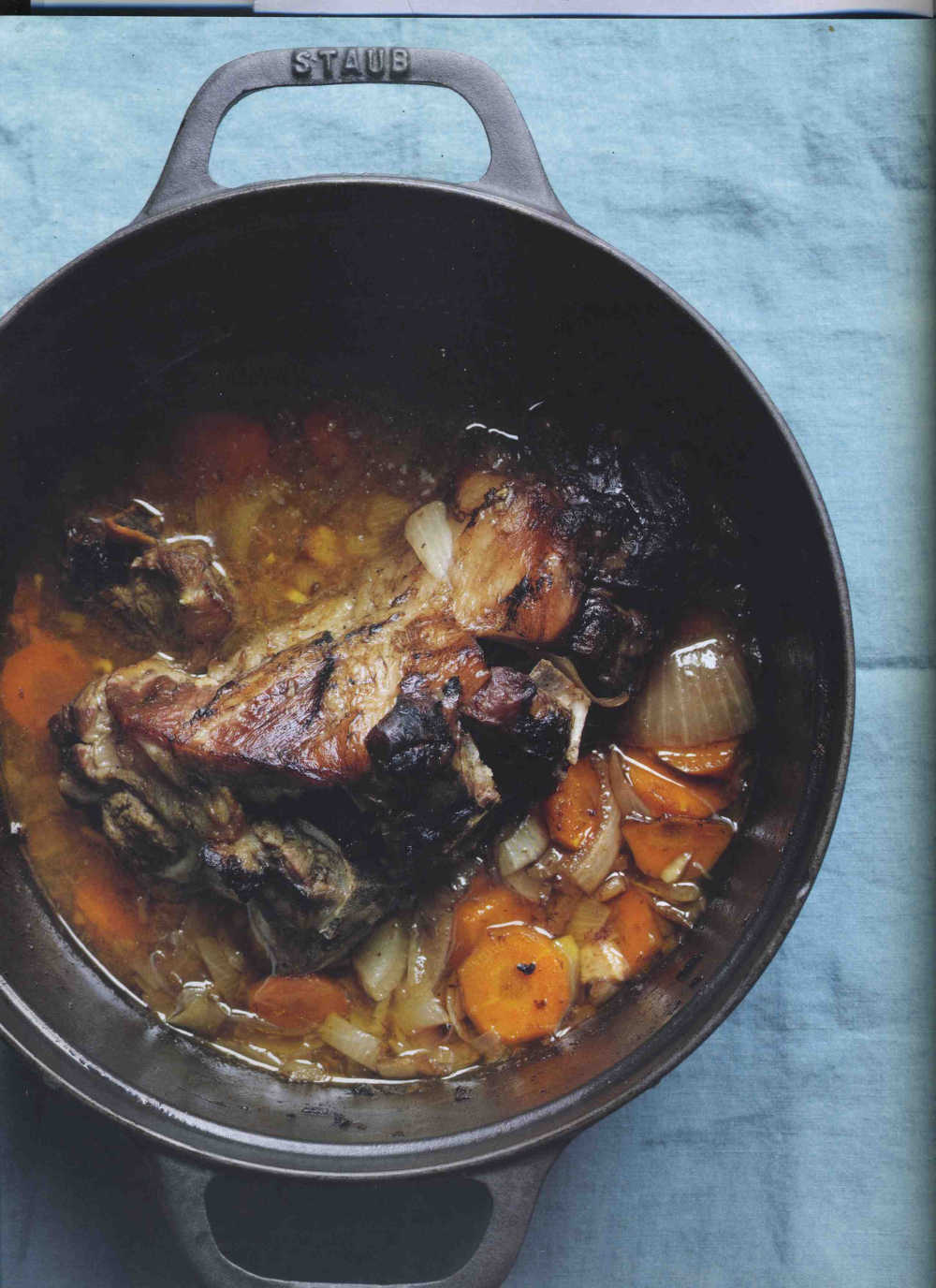 SAMPLE RECIPE: Mutton Pot Roast With Onions And Carrots
SAMPLE RECIPE: Mutton Pot Roast With Onions And Carrots
This is a really interesting recipe from Home to pick as a sample, because it illustrates the kind of food dilemmas we find ourselves in today, and of which Trish Deseine is clearly very aware.
It’s in a chapter entitled Mutton, Beef and Game and, while the beef and game probably seemed straightforward enough (at the time of writing anyway), the mutton is in reality almost nowhere to be found and even hogget (the name for a young sheep once it’s over a year old) is now more likely to be sold as ‘lamb’.
In particular, mountain lamb is a very seasonal late season product and this small, lean animal is never likely to be offered for sale at anything like the size or maturity associated with mutton. But mutton, which is enjoying renewed popularity in the UK, must be due for a comeback here too, so this will be the very recipe for it when it does.
‘It's not that easy to find mutton or hogget in Ireland these days, as modern taste has, for years, preferred the sweeter, more delicate meat of lambs butchered before the connective tissue has time to grow. In the old times, the greatest asset of sheep was their wool, not their meat, but now it is rare to find ram meat over six months old. When you do come across mature sheep meat, it's best to cook it long and slow.
Mutton, after kid, would have been the meat traditionally found in Irish stew, and this is a pot roast version of it, with a little extra luxury in the form of carrots. A leg of mutton is best poached for a couple of hours, like ham, and served with Colcannon and caper sauce.
Irish lamb is famously delicious, and enjoyed all over the world, but the Calvey's family Achill Mountain Lamb is truly special. Look out for it!’
For 4
5 minutes preparation 2 to 3 hours cooking
30 g butter
2 kg piece of neck of mutton
2 large onions
4 carrots
Salt and pepper
Peel and slice the carrots and onions.
Pre-heat the oven to 150°C.
Heat the butter in a heavy based casserole dish (with a lid) and brown the mutton all over. Add the carrots and onions and brown them in the mutton fat.
Pour in a glass of water - just so the base of the meat and the vegetables are covered - season lightly with salt and pepper and bring to the boil on the hob.
Once simmering, put the lid on and cook in the oven for 2½ to 3 hours, until the meat is melting.
You can remove some of the fat, before serving with fluffy potato mash.
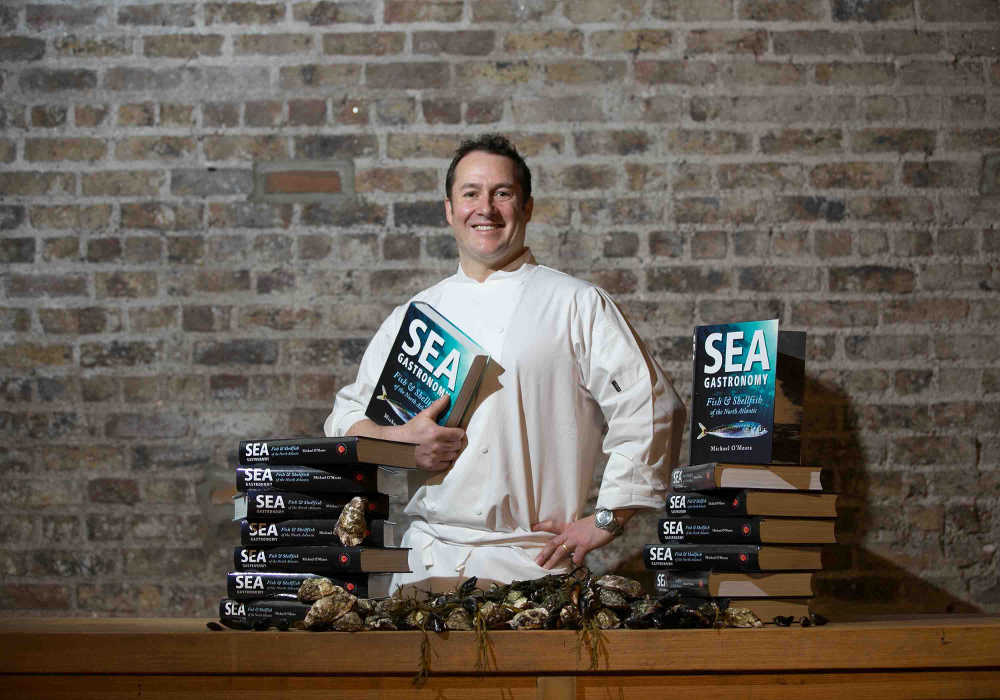 SEA GASTRONOMY Fish & Shellfish of the North Atlantic by Michael O’Meara (Artisan House hardback 440pp, with original photography by the author; Foreword and wine guidance by Ernie Whalley. €30 from bookshops nationwide, also from Oscar’s Seafood Bistro, Galway (www.oscarsbistro.ie) and online from www.artisanhouse.ie.
SEA GASTRONOMY Fish & Shellfish of the North Atlantic by Michael O’Meara (Artisan House hardback 440pp, with original photography by the author; Foreword and wine guidance by Ernie Whalley. €30 from bookshops nationwide, also from Oscar’s Seafood Bistro, Galway (www.oscarsbistro.ie) and online from www.artisanhouse.ie.
The talents that Michael O’Meara deploys with such skill in the kitchen of Oscar’s Seafood Bistro - the Galway restaurant that he runs with his wife, Sinead - have been given free rein in this stunning and very timely book.
Another beautiful tome from the Connemara publishers, Artisan House, SEA GASTRONOMY Fish & Shellfish of the North Atlantic is a must-have reference for any seafood lover - and, although Michael shares a huge range of recipes (235 in total), this encyclopaedic but very readable culinary study of the huge variety of fish and shellfish in the North Atlantic is much more than a cookbook.
Combining the beauty of Michael’s photography with information on an astounding range of fish and shellfish (many of which will be totally new to most readers as they have, until now, been discarded as unwanted by-catch) and their sustainability, it’s the culmination of two decades of research by a gifted chef who - thanks to the skills passed on by his parents - has had a joint passion for fish and cooking since the age of six.
A deep respect for marine resources is the cornerstone of Sea Gastronomy and that, especially, will make it an invaluable resource for schools and colleges as well as home cooks. The responsible seafood lover will find that Dr Peter Tyndall’s notes on sustainability make sense of a topic that is confusing to many, helped in practice by Michael’s detailed and well illustrated information and advice on the many types (an amazing 120 species) of north Atlantic fish and shellfish, how to buy and store them, and the basic preparation and cooking methods organised by type.
In his role as photographer, Michael has for many years been working on the portfolio of images that would enable this book to become reality. The 375 photographs selected from his collection contribute something very special - and so do his original recipes which, while contemporary, transcend fashion and will be a source of inspiration to cooks and chefs for many years to come.
An outstanding work, SEA GASTRONOMY Fish & Shellfish of the North Atlantic is surely destined to take its place alongside classics like Alan Davidson’s North Atlantic Seafood (1979) and Rick Stein’s first book English Seafood Cookery (1988) as a game changer in the way we understand, value and cook with the treasures of the ocean.
A book to treasure.
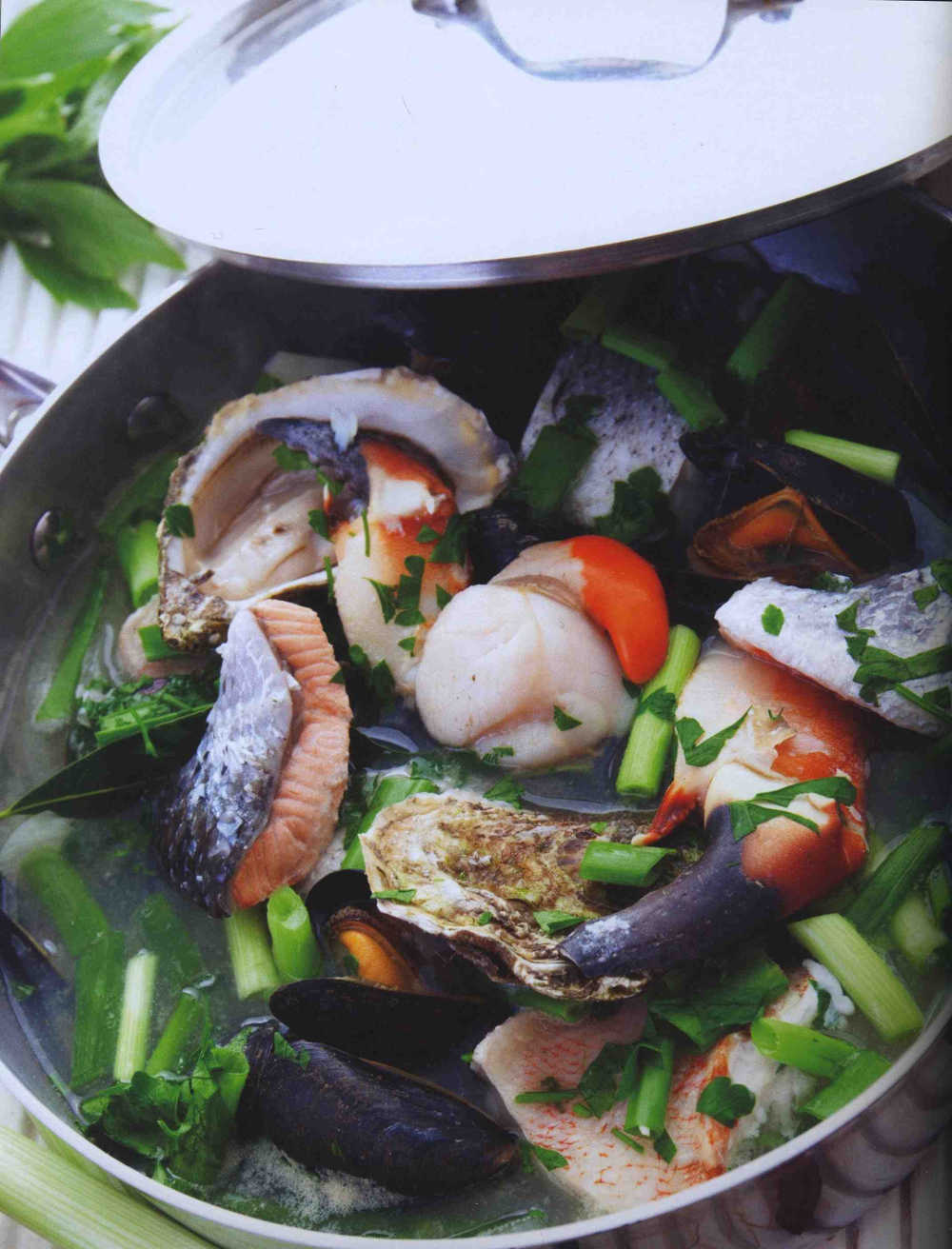 SAMPLE RECIPE: Seafood coddle
SAMPLE RECIPE: Seafood coddle
This is a simple one-pot dish that will pose little challenge to even the most inexperienced cook. A dish this simple, however, will require the best possible ingredients. Substituting the fish stock for a good chicken stock also works well, especially for those who prefer less intensity to their seafood.
Serves 4
300 ml chicken stock or fish stock
4 sprigs of thyme?
2 bay leaves
1 wet (freshly harvested) garlic, finely chopped
150 g leek, cleaned and cut into medium-sized pieces
1 small onion, peeled and sliced
5 new season Queens potatoes,? washed well and sliced
350 g mixed fish and shellfish, such as scallops, salmon, crab, prawns, bluemouth, mussels
salt and black pepper, freshly ground, to season
15 g flat-leaf parsley, roughly chopped
Put the stock into a medium-sized pan and bring to a gentle simmer.
Add the potatoes, thyme, bay leaves and onion; simmer until the potatoes are three-quarters cooked.
Add the wet garlic, leek and all the fish, cover the pan and gently simmer until the fish is cooked.
Season with salt and pepper and serve in a bowl. Garnish with the flat-leaf parsley.
Georgina Campbell's Book Reviews
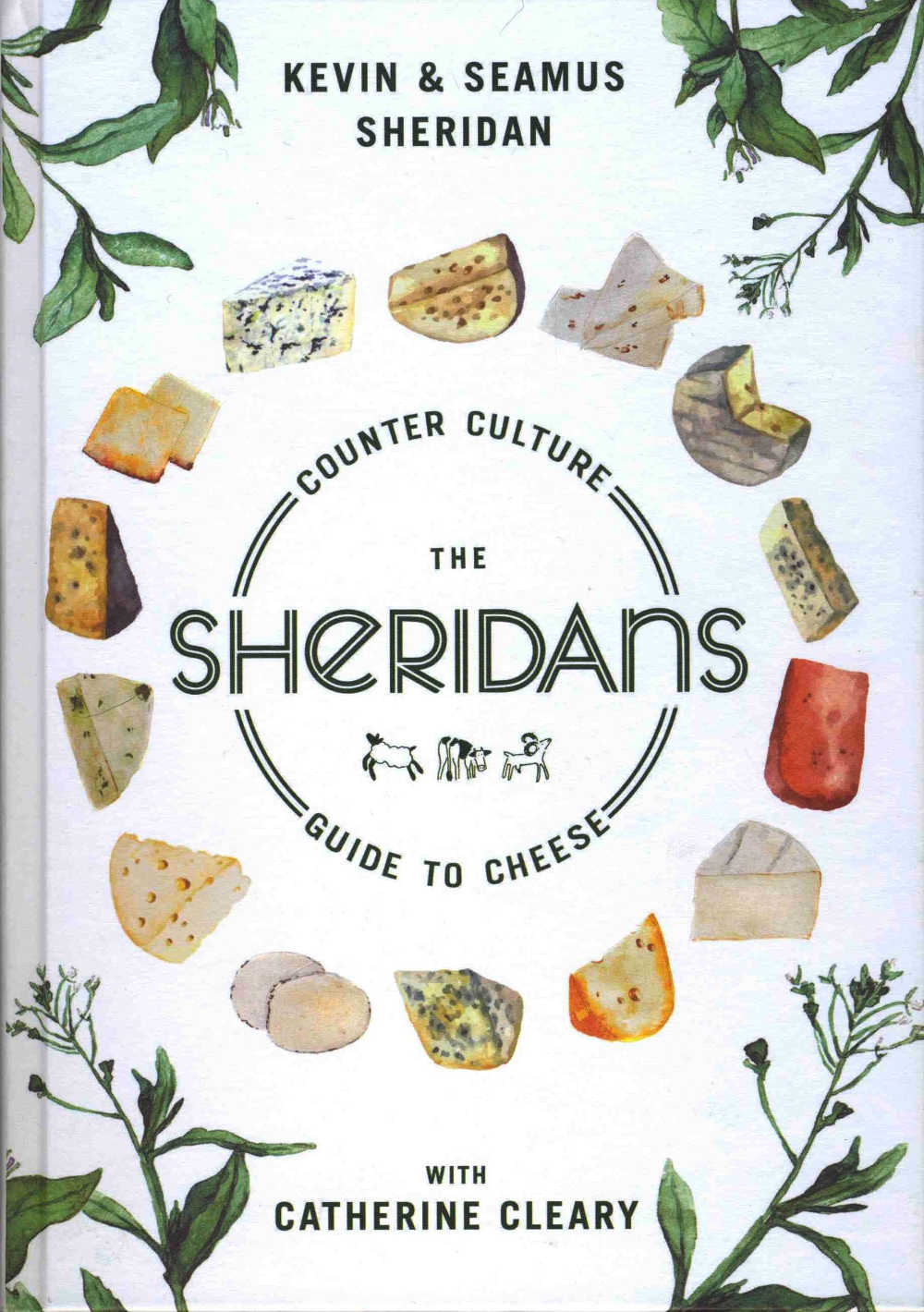
 Counter Culture - The Sheridans Guide to Cheese, by Kevin and Seamus Sheridan, with Catherine Cleary (Transworld; hardback, £16.99)
Counter Culture - The Sheridans Guide to Cheese, by Kevin and Seamus Sheridan, with Catherine Cleary (Transworld; hardback, £16.99)
How to buy, store, age, taste and appreciate the great cheeses of the world and create a perfect cheese plate for any occasion...
Although only in their prime, Kevin and Seamus Sheridan are already a part of Irish food lore. Everyone with even a passing interest in good food knows a bit about the Dublin brothers, and how they started selling farmhouse cheese at Galway market in the 1990s. And how they next opened Sheridans Cheesemongers, first in Galway and then in Dublin, Waterford (at Ardkeen Quality Food Store) and in Meath.
Here their wonderful headquarters - warehouse, shop, office - is in restored buildings at Virginia Road railway station near Kells, where they also hold markets and their famous annual Food Festival. Today, their skill as affineurs and purveyors of the best cheeses from Ireland and abroad has earned widespread recognition - also their close relationship with local producers and championship of the family farm, which has been a profound force for good in the development of the vibrant food culture that we are once again enjoying.
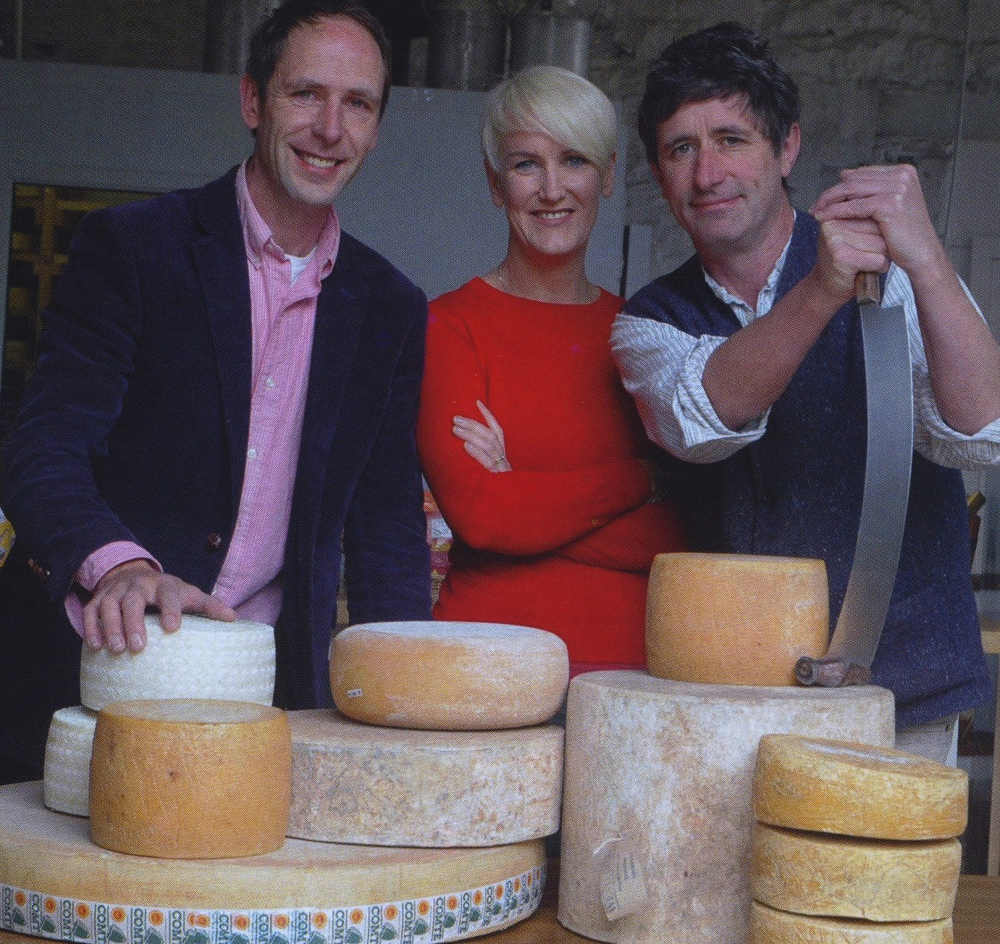 Even at its simplest, it’s an inspiring story and many of the small dairy farmers and artisan producers who are at the heart of this book would not have found a market for their quality foods without the Sheridans. But, while their Slow Food philosophy of respect for the land and its custodians may be simple, and their insistence on quality has become a byword underpinning everything they do (including production of their own range of crackers and other accompaniments for cheese), their love and care and nurturing of cheese and the people who make it is fascinatingly complex - and this is their story as much as a handbook to appreciating great cheeses.
Even at its simplest, it’s an inspiring story and many of the small dairy farmers and artisan producers who are at the heart of this book would not have found a market for their quality foods without the Sheridans. But, while their Slow Food philosophy of respect for the land and its custodians may be simple, and their insistence on quality has become a byword underpinning everything they do (including production of their own range of crackers and other accompaniments for cheese), their love and care and nurturing of cheese and the people who make it is fascinatingly complex - and this is their story as much as a handbook to appreciating great cheeses.
The Sheridans Guide to Cheese is as multi-layered as any of the great cheeses that they love so much. Along with all the practical information that their unique expertise allows them to share, this is a family story about the people they grew up with, their lives and their values, also the story of the many cheesemakers who have filled the shelves of their warehouse and the other cheese lovers who have tended them, sold them and educated people about them. Food writer and journalist, Catherine Cleary, helps to tell their wonderful stories, but this is Kevin and Seamus’s book, and her presence is discreet.
It’s as much a book to read as a reference, with interesting diversions at every turn, yet also with the practical contents divided up very logically into two major sections - the first covering the history and science of cheese, and the second (the main part of the book) devoted to six sections on the main types: Fresh Cheese; Bloomy Rinds; Washed Rinds; Pressed Uncooked; Pressed Cooked; and Blues.
In each category, Kevin and Seamus introduce key cheese makers, explain production methods and what gives cheeses their individuality, and give practical advice on selecting, buying, aging and storing each variety. Then there are the food and drink pairings that they enjoy with their favourite cheeses, and recipes too - all of which will inspire readers to be more adventurous shoppers, to care for cheese with confidence - and enjoy it to the full.
 The book itself is also interesting in many respects. It has a rustic, slightly higgledy piggledy tone to it that feels just right, as it’s homely and organic. The design is pleasantly old fashioned, with most of the many photographs in black and white, making it feel as if it’s made for the local market, almost like a parish magazine - yet it’s priced in sterling and, when you turn to the front, you see that Transworld Ireland are part of the massive Penguin Random House group.
The book itself is also interesting in many respects. It has a rustic, slightly higgledy piggledy tone to it that feels just right, as it’s homely and organic. The design is pleasantly old fashioned, with most of the many photographs in black and white, making it feel as if it’s made for the local market, almost like a parish magazine - yet it’s priced in sterling and, when you turn to the front, you see that Transworld Ireland are part of the massive Penguin Random House group.
So, thankfully, this artfully retro publication is destined find a place on the bookshelf of many an international reader who will become one of the new food tourists, visiting Ireland specifically to experience the culture so evocatively described by the Sheridan brothers - who already export to customers around the world.
With all the warmth and the individuality of any of their beloved cheeses, this is a book to have and to give - enjoy it.
SAMPLE RECIPE
BLOOMY RINDS: WINTER RECIPES
Cooleeney, Cranberry and Port Toasties
This is the perfect marriage of leftover seasonal treats. You can use cranberry sauce from a jar if you don't want to make it yourself
MAKES 6
150g fresh cranberries
50g sugar
50ml Port
200g Cooleeney cheese
1 loaf sourdough or brioche, cut into 12 slices
3 large eggs
50ml milk
olive oil, for frying
Put the cranberries, sugar and Port into a saucepan and cook over a medium heat, stirring occasionally, until the cranberries have begun to burst. Set aside to cool.
Cut the Cooleeney into bite-sized pieces leaving the rind on. In a bowl, gently mix together the cheese and the cooled cranberry sauce.
Take a slice of bread or brioche and slather it generously with the cheese and cranberry mixture. Top with a second slice of bread and press them together well.
Beat the eggs and milk together. Dip the cranberry and Cooleeney sandwich into the egg wash - carefully pressing to keep it together. Make sure both sides are covered.
Depending on the size of your pan, fry one, two or three toasties at a time in a hot pan greased with olive oil. Repeat with the remaining cheese mixture and bread.
Keep the toasties warm in the oven as you cook the rest and slice each one into fingers to serve.
The ICA Book of Christmas
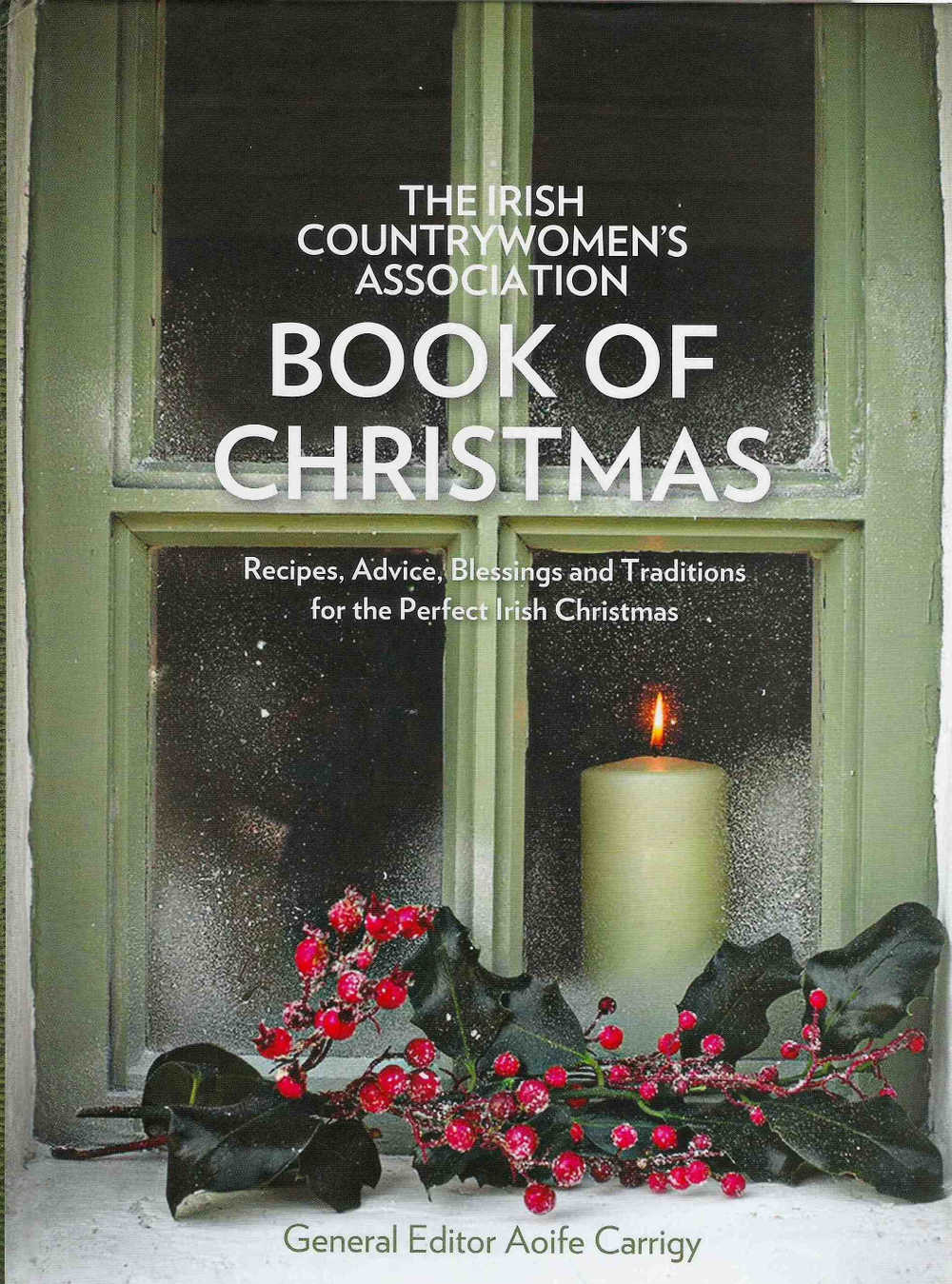

Aoife Carrigy introduces The ICA Book of Christmas - an evocative book that should be somewhere on every family’s gift list!
It was such a pleasure to edit The ICA Book of Christmas, the fourth such book published by Gill & MacMillan with the Irish Countrywomen’s Association in as many years. It felt like quite the privilege to sift through hundreds of submissions from women of all ages from all corners of the island, and gather together their collective homage to a uniquely Irish Christmas as it has been known and loved in their family homes over the decades. The resulting book is a collection not just of favourite festive recipes and crafts, traditions and memories but also of seasonal stories and poems, carols and songs.
To spend time with The ICA Book of Christmas is to gain an insight into an Ireland of yesterday, of today and of tomorrow – and to discover many surprises among the enduring traditions that we know and love so well.
I learnt so much through the vivid first-hand recollections of these women: of the annual ‘big shop’ to ‘bring home the Christmas’ and of the beloved Christmas Box, a gift from local grocers to thank customers for their loyalty through the year; and of the Wren’s Day traditions as played out in Dingle, Cavan and Roscommon, amongst so many other regional corners; and of the historical origins of the wonderful tradition of Nollaig na mBan, or Women’s Christmas.
And I came away from the book with second-hand memories of turkeys in the post to England and the thrill of the American parcel, and of Christmas bread once cooked over a turf in Cahirciveen and now enjoyed every year in Vancouver – all these little slices of other people’s lives that now have become part of my own sense of what an Irish Christmas is.
Here’s a little selection of some of my favourite pages from the book...
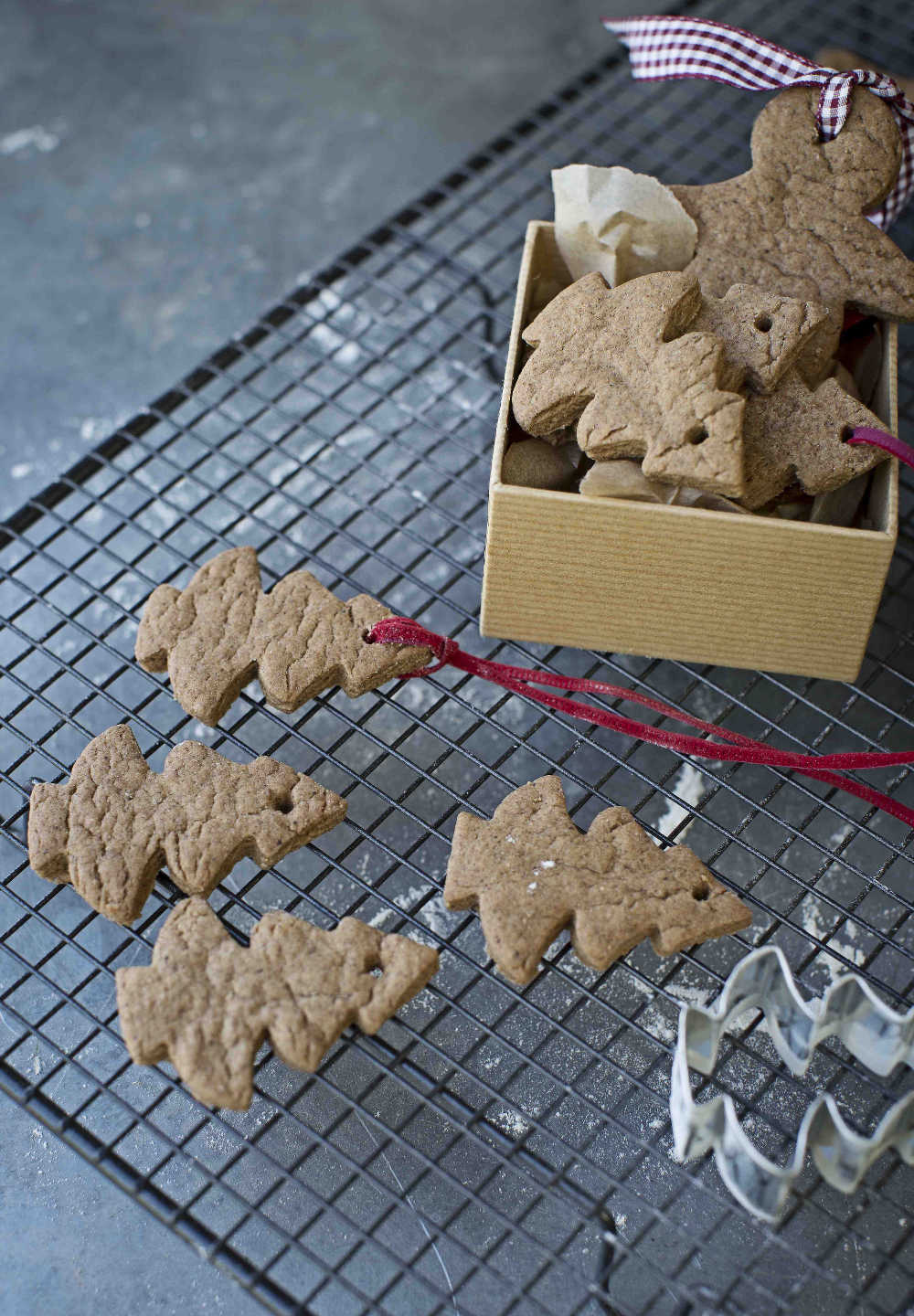 Speculoos Biscuit Tree Decorations
Speculoos Biscuit Tree Decorations
MIRIAM MURPHY, BLANCHARDSTOWN GUILD DUBLIN
These Dutch spiced shortbread biscuits are traditionally served on St Nicholas's feast day on 6 December. They also make lovely tree decorations, if they last that long. Children love making (and eating!) them and the baking aromas evoke everything that is warm and festive about Christmas.
Makes 10-15 biscuits
200g (7oz) plain flour
2 teaspoons ground cinnamon
1 teaspoon ground nutmeg
1 teaspoon ground cloves
1 teaspoon baking powder
½ teaspoon salt
150g (3½ oz) soft brown sugar
1 tablespoon milk
I50g (5½ oz) butter, at room temperature
To finish
10-15 pieces of ribbon, about 35cm (14in) long
You will also need
baking tray
baking parchment
Preheat oven to 180ºC/250ºF/Gas 4.
1. Line the baking tray with baking parchment.
2. Sieve the flour, spices, baking powder and salt into a bowl. Add the brown sugar, breaking up any lumps with your hands. Add the milk and butter to bring the mixture together into a dough. Transfer to the fridge to rest for 30 minutes.
3.Turn out the dough onto a lightly floured work surface and roll to about 5mm thickness. Cut out the biscuits with a cookie cutter of your choice, or into whatever shape you like. If you wish to hang them on the tree, use a piping tip nozzle with a 3-4 mm opening to cut out a hole at one end of each biscuit. These holes will be used to thread the ribbon through when the biscuits have been baked and cooled.
4. Place the biscuits on the lined baking tray with a gap of at least 2-3cm (1 in) between them. Bake in the preheated oven for 15-18 minutes or until golden brown and firm to the touch. Transfer to a wire rack to cool.
5. Thread the ribbons, if using, through the holes in the biscuits and tie the ends together before hanging on your Christmas tree.
6. These biscuits will keep well for up to a week in an airtight container.
ICA Tip
In the Netherlands a textured or patterned rolling pin is traditionally used to imprint patterns on the dough when it is rolled out.
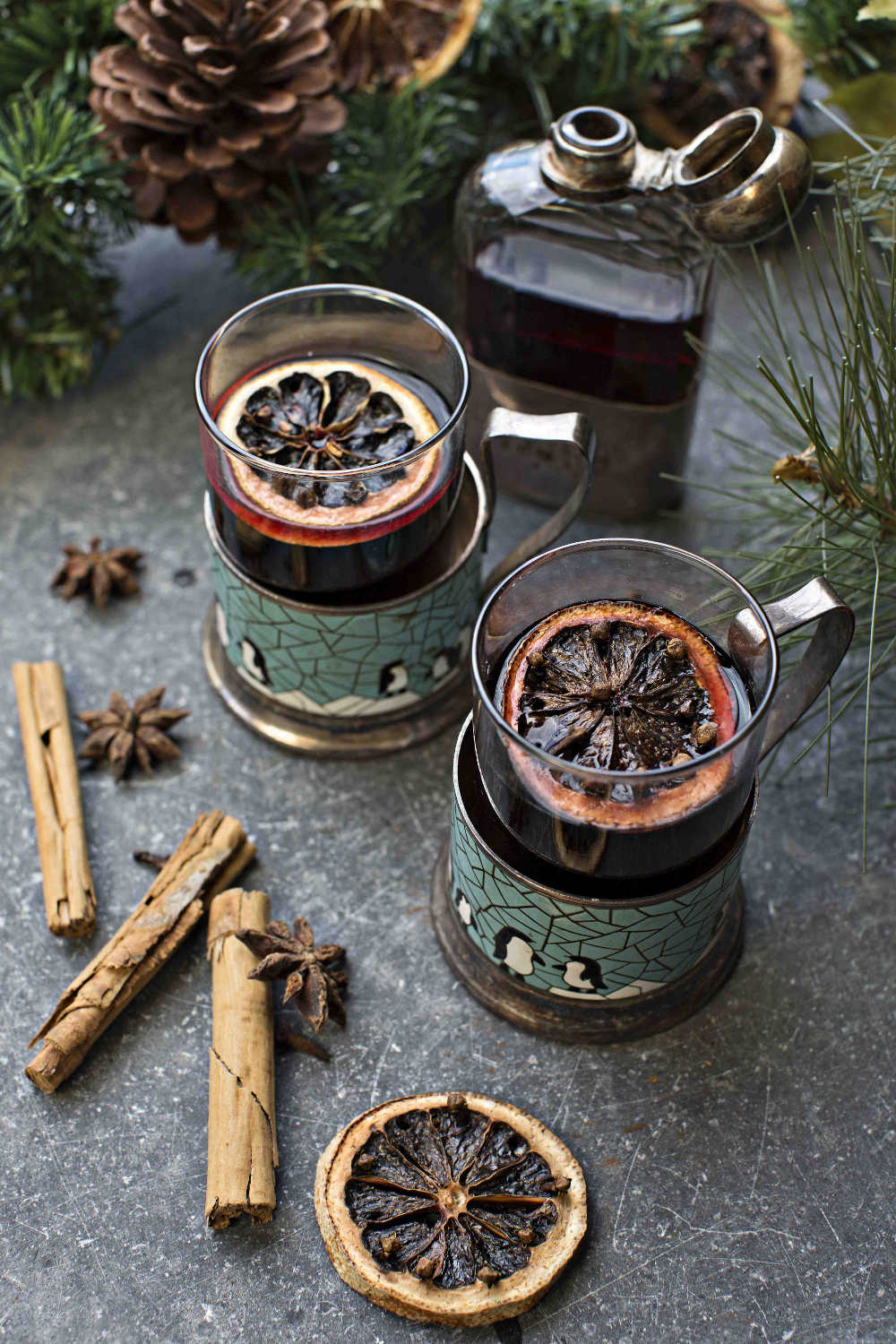 Mulled Wine
Mulled Wine
PATRICIA CAVANAGH, BALLINODE GUILD, MONAGHAN
Each year since the new millennium, on the Sunday before Christmas, my local walking club in Knockatallon on the Monaghan-Tyrone border meet up with the Togher Valley walkers. Our annual ‘mulled wine walk' takes us up to Knockmany Cairn, an ancient passage grave situated on a high hilltop. There we sing carols and share flasks of mulled wine with homemade mince pies and shortbread.
Serves 12-15
1 lemon, unwaxed if possible
1 large orange, or two mandarin oranges
4 dozen cloves, approx.
150g (6oz) brown sugar
12 sticks cinnamon
2-3 star anise (optional)
1 bottle red wine
½ bottle ruby port
Garnish
thin slices of orange and lemon
Sprinkling of grated nutmeg (optional)
1. Pare the lemon and the orange (or mandarins) thinly and remove the pith.
2. Stud the peeled fruit all over with cloves, and add to a large saucepan with 570ml (1 pint) water. Add the brown sugar, cinnamon and star anise, if using. If you are using unwaxed lemons or oranges, you can add the peel too.
3. Stir over low heat until the sugar has dissolved. Simmer for about an hour to give the flavours time to combine. (Even better, you can prepare this a day in advance to really give the flavours a chance to blend, and simply reheat it before the next step.)
4. Strain and discard the fruit and spices. Return the infused liquid to the saucepan and add the red wine and port. Reheat to bring almost to the boil.
5. Serve hot with orange and lemon slices and a sprinkling of nutmeg if desired
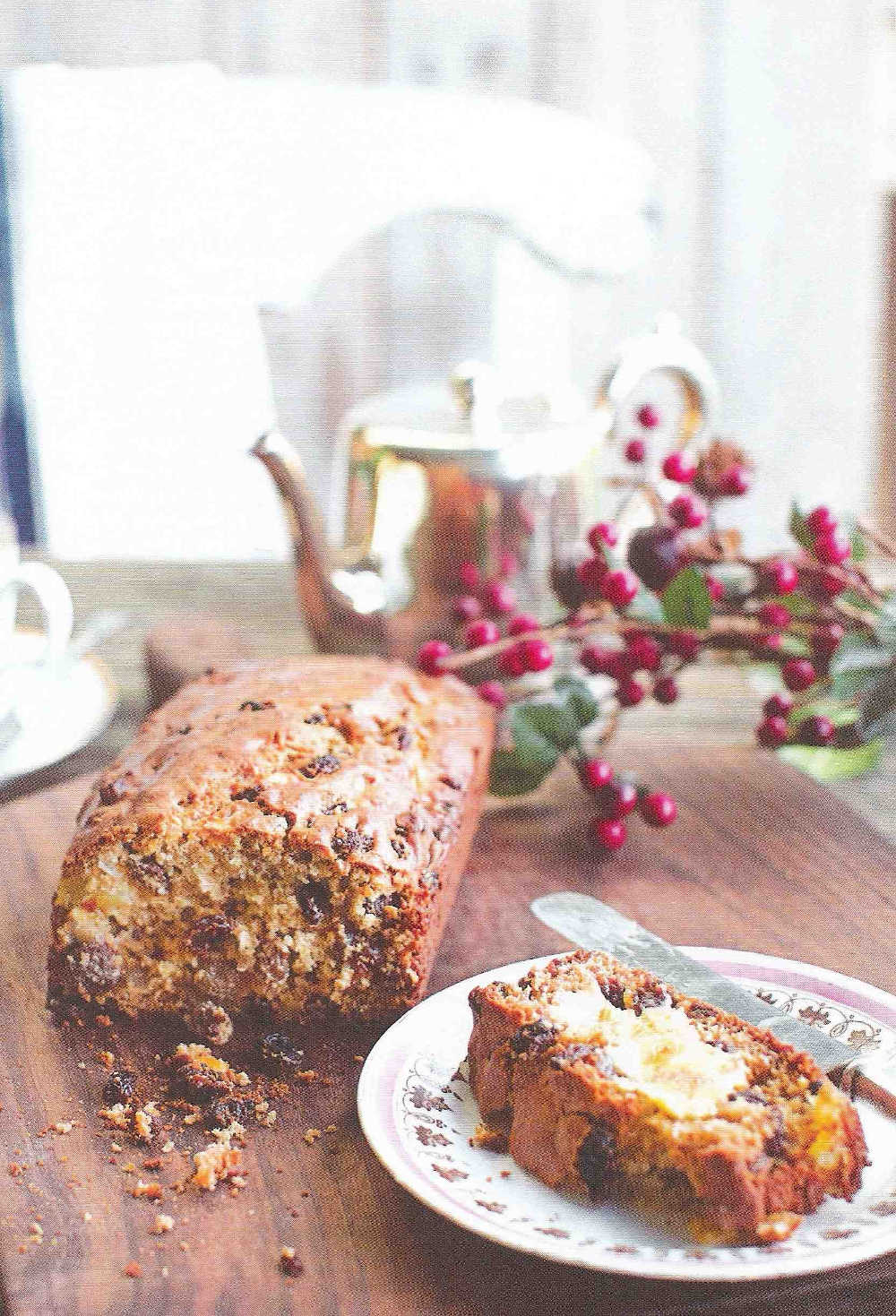 Nanny's Christmas Bread
Nanny's Christmas Bread
MARY CURLEY, LUCAN GUILD, DUBLIN
My grandmother Sheila O'Connor used to bake this bread in an oven hanging on a crook over an open turf fire with a hot sod of turf on top of the lid. My sons can’t get enough of 'Nanny's Bread’ and it's now being baked and enjoyed in Vancouver, far from that turf fire in Cahirciveen.
Makes 1 loaf
85g (3 oz) butter
675g (1½ lb) plain white flour
1 teaspoon bicarbonate of soda
1 teaspoon cream of tartar (e.g. Bextartar)
1½ teaspoons mixed spice
110g (4oz) Demerara sugar
1 fistful currants
1 fistful raisins (muscatels, if available)
1 fistful sultanas
110g (4oz) mixed peel
110g (4oz) chopped glace cherries
110g (4oz) flaked almonds
3 eggs
3 tablespoons treacle
500ml (l8floz) buttermilk, plus a little extra if needed
1. Preheat oven to 200°C/400°F/Gas 6.
2. In a large mixing bowl, rub the butter into the flour to make a crumb-like consistency. Stir in the remaining dry ingredients and the fruit, peel and almonds.
3. Beat the eggs in another bowl, add the treacle and mix well before adding the buttermilk. Add this to the dry ingredients and mix well, adding more buttermilk if needed to bring together into a dough. Turn out onto a floured surface and knead lightly for a few minutes.
4. Shape into a round and place on a floured baking sheet. Bake in a preheated oven for about 45 minutes or until the base sounds hollow when tapped. Turn out onto wire rack to cool fully before slicing.
THE TURKEY’S IN THE POST
“I grew up on a farm and have fond memories of Christmas preparations. My mother used to hang the Christmas puddings, wrapped in muslin cloths, from the ceiling in the kitchen from the time they were made until Christmas Day.
But I always knew Christmas was approaching when the poultry was being prepared for the post. Each year my mother sent a turkey to my uncle in London and a chicken to a cousin in Liverpool. The poultry were killed and plucked hut not drawn (cleaned out), and then wrapped up with head and feel intact. This task took up the entire kitchen table and both my parents' wrapping skills.
First the bird was wrapped in greaseproof paper, then several pages of the Wicklow People, then strong brown paper (probably saved over the year from meat purchases), and finally robust string. Plastic bags and Sellotape simply weren't available. The two parcels were then taken into town to the post office.
In the mid-1950s the cousin from Liverpool wrote thanking my parents for the chicken. She stated that she noticed chickens had become more plentiful to buy in her locality, and although they certainly wouldn't taste anything like the Irish chicken, she felt it wasn't necessary for any more chickens to be posted to her.
The turkey was still despatched to London until, in one New Year's letter, my uncle wrote to say that the turkey had arrived safely but had 'gone off slightly’! This was probably a combination of a mild December and the introduction of heating in the sorting office. All was not lost, however, and they had managed to salvage enough of the bird which, having been roasted extra well, provided a hearty dinner without any ill effects.
Needless to say, this all happened long before refrigeration, EU regulations and best before dates.”
- Heather Evans, Clonakenny Guild, Tipperary
The ICA Book of Christmas is published by Gill & Macmillan, price €22.99. Available from bookshops, and online from Easons (http://www.easons.com/buy/The-Irish-Countrywomens-Association)
--

Chairwoman of the Irish Food Writers’ Guild, Aoife Carrigy is a freelance food and wine writer and editor. She is a regular contributor to FOOD&WINE Magazine, The Irish Independent, The Herald and Cara Magazine, amongst others, and was co-author of The Ard Bia Cookbook and general editor of The ICA Cookbook, The ICA Book of Home and Family, The ICA Book of Tea & Company and, most recently, The ICA Book of Christmas. In 2015, she teamed up with Great Irish Beverages to launch the inaugural Dublin Wine Fest and Irish Cider & Food Day.
Georgina Campbell's Book Reviews
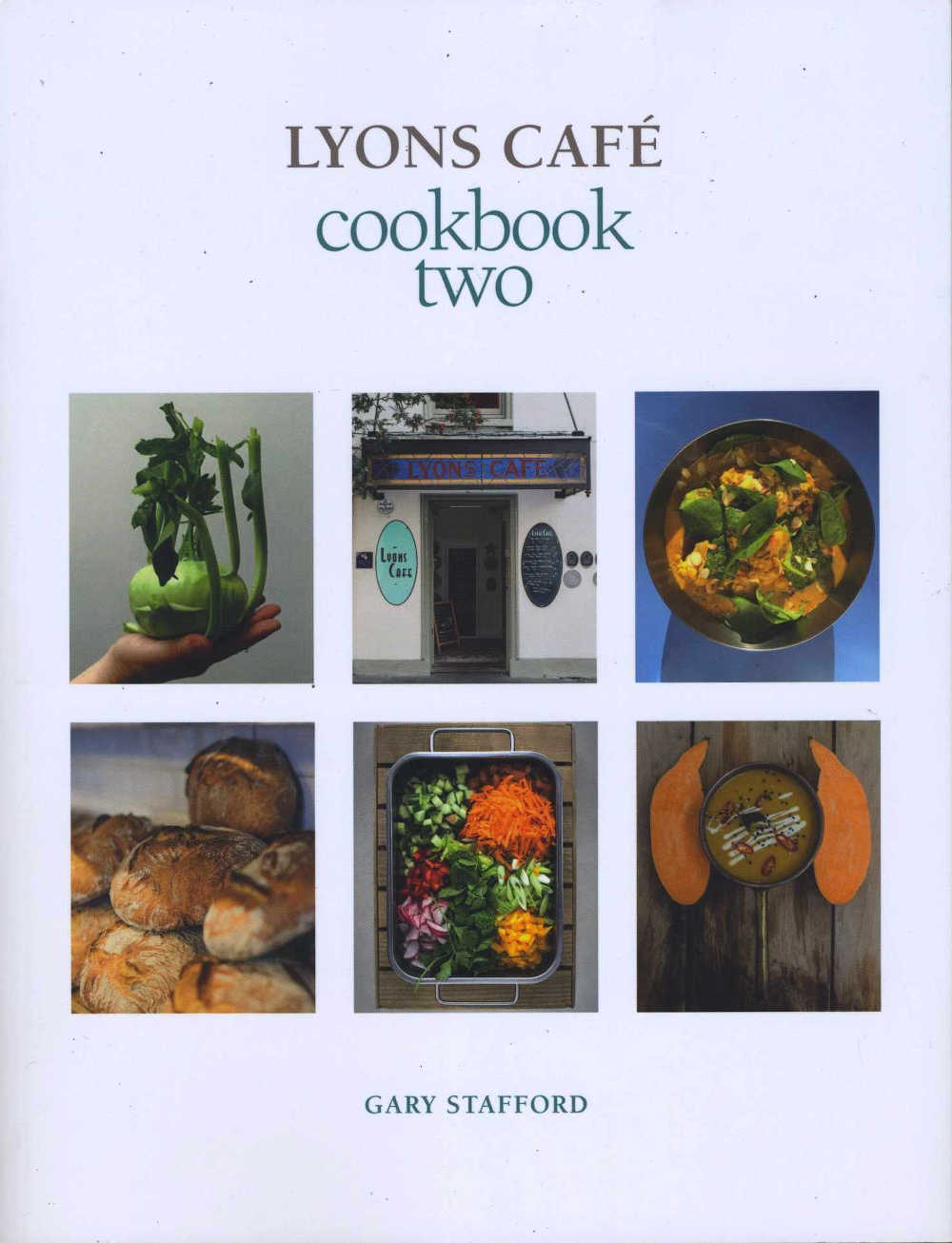
 It seems only the other day that Gary Stafford published his super book of recipes from the lovely Lyons Café in Sligo Town yet, not only has it already been reprinted, but Gary and the team haven’t been slacking in the meantime either as the follow up Lyons Café Cookbook Two made its appearance just before Christmas (€22 + 8.50 p&p online from here; also from bookshops in the Sligo area), and it is a great credit to them.
It seems only the other day that Gary Stafford published his super book of recipes from the lovely Lyons Café in Sligo Town yet, not only has it already been reprinted, but Gary and the team haven’t been slacking in the meantime either as the follow up Lyons Café Cookbook Two made its appearance just before Christmas (€22 + 8.50 p&p online from here; also from bookshops in the Sligo area), and it is a great credit to them.
Once again, Gary and his team have produced a handsome book that is as pleasing to look at and to handle as it is to read, or to cook from. As before, the contents are based on customer requests and the recipes will be very familiar to anyone lucky enough to have eaten at the café - or to have enjoyed any of the wide range of breads, cookies, cakes and desserts from The Bakeshop, which has opened since the first book was published.
The food at Lyons Café is imaginative and very, very tasty - but there are no gimmicks and, whether you’re making a basic stock, a seasonal soup, one of the great range of salads and sandwiches, a hearty main course such as the roast pork below, or something from the bakeshop, the recipes are very do-able (and well photographed).
Middle Eastern influences are strong, but the suppliers are very local and one of the things I like best about this book is the introductory pages that set everything into a meaningful context by detailing the local ingredients and suppliers that the Café depends on for its success, the people on the team, and the fascinating ‘potted history’ of Sligo and its roots as a market town.
I love this book and I’m sure that anyone who cares about good food will love it too.
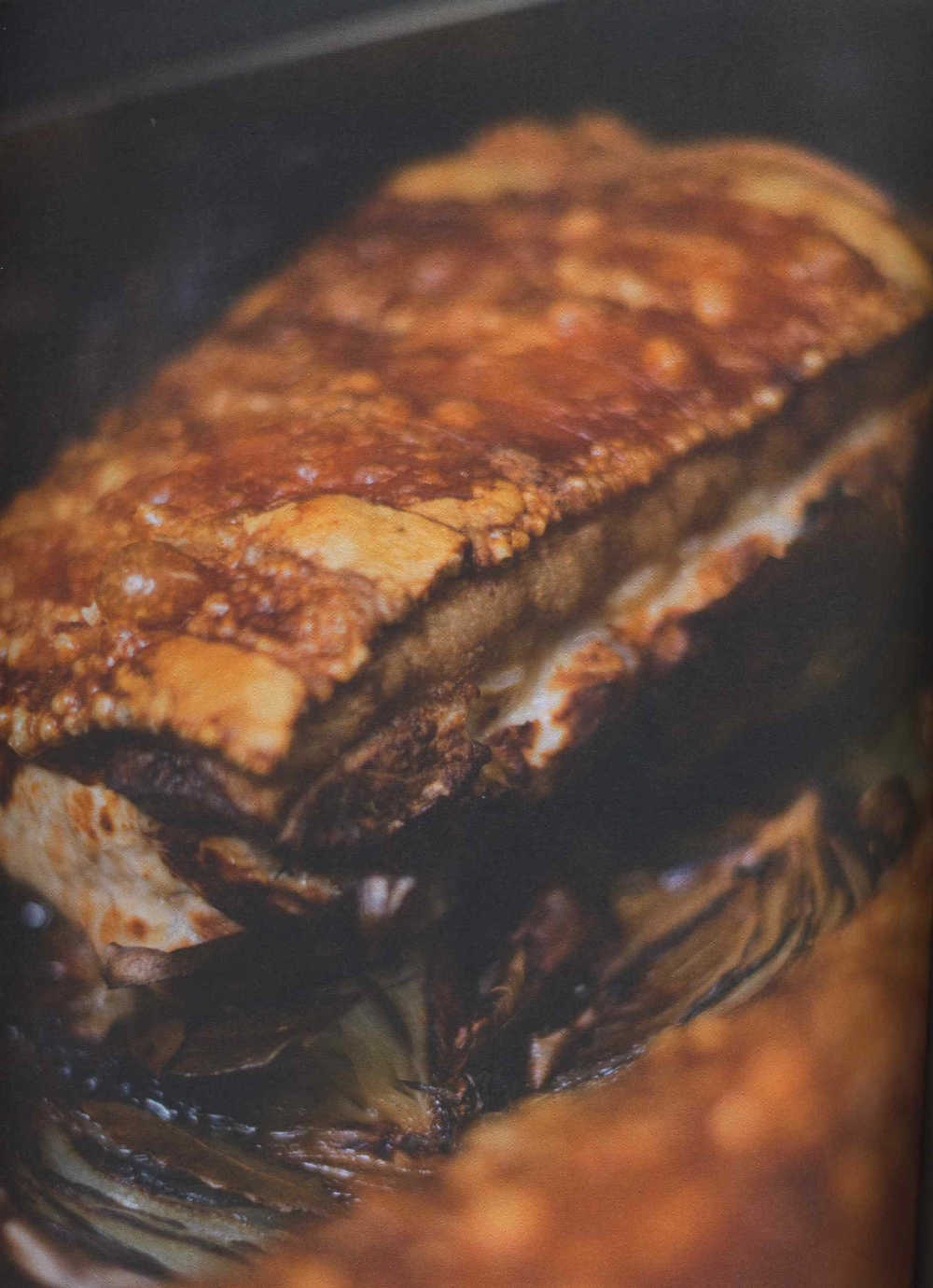 SAMPLE RECIPE: Roast Crackling Pork Loin
SAMPLE RECIPE: Roast Crackling Pork Loin
When it comes to crackling, the secret is in the preparation. Ask your butcher to prepare the joint by scoring the skin for you. Take time with pre-oven preparation and you will be rewarded with a fantastic meal.
Serve with our Crispy Roast Potatoes or Savoy Cabbage and Celeriac. Alternatively, good side dishes that also work well with this are our Spring Onion Mash or Dauphinoise Potatoes. (Recipes for all of the side dishes suggested above are given in the book, also the chicken stock in the ingredients list below).
2 kg loin of pork
1 tbsp sea salt
olive oil
1 carrot, peeled and roughly chopped
1 onion, peeled and roughly chopped
1 tbsp arrowroot (mixed with a little water)
250ml dry cider
250ml chicken stock
ground black pepper
Preheat oven to 240°C.
Prepare pork joint: using a sharp knife, score the skin into thin strips (your butcher can also do this for you).
Pat the skin dry as much as possible. Leave to air dry for 10-15 minutes. Sprinkle around 1 tablespoon of sea salt over the joint. Drizzle with a little olive oil. Rub the oil and salt really well into the scored skin, making sure it gets into the slits.
Place joint in a roasting tin on top of the roughly chopped carrots and onions. Place in the oven. After 30 minutes reduce the heat to 180°C. In total you want to ensure you cook for 25-30 minutes per 500g of meat.
Use a meat thermometer or metal skewer to test the meat. When juices run clear it is ready to be removed from oven. Take the joint out of the roasting tin and allow the pork to rest for at least 30 minutes.
To make the gravy: Discard the vegetables. Tilt the tin and spoon off fat leaving only the juices. Place the tin over medium heat, stir in the arrowroot mix, add cider and stock. Using a whisk, bring to a simmer whilst stirring. Season with salt and pepper.
Tip: The fat under the skin reacts with the salt, which makes the skin puff up and crisp. If you don't rub the salt in properly, the crackling will have that chewy texture.
XXXXXXXXXXXXX
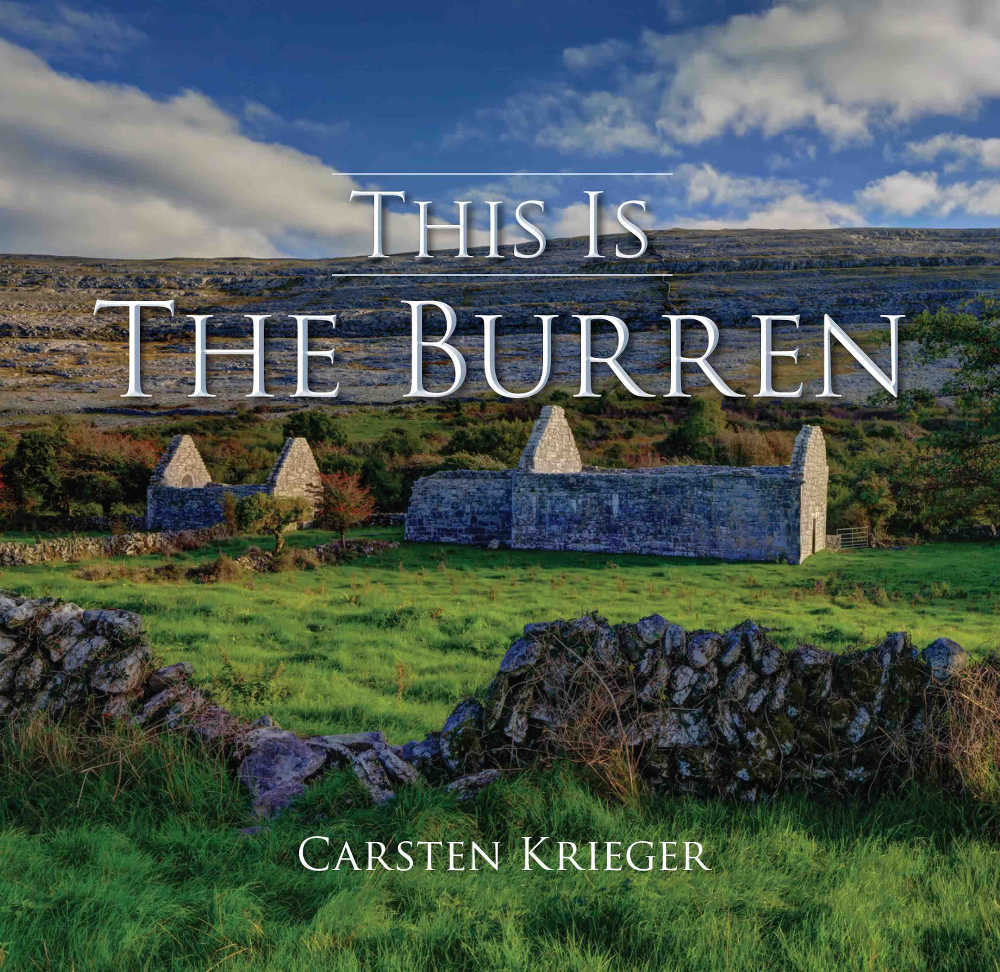 While it is not a food book This Is The Burren, by the acclaimed photographer Carsten Krieger (Collins Press, hardback €19.99), takes a holistic view of this intriguing place - and the Burren Ecotourism Network, which includes The Burren Food Trail, is given special mention in the Acknowledgments and by Carol Gleeson, Manager of the Burren and Cliffs of Moher Geopark, in her contribution to the Foreword.
While it is not a food book This Is The Burren, by the acclaimed photographer Carsten Krieger (Collins Press, hardback €19.99), takes a holistic view of this intriguing place - and the Burren Ecotourism Network, which includes The Burren Food Trail, is given special mention in the Acknowledgments and by Carol Gleeson, Manager of the Burren and Cliffs of Moher Geopark, in her contribution to the Foreword.
The importance of food production and tourism in the Burren, and its role in developing and protecting this unique landscape, is gaining both national and international recognition. While this book was in production, The Burren took the 2015 Restaurants Association of Ireland ‘Foodie Town’ title, as the place that ‘set the benchmark for food tourism in Ireland’, The Burren and Cliffs of Moher Geopark was awarded a new UNESCO designation, and The Burren Food Trail was named the Irish winner of the 2015 “European Destination of Excellence – Tourism and Local Gastronomy” (EDEN) award for ‘developing a tourism offering based on their local gastronomy that balances sustaining the local environment with the promotion of viable tourism’.
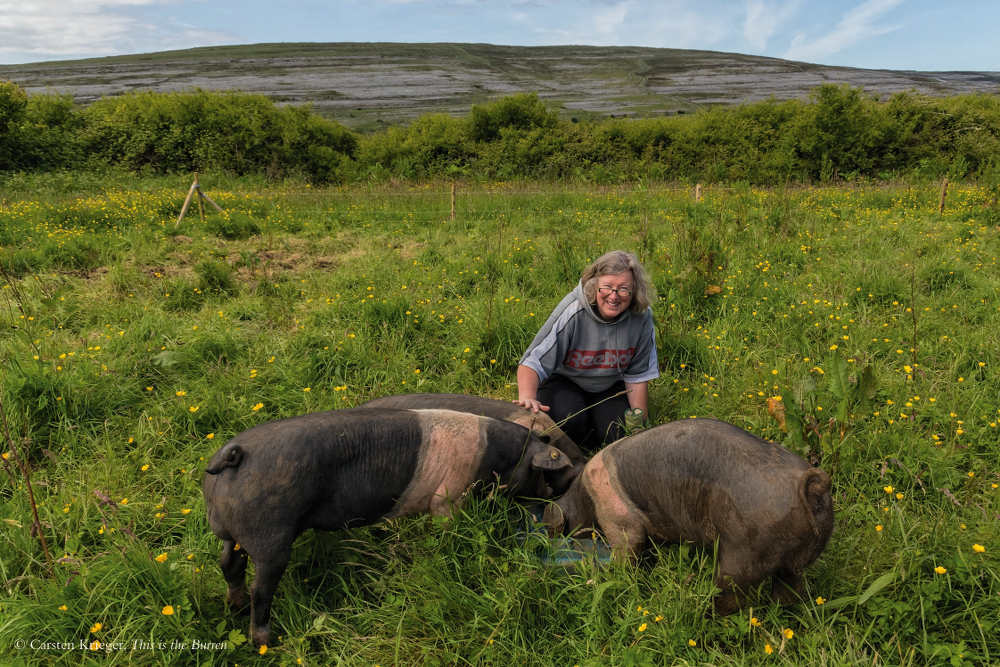 These great achievements reflect the vision, dedication and sheer hard work of the people involved in the Burren Food Trail, the Burren Ecotourism Network and the Burren and Cliffs of Moher Geopark, many of whom feature in this beautiful book, especially in the final chapter, dedicated to People and Places. Not all are involved with food, of course, and alongside larger than life food and drink characters like the Lisdoonvarna craft brewer and publican, Peter Curtin, and Eva Hegarty of Burren Free Range Pork (right), the roll call includes writers, historians, musicians (notably P. J. Curtis, the Kilnaboy native who is all three - author, historian and broadcaster - and whose evocative Foreword sets the poetic tone of the book), artists, gardeners, perfumiers (The Burren Perfumery is one of the area’s great success stories) and crafts people.
These great achievements reflect the vision, dedication and sheer hard work of the people involved in the Burren Food Trail, the Burren Ecotourism Network and the Burren and Cliffs of Moher Geopark, many of whom feature in this beautiful book, especially in the final chapter, dedicated to People and Places. Not all are involved with food, of course, and alongside larger than life food and drink characters like the Lisdoonvarna craft brewer and publican, Peter Curtin, and Eva Hegarty of Burren Free Range Pork (right), the roll call includes writers, historians, musicians (notably P. J. Curtis, the Kilnaboy native who is all three - author, historian and broadcaster - and whose evocative Foreword sets the poetic tone of the book), artists, gardeners, perfumiers (The Burren Perfumery is one of the area’s great success stories) and crafts people.
But Carsten Krieger is best known as a landscape photographer and his close relationship with it and the Burren’s history, heritage, flora and fauna is palpable in the stunning and sometimes haunting imagery. Carsten and his wife now live in County Clare, but perhaps it should come as no surprise that his own introduction to the Burren was the result of learning that it was the inspiration for J.R.R. Tolkien’s Middle Earth, as he captures that sense of other-worldliness uncannily well.
This Is The Burren is a beautifully produced yet compact volume, ideal for visitors who need to be practical about the weight of their luggage. But, for those who are not restricted by size or weight, it would be a treat to see those wonderful landscapes in a more sumptuous format - a limited edition coffee table book, perhaps?
XXXXXXXXXXX
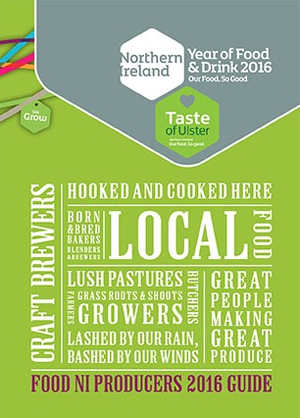 And so to something very different, and yet also special of its type. To coincide with the Northern Ireland’s Year of Food and Drink 2016, Food NI and Taste of Ulster recently launched a series of new Food and Drink guides.
And so to something very different, and yet also special of its type. To coincide with the Northern Ireland’s Year of Food and Drink 2016, Food NI and Taste of Ulster recently launched a series of new Food and Drink guides.
By promoting Food NI members and giving details of what they do, where to find them and how to get in contact with them, these compact little Food Producer and Taste of Ulster guides give a great overview of what’s going on in the development of food production and hospitality in Northern Ireland.
And, this year, Food NI has created an additional guide, the Food NI Drinks Guide 2016 with details of both established drinks producers and the new wave of craft brewers, distillers and more. In addition, they are currently working on a street food guide - whoever would dreamt, even a few years ago, that all this was possible.
The guides are available free from Tourist Information Centres, and also distributed to journalists, the Guild of Food writers both UK & Ireland, all ports and airports in Northern Ireland, Connolly Station Dublin, places of visitor interest, serviced and non serviced accommodation and at all Food NI events.
Georgina Campbell's Book Review
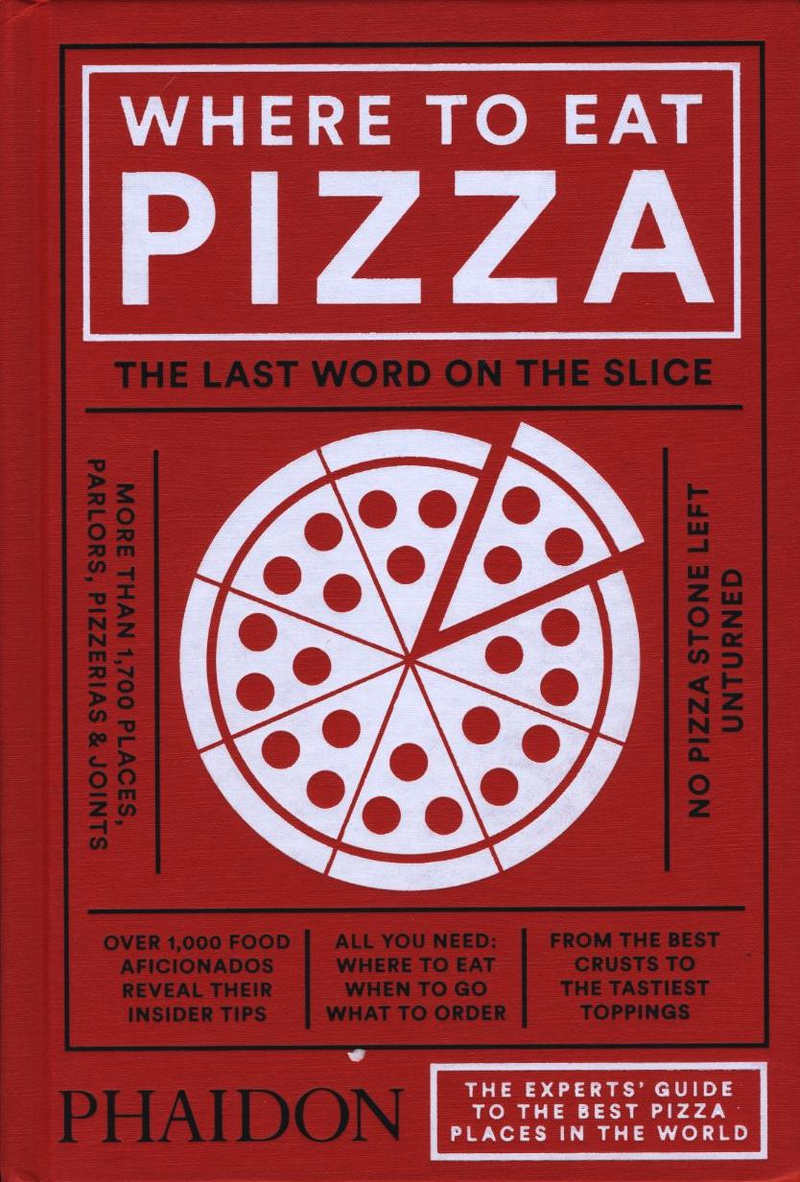
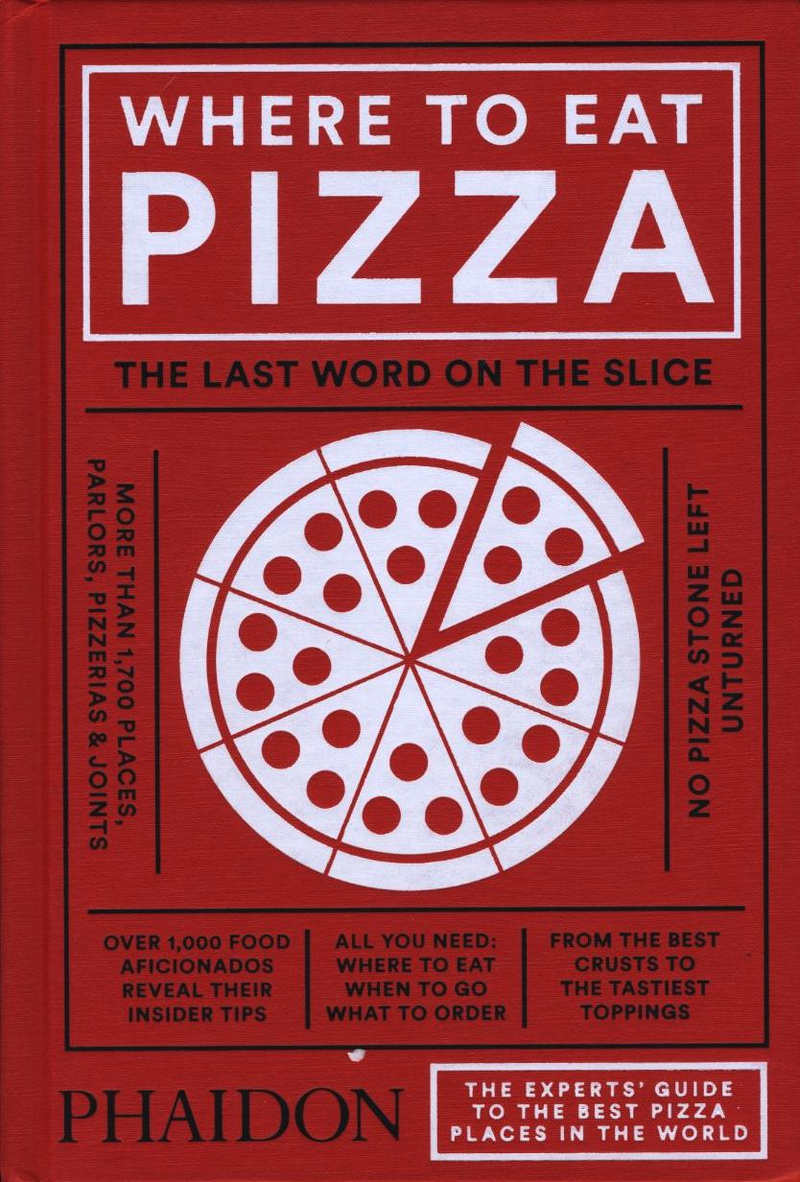 Where to Eat Pizza, by Daniel Young (Phaidon, hardback; 14 b/w illustrations; 576pp; £16.95/€24.95)
Where to Eat Pizza, by Daniel Young (Phaidon, hardback; 14 b/w illustrations; 576pp; £16.95/€24.95)
Subtitled variously ‘The Last Word on The Slice’ and ‘The Experts’ Guide to the Best Pizza Places in the World’, this cheerful, chunky hardback is certainly not a pocket guide but it weighs much less than its 2-inch spine would lead you to expect - so no fancy art paper or atmospheric food shots here, which is just as it should be.
But why a world guide to pizza at all, you may ask. Well, the author, pop-up pioneer Daniel Young - the London-based food critic behind the cleverly named youngandfoodish.com and author of the hugely successful international restaurant guide, Where Chefs Eat - is mad about pizza (among other things) and he has no shortage of evidence to suggest that plenty of other people are too, Michelin-starred chefs, food writers, critics, bloggers, bakers and pizzaioli among them.
And no, he didn’t eat in all of the 1,705 recommended pizzerias in 48 countries himself, he used local knowledge to do the legwork for him. Calling on the knowledge of 121 regional experts, who then chose 956 ‘pizza informants’ in their regions, he put together the first ever ‘comprehensive insider's guide to the best pizza places around the world’.
Organised by continent and then by country, region or city, the recommendations reflect the diversity of the pizzas themselves (‘thick and thin, round and square, pan-baked and stone-baked, wholesome and trashy’) and the pizzarias, which range from’ old-school family establishments, restaurants devoted to craft pizza, food trucks and holes-in-the-wall’.
The content is mainly made up of brief summary style entries - sometimes just a sentence, each with a by-line. But there are also some of Daniel Young’s own pieces scattered through the text, on topics of burning interest to pizza obsessives - custom-crafted brick ovens, repurposed Citroen trucks, house-made mozzarella, pizza boxes, and pizza folding etc - and some of more general interest (a piece about Pizza Tours, for example) and the book ends somewhat wistfully with the story the oldest pizzeria in Sao Paulo: “To eat at Casteloes is to visit a Sao Paulo that now lives in black-and-white photos…”
Like anyone who gets their hands on a guide that might have something of local interest, I hunted out the Irish section, where there are just eight entries (and, as far as I could see, none at all in Northern Ireland). Ireland’s ‘pizza informants’ - the regional expert, restaurant critic Tom Doorley of the Irish Daily Mail, assisted by Gillian Nelis (Sunday Business Post), Ailbhe Malone (BuzzFeed UK) and Niall Harbison (Lovin Dublin) - picked a good cross section including Osteria Lucio on Grand Canal Quay and Camp de’ Fiori in Bray - but it does seem a tiny number, and almost all in or near Dublin (the exception is the excellent La Cucina in Limerick).
Maybe I missed something in the small print of the criteria for inclusion (or perhaps it was simply that space ran out) but a few missing gems outside Dublin that come to mind right away include Luna, in Dromahair, Co Leitrim (run by Bernadette O’Shea, author of Pizza Defined, who introduced gourmet pizzas showcasing local artisan ingredients in the 1990s); The Ballymore Inn at Ballymore Eustace, Co Kildare, where Georgina O’Sullivan has been doing the same with style for decades; The Twelve in Barna, Co Galway, where Pizza Dozzina is a destination in itself; Rathmullan House, Co Donegal, where affianados flock to The Tap Room for Scarpello & Co’s stone baked pizzas to wash down with Kinnegar beers….and there are plenty more.
No doubt readers in all 48 countries are poring over the entries and wondering where some of their local favourites are - that goes with the territory in ‘comprehensive’ guides. And real pizza-heads may also be wondering where this chunky tome will be when they need it on tour (not in the handbag, that’s for sure), but the solution for that is simple - happily I noticed a note on the inside back cover, stating that it’s available as an app. Problem solved - buon appetito!
Georgina Campbell's Book Review
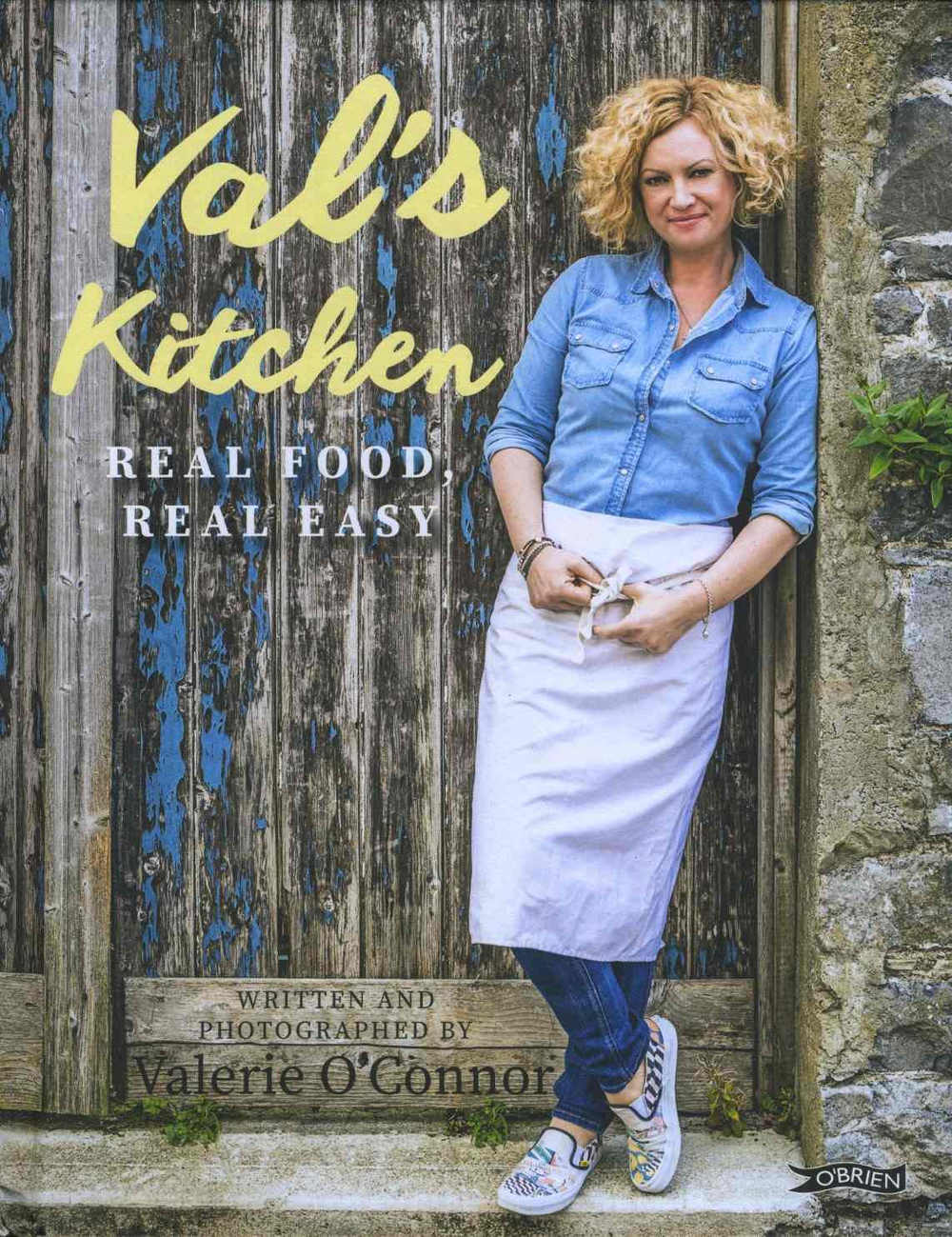
 Val's Kitchen Real Food, Real Easy by Valerie O'Connor (Brien Press; hardback, 246x189mm, 160pp; photography by the author; €19.99/£14.99)
Val's Kitchen Real Food, Real Easy by Valerie O'Connor (Brien Press; hardback, 246x189mm, 160pp; photography by the author; €19.99/£14.99)
Already well known to followers of the popular blog that she has written for over a decade (www.valskitchen.com), Valerie O’Connor’s books are reaching a ready audience. Hot on the heels of the successful ‘Bread on the Table’ (also published by O’Brien Press), the Limerick-based cook, blogger, food writer, organic horticulturist, photographer and mother of two teenagers has followed up with a topic that she seems especially comfortable with: “A family cookbook for today”.
Her approach to cooking for a family is sensibly straightforward and wholesome - if you want your family to be well nourished you’re going to spend a good bit of time in the kitchen anyway, so why not make it as easy and enjoyable as possible.
There is a wide range of dishes here for everyday and special days, with a recognition of traditional values. As a nation we’ve been a bit slow in seeing the sense of the old ways, but now that the horror of obesity and ill health that has followed the widespread of adoption of diets based on processed food is understood, the movement back to natural foods and simple cooking can’t come soon enough.
Val teaches traditional cooking skills and, like a lot of us today, she recognises that our parents and grandparents got it right with their simple dishes based on inexpensive, easily available ingredients - cheaper cuts of meat for nourishing slow-cooked dishes, plenty of vegetables, grains like barley and oats, porridge smothered in cream and honey, potatoes doused with butter…
While the delicious sourdough breads that Valerie advocates may be a recent addition to the Irish baking tradition, those ‘glasses of pro-biotic buttermilk’ were the health drink of every Irish family long before the term was coined, and much of the fermenting that is currently so trendy was an ordinary part of everyday life before refrigeration.
There’s a whole chapter on fermented food, as well as a wide range of more familiar throwbacks (Braised Shin Beef with Bone Marrow and Vegetables, for example, and proper stocks), the whole collection livened up by dishes inspired by Val’s travels.
Organic horticulturist that she is, Val has included a chapter on growing your own food (plus a bit on foraging) and this is the perfect time of year to get started too. All round there is plenty of guidance in Val’s Kitchen to get curious cooks moving in the right direction - and, importantly, it should appeal to a young audience.
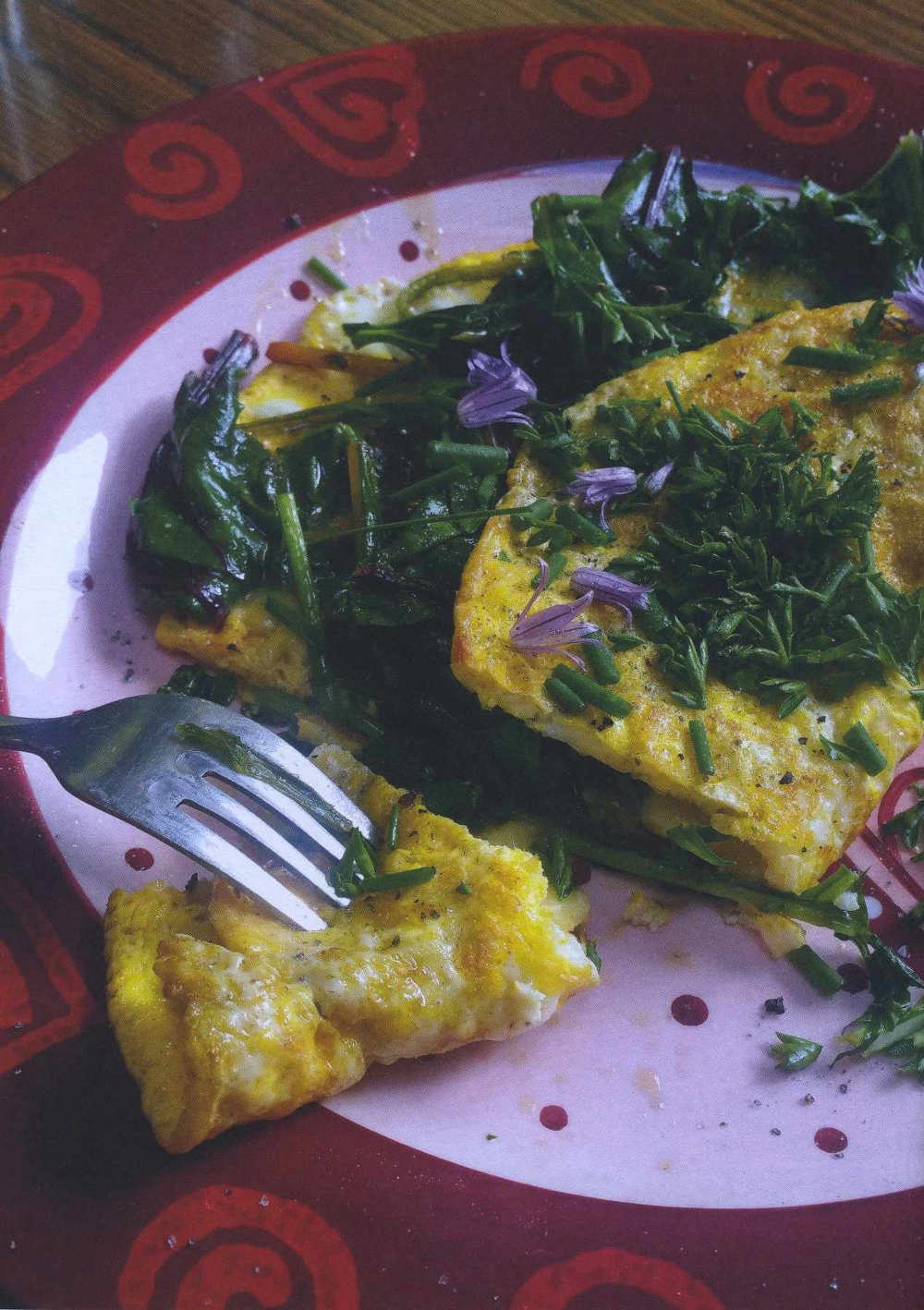 SAMPLE RECIPE: The Veg-Out Omelette
SAMPLE RECIPE: The Veg-Out Omelette
“One of my favourite breakfasts came from the Wild Onion Café in Limerick where the feisty Ruth would hold court every Saturday policing customers who had the audacity to walk in and expect a table in their tiny, bustling diner. Ruth stood, notebook in hand, marshalling the hungry crowd who stood in line waiting for a table. Their breakfasts were the stuff of legend; this was my favourite so I'm attempting to re-create it in homage to Bob and Ruth who have now moved their business to a small bakery on the Ennis Road.”
[Sadly Ruth died in March 2016, following a short illness, and Bob has closed the bakery - so Valerie’s homage is a poignant memorial to a great woman and a great Limerick institution. GC.]
Serves 1
Ingredients
A mixture of broccoli, peppers, mushrooms and 'onions or anything that will griddle well, about a handful of each
Cheddar cheese, to garnish
A few slices of a medium chilli
3 fresh eggs
Butter, for frying the omelette
Olive oil, for cooking the veg
Method
Heat up a large griddle pan and slice the veg into even thicknesses so they will all cook in a similar time. Drizzle on a little olive oil and throw on the veg. Let them get a bit burnt at the edges, then turn them over; this gives a great flavour. They should be done in about 6-8 minutes. Remove to a warm plate.
Meanwhile make your omelette. You will need a decent sized pan here, cast iron pan or ceramic, ideally. Heat the pan and melt a good sized knob of butter to evenly coat the bottom. Quickly whisk your eggs in a bowl with a little salt and pepper and pour the mixture onto the frying pan.
Let this bubble up and don't disturb it. When it starts to look cooked around the edges carefully slide the veggies onto one side of the eggs. Leave them to settle, then pop on your chilli and cheese and let it melt. Then flip the eggy side over onto the veg and slide the omelette out of the pan onto a warm plate.
Variation: you can just as easily fill an omelette with some steamed kale and top it with a few slices of fried chorizo, yummy and no need for cheese.
Georgina Campbell's Book Review
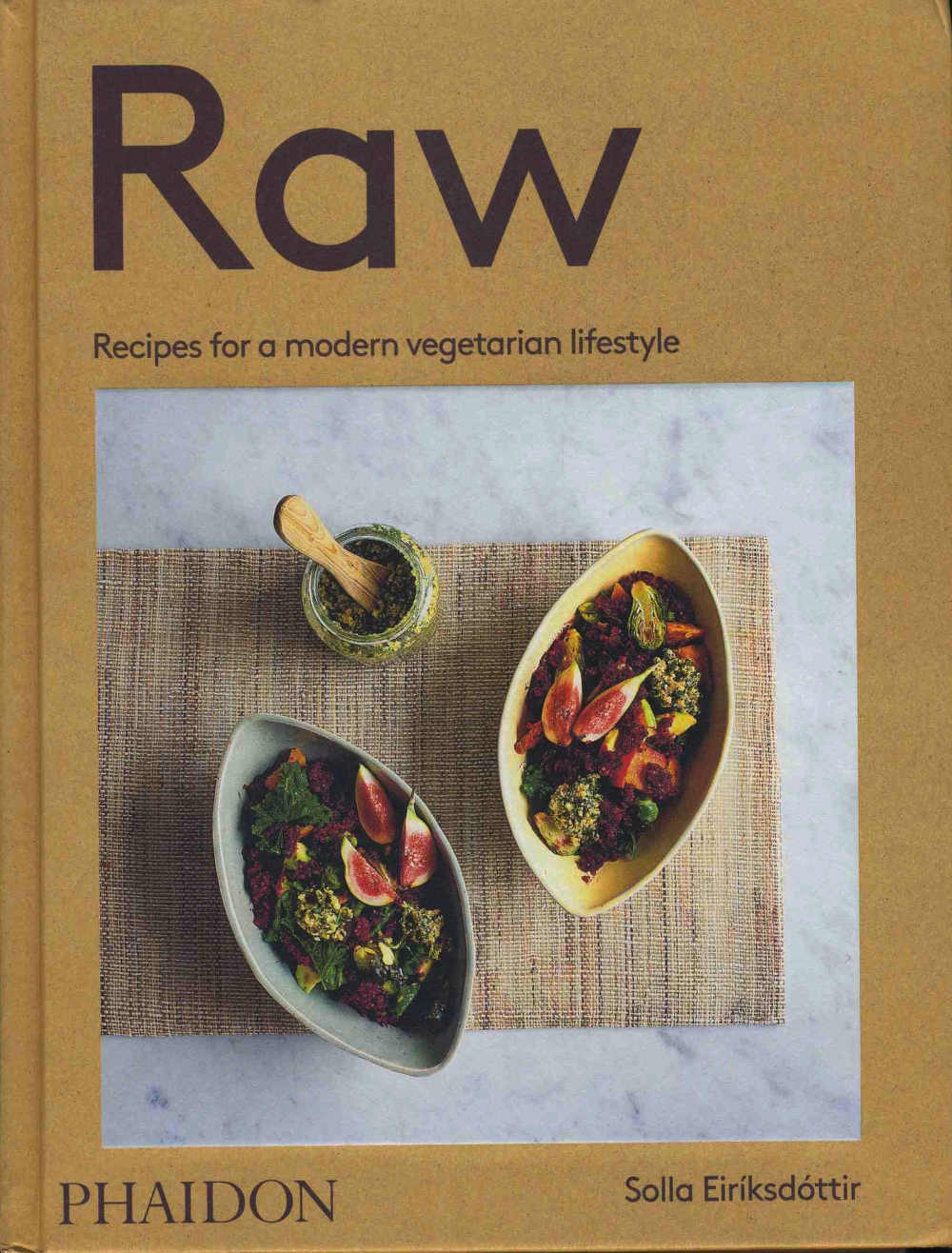

Raw: Recipes For a Modern Vegetarian Lifestyle by Solla Eiríksdóttir Published by Phaidon; hardback, 240 pp, 100 specially commissioned photographs; £24.95/€34.95.
Like Ireland, Iceland is a relative newcomer to the concept of food tourism, but they are making up for lost time - their food, culture and landscape is currently touching a special chord and, very unusually, a (possible) visit to Iceland was flagged to reviewers on the publication of this book.
But you don’t have to be one of the lucky few invited on a press trip to experience the unique food culture of this special country; ‘Eat in Iceland - Scenic Food Tours in Iceland’ (www.eatiniceland.com) organises ‘slow travel’ trips on which visitors can sample the best that Iceland has to offer, and meet some of its stars of New Nordic cuisine.
Among them may well be the author of this book, Solla Eiriksdóttir. One of Iceland’s most famous chefs, she runs five restaurants, an organic food market, her own food brand, and is regularly on TV - and she has been a proponent of the raw-food movement since the early 1980s. So, however timely this, her first book in English, may be, she is no fashion-led johnny come lately.
It’s a lovely book, quite spare and disciplined and as much of interest for its portrayal of Iceland - as seen through the eyes of a family committed to an organic and eco-friendly lifestyle - as for the food and recipe content. Wonderful photography conveys the grandeur of the landscape, the agriculture, the seasons (hugely important in a country where day length varies from just four to 21 hours), and the elegant simplicity of Solla’s plant-based cuisine. The seasonal structure of the book allows for important seasonal activities, such as the seed sprouting given below, to be included alongside the recipes
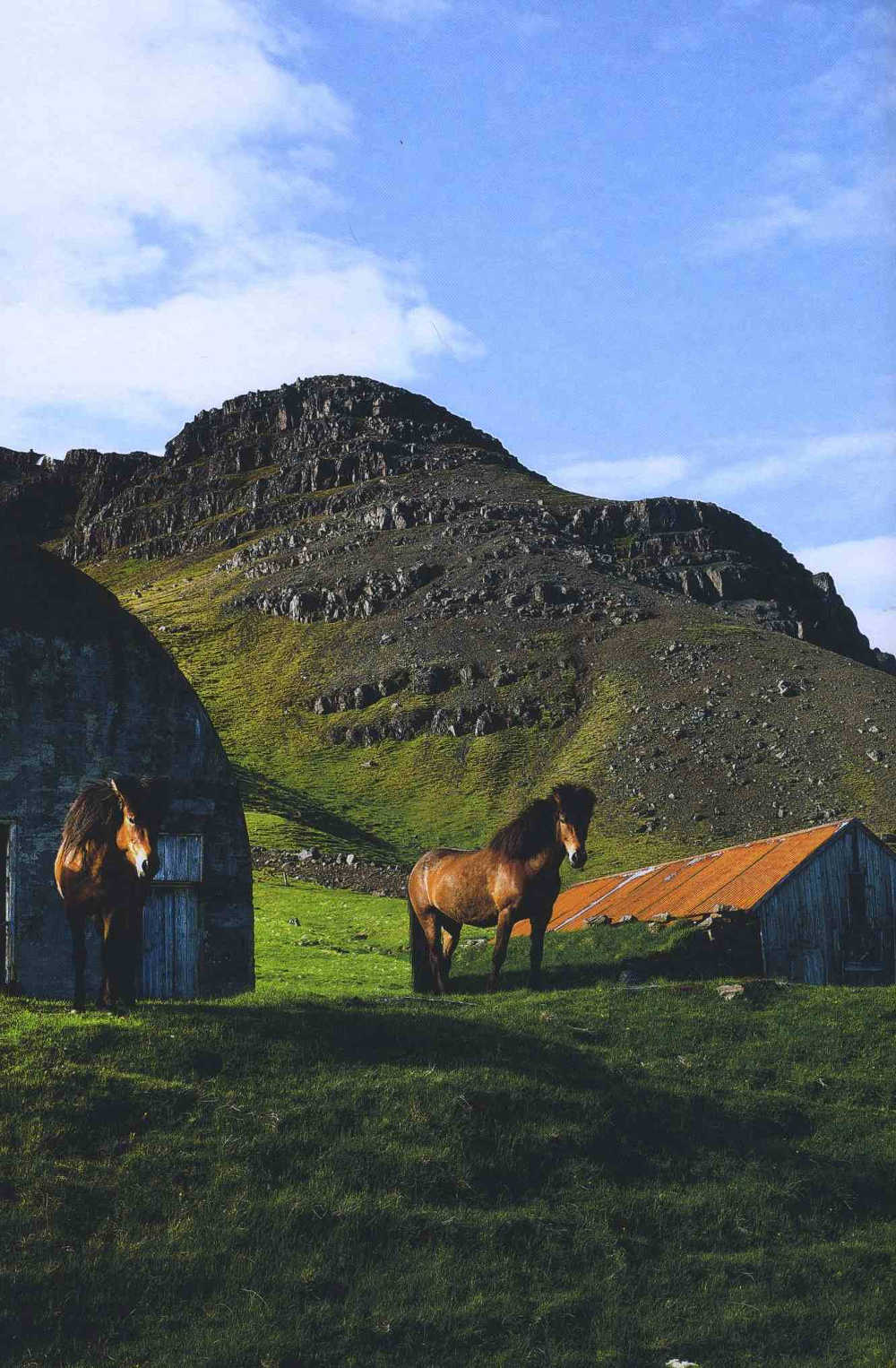
The trend for ‘clean’ and plant-based raw eating goes with the reasonable assumption that this is a healthy lifestyle choice, and Solla Eiríksdóttir certainly makes a strong case for it. On the other hand, there is something so comforting and relaxing about hot food that one can’t help wondering if it is wise to ignore it.
I noticed an interesting article in the Daily Telegraph magazine, Stella, recently, in which actress Sadie Frost goes to an alpine medispa, VivaMayr Altaussee for a ‘detox holiday’ and discovers, to her great surprise, that she’s been eating ‘too many vegetables, juices, salads and raw foods’, while ‘cooked food…is much easier to digest’.
However, Solla wrote this book with her daughter, Hildur, who studied nutritional science and shares her mother’s approach to health and wellbeing. It is an interesting read, the philosophy is compelling and, while the proportion of raw food recipes is high, many are cooked, but at extremely low temperatures, allowing the vegetables, grains and pulses to retain their maximum nutrients.
Solla’s own diet is at least fifty percent raw plant food but, even if that is not for you, there are elements that will please the most middle of the road eater - and the current popularity of vegetarian and vegan diets will make it a go-to book for a huge number of people, certainly far more than would have been the case just a few years ago.
All of the easy to follow recipes are vegetarian and each is marked with a symbol indicating whether it is suitable for a dairy-free, gluten-free, nut-free, raw, or vegan diet. Some of the ingredients may not yet be on your regular shopping list but many of the recipes, such as the morning smoothies and shots, will be familiar to most readers and, alongside the fermented recipes that are quite rightly causing such a stir at the moment and other obviously healthy dishes, there are plenty with mainstream appeal such as a versatile seed bread, soups, homemade butter and some very tempting treats including a seriously luscious layered chocolate cake.
And, among the sometimes unlikely seasonal activities, there’s even a recipe for making your own adzuki bean face mask.
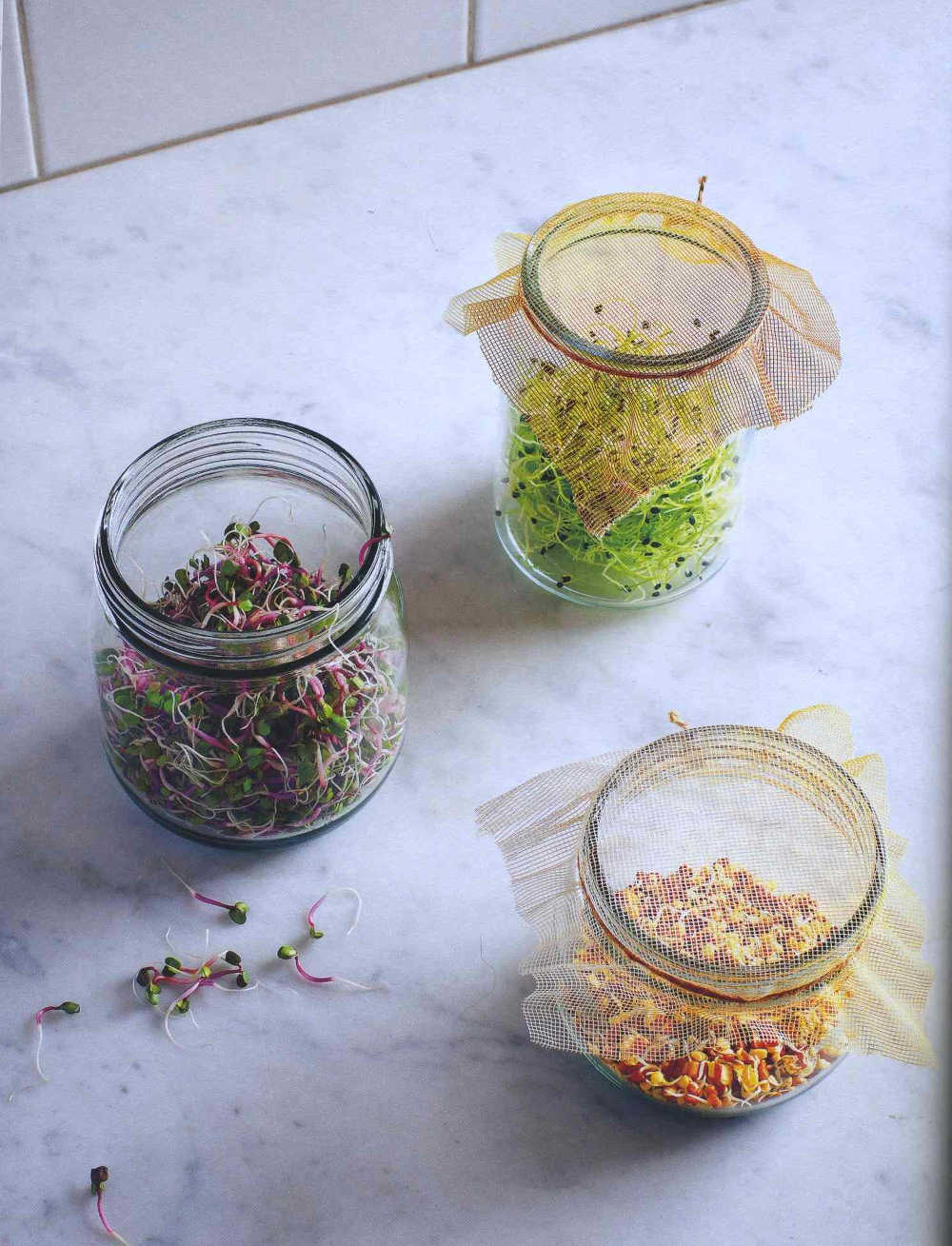 SAMPLE from Spring Recipes and Activities: Sprouting
SAMPLE from Spring Recipes and Activities: Sprouting
Sprouts are a beautiful reminder of how life wakes from hibernation in the spring. Homegrown sprouts are easy and fun to prepare.
1. Rinse the seeds, grains, or beans of your choice in a strainer (sieve) and then discard any that do not look healthy.
2. Put the seeds, grains, or beans into a sterilised glass jar and add water. The ratio of seeds to water should be 1:4. Instead of a lid, cover the jar with a piece of mesh (from inorganic fabric) and secure with a rubber band. Let sit overnight.
3.The next day, rinse the seeds, grains, or beans. Do this by turning the jar upside down and letting the water drip out, then fill it up with fresh cold water and let drip upside down again.
4. Next, put the jar on a drying rack, facing upside down, for an hour to drain the seeds. Let the jar sit for 3-6 days on the rack, rinsing twice a day with water as described above. For the first 2 days cover the jars with a cloth to keep the light out, then for the last few days, let the sprouts have light so that the leaves can produce chlorophyll.
5. When the sprouts are ready, put them into a bowl filled with water; after a while the husks should float to the top and can be removed easily.
6. Dry the sprouts with paper towels or a clean dish cloth, then put them into an airtight container and store in the refrigerator.
7. The sprouts will keep for up to a week if you wash and rinse them every 3 days and let them dry before storing again. A good rule is to smell the sprouts to check if they are okay to eat. Sprouts should smell fresh, not mouldy.
Georgina Campbell's Book Review

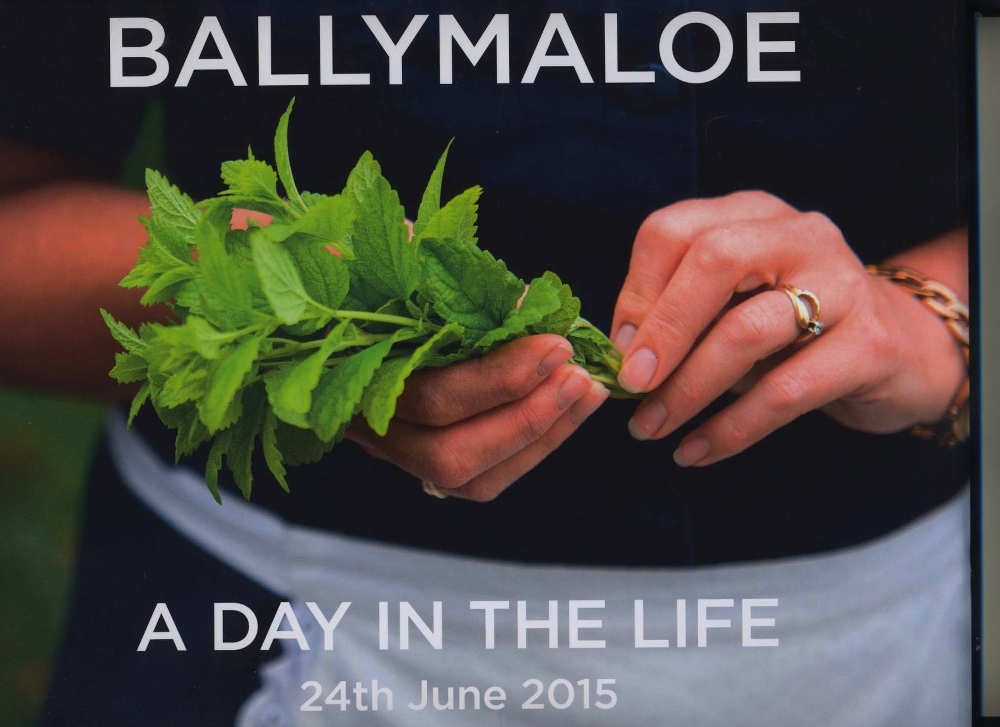 Ballymaloe - A Day in the Life, 24th June 2015, by Daphne Spillane; photography by Joleen Cronin and Leila Aldous (Trijar Publishing, hardback, 96pp; €25)
Ballymaloe - A Day in the Life, 24th June 2015, by Daphne Spillane; photography by Joleen Cronin and Leila Aldous (Trijar Publishing, hardback, 96pp; €25)
The idea of making a photographic record of one working day at Ireland’s most famous country house probably seemed simple to former Ballymaloe House staff member, Daphne Spillane (nee Beamish), and it was a long-held ambition - but putting it into action, after she came back to work at Ballymaloe again in 2015, must have been like mobilising an army.
Not that the reader will be conscious of the work involved, as the orderly progression through the day is seamless - and, although they were in the lap of the gods weather-wise once the date had been set, it turned out to be fine so the house, gardens and farm are looking their magnificent high summer best.
Daphne’s main intention was to acknowledge the loyalty, dedication and longterm service of the staff - many of whom have worked at Ballymaloe for 40 or 50 years - and, together with photographers Joleen Cronin and Leila Aldous, she does that brilliantly. And by doing so, of course she also pays tribute to the Allen family, especially Myrtle Allen, “a woman of great foresight”.
What comes across on every page of this delightful book is a tremendous sense of an organically developing community working happily together. As Daphne points out, “The Allen family, as employers, have embraced every member of staff, considering each as an extended family member, always there in support through good times and offering a caring hand when most needed.”
So this is the community that we are invited to join, from 6.30am on a typical working day.
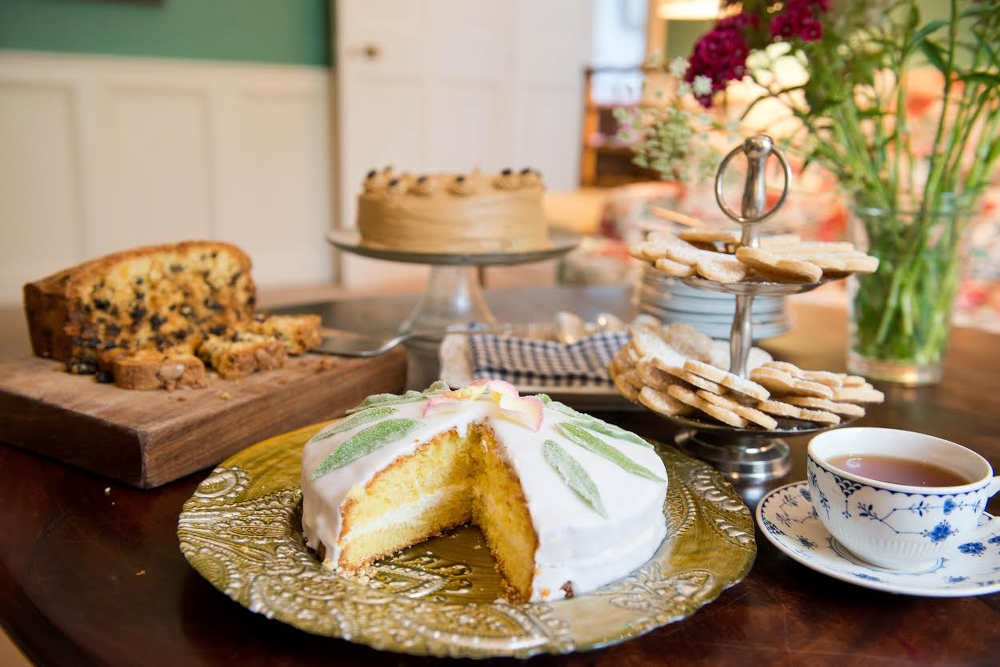
The camera follows staff and family members through the various tasks and highlights that punctuate the day: breakfast preparation, housekeeping, children helping to feed pigs and chickens, staff meal times, working on the wine list and menus, tending the gardens and harvesting flowers and produce, preparing for lunch and afternoon tea, work at the shop and café, dinner preparations, winding down for the night...
There is a natural ebb and flow to the activities of the day, and the picture painted is of a very happy ship. So many vivid portraits are painted - a double page group shot gives a sense of the scale (Ballymaloe currently employs about 70 people, and the family is constantly growing) and many of the photos capture the vital contribution that each individual makes.
This is not a book commissioned by an international publisher, but a labour of love created by a local team - including the design, production and printing, which were all done in Cork - and, in turn, everyone who loves Ballymaloe will want to have a copy.
Georgina Campbell's Book Reviews
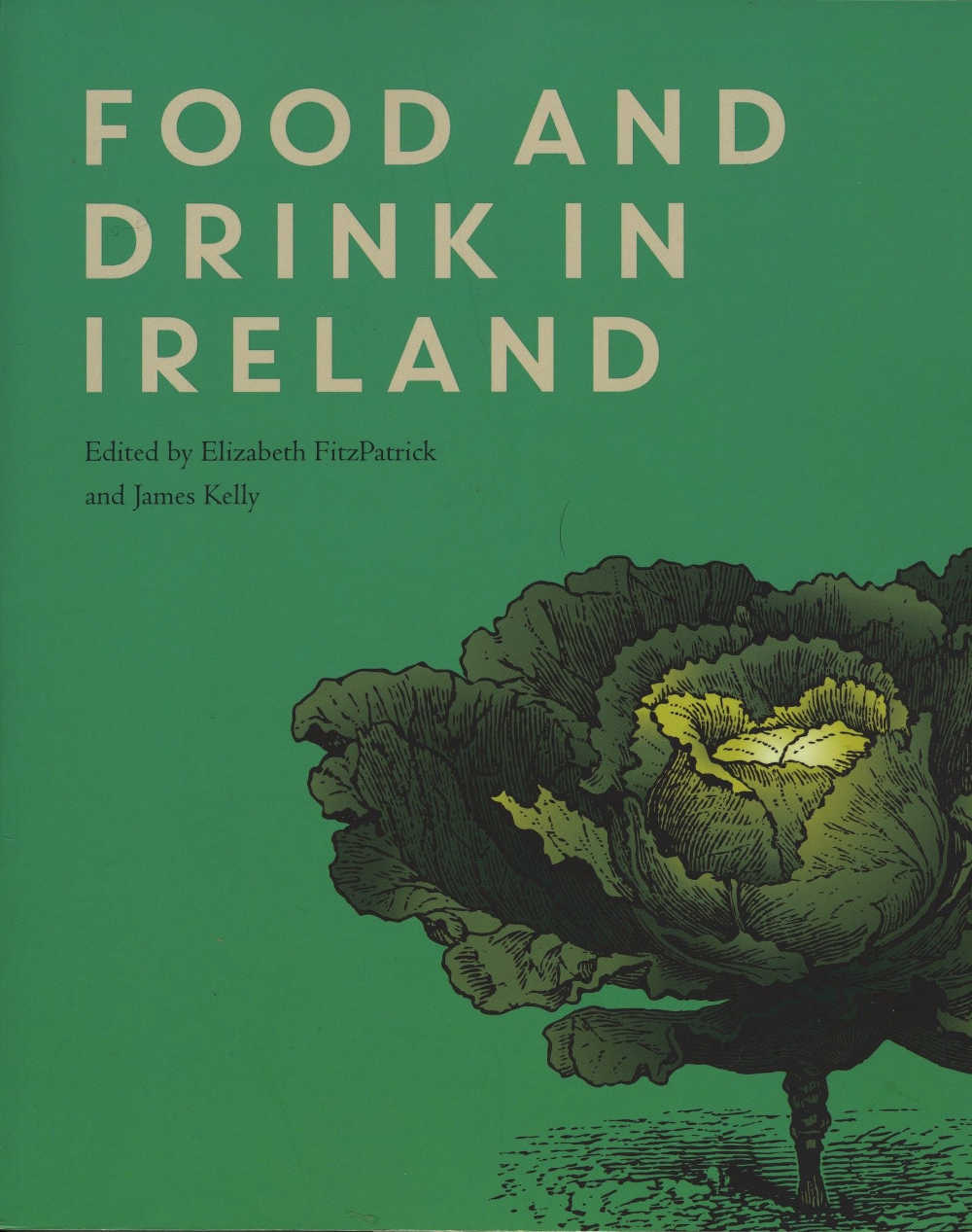
An unusual crop of food and drink books has landed on my desk this autumn - less of the bumper cookbooks from TV shows and celebrity chefs, more of the reflective and genuinely interesting books that are a pleasure to read and add to our knowledge, often by reintroducing us to forgotten foods or lost techniques…Perfect gift material for the discerning food lover in your life, in fact - which may well be yourself.
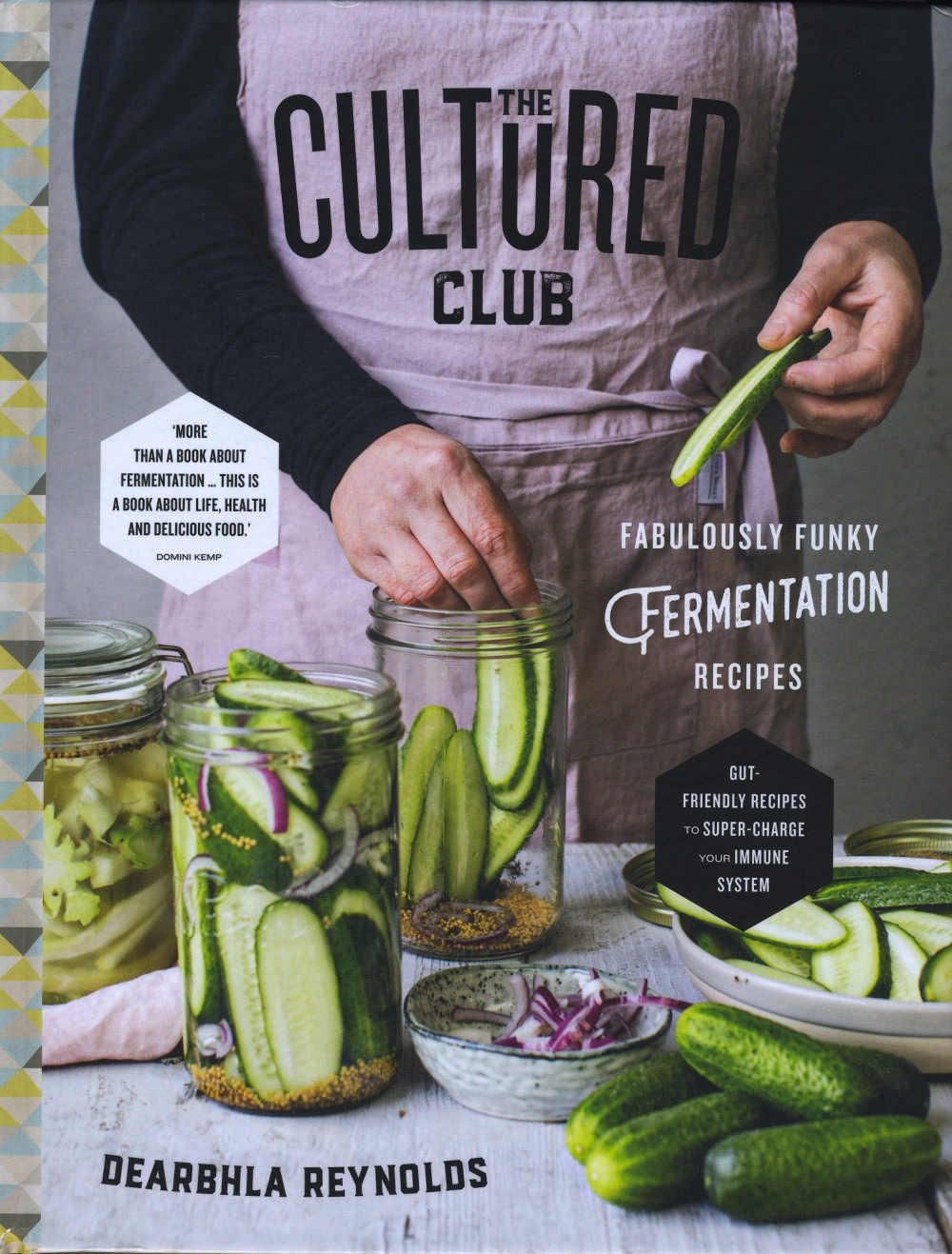 THE CULTURED CLUB, Fabulously Funky Fermentation Recipes by Dearbhla Reynolds, photography Joanne Murphy. (Gill Books, hardback; 342pp; €27.99/£24.99).
THE CULTURED CLUB, Fabulously Funky Fermentation Recipes by Dearbhla Reynolds, photography Joanne Murphy. (Gill Books, hardback; 342pp; €27.99/£24.99).
Very much with the zeitgeist, this impressive and handsomely produced book is destined to be a huge success. Although a first book, fermentation expert Dearbhla Reynolds - daughter of a pharmacist and a home economics teacher - hit the high spots early when she formed a collaboration with Belfast’s hottest restaurant, OX.
All the buzzword foods and drinks - kimchi, sauerkraut, fermented salsa, kombuchas and kefir - are here, but there’s not a bandwagon in sight. A serious book in many ways - the history and ‘gut health’ benefits of the world’s oldest method of food preservation are explained, together with ‘the art of fermentation and how to turn simple foods into super food’ - but with plenty of fun to be had along the way.
SAMPLE RECIPE: Dilly Carrots Two Ways
In her introduction to this ‘fresh and fragrant’ recipe Dearbhla Reynolds says reminds us that all root veg ‘will work wonderfully well as a fermented food’.
#1 Dilly Carrots
Makes 1x1-litre jar
I kg carrots - the bigger, the better for processing
1 bunch of fresh dill
I tbsp sea salt
Process the carrots however you like, using a food processor, mandolin, spiraliser or grater. Remove the stems from the dill and chop the fronds finely for an even mix.
Place the carrots and dill in a bowl. Sprinkle over the sea salt and massage it through the vegetables until they feel wet.
Pack the mixture into a clean 1-litre flip-top jar, pressing each handful down tightly to ensure no air is trapped. Pack the jar tightly, leaving 2.5cm headspace at the top of the jar. Make sure the
carrots and dill are completely submerged under the liquid that has been released.
Close the lid and allow to ferment for five days at room temperature, then store the jar in the fridge for up to six months. Carrots are best enjoyed within this time, as they tend to get mushy after six months.
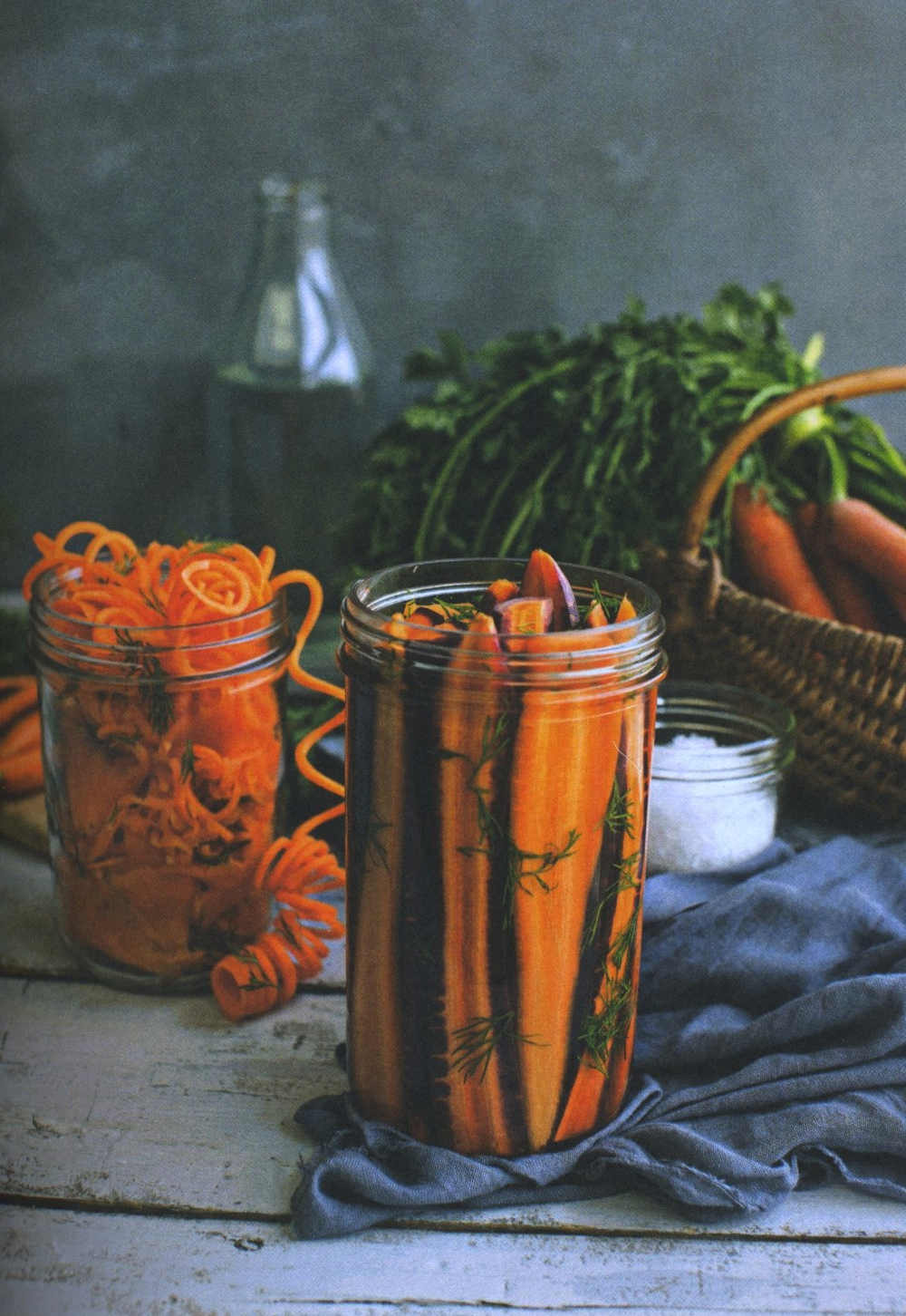
#2 Carrot Sticks
Makes 1x 1-litre jar
6 carrots, unpeeled and cut into sticks
1-2 garlic cloves, smashed
I tbsp chopped fresh dill
2% brine solution (1 tbsp sea salt dissolved in 1 litre filtered water).
Place the carrots, smashed garlic cloves and fresh dill into a clean 1-litre jar. Packing them vertically is the most efficient way to get a tight pack in the jar. Cover with the 2% brine to within 2.5cm of the top of the jar.
Leave to ferment on the countertop for at least two weeks. Taste after this time and continue to ferment until you have achieved your desired flavour. Once you are happy with the taste and texture, you can tuck in.
Store in the fridge for up to six months once opened.
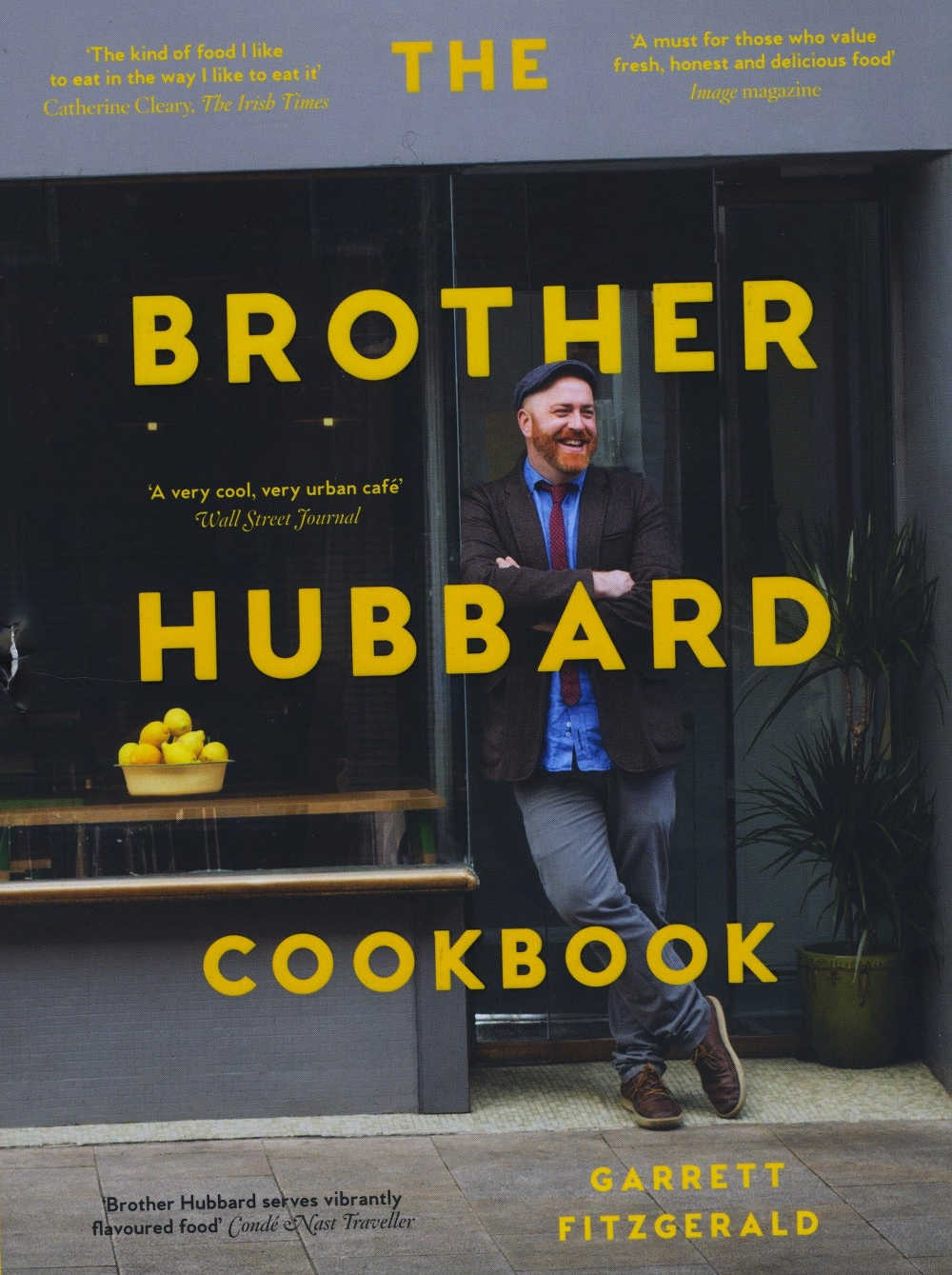
THE BROTHER HUBBARD COOKBOOK by Garrett Fitzgerald; photography by Leo Byrne (Gill Books, hardback; 372pp; €27.99/£24.99.)
A sociable food lovers’ magnet on Capel Street since 2012, the broadly Middle Eastern / Southern Mediterranean restaurant that Ballymaloe Cookery School-trained chef, Garrett Fitzgerald, runs with his partner, James, is already a Dublin institution.
Originally offering an aromatic haven that was like a big hug for recession-beaten Dubliners, it has developed organically to become a daytime café, bakery, and evening restaurant offering ‘fresh pure flavours dedicated to sharing and happiness’ for its community of followers - and an attractive younger sibling, Sister Sadie, has followed in the same tradition south of the Liffey since 2014.
With a welcome emphasis on flavour, colour and texture, this is real food with a nicely balanced combination of good sense and culinary curiosity - delicious and do-able, in short. I also applaud the practicality of details like the multiple page marker ribbons - whoever wants to mark just one recipe?
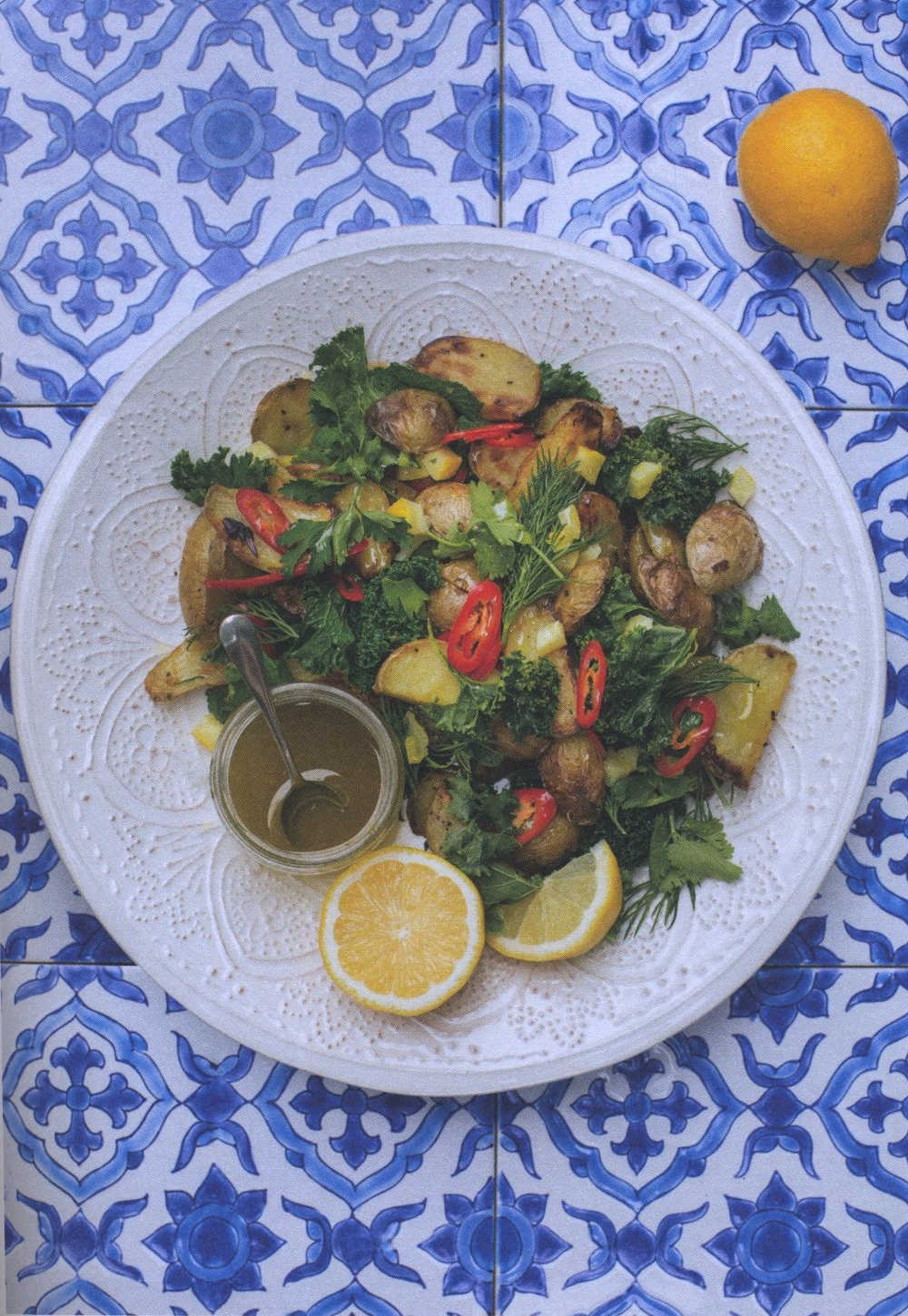
SAMPLE RECIPE: Potato, preserved lemon and kale salad
“Kale has become such a popular ingredient, and rightly so. It's great that its wonders have been rediscovered, but I would like to see the same thing happen to some other overlooked ingredients: pearl barley, caraway seeds and even prunes are on my hit list.
Here we have a salad that is substantial, satisfying, pretty and good for you - everything a salad should be! As per usual, play around with the flavours until it's as you would like it to be.”
Serves 4-6 as a substantial side salad
2 tbsp olive oil
1kg baby potatoes, cut into bite-sized pieces
2 garlic cloves, crushed
1 tsp ground cumin
1 tsp smoked paprika
salt and freshly ground black pepper
200g kale
½ preserved lemon (recipe given for this, or can be shop-bought)
1 red chilli, deseeded and finely diced or thinly sliced into rings
20g mixed fresh herbs (parsley, dill and/or mint), parsley and dill stalks finely chopped and all leaves roughly chopped
juice of ½ lemon.
Preheat the oven to 180°C.
Pour the oil into a large roasting tin and place in the oven to heat through. Place the potatoes in a large bowl, then add the garlic, cumin and smoked paprika along with some seasoning and mix well. Carefully place the well-seasoned potatoes into the hot oiled tin, give it a shake and return to the oven for 25-30 minutes, shaking once midway through. The potatoes are done when they have taken on a nice brown colour and are tender all the way through.
Remove the central rib/stalk from the kale and discard it, then roll up the leaves like a cigar and slice them finely. Remove any of the flesh that's still inside the preserved lemon and discard it, then finely dice the rind.
Place the hot potatoes in a large bowl and toss with the kale, preserved lemon, chilli, mixed herbs, lemon juice, a drizzle of oil and some black pepper and mix well. Taste and season accordingly, adding more garlic, lemon juice, spices or seasoning as you see fit. You can serve this immediately, while it's still warm, but there is also no harm in letting it sit a while so the flavours mingle and the kale softens slightly.
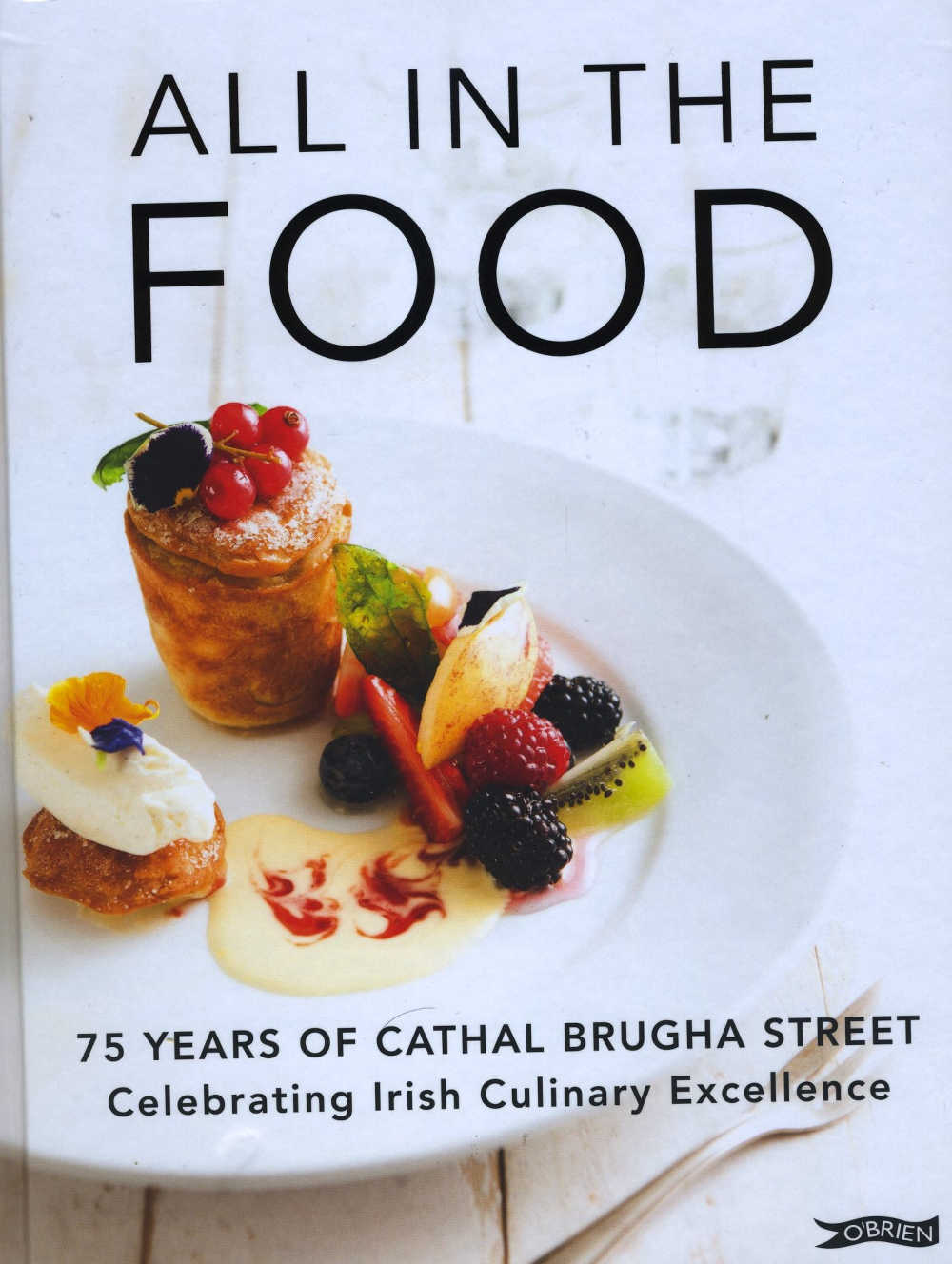
ALL IN THE FOOD - 75 YEARS OF CATHAL BRUGHA STREET, Celebrating Irish Culinary Excellence (O’Brien Press, hardback; 224pp; €24.99/£19.99)
At the other end of the age scale from Brother Hubbard, The School of Culinary Arts and Food Technology - known to all simply as ‘Cathal Brugha Street’, after the place that it has enriched since 1941 - marks its 75th anniversary and celebrates the many achievements of the college and its graduates with this book. Part memoir, part Irish food history, part text book, and part glimpse into what promises to be a bright future, it’s very ‘Cathal Brugha Street’.
And its diverse contents are all built around a backbone of impressive recipes from many famous graduates and associates including Darina Allen, Ross Lewis, Paul Kelly, George Smith, Michael O’Meara, Derry Clarke, Catherine Fulvio, Neven Maguire, and Mark Moriarty among many other luminaries.
Given the nature of the book and the calibre of its professional contributors, the recipes tend to be in the ‘special occasion’ bracket - but there are some simple, wholesome exceptions, including Richard Corrigan’s Scotch Broth (see below), Margaret Connolly’s lovely Nettle Soup, James Griffin’s Seaweed Soda Bread and Pauline Danaher’s Carrot Cake. Everyone who has a connection with Cathal Brugha Street will want to have a copy of this book.
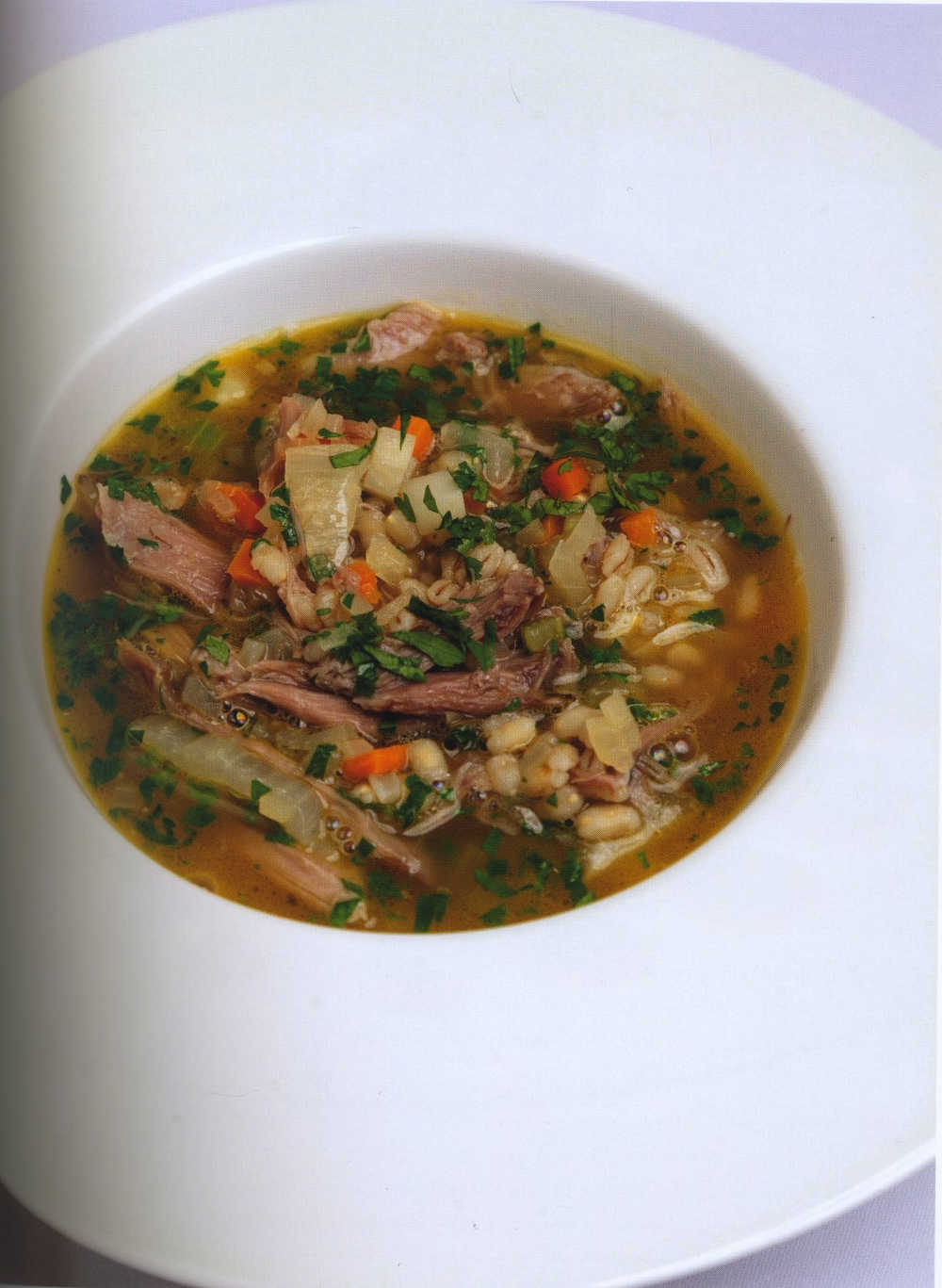
SAMPLE RECIPE: SCOTCH BROTH
This admirably simple recipe - Scotland’s answer to Irish Stew - was contributed by Richard Corrigan, a chef whose combination of finesse and the down to earth is legendary: 'Sometime classic favourites are simply the best. Broth is making a welcome comeback on cold winter days.'
Serves 4
2 lamb necks, on the bone, each weighing 300-400g
50g carrots, diced
50g onion, diced
50g leek, diced
50g celery, diced
50g celeriac, diced
50g turnips, diced
3 garlic cloves, sliced
40g pearl barley
1 bouquet garni
Parsley
200ml olive oil
Salt, pepper
Heat the olive oil in a large, heavy-based pan over a medium heat. Sweat all the vegetables and garlic for 5-10 minutes until soft and lightly golden.
Add the lamb necks, followed by the pearl barley and approximately 2 litres of cold water. Bring to the boil, season with salt and pepper and add the bouquet garni.
Simmer the broth for 2 hours, remove from the heat. Carefully lift the necks out of the pan and flake the meat from the bone. Discard the bones and add the flaked meat back to the broth.
TO SERVE: Reheat the broth, adjust the seasoning to taste and stir in plenty of chopped parsley [Suggested drinks: Chenin Blanc wine or Scotch ale.]
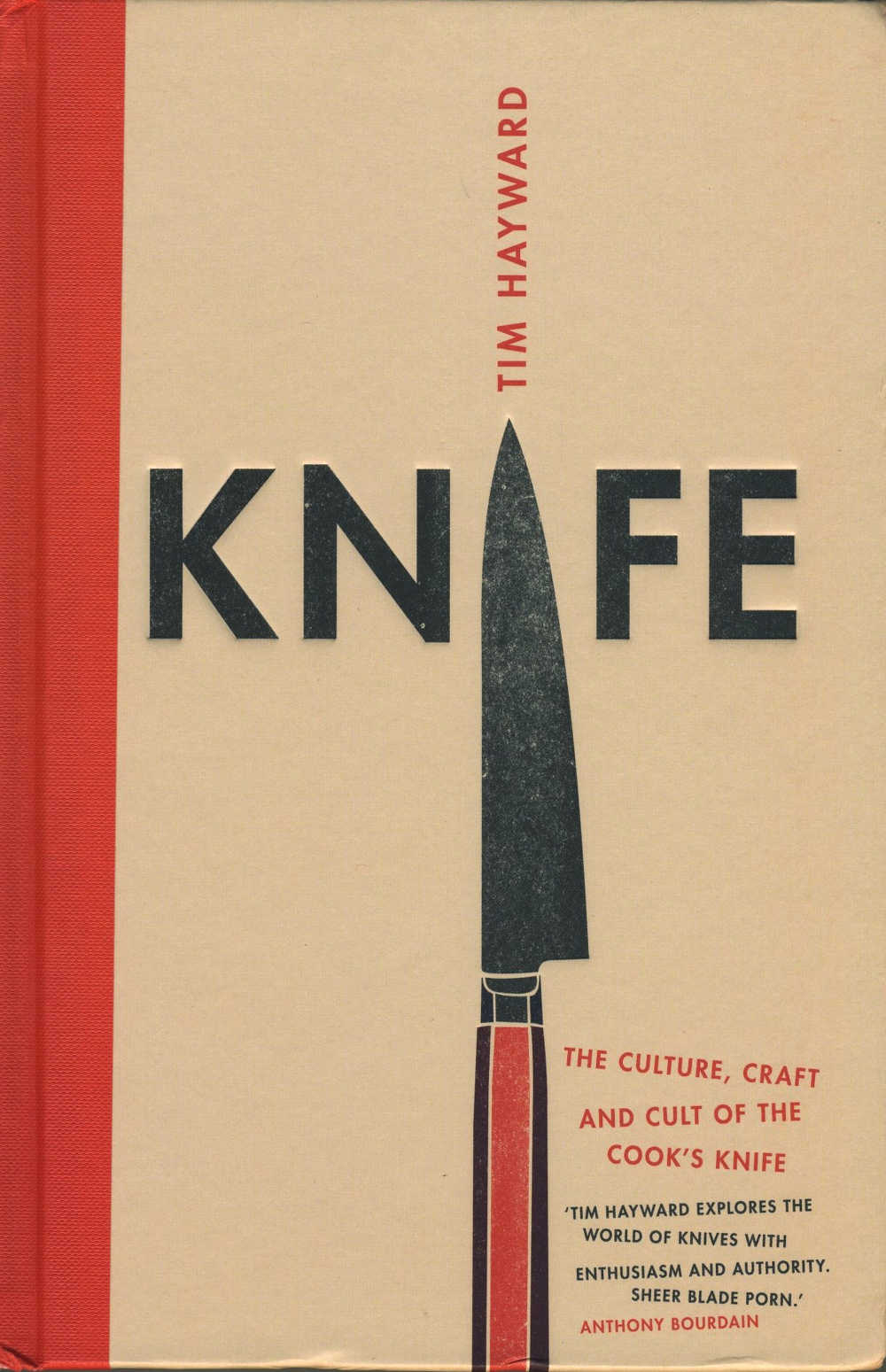 KNIFE, The Culture, Craft and Cult of the Cook’s Knife by Tim Hayward; photographs by Chris Terry (Quadrille, hardback; 224pp; £20.00)
KNIFE, The Culture, Craft and Cult of the Cook’s Knife by Tim Hayward; photographs by Chris Terry (Quadrille, hardback; 224pp; £20.00)
I love this book – it’s refreshing to see something so different from the endless array of quite similar cookbooks that hit the shelves at this time of year and it will make a great gift for anyone with a chef or aspiring chef in the family, or anyone with an interest in food, or culinary history, or civilisation – or just about anything at all.
Forget about all those appliances that clutter up the countertop, we all know that a good knife is all we really need - along with a good chopping board of course, a topic also touched on here. Tim Hayward - proprietor of the 90-year old Cambridge bakery and restaurant, Fitzbillies - was the 2015 Guild of Food Writers’ Food Writer of the Year and is well known for his print journalism and contributions to thinking persons’ radio programmes like The Kitchen Cabinet and The Food Programme.
Just the man to write ‘a love letter to he most treasured of culinary tools’. Get it and pore over Chris Terry’s loving photo portraits of every conceivable kind of knife from the slightly rusty carbon steel classic beloved of Elizabeth David to Chinese cleavers, picnic knives and Japanese mandolins, and get lost in the illuminating and very readable text.
There’s everything you never knew you wanted to know about knives here, from their history and cultural significance, to how they’re made, how they feel - and how we feel about them. Practical stuff too - on sharpening, and the 10 Rules of Carving, for example - and you’ll be interested to see what Tim has to say about the electric carving knife too. A magic book.
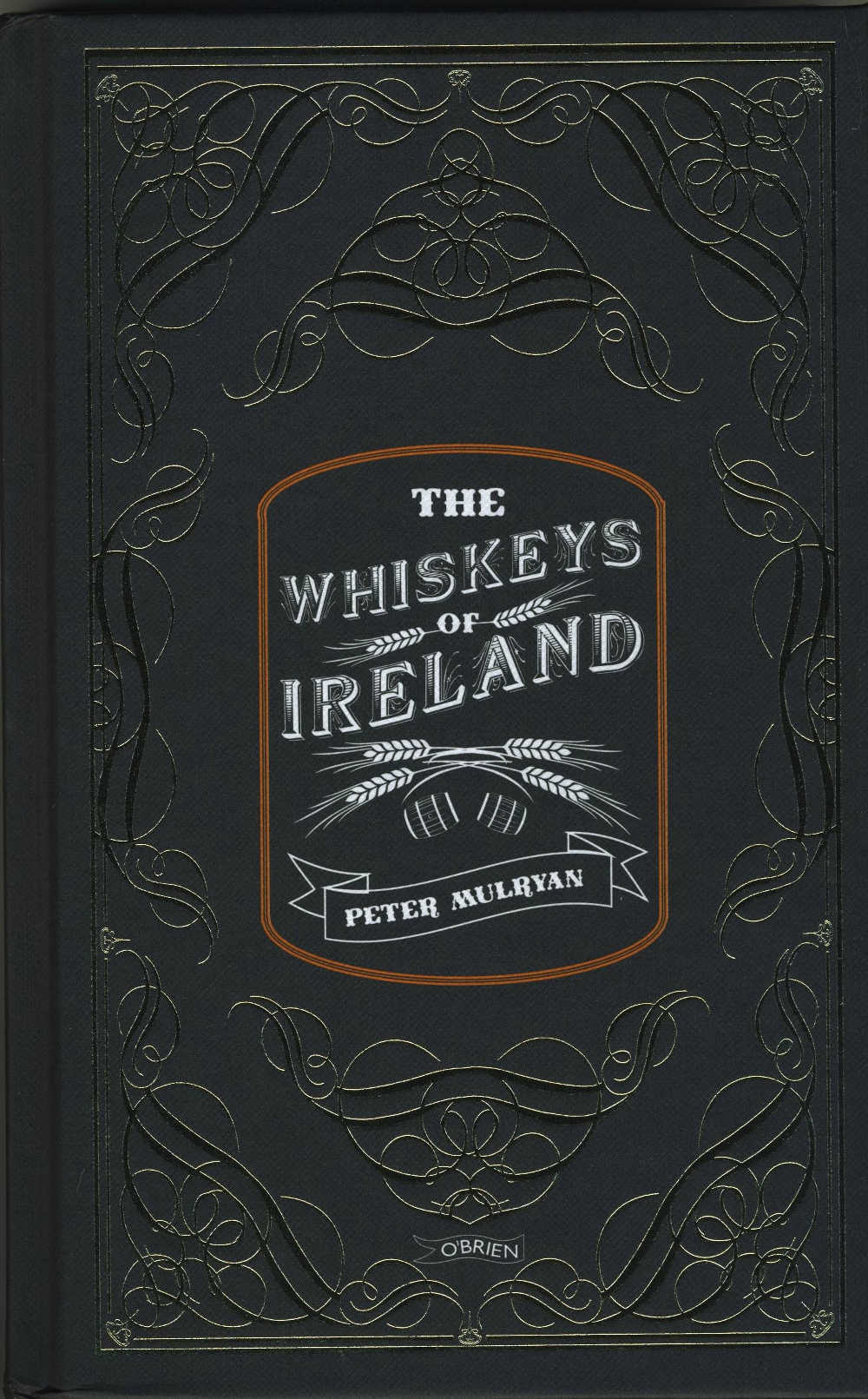
The Whiskeys of Ireland by Peter Mulryan. (O’Brien Press, hardback;192pp; €19.199/£14.99)
The author of multiple books on Irish whiskey, former radio and TV producer Peter Mulryan - now owner of Blackwater Distillery, West Waterford - is an established expert in the field and this is an updated version of the 2002 edition.
How things have changed since then. Whether or not you are a whiskey drinker, this book is sure to be as enjoyable as it is fascinating, for it’s a rollicking good read (as they used to say) that moves along at a cracking pace and tells us as much about Ireland and our relationship with the world as it does about whiskey.
Tracked from way back in ‘the mists of time’, through its rise - eventually to meteoric heights in the late 19th century following the arrival of phylloxera in Europe and consequent wipe out of French brandy - and fall, largely due to over-production and dropping standards, the history of Irish whiskey is nothing if not exciting, a roller coaster ride of successes and near disasters.
This is a terrific book with one small caveat - there is no Index. This is especially missed in the later sections which deal with the renaissance of craft distilling, a miracle that first began in a small way at Longueville House, Co Cork, in the early 1990s when the late Michael O’Callaghan started making apple brandy, although it was well over a decade later before larger scale operations began to start up.
This is a fascinating - and unfinished - part of the story, and one to which we can all relate. I wonder how many readers will be struck by the irony that, in 19th century Ireland, an almost tasteless high-alcohol distillation called ‘silent spirit’ (because it lacked the natural flavours of pot still whiskey) was made in huge volume in ‘column’ stills that - unlike pot stills - could operate 24/7. As well as being used here for the production of inferior spirits (and industrial use), it was exported.
Today, a similar product is imported, and is the base for many of the fashionable new gins - of which only a handful, including Peter Mulryan’s excellent Blackwater Gin, are all-Irish products. Plus ca change.

FOOD AND DRINK IN IRELAND, Edited by Elizabeth FitzPatrick and James Kelly (Royal Irish Academy; paperback; 430pp; €25 from ria.ie)
If you, or a friend or relative on your Christmas list, has an academic interest in Irish food and drink, then this is the book for you. As pointed out by the publishers, the Royal Irish Academy, “Although subjects of enduring interest in their own right, food and drink are still more revealing archaeologically and historically when they amplify and illuminate broader societal behaviours and trends.”
Beginning in very early times, with the first settlers, this impressive book presents a holistic view of ‘the collection, cultivation, consumption and culture of food and drink in Ireland’ through essays by a team of fourteen contributors who are all leading experts in their fields.
Highlights include Regina Sexton’s essay on Food and culinary cultures in pre-Famine Ireland; Diarmaid Ferriter on Drink and society in twentieth century Ireland; Máirtín Mac Con Iomaire on haute cuisine restaurants in nineteenth and twentieth century Ireland; and Frank Armstrong’s essay Beef with potatoes, on food, agriculture and sustainability in modern Ireland.
Whether for serious research, or to dip into with curiosity and pleasure from time to time, this is an extraordinary and thought provoking book - and excellent value too.
Georgina Campbell's Book Reviews
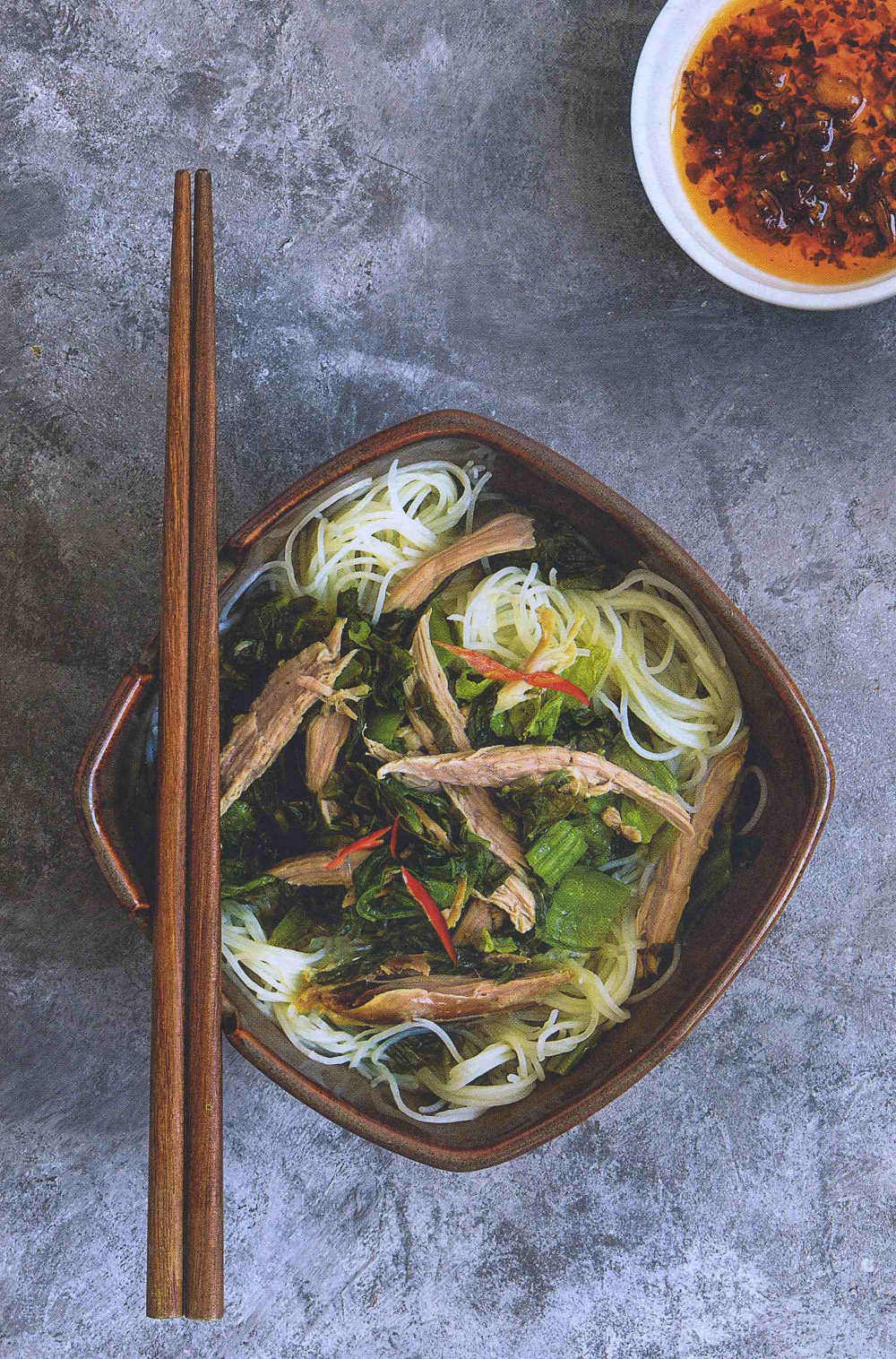
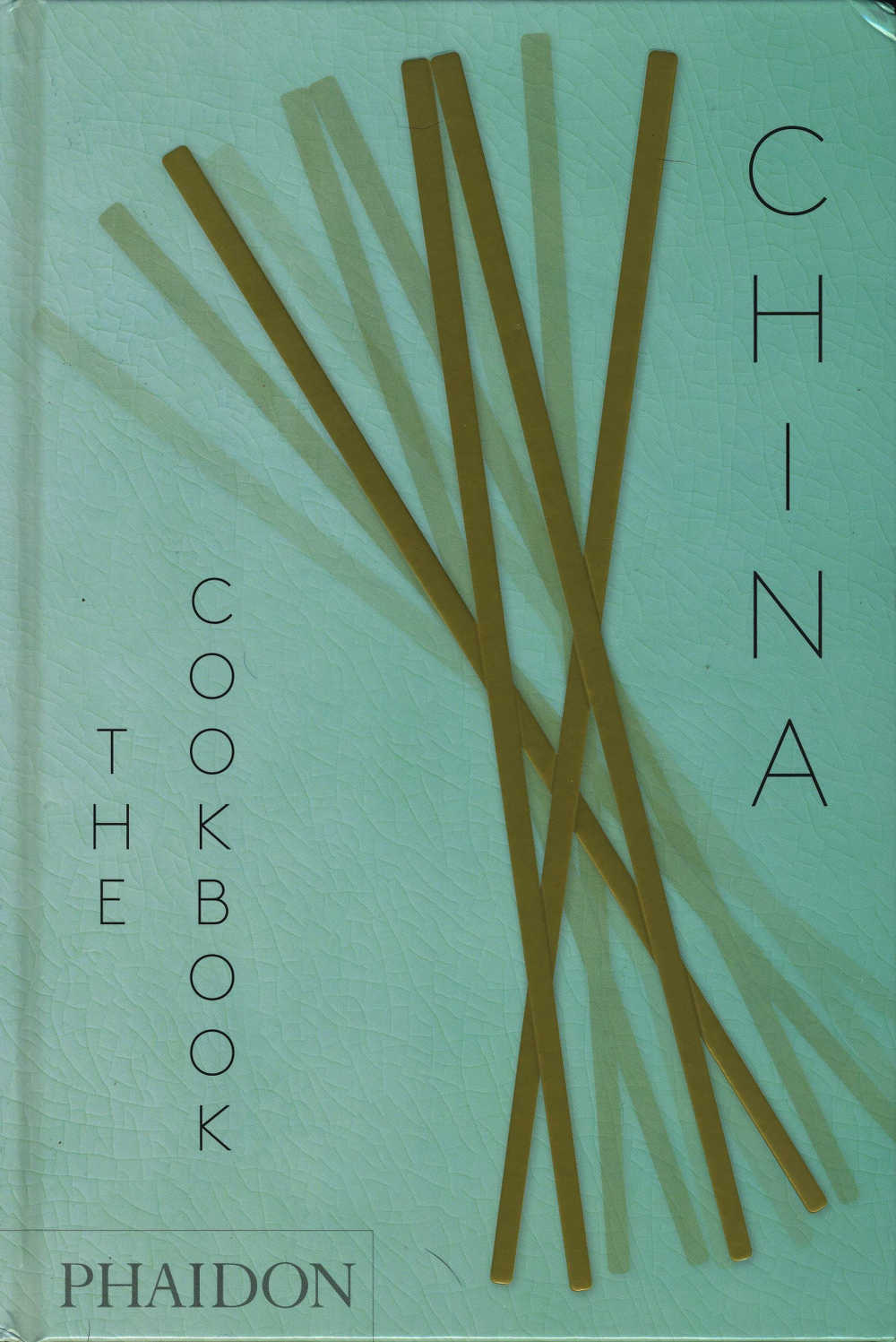
China, The Cookbook by Kei Lum and Diora Fong-Chan (Phaidon; hardback 720pp, colour photographs throughout; €39.95, stg£29.99)
The traditional holiday period associated with the Chinese New Year is in full swing and, just as St Patrick’s Day gives us a unique opportunity to remind the world of all things Irish (or, in the unlikely event that it doesn’t already exist, create awareness), this is a time to celebrate Chinese culture everywhere.
The ‘official’ holiday is only 7 days (27 Jan - 2 Feb this year), but the ‘traditional’ holiday extends over 23 days, so there is plenty of time to get the message across. Chinese communities everywhere, including Ireland, organise festivities that educate, entertain and strengthen generational and community bonds, there is a strong focus on food and its role in Chinese culture and traditions, and restaurants offer special festive menus.
This is the Year of the Rooster, a birth sign associated with some admirable traits - such people are said to be ‘resourceful, hardworking, talented, courageous’ - and I wonder if either of the esteemed husband and wife writing team Kei Lum and Diora Fong-Chan are ‘Roosters’ as it seems to me that the authors of the definitive Chinese cookery book, China, The Cookbook would need all of that on their side and more.
Phaidon are doing a nice promotion on their website, tying the book in with the Chinese New Year by suggesting four dishes from it for a Healthier, Happier and Wealthier Chinese New Year - in case you’re wondering, they’re Soy Sauce Chicken (prosperity); Lettuce Wrap with Oysters (boost your professional life); Stir Fry Shanghai Noodles (longevity); and Laughing Donut Holes (happiness).
Which is all good fun but, while the relatively short opening chapters of this book will teach most of us a great deal about Chinese food and its symbolism, it doesn’t dwell on festivities or ritual - the main focus is on the recipes, all 650 of them.
That means you could try a new dish every day for nearly two years without repetition, which seems very appropriate for a book that represents a country so vast that it’s hard to comprehend. Its food culture is correspondingly complex and, when you think about a country with thirty four provinces and regions and fifty six indigenous nationalities - each with its own food traditions - the word diversity takes on a whole different meaning.
Then there is the range of climatic conditions and terrain - the mountainous, the land-locked, the regions dominated by great rivers, and the favoured coastal zones… ‘A gross simplification would be to say that each of China’s main areas are characterised by a distinct flavour: the northj (Shandong) is salty, the east (Anhui, Jiangsui, Zhehjiang) is sour, the south (Guandong and Fujian) is delicately sweet and the west (Hunan and Sichuan) is heart-clutchingly spicy.’
These regions are known as China’s Eight Great Cuisines, and each is detailed in the introductory pages with its key characteristics and references to some of the signature dishes that are sprinkled through the book.
Cooking techniques and equipment are covered too and, while authenticity is a given, most of the specialised ingredients are now quite easily accessed and the wonder of it is that so many of the recipes are straightforward and very accessible for any home cook with an interest in doing things right.
The shame of it is that only a couple of the main regional styles are likely to be familiar to most of us - Cantonese (Guandong) and Sichuan - but this is just the place to learn more. A lovely gift for anyone with an interest in Chinese food and culture (including yourself), and this handsomely produced, gilt-edged volume is exceptionally good value too.

SAMPLE RECIPE: Vermicelli With Roast Duck In Soup
Region: Hong Kong
Preparation time: 10 minutes
Cooking time: 15 minutes
Serves: 2
7 oz/200 g dried rice vermicelli
3 cups (25 fl oz/750 ml) chicken broth (stock)
1/2 teaspoon salt
1 tablespoon vegetable oil
1 clove garlic, sliced
5 oz/150 g preserved mustard greens, rinsed, trimmed, and chopped
1 red chilli, seeded and finely sliced (optional)
1/2 small roast duck, meat shredded
1 teaspoon cornstarch (cornflour)
For the sauce:
2 teaspoons light soy sauce
1 teaspoon granulated sugar
1 teaspoon sesame oil
Bring a large saucepan of water to a boil and add vermicelli. Cover, turn off the heat, and let stand for 10 minutes until softened. Using chopsticks, stir the vermicelli to prevent it from sticking, then drain,
Put the chicken broth (stock), salt, and 2 cups (16 fl oz/475 ml) water in a large saucepan and bring to a boil. Add the vermicelli, return to a boil, and then transfer everything to a soup tureen.
Heat the vegetable oil in a wok or large skillet (frying pan) over high heat, add the garlic, and stir-fry 1 minute until golden. Add the mustard greens and chile, if using and stir-fry for 1 minute.
Stir in the roast duck and sauce ingredients, add 4 tablespoons water, and bring to a boil.
Mix the cornstarch (cornflour) with 1 tablespoon water in a small bowl and stir this mixture into the wok. Bring to a boil, stirring, for 30 seconds to thicken the sauce then pour over the vermicelli.
Book Review by Barbara Collins
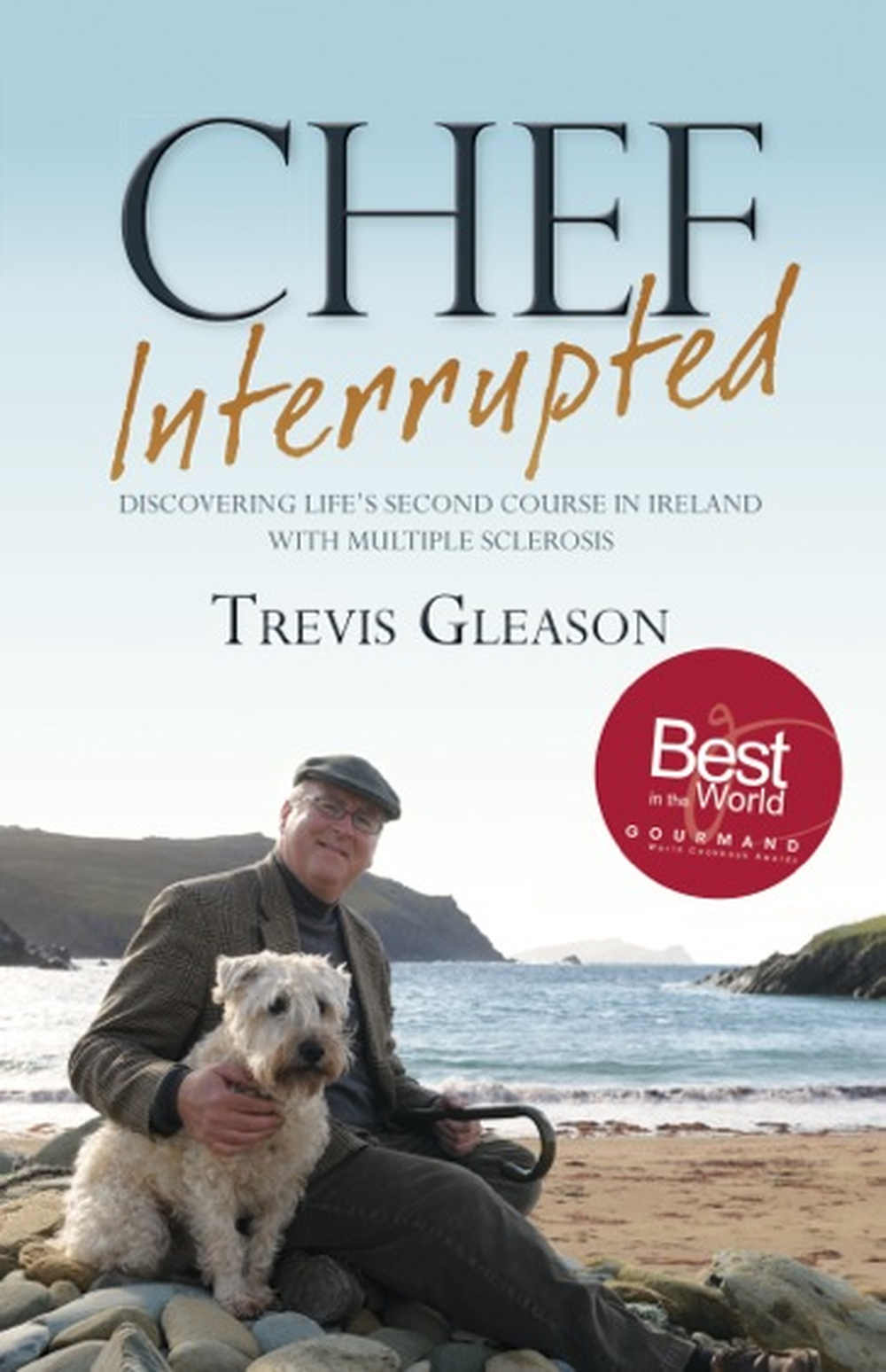
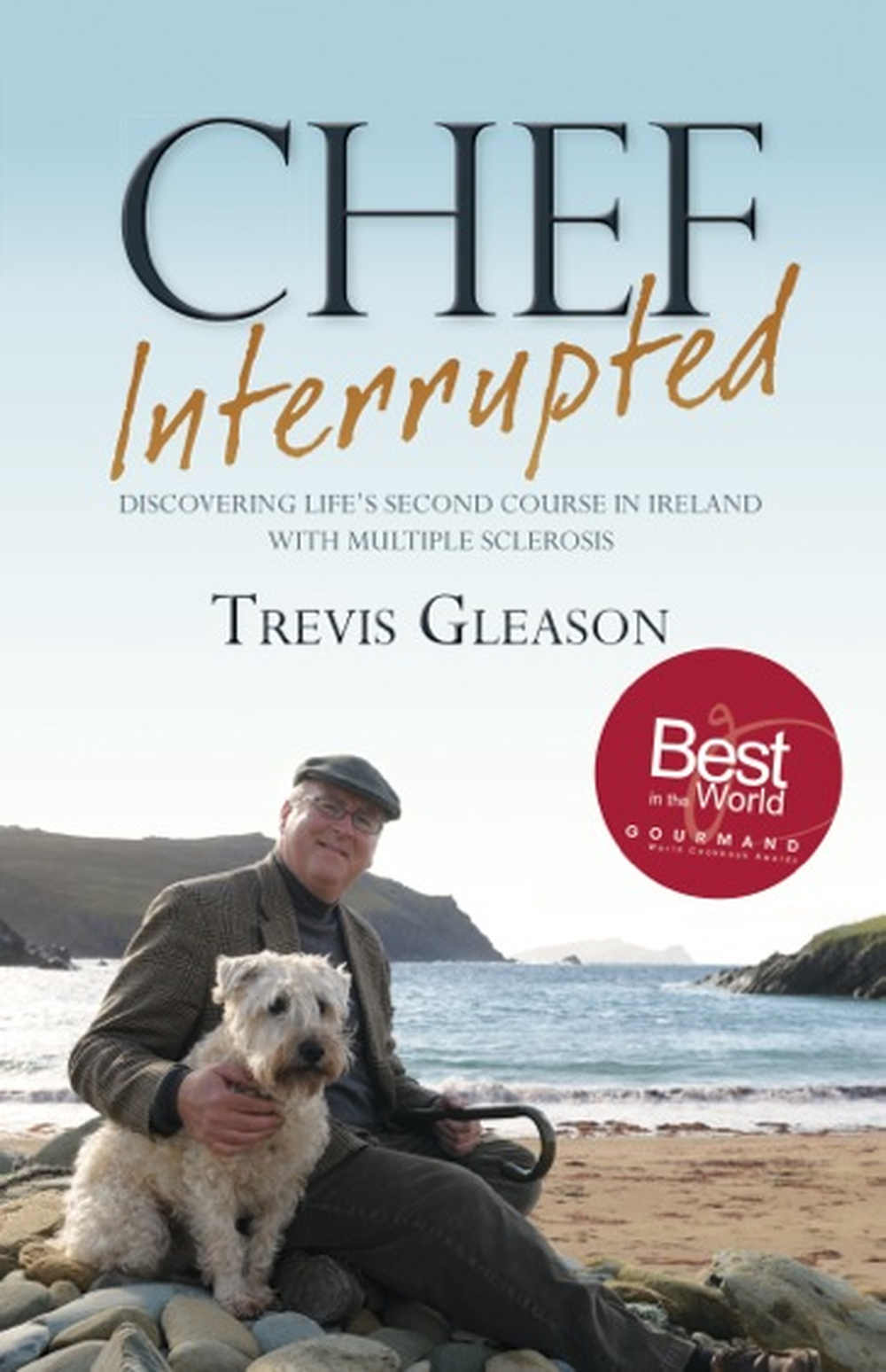
Chef Interrupted, by Trevis Gleason; Collins Press Paperback, €12.99.
Reviewed by Barbara Collins
Not many people who have been diagnosed with Multiple Sclerosis would be able to start a new life for themselves on another continent, but the former American chef Trevis Gleason’s inspiring read Chef Interrupted- Discovering Life’s Second Course in Ireland with Multiple Sclerosis tells the story of how he did just that.
The tone of the book, which won a Best in the World Gourmand Cookbook Award in China last May, is self-effacing and humorous. Trevis’s ancestors left Fermanagh in 1690, but he always knew he had Irish blood. After a trip “home” he fell in love with Dingle and eventually decided to move there with his wife Caryn who he met after that first trip.
They rented a cottage, got two dogs and slowly but surely got the hang of driving on the left, sheep in the garden and understanding the lilting West Kerry accent. Trevis has put down firm roots in The Town. He is an ambassador for the Blas na hEireann Irish Food Awards. He is also on the organising committee of the Dingle Food Festival.
After the diagnosis in 2001, Trevis didn’t give up on cooking. He could no longer keep up with the hectic pace of a professional kitchen or a demanding teaching schedule, but that doesn’t stop him experimenting with roasting a leg of lamb by the fireplace and regularly entertaining friends with dishes like Steak and Guinness Pie with Colcannon and Sticky Date Pudding. These recipes, and many more of his favourites, are peppered through this book.
Writing is another obvious talent of the man who likes to “tell it like it is” in his popular blog Life With MS. He is on the editorial board of MS Ireland and has been twice-ranked as the No. 1 Online Influence on the topic of MS. This is a story not of survival, but of living life to the full. Trevis’s humour in the face of his changed life is sure to inspire and have you coming back for seconds.
Chef Interrupted is available on the Collins Press website, in all good bookshops and on Amazon.
SAMPLE RECIPE: TREVIS GLEASON’S COLCANNON
Using floury baking potatoes makes for a lovely mash, which then absorbs the cream and butter, and Trevis uses kale instead of cabbage. Eat this with bacon, stew or on its own, it is addictive.
Ingredients
770g/ 1.5 lbs baking potatoes, peeled and quartered
450g/1lb kale (washed and stalks removed, then chopped medium coarse)
150ml/5 fl oz cream
50g/ 2oz butter
1 bunch scallions/spring onions, cleaned and sliced
Salt and black pepper to taste
Method
Put the potatoes in a large pot with enough cold, salted water to cover by about 8cm/3 inches.
Bring to the boil, and then reduce the heat to a slight simmer and cook until nearly tender (about 10 minutes)
After about 5 minutes, add the kale to the water and stir, being careful not to break the potatoes.
At that point, take a small pan and add the cream, butter and scallions; season with salt and pepper and bring to a gentle simmer. Do not let this mixture boil.
When the potatoes are tender, drain and shake well. Return the pot to a low heat to dry and place the potatoes and kale in the warm pot for 2 minutes.
Mash the potatoes and kale until there are no potato lumps. Stir in the cream/scallion/butter mixture a bit at a time and fold in with a wooden spoon until at the desired consistency.
Correct the seasoning with salt and pepper. Serve.
---
 Barbara Collins is a BBC journalist and freelance food, travel and agricultural writer. She contributes regularly to Countryfile magazine, the Farmers Guardian, the Irish News, FFT and the Irish Mail on Sunday. She was Chief Food Writer for Flavour magazine. She is a member of both the UK and Irish Food Writers’ Guilds and splits her time between Belfast and Galway. Barbara also does menu consultancy and copywriting.
Barbara Collins is a BBC journalist and freelance food, travel and agricultural writer. She contributes regularly to Countryfile magazine, the Farmers Guardian, the Irish News, FFT and the Irish Mail on Sunday. She was Chief Food Writer for Flavour magazine. She is a member of both the UK and Irish Food Writers’ Guilds and splits her time between Belfast and Galway. Barbara also does menu consultancy and copywriting.
@thegoodchinaset
Book Review
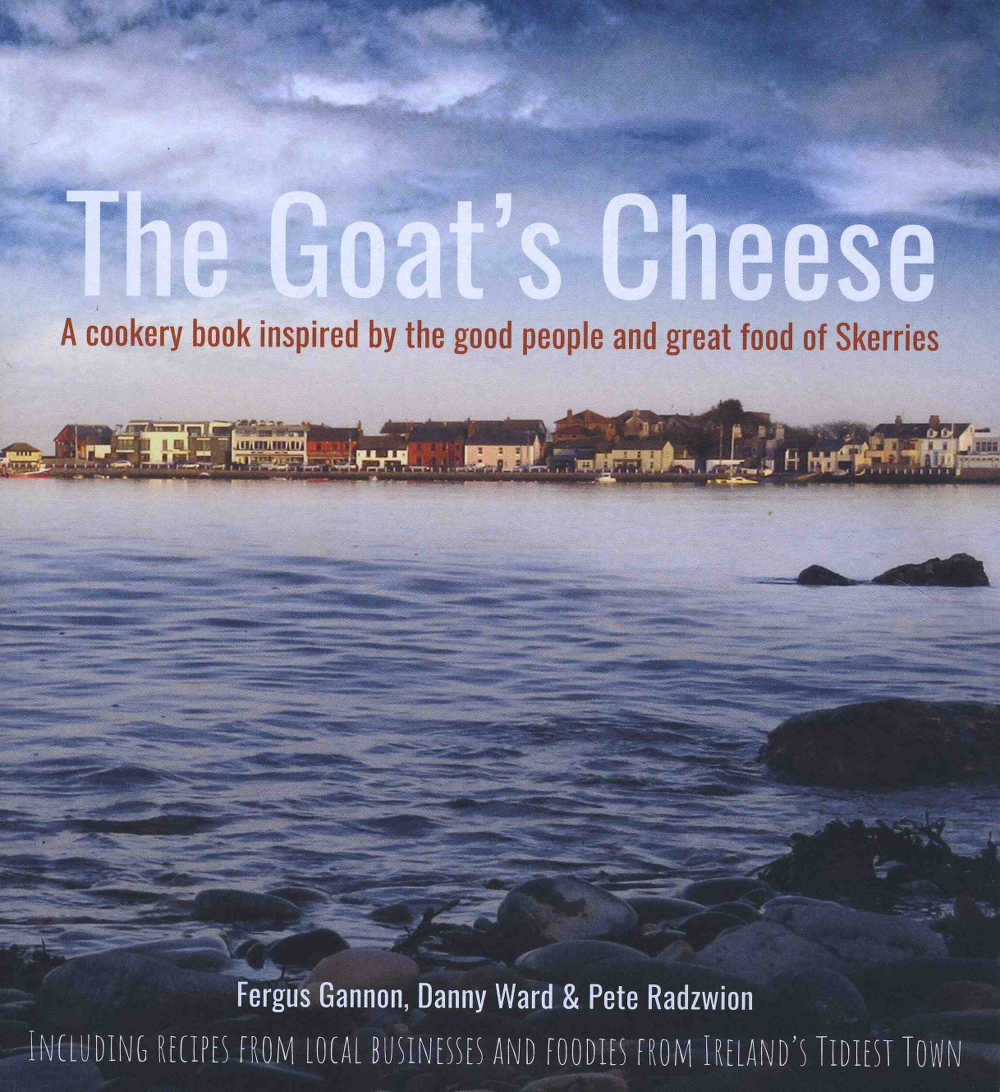
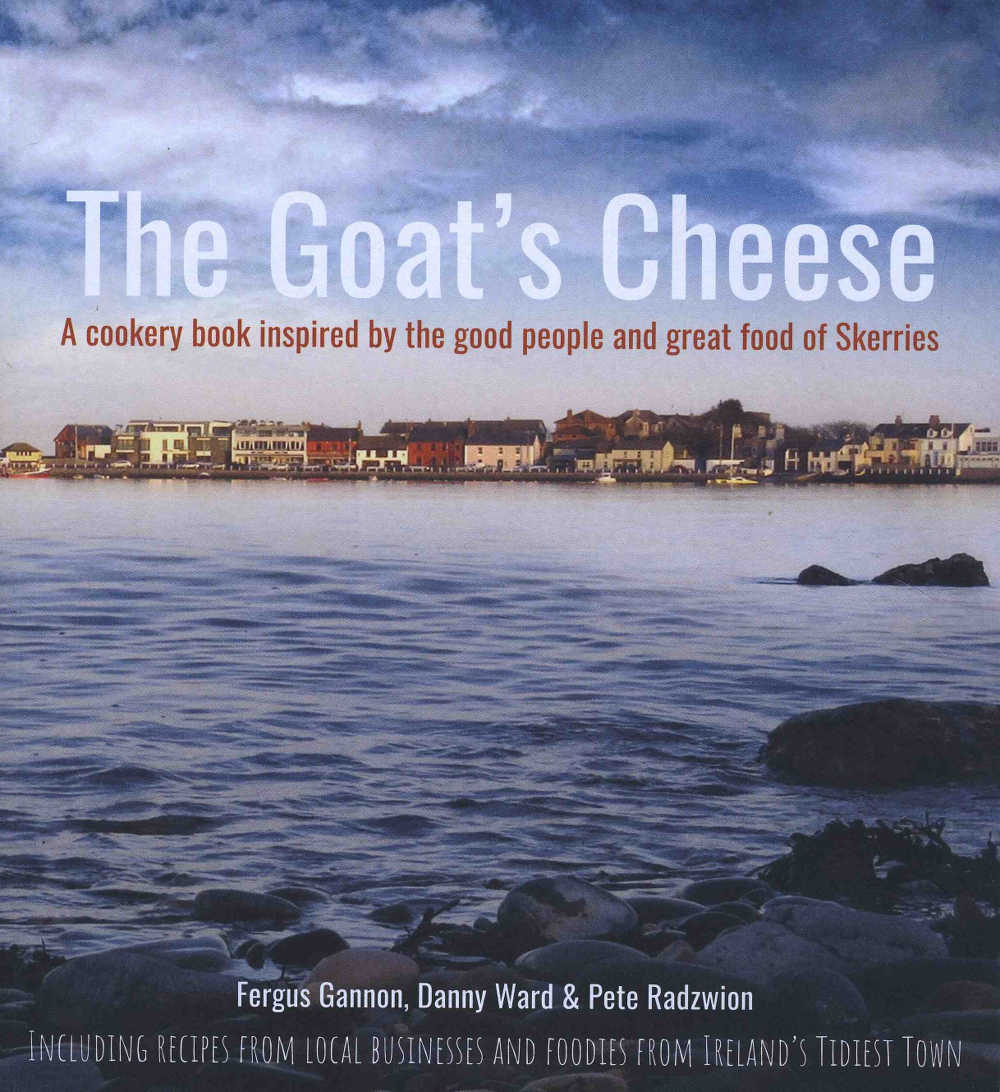
JEANNE QUIGLEY reviews The Goat’s Cheese, A cookery book inspired by the good people and great food of Skerries by Fergus Gannon, Danny Ward and Pete Radzwion (The Goat’s Cheese, paperback, 122pp, €25)
Legend has it that when St Patrick lived on an island just off the coast of Skerries, local people stole and feasted on his goat. When they tried to deny it, they could only bleat, thus earning themselves the nickname of goats, which endures to this day.
But this is not a cookery book inspired by either goats or goat’s cheese. In fact, just three of the 62 recipes feature this cheese and one of those is an unusual goats cheese and blueberry mousse, courtesy of chef Terry McCoy of one of Skerries’ oldest and most famous restaurants, The Redbank.
And that’s the idea behind this book – it’s a collection of recipes from many of the town’s best eating places and others who have a connection with this delightful North County Dublin town. It features recipes from Olive Deli & Café, White Cottages B&B, The Windmill Steakhouse, Blue Bar, Joe May’s Stoops, the Red Bank…..the list goes on. But, not content with present day Skerries’ residents, the authors invited some of those who started their culinary journeys in this seaside town to contribute.
Robert Bullock, for example, who set up his well-known company Le Patisserie when he lived locally in Hoar Rock, lets us in on the secret of his award-winning Tart de Citron Meringue; Colin Kelly – of One Pico and La Stampa fame – fell in love with kitchens when he worked as a kitchen porter in the original Windmill and his contribution is Chocolate and Peanut Butter Mousse with fresh raspberries and salted caramel popcorn. And the pioneering Linda O’Rourke, who opened Skerries’ first coffee shop ‘back in the day,’ shares her luscious Phoenix Pavlova that’s sure to bring back memories to plenty of older goats.
The foreword is written by local author and Irish Times columnist Shane Hegarty (whose Darkmouth children’s book series is currently being filmed) and, for the three thirtysomething authors, Fergus, Danny and Pete, this book is a labour of love.
Realising that their town could compete with any of Ireland’s so called ‘foodie towns’ they wanted to make sure that the public was well aware of this. They asked for – and received – recipes from as many of the local food businesses as they could and then added in a few historical notes and cultural references. These include a list of What’s On in Skerries throughout the year, including the Water Festival, the Christmas Swim and the FBD Ras Street Party. Local writer and artist Hugh Fitzgerald Ryan gives his unique take on some of the legends associated with St Patrick and Skerries.
As you would expect with a cookbook from this area, fish features pretty heavily. We’re told that just about everyone from Skerries has caught a mackerel off the end of the pier, from a small boat or by casting a line out into the sea. And if you haven’t maybe it’s time you did. But in case you don’t know how to cook it, Conor McLoughlin provides an easy grilled fish with devilled sauce.
Razor clams, once thought of as ‘famine food’, are very plentiful in the waters and one of the most frequently caught shellfish. Chef Stephen Atley gives a quick way of mixing with pancetta and garlic, sprinkling with Parmesan and grilling.
The book is divided by season, and if you have ever felt nervous about the Christmas Dinner, well, there are four pages in the Winter section devoted to this, from the Bird to the Trimmings to the Mince Pies (gluten free in this case). Apparently, Skerries people love their ice cream, hot chocolate and speciality coffee and not just in summer as the well-known ice cream parlour Storm in a Tea Cup gives a nostalgic Crunchy Kinder Crepe recipe.
The recipes range from easy to slightly more time consuming, but everything is explained well so amateur cooks need not worry that the recipes are beyond their range. Pages and excellent photography are slightly muted giving an old-fashioned hue, but this is a book that will sit well in any kitchen.
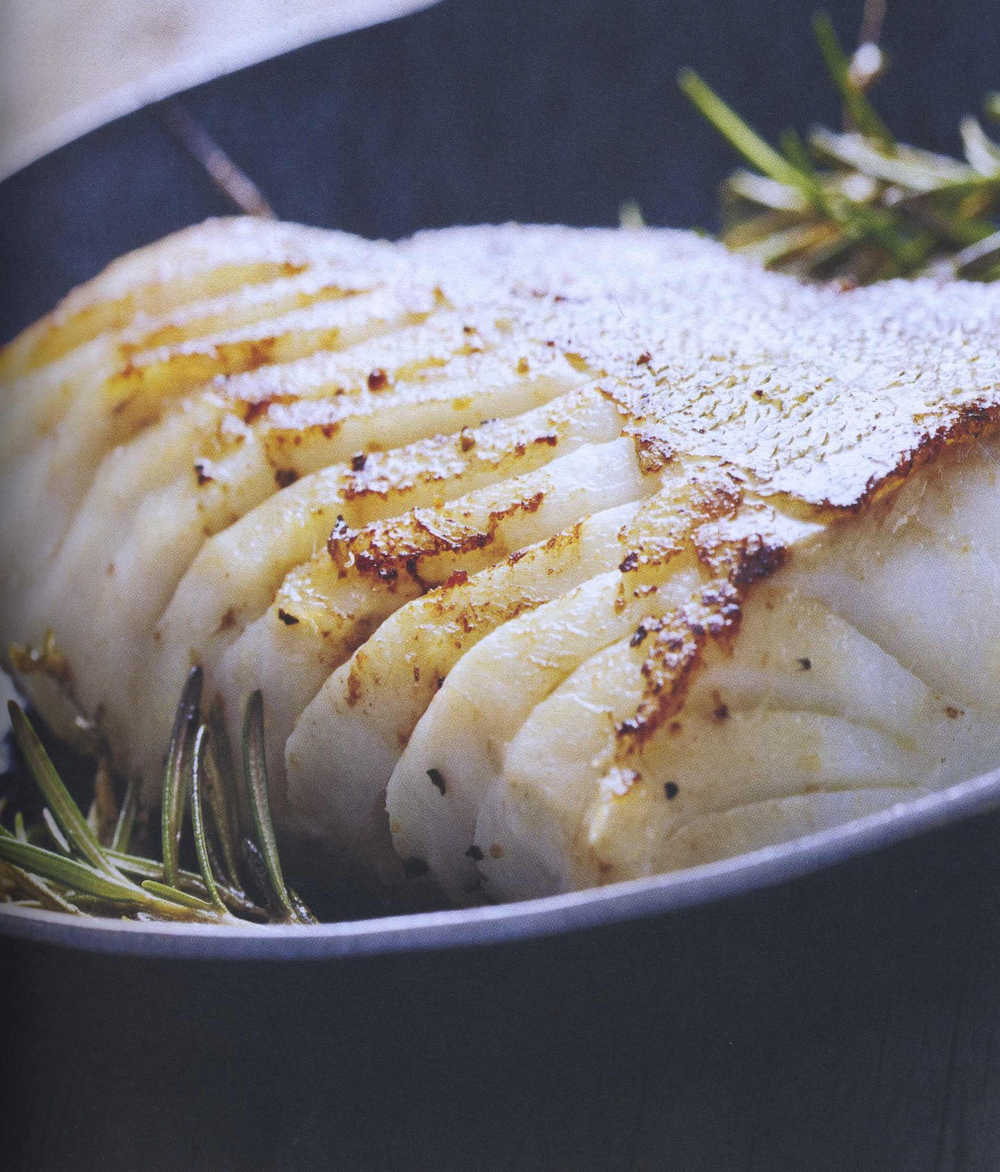
SAMPLE RECIPE: Pan-seared and roasted lemon cod (courtesy of Egan’s Ocean Fresh)
Egans have been supplying fresh fish to Skerries customers for 10 years. But as well as catching the fish, they also know the best ways to cook it to keep that flavour. This recipe is easy and healthy and can be ready in less than 15 minutes.
2 x 250g cod fillets (skin/boneless)
4 sprigs fresh rosemary
12 vine cherry tomatoes
2 tbsp olive oil
2 tbsp almonds (chopped/sliced)
1 slice lemon
salt & pepper to taste
Pre-heat oven to 200°C.
In an ovenproof dish, roast the cherry tomatoes on the vine with the rosemary and lemon for 10 minutes.
Heat a pan and add the olive oil.
Season the cod with salt and pepper.
Sear for 1 -2 minutes on each side.
Place the cod on a baking tray and sprinkle the almonds over the top.
Bake for 3-5 minutes depending on the thickness of your fillets.
To serve
Arrange the fish on heated plates with the roasted tomatoes; garnish with rosemary and serve with baby boiled potatoes
TIP: try soaking the cod fillets in a shallow bowl of milk for 15 minutes before cooking. This will help take away any fishy odours.
Book Reviews
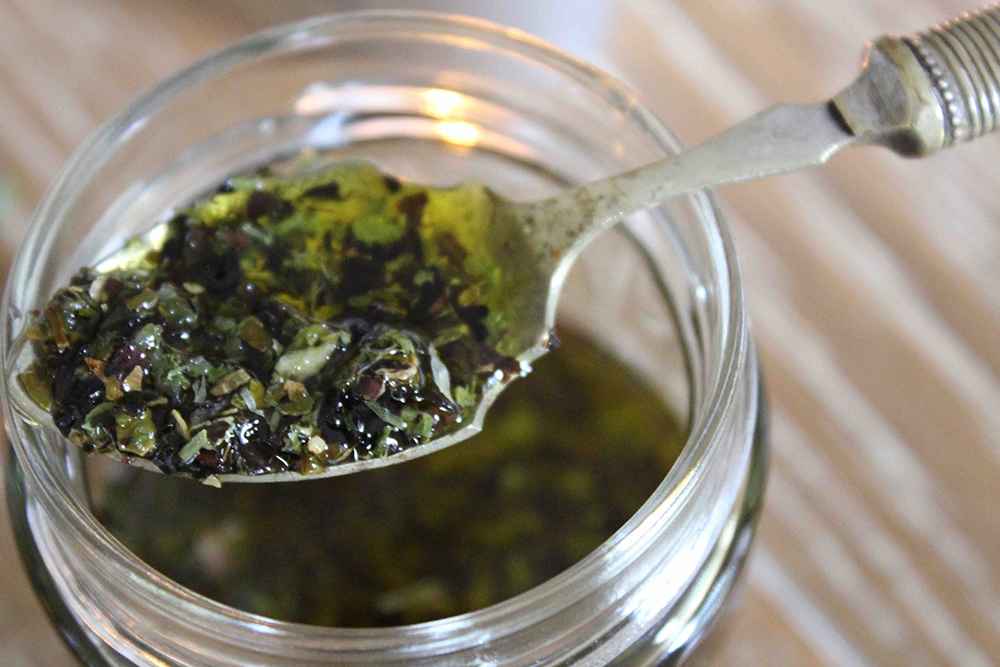
 If size counts - and it certainly does where kids are concerned - GIY’s Know-it-Allmanac is a winner. Checking in at 39cm x 28cm it’s at least twice as big as most books, which is just as it should be for one that aims to be shared around - and to entertain and educate in equal measure. As GIY Founder Michael Kelly says, “The Know-it-Allmanac is funny, colourful, tongue-in-cheek, slightly irreverent, bursting with fun characters, information, trivia and loads of food knowledge. Everywhere you look there’s more to learn, see and a fun gag. Making it really easy for any child to grow and cook it themselves, regardless of how much space they have. Kids of all ages will absolutely love it.” He’s dead right and - especially since we know that the best way to teach adults is through pressure from kids - there should be a copy of this hilarious and refreshingly original month-by-month grow-it-and-cook-it guide in every home. Written by Michael Kelly and Dig in Diner’s Muireann Ní Chíobháin, together with award-winning illustrator Fatti Burke, GIY’s Know-it-Allmanac is published by GIY (hardback, 104 pages; €25); available from all good book shops or online from www.giy.ie.
If size counts - and it certainly does where kids are concerned - GIY’s Know-it-Allmanac is a winner. Checking in at 39cm x 28cm it’s at least twice as big as most books, which is just as it should be for one that aims to be shared around - and to entertain and educate in equal measure. As GIY Founder Michael Kelly says, “The Know-it-Allmanac is funny, colourful, tongue-in-cheek, slightly irreverent, bursting with fun characters, information, trivia and loads of food knowledge. Everywhere you look there’s more to learn, see and a fun gag. Making it really easy for any child to grow and cook it themselves, regardless of how much space they have. Kids of all ages will absolutely love it.” He’s dead right and - especially since we know that the best way to teach adults is through pressure from kids - there should be a copy of this hilarious and refreshingly original month-by-month grow-it-and-cook-it guide in every home. Written by Michael Kelly and Dig in Diner’s Muireann Ní Chíobháin, together with award-winning illustrator Fatti Burke, GIY’s Know-it-Allmanac is published by GIY (hardback, 104 pages; €25); available from all good book shops or online from www.giy.ie.
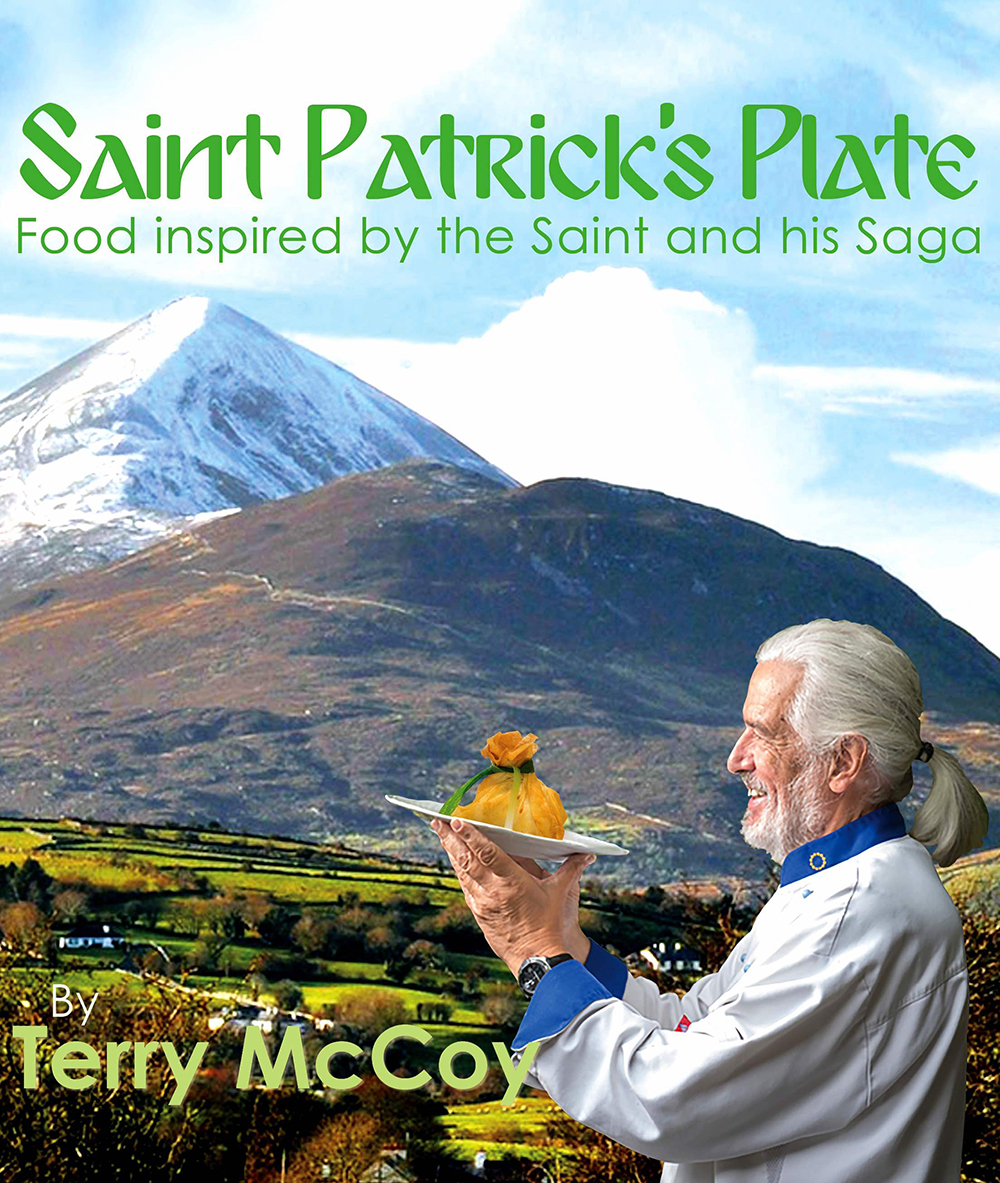 And there’s been another original mind or three at work in Skerries, Co Dublin, where chef Terry McCoy (former owner of the famous Red Bank Restaurant, which he and his late wife Margaret established in 1989), together with associates Fergus Gannon and Joe Shannon, has come up with the fascinating Saint Patrick’s Plate, A Cookery Book Inspired By The Saint And His Saga. St Patrick’s first Irish monastery was established on St Patrick’s Island off the coast near Skerries in 432AD and, ever since he settled in Skerries, Terry has been fascinated by the saint and his saga. Specifically, it struck him how few food references there are in the stories and legends associated with the saint and, thinking about the likely Roman culinary influence of the time, he determined to imagine the healthy, high energy recipes that might have been used in the 5th century. What he ended up with is a collection of over 60 recipes interspersed with stories and legends - and there’s no need to be too concerned that the recipes will be obscure or challenging. Many, including his famous Wild Garlic & Nettle Soup and Skerries Razor Clams (see below), will in fact be reassuringly familiar to fans of the old Red Bank Restaurant - and, for each one, Terry not only provides a relevant introduction but he also devised a section entitled ‘In Patrick’s Time’ to present them in 5th century context. Published in paperback, St Patrick’s Plate costs €19.99 online from www.saintpatricksplate.com and from selected outlets.
And there’s been another original mind or three at work in Skerries, Co Dublin, where chef Terry McCoy (former owner of the famous Red Bank Restaurant, which he and his late wife Margaret established in 1989), together with associates Fergus Gannon and Joe Shannon, has come up with the fascinating Saint Patrick’s Plate, A Cookery Book Inspired By The Saint And His Saga. St Patrick’s first Irish monastery was established on St Patrick’s Island off the coast near Skerries in 432AD and, ever since he settled in Skerries, Terry has been fascinated by the saint and his saga. Specifically, it struck him how few food references there are in the stories and legends associated with the saint and, thinking about the likely Roman culinary influence of the time, he determined to imagine the healthy, high energy recipes that might have been used in the 5th century. What he ended up with is a collection of over 60 recipes interspersed with stories and legends - and there’s no need to be too concerned that the recipes will be obscure or challenging. Many, including his famous Wild Garlic & Nettle Soup and Skerries Razor Clams (see below), will in fact be reassuringly familiar to fans of the old Red Bank Restaurant - and, for each one, Terry not only provides a relevant introduction but he also devised a section entitled ‘In Patrick’s Time’ to present them in 5th century context. Published in paperback, St Patrick’s Plate costs €19.99 online from www.saintpatricksplate.com and from selected outlets.
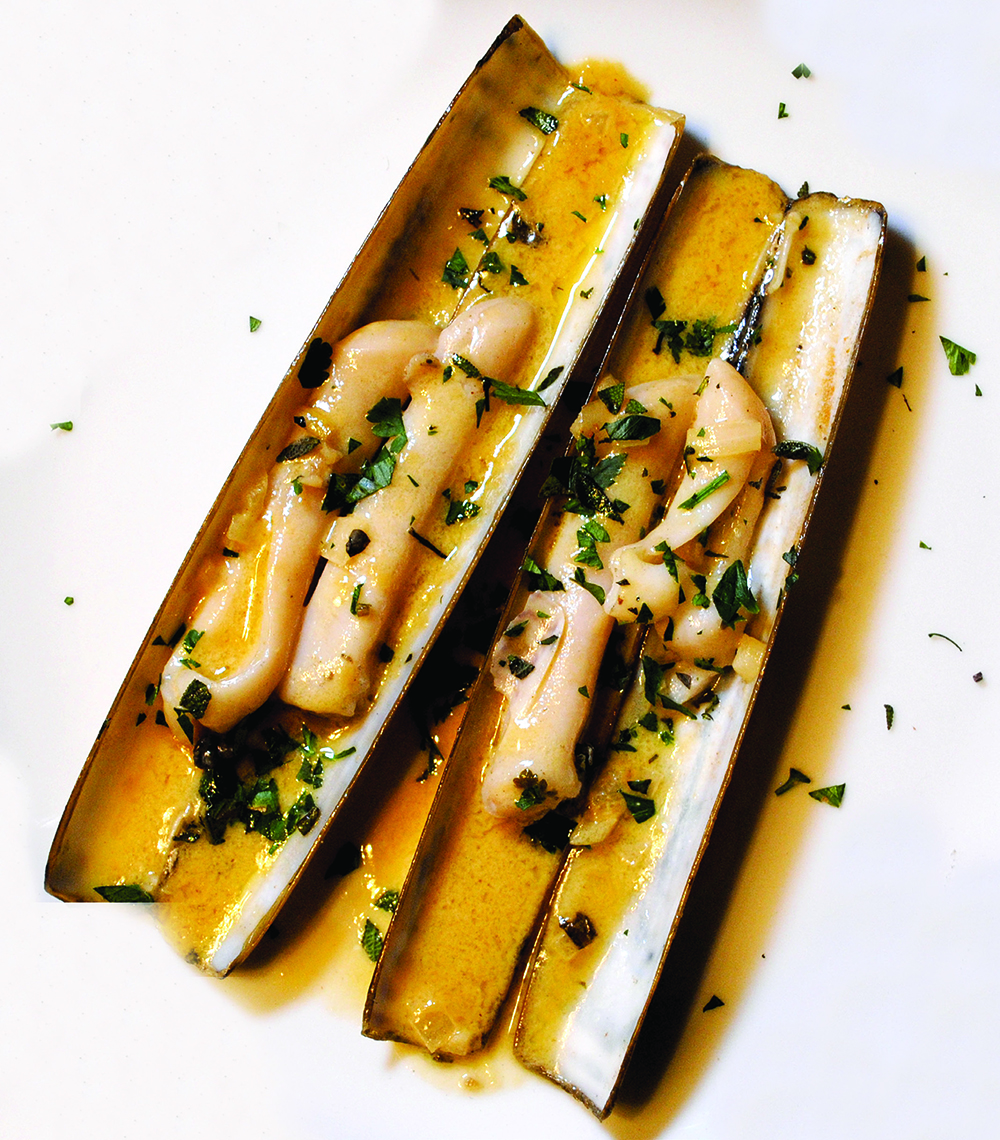 RECIPE: SKERRIES RAZOR CLAMS
RECIPE: SKERRIES RAZOR CLAMS
This is a dish that all the family and friends can become involved in - a razor clam hunt for dinner. Simply choose a beach in a clean area. Skerries on Dublin’s coast is a perfect example - in fact, the locals call the rocks that are only visible at very low tides “Razor Rocks”. Prepare a solution of saturated salted water in a sports drink bottle. Look for the oval shaped dimples of the Razor clam burrows at low water tide. Squirt the solution into several burrows in close proximity. The clams should quickly rise to the surface. Stand in seawater for a few hours to purge them of sand. Cooking the razor clams is really simple and the meat is uniquely sweet.
Ingredients
4 Razor fish per portion
1 Crushed clove of garlic
4 Leaves of Basil (chopped)
3 Sprigs of Parsley (chopped)
Salt & Pepper
1 Knob of unsalted butter
Method
Ensure the razors are purged of sand.
To take the fish from their shells, gently warm the shellfish in water until the
shells begin to open. Remove from the water take all the white asparagus-shaped meat out. The spear should still be alive and pulsing.
Discard any that are not.
Clean the shells and place the live spears on the shells. Arrange 2-4 shells per portion on a serving plate.
In a pan, melt the unsalted butter. Add the crushed garlic, basil and parsley
and sweat for 2 mins. Drizzle this over the arranged plated shellfish.
Place the plated dish under a preheated grill for a short time until the butter
mixture is bubbling and cooking the spears. This is the critical point. If cooked too much the fish will be tough and rubbery. The reward for getting it just right is sensational. Serve with Brown Bread (see Terry’s recipe in the book) and a glass of Sauvignon Blanc or Guinness.
In Patrick’s Time
Like many places the fishing village of Skerries on Dublin’s coast lays claim to a strong St. Patrick’s connection. Legend has it that the Saint founded his first church on St. Patrick’s Island, just off the Skerries coastline. What I can say for sure is that Razor Clams are plentiful along the beaches of Skerries when there is a very low tide. If the legend is true, St. Patrick certainly would have dined on the razor clams for which Skerries is famous.
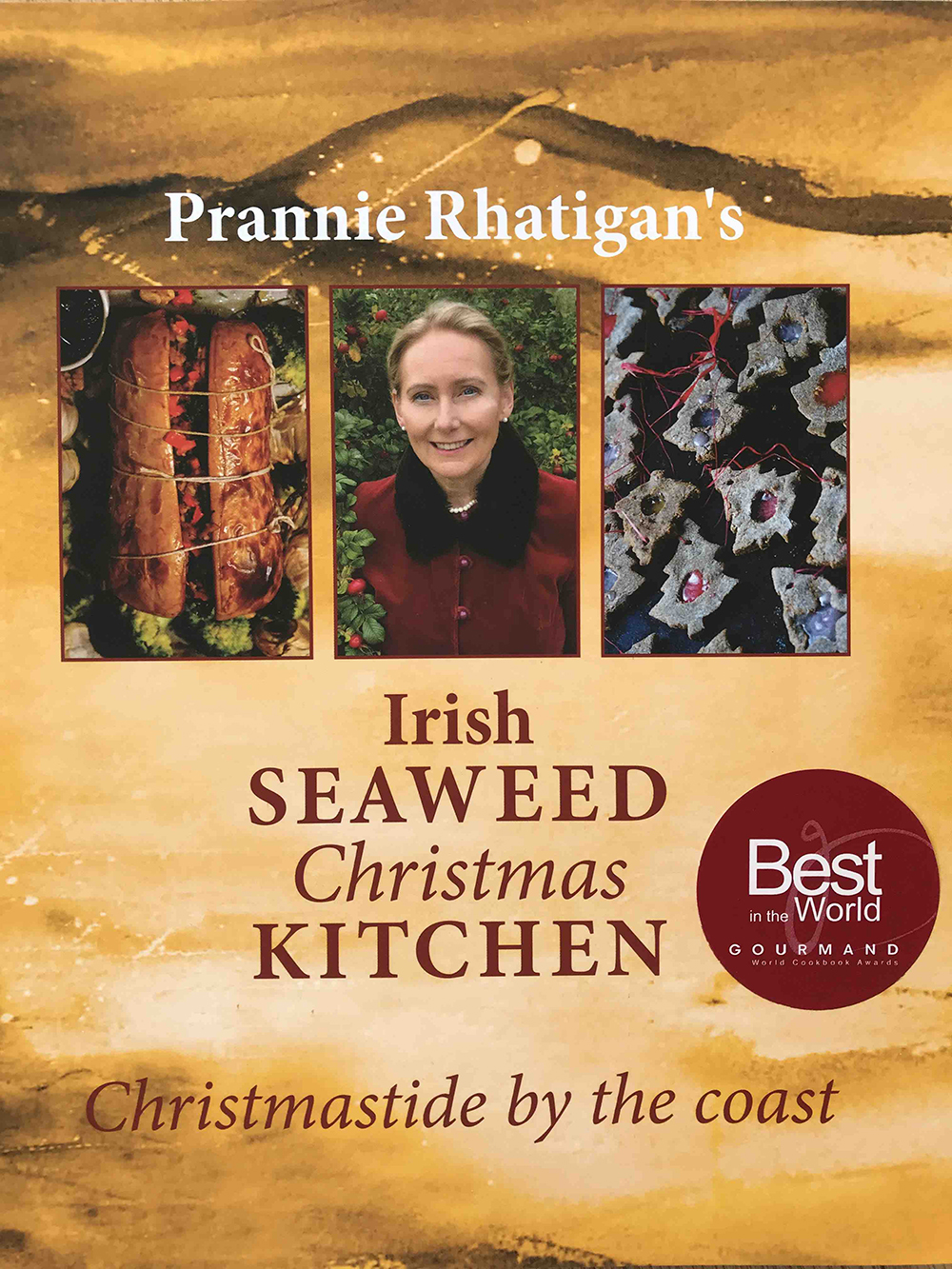 Ten years ago Prannie Rhatigan’s beautiful Irish Seaweed Kitchen took the Irish food world by storm and re-awakened us to the magical ingredients that we have on our foreshores and tidal fringes - and that were once an essential part of everyday cooking in coastal areas. And then, what joy, along came Prannie Rhatigan’s Irish Seaweed Christmas Kitchen. Described as “an exciting food fairy tale taking you from winter solstice to the Women’s Christmas with lots of seaweed cookery adventures in between”, it’s the perfect follow-up with all the warmth and originality that goes with everything that this much-loved Sligo GP and seaweed adventuress does. You’ll find old favourites like plum pudding, mince pies and Christmas cake “without the overload of unhealthy ingredients that everyone wants to avoid at this time of year”; gifts like homemade sea salt and seaweed chocolate; plenty of alcohol to cheer you along towards New Year (think gin soaked duileasc, and Danish juleglögg) and the usual sprinkling of anecdotes that makes Prannie’s books unique. This is one for your own Christmas bookshelf, as well as making a lovely gift. [Softback, 186 pages, full colour. www.irishseaweedkitchen.ie]
Ten years ago Prannie Rhatigan’s beautiful Irish Seaweed Kitchen took the Irish food world by storm and re-awakened us to the magical ingredients that we have on our foreshores and tidal fringes - and that were once an essential part of everyday cooking in coastal areas. And then, what joy, along came Prannie Rhatigan’s Irish Seaweed Christmas Kitchen. Described as “an exciting food fairy tale taking you from winter solstice to the Women’s Christmas with lots of seaweed cookery adventures in between”, it’s the perfect follow-up with all the warmth and originality that goes with everything that this much-loved Sligo GP and seaweed adventuress does. You’ll find old favourites like plum pudding, mince pies and Christmas cake “without the overload of unhealthy ingredients that everyone wants to avoid at this time of year”; gifts like homemade sea salt and seaweed chocolate; plenty of alcohol to cheer you along towards New Year (think gin soaked duileasc, and Danish juleglögg) and the usual sprinkling of anecdotes that makes Prannie’s books unique. This is one for your own Christmas bookshelf, as well as making a lovely gift. [Softback, 186 pages, full colour. www.irishseaweedkitchen.ie]
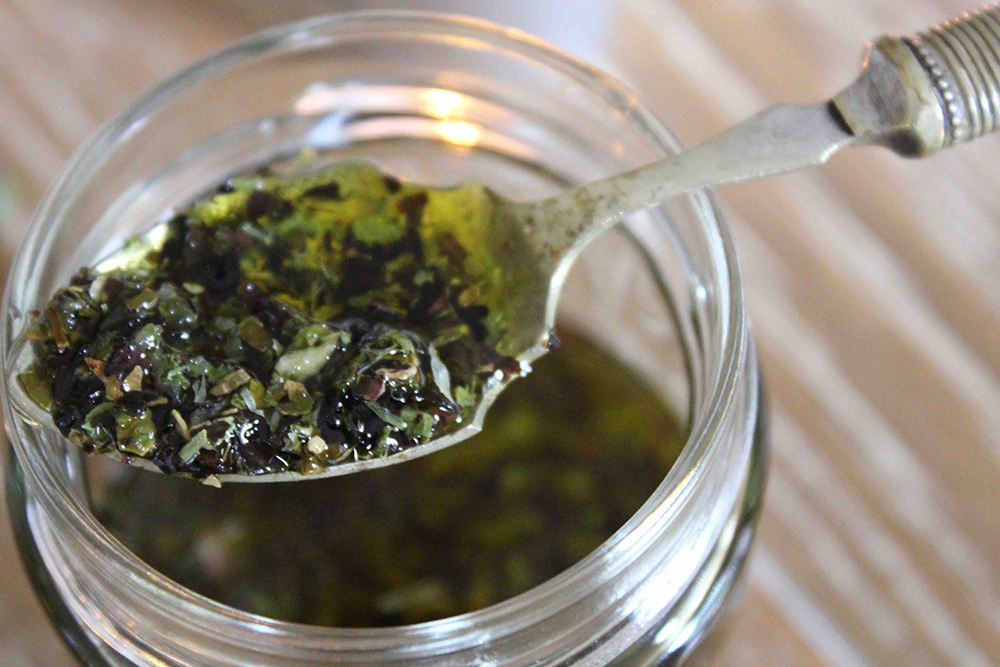 RECIPE: Seaweed Blend Pesto
RECIPE: Seaweed Blend Pesto
We can all use a touch of magic in the kitchen, especially at Christmas. Add a dollop of pesto and transform the plainest store cupboard staples into snacks that can certainly go to the ball... A magic wand in a jar. This recipe uses Prannie’s own dried seaweed blend (available to purchase https://irishseaweedkitchen.ie/irish-seaweed-kitchen-shop/) and it makes a lovely small gift to bring along when visiting friends and family.
Makes 5 servings; Seaweed used: dried seaweed blend
1 rounded tablespoon dried seaweed blend
5 tablespoons best quality olive oil
clove of garlic, pressed
Tip the seaweed into a small glass jar with a lid
Add the olive oil and hint of garlic.
Stir well and use at once or store in the fridge for up to five days.
Drizzle over rice cakes, baked sweet potatoes, roast vegetables, pasta, rice noodles, tofu, smoked salmon and cheeses.
Book Review- Cornucopia- The Green Cookbook
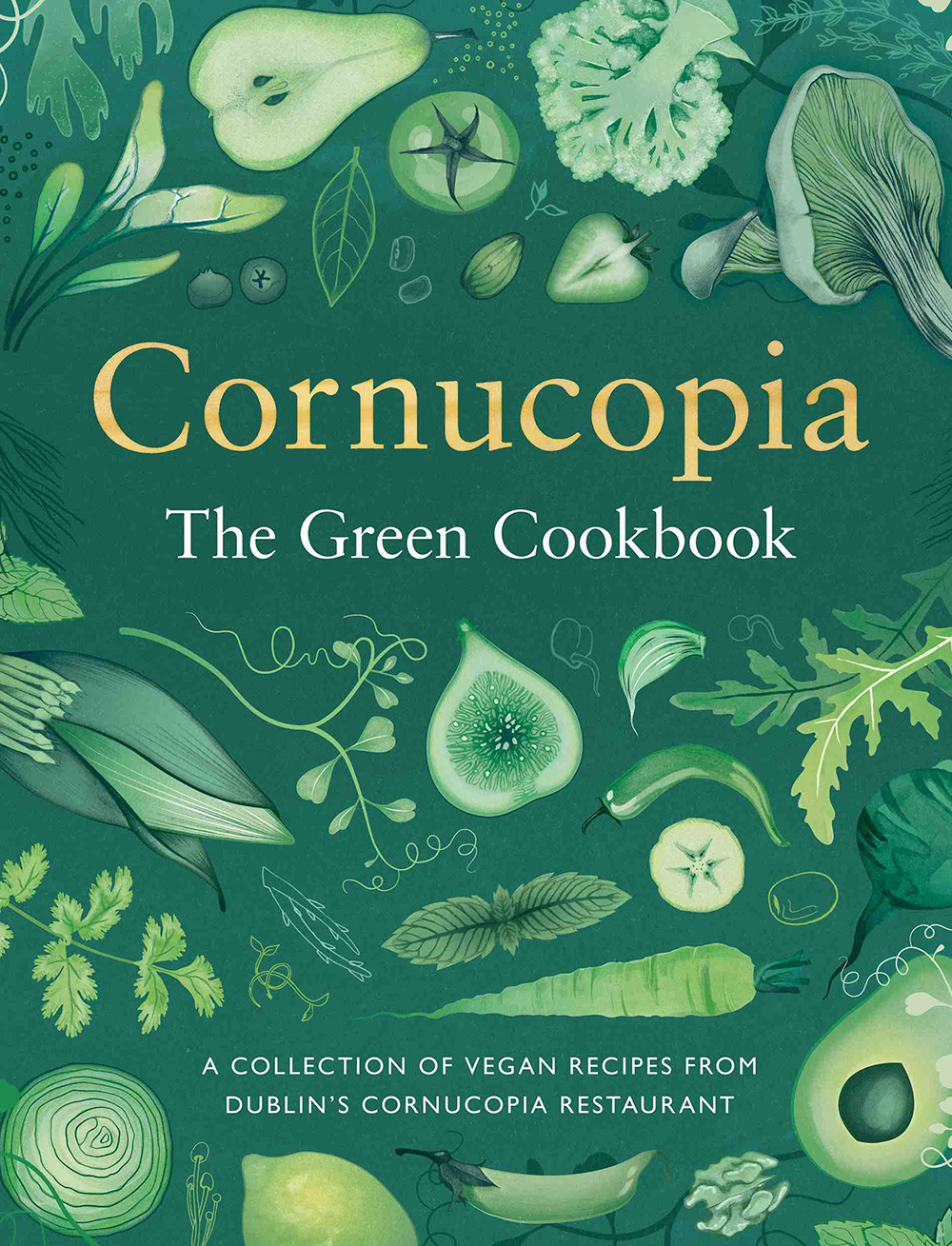
 Modestly described on publication as “A timely cookbook from Ireland’s plant-based pioneers”, Cornucopia: The Green Cookbook went on to win the Avoca Cookbook of the Year 2019 title at the An Post Irish Book Awards within weeks of hitting the bookshops - a well-deserved accolade for a beautifully produced book and the team behind one of Dublin’s best-loved and longest established restaurants.
Modestly described on publication as “A timely cookbook from Ireland’s plant-based pioneers”, Cornucopia: The Green Cookbook went on to win the Avoca Cookbook of the Year 2019 title at the An Post Irish Book Awards within weeks of hitting the bookshops - a well-deserved accolade for a beautifully produced book and the team behind one of Dublin’s best-loved and longest established restaurants.
Following a life-changing spell working at the Hippocrates Health Institute in Boston, Deirdre McCafferty and her late husband Neil returned to Ireland and established Cornucopia in 1986. While their vegetarian ethos is central to Cornucopia, it has always been a place to be enjoyed by all and its story - told by Head Chef Tony Keogh, food writer Aoife Carrigy, the Cornucopia chefs and the owners, mother and daughter Deirdre and Dairine McCafferty - is inspirational. It’s a great read, with happiness, job satisfaction and a sense of community shining through on every page.
This is the second Cornucopia Cookbook - the first, Cornucopia at Home, The Cookbook, was published in 2008, and was vegetarian. Now, with The Green Cookbook, they have taken the ethos further and, like most of the dishes served in the restaurant these days, the recipes are all vegan.
I have reservations about the current rush to veganism and, while I am a keen gardener and love plant-based food, I dislike vegetarian and vegan dishes created to ape traditional meat dishes - so, for example, I would find the tasty stew recipe given below more appealing if it had a less imitative title. And the nutritional challenges of veganism are barely touched on in The Green Cookbook. This is the elephant in the room, but perhaps as a restaurant serving individually delicious meals to happy customers, as opposed to being responsible for their overall dietary choices and any lasting effects that they may have, the educational responsibility is not theirs. It certainly doesn’t detract from the fact that this is an excellent recipe book from an exceptional team and the press release puts it very fairly:
“The mission at Cornucopia has always been to make great-tasting, home produced, healthy, vegetarian and vegan food. At a time when plant-based eating is more popular than ever, they are pioneers in creating delicious, hassle-free meals packed with veg.Whether you are a vegetarian, vegan or are trying to cut down on your meat intake, this book brings you punchy flavours, satisfying dishes, a dash of urban cool and a refreshing take on the conventional stereotype of vegan food. The dishes are flexible and include ingredients that can
be easily sourced, allowing you to make healthy and delicious meals for any occasion.This is a cookbook for anyone who feels there is merit is reducing or limiting our consumption of animal-based food products from a trusted team of chefs.”
The main author, Head Chef Tony Keogh, acknowledges that creating good vegan dishes can take more time and effort than conventional cooking, but the recipes are categorised as ‘Simple’ Moderate’ and ‘Complex’ to help you choose something that will suit your mood and available the time - and there is no shortage of helpful guidelines.
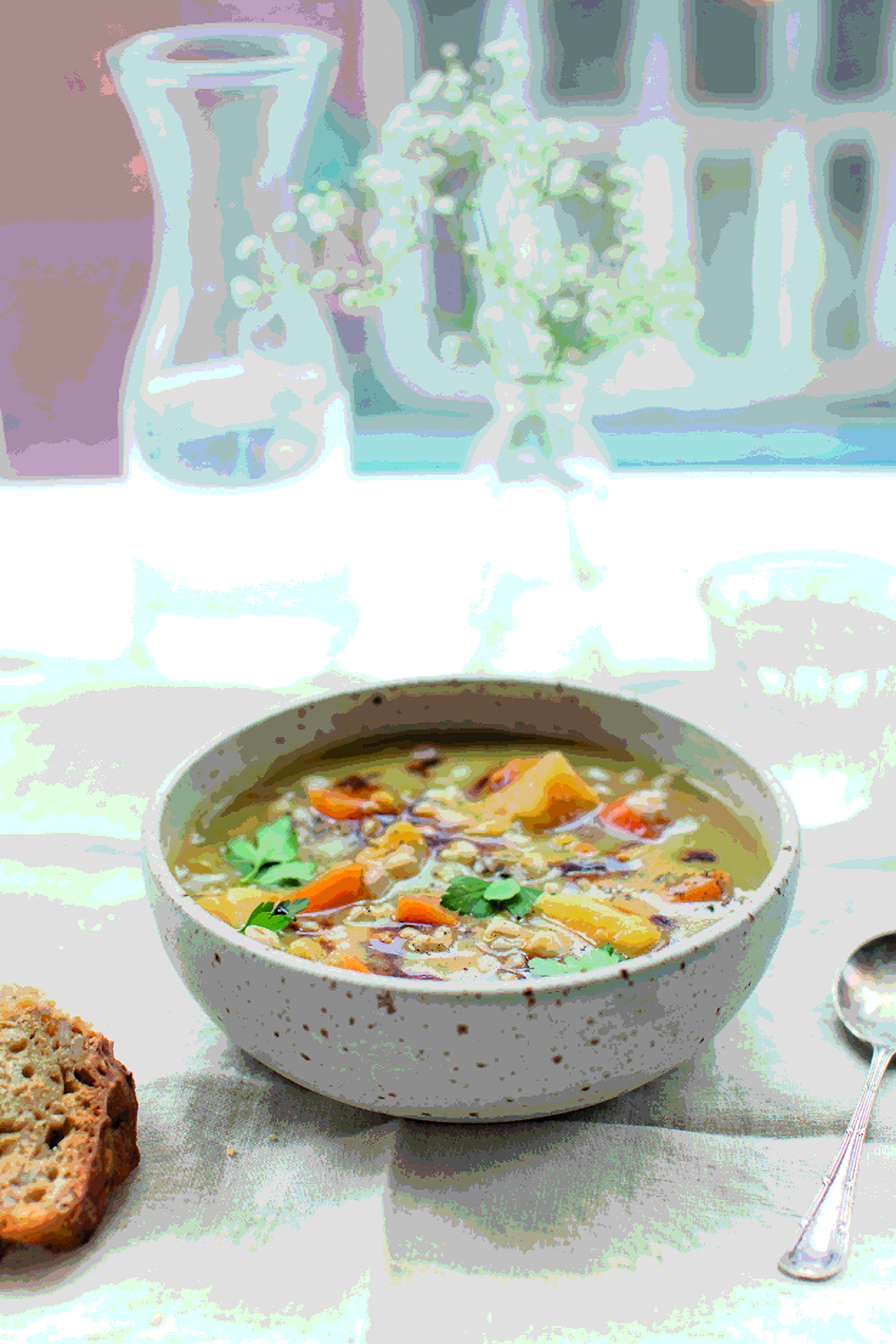 SAMPLE RECIPE: Cornucopia’s Quick Irish Stew
SAMPLE RECIPE: Cornucopia’s Quick Irish Stew
“Our twist on an Irish classic is a huge hit in the restaurant during theannual St Patrick's Day festival. This is a simpler version and is perfect for whipping up at home when you want some comfort food, fast. Made with a variety of local root vegetables and a meat substitute of your choice, it is a warming, nutritious option for a cold Irish day. Roasted mushrooms or aubergines also work well, though they are certainly not as traditional. Serve it up with vegan soda bread or a crustyspelt boule.”
SERVES 6 • GF WF
SIMPLE
75g gluten-free oat groats (or pot barley)
3 large onions, sliced
4–5 medium carrots, diced
3 leeks, white parts only, rinsed and sliced
3–4 bay leaves
1 small bunch of fresh thyme
2 litres stock, homemade or shop-bought
850g floury potatoes, peeled and diced
100ml tamari, or good-quality soya sauce
3 tablespoons vegan Worcestershire sauce
1 tablespoon Dijon mustard
salt and freshly ground black pepper
rapeseed oil
TO SERVE (OPTIONAL)
300g prepared tempeh (soy product made from fermented soybeans), or
seitan (protein rich wheat gluten)
vegan Worcestershire sauce
YOU WILL NEED
stick blender and jug or high-speed blender
twine
Cook the oat groats (or pot barley, if using) according to packet instructions.
Heat a tablespoon or two of oil in a large heavy-based saucepan over a high heat, add the onions, carrots, leeks and bay leaves and sauté for a good five minutes until softened and browned.
Pour in the stock and add the thyme bunch, tied with twine. Bring to a rolling simmer, add the potatoes and reduce the heat to medium. Cook at a gentle simmer for about 20 minutes or until the vegetables are nicely cooked. Remove from the heat and fish out the bay leaves and the tied thyme.
Take a couple of ladles of solid matter from the stew and put it in the blender along with the tamari (or soya, if using), Worcestershire andmustard. Blend to a smooth purée before stirring it back into the stew.
Add the cooked oats (or barley) along with the tempeh (or seitan) andseason to taste before serving. This is lovely with an extra swirl ofWorcestershire sauce on top.
TIP
*We like to keep our recipes gluten-free where possible, so we use tamari, gluten-free oats and tempeh in this recipe. If gluten-free ingredients are not a priority for you, you could substitute a good-quality soya sauce for the tamari, pot barley for the oats and seitan for the tempeh.
Cookery Feature - Maura O�Connell Foley�s Recipes & Recollections
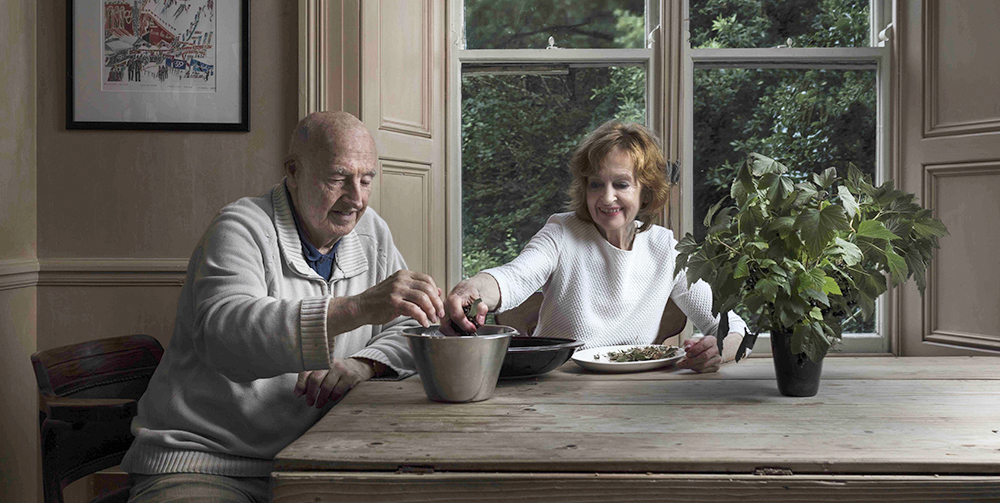
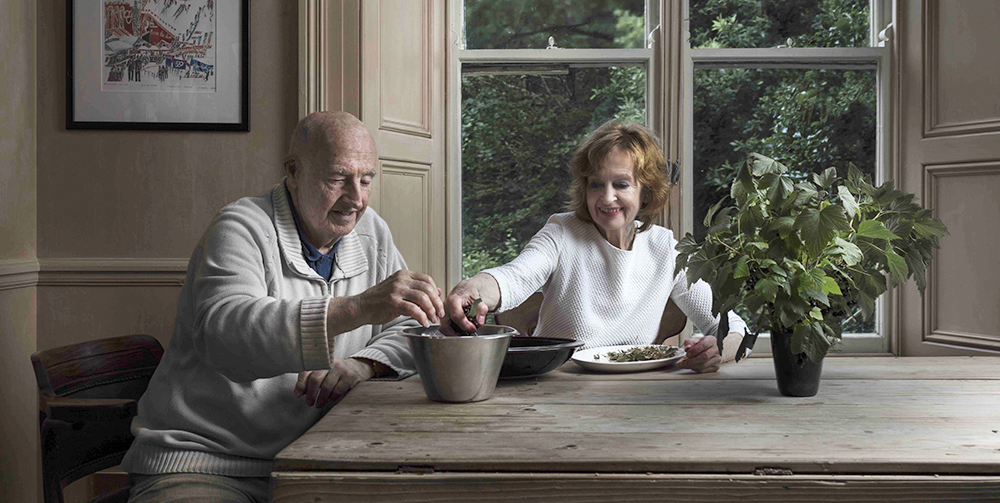
Hardly into Q2 of this extraordinary year, we have another book by an exceptional figure in Irish food. In February, Jp McMahon’s The Irish Cookbook hit the culinary headlines with its well researched and passionate celebration of this bountiful island and the cooking traditions that are so often dismissed; a wonderful gift to a new generation of cooks by one who revels in exploring the good things in our food culture.
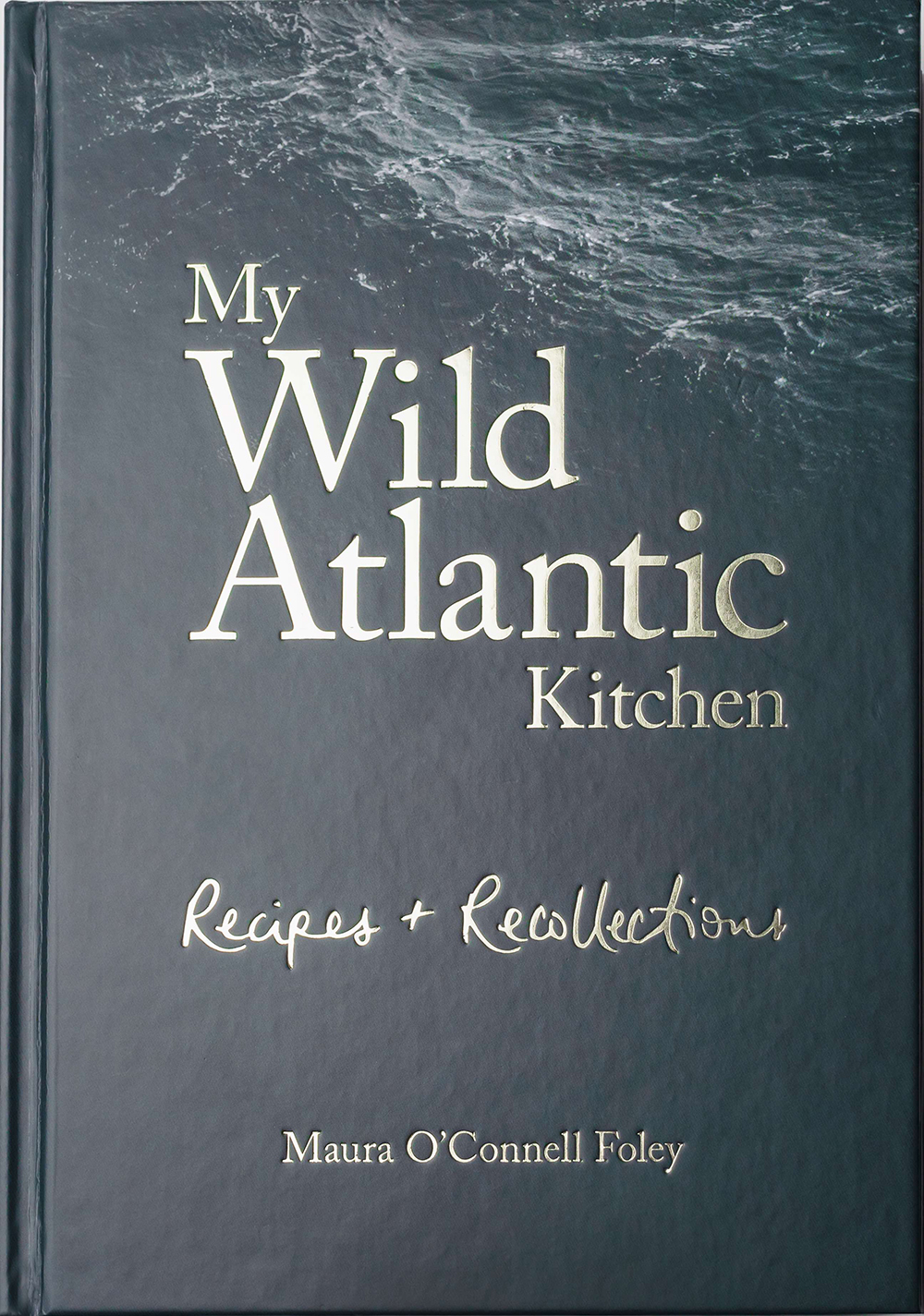 And, then came Kenmare chef Maura O’Connell Foley’s beautiful labour of love, My Wild Atlantic Kitchen, Recipes & Recollections – and what a joyful feast it is. With its meaningfully understated cover, moody Kerry landscapes and seascapes by Norman McCloskey, illustrations by artist Christine Bowen, and paintings from Pauline Bewick interspersed among over 250 favourite recipes that she has cooked over six decades, the book itself is a perfect expression of Maura’s personality and talents. (The imprint page at the back gives the team credits.)
And, then came Kenmare chef Maura O’Connell Foley’s beautiful labour of love, My Wild Atlantic Kitchen, Recipes & Recollections – and what a joyful feast it is. With its meaningfully understated cover, moody Kerry landscapes and seascapes by Norman McCloskey, illustrations by artist Christine Bowen, and paintings from Pauline Bewick interspersed among over 250 favourite recipes that she has cooked over six decades, the book itself is a perfect expression of Maura’s personality and talents. (The imprint page at the back gives the team credits.)
Maura shares the values of simplicity and careful cooking of local seasonal ingredients that made the late Myrtle Allen an iconic figurehead in the development of modern Irish food and, while not a household name in the way that Myrtle was, Maura has also been a leader throughout her long and very successful career. As well as building a loyal customer base over the years - including the playwright John B Keane, a regular “who came especially from Listowel for the scallops with Noilly Prat!” – Maura has always commanded great respect amongst her peers. Derry Clarke spoke for many when he said in his lovely Introduction: “As a fellow chef, I am proud to know her and respect her for all her achievements.”
What I really love about this book is that everything is in context – we know that Maura ‘never made the time’ to write it before, despite numerous invitations over the decades to do so, and now, with the help of family and some special friends, it has emerged not only as an expression of her life’s work and family influences but also a fascinating record of Kenmare and its development as a food destination over that time (in which she has played a key role).
The introductory section, My Life in Food, Early Life and Influences, is a wonderful read, vividly recalling the people and circumstances that made Maura the chef and – at the wonderful Shelburne Lodge, which she still runs with her husband Tom – host that she is today. We learn, for example, of her special love of fish and the fish cookery for which she is best known; opening the original Purple Heather Tea & Cake Shop with her mother Agnes in 1961 and then developing it in new premises as a restaurant and piano bar (still run by her sister, Gráinne); of early professional influences including Theodora FitzGibbon, Elizabeth David, Declan Ryan, Julia Child, Myrtle Allen and many of the great names of Irish food and hospitality in the 1970s and ‘80s; meeting Tom in 1975 and, after a whirlwind romance, marrying him just two months later; opening The Lime Tree with him in 1985 and, using her love of art and superb eye for interiors to create an atmospherically rustic space featuring Irish artwork, local pottery from Louis Mulcahy and Irish tweed; doing a stage with Sonia Stevenson at The Horn of Plenty in the early ‘80s; starting up Packies (later taken on by chef Martin Hallissey) in the early 1990s and restoring Shelburne Lodge, which they have now run with great style since 1996…
The recipes and chapter introductions continue in the same vein and, for me, that’s what makes them special. Many of the recipes are classics, or versions of well known dishes, but the way that Maura sets them in context makes them unique. The sample recipes below have been selected for their seasonality, expression of Maura’s love of local and artisan produce and possible use as an Easter menu, if circumstances permit; Kerry mountain lamb is not in season until later in the year, but lowland spring lamb can be used or even frozen mountain lamb from last autumn if available. The salmon dish is an echo of Richard Corrigan’s comment on the back cover: “The last time I stayed at Shelburne Lodge, Maura cooked me wild salmon, seared lightly and served with a lemon sauce for my breakfast. It was the finest start to the day I’ve ever had.”
My Wild Atlantic Kitchen: Recipes and Recollections by Maura O’Connell Foley (Hardback, 408pp; Design by Anchor Studio, Art director & Food Stylist Joanna Resiak. RRP €35, from www.mywildatlantickitchen.com and selected
independent bookstores, hotels and stores nationwide, or from Amazon.
RECIPES
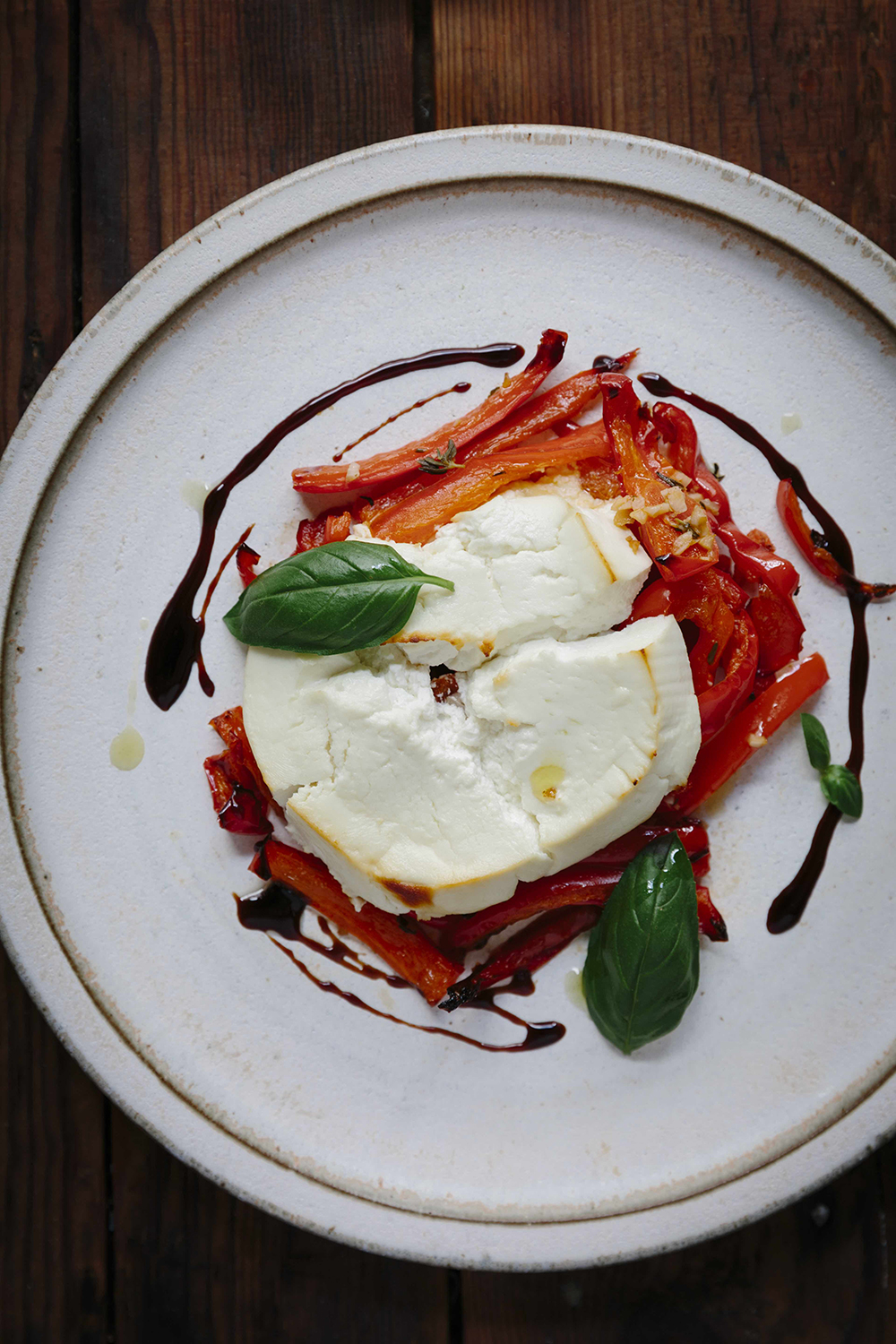 ST TOLA IRISH GOAT'S CHEESE & WARM RED PEPPER SALAD
ST TOLA IRISH GOAT'S CHEESE & WARM RED PEPPER SALAD
Meg and Derrick Gordon started St Tola Goat's Cheese in the 1980s in Inagh, Co. Clare. Gerry Galvin of Drimcong, Galway first introduced me to their cheese. He was a terrific chef and I was fortunate to do a great course in Drimcong. Every Monday when in The Lime Tree, three logs were posted to me, beautifully packaged with great care. The cheese was astounding, it came out of the oven like a soufflé! Siobhan Ni Ghairbhith, who took over business in the late 1990s, shared the same passion as the Gordons and has developed it into one of the finest farmhouse goat's cheese in Ireland. Serve with beetroot, apple and toasted almonds, hazelnuts or pine nuts as an alternative to the peppers.
Ingredients
Serves 4
Red Pepper Mixture:
• 3tbsp olive oil
• 4 red peppers, cored, seeded and sliced into batons
• 16 large fresh purple garlic doves, peeled and finely chopped
• 1 tsp fresh thyme, basil or rosemary leaves
• 1 tbsp red wine vinegar
Goat Cheese Salad:
• 4 portions of stewed red pepper mixture
• 4 slices of St Tola Irish Goat's Cheese Original Log about 2cm/ ¾ in)
• 4 handfuls of organic leaves
• Bunch of fresh basil leaves
• 4 tbsp citrus vinaigrette
Method
First make the citrus vinaigrette (see below).
Heat the oil in a large stainless steel saucepan, then add the peppers, garlic, thyme and vinegar. Reduce the heat and stew for approximately 10-12 minutes. Do not allow to brown. These can be kept in the fridge sealed in a jar for up to a week and taken out and warmed when needed. These form the base for the salad.
Preheat the oven to fan 200°C / fan 400°F / gas mark 7 or preheat the grill to medium. Prepare the peppers or, if they were prepared in advance, warm them first in a saucepan. Place the warm peppers, divided into 4 portions, in a suitable dish for the oven or grill. Place a slice of goat's cheese on top of each pepper portion. Bake in the oven for about 5-7 minutes or grill for 3-4 minutes or until the cheese is lightly golden at the edges.
To serve, use a fish slice to place each serving of peppers and goat's cheese in the centre of each plate. Spoon the reduced balsamic around the peppers and goat's cheese. Dress the leaves in a bowl; serve on the side or separately.
Citrus vinaigrette: Put 2 tbsp orange or lemon juice, 2 tsp local honey (warmed to help it combine) and 1 tsp Dijon mustard into a jar, seal tightly and shake vigorously. Add 4 tbsp extra virgin olive oil, 1 tbsp chopped herbs of choice (tarragon, chives, coriander, oregano or basil, depending on salad ingredients); season with sea salt and cracked black pepper and shake again. Taste and adjust to your liking.
Serving suggestion: 4 tbsp reduced balsamic (250ml/9 fl oz balsamic vinegar and 2 tbsp honey, reduced to about half over medium-low heat).
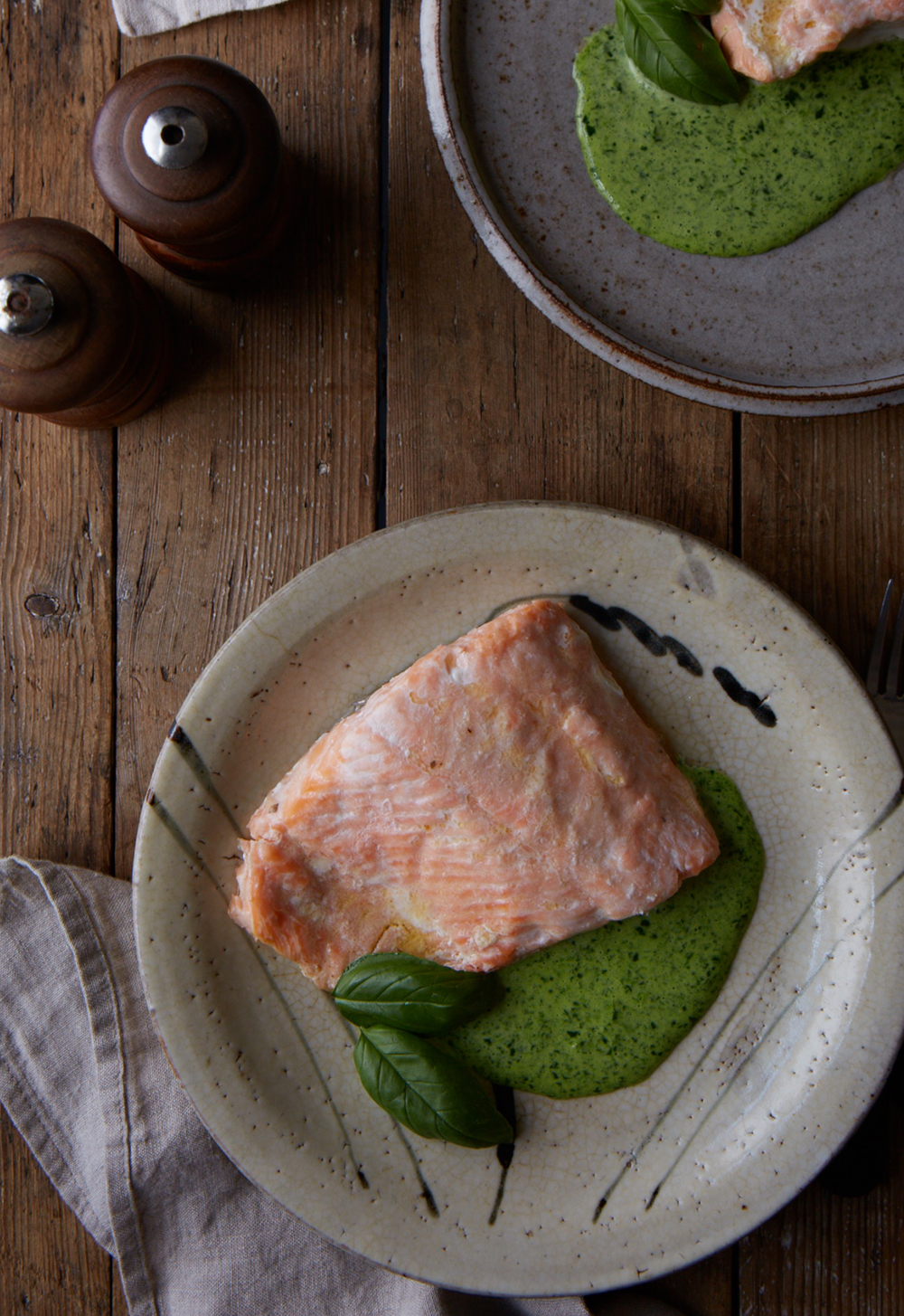 BAKED FILLET OF WILD SALMON WITH WILD SORREL HOLLANDAISE
BAKED FILLET OF WILD SALMON WITH WILD SORREL HOLLANDAISE
If you can, use spring wild salmon. They are oilier than summer wild salmon, and more robust and flavoursome by nature. Wild salmon is delicious on its own with a simple hollandaise. I served it in abundance in the 1960s. I used to stand over the stove, whisking the cold butter into my egg to get an emulsion, sometimes making a few batches a day. I spent over 20 years making it in the traditional classic fashion! Thankfully in the mid 1980s Sonia Stevenson (renowned founder of The Horn of Plenty in Devon) taught me the swift way to make hollandaise (see below) with melted butter, which is just as light and delightful.
[Note: The Wild Sorrel Hollandaise given here is ideal in spring. Maura also gives a Gooseberry, Elderflower & Lime Sauce: “With elderflowers in abundance from mid-May to June, this is the best time to showcase them in this fragrant sauce”.]
Ingredients
Serves 4
• 4 salmon fillets, wild if possible
• 55g / 2oz cold butter, cut into small pieces
• Sea salt and cracked black pepper
Wild Sorrel Hollandaise:
1 quantity of swift hollandaise sauce (see below)
Handful wild sorrel leaves, washed and dried
Serving suggestions (recipes all given in the book): Colcannon, roast fennel, fresh wilted spinach, sugar snaps
Method
Preheat the oven to fan 200°C / fan 400°F / gas mark 7. Lay out four large square pieces of foil and place each fillet on a sheet, skin side down. Season with salt and pepper then dot butter over each fillet. Fold up the sides of each foil square and loosely wrap and seal. Bake in the oven for 8-10 minutes or until cooked to your liking.
Serve with Wild Sorrel Hollandaise:
Make your hollandaise (see below). When the hollandaise is complete, add a handful of wild sorrel to the blender and blitz until it is blended - it will take only 10-20 seconds. The salmon is also delicious with hollandaise on its own. Serve with a sprig of fennel.
Swift Hollandaise Sauce
My first encounter with hollandaise was in a Swiss restaurant, Maison Suisse, owned by two sisters in London in the 1950s. My aunt brought me there as a teenager on special occasions. I remember vividly the chicken dish with a white wine cream sauce, the one both my aunt and I especially went for. They also served globe artichokes with hollandaise, and, being my first taste of the sauce, I was in awe. To this day it is still one of my favourite sauces. This basic swift hollandaise is thanks to Sonia Stevenson and to a food processor. The butter must be hot and foaming and initially added slowly to the processor.
Ingredients Makes 200-250ml/ 7-9fl oz
Egg Base:
• 225g/8oz butter
• 2 tbsp cold water
• 2 egg yolks
• Swift Method: 1 tbsp fresh lemon juice, more to taste if needed
In a small saucepan, melt the butter until it starts to boil then remove from the heat. Meanwhile, place the water and yolks in a food processor and blend until pale and fluffy. Very gradually start to pour the hot foaming butter via the funnel into the processor, keeping the motor running, until it starts to emulsify. You can then add the remaining butter more swiftly while still hot. Add lemon juice via the funnel and blend. Add more to taste if needed. Transfer the hollandaise into the saucepan used to melt the butter and cover with a lid. If not serving immediately, place the saucepan over another saucepan of hot water to keep warm until serving.
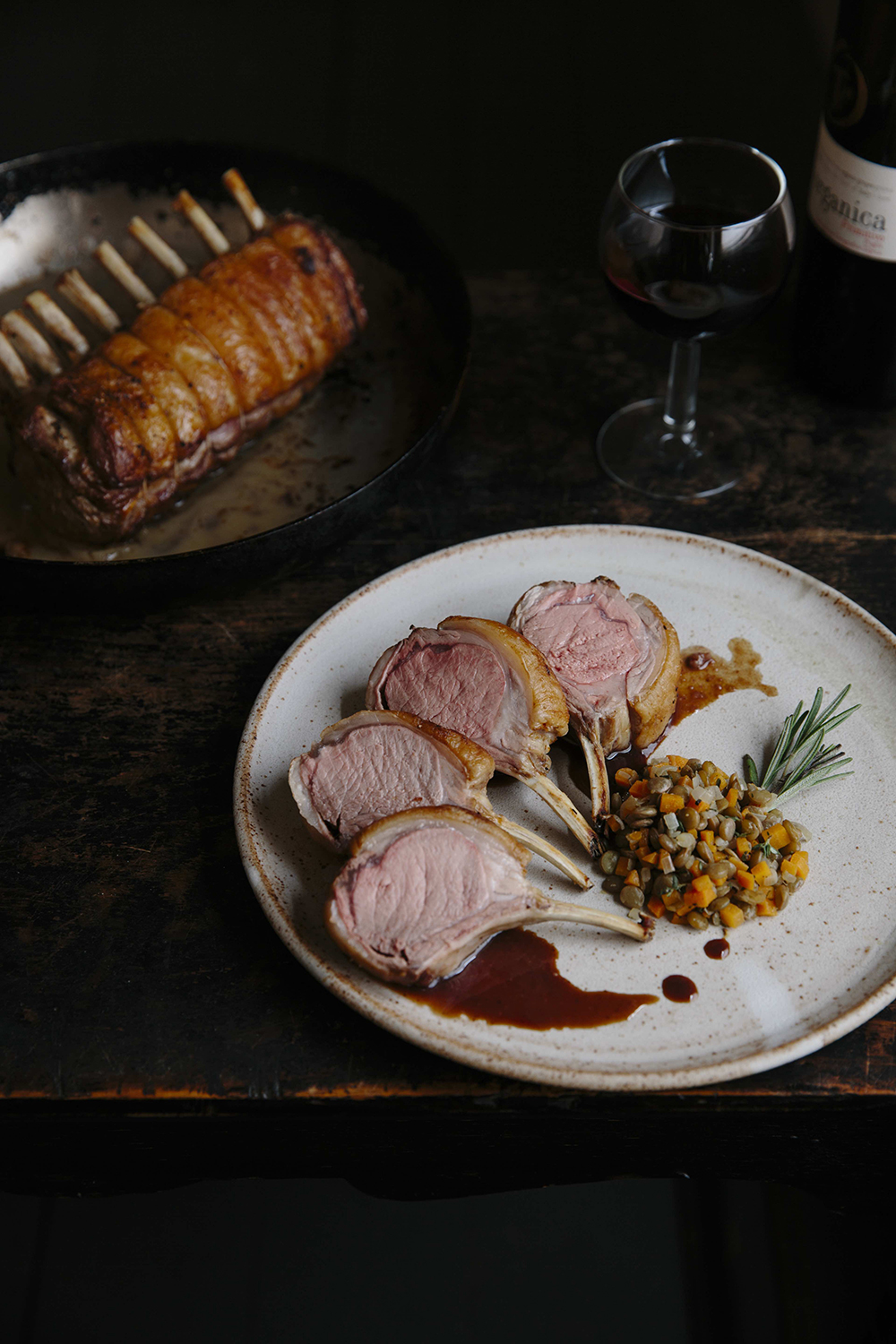 RACK OF LAMB WITH PUY LENTILS AND RED WINE SAUCE
RACK OF LAMB WITH PUY LENTILS AND RED WINE SAUCE
Our Kerry mountain lamb feeds on the beautiful wild mountain herbs giving it its distinct and special flavour. Kerry lamb is used in all good kitchens and Connemara lamb is equally fantastic.
[In the restaurant, before we roasted the lamb, we would divide the best end into two [allowing a rack of 4 cutlets per portion. We cooked the rack whole and sliced it into 4 cutlets per portion before serving. Fat should be left on the meat to protect it and give it a greater flavour. In spring and early summer, paloise is a superb sauce to accompany the lamb - this is a bearnaise using mint instead of tarragon - or it can be served with a fast and easy red wine jus, using the residue in the roasting pan. In late summer and autumn, a stronger flavoured rich red wine sauce can be used, enhanced with rosemary and garlic (the recipes are all given in the book).
Ingredients
Serves 4
• 2 best ends of lamb with fat on, French trimmed by your butcher (4 racks of 4 cutlets per person, each rack cooked whole)
• 20g / ¾ oz butter, melted
• 250g/9oz puy lentils (or dark speckled), washed under water until the liquid is clear
• 55g/2oz butter
• 3 shallots, finely diced
• 2 medium carrots, peeled and finely diced
• 1 tbsp fresh thyme leaves, chopped
• Sea salt and cracked black pepper
• Choice of sauces as mentioned above
• A few sprigs of rosemary, to garnish
Serving suggestions (all recipes given in the book): Buttered carrots, colcannon, roast beetroot, sugar snaps with mint, garden peas.
Method
Preheat the oven to fan 200°C / fan 400°F / gas mark 7.
Brush the meat with the melted butter on both sides. Heat an ovenproof pan over a medium-high heat. Add the lamb fat side down to seal for 2-3 minutes per side or until all the fat is golden brown.
Move the pan into the oven and cook for about 20 minutes for rare, 25 minutes for medium rare, or longer depending on how well cooked you would like the lamb. Cooking time will depend on the meat. Remove the lamb from the pan and rest for 10 minutes.
To make the lentils, add the lentils to a small saucepan and cover with cold water. Bring to the boil, then reduce to a simmer and cook for 15-20 minutes or until the lentils have just a small bite to them. Drain and rinse well. In another small saucepan, melt the butter over a low-medium heat. Add the shallots, cover and sweat gently for 10 minutes or until very soft. Stir in the carrots and thyme and sweat for a further 5 minutes. Stir in the lentils and season to taste.
Serve 4 cutlets per person with the puy lentils and sauce.
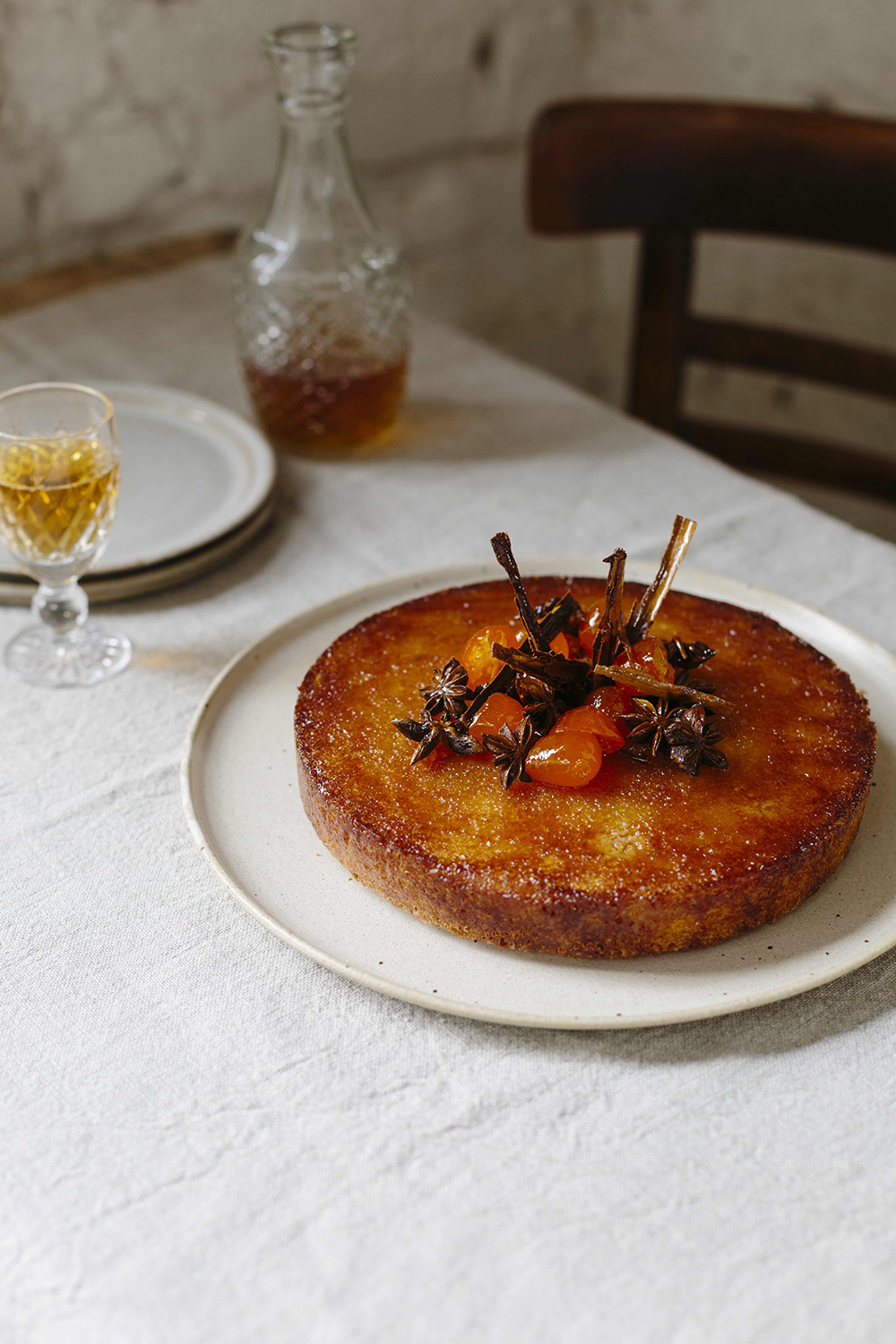 TUNISIAN ORANGE CAKE
TUNISIAN ORANGE CAKE
This is a favourite cake in my family and it was requested by my daughter and son-in-law for their wedding. I made numerous batches which were for the dessert and when I was making the main cake, my Rational oven decided to give up during the process! My good friend James Mulchrone of Jam Cafés kindly came to my rescue and produced the most exquisite large Tunisian cake. It was a work of art. This cake is worth making in double quantities just so one can be frozen for later. For a special occasion, add 2 tbsp of Grand Marnier to the syrup.
Serves 8-10
Ingredients
Cake:
• 45g / 1½ oz fresh soft white breadcrumbs
• 200g / 7oz caster sugar
• 100g / 3½ oz ground almonds
• 1 tsp baking powder
• Zest of 1 orange
• Zest of ½ lemon
• 200ml / 7fl oz sunflower oil
• 4 medium eggs, at room temperature
Syrup:
• Juice of 1 orange
• Juice of 1 lemon
• 70g / 2½ oz sugar
• ½ cinnamon stick
• 5 star anise
• 6-7 kumquats, cut in half
Serving suggestion: Clotted cream
Method
Line and grease a 20cm / 8in spring-form cake tin.
In a large bowl, mix together the breadcrumbs, sugar, ground almonds and baking powder, then add the orange and lemon zest. In a separate bowl, lightly whisk together the oil and eggs. Pour the egg and oil mixture into the dry ingredients and combine well.
Pour the cake batter into the prepared tin and place in a cold oven. Turn the oven to fan 180°C / fan 350°F / gas mark 6 and bake for 40-45 minutes or until a skewer inserted comes out clean. Allow the cake to cool in the tin for 5 minutes, then turn out upside down onto a large plate.
To make the syrup, combine all the ingredients in a small saucepan and gently bring to the boil, stirring to dissolve the sugar. Boil for 2 minutes to a light syrupy consistency. Take out the spices and kumquats and reserve for decoration.
While the cake is still warm, use a thin steel skewer to poke holes over the cake. Slowly pour over the syrup, allowing it to be absorbed before adding more.
Decorate the cake with the reserved spices (splitting the cinnamon stick is effective), kumquats and serve with clotted cream.
Cookery Feature - The Joy of Food
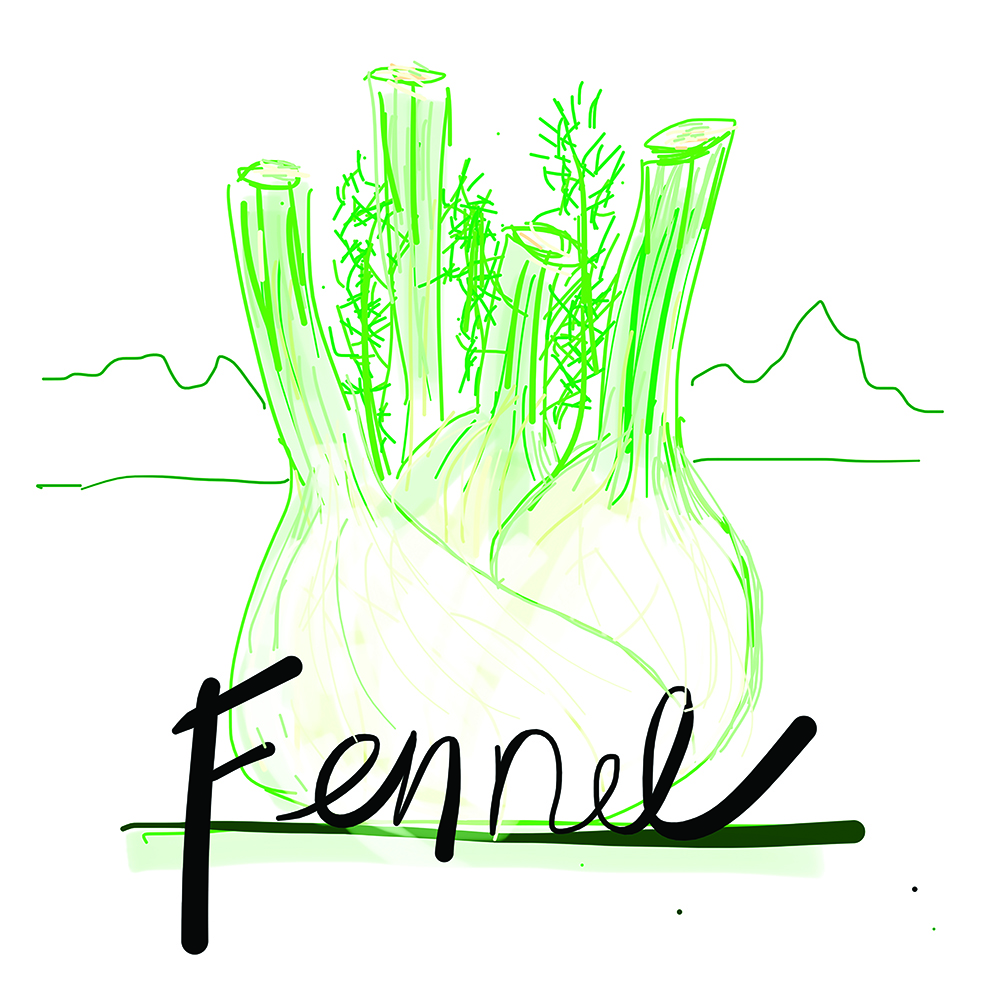
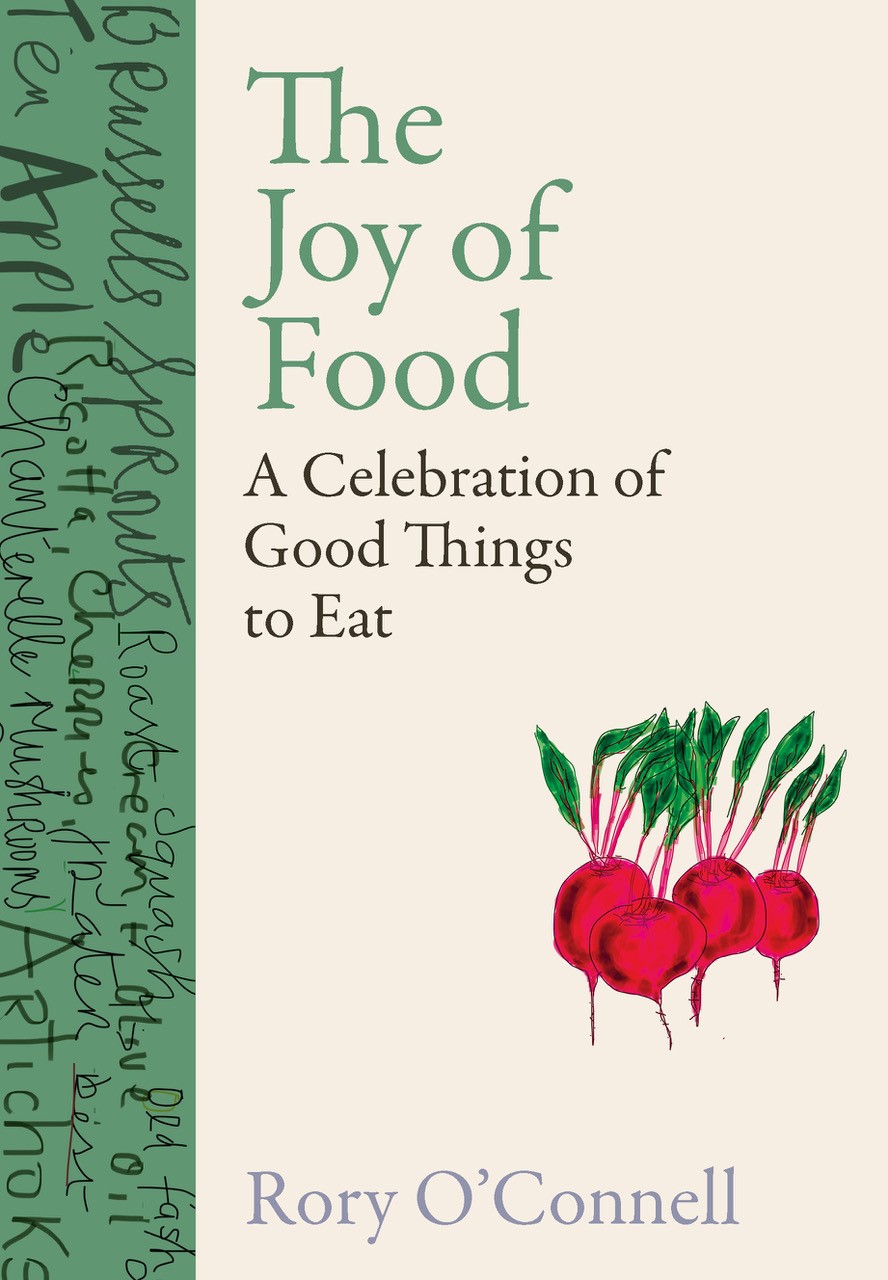 A simple statement on the back cover of The Joy of Food says, ‘This is the book that Rory O’Connell was born to write.’ And it is no overstatement. If ever there was a cookbook that expresses the author’s life philosophy, this is it. Multi-layered, with Rory’s own vibrant illustrations, and essays that are full of love and memories - Hazelnuts, A Bunch of Flowers for the Table, Heavenly Hens, Picnic - sprinkled through between the recipes, it’s not only a trusty kitchen guide but also a life-enhancing read.
A simple statement on the back cover of The Joy of Food says, ‘This is the book that Rory O’Connell was born to write.’ And it is no overstatement. If ever there was a cookbook that expresses the author’s life philosophy, this is it. Multi-layered, with Rory’s own vibrant illustrations, and essays that are full of love and memories - Hazelnuts, A Bunch of Flowers for the Table, Heavenly Hens, Picnic - sprinkled through between the recipes, it’s not only a trusty kitchen guide but also a life-enhancing read.
Handsomely produced yet devoid of glossy instagram-perfect food photography, The Joy of Food is reminiscent of the great food books of an earlier era - by Elizabeth David, Jane Grigson (her classic ‘Good Things’ is very special to Rory) and, perhaps, a favourite of my own, Florence Irwin’s extraordinary Northern Irish gem ‘The Cookin’ Woman’ - that have inspired generations with evocative text lifted only by a few simple line drawings. A tonic for the imagination, such books engage the reader in a way that modern cookbooks rarely do and - like Rory O’Connell’s earlier books Master It (Irish Book Awards Cookbook of the Year 2013) and Cook Well, Eat Well (André Simon foodbook award 2017) - The Joy of Food is a confidence-inspiring teaching companion. Never taking shortcuts, the recipes are as long as they need to be and every dish is meticulously explained in detail, and in the context of seasonal foods that are made endlessly exciting by their ephemeral nature. Once again, in The Joy of Food, Rory’s USP as a teacher is the ability to make the reader feel that the master himself is in the kitchen with you, explaining and demonstrating each ingredient and each dish so that you feel a shared sense of accomplishment.
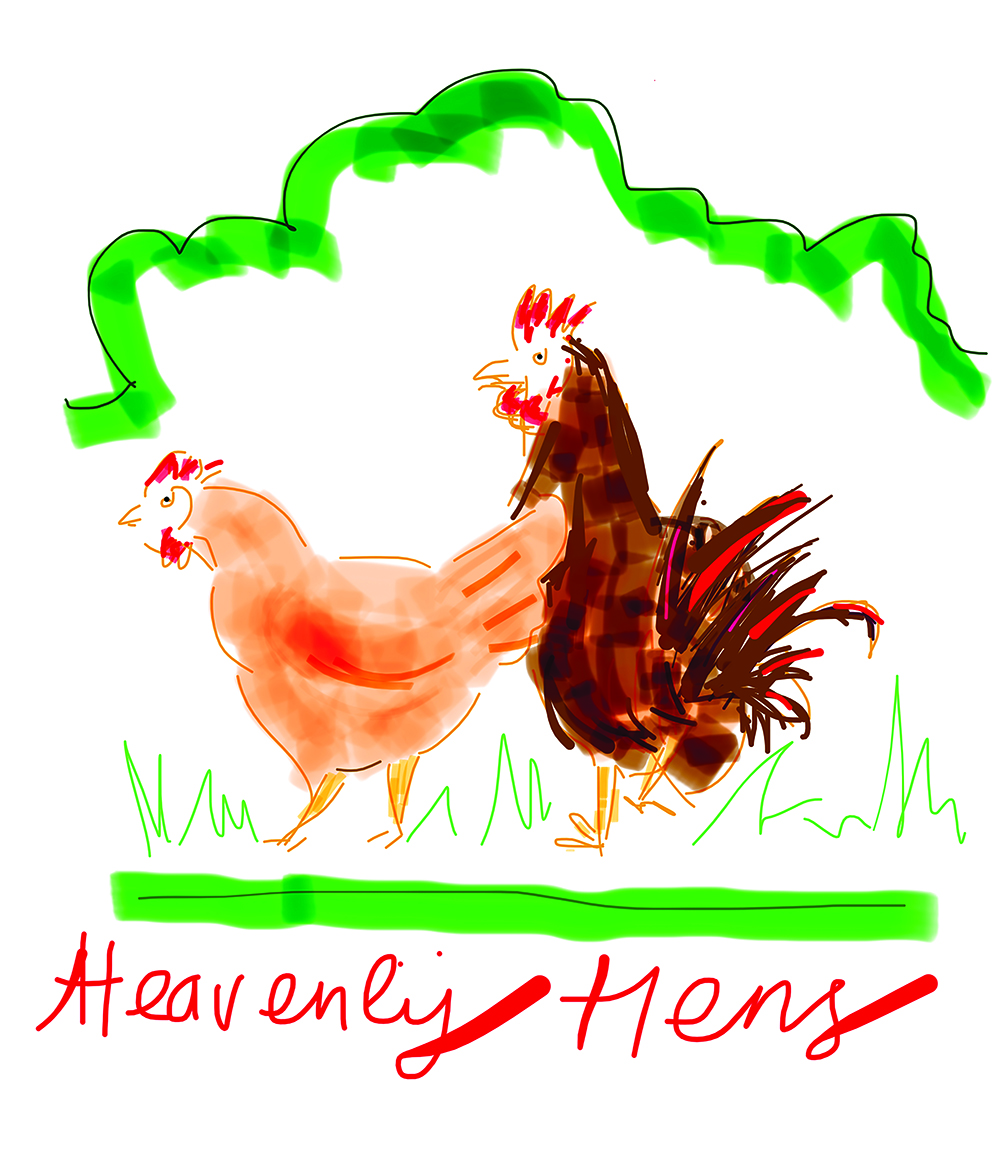 There’s also a sense of mindfulness, which makes The Joy of Food an exceptionally rewarding companion for our time. The joy comes in many forms - including, of course, the joy of sharing - and there are small Zen-like joys that are uniquely memorable, like sounds in the kitchen: ‘the almost inaudible sound coming from a stockpot as the bubble gently break on the surface of the liquid’, or ’the noise bread makes as it cools’. And, while it’s always been all about the ingredients for Rory O’Connell, his love of the cooking process itself is almost tangible - sometimes he simply loses himself in the process of creating a dish, occasionally even in front of a class of students at the Ballymaloe Cookery School (which he co-founded with his sister, Darina Allen, in 1983) - and there’s a profound and keenly acknowledged thankfulness for having found a life in food.
There’s also a sense of mindfulness, which makes The Joy of Food an exceptionally rewarding companion for our time. The joy comes in many forms - including, of course, the joy of sharing - and there are small Zen-like joys that are uniquely memorable, like sounds in the kitchen: ‘the almost inaudible sound coming from a stockpot as the bubble gently break on the surface of the liquid’, or ’the noise bread makes as it cools’. And, while it’s always been all about the ingredients for Rory O’Connell, his love of the cooking process itself is almost tangible - sometimes he simply loses himself in the process of creating a dish, occasionally even in front of a class of students at the Ballymaloe Cookery School (which he co-founded with his sister, Darina Allen, in 1983) - and there’s a profound and keenly acknowledged thankfulness for having found a life in food.
This life in food goes back to growing up in Culahill, where his mother’s love of cooking and of seasonal ingredients was passed on to her family, several of whom went on to make their names in food-related careers. And, as well as teaching at Ballymaloe Cookery School, Rory worked for many years with Myrtle Allen, as head chef at Ballymaloe House, and in other famous kitchens including the River Café and Chez Nico in London and Alice Waters’s iconic Californian restaurant, Chez Panisse, all of which have left their mark.
Rory O’Connell is without question one of the giants of modern Irish food and, while he’s been recognised nationally and internationally by his peers and his students for decades, it’s astonishing that he only became a household name relatively recently, with the arrival of his avidly followed How To Cook Well programmes on RTE. We are fortunate that his wisdom is now being passed on to a wider audience - and, especially, to so many young people, who are inspired by his philosophy of good food and always hungry for more of his teaching.
The Joy of Food is not for time-starved cooks in search of short cut recipes - but it is a must for every true food lover’s kitchen bookshelf, or bedside table.
The Joy of Food: A Celebration of Good Things to Eat by Rory O’Connell is published by Gill Books, priced €24.99.
RECIPES - a tempting seasonal selection from The Joy of Food, complete with Rory O’Connell’s detailed recipe introductions. With many of us likely to have smaller gatherings than usual at Christmas this year, the pheasant dish is worth remembering as a possible alternative to a big turkey.
SALAD OF SHAVED FENNEL AND KUMQUAT WITH GOATS’ MILK GREEK-STYLE CHEESE
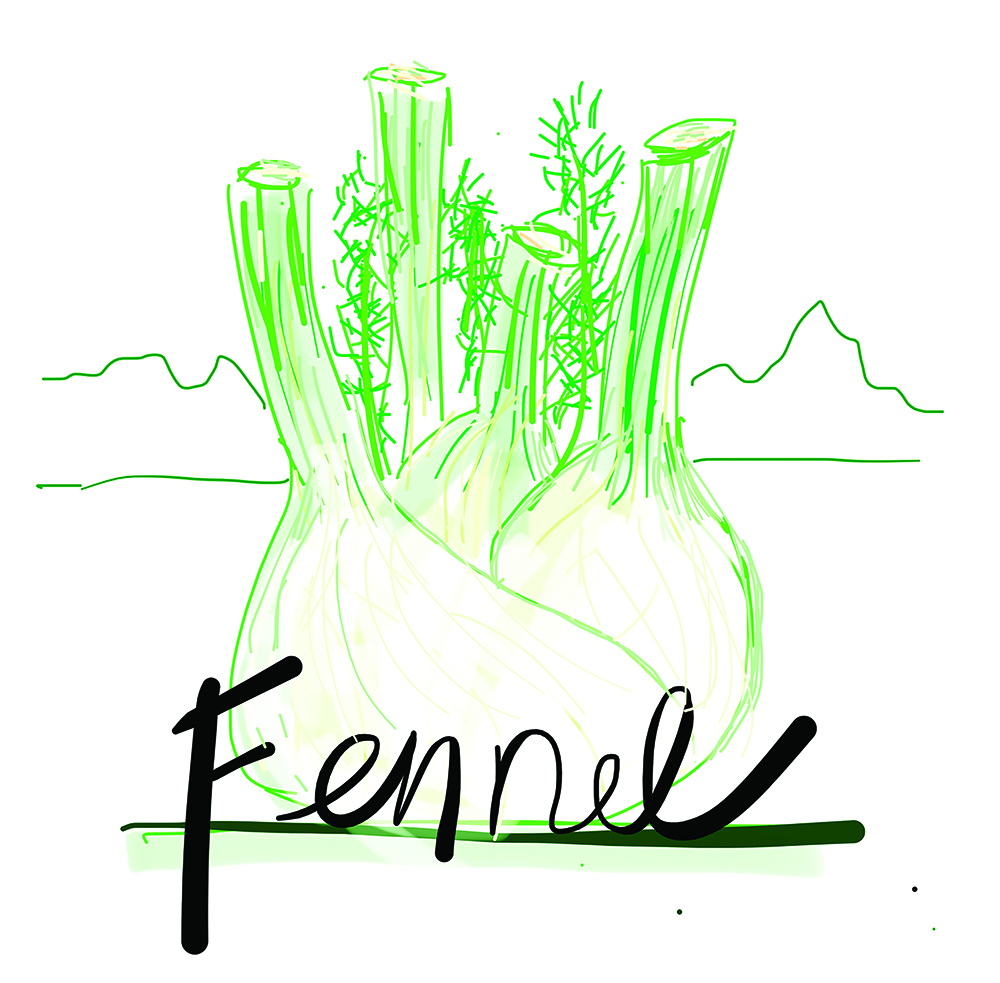 This is a refreshing combination of ingredients that can be served on its own as a light starter or to accompany grilled meat or fish. It is particularly good with grilled chicken or roast chicken legs. It is vital to shave the fennel thinly, otherwise it may be a bit tough and difficult to eat. It is equally important to take care with the kumquats, as they, too, will be much more delicious when sliced almost paper thin. The flavour of a goats’ cheese works well, as its robust taste stands up to the forthright flavour of the other ingredients.
This is a refreshing combination of ingredients that can be served on its own as a light starter or to accompany grilled meat or fish. It is particularly good with grilled chicken or roast chicken legs. It is vital to shave the fennel thinly, otherwise it may be a bit tough and difficult to eat. It is equally important to take care with the kumquats, as they, too, will be much more delicious when sliced almost paper thin. The flavour of a goats’ cheese works well, as its robust taste stands up to the forthright flavour of the other ingredients.
Calling what we used to call ‘feta’ a Greek-style cheese is rather cumbersome, but the use of the word ‘feta’ can now only be associated with a sheep’s milk cheese made in Greece, hence the longer title. I use one of Jane Murphy’s Ardsallagh goats’ cheeses from County Cork, which she calls a ‘Greek-style salad cheese’. I am certain a sheep’s milk cheese in the same style would be good here as well. I have on occasion eaten some of the leftover salad the following day, and though the texture of the fennel had softened somewhat, it was still good.
I like to serve the salad spread out on the plate rather than piled up, as I find the flavours work better that way.
Serves 4
• 1 fennel bulb, about 350g
• 70g kumquats
• 6 tablespoons extra virgin olive oil
• 2 tablespoons freshly squeezed lemon juice
• 1 teaspoon honey
• 1 level teaspoon fennel seeds, toasted and coarsely ground
• 60–80g goats’ milk feta cheese
• Sea salt and freshly ground black pepper
Remove any tired outer leaves from the fennel bulb and trim the tops if they are looking a little dry. Save any feathery fennel fronds and flowers for garnishing the dish.
Slice the fennel bulb about 2mm thick, either by hand or using a mandolin. You can slice the bulbs lengthways or sideways. I sometimes do a combination of both.
Cut the kumquats into 2mm-thick slices with a sharp knife and remove and discard any pips as you go. Add to the fennel. I like the kumquats sliced lengthways, but others will be amused by them cut into thin rounds. Removing the pips is a bit tedious but worth the effort.
Whisk the olive oil, lemon juice, honey and fennel seeds together. Season to taste with salt and pepper. Pour the dressing over the fennel and kumquats and mix gently but thoroughly with your fingers. Taste again to see if the seasoning is correct. Allow to sit at room temperature for up to 1 hour before serving.
Serve the salad in a single layer spread out on a large flat plate. Crumble the feta over the salad and garnish with fennel fronds and a few fennel flowers, if available. If I think the oil looks a little scant, I will drizzle a little extra over at the last minute.
CASSEROLE ROAST PHEASANT WITH JERUSALEM ARTICHOKES AND INDIAN SPICES
 I love a traditional roast pheasant with all the time-honoured trimmings, but this recipe, with the use of an Indian spice mixture, is a way to ring the changes with this bird. Pheasants are generally excellent value for money and this technique of casserole roasting produces a very juicy result and is my favoured method of cooking this bird, which when roasted can sometimes be a little dry.
I love a traditional roast pheasant with all the time-honoured trimmings, but this recipe, with the use of an Indian spice mixture, is a way to ring the changes with this bird. Pheasants are generally excellent value for money and this technique of casserole roasting produces a very juicy result and is my favoured method of cooking this bird, which when roasted can sometimes be a little dry.
The joy of this dish, apart from the flavours, is that when you remove the casserole from the oven the ingredients have produced a sauce created by the juices of both the pheasants and the artichokes, then all you have to do is carve the birds and bring it to the table.
Jerusalem artichokes, which curiously are a member of the sunflower family, are getting easier to find every year as they become better known and valued for their taste and as a wonderful food for the gut. Gardeners will know that they are utterly easy to grow – when you plant them once, you will have them for ever more, as they come back year after year. The knobbly tubers sometimes require peeling, which is definitely tedious, but in this recipe they just need careful scrubbing. The vegetable can be eaten raw or cooked and is extremely versatile. They make a silky soup and a lovely purée and are delicious when roasted to a rich colour or slowly braised in chicken stock. There are countless flavours that it will accept and in this book I also pair them with mussels and saffron in a soup.
The spice paste as listed will make twice what you need for this recipe, but I find it so useful that I make the full quantity and keep it in the fridge for up to a week or freeze it. I use it with other birds, such as chicken, quail and guinea fowl, and it makes a fantastic paste for roast chicken wings.
Serves 4–6
• 2 oven-ready pheasants
• 20g butter, at room temperature
• 650g Jerusalem artichokes, scrubbed and sliced in half lengthways
• 1 tablespoon chopped fresh coriander leaves
• Sea salt and freshly ground black pepper
• Spice paste
• 2 large garlic cloves, peeled and crushed to a paste
• Juice of 1 lemon
• 2 tablespoons extra virgin olive oil
• 1 tablespoon lightly roasted and finely ground cumin seeds
• 1 tablespoon sweet paprika
• 1 tablespoon ground turmeric
• 1 level teaspoon cayenne pepper
• 1 teaspoon caster sugar
• 1 teaspoon salt
• 1 teaspoon freshly ground black pepper
Preheat the oven to 180°C.
Mix all the ingredients for the spice paste together and reserve.
Heat a heavy-based casserole large enough for the two birds on a gentle heat until quite hot. Dry the skin of the birds, then smear the butter over the breasts and legs and place them breast side down in the heated casserole. The breasts should sizzle on contact with the casserole – if they don’t, remove and allow the casserole to become hotter. Equally, however, you don’t want to burn the birds, so make sure your heat is not too high. Allow the breasts to become a golden brown colour, then remove the birds from the casserole and turn off the heat. Do not wash out the casserole at this point unless it has overheated while browning the birds.
Place half of the artichokes in the casserole and season with salt and pepper. Smear half of the spice paste over the breasts and legs of the birds and also a little into the cavity, then return the birds to the casserole. Reserve the rest of the spice paste for another use. It will keep covered in the fridge for a week or it freezes well. Place the remaining artichokes around the birds, season and cover with a tight-fitting lid.
Place the casserole in the preheated oven and cook for 1 hour 15 minutes. Test to see if the birds are cooked by checking to see if the juices run clear between the thigh and the breast. I loosen the leg a little and push in a teaspoon to collect some of the juices so that I can accurately judge the colour. If the juices are a little pink, I usually pop the covered casserole back into the oven for another 10 minutes and test again.
The dish is now finished and ready to serve with the tender artichokes and delicious cooking juices as the sauce. If you wish you can spoon off the small amount of fatty juices from the surface of the sauce, but I often leave them in.
Carve the birds onto hot plates or a serving dish. Surround with the artichokes and pour over the bubbling hot juices and a sprinkle of chopped coriander. I love to serve simple boiled green cabbage or curly kale with this dish. York is a wonderful variety of winter cabbage.
BRAMLEY APPLES BAKED WITH CHOCOLATE, HAZELNUTS AND SULTANAS
 Gosh, how times have changed. When we were growing up, we were occasionally allowed to bring a Bramley apple in from the orchard, slice it thinly and dip the cold pieces in granulated white sugar before eating it. Mind you, my mother did keep an eye on us to make sure we did not eat too many of these wincingly bittersweet treats, as she knew – and indeed, we knew – that too many slices could definitely lead to ‘a pain in my tummy’. I vividly remember the crunchy texture of the sugar and the almost lemony tang of the bitter apple. It was without doubt what would nowadays be called a taste sensation. I wonder how many children taste such a thing these days – not too many, I suspect, in a world full of terrifying and mixed messages about food. We must not forget the joy of food, the joy of remembered moments around the table, the joy of sharing and of memories made.
Gosh, how times have changed. When we were growing up, we were occasionally allowed to bring a Bramley apple in from the orchard, slice it thinly and dip the cold pieces in granulated white sugar before eating it. Mind you, my mother did keep an eye on us to make sure we did not eat too many of these wincingly bittersweet treats, as she knew – and indeed, we knew – that too many slices could definitely lead to ‘a pain in my tummy’. I vividly remember the crunchy texture of the sugar and the almost lemony tang of the bitter apple. It was without doubt what would nowadays be called a taste sensation. I wonder how many children taste such a thing these days – not too many, I suspect, in a world full of terrifying and mixed messages about food. We must not forget the joy of food, the joy of remembered moments around the table, the joy of sharing and of memories made.
There is something rather lovely about a baked apple though. They have a retro appeal, certainly, but much more importantly, when properly cooked at the correct time of the year, they are a joy. The best time as far as I am concerned is when the apples are either still on the trees or shortly afterwards. When they are fresh off the tree, they are full of juice and this yields the fluffiest and lightest baked apple. The apple I always bake is the crimson variety of the Bramley, which has the most delicate pink hue to the steaming froth within.
The timing of a baked apple is all-important. The flesh of the cooked apple needs to be cooked through and almost like froth, and at the same time the apple should look as plump as a pigeon at harvest time. An overcooked baked apple is a sad, shrivelled and dishevelled sight. I am still as amused by the pale marshmallow-pink midriff of the cooked apple just beginning to ooze out of the stretched and shrinking skin as I was when I watched them coming out of the oven at home as a child.
By the time these apples are cooked, the chocolate will have melted into a sauce that combines beautifully with the juices in the bottom of the roasting dish, with the sultanas and hazelnuts adding further texture and flavour. I like cold softly whipped cream with the hot apples, which I serve on hot plates. Others will perhaps like thin custard.
Serves 4
• 4 Bramley apples
• 6–8 teaspoons Barbados soft dark brown sugar
• 40g chocolate (54% cocoa solids), chopped into small pieces
• 30g butter, diced
• 50g hazelnuts
• 30g sultanas or raisins
• 200ml apple juice
• To serve
• Chilled softly whipped cream
Preheat the oven to 180°C.
Using an apple corer, punch a hole right down though the core of each apple. If the hole looks a little narrow, I sometimes punch a second hole to make plenty of room for the filling. Now you need to score an incision about 1mm deep all around the belly of the apple. This allows the skin to shrink during cooking and prevents the apple from bursting.
Place the apples in an ovenproof baking dish. The apples should be snug but not touching each other.
Start filling each apple with 1 teaspoon of sugar followed by some chocolate, then some butter, hazelnuts and sultanas. Use a little force, such as your thumb, to press the ingredients into the opening, pushing in as much as you can. Scatter all the chocolate, hazelnuts and sultanas that won't fit in the hollowed apples around the apples in the dish. Top each stuffed apple with the remaining sugar and pour the apple juice over and around the apples.
Cover the dish with a piece of dampened non-stick baking paper. Bake in the preheated oven for about 30 minutes, until the apples are completely tender but still holding their shape.
Serve the apples as soon as possible on hot plates and spoon over the juices, fruit and nuts from the baking dish. Chilled softly whipped cream is the perfect accompaniment.
Cookery Feature - Bake
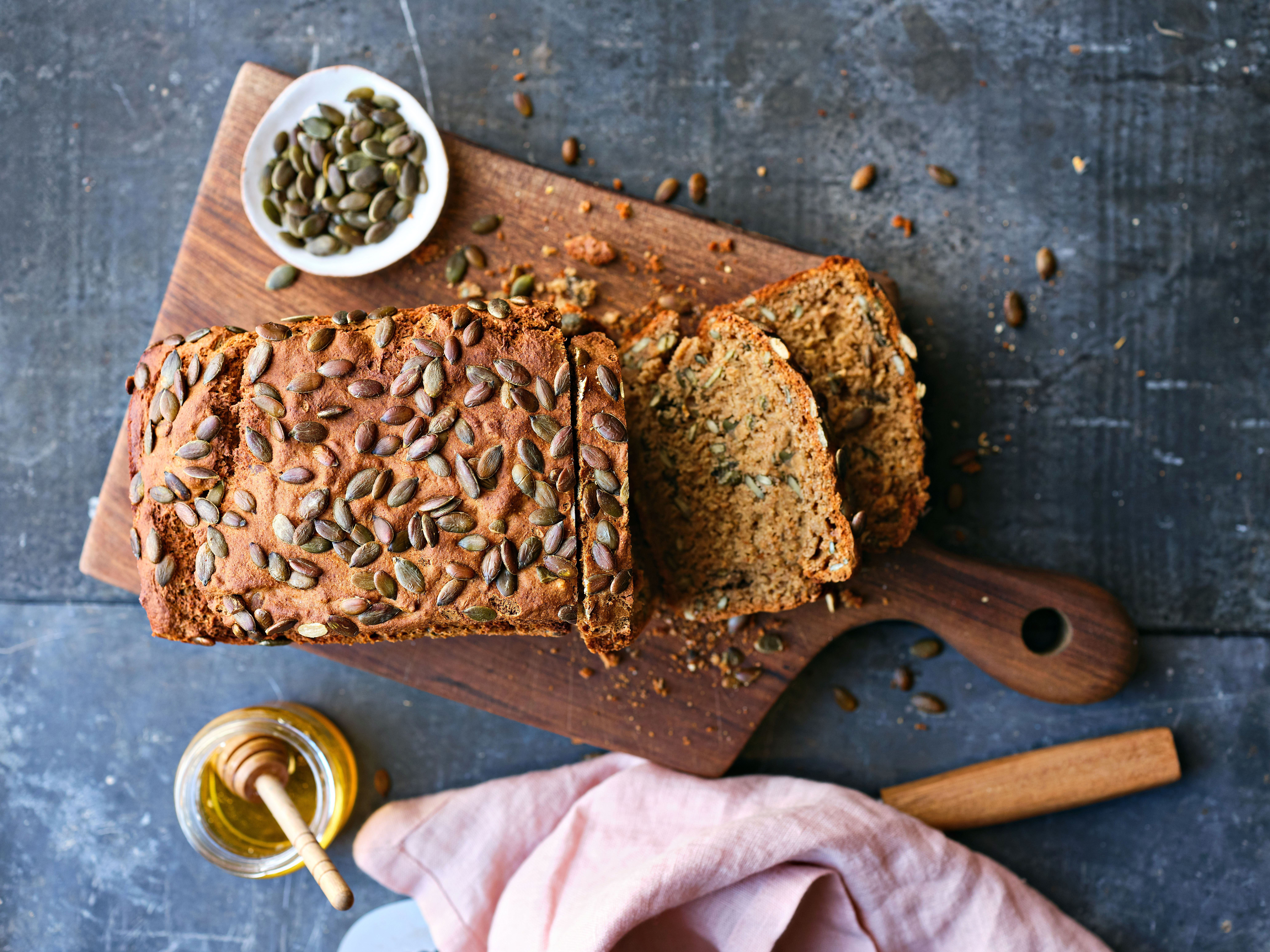
%20(Pic%20Joanne%20Murphy)%20copy.jpg) Although we have many traditional bakes in Ireland for calendar festivals and other special occasions, there’s never any need for an excuse to do a bit of baking and it’s one of the things we do best. Not that we’ve always remembered that – we went through a long period when sliced pan was king and when I wrote my own baking book ‘The Best of Irish Breads & Baking’, in the mid ‘90s, it was in the hope of inspiring a revival in home baking. Fortunately things have changed a lot since then and this wonderfully caring and beautifully produced book is a celebration of the magic of Irish baking in its traditional and more creative modern forms. Also – like all of the books produced over the last couple of years by publishing sensation Kristin Jensen of Nine Bean Rows and Blasta Books – it tells a story.
Although we have many traditional bakes in Ireland for calendar festivals and other special occasions, there’s never any need for an excuse to do a bit of baking and it’s one of the things we do best. Not that we’ve always remembered that – we went through a long period when sliced pan was king and when I wrote my own baking book ‘The Best of Irish Breads & Baking’, in the mid ‘90s, it was in the hope of inspiring a revival in home baking. Fortunately things have changed a lot since then and this wonderfully caring and beautifully produced book is a celebration of the magic of Irish baking in its traditional and more creative modern forms. Also – like all of the books produced over the last couple of years by publishing sensation Kristin Jensen of Nine Bean Rows and Blasta Books – it tells a story.
%20copy.jpg) Graham Herterich, aka The Cupcake Bloke, grew up above the family’s renowned pork butchers shop in Athy County Kildare and, aside from an outstanding recipe collection, the story that is woven so warmly through the book – and illustrated with family photos down through the years – also tells us a lot about rural Ireland, especially since the 1970s. Also how a love of food, and baking in particular, was passed down by Graham’s mother, grandmothers, aunts and neighbours - who, among other significant women (for they are nearly all women), people this lovely book and led him to become the professional baker he is today, and author of a book in which ‘every recipe for a traditional bake is followed by a fresh new spin using the ingredients available in Ireland now, from advieh to zhug’.
Graham Herterich, aka The Cupcake Bloke, grew up above the family’s renowned pork butchers shop in Athy County Kildare and, aside from an outstanding recipe collection, the story that is woven so warmly through the book – and illustrated with family photos down through the years – also tells us a lot about rural Ireland, especially since the 1970s. Also how a love of food, and baking in particular, was passed down by Graham’s mother, grandmothers, aunts and neighbours - who, among other significant women (for they are nearly all women), people this lovely book and led him to become the professional baker he is today, and author of a book in which ‘every recipe for a traditional bake is followed by a fresh new spin using the ingredients available in Ireland now, from advieh to zhug’.
And a huge amount of research and TLC has gone into Bake, which covers not only the much-loved breads, scones and bracks that say ‘Ireland’ (and the butter and other dairy products that partner them so perfectly) – but also a wide range of seriously delicious cakes, desserts and other treats. And there are no gimmicks. While it’s a great read, this is a real hands-on baker’s book, complete with introductory chapters on the history of Irish baking and the modern landscape of Irish food, by food writers Ali Dunworth and Dee Laffan (editor of companion publication ‘Scoop’) that give context, and ‘Everything you need to know’ chapters on baking and ingredients, that answer all of the questions for novice bakes or anyone unfamiliar with Irish ways.
For many people, Bake will change their perception of Irish baking, and of Irish food in general - and also, perhaps, of Athy and other rural Irish towns. Highly recommended.
Bake: Traditional Irish Baking with Modern Twists by Graham Herterich is published by Nine Bean Rows. Hardback 978-1-9993799-4-0; 224 pages175mm x 223mm €25.00 / £21.50 / US$27.00
SAMPLE RECIPES
 Guinness brown bread
Guinness brown bread
Guinness brown bread has become iconic over the years. My favourite way to eat it is sliced and topped with some horseradish crème fraîche, smoked salmon and pickled red onion, all accompanied by a glass of the black stuff!
Makes 1 x 900g (2lb) loaf
melted butter, for greasing the tin
300g coarse wholemeal flour
150g plain flour, plus extra for dusting the tin
50g porridge oats, plus extra to sprinkle on top
1 tsp bread soda
1 tsp salt
250ml buttermilk
200ml Guinness stout
100g treacle
2 tbsp vegetable oil
To serve:
smoked salmon
horseradish crème fraîche (see the note)
pickled red onion (see the note)
chopped fresh chives
Preheat the oven to 180°C fan. Prepare a 900g (2lb) loaf tin by lightly brushing it with melted butter and dusting with a little plain flour.
Place all the dry ingredients in a large bowl and gently mix.
In a separate jug, gently whisk all the wet ingredients together with a fork, then mix this into the dry ingredients. Add a little more buttermilk if the mixture is too dry – it should be a soft, wet dough.
Pour the dough into the prepared tin and sprinkle some extra porridge oats on top. Bake in the preheated oven for 55 minutes. Carefully take the bread out of the tin and place it back in the oven on the rack for a further 5 minutes. To check if the bread is baked, tap the bottom – it should sound hollow when fully cooked.
Remove from the oven and wrap in a clean tea towel while it’s cooling to stop the crust getting too hard. Serve with smoked salmon, horseradish crème fraîche and pickled red onion and garnish with chopped fresh chives.
NOTE
To make the horseradish crème fraîche, simply stir a teaspoon of horseradish sauce into a small tub of crème fraîche. For the pickled red onion, halve and thinly slice a red onion. Pour over 4 tablespoons white wine vinegar, 1 teaspoon salt and 1 teaspoon caster sugar. Leave to stand for 1 hour before using.
Bake: Traditional Irish Baking with Modern Twists by Graham Herterich is published by Nine Bean Rows (€25)
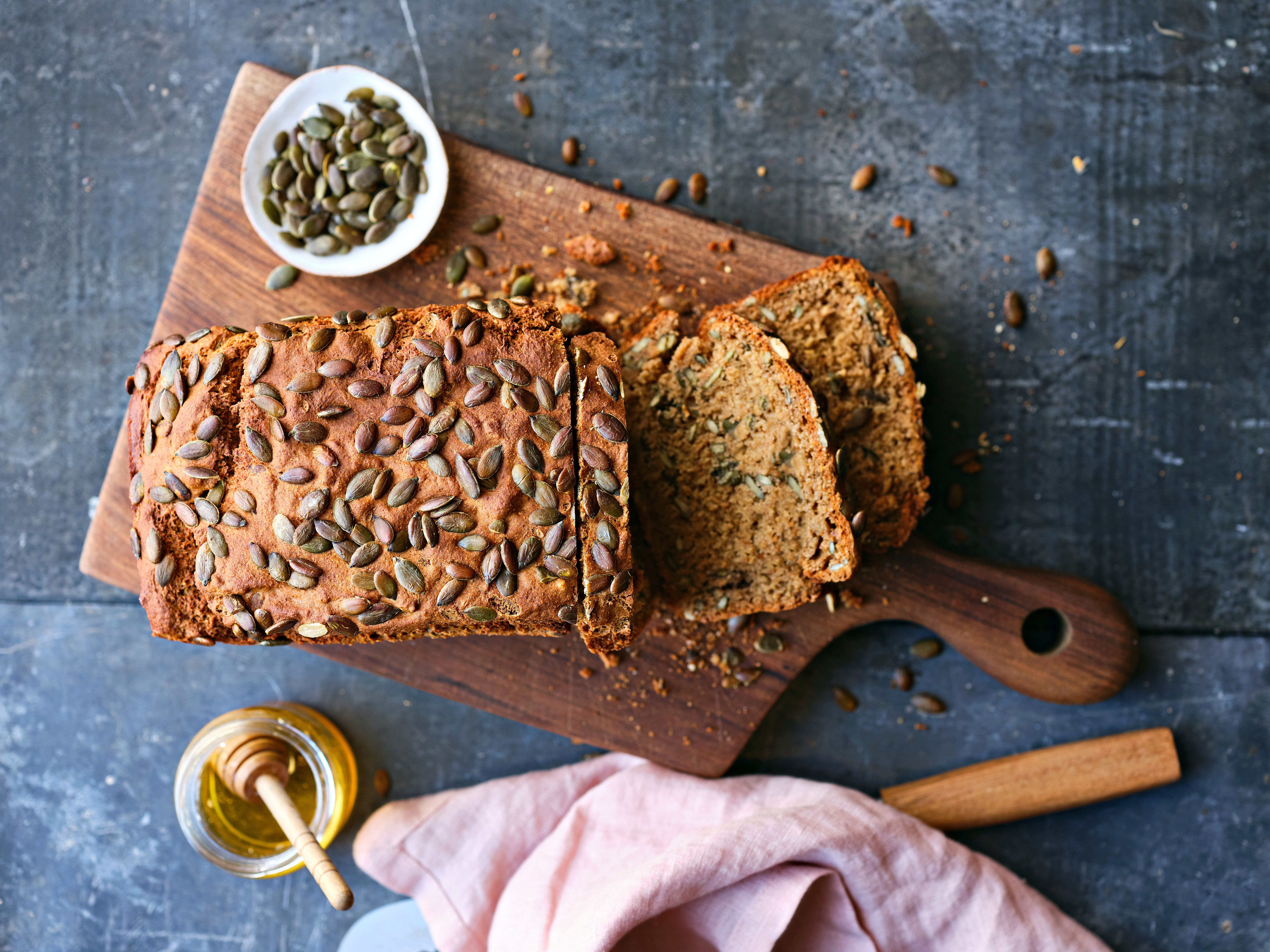 Rye, ale & honey bread
Rye, ale & honey bread
I wanted to create a bread that worked really well with baked ham and cold meats. My dad was a pork butcher, so it’s only natural that he is the inspiration for this recipe. He loves a pint of Smithwick’s and with a surname like Herterich, I had to look to Germany for some inspiration. I’ve used rye flour and lots of seeds, like so many good German breads. I love this bread served with the honey and mustard baked ham along with some good salted butter, gherkins and mustard. Pass the Kölsch – prost!
Makes 1 x 900g (2lb) loaf
melted butter, for greasing the tin
300g dark rye flour
150g plain flour, plus extra for dusting the tin
100g pumpkin seeds, plus extra to sprinkle on top
1 tsp bread soda
1 tsp salt
250ml buttermilk
250ml ale
75g honey
2 tbsp vegetable oil
Preheat the oven to 180°C fan. Prepare a 900g (2lb) loaf tin by lightly brushing it with melted butter and dusting with a little plain flour.
Place all the dry ingredients in a large bowl and gently mix.
In a separate jug, whisk all the wet ingredients together with a fork, then mix this into the dry ingredients. Pour the dough into the prepared tin and sprinkle some porridge oats on top. Bake in the preheated oven for 1 hour, then take the bread out of the tin and place it back in the oven, straight on the oven rack, for a further 5 minutes. To check it’s baked, tap the bottom of the bread – it should sound hollow when it’s fully cooked.
Remove from the oven and wrap in a clean tea towel while it’s cooling to stop the crust getting too hard.
Bake: Traditional Irish Baking with Modern Twists by Graham Herterich is published by Nine Bean Rows (€25)
Cookery Feature - The Gathered Table - A Taste of Home
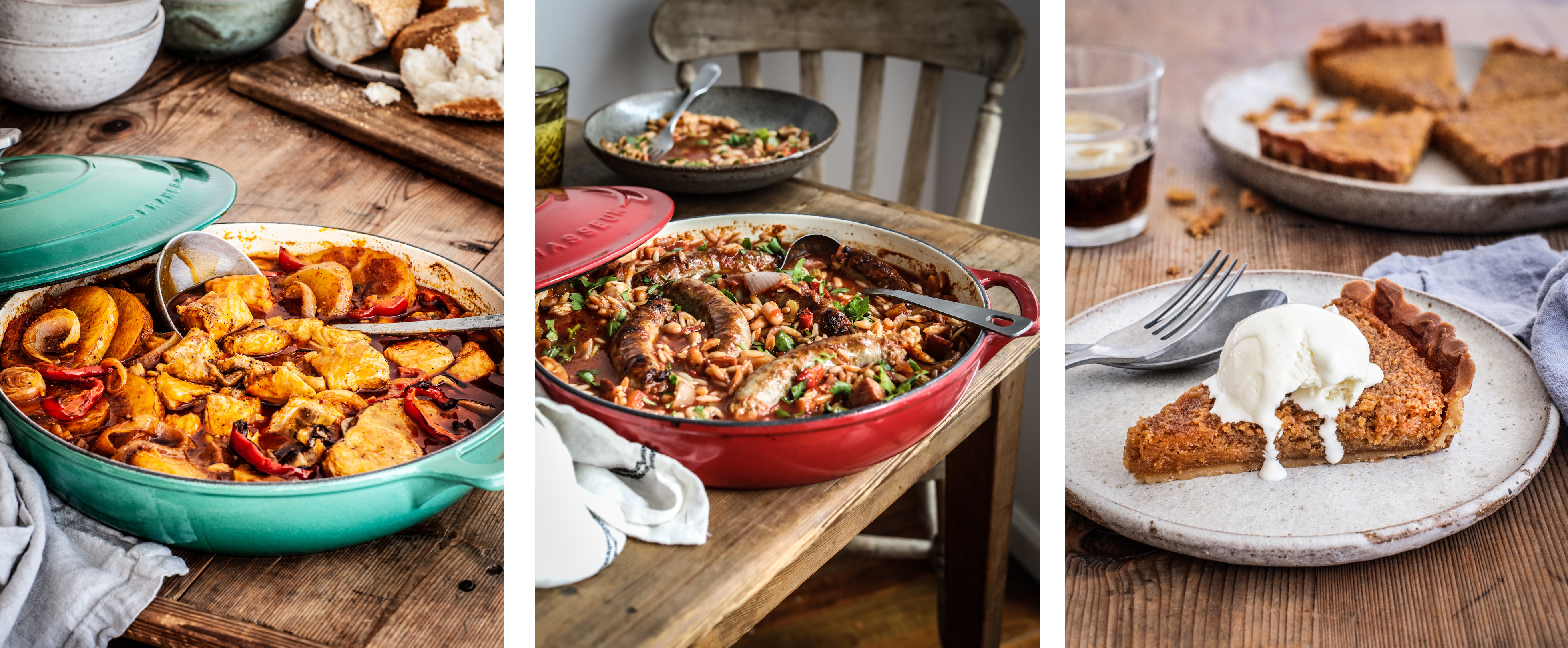
A timely publication if ever there was one – and very appropriately launched recently at a lovely homely event in Eoin McCluskey’s Bread 41 Dublin bakery and café - this unusual collaborative Irish cookbook celebrates the relationship between food and home, in aid of the national housing and homeless charity Peter McVerry Trust, which marks its 40th anniversary this year.
%20(3).jpg) The Gathered Table: A Taste of Home, is a beautiful 160-page hardback cookbook featuring a collection of 55 recipes from across Ireland’s food world, with contributions
The Gathered Table: A Taste of Home, is a beautiful 160-page hardback cookbook featuring a collection of 55 recipes from across Ireland’s food world, with contributions
.from bakers and butchers, farmers and food champions, producers, shopkeepers and
chefs. Each contributor has supplied their favourite recipe to cook at home, the one that takes them back to happy times and celebrates the relationship between nurturing food and the community of home, wherever your home may be.
Originated and compiled by Gather & Gather Ireland and edited by Kristin Jensen from boutique Irish publishing house Nine Bean Rows, The Gathered Table: A Taste of Home is priced at just €30 with all proceeds going to Peter McVerry Trust.
The list of contributors reads like a roll call of the best and brightest in the Irish food world. Chefs include Anna Haugh, Aishling Moore, Gaz Smith, Kwanghi Chan, Darina Allen, Neven Maguire, Domini Kemp, JP McMahon, Danni Barry, Aoife Noonan, Gastrogays and more. You’ll also find recipes from broadcaster and writer Suzanne Campbell, food writers John and Sally McKenna, and myself, as well as Gráinne Mullins from Grá Chocolates, Siobhán Ní Gharbhith from St Tola, Pat Whelan from James Whelan Butchers, Aisling and Michael Flanagan from Velvet Cloud and Eva Pau from Asia Market among others.
Recipes include a classic beef and Guinness pie, comforting stews and casseroles, a decadent sticky coffee pudding, treacle tart, porridge bread and a simple but delicious mac 'n' cheese.
The book also features some truly inspirational stories directly from those who Peter McVerry has helped out of homelessness. Last year alone, Peter McVerry Trust supported over 12,000 people in towns and cities across the country and gave over 900 people the key to their own home. Pat Doyle, CEO of Peter McVerry Trust said, “Peter McVerry Trust is honoured to be part of this fantastic project. Gather & Gather are long standing supporters of our organisation and we cannot thank them enough. Home means something special to many of us. For the people we work with in Peter McVerry Trust, home means safety, security and independence. Included in this book, alongside the wonderful recipes, are stories from some of the people we have supported out of homelessness – what their new home means to them and how it has changed their lives. Buying this book – for yourself or as a gift – is a fantastic way to help people impacted by homelessness across Ireland.”
Pauline Cox, Managing Director of Gather & Gather Ireland, elaborates on the initiative saying, “Mark Anderson, our culinary director, brought me the idea of creating a cookbook back in 2021. We had been involved with the Peter McVerry Trust for several years and had been looking for a project that would make an impact in supporting their work. While a cookbook’s role in raising awareness of homelessness may not be apparent at first glance, it becomes more evident when you consider the relationship
between our food and our security and comfort. For me, a great cookbook should do more than teach you how to cook a dish – it should carry real meaning, reflecting memories of people or places. The Gathered Table: A Taste of Home does all these things, in aid of a very good cause. We hope you enjoy reading and using the book just as much as we enjoyed compiling it.”
Kristin Jensen, publisher, Nine Bean Rows says, “There are a few things that connect everyone, everywhere. Food is one of them. Home is another. This is powerfully illustrated in The Gathered Table, which we are proud to be publishing for such a good cause.”
A gorgeous coffee table book as well as a recipe book for all levels of cooking, with photography by award-winning photographer Katie Quinn, The Gathered Table: A Taste of Home, €30, is available in bookshops and independent retailers across the country and online at Nine Bean Rows Books
RECIPES TO TRY – Just a taste of the delicious dishes to be found in this beautiful and very practical book
%20p86.jpg) Sausage, Chorizo And Roast Pepper Casserole
Sausage, Chorizo And Roast Pepper Casserole
Mark Anderson, Gather & Gather
When I cook at home, I want a dish that appeals to everyone and is easy to make so that I can be still part of the chats and fun. This recipe changes all the time and is one of the first things I taught my kids, Hannah and Dylan, to cook. They now cook it themselves and have adapted it to be their own versions. Food and cooking are so important in creating relationships and memories and this dish has done that for me repeatedly. It’s like a big warm hug on a cold night.
Serves 4
• 150g orzo
• 2 tbsp vegetable oil
• 8 good-quality Irish pork sausages
• 200g raw cooking chorizo, diced
• 2 red onions, roughly chopped
• 1 medium carrot, diced
• 1 celery stick, finely diced
• 4 garlic cloves, thinly sliced
• 2 sprigs of fresh rosemary needles, picked and chopped
• 1 small bunch of fresh thyme, chopped
• 1 tsp fennel seeds
• salt and freshly ground black pepper
• 1 tsp hot smoked paprika
• 50ml sherry vinegar
• 150ml white wine
• 500ml chicken stock, divided
• 500g good-quality passata (I like the Bunalun or Mutti brands)
• 1 jar of roasted peppers, drained and thinly sliced
• 1 x 400g tin of cannellini beans, drained and rinsed
• 1 bunch of fresh flat-leaf parsley, chopped
• a few handfuls of rocket, chopped
• freshly grated Parmesan, to serve (optional)
Preheat the oven to 200ºC (180ºC fan).
Cook the orzo in boiling salted water according to the packet
instructions, then drain and set aside to cool.
Heat the oil in a large shallow casserole over a medium heat. Add the
sausages and brown on all sides. Remove from the casserole and set aside.
Add the diced chorizo to the casserole and cook for 2–3 minutes, until
the fat has rendered out and the chorizo is beginning to brown. Add
the red onions, carrot, celery, garlic, herbs and fennel seeds and cook
for 3–4 minutes, until softened. Season with salt but be careful as the
chorizo is often quite salty. Add the smoked paprika and cook for 30
seconds, then deglaze with the sherry vinegar. Once the vinegar has
bubbled down and become sticky, pour in the white wine and allow it
to reduce by half.
After the wine has reduced, add 350ml of the stock along with the
passata, roasted peppers, cannellini beans and cooked orzo. Bring to
the boil, then cover with a lid or foil and transfer to the preheated oven.
Cook for 5 minutes, then check the casserole and add the remaining
150ml of stock if it’s drying out. Cover and return to the oven to
cook for another 5 minutes, at which point the sausages should be
completely cooked and the pasta should have warmed through.
To finish, remove from the oven, remove the lid or foil and stir in the
chopped parsley and rocket. Drizzle with a little good olive oil and
adjust the seasoning with salt and pepper if necessary. Finish with
freshly grated Parmesan if you want to add a little luxury.
%20p114.jpg) Mediterranean seafood casserole with chorizo and chickpeas
Mediterranean seafood casserole with chorizo and chickpeas
Niall Sabongi, Sustainable Seafood Ireland
This is my go-to dish to cook at home for the people I love most. I like to use line-caught pollock – it’s local, sustainable and delicious – and red mullet, which gives it a Mediterranean feel. But you can use any fish you like, such as hake, brill, cod, turbot or even shellfish.
Serves 2–4
• For the roast vegetables:
• 2 large potatoes, cut into slices 1cm thick
• 1 onion, cut into slices 1cm thick
• 1 red pepper, cut into slices 1cm thick
• 1 lemon, sliced as thinly as you can
• 1 garlic clove, grated or crushed
• salt and freshly ground black pepper
• For the casserole:
• 6 tbsp olive oil, plus extra
• ½ raw chorizo sausage, diced
• 1 onion, diced
• 5 garlic cloves, sliced
• 1 tbsp paprika
• ½ tbsp chilli powder
• ½ tbsp ground cumin
• ½ tbsp coriander seeds, crushed
• ½ tbsp caraway seeds
• a few strands of saffron
• 600ml warm water
• 2 tbsp tomato purée
• 1 x 400g tin of chickpeas, drained and rinsed
• 200g fish per person (see note in intro)
• To serve: good crusty bread
Preheat the oven to 240ºC (conventional or fan) or as high as it will go.
Toss the sliced potatoes, onion, pepper and lemon with the garlic, a splash of olive oil and some salt and pepper on a baking tray. Roast in the preheated oven for 15 minutes.
Set aside.
Reduce the oven temperature to 220ºC (200º fan).
Heat the 6 tablespoons of oil in a large heavy-based casserole over a medium-low heat. Add the chorizo and cook for 3–4 minutes. Add the onion and cook for 3 minutes, then add the garlic and cook for 2 minutes more. Add the paprika, chilli powder, cumin, coriander and caraway seeds and cook gently for 1–2 minutes.
Put the saffron in a measuring jug with the warm water, tomato purée, 1 tablespoon salt and a good twist of pepper.
Allow to sit for 5 minutes, then add this to the casserole along with the chickpeas. Simmer for 4–5 minutes and taste for seasoning.
Add the roasted vegetables along with all their juices from the baking tray, then nestle in the fish and drizzle with 2–3 tablespoons of olive oil. Transfer the casserole to the oven and cook for 15 minutes, until the fish is cooked through.
Allow to rest for 5 minutes. Serve straight to the table with crusty bread for mopping it all up.
%20po148.jpg) Treacle Tart
Treacle Tart
Elaine Murphy, The Winding Stair
A happy place, a sanctuary, somewhere to love and be loved, to create and flourish. Home is any place where you feel safe and secure. For me this tart is the taste of Ireland. It brings a sense of the richness and culture thar are synonymous with our streets and towns.
Serves 6–8
• For the sweet pastry:
• 250g plain flour, sifted, plus extra for dusting
• 175g cold butter, diced, plus extra melted butter for greasing
• 75g icing sugar
• 2 egg yolks
• 1 tbsp cold water
• For the filling:
• 150g day-old brown or white bread, crusts removed
• 650g golden syrup or 140g treacle
• 150g unsalted butter
• 1 egg
• 50ml double cream
• zest of 2 lemons
• a large pinch of salt
• To serve: clotted cream or ice cream
To make the pastry, put the sifted flour and butter in a large bowl and rub
together using your fingertips until it resembles breadcrumbs. Add the icing sugar, egg yolks and water and mix until it comes together into a dough. Wrap in cling film, then chill in the fridge for 2 hours.
Grease a 23cm loose-bottomed tart case with melted butter, then dust it with flour, gently knocking out any excess. Line a baking tray with non-stick baking paper and put the prepared tart case on top.
Once the pastry has rested, roll it out on a lightly floured work surface until it’s 4–5mm thick. Lift the rolled pastry into the prepared tart case, pressing it firmly into the case to mould it to the sides and bottom.
Trim off any excess pastry, then chill in the fridge for 30 minutes.
Preheat the oven to 200ºC (180ºC fan).
Remove the tart case from the fridge and prick the base several times with a
fork. Line the base and sides of the case with non-stick baking paper, then fill it with dried beans. Bake in the preheated oven for 30–35 minutes, until crisp and pale golden brown. Discard the paper and beans.
Meanwhile, to make the filling, blitz the bread in a food processor until it has formed breadcrumbs. Set aside.
Melt the golden syrup or treacle and the butter in a saucepan over a low to medium heat. Set aside to cool slightly.
In a large bowl, whisk together the egg and cream until well combined. Pour in the syrup and butter mixture and stir to combine, then stir in the breadcrumbs, lemon zest and a large pinch of salt until well combined.
Pour the filling into the cooked pastry case, then return the tart to the ove and bake for 40–45 minutes, until the filling is dark golden.
Allow the tart to cool slightly for 15 minutes before cutting into slices. Serve warm with clotted cream or ice cream.
Cookery Feature - Butter Boy

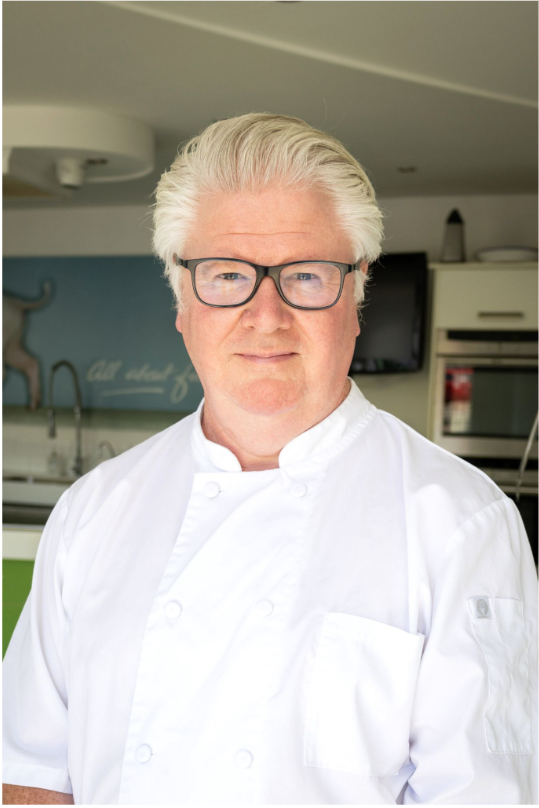 Butter Boy is not Paul Flynn’s first cookbook – in fact it is his fifth – but when this lovely big yellow door stopper of a book landed on my desk it took me straight back to 1995, and the early years of the Egon Ronay’s Ireland Guide when Paul was leading the kitchen team at Dublin’s wonderful La Stampa, the Guide’s Restaurant of the Year. The citation referred to it as ‘ a breath of fresh air’, ‘a hugely enjoyable experience’, ‘real value for money’ and to ‘the wish to return’ – all of which could equally apply to The Tannery, which Paul and Maire Flynn bravely left Dublin to establish in Dungarvan just two years later, in 1997. Which, as it happened, was also the year when Egon Ronay’s Guides (Britain and Ireland) suddenly went quiet, in a closure very similar to the demise of The Irish Press group – to be replaced, in Ireland, by GCGuides. In the more detailed main entry, readers were urged to scrutinise Paul’s monthly-changing menus carefully for their ‘eclectic mix of dishes’ with ‘lobster bisque sitting happily alongside Thai crab risotto and perhaps goats cheese pizza, escalope of veal milanaise or daube of beef with cabbage, bacon, bacon, carrots and mash’ and the ‘good local cheeses’ named included Cooleeny and Gubbeen…
Butter Boy is not Paul Flynn’s first cookbook – in fact it is his fifth – but when this lovely big yellow door stopper of a book landed on my desk it took me straight back to 1995, and the early years of the Egon Ronay’s Ireland Guide when Paul was leading the kitchen team at Dublin’s wonderful La Stampa, the Guide’s Restaurant of the Year. The citation referred to it as ‘ a breath of fresh air’, ‘a hugely enjoyable experience’, ‘real value for money’ and to ‘the wish to return’ – all of which could equally apply to The Tannery, which Paul and Maire Flynn bravely left Dublin to establish in Dungarvan just two years later, in 1997. Which, as it happened, was also the year when Egon Ronay’s Guides (Britain and Ireland) suddenly went quiet, in a closure very similar to the demise of The Irish Press group – to be replaced, in Ireland, by GCGuides. In the more detailed main entry, readers were urged to scrutinise Paul’s monthly-changing menus carefully for their ‘eclectic mix of dishes’ with ‘lobster bisque sitting happily alongside Thai crab risotto and perhaps goats cheese pizza, escalope of veal milanaise or daube of beef with cabbage, bacon, bacon, carrots and mash’ and the ‘good local cheeses’ named included Cooleeny and Gubbeen…
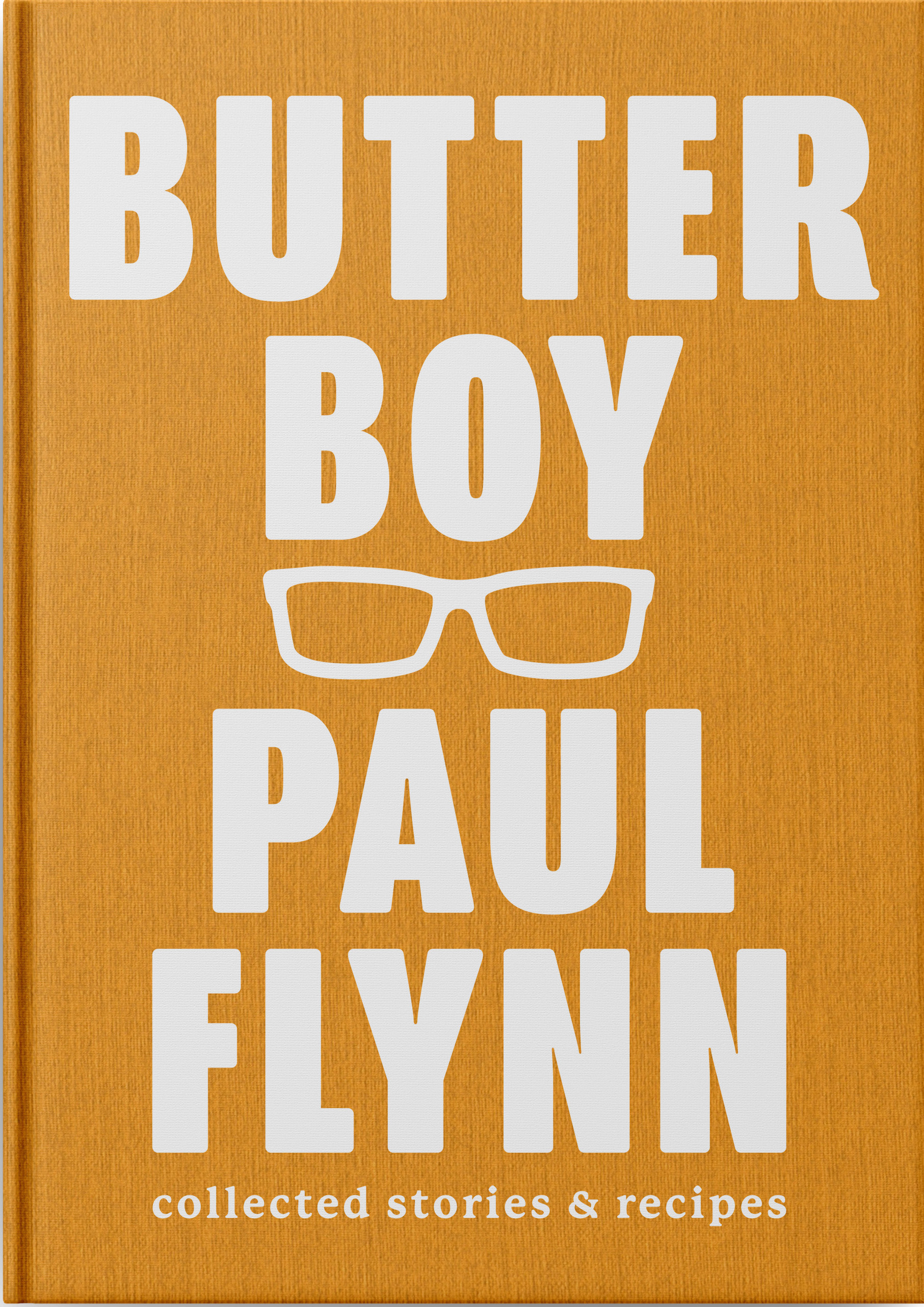 So, here we are nearly three decades later and plus ca change…With the arrival of Butter Boy, we hear that ‘Paul’s passion for contemporary cooking while championing traditional Irish ingredients is apparent in his fun Turnip Tortilla and Posh Bacon and Cabbage or Steamed Mussels with Cidona, Curry Spice and Crème Fraîche’, and that ‘Summer recipes are inspired by Paul's travel’. Much has changed along the way of course, not least that Paul is now a household name, famed for his Irish Times columns (2000–2004 and 2019–2022), TV programmes such as Lords and Ladles and Paul Flynn’s Food Truck Favourites - and, of course, the very successful Tannery Cookery School. But the fundamentals remain the same, with great seasonal Irish produce used in a wide range of dishes that, he says, have been kept ‘uncomplicated, seasonal and family-oriented’. But equally importantly Butter Boy is a just a great read and nobody could argue with the press release statement that ‘Even if you never cook any of the dishes, you’ll certainly enjoy the journey Paul takes his readers on’.
So, here we are nearly three decades later and plus ca change…With the arrival of Butter Boy, we hear that ‘Paul’s passion for contemporary cooking while championing traditional Irish ingredients is apparent in his fun Turnip Tortilla and Posh Bacon and Cabbage or Steamed Mussels with Cidona, Curry Spice and Crème Fraîche’, and that ‘Summer recipes are inspired by Paul's travel’. Much has changed along the way of course, not least that Paul is now a household name, famed for his Irish Times columns (2000–2004 and 2019–2022), TV programmes such as Lords and Ladles and Paul Flynn’s Food Truck Favourites - and, of course, the very successful Tannery Cookery School. But the fundamentals remain the same, with great seasonal Irish produce used in a wide range of dishes that, he says, have been kept ‘uncomplicated, seasonal and family-oriented’. But equally importantly Butter Boy is a just a great read and nobody could argue with the press release statement that ‘Even if you never cook any of the dishes, you’ll certainly enjoy the journey Paul takes his readers on’.
And rarely has context been so important for a cookery book - Butter Boy is the complete Irish Times collection of all of Paul’s 152 articles and over 450 recipes from three very unusual years, November 2019 to October 2022, ‘a time when cooking and mealtimes took on new meaning’, and his record of this time through food (and stories) not only resonates for all of us now, but its importance as a record will grow as the pandemic becomes a distant memory. The calendar sequence with the dates of the original articles is also very practical and makes the seasonality very natural and easy to reference. At one point Paul describes in detail how the Irish Times features were put together, including Maire’s editing role - which was mainly to get Paul’s text down to the right word count but there is a sense that she also put manners on his occasional (entertaining) rants too. And it should be noted that Harry Weir’s photographs for The Irish Times articles (as in samples below) do not feature in Butter Boy, which already runs to over 700 pages without illustrations. Readers of the Insta generation may possibly find that strange, but for the rest of us it’s a nice reminder of the days when cookery books had little more than a few line drawings or a little cluster of photos in the section breaks and reading them stimulated the imagination as much as the appetite.
Published by boutique Irish publishing house Nine Bean Rows (itself a sensation), Butter Boy is set to become a classic.
Keep up to date with the latest news by following Paul Flynn on social at @paulflynnchef and @thetanneryrestaurant
SAMPLE RECIPES
Butter Boy: Collected Stories and Recipes by Paul Flynn is published by Nine Bean Rows, price €40; available from ninebeanrowsbooks.com and all good bookshops, as well as independent retailers around Ireland.
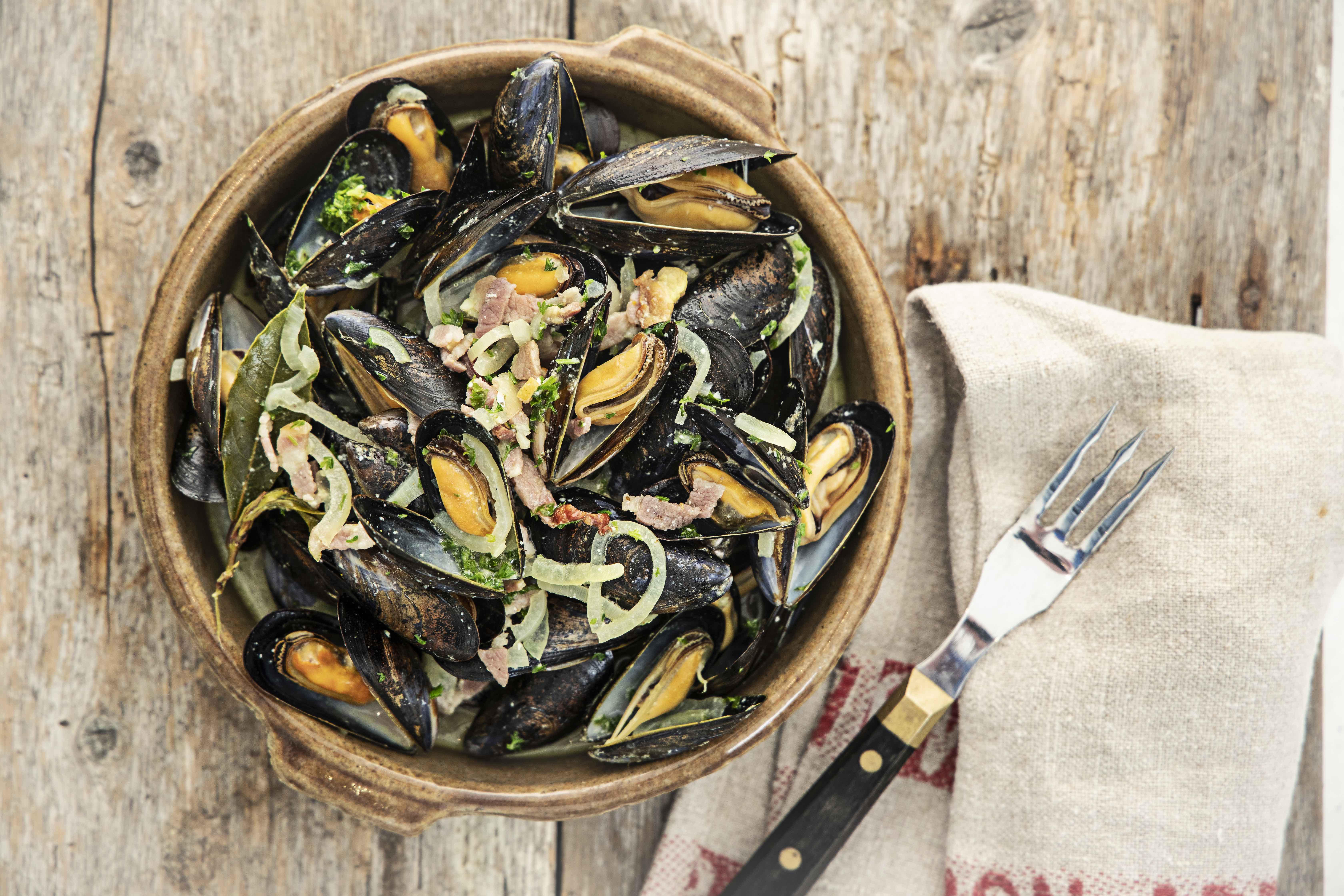 Steamed mussels
Steamed mussels
Steamed mussels with cidona, curry spice and crème fraîche
Serves 2
This dish is a little controversial because I put Cidona in my mussels. So should you. It was inspired by Normandy, where they pair mussels with cider so beautifully. I’ve added crème fraîche to temper the sweetness of the Cidona.
1kg mussels
50g butter
1 small onion, sliced
125g smoked bacon lardons
2 bay leaves (fresh if possible)
½ tsp curry powder
200ml Cidona
2 tbsp crème fraîche
chopped fresh parsley
• To prepare the mussels, immerse them in a clean sink of cold water. Agitate. Debeard them one by one into a clean bowl, discarding any that are open and won’t close when you gently tap them on the counter. Drain and clean the sink, fill it with cold water again and re-immerse the debearded mussels. Agitate the mussels once more, then lift them from the water, leaving any sediment behind.
• Melt the butter in a large saucepan over a medium heat. When the butter starts to foam, add the onion, bacon and bay leaves and cook for 10 minutes, until the onion has softened. Add the curry powder and cook for 1 minute before adding the mussels and Cidona.
• Cover the pan and bring to the boil. Cook for 2–3 minutes over a high heat, until all the mussels are open, stirring just once along the way. Do not overcook or the mussels will be tough and rubbery. Discard any that remain closed.
• Remove the pan from the heat, then stir in the crème fraîche and parsley.
• Serve straightaway with crusty bread.
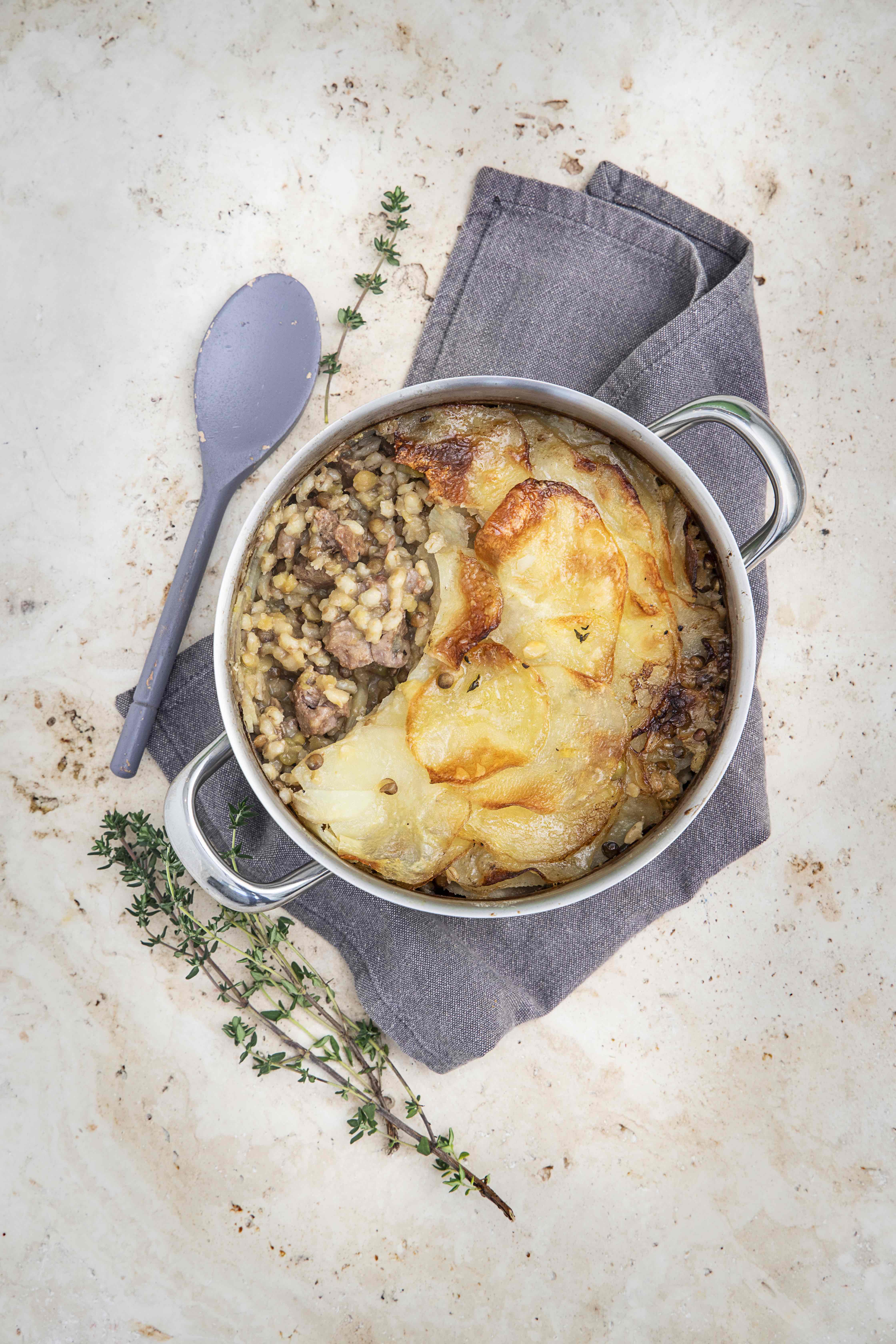 Flynny’s lamb hotpot
Flynny’s lamb hotpot
Serves 4
350g diced lamb shoulder
3 tbsp country relish
1 tbsp prepared English mustard
a few sprigs of fresh thyme
200g broth mix (widely available in supermarkets in the health food aisle – a mix of barley, lentils and split peas)
400ml water
400ml cider (optional but nice – replace with water if you don’t have it)
1 chicken stock cube
5 medium Rooster potatoes, peeled and thinly sliced
a knob of butter
3 bay leaves (fresh if possible)
1 cinnamon stick
• Preheat the oven to 160°C.
• Put the lamb in the bottom of a medium-sized pot or casserole with high sides. Add the relish, mustard and thyme, season with salt and pepper and mix well. Sprinkle the broth mix evenly over the top.
• Pour the water and cider into another pot, add the chicken stock cube and a little salt and pepper. Bring to a simmer briefly, whisking to dissolve the stock cube.
• Cover the lamb and broth mix by overlapping the sliced potatoes on top. They should make two layers or so. Pour the cider stock gently over the top – your potatoes will be immersed, but don’t worry. Dot butter over the top of the spuds, then intersperse the bay leaves and cinnamon stick with the potatoes.
• Cover the pot or casserole tightly with a lid or foil and cook in the oven for 1 hour 15 minutes. Turn the heat up to 190°C. Remove the lid or foil and cook for 25 more minutes, until the potatoes are golden and crisp.
• This would be lovely with a generous blob of redcurrant jelly and a crisp green salad.
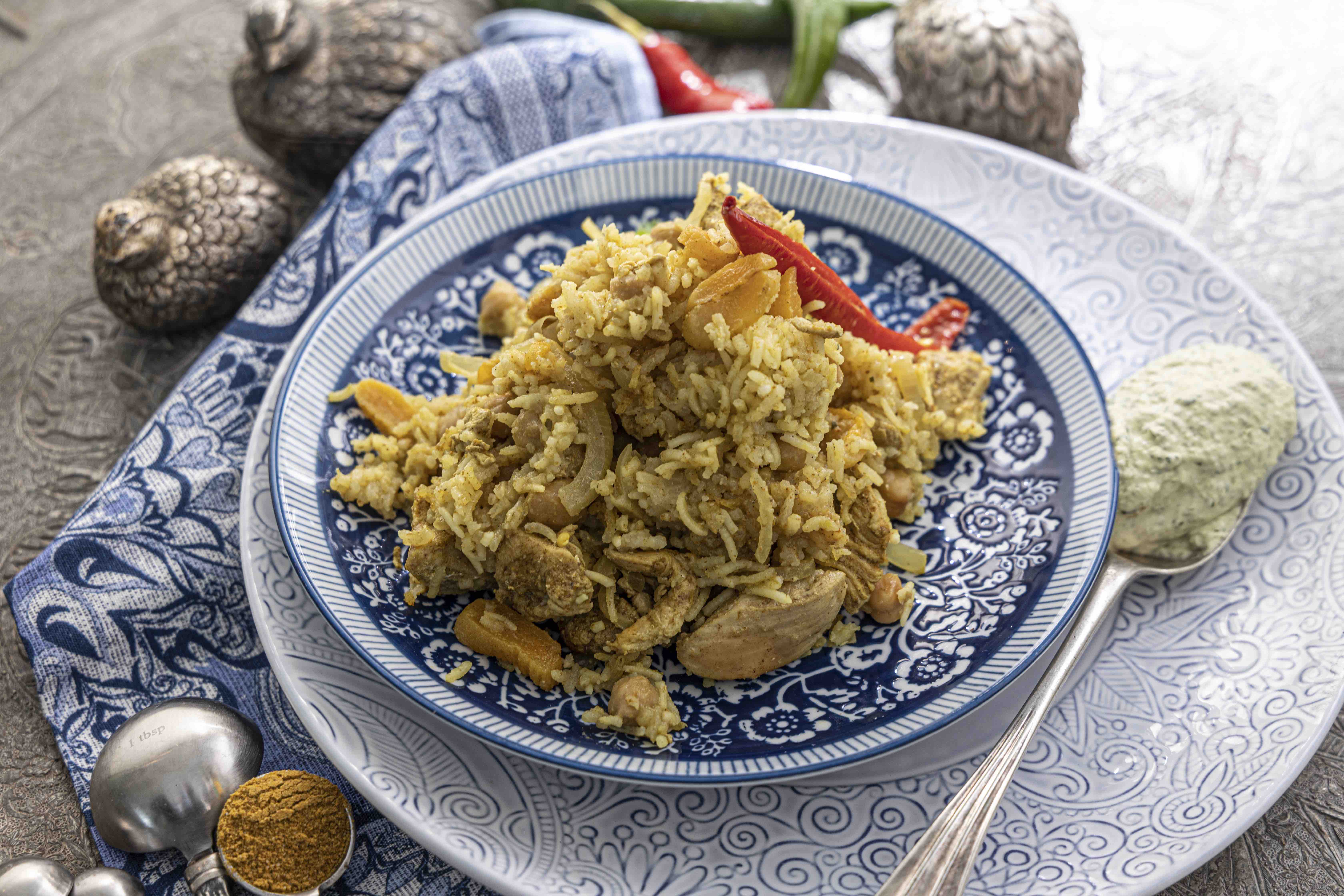 Coronation chicken
Coronation chicken
Coronation chicken rice with lime and coriander cream
Serves 4
50g butter
1 large red onion, thinly sliced
2 garlic cloves, sliced
2 chicken breasts (350g), diced
2 tbsp curry powder
1 x 400g tin of chickpeas, drained and rinsed
300g basmati rice, rinsed
100g dried apricots, sliced
1 fresh red chilli, deseeded and halved lengthways
800ml chicken stock
a pinch of caster sugar
shop-bought crispy onions (optional)
For the cream:
1 x 35g bunch of fresh coriander, roughly chopped (including the stalks)
250ml cream
2 limes – zest of 1 and juice of both
• Preheat the oven to 185°C.
• Melt the butter in an ovenproof saucepan over a gentle heat. When the butter starts to foam, add the onion and garlic and cook gently for 5 minutes. Add the chicken and curry powder and cook for a further 5 minutes, until the onion softens and the chicken colours a little.
• Add the chickpeas, rice, apricots, chilli and seasoning, then stir together. Add the stock and sugar. Bring to a simmer, then cover the pan, transfer it to the oven and cook for 20 minutes.
• Remove the pan from the oven and fork through the rice, then drape a clean tea towel over the pan and replace the lid to form a seal. The cloth will absorb any excess moisture.
• To make the lime and coriander cream, quickly pulse all the ingredients together with a pinch of salt, then chill. Be careful – if you blend too much it will get too thick.
• Serve the rice in warm bowls with the cream drizzled over the top along with a scattering of crispy onions (if using).
Cookery Feature - The New Ballymaloe Bread Book
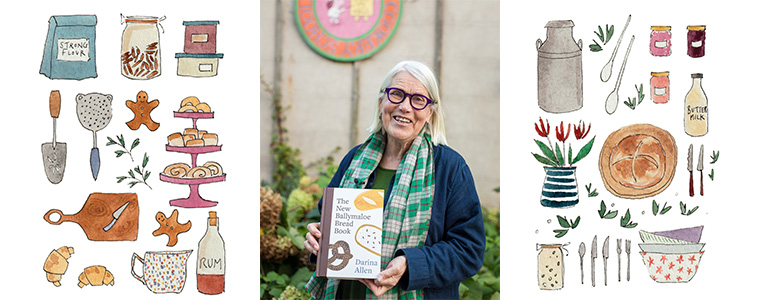
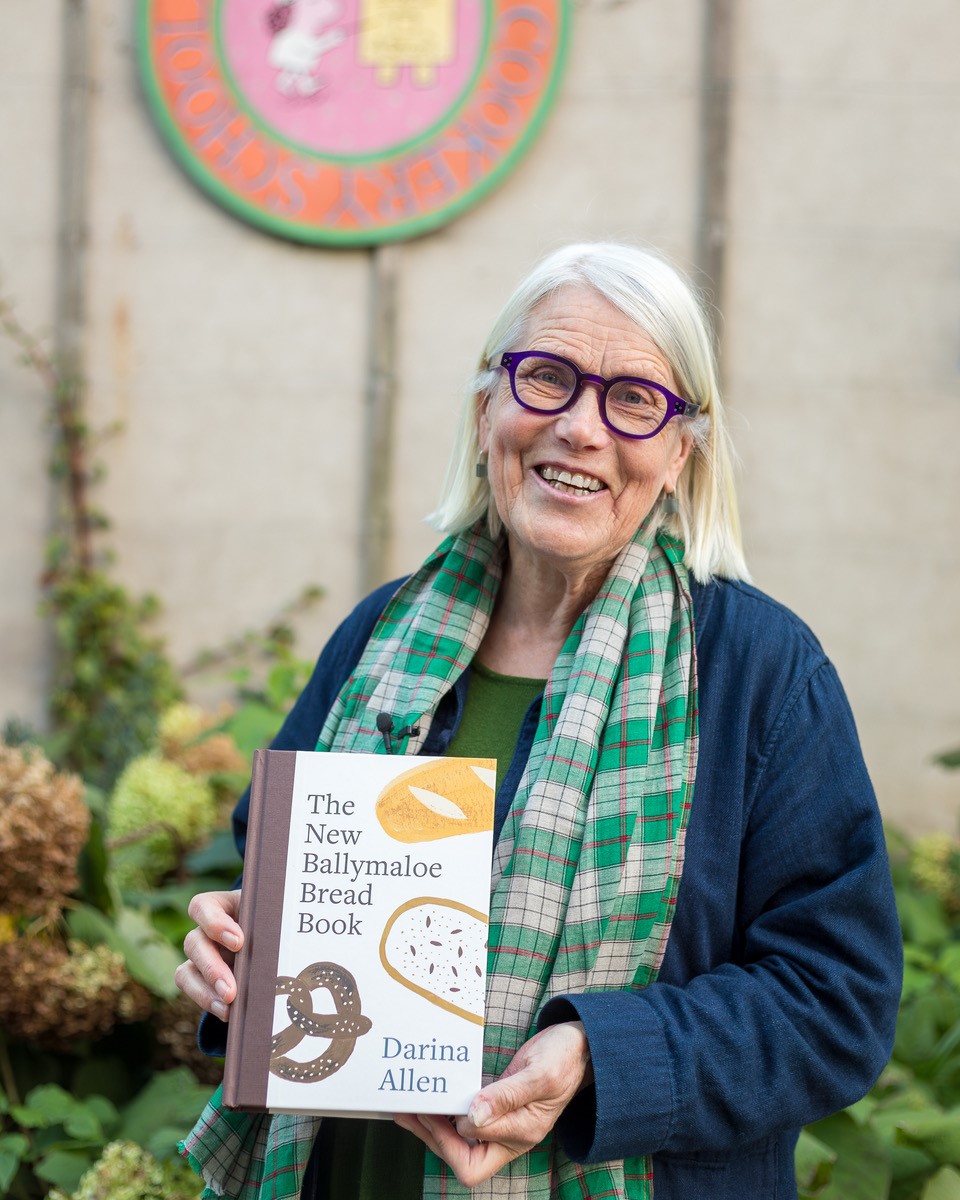 Destined to become the go-to bread-making reference for a new generation of cooks and bakers in Ireland and beyond, Darina Allen’s new book is just what’s needed post-pandemic, and will be a reassuring panacea for many of the world’s ills for many a year to come.
Destined to become the go-to bread-making reference for a new generation of cooks and bakers in Ireland and beyond, Darina Allen’s new book is just what’s needed post-pandemic, and will be a reassuring panacea for many of the world’s ills for many a year to come.
Ireland’s cookery teacher and food ambassador par excellence, Darina has always had a special place in her heart for bread – especially soda bread – and, four decades after she and her brother Rory O’Connell established the incomparable Ballymaloe Cookery School, her fiery enthusiasm is undimmed. As she says in the Introduction, ‘Anyone – and I mean anyone – can make a simple loaf of soda bread: just mix, pour (or, if you don’t have a bread tin, shape it into a floury round and transfer to a baking tray) and pop it into the oven. You wouldn’t have found your car keys and be back from the shops by the time it’s baked. When you share the joy of how to make a loaf of bread, you give a gift for life. So if I could teach only one thing it would be how to make a loaf of soda bread.”
And, of course, there is much more than soda bread in this extraordinary reference, which includes over 180 tried and tested recipes – including yeast bread, the sourdough that kept so many of us going through the pandemic, pizza and focaccia, flatbreads, sweet breads and breads from around the world. There’s a full section on gluten-free bread recipes, as well as a seriously delicious one on what to do with leftover bread (some of the most irresistible recipes, including Queen of Puddings and Brown Bread Ice Cream, are in this section…) and a wide range of sweet and savoury extrasincluding jams, flavoured butters, salsas and tapenades.
Being the teacher that she is, no instructive or useful detail has been overlooked by Darina – everything you need to know about is here, ranging from basic equipment and ingredients (including a list of Irish Artisan Millers), techniques and the reasons for them (such as ‘How To Knead Bread and Why We Do It’), a list of Breads To Make With The Kids and useful websites, including Real Bread Ireland.
And then of course there’s the positivity attached to bread making, not to mention the benefits of eating simple, healthy foods – so, when feeling a bit down, it mightn’t be a bad idea think about these words from Darina: ‘I’ve been making bread all my adult life and most of my childhood, but I still get a thrill every time I take a loaf of crusty bread out of the oven. How wonderful is that?’ And then go and bake some bread.
• The New Ballymaloe Bread Book by Darina Allen, with illustrations by Lydia Hugh-Jones. Hardback, €26.99.
ISBN 978 07171 9585
SAMPLE RECIPES: With Christmas on the horizon, we start with a wonderfully festive recipe for Stollen bread – and, as it is quite a lengthy process, we’ll balance that with one of Darina’s quickest and easiest recipes, the Shanagarry Brown Soda Bread.
 MARY JO’S STOLLEN
MARY JO’S STOLLEN
My lovely American friend and legendary baker, Mary Jo McMillin, shared this delicious stollen recipe with me. It’s a three-day process, but really worth it. Stollen is a fruit bread of nuts, spices and dried or candied fruit, coated with icing sugar and often containing marzipan. It’s a traditional German Christmas bread. Apparently, it was baked for the first time at the Council of Trent in 1545.
Makes 2 × 700g cakes
Brandied Fruit:
250g mixed fruit (sultanas, currants, candied peel - a recipe for preparing your own is given in the book - and/or diced glacé cherries)
2 tablespoons brandy
Yeast Sponge Starter:
15g fresh yeast (or 1 × 7g sachet of dried yeast)
115ml tepid milk
115g strong white flour
Dough:
55g caster sugar
grated rind of ½ lemon
110g butter, softened
2 eggs
5g salt
250g strong white flour
To Finish:
175g marzipan (preferably homemade, a recipe for preparing your own is given in the book)
2 tablespoons melted butter
3–4 tablespoons icing sugar
Day 1
Mix the dried fruit with the brandy in a bowl. Cover with cling film and allow the fruit to macerate overnight.
Day 2
To make the yeast sponge starter, crumble the fresh or dried yeast into the tepid milk in a medium bowl. Set aside in a warm, draught-free place. After about 5 minutes, it should be creamy and slightly frothy on top. Mix in the flour and beat well with a wooden spoon. Cover with cling film and allow to rest in a warm, draught-free place for 30–45 minutes, until light and well risen.
Meanwhile, put the caster sugar in the bowl of a stand mixer. Add the lemon rind and rub it into the sugar with your fingertips. Add the butter and beat with the paddle attachment until creamy. Add the eggs one at a time, beating well between each addition. Add the salt, scrape down the edges of the bowl with a spatula and continue to beat for 1–2 minutes, until soft.
Add the risen yeast sponge to the creamed mixture along with the 250g strong white flour. Switch to the dough hook attachment and knead on a medium speed for 10 minutes, until the dough is silky and soft. It should not stick to your fingers.
Cover the bowl and allow the dough to rise at room temperature for 2–2½ hours, until doubled in size.
Knock back the dough and scrape it out onto a clean flour-dusted surface. Flatten to 1cm and sprinkle the brandy-soaked fruit on top. Roll up like a Swiss roll and knead the fruit into the dough. The dough may growsticky, but avoid adding more flour. Scrape the fruited dough into a bowl, cover and refrigerate overnight.
Day 3
Remove the dough from the fridge and scrape it out onto a lightly floured surface. Divide in half. Shape each half into an oval and roll to about 2cm thick. Make an indentation lengthways along the centre of the dough and lay a 75g long sausage-shaped piece of marzipan on it. Fold over and press to seal. Place each oval approx. 5cm apart on a parchment-lined baking tray. Cover with a clean tea towel and allow to rise in a warm, draught-free place for 4–5 hours, until doubled in size.
Preheat the oven to 180°C/350°F/gas mark 4.
Spray the loaves with a water mister. Bake in the preheated oven for 30–35 minutes, until deep golden and fully cooked. While still hot, brush with melted butter, then sieve some icing sugar thickly over the top.
Cool well on wire racks before slicing. The stollen will keep wrapped for four or five days and may be frozen.
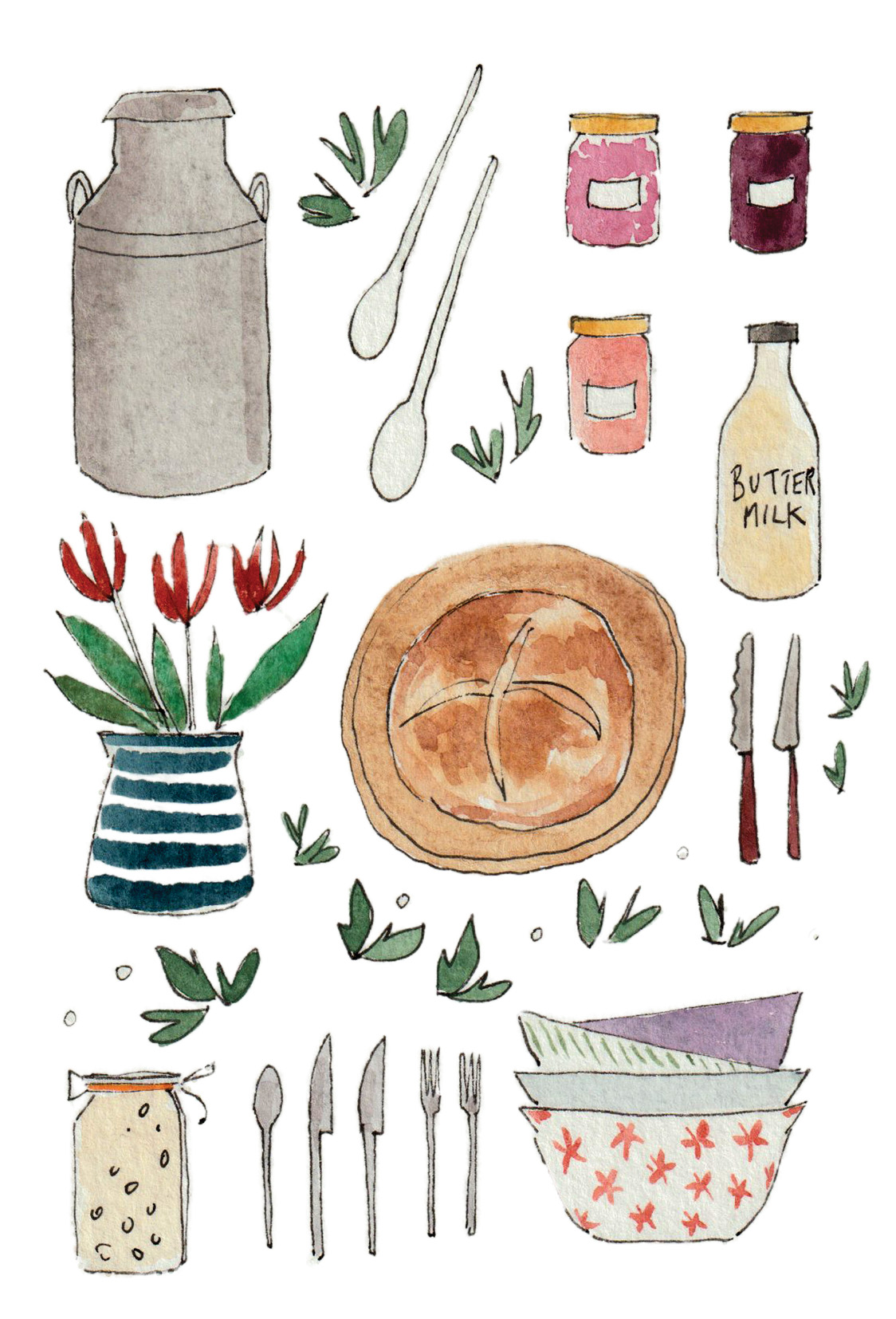 Shanagarry Brown Soda Bread
Shanagarry Brown Soda Bread
This is a more modern version of soda bread. It couldn’t be simpler – just mix and pour into a well-greased tin. This bread keeps very well for several days and is also great toasted.
Makes 1 loaf or 3 small loaves
400g stone-ground wholemeal flour
75g plain flour, preferably unbleached
1 level teaspoon bicarbonate of soda, finely sieved
1 teaspoon salt
1 egg
425ml buttermilk or sour milk (approx.)
1 tablespoon sunflower oil, plus extra for greasing
1 teaspoon honey or treacle
sunflower or sesame seeds (optional)
Preheat the oven to 200°C/400°F/gas mark 6. Grease a 13cm × 20cm (450g) loaf tin or three small loaf tins (14.6cm × 7.6cm).
Put all the dry ingredients, including the sieved bicarb, in a large bowl and mix well. Whisk the egg, buttermilk, oil and honey or treacle together. Make a well in the centre of the dry ingredients and pour in all the liquid.
Mix well and add more buttermilk if necessary. The mixture should be soft and slightly sloppy.
Pour into the oiled tin or tins. Using a butter knife, draw a slit down the middle. Sprinkle some sunflower or sesame seeds on the top (if using).
Bake in the preheated oven for approx. 60 minutes for a large loaf or 45–50 minutes for the small loaf tins, until the bread is nice and crusty and sounds hollow when tapped on the bottom. Cool on a wire rack.
IRISH BOOKS FOR COOKS

At the busiest, buzziest time of year for bookshops, here’s a round up of some of our favourite recent books for cooks and food lovers, to buy for yourself or others – could be just the thing for those book tokens after Christmas…
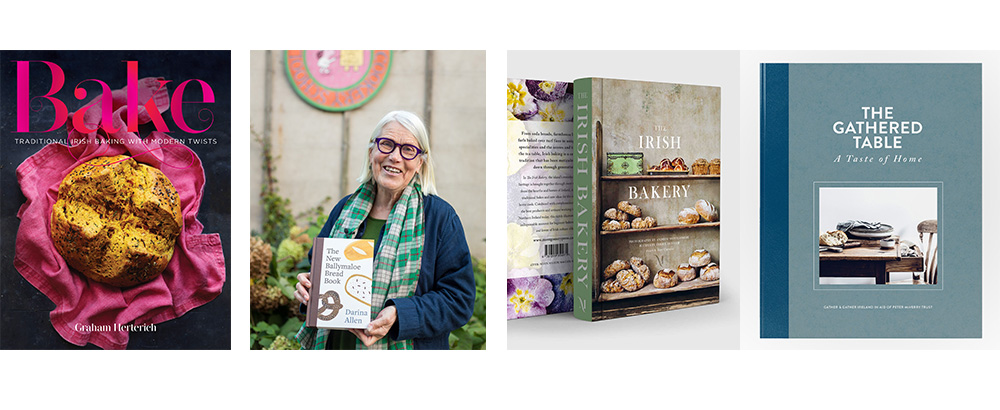
Baking is on a roll these days, but it hasn’t always been like that. Sliced pan was king over a long period in Ireland and when I wrote my own baking book ‘The Best of Irish Breads & Baking’, in the mid ‘90s, it was in the hope of inspiring a revival in home baking. Fortunately things have changed a lot since then and several outstanding baking books have arrived this year, starting with the delightful and highly practical Bake: Traditional Irish Baking with Modern Twists by Graham Herterich, aka ‘The Cupcake Bloke’ (https://ninebeanrowsbooks.com/ Hardback,€25) While it’s a great read, this is a real hands-on baker’s book which, for many people, will change their perception of Irish baking, and of Irish food in general - and also, perhaps, of Graham’s home town of Athy and other rural Irish towns. [Read our review & recipes here] Then along came The New Ballymaloe Bread Book by Darina Allen (Gill Books Hardback, €26.99). A comprehensive work by Ireland’s leading cookery teacher, it’s destined to become the go-to bread-making reference for a new generation of cooks and bakers in Ireland and beyond. Superb in every way, it is just what’s needed post-pandemic, and will be a reassuring panacea for many of the world’s ills for years to come. [Read our review & recipes here] Most recently The Irish Bakery by Cherie Denham and Kitty Corrigan, with photography by Andrew Montgomery (also the publisher) was launched in Belfast in November and promises to be a real treat. It was an a immediate sell-out and we can’t wait to see it when a reprint becomes available in early February 2024. Priced at £27+ P&P, it can be pe-ordered at https://montgomerypress.co.uk/products/the-irish-bakery
And there is a bread connection with pretty much everything in food, including The Gathered Table: A Taste of Home (Hardback, €30) which was launched at in Eoin McCluskey’s super Dublin bakery and café, Bread 41. Originated and compiled by Gather & Gather Ireland and edited by Kristin Jensen of the boutique Irish publishing house Nine Bean Rows, this unusual and beautifully produced collaborative Irish cookbook celebrates the relationship between food and home, in aid of the national housing and homeless charity Peter McVerry Trust, which marks its 40th anniversary this year.[Read our review & recipes here]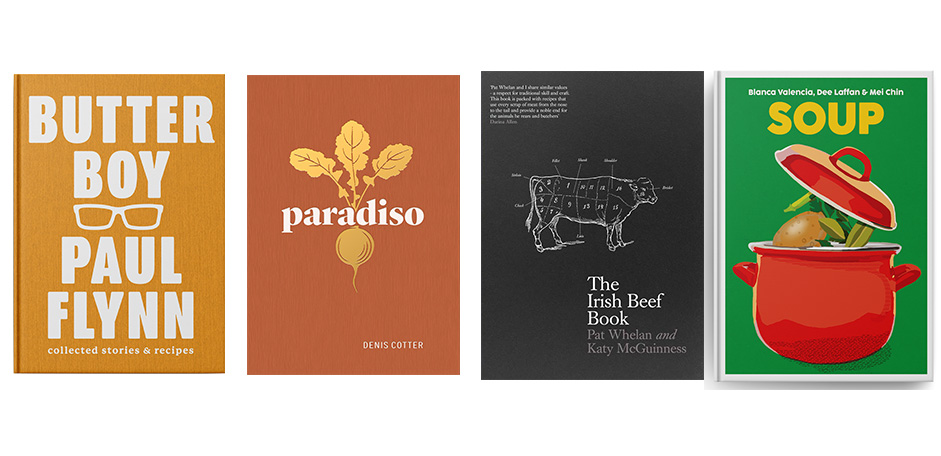
Chef Paul Flynn’s Butter Boy is a lovely big yellow door stopper of a book, jam-packed with his recipes and highly entertaining stories. But it is also important historically as Butter Boy is the complete Irish Times collection of all of Paul’s 152 articles and over 450 recipes from three very unusual years, November 2019 to October 2022, ‘a time when cooking and mealtimes took on new meaning’, and his record of this time through food (and stories) not only resonates for all of us now, but its importance as a record will grow as the pandemic becomes a distant memory. Widely available, €40. [Read our review & recipes here ]
Another highlight this year was the arrival of Paradiso: Recipes & Reflections by Denis Cotter (https://ninebeanrowsbooks.com/ Hardback, €39) a beautiful hardback featuring 160 recipes from the legendary founder of Cork’s pioneering vegetarian Paradiso restaurant, with photography by Ruth Calder-Potts. As pandemic projects go, this is pretty epic - and the forward-looking tone may be a surprise after three decades in business and many awards, when a little nostalgia might be expected. But standing still, or even slowing down, is not in the script at Paradiso, where it’s all about evolution. It’s also a very practical book with pointers on kitchen management, in particular, that will be very helpful to home cooks who like to entertain – and for family events, like Christmas. [Read our review & recipes here] To balance up the vegetarian theme it’s only fair to mention that The Irish Beef Book by well known butcher Pat Whelan and food writer Katy McGuinness celebrates ten years with a special reprint edition – and all proceeds of the classic cookbook are going to Cork Penny Dinners and The Capuchin Day Centre. An ideal Christmas present, available at all good bookshops, online and at Dunnes Stores, price €22.99.
Community and story-telling is very much at the heart of many of the best cookery books, and that’s certainly true of Soup (https://blastabooks.com/ Hardback €15) by Blanca Valencia, Dee Laffan and Mei Chin, co-hosts of the popular Spice Bags podcast. They say that soup connects us all - and the recipes reflect both the individual cultures, memories and tastes of the authors, and Irish food today. [Our review & recipes] A sister publication in the super little Blasta Books range is Tapas by Anna Cabrera and Vanessa Murphy of the wonderful Dublin destination Las Tapas de Lola. Nobody knows more about Tapas than this pair, who say: “Tapas are the perfect party food and even better icebreakers (great for first dates!). They can be enjoyed at a table or bar or simply as finger food. It’s all about sharing. And the best part is that you don’t have to commit to one dish – you can sample them all.” Perfect casual entertaining to, including Christmas. The 72-page A5 cookbook illustrated by Dublin artist Nicky Hooper is available to buy online and in bookshops and independent retailers around Ireland, price €15. Also from a much-loved Dulin chef and restaurateur Spice Box by Sunil Ghai (Penguin ISBN: 9781844885831) hit the shelves running this year. Sub-titled Easy, Everyday Indian Food, it does what it says on the tin so you can expect an authentic but accessible introduction to Indian cooking and over 100 encouragingly easy recipes to cook at home. All the classics are here - delicious kormas, curries, fish dishes, meat-free favourites, desserts and sides from naan breads to raitas and chutneys – and, crucial to the promise of ‘easy’ food, the ingredients are widely available (and probably in stock at home already). Spice Box is widely available, including online from Easons and Dubray Books.
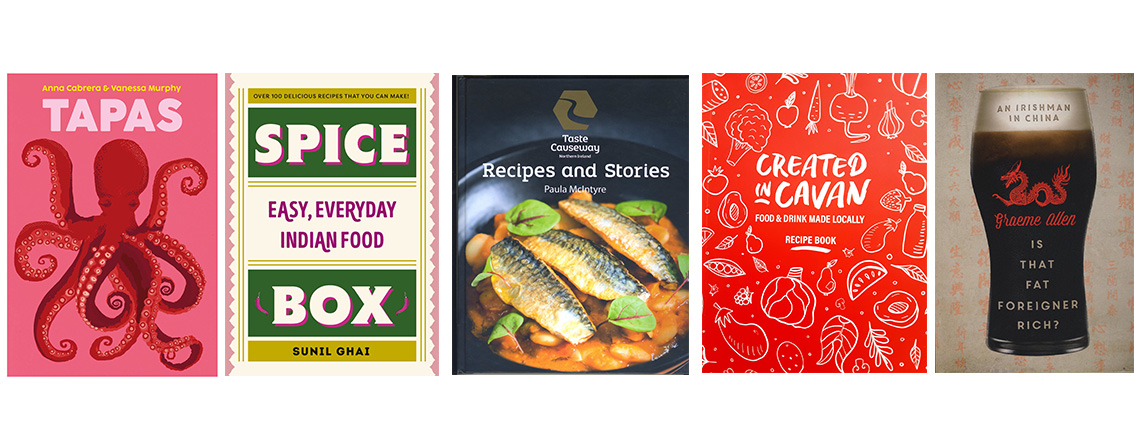
Closely-connected local communities within Ireland are embarking on some great joint projects these days, including Paula McIntyre’s latest book, Taste Causeway – Recipes and Stories (Hardback, £25. Buy online and from some of the businesses featured.). As much a travel guide as a cookbook, the diversity of the produce and 40 or so businesses featured within a relatively small area is remarkable – and, as always with Paula McIntyre, it’s a lovely read. [Read our review & recipes here ] In the same vein, Created in Cavan is a lovely colourful collaborative cookbook from members of the Created in Cavan Food Network. Bringing Cavan’s food, drink and hospitality community together, the aim was to raise the visibility of the county’s outstanding offering, in Ireland and internationally, and to raise funds for several charities - Cavan Autism Parents Support CLG, Breffni Blues Special Olympics Club and Cuan Cancer Support Centre. [Read our review & recipes here ]
Finally, an unexpected treat, Is That Fat Foreigner Rich? An Irishman in China by Graeme Allen (Murphy Brothers Publishing), arrived on the editorial desk recently and while not a cookbook or newly published, it is in print and will be a find for anyone interested in food and hospitality, so well worth seeking out. It’s a rollicking tale of an Irishman abroad the author, a nephew of the late Myrtle Allen, is a man who has done a lot of living - mainly around the hospitality industry - in his 80 or so years. Some of it has been in Ireland with a hotel in Clifden, and there were key times in Australia. But most of it is in China (where he and his Chinese wife run a restaurant) in an increasingly hectic time of devolopment - when he first worked in Shanghai, it was said to be the location of a quarter of the world's active tower cranes. Thus he was inevitably drawn into executive roles with the large-unit international hotel chains, and proved to have a real zest and talent for sales and marketing on the grand scale.
So although China has become much more prosperous and smoothly organised than it was during his formative years of experience there, this entertaining book is a fascinating introduction to the Chinese way of doing things. For instance, they want to feel they have established a personal friendship before working on a business deal. And a bit of private enterprise is always being explored - in one posting, he was at first surprised to find three of his sales staff in head office were giving their phones double use in order to run various personal enterprises in addition to selling rooms in their thousands. It's a bit reminiscent of how the entrepreneurial Albert Reynolds, as Station Clerk on the railway at Dromod in Leitrim, began to build his multi-aspect business empire thanks to his unfettered access to a functioning phone, while in Buenos Aires, a young Greek emigrant called Aristotle Onassis began to create a global shipping mega-business through being on the night shift as a telephone operator.
This fascinating book entertainingly reveals similar attitudes which enabled China - once the restraints of various overly oppressive governments were eventually removed - to be set on course to become the world's second largest economy. Through it all, Graeme Allen made his way. It was often a merry one, but there were dark patches too, while today's China is much changed from the vast mysterious place he was initially drawn to. First published in 2016, this rollicking read has been re-issued in a timely way to entertain, inform and engage the sympathies of today's readers, and is spot-on for the Christmas market. Available online, including from Amazon. Prices vary.
Book Review - A Compendium of Irish Pints - The Culture, Customs and Craic
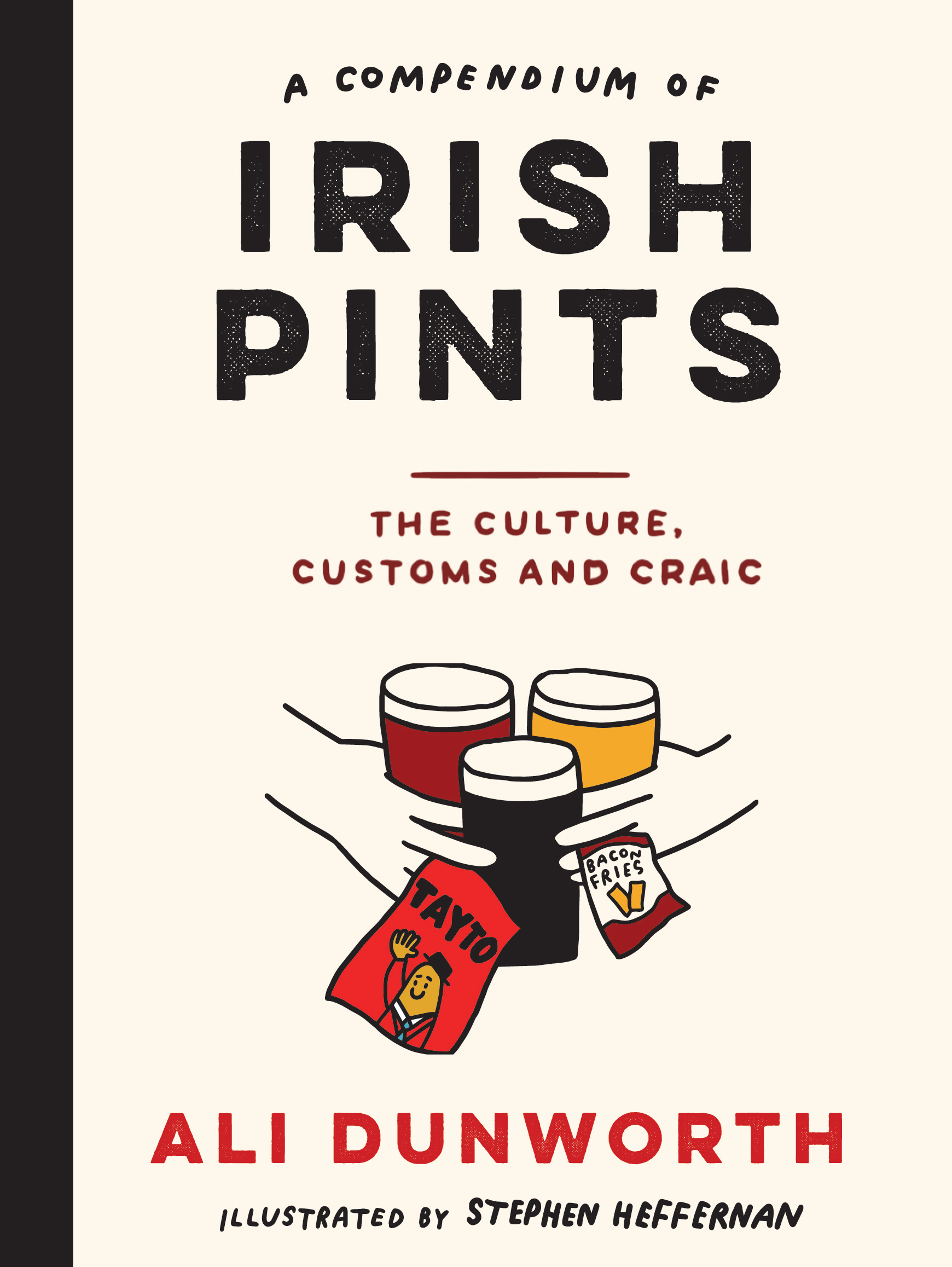
.jpg) Ali Dunworth is well known as a writer, journalist, consultant and events curator ‘who loves writing and talking about food and drink so much that she’s made a career out of it’. And no better woman to come up with the idea for this brilliant book - and to undertake the job so thoroughly, and write it with such warmth and easy flow that the tone sums up perfectly everything that is so dear to us about the pint, and the Irish pub culture.
Ali Dunworth is well known as a writer, journalist, consultant and events curator ‘who loves writing and talking about food and drink so much that she’s made a career out of it’. And no better woman to come up with the idea for this brilliant book - and to undertake the job so thoroughly, and write it with such warmth and easy flow that the tone sums up perfectly everything that is so dear to us about the pint, and the Irish pub culture.
As her (highly empathetic) publishers say in the press release, “In Ireland, a pint – having one, going for one, buying one – is a cultural institution. It’s so much more than 568ml of beer in a glass. But how did a simple pint become such a phenomenon? Like all great superheroes, the pint has its own origin story, a full-bodied narrative that explains how the beloved beverage came into being and part of everyday life.”
It’s a great read and perfectly packaged in a neat hardback that will tuck handily into a handbag or large pocket for a chuckle wherever you need it. And Stephan Heffernan’s illustrations are the perfect accompaniment too - get the flavour of this little work of genius in the extract below. Sláinte!
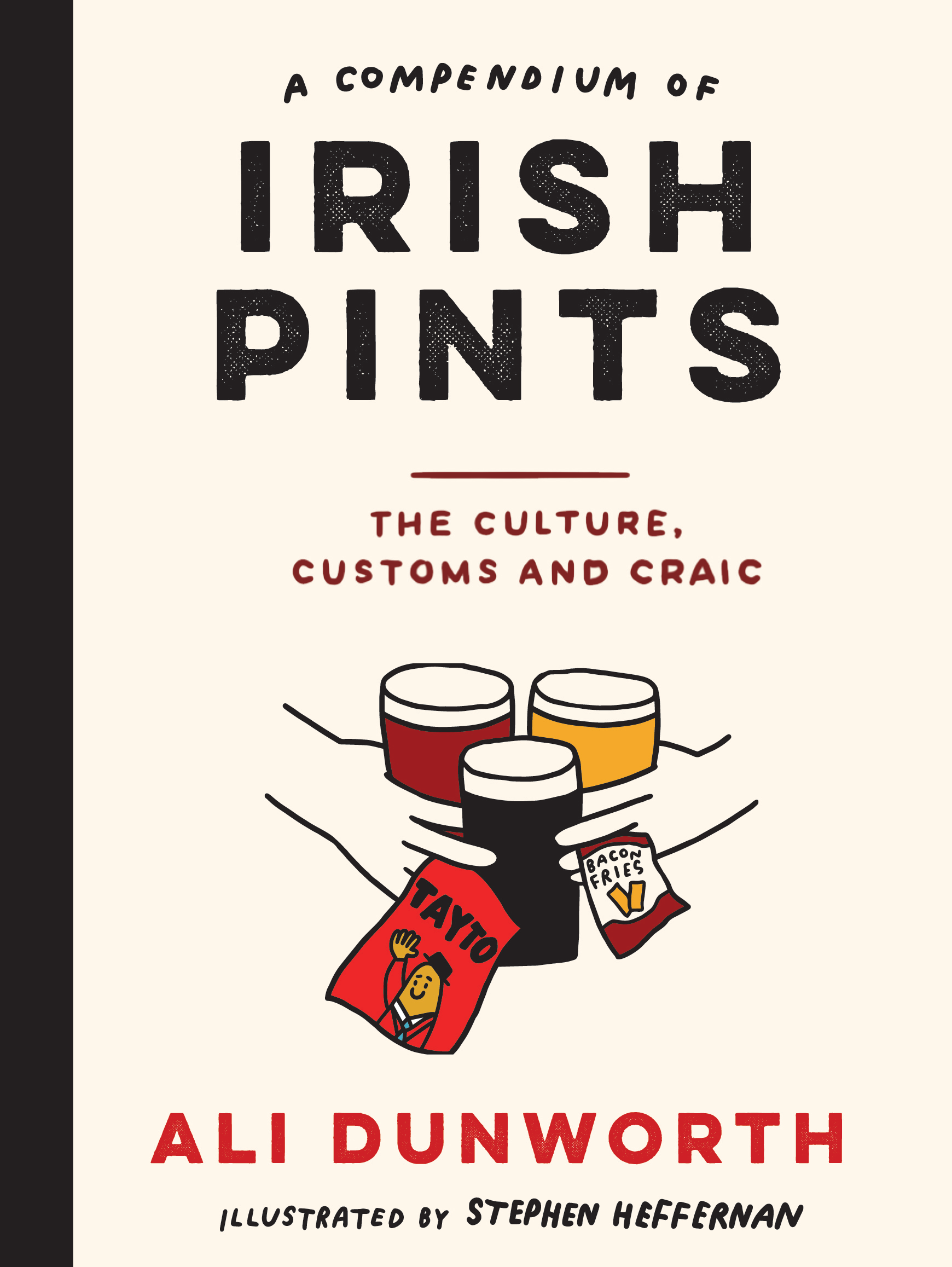 “A Compendium of Irish Pints” by Ali Dunworth is published by Nine Bean Rows and illustrated by Stephen Heffernan. It is available from all good bookshops and many independent retailers around the country as well as online at ninebeanrowsbooks.com.
“A Compendium of Irish Pints” by Ali Dunworth is published by Nine Bean Rows and illustrated by Stephen Heffernan. It is available from all good bookshops and many independent retailers around the country as well as online at ninebeanrowsbooks.com.
 AFTER-WORK PINTS
AFTER-WORK PINTS
Unwinding after work with a drink, shaking off the day and the shackles, getting to have some unstructured time with your colleagues to build camaraderie or bitch about your boss – few things taste better than that well-earned after-work pint, so it’s no wonder drinking after (and sometimes during!) work has been part of human culture in various forms for a long time.
A short history of after-work pints
The practice of a post-workday pint in a pub kicked off around the Industrial Revolution. As Ireland became more urban and industrial work increased, people gathered at pubs or taverns after working on the docks or in a mill (people predominantly being male, which was a factor in how the pub was traditionally the preserve of men – see also ‘The old man’s
pub’ for more on this). Alcohol began its infamous relationship with the after-work crowd and after-work drinks eventually became a staple ritual to separate work from play.
In Kingsley Amis’s book On Drink, he writes about the rapid increase in drinking in urban cultures:
'The strains and stresses of urban living, to coin a phrase, are usually held accountable for these increases … sudden confrontation with complete or comparative strangers in circumstances requiring a show of relaxation and amiability … the reason why I, and most others, usually turn out to enjoy meeting such creatures is simply and obviously the co-presence of drink.'
The three types of after-work pints
After-work pints can differ depending on the type of job you have but in general there are three main types of situation you are likely to encounter when you swap the swivel chair for the bar stool.
The swiftie When you genuinely go for just the one. You have one pint that quenches your thirst and marks the end of the day and the start of the evening (or even better, the weekend). You have a nice brief chat with your work friends, then you head off. This after-work pint tends to be a bit of a unicorn, though. Calling it after one pint is not a skill that everyone has in them.
The proper pints This is the sweet spot. It may be an occasion, a birthday, a leaving do or just a Friday or sunny midweek evening, but whatever it is there’s a reason you should stay for more than one. Bonus if someone’s there with a company card buying the drinks. You get the polite chat out of the way and then you get a bit more into it. You end up sitting beside your work bestie or someone you’ve wanted to have a gossip or a chat with or maybe even someone you fancy. The pints and the chats flow. When the proper pints go well, you’ve bonded, you’ve laughed, you’ve had a good time. Ideally you don’t say anything too inappropriate or overshare. This is after-work pint perfection.
The one too many (oh no, what did I do/say?) It started out as proper pints. Things were going well but you or someone else got carried away. There was that extra pint you said you didn’t need, someone ordered shots or maybe you were deep in a bitching session and didn’t want to leave. Whatever the reason, if you’ve been there, you know – and you may still
even have the fear about whatever happened or was said. Let there be solace in knowing you are not alone. The less said about the one-too-many-after-work drinks, the better.
After-work pints in the hospitality industry
Anyone who works in hospitality has another take on after-work pints because they have their pints when we’re all at home in bed or recovering from the night before. Irish chef Christine Walsh describes the magic of off-duty chef pints perfectly:
'Picture this. You’ve worked for 10 hours straight. You’re annoyed, exhausted and fed up. You’re off tomorrow but no plans are made. Half an hour to finish and your mate texts, ‘Pint?’ It’s one of the best feelings – giddiness, excitement, knowing you can go and sit in a pub, no rush on anyone, have talks and laughs and just completely decompress for a few hours in the company of the people you’re most comfortable being around before going home. My favourite type of pint is on a Sunday afternoon, when all the messy arseholes from Saturday nights have crawled home in bits. Sundays are left with the best people out just wanting slow, happy, drama-free pints. Going for pints is not about getting pissed. It’s the social, banter-loving atmosphere that we crave the most with the people we like the most.'
 AIRPORT PINTS
AIRPORT PINTS
There is an unwritten rule once you pass airport security that you are in no man’s land when it comes to time, which means having a drink is acceptable – and often encouraged – at any time of the day. It’s always five o’clock somewhere when you’re in a departure lounge. Dublin Airport is a particularly good example of this, with Terminal 1 leading the way. Even if you arrive bleary-eyed in the wee hours, someone will be drinking a pint. At busy times there’s a palpable buzz that only adds to the excitement if you’re heading off. For many, the airport pint is a holiday tradition. They plan to get there early, meet with friends and catch up. It’s the ultimate klaxon to say, right, I’m switched off and holiday mode is on. You might spot groups in matching tracksuits with ‘Team Bride’ emblazoned on the back tucking into drinks before they board their Ryanair flights to Spain or rowdy gangs in matching T-shirts proclaiming their tribe (Johnno’s Stag! Mary’s 50th!) en route to Liverpool or Vegas. In the 1950s, the Dublin Airport restaurant was the place to be. It was a chic, linen tablecloth affair. People with no intention of ever flying would get dressed up and head there for the evening. Dances were even held there. No doubt a few bottles of porter were drunk. It’s no wonder there’s still a sense of devilment in the air when you get there. Non-drinking travellers look on and laugh (mostly) and business travellers pretend to ignore them and tap on their laptops. Couples heading off without their kids (yay!) order a drink, looking forward to the undisturbed sleep as much as as much as the sunshine. Solo travellers sip away and enjoy the unrivalled people-watching an airport offers. Then there are the travellers who are leaving Ireland for a while, cherishing what might be their last decent pint until they return.
Whatever the reason, the airport pint is unique and the camaraderie in Irish airport bars is something not seen elsewhere. And it’s become a ubiquitous social media post. You’d think you can’t get on a flight without uploading a ‘pint and passport’ picture along with a cheesy caption like ‘Out of office is on!’ Guinness has cottoned on (as they usually do) that there’s quite the demand for a perfect pint of the black stuff before people head off and in 2022 opened a dedicated Guinness bar in Dublin Airport’s Terminal 1. It’s a fine pour there and it’s hard to resist a quick stop if you’ve got 20 minutes to spare. If you’re not an airport pinter, why not? Next time you fly, try it for yourself – just don’t forget your ‘out of office’ social media post.
Cookery Feature - A Taste of Malaysia
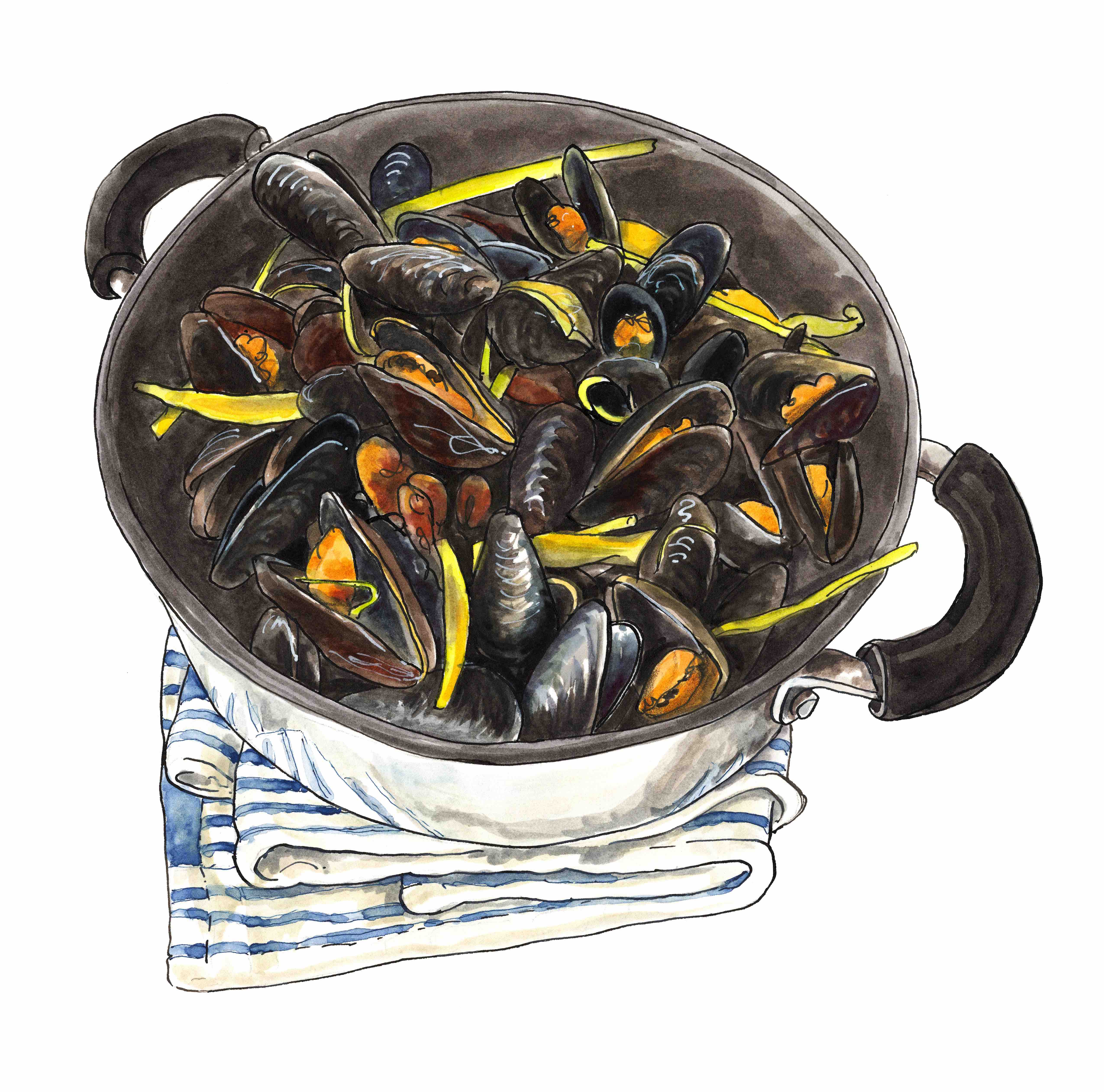
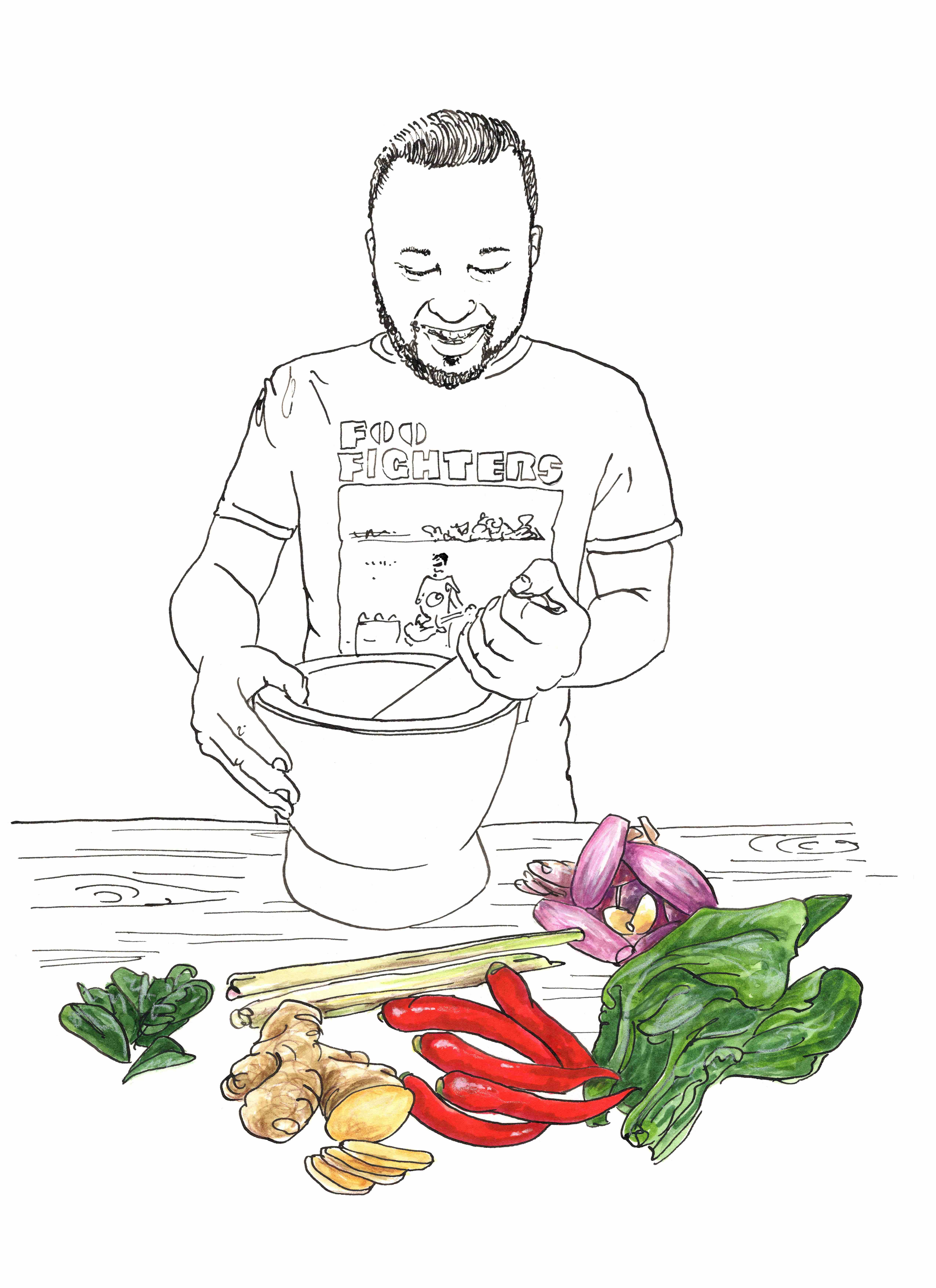 Well known for his regular appearances on Virgin Media One’s Six O’Clock Show, where he demonstrates easy Asian-style dishes, the engaging Malaysian-born Euro-Toques restaurateur, chef and cookery teacher Shamzuri (‘Sham’) Hanifa has earned many fans (and accolades) for the terrific businesses that he owns/co-owns - The Cottage Restaurant in Jamestown, and two newer enterprises, Buffalo Boy and My Kitchen by Sham Hanifa, in Carrick-on-Shannon, and his authentic Chef Sham Sauces range - each a reminder of the hospitality credentials of this important riverside destination. Originally from Malaysia, he moved to Co Leitrim in 2000 and has since become a driving force in the region’s food and hospitality sector, bringing new energy and diverse flavours to a part of Ireland that can sometimes be overlooked – and, as we said in our annual awards last autumn, he is a true ‘Taste of the Waterways’ hero.
Well known for his regular appearances on Virgin Media One’s Six O’Clock Show, where he demonstrates easy Asian-style dishes, the engaging Malaysian-born Euro-Toques restaurateur, chef and cookery teacher Shamzuri (‘Sham’) Hanifa has earned many fans (and accolades) for the terrific businesses that he owns/co-owns - The Cottage Restaurant in Jamestown, and two newer enterprises, Buffalo Boy and My Kitchen by Sham Hanifa, in Carrick-on-Shannon, and his authentic Chef Sham Sauces range - each a reminder of the hospitality credentials of this important riverside destination. Originally from Malaysia, he moved to Co Leitrim in 2000 and has since become a driving force in the region’s food and hospitality sector, bringing new energy and diverse flavours to a part of Ireland that can sometimes be overlooked – and, as we said in our annual awards last autumn, he is a true ‘Taste of the Waterways’ hero.
Agak-Agak - a term heard across Malaysia, meaning ‘to estimate’ - is where cooking is about instinct rather than measurements and in this book Sham translates those instincts into dishes that show his own personal representation of the Malaysian flavours he grew up with. As in all the Blasta Books range, the recipe collection is all about the back story – and, growing up in Taiping, surrounded by Chinese and Thai food influences from his maternal side and Indian and Malay influences from his paternal side, this is Sham’s fascinating mash-up of Malaysian flavours that introduce readers to favourite family dishes, as well as dishes offered in his much-loved restaurants.
With 30 easy-to-follow recipes for traditional street foods [Malaysian Stuffed Tofu], slow-cooked curries [Lamb Rendang], speedy stir-fries [Thai-style Chilli Beef], savoury soups [Crab Laksa], and plenty of ideas for leftovers [Indonesian Fried Rice] or celebrations [Chicken Sambal], Sham shares the taste and aromas of his childhood, and the family who inspired him. With fun diagrams, helpful suggestions on batch cooking, clever cooking tips to get the most out of your ingredients and the three ingredients key to Malaysian cooking, Agak-Agak is a big flavour punch in a little book.
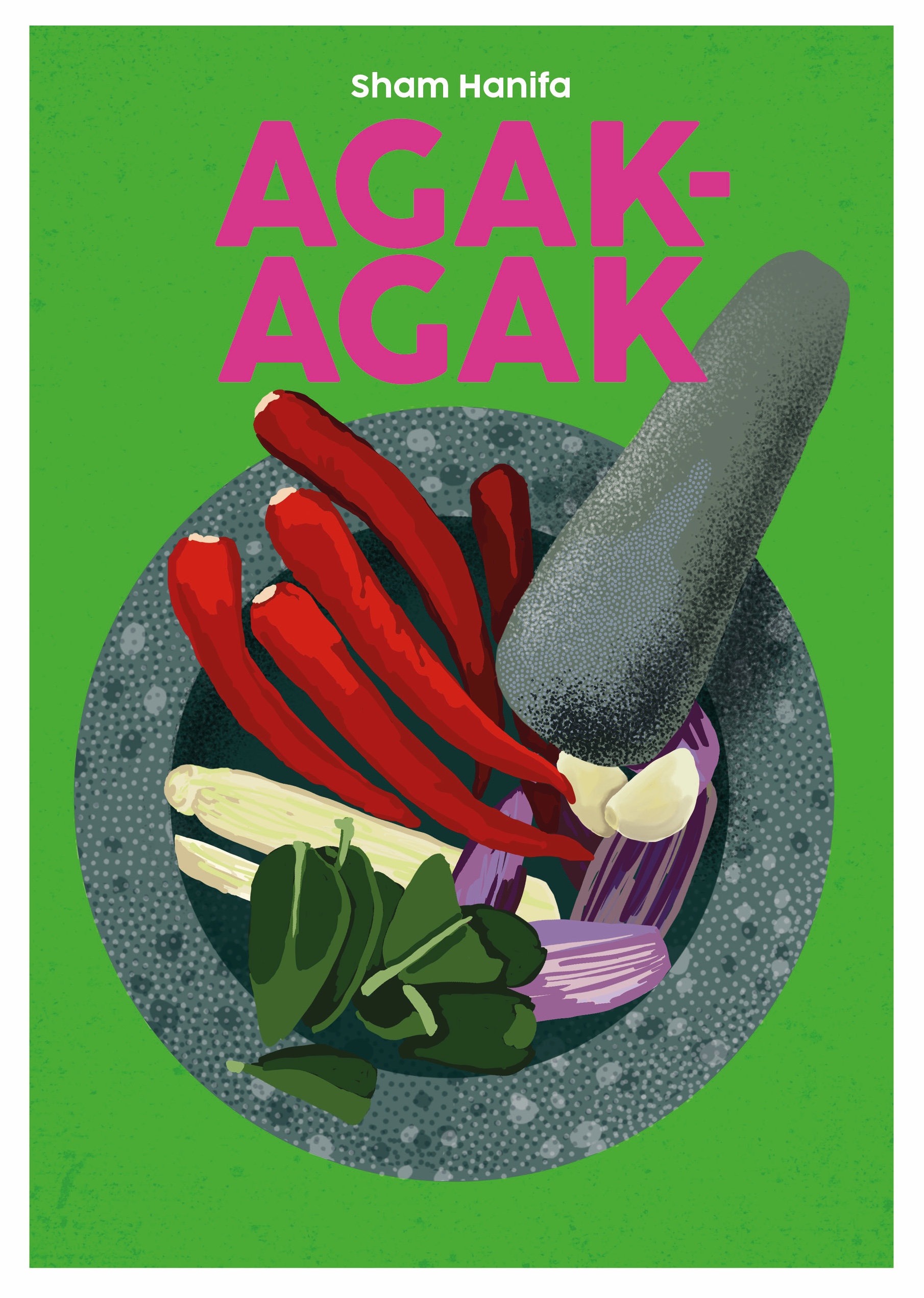
Blasta Books #11: AGAK-AGAK Publication: July 2024. Hardback, 70pp, RRP €15/£13
SAMPLE RECIPES from Blasta Books #11: Agak-Agak by Sham Hanifa is published by Blasta Books (€15)
%20LR.jpg) Gaeng prik khiao waan (Thai green curry)
Gaeng prik khiao waan (Thai green curry)
I always say that whatever I put into a dish, I want to get it back – I want to taste all the ingredients, so everything should be there for a reason. For me, this is the perfect way to eat aubergine, green beans and tofu. You can use any veg you like but cook hard veg like carrots or squash longer than soft veg like broccoli, green beans and aubergine. It’s comforting to eat when you’ve had enough meat for the week. [I will be trying this recipe with the organic West Cork Otofu that I picked up in Bandon’s wonderful URRU culinary store last week…GC]
Serves 4
FOR THE GREEN SPICE PASTE:
4 garlic cloves, chopped
3 shallots, chopped
3 fresh green chillies, chopped
2 lemongrass stalks, chopped
a thumb-sized piece of ginger, peeled and chopped
a thumb-sized piece of galangal, peeled and chopped
a large handful of fresh coriander (leaves and stems)
1 tbsp caster sugar
1 tbsp fine sea salt
FOR THE CURRY:
1 block of tofu, cubed
2 tbsp vegetable oil, plus extra for deep-frying
1 shallot, chopped
1 tsp grated garlic
2–3 lime leaves, torn
juice of 1 lime
1 tbsp caster sugar
1 tbsp fish sauce
1 tsp fine sea salt
1 x 400ml tin of full-fat coconut milk
2 tbsp soy sauce
1 carrot, chopped
½ small squash, chopped
a handful of broccoli florets
a handful of green beans, chopped
½ aubergine, chopped
TO FINISH:
1 lime leaf, shredded
juice of ½ lime
1 tsp caster sugar
1 tsp fish sauce
TO SERVE:
boiled jasmine rice
To make the spice paste, blend all the ingredients until smooth in a high-speed blender or crush them together in a pestle and mortar. You need only 4 tablespoons for this curry, so save the rest for another dish.
Deep-fry the tofu until it’s golden brown all over. Drain on kitchen paper and set aside.
Heat 1 tablespoon of the oil in a large saucepan on a medium heat. Add the shallot, garlic and lime leaves and cook for 2 minutes, until fragrant. Add 4 tablespoons of the green spice paste and the other tablespoon of oil and cook for 2 minutes, stirring constantly.
Add the lime juice, sugar, fish sauce and salt and cook for 30 seconds, then stir in the coconut milk and soy sauce. Turn the heat up to high and add the carrot and squash (or any hard veg you’re using). Bring to a boil, then reduce the heat to a simmer for 8–10 minutes, stirring occasionally, until reduced slightly.
Add the broccoli, green beans and aubergine (or any soft veg you’re using). Simmer for 5 minutes, then add the tofu to heat it through. Keep cooking until the sauce is nice and thick – it should be coating the veg, which should all still be holding their shape. When my mother cooks this dish she will reduce the sauce a little bit more than usual to allow all the flavour from the green curry to bind nicely with the vegetables.
Finish with the shredded lime leaf, lime juice and a final teaspoon each of sugar and fish sauce. I serve this with jasmine rice because it has more starch and is a little stickier than other kinds of rice, so it works beautifully to soak up the curry sauce.
%20LR.jpg) Phad gra pow (Thai basil beef)
Phad gra pow (Thai basil beef)
When I was growing up, my Thai grandparents lived with us until I was 13 years old. My grandmother was a cook at the Buddhist temple, where she cooked for the monks and visitors. She made this dish with pork but my mother uses the best bit of beef she can get instead. It always brings back memories of my childhood for me. Serves 4
FOR THE MARINADE:
2 tbsp soy sauce
1 tsp grated garlic
1 tsp light brown sugar
1 tsp ground black pepper
500g beef fillet, sliced very thinly
TO COOK:
2 tbsp vegetable oil
2 garlic cloves, thinly sliced
a thumb-sized piece of ginger, peeled and thinly sliced
1 shallot, thinly sliced
1 fresh red chilli, thinly sliced at an angle
1 tsp ground black pepper
2 tbsp oyster sauce
1 tbsp soy sauce
2 tbsp water
1 tsp light brown sugar
1 tsp slaked cornflour (i.e. cornflour mixed with a little liquid)
a handful of fresh Thai basil leaves
TO SERVE: boiled basmati rice
Mix together the soy sauce, garlic, sugar and pepper. Put the beef in a shallow bowl or baking dish and pour over the marinade. Set aside for just 15 minutes while you prepare the rest of the ingredients.
Put a dry wok or a large frying pan on a high heat and let it get really hot – don’t add any oil. Add the beef and stir-fry for 1 minute, then push it to the sides of the wok or pan to keep the middle clear.
Add the oil, garlic and ginger and stir-fry for 30 seconds. Add the shallot, chilli and black pepper, then mix the beef back in. Stir-fry for another 30 seconds, then add the oyster sauce and soy sauce. Cook for 1–2 minutes, then pour in the water to dilute the saltiness. Let it bubble up and reduce, then stir in the sugar, cornflour and most of the basil. Cook until the sauce thickens and coats the beef.
Serve with boiled basmati rice and garnish with the remaining whole basil leaves.
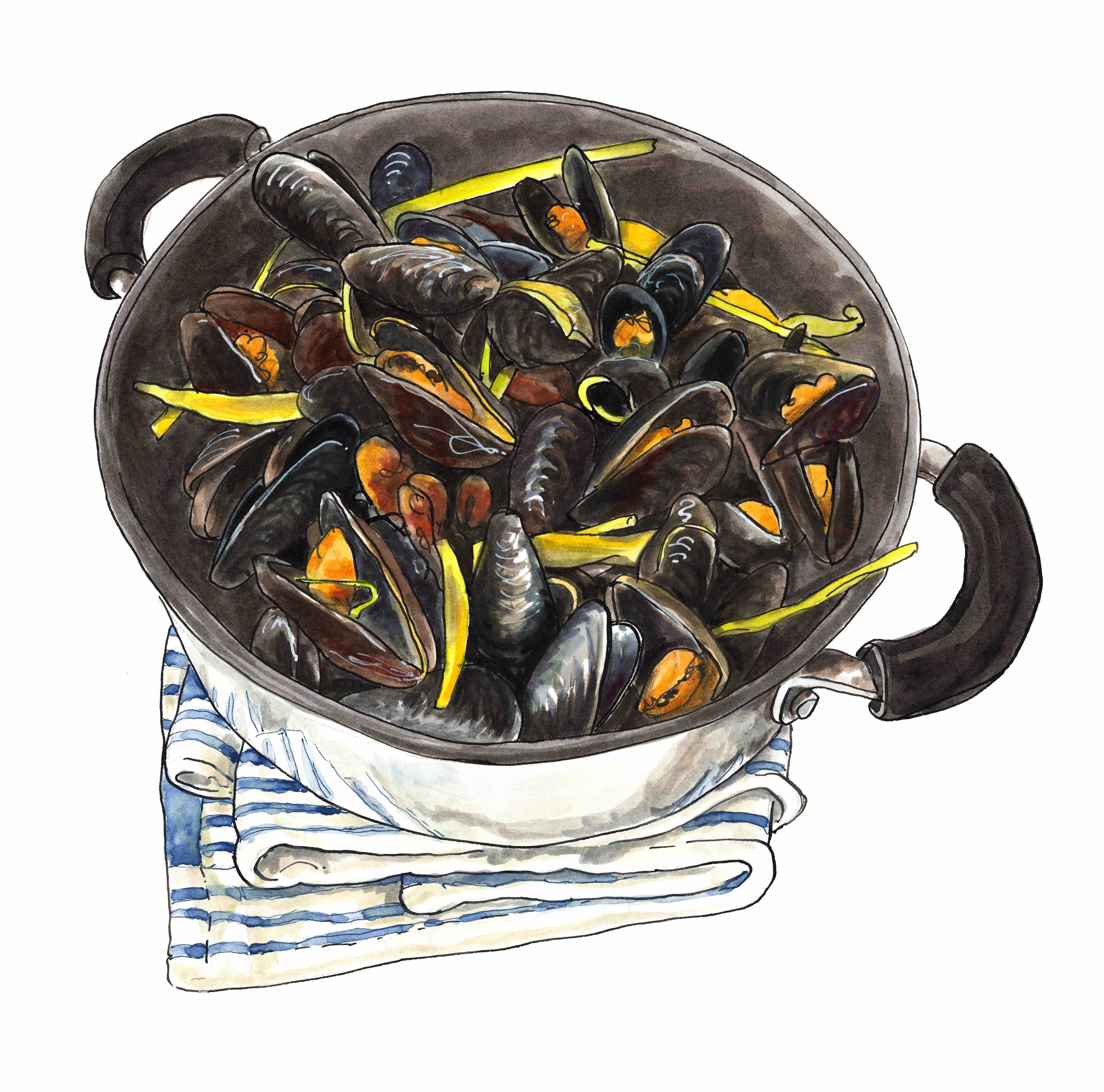 Mussels with coconut, lemongrass, lime and ginger
Mussels with coconut, lemongrass, lime and ginger
Living in Ireland for the past 23 years, I’ve had the chance to travel all over the country with Euro-Toques to see and taste the best of Irish produce, including a boat trip in the Killary fjord to taste beautiful Irish mussels. With my Asian background, I love to create East-meets-West dishes like this one. Originally this masak lemak recipe uses clams, cockles or periwinkles but I decided to use mussels. It’s simple and quick to prepare if you already have the spice paste in the fridge or freezer. Just fry the paste to bring up the aroma, then add the coconut milk and mussels and it’s ready in no time. Serves 4
FOR THE SPICE PASTE:
3 garlic cloves, chopped
2 lemongrass stalks, bottom halves only, thinly sliced (save the tops)
2 bird’s eye chillies, chopped
2 thumb-sized pieces of ginger, roughly chopped
juice of 1 lime
1 tbsp fish sauce
1 tbsp water
1 tbsp ground turmeric
1 tsp ground coriander
FOR THE MUSSELS:
1kg mussels
1 tbsp vegetable oil
1 shallot, halved lengthways and thinly sliced
1 garlic clove, thinly sliced
1 bird’s eye chilli, halved lengthways
1 tbsp spice paste
50ml water
1 x 400ml tin of full-fat coconut milk
juice of ½ lime
1 lime leaf
1 tbsp fish sauce, plus extra to taste
1 tsp light brown sugar
To make the spice paste, blend all the ingredients until smooth in a high-speed blender or crush them together in a pestle and mortar. You need only 1 tablespoon of the paste for this dish, so save the rest for another time.
Rinse the mussels under cold running water and debeard them. If any are open, give them a gentle tap on the countertop. If they close, they’re safe to eat. If they stay open, throw them away.
Heat the oil in a large saucepan on a medium heat. Add the shallot, garlic, chilli, lemongrass tops and 1 tablespoon of the spice paste. Cook for 1 minute, then add the water and cook for 30 seconds before stirring in the coconut milk. Bring up to a simmer, then add the lime juice, lime leaf, fish sauce and brown sugar.
Add the mussels, cover the pan and give it a quick shake. Cook for 3 minutes, until all the mussels have opened. Discard any that are still closed. Taste the sauce and adjust the seasoning with more fish sauce if needed.
To serve, divide among four wide, deep bowls.
Blasta Books 11: Agak-Agak by Sham Hanifa is published by Blasta Books (€15)
Cookery Feature - TANGO


Nothing brings people together like food and nowhere do we see this demonstrated better in Ireland than in the Blasta Books cookery series, which tells the stories of an extraordinary diverse range of chefs and cooks through their food.
 Tango, the fourteenth in the series, is by Facundo Rodulfo and Pam Neumann, the Argentinian couple behind Munster’s first Argentine restaurant, the popular Tango Street Food (which started as a food truck in the pandemic), in Killarney, Co Kerry. Originally from Buenos Aires, they moved to Ireland in 2018 and - very aware of the power of food to transcend borders, connect people and create community - they thoroughly enjoy sharing the flavours of their homeland, while also fostering cultural awareness and togetherness through food.
Tango, the fourteenth in the series, is by Facundo Rodulfo and Pam Neumann, the Argentinian couple behind Munster’s first Argentine restaurant, the popular Tango Street Food (which started as a food truck in the pandemic), in Killarney, Co Kerry. Originally from Buenos Aires, they moved to Ireland in 2018 and - very aware of the power of food to transcend borders, connect people and create community - they thoroughly enjoy sharing the flavours of their homeland, while also fostering cultural awareness and togetherness through food.
From the iconic empanadas chosen for the cover illustration, to stuffed pizzas and family favourites such as Argentine shepherd’s pie and chocotorta, Tango showcases a fusion of Argentine and Italian street food-style recipes that bring Argentine food culture to everyone’s table. Like the dance that the book is named after (emotion, history, passion…) the recipes all tell their story of love, tradition and unity - and it’s a great read.
Tango (illustrated by Ciara Coogan; hardback 72pp, price €17.00) is available in bookshops and speciality stores, or buy online from the publisher https://blastabooks.com/products/blasta-books-14-tango
A Couple of Recipes To Try:
 Pastel De Papa / Argentinian Cottage Pie Recipe
Pastel De Papa / Argentinian Cottage Pie Recipe
You might be surprised – as we were when we moved to Ireland - that pastel de papa is one of our cherished recipes. It makes you wonder how we can have so much in common even when we’re from such different countries. As we always say, food has a unique way of bringing us together. Take this cottage pie for example. It’s a beloved traditional dish in both Ireland and Argentina, and a true cultural staple. No matter where you’re from – whether you’re Irish, Argentinian, or anything else - we think you’ll find comfort in it. We’re excited to share our family's version of this classic with you.
Serves 10-12
Ingredients
4 hard boiled eggs
3 tbsp olive oil
3 medium onions, chopped
1 red pepper, chopped
1 garlic clove, chopped
1 tsp chilli flakes
1 tsp sweet paprika
1kg (2¼1b) beef mince
400ml (12/3 cups) tomato passata
1 tsp salt
1 tsp ground black pepper
Mashed Potato Topping
2kg / 4½lb potatoes, peeled & roughly chopped in chunks
1 tsp salt
110g / ½ cup unsalted butter, diced
120 ml / ½ cup milk
1tsp ground black pepper
pinch of ground nutmeg.
To serve: freshly grated Parmesan cheese.
Preheat the oven to 200°C fan (400°F fan).
Hard-boil the eggs – boil for 8 minutes, then cool under cold running water before peeling and chopping. Set aside.
This is how we make the mas, but feel free to use your own family recipe
If you like like. Put the potatoes in a large saucepan and cover with water by at least 3cm (1¼ in). Add the salt and bring to a boil, then reduce the heat and simmer 10-15 minutes, until the potatoes are tender. Drain in a colander, then return them to the saucepan and allow them to steam dry. Add the butter, milk, pepper and nutmeg and mash together while the potatoes are still hot.
Heat the oil in a large frying pan on a high heat. Once the oil is good and hot, add the onions and red pepper - they should sizzle when you add them to the pan. Cook for 3 minutes, then add the garlic and cook for just a moment, as it can easily burn. Add the chilli flakes and sweet paprika and cook for 30 seconds then stir in the beef mince and tomato passata and season with the salt and pepper. Break up the mince with the back of a wooden spoon and cook for about 15 minutes until nicely browned. Remove from the heat, cool for 15 minutes, then stir in the chopped eggs.
To assemble, spread half of the mashed potato in the bottom of a large baking dish. Add the filling, spread it out evenly, then cover with the remaining mash. Run the tines of a fork along the topping to help it crisp up a bit in the oven.
Cook in the preheated oven for about 15 minutes until the filling is starting to bubble up a bit and the topping is starting to turn golden brown.
Serve straight to the table. We like to grate over some Parmesan.
 Pollo A La Pomarola
Pollo A La Pomarola
Chicken, Peppers & Potatoes In Tomato Sauce
This dish is also known as pollo al disco. The word disco refers to an old plough disc that has been ingeniously repurposed by a blacksmith. With added sides and legs, it's an ideal cooking vessel, allowing the dish to be cooked over an open fire. This traditional method gives the dish a unique, rustic flavour, making pollo al disco a favourite in Argentina. The more generic name for this dish is pollo a la pomarola, regardless of whether it's prepared in a disc or a casserole. We're providing instructions for making this dish in your kitchen, but you can try the barbecue version if you're feeling adventurous! This recipe is as significant to Pam as the beer-glazed pork (also given in the book) is to Facu, as her dad would always prepare it at home, temporarily taking over her mom's kitchen.
120ml (½ cup) olive oil
4 chicken legs
2 large white onions, finely sliced
2 red peppers, finely sliced
1 garlic clove
3 potatoes, cubed
400g (14oz) tin of whole plum tomatoes (we prefer San Marzarno)
3 bay leaves
2 tbsp sweet paprika
2 tsp salt
1 tsp freshly ground black pepper
200ml (¾ cup + 4 tsp) Malbec red wine
200ml (¾ cup + 4 tsp) water
Heat half of the oil in a large shallow casserole over high heat. Add the chicken and cook all over until golden and seared all over. Remove the chicken from the casserole and set aside.
Reduce the heat to medium, then add the remaining olive oil and allow it to heat up Add the ions and peppers and cook for about 10 minutes, until softened Add the garlic and cook for 30 seconds, just until fragrant. Add the
potatoes, turning to coat in the oil then stir in the tomatoes, bay leaves, paprika, salt and pepper.
Return the chicken to the casserole, then pour in the wine and water. Bring to a boil, then reduce the heat and simmer for about 25 minutes, unti the chicken is cooked through and the potatoes are tender. Serve immediately.
Show me all Article

